PALAEONTOLOGIA AFRICANA

Volume 57 (Special Issue) 2023
Annals of the Evolutionary Studies Institute
University of the Witwatersrand







Molteno Kannaskoppia


Mid-Triassic gymnosperm case study for whole-plant taxonomy



 Suppported by PALAEONTOLOGICAL SCIENTIFIC TRUST
Suppported by PALAEONTOLOGICAL SCIENTIFIC TRUST






ISSN 2410-4418 [Online]
J o h n M . A n d e r s o n & H e i d i M . A n d e r s o n John M. Anderson Heidi M. Anderson
EVOLUTIONARY STUDIES INSTITUTE
Director,Evolutionary Studies Institute
M.K. Bamford BSc (Hons), MSc, PhD (Witwatersrand)
AcademicStaff
S. Badenhorst BSc Honours (Simon Fraser), PhD (UNISA)
J. Benoit BSc (Amiens), PhD (Montpellier)
J.N. Choiniere BSc (Massachusetts), PhD (George Washington)
P. Durand BCh, BSc, PhD (Witwatersrand), MSc (Kings College)
C. Henshilwood BA (Hons) (UCT), PhD (Cambridge)
C. Penn-Clarke BSc Honours, PhD (Witwatersrand)
R.M.H. SmithBSc (Manchester), MSc (Witwatersrand), PhD (Cape Town)
L. Wadley MSc (UCT), PhD (Witwatersrand)
Editorial Panel
J.N. Choiniere, Head Editor
M.K. Bamford,Associate Editor
B. Zipfel, Associate Editor
Responsible Editor for Volume 57 (Molteno Kannaskoppia)
M.K. Bamford
University Curator of Collections
B. Zipfel NHD Pod., NHD PS Ed. (TWR), BSc (Hons) (Brighton), PhD (Witwatersrand)
Support Staff
G. Chinamatira (CT Scanner Manager)
S. Jirah (Collections Manager)
T. Moletsane (Financial Officer)
Post-Doctoral Fellows
L. Ajikah
V. Buffa
K. Chapelle
A. Dabengwa
A. Duhamel
A. Effiom
R. Hanon
J. Jodder
S. Mnguni
L. Norton
M. van den Brandt
Technical andAdministrative Staff
P. Bande (Technician)
W. Bilankulu (Technician)
C. Dube (Technician Supervisor)
G. Germishuizen (Senior Technician)
P. Keene (Manager of Blombos Collections)
B. Louw (Technician)
G. Mokoma (Technician)
T. Nemavhundi (Technician)
B. Nkosi (Casting technician)
N. Nkosi (Administrative Assistant)
A. Phaswana (Technician)
M. Ramalepa (Technician)
L. Sekowe (Technician)
C. Seshoene (Technician)
M. Seshoene (Technician)


PALAEONTOLOGIA AFRICANA Volume 57 (Special Issue) December 2023 ANNALS OF THE EVOLUTIONARY STUDIES INSTITUTE UNIVERSITY OF THE WITWATERSRAND ISSN 2410-4418 [Online] Molteno Kannaskoppia: Mid-Triassic gymnosperm case study for whole-plant taxonomy By John M. Anderson & Heidi M. Anderson Colour photography by Christian Autotte Palaeontologia africana 57 (Special Issue): i–xiv + 1–324 — ISSN 2410-4418 [Palaeontol. afr.] Online only. Permanently archived on the 1st of December 2023 at the University of the Witwatersrand, Johannesburg, South Africa. The article is permanently archived at: https://hdl.handle.net/10539/37107 Received 8 February 2023. Accepted 24 August 2023
© 2023
EVOLUTIONARY STUDIES INSTITUTE
University of the Witwatersrand Johannesburg
Articles contained in this volume (except where noted otherwise) are published under the Creative Commons Attribution4.0 Unported License (CC BY 4.0). This license permits unrestricted use, distribution, and reproduction in any medium, provided the original author and source are credited.
ACKNOWLEDGEMENTS
The Evolutionary Studies Institute gratefully acknowledges financial support for its programmes by
THE COUNCIL’S RESEARCH COMMITTEE, UNIVERSITY OF THE WITWATERSRAND
and the
DSI-NRF CENTRE OF EXCELLENCE IN PALAEOSCIENCES
THE PALAEONTOLOGICAL SCIENTIFIC TRUST (PAST)
A proud partner and major sponsor of Palaeontologia africana since 2001





 Production by Isteg Scientific Publications, Irene, Centurion, South Africa
Cover images: Kannaskoppia vincularis/Rochipteris vincularis (Kan 111 Ast spA) pp 124, 125. Watercolours by Heidi Anderson, 1995, 2001. Title page images: bottom left: Kannaskoppia telemagnus/Rochipteris telefolia (Tell 111 Hei elo) p. 126; digital watercolours by Heidi & Clara Anderson, June 2020; bottom right: Kannaskoppianthus matatiparvus/Rochipteris matatifolia (Mat 111 Dic dub) p. 134; digital watercolours by Heidi & Clara Anderson, June 2020.
Production by Isteg Scientific Publications, Irene, Centurion, South Africa
Cover images: Kannaskoppia vincularis/Rochipteris vincularis (Kan 111 Ast spA) pp 124, 125. Watercolours by Heidi Anderson, 1995, 2001. Title page images: bottom left: Kannaskoppia telemagnus/Rochipteris telefolia (Tell 111 Hei elo) p. 126; digital watercolours by Heidi & Clara Anderson, June 2020; bottom right: Kannaskoppianthus matatiparvus/Rochipteris matatifolia (Mat 111 Dic dub) p. 134; digital watercolours by Heidi & Clara Anderson, June 2020.
CONTENTS
FOREWORD .............................iv
PREFACES ..................................v
ABSTRACT ................................vi
ACKNOWLEDGEMENTS ....vii
INTRODUCTION ....................viii
Chart 1. Plant phylogeny.............................................................................ix
Chart 2. Co-evolution of plants & insects ....................................................x
Fig. 1. Plant Timetree .............................................................................x
Fig. 2. Insect Timetree ...........................................................................xi
Chart 3. Molteno floristics .........................................................................xii
Tab. 1. Observed vegetative diversity ..................................................xii
Tab. 2. Gymnosperms, observed diversity ..........................................xiii
PART 1. SAMPLING & OCCURRENCE...............................1
Chart 1. Sampling the Molteno & Gondwana Triassic ................................2
Chart 2. Gondwana Triassic Megaplants .....................................................4
Fig. 1. Geographic occurrence ...............................................................4
Fig. 1. Stratigraphic occurrence .............................................................5
Chart 3. Molteno Fm. Megaplants ...............................................................6
Chart 4. Molteno Fm., ecological occurrence ..............................................8
Chart 5. Molteno Fm., stratigraphic occurrence ........................................10
Chart 6. Rochipteris & affiliates – Molteno occurrence ............................12
Chart 7. The 26 Molteno Petriellaceae sites ..............................................14
PART 2. SYSTEMATICS .........................................................29
Chart 1. Taxonomic approach ....................................................................30
Chart 2. Sigma (as opposed to Alpha) taxonomy ......................................32
PART 3. THE WHOLE-PLANT GENUS & SPECIES .....117
Molteno Habit & Habitat reconstructions ................................................118
Colour renderings of the Molteno whole-plant Petriellales species ........122
Chart 1. Kannaskoppia vincularis/Rochipteris vincularis .......................124
Chart 2. Kannaskoppianthus telemagnus/Rochipteris telefolia ...............126
Chart 3. Kannaskoppianthus irregularis/Rochipteris distivena ...............128
Chart 4. Kannaskoppianthus aasvoelensis/Rochipteris rollerii ...............130
Chart 5. Kannaskoppianthus switzianthus/Rochipteris switzifolia ..........132
Chart 6. Kannaskoppianthus matatiparvus/Rochipteris matatifolia ........134
Chart 7. Kannaskoppianthus komanthus/Rochipteris komifolia ..............136
Chart 8. Kannaskoppianthus lutinumerus/Rochipteris lutifolia...............138
Chart 9. Rochipteris obtriangulata ..........................................................140
Chart 10. Rochipteris cf. sinuosa .............................................................142
Chart 11. Rochipteris penensis ...144
Chart 12. Rochipteris pusilla .....146
PART 4. COLOUR PLATES .................................................149
Coverage ..................................................................................................150
Table of contents ......................................................................................151
Rochipteris rollerii
Rochipteris switzifolia
Rochipteris matatifolia
Rochipteris komifolia
Rochipteris lutifolia
Rochipteris obtriangulata
Rochipteris cf. sinuosa
Rochipteris penensis
Rochipteris pusilla
Palaeodeme sketches
Hypodigm charts; Gondwana Triassic (GT) ............................................102
Chart 1. Rochipteris, South America .................................................106
Chart 2. Rochipteris, Africa
Chart 3. Rochipteris, Antarctica, New Zealand .................................110
Colour plates, 26 localities (in stratigraphic sequence) ...........................152
pls
1. Cala Road (Cal 211 Hei elo) .............................................1–2 .....152
2. Greenvale (Gre 121 Hei elo) ............................................3–6 .....154
3. Greenvale (Gre 111 Equ sp) .................................................7 .....158
4. Boesmanshoek Pass (Boe 112 Dic cor) ................................8 .....159
5. Cyphergat (Cyp 111 Dic cra) ..........................................9–18 .....160
6. Kannaskop (Kan 112 Hei elo) ......................................19–22 .....170
7. Kannaskop (Kan 111 Ast spA) .....................................23–40 .....174
8. Telemachus Spruit (Tel 111 Hei elo) ............................41–46 .....192
9. Kommandantskop (Kom 111 Sph/Dic) ........................47–50 .....198
10. Vineyard (Vin 111 Dic odo) ..........................................51–52 .....202
11. Lutherskop (Lut 311 Hei elo) .......................................53–68 .....204
12. Koningskroon (Kon 211 Ast 2spp) ...............................69–72 .....220
13. Peninsula (Pen 311 Hei elo) .........................................73–78 .....224
14. Peninsula (Pen 411 Hei elo) .........................................79–88 .....230
15. Kapokkraal (Kap 111 Dic/Ris) .....................................89–90 .....240
16. Nuwejaarspruit (Nuw 111 Dic zub) ....................................91 .....242
17. Winnaarspruit (Win 111 Hei elo) ..................................92–93 .....243
18. Hlatimbe (Hla 213 Dic elo) ..........................................94–96 .....245
19. Umkomaas (Umk 111 Dic 2spp) ................................97–110 .....248
20. Sani Pass (San 111 Dic cra) ......................................111–112 .....262
21. Matatiele (Mat 111 Dic dub).....................................113–118 .....264
22. Little Switzerland (Lit 111 Dic/Hei) .........................119–124 .....270
23. Aasvoëlberg (Aas 111 Hei elo) .................................125–142 .....276
24. Aasvoëlberg (Aas 211 Hei elo) .................................143–144 .....294
25. Aasvoëlberg (Aas 311 Hei elo) .................................145–152 .....296
26. Aasvoëlberg (Aas 411 Dic/Sph) ...............................153–162 .....304
....................316
iii ISSN 2410-4418 Palaeont. afr. (2023) 57 (Special Issue): i–xiv +
1–324
Petriellales [(Molteno), taxonomic descriptions] .............. Kannaskoppia ........................34 Kannaskoppia vincularis ..36 Kannaskoppianthus ................38 Kannaskoppianthus telemagnus .......................................................42 Kannaskoppianthus irregularis ........................................................43 Kannaskoppianthus aasvoelensis .....................................................44 Kannaskoppianthus switzianthus .....................................................45 Kannaskoppianthus matatiparvus ....................................................46 Kannaskoppianthus komanthus........................................................47 Kannaskoppianthus lutinumerus ......................................................48 Kannaskoppianthus telepentatus .....................................................49 Rochipteris .............................50 Rochipteris vincularis ......................................................................54 Rochipteris telefolia ...........55 Rochipteris distivena
.........56
.............57
.......58
......59
.........60
..........61
..62
.......63
..........64
.............65
.................................................................................66
...............................................................108
Chart 4. Rochipteris, Australia
...........................................................112
Chart 5. Kannaskoppia & Kannaskoppianthus
..................................114
BIBLIOGRAPHY
GLOSSARY
ABBREVIATIONS
INDEX .......................................324
page
..............................320
..................323
page
FOREWORD
Almost exactly two decades ago I had the privilege of writing the Foreword to Heyday of the Gymnosperms, the fourth volume to be published by John and Heidi Anderson in their monumental series that deals with the plant fossils of the Molteno Formation and places them in their broader context. Time has moved on, a further three books have been published, and I now have the honour to write the Foreword to the eighth volume in the series Molteno Kannaskoppia: A Triassic Gymnosperm Case Study for Wholeplant Taxonomy. This latest remarkable volume is built on a foundation of more than 50 years of hard work dedicated to understanding the plant fossils of the Molteno Formation. As John and Heidi note in their respective prefaces, it has been quite a journey, undertaken through an interval of momentous change that has left global biodiversity in tatters. In their focus on the world of the Upper Triassic, seen through the lens of the Molteno Formation, John and Heidi help to place our current moment in its appropriate context: the context of the deep history of our planet.
As I noted 20 years ago, in my experience there is no set of fossil plant assemblages that has been collected with the same intensity, uniformity of approach, and care that John and Heidi have lavished on the Molteno Formation. The scale and scope of their effort, which has resulted in a collection of more than 30 000 slabs from more than 40 localities and 100 different plant fossil assemblages, is unequalled. This huge effort in the field has been joined with intensive and equally methodical work in the laboratory and this volume presents John and Heidi’s discoveries and observations in almost overwhelming detail. The presentation of results is also enlivened by John and Heidi’s considerable artistic skills. Numerous locality sketches and reconstructions of ancient plants and vegetation are an important part of this book, and the line drawings of individual plant fossils, done with extreme care, are especially valuable. What emerges from John and Heidi’s diligence and dedication to the plant fossils of the Molteno Formation is a more detailed glimpse into Triassic vegetation than that provided by any other set of localities anywhere in the world. John and Heidi’s work takes its place alongside other classic works on Triassic plant fossils, such as those from Greenland, southern Sweden, and the southwestern United States. It is overshadowed by none of them.
As John noted in his Preface to the Heyday of the Gymnosperms (2003), the approach that he and Heidi adopted in their studies of the Molteno flora was unconventional; defined by “the production of a few stout monographs instead of numerous slender papers in journals”. That approach has allowed them to view the plants and vegetation of the Molteno floodplain as a whole. John and Heidi have sought ancient ecologies and recognized characteristic associations of ancient plants that point towards ancient plant communities. Along the way, they have treated the distinctive and hugely diverse leaves of Dicroidium in detail, and they have produced monographs on the Molteno ferns and sphenophytes. Especially important and impressive has been their groundbreaking revelation of the variety of extinct seed plants that lived on the Molteno flood plain. These include undoubted relatives of Ginkgo, conifers, Pentoxylales, Bennettitales, corystosperms, and most likely Gnetales. Also prominent are a variety of plants, increasingly grouped as the Petriellales, which have ginkgo-like Rochipteris foliage to which John and Heidi have convincingly linked the seedbearing organs Kannaskoppia, and the strange pollen organs Kannaskoppianthus
John and Heidi’s treatments of Kannaskoppia, Kannaskoppianthus and Rochipteris are based on extensive material from many localities, and are the key contributions of this volume. Rochipteris is widespread and there are clear links with Kannaskoppianthus in
a dozen plant fossil assemblages. Kannaskoppia is known from just one assemblage as branching axes bearing tiny cupules that most likely contained tiny seeds, but its great significance is that there are Kannaskoppia specimens unequivocally attached to shoots along with Rochipteris leaves. The importance of specimens that reliably establish the biological connections between the leaves, seed-bearing units and pollen organs cannot be overstated. As such, this volume adds substantially to what we know about seed plants that bore Rochipteris foliage.
In the many assemblages within the Molteno, and also elsewhere, Kannaskoppia, Kannaskoppianthus and Rochipteris are preserved in different ways. All modes of preservation have their limitations, but each assemblage adds new information to what we know about this strange Triassic plant. And John and Heidi have teased out as much detail as the material is likely to allow. As always in palaeobotany you have to do the best you can with what you have, rather than what you might hope for. The results are impressive, and the details of the fossils are illustrated in Christian Auttote’s superb high-quality photographs, mostly in colour. It would be very hard to improve upon them.
John and Heidi’s work will not be the final word on Kannaskoppia and Kannaskoppianthus, still less on the Petriellales as a whole. Nor would they claim it to be. No one with the right view of science has the privilege of definitive finality. But through the painstaking research included in this volume John and Heidi make a very substantial contribution. They add important new pieces to the puzzle of what these kinds of plants were like in life, right down to the extent to which the Molteno plants were fed upon by insects Kannaskoppia, Kannaskoppianthus and Rochipteris, and the links now recognized among them, expand significantly our understanding of extinct seed plant diversity. This diminutive, perhaps almost herbaceous, seed plant appears to have been widespread across different parts of the southern hemisphere. John and Heidi’s work has brought it into the spotlight.
Recently, I had the opportunity to spend time studying the Molteno collections, now housed and curated at the University of the Witswatersrand. It was eye-opening to be guided through them by John and Heidi. The sheer scale of the collections reflects the intensity of focused effort in the field, and that effort was more than repaid by the number of connections between reproductive and vegetative parts that it revealed. Five ovulate structures from different kinds of seed plants, and two kinds of pollen organs, are now linked securely with their corresponding foliage in the Molteno Formation, and there is also circumstantial evidence for other connections among reproductive and vegetative plant parts. This is a major contribution. These discoveries, observations and inferences provide indispensable anchor points for future palaeobotanical research. They raise new questions and will stimulate further palaeobotanical progress. Through their continuing work on the plant fossils preserved in the Molteno Formation, John and Heidi are leaving a truly impactful legacy: work that is of disproportionate value for understanding the plants of the past, and what they tell us about the plants of the present.
Sir Peter Crane FRS President
Oak Spring Garden Foundation
1776 Loughborough Lane Upperville, VA 20184 U.S.A. peter@osgf.org
9 October 2022
iv ISSN 2410-4418 Palaeont. afr. (2023) 57 (Special Issue): i–xiv + 1–324
PREFACES
On 28 June 2018, my 75th birthday, our Molteno Sphenophytes volume was published. My dream was that our final synthesis of the Molteno flora, along with accompanying fauna, be published on my 80th birthday, 28 June 2023! Heidi and I agreed to a five-year span from 2018 to 2023, to push for this to come about.
There’s been a bit too much parallel focus for me also on a range of Gondwana-Alive/Earth-Alive/Africa-Alive (GA/EA/AA) projects, so now we’re looking at a five-year plan from the year following publication of the current Kannaskoppia volume – (2023–2028).
The present Kannaskoppia volume will be our 8-eighth in the Molteno series to be published; leaving a further four volumes to be completed – ending with the overall Molteno synthesis (see Introduction).
Having begun our Molteno journey in around mid-1967, this will then have been a 60-year marathon. A marathon exploring – through our particular window – the heyday of the gymnosperms at the heart of Gondwana midway through the Triassic. Peering through a window at a most special moment in earth’s history – at the height of the Triassic explosion of life in the aftermath of the end-Permian Extinction. A marathon one would not have exchanged for anything.
Our 60-year journey (1967 – c. 2027) encompasses a particularly special half-century in Earth history – from the inaugural Earth Day (22 April 1970) to the 50th Anniversary of Earth Day (22 April 2020). And that date, 22 April, happens to be rather special too, being the birthday of one of us, Heidi.
This has been a critical 50-year span, the very heart of the Anthropocene. In 1970, the human population was 3.7 billion, in 2020 it is close to 8 billion; and the car and truck population has exploded from around 200 million to 1.5 billion. The term ‘global warming’ had not yet been coined in 1970; though air pollution creating a ‘greenhouse effect’ appeared in the reporting around that first Earth Day. Whereto in the next 50 years?! My GA/EA/AA projects are concerned with just that.
My perspective is that a general knowledge of earth’s history and the major trends and key turning points in the evolution of life on earth should be as crucial as the times-table and alphabet in everyone’s education. We are not alone. The Molteno flora (and insect fauna) colours one of those key turning points!
At our home on Pretoria, I have over the decades built up an ‘Earthtime’ sculpture garden, indoors and outdoors, named ‘The Amphitheatre, Microcosm of the World’. It touches on the geological, biological and cultural history of our planet through the past, present and into the future. One category of sculptures is termed ‘Indoor-outdoor Sculptures’; and one of these is our ‘Heyday of the Gymnosperms/Heyday of the Angiosperms’ sculpture. ‘The ‘Heyday of the Gymnosperms’ –otherwise known as the ‘Little Molteno Room’ – is the indoors component, whilst the ‘Heyday of the Angiosperms’ – otherwise known as the ‘Trident Double Rainbow’ – is the outdoor component. The indoors component consists of our converted garage, in which we house the Molteno specimens out on loan whilst completing the current volume; the outdoors component consist of a trident pathway leading to our front door, with the paths tracking through a rockery, home to a diversity of flowering plants with at least two species for each colour of the rainbow – red, orange, yellow, green, blue, indigo, violet – flowering each day of the year, 1 January to 31 December. In our indoor-outdoor sculpture, a brick wall separates the two components; in earth’s history, 230 million years separates them!
John M. Anderson Pretoria, South Africa, 2020
I sit here and finally put pen to paper for my preface – at dawn in Dorrigo, Australia. This Molteno monograph is very much John’s book. It reflects his vision and spirit to follow a different approach in palaeobotany. It is his energy and determination that has resulted in the collection of most of the fossils described herein and he first found the fruit and leaves attached to a stem. These prize specimens were first described in our Molteno Heyday volume which was largely completed by the 10th Gondwana Conference held in Cape Town in 1998 but only published in 2003. But describing all the leaves, placing them in their habitat and bringing them alive with colour is only accomplished in this volume.
The geologist Brian Turner (who did a basin-wide study of the Molteno Fm. in the early 1970s), first took me to this roadside cutting at Kannaskop (Kan 111) as it had revealed some fossil plants. This was in June 1971 and on the same trip I collected leaf specimens (Rochipteris) from Aasvoelberg (Aas 111) and Kommandantskop (Kom 111). After completing our Molteno Gymnosperm volume (finally published in 1989) our plan was to complete the next one on the non-gymnosperms. Towards this aim we planned a field trip to gather more specimens of ferns and sphenophytes from some of the under-collected localities. John went to the road cutting at Kannaskop (Kan 111) to collect more ferns and made the fortunate strike of finding the attached Kannaskoppia specimens in 1989. Subsequently we made a concerted effort to obtain more specimens from this horizon. While in the field, John cajoled the local road grader (busy working nearby) to slightly enlarge the cutting and expose some slabs for us. We obtained some beautiful fern specimens (described as the whole-plant Rooitodites pulchra in our Fern volume of 2008) but there were unfortunately no more attached specimens in this large-scale dig. However, our focus shifted to describing these remarkable specimens – being the first record of attached fruit and leaves in the Gondwana Triassic. This plan expanded to describing the other fertile structures associated with leaves and after much trial and tribulations resulted in our 2003 book.
Our two daughters have provided us with four wonderful grandchildren who are now of a similar age to what they were when they accompanied us on some field trips in the 1980s. They grew up to help us navigate the digital world with the welcome assistance of our sons-inlaw. For this current volume, Clara has been an important contributor. I was struggling with the watercolour renderings of my habitat drawings (in Dorrigo) and implementing John’s colour suggestions (in Pretoria). She said (in London) “But Mummy that is easy with my new digital painting programme. One can adjust the colour of any leaf over and over again till Daddy is happy with it” I am very grateful to Clara for doing the digital colour renderings of the habitat pages with IT help from husband Hannes. The reason that she had time to embark on this project was due to the Covid-19 pandemic which caused a lull in their working lives as independent architects in London, U.K.
As mankind deals with the current Covid crisis, a much more serious threat looms. It is commonly referred to as ‘Climate Change’ but really it should be called the ‘Sixth Extinction’. Of all the animals on earth, we are amongst the most vulnerable and have also been the direct or indirect cause of the extinction of numerous animals and plants. So great has been our impact that it merited the naming of the Anthropocene era. The future of man hangs in the balance but many of the plants will survive for hundreds, some for thousands and a few for millions of years. In the Molteno Flora we find plants related to the extant mosses, ferns, cycads, conifers and the Ginkgo. But many plants with seeds and fern-like foliage had their heyday in the Upper Triassic, and although long gone, they were the fore-runners to the angiosperms. One of these is the Kannaskoppia plant and in this monograph we try to bring it alive and stimulate further research into these special plants that lived some 230 million years ago in Gondwana.
Heidi M. Anderson Dorrigo, Australia, 30 November 2020
v ISSN 2410-4418 Palaeont. afr. (2023) 57 (Special Issue): i–xiv + 1–324
ABSTRACT
The flora from the Upper Triassic Molteno Formation, southern Africa, is the most extensively collected and documented macro-flora in the Gondwana Triassic. The collection includes c. 30 000 catalogue slabs from 100 assemblages in 43 super-localities. Some 61 genera and 211 species have been described in a series of publications from the early 1980s covering most of the plant groups. In this volume, the genus Kannaskoppia and affiliates, in the order Petriellales, are described in greater detail than previously in 2003, and offer the opportunity to explore the question of whole-plant genera and species.
The ovulate strobilus, Kannaskoppia, with the single species K. vincularis, occurs in only one assemblage – where it is common with c. 50 specimens, including five with both the foliage and strobili found attached to shoots. This find remains unique for the Gondwana Triassic. The male strobilus, Kannaskoppianthus, with eight species recognized (four described as new), occurs in 12 assemblages; at two of these, both distinct species, it is found attached to shoots. The foliage Rochipteris, with 12 Molteno species recognized (seven described as new), is known from 26 of the 100 Molteno assemblages; at four of these, in three distinct species, the foliage has been found attached to shoots. For each of the these 26 assemblages, geographic and stratigraphic information is provided, plus the associated flora and plant/insect records.
As in previous Molteno publications, the Palaeodeme approach is followed in the circumscription of species. All the Reference Palaeodemes are illustrated by line drawings and extensive photographs as are the more important Sister Palaeodemes.
A comprehensive revision of the Gondwana Triassic records of Rochipteris has resulted in 24 accepted species, of which seven occur only in the Molteno Flora. All previously illustrated material is listed in the hypodigm table and used for comparison and nomenclatural considerations with the Molteno specimens.
Whole-plant species from the Molteno have been recognized, based on considerations of affiliation and taphonomy. For each of these the habit and habitat are reconstructed in colour. Each is placed in its most-likely habitat within the Molteno Biome, with the seven primary habitats (ecozones) as recognized previously for the Formation. These plants are typically considered perennials to about one metre high that grew in a variety of habitats and were often associated with Dicroidium/Umkomasia or with Heidiphyllum/Telemachus trees.
The current study of Kannaskoppia, and affiliates, supports previous phylogenetic, anatomical and ecological studies that amongst the gymnosperms the order Petriellales constitutes a likely sister group of the angiosperms.
vi ISSN 2410-4418 Palaeont. afr. (2023) 57 (Special Issue): i–xiv + 1–324
ACKNOWLEDGEMENTS
After the specimens themselves, the next best portrayal of a fossilplant collection is the photographic plates. For the colour plates in this volume, we are indepted to Christian Autotte from Montreal, Canada. He has now made three dedicated trips to South Africa. These have occurred every other year:
18–31 August 2015 (2 weeks)
7–27 March 2017 (3 weeks)
5–25 March 2019 (3 weeks).
During the first year, he helped complete the colour plates for our Sphenophyte volume; and during the subsequent two, he did the colour photography for the Kannaskoppia volume. These three trips half-way round the world, Christian has made for the love of it – for the love of fossils, of photography and for travel. He has made his own way over here and has done all the photography free of charge, in exchange for a roof over his head (our roof), for meals, and for a special trip out somewhere more or less once a week. These weekly trips have included, amongst others places, the Cradle of Humankind, Pilanesberg, the Tswaing Crater, the Cullinan Diamond Mine and the Pretoria Zoo. And, of course there’ve been trips across to Johannesburg at intervals, for us to take specimens out on loan from the Evolutionary Studies Institute (ESI) where our Molteno Collection is housed.
Adela Romanowski (retired since Jan. 2002 from SANBI, and now living in New Zealand) processed and printed the black & white photographs, taken by one of us, HMA, back in the 1980s and 1990s. These have now been scanned in here to supplement the colour plates where necessary.
Conrad Labandeira, from the Smithsonian Institution, Washington, U.S.A. – specialist on fossil insects and plant–insect interaction in the fossil record – has done the background research enabling us to add focus on the insects (Part 1, pp 14–27) at the 26 assemblages (TCs) covered. He spent nine years visiting South Africa annually (2001–2009), working on our Molteno collections at SANBI, and staying here at our home in Pretoria; and made a further visit in 2014 to study the Molteno fossils after they had been moved to ESI.
Hannah Bonner of Mallorca, Mediterranean island off Spain, and Satu Jovero of Helsinki, Finland, have contributed greatly to the further exploration of the co-evolution between the plants and insects. Through the years 2016–2018, they worked closely with JMA researching and creating the Plant and Insect Timetrees presented on pp x, xi in our front matter.
Our Molteno volumes from the start, being full of figures, sketches and photographs, have absorbed considerable time and expertise on graphics and layout. For their great contributions in this towards the current volume, we wish to thank Ditshego Madopi and Petrus Krüger in particular. Ditshego has been working part time, on-and-off, for us on graphics and layout on our Molteno and ‘Gondwana Alive/Africa Alive’ volumes now for some 10 years, since November 2013. Through to 2019, though now working fulltime over in Johannesburg, she continued putting in a day or two each month, on weekends, at our place.
Petrus Krüger, a young bass-voice member of the Bach Choir, and a multi-talented musician – piano, organ, clarinet and recorder – has
put in numerous nimble-fingered hours. This shortly after having completed his bachelor’s degree in Industrial Design at the Open Window Institute, Pretoria. Starting on 25 November 2019, he has put in regular time. By June 2023, with this volume now ready for the press, he has put in key time for 3.5 years.
We are grateful to Francis Thackeray and Paul Fatti, both retired professors – in Palaeoanthropology and Statistics, respectively, at the Witwatersrand University – for their insightful contributions to our debate on the recognition of species in palaeontology. Francis has contributed directly to this volume (Part 2, pp 31–33), concerning his particular focus on Sigma versus Alpha taxonomy.
For their help with literature and various information towards the compilation of our Hypodigm, we extend our thanks to Josefina Bodnar, Universidad Nacional de La Plata (UNLP), Museo de La Plata, Argentina; Steve McLoughlin, Department of Palaeobiology, Swedish Museum of Natural History, Sweden; and Benjamin Bomfleur, Forschungsstelle für Paläobotanik am Institut für Geologie und Paläontologie, Westfalische Wilhelms-Universität Münster, Germany. And for his recent involvement in helping with references to update our Gondwana Triassic correlation chart, we must thank Randy Irmis, University of Utah, Salt Lake City, U.S.A.
Since later 2008 our Molteno collection has been housed at the Evolutionary Studies Institute (ESI), Witwatersrand University, Johannesburg – where it was moved after our retirement from the South African National Biodiversity Institute (SANBI), in Pretoria. Since the mid-2010s, we are especially grateful to Marion Bamford, Director of ESI and Head of Palaeobotany, to Jonah Choiniere, Editor of Palaeontologia africana; and to Bernhard Zipfel, collections manager. And we are most grateful to them for publishing our most recent Molteno volume; Molteno Sphenophytes: Late Triassic Biodiversity in Southern Africa in June 2018.
PAST (Paleoanthropological Scientific Trust), based at the Evolutionary Studies Institute (ESI) at Wits, have awarded us a grant towards publication of this volume. For this we are most grateful.
Our daughters, Clara and Hilary, not only helped with collecting on many field trips, when they were still pretty young, but with constant encouragement since. Clara did the colour rendering of the whole-plant sketches (Part 3, pp 116–147) – as a special 77th birthday present to JMA. Hannes du Plessis and Michael Netterberg, son-in-law and step-son, have both helped considerably on and off with their computer skills. We thank them all.
Peer reviewers are generally kept anonymous, but in this case both Benjamin Bomfleur and Josephina Bodnar have chosen to be named should we so wish. We are greatly appreciative of the effort they have put into so carefully going through the manuscript and for their edits and suggestions. Both have been particularly complimentary of the devotion we have put into sampling the Molteno and describing the flora, including this current Kannaskoppia volume.
Last but never least, are our spouses, Marijke Anderson-Marschal and Keith Holmes. Without their constant support and backing, completion of our more recent volumes and the current work would hardly have been possible.
vii ISSN 2410-4418 Palaeont. afr. (2023) 57 (Special Issue): i–xiv + 1–324
INTRODUCTION
Throughout our 56-year span of collecting and describing the fossil flora of the Molteno (beginning back in 1967 at the Little Switzerland locality), we have been concerned with finding an approach to recognizing natural species (whole-plant species). And are thus piecing together a perspective on the patterns of ecology and biodiversity of the world back in the middle to later Triassic.
This remains core to the present volume, the eighth in our series on the Molteno and related works on its context within a southern Africa and global context. It is akin to our first in the series – that on Dicroidium (1983) – in that our focus is on a single ‘generic’ taxon, Kannaskoppia and its affiliates. Dicroidium presented a special challenge in being the most diverse and dominant genus throughout the Gondwana Triassic. Our conclusion was that the evolutionary history within such a genus, and the recognition of natural species (as opposed to morpho-species) within it, was anything but simple. Reticulate evolution, involving a mesh of palaeodemes (fossil populations) of differing variation, appeared the pattern. With continuously shifting patterns of topographic and climatic backdrop, populations of Dicroidium – essentially a woody taxon dominating forest and woodland habitats across Gondwana over tens of millions of years – were forever diverging and converging, and hybridizing. In such a successful genus, reticulate evolution appeared to be the order of the day.
What of the genus Kannaskoppia, also a gymnosperm but quite different ecologically – interpreted as a relatively small erect woody pioneering shrub occupying various habitats generally bordering water bodies, rivers, lakes or marshland. And like Dicroidium, it occurred widespread across Gondwana and through much of the Triassic. To what degree did it also undergo reticulate evolution? In view of its preferred habitat close to water bodies, and in that it was shrub-like rather than a canopy tree, its taphonomy was quite different. We find far more often than in Dicroidium, attached specimens – foliage, male and female. This offers us new possibilities in the recognition of natural species – whole-plant species. And this to a large degree is the theme of our current volume.
The Triassic Explosion of life
In recent years there has been a steady improvement in the correlation of Triassic deposits globally; which enables one to piece together the dramatic story of the Triassic more fully (Ruffell et al., 2018).
The Carnian Pluvial Episode (CPE), a c. 4 million-year episode dating around c. 235–231 Ma midway through the Carnian – associated with major volcanic eruptions – marks a major global extinction event.
In the wake of this event, in the later Carnian, occurred an explosion of life. “the dinosaurs diversified explosively …. Marks the beginning of the ‘age of dinosaurs’ and their 165-million year rule of the Earth. …. This time also marks the origin or initial expansion of nearly all modern tetrapod groups, including turtles, crocodiles, lizards, and mammals.” (Ruffell et al., 2018)
The main Dolomites were deposited in this time (the later Carnian) following the CPE; as was the Molteno – marking the heyday of the gymnosperms. It should be noted that to date there have been no absolute dates determined for the Molteno Fm., but based on our Gondwana Triassic correlations, it is plotted as falling within this explosive later Carnian Stage (c. 233–227 Ma).
Towards the Angiosperms
The order Petriellales, including Kannaskoppia/Kannaskoppianthus/Rochipteris, is currently recognized as the sister group to the angiosperms by Rothwell & Stockey (2016). In Chart 1 (p. ix), showing the radiation of the gymnosperms (Devonian to Triassic) and of the angiosperms (Lower Cretaceous), the order is highlighted
in yellow to emphasize its position. This places Kannaskoppia and its affiliates in a position of significance with respect to the origin of flowering plants.
Plant & Insect Timetrees & the exploration of colour
It is our intention, as always, to see the Molteno in the broadest perspective of earth-time and the evolution of plant and animal life. Where does it fit and how does it add to the picture?
Let us briefly consider the plant and insect timetrees (Chart 2, pp x, xi) in the wake of the end-Ordovician Extinction. The roots/ origins of these timetrees occur in the Silurian and over the subsequent 430 million years through to the present, the vascular plants and insects have flourished interdependently to great diversity. Three main groups of plants occur; the pteridophytes, gymnosperms and angiosperms. The Molteno, midway through the Triassic, offers a clear expression of the heyday of the gymnosperms (And. & And., 2003; And., And. & Cleal, 2007). The Molteno likewise shows a marked diversity of insects, particularly the beetles which for the first time make up around half that total. Consider today’s world where colour reflects the interconnected worlds of the angiosperms (flowering plants) and the insects (and of the birds). The world of colour probably expanded rapidly with the diversification of gymnosperms and insects following the end-Permian Extinction. We have added colour of our own choice to the reconstructions of the ‘wholeplant’ as presented in Part 3.
Molteno plant biodiversity
To clearly emphasize the plant diversity of the Molteno, we include the two tables (floristics in general and the gymnosperms in particular, Chart 3, pp xii, xiii), following the plant and insect timetrees. We currently recognize a total diversity of 61 genera and 211 species of vegetative taxa; and 38 genera and 143 species of gymnospermous whole-plant taxa. Though we have collected extensively and intensively from 100 Molteno assemblages (69 localities, up to 1 km diameter), it is clear from our sampling history, that should that number of assemblages be doubled by the next generation, many more species would come to light.
Volumes published
1. 1983 – ‘Dicroidium’ (Molteno, vegetative)
2. 1985 – ‘Prodromus of South African Megafloras ’, Devonian to Lower Cretaceous
3. 1989 – ‘Gymnosperms’ (excluding Dicroidium)
4. 2003 – ‘Heyday of the Gymnosperms’ (Molteno, fructifications)
5. 2007 – ‘Brief History of the Gymnosperms’ (global review, Late Devonian to Present)
6. 2008 – ‘Molteno Ferns’
7. 2018 – ‘Molteno Sphenophytes’
8. Current volume – ‘Kannaskoppia’
Volumes in preparation
The aim, ideally, is to complete the Molteno series over a fiveyear span (2023–28) following publication of the Kannaskoppia volume.
9. Mosses, Liverworts, Lycopods and other non-gymnosperms (including palynology)
10. Unaffiliated gymnosperms (including cones, scales, seeds, foliage and palynology)
11. Molteno insects and other fauna; a full overview of the insects and their plant interactions, along with the remaining fauna, fish, conchostraca and spiders (and the ‘silent’ tetrapods).
12. Molteno synthesis; window onto the heyday of the gymnosperms; overall synthesis of the flora and fauna, including dating, ecology and biodiversity.
viii ISSN 2410-4418 Palaeont. afr. (2023) 57 (Special Issue): i–xiv + 1–324
Chart 1. PLANT PHYLOGENY (from the Gymnosperms to the Angiosperms).
Gymnosperms
Cone-bearing plants
Progymnosperms
Hydrasperman Seed Ferns
Medullosan Seed Ferns
Callistophytalean Seed Ferns
Cycads
“Higher” Seed Ferns
Bennettitales & Pentoxylales Ginkgo , Cordaiteans, & Conifers
Gnetophytes Doyleales
Elkinsia Cecropsis Archaeopteris Aneurophyton
Heterangium
Lyginopteris
Medullosa Quaestora
Callistophyton
Zamiaceae Cycadaceae
Glossopteris Peltasperms
Corystosperms
Caytonia
Pentoxylon Bennettitales
Ginkgo
Pinus Taxus
Emporia Podocarpus
Mesoxylon Cordaixylon
Doylea tetrahedrasperma
Doylea mongolica
Charcoalifi ed seeds
Gnetum EphedraWelwitschia
Petriellales Petriellales
Angiosperms
Flowering plants
Nymphaeales Piperaceae Aristolochioideae Monocots Eudicots
Cloranthaceae Laurales Winteraceae Austrobaileya Magnoliaceae Eupomatia

Molteno
Petriellales: including Rochipteris (foliage) & its affiliates, Kannaskoppia (♀) & Kannaskoppianthus (♂); the Whole-plant described in this volume.
Corystosperms: including Dicroidium (foliage) & its affiliates, Umkomasia (♀) & Pteruchus (♂); the most-dominant Whole-plant in the Gondwana Triassic.
The Triassic Explosion of life & Heyday of the gymnosperms
The aim here, in Chart 1 and in Chart 2 overleaf, is to emphasize the position of the Molteno Fm. at this critical moment in the evolution of life on Earth – in the aftermath of the 3rd Global Extinction event ending the Permian Period.
As regards the closely interdependent plants and insects, the Molteno, in the richly diverse assemblages it has yielded, portrays this moment around midway through the Triassic more fully than any other formation globally.
Molteno (age & duration)
The precise age and duration of the Molteno Fm. remains uncertain. In the figure above and on the Plant and Insect Timetrees overleaf, it is shown as having accumulated through six million years, from 233–227 myrs in the Carnian, midway through the Triassic. For further discussion, see Part 1 (p. 10).
References
Phylogeny: adapted from Rothwell & Stockey (2016). Gymnosperms: adjusted to Geol. Timescale as per And., And. & Cleal (2007).
Angiosperms: for Angiosperm Phylogeny poster, see Hilger (2014).
Geol. Timescale: IUGS (2018). aligned with Plant & Insect Timetrees overleaf.
Age (Ma) 6th Permian Carboniferous Cretaceous 80 100 Cenozoic d a e o s h s c a i a o d F Jurassic 200 Triassic n We h W a l l o d o u n n t C e s n r y n o s e c h P t a a P B “ y S S Me u i H k ec c r Devonian Silurian 3rd 5th 2nd 0 20 40 60 120 140 160 180 220 240 260 280 300 300 320 320 340 360 380 400 420 420 440 i ne l e l e e ox a oc s t n o s o 4th t n r h o Period Extintions M L U L U U M L U U L M L U M L L U 227 233 1st L M U M
ix ISSN 2410-4418 Palaeont. afr. (2023) 57 (Special Issue): i–xiv + 1–324
233
Molteno 227
Cretaceous 80 100
Age (Ma) 6th Permian Carboniferous



Chart 2. CO-EVOLUTION OF PLANTS & INSECTS.








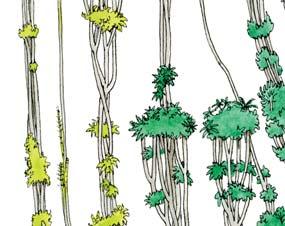
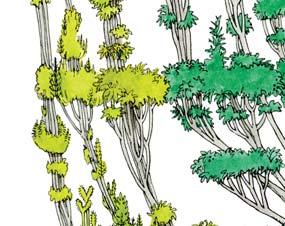

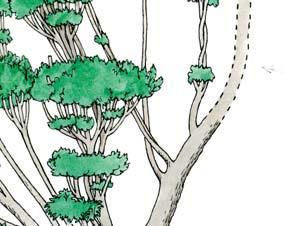


Cenozoic Jurassic 200 Triassic f D h f d H Devonian
Origin & spread of grasslands

Silurian 3rd 5th 2nd 0 20 40 60 120 140 160 180 220 240 260 280 300 300 320 320 340 360 380 400 420 420 440 4th Period Extinctions M L U L U U M L U U L M L U M L L U 1st angiosperms gymnosperms pteridophytes Key 227 233 tenoMol L M U M x ISSN 2410-4418 Palaeont. afr. (2023) 57 (Special Issue): i–xiv + 1–324



Heyday of the Gymnosperms Climate change e Cold Hot
Hannah Bonner 2018
Heyday of the Angiosperms Climate chan a g e C 20º C swing

Telemachus
Dordrechtites
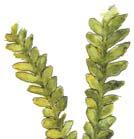


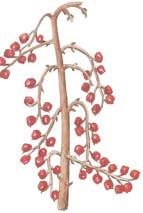
PINOPSIDA DicroidiumUmkomasia GINKGOOPSIDA
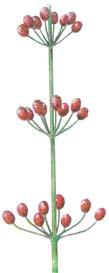

Molteno
Molt

Diversification of seed plants
Origin of arboreal plants (trees)
Origin of vascular plants (higher land plants with specialized tubes for conducting water & minerals)
Or gin of vascular p ants(higher

Molteno Plants (selection of gymnosperms)

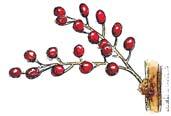

Kannaskoppia PETRIELLALES
Fredlindia BENNETTITOPSIDA
Molteno window onto co-radiation of gymnosperms & beetles
The plants and insects share a close co-evolutionary history from around 440 million years back in the early to middle Silurian. Particularly clear, for instance, is the parallel radiation of the angiosperms (flowering plants) and of the ‘Big Four’ orders of pollinating insects, the Coleoptera (beetles), Diptera (flies), Lepidoptera (butterflies & moths), and the Hymenoptera (Ants, wasps & bees), from the early Cretaceous at around 140 million year ago

In the Triassic explosion of life, we see the ‘heyday of the gymnosperms’ and the earliest great diversification of the beetles. For the first time they constitute around half the total diversity of the insects – as in today’s world. The evidence for the close interdependence of the beetles and gymnosperms in the Molteno is clear. The beetles were most likely the primary pollinators of the diversity of gymnosperms in the Molteno and across Gondwana at the time.
Nataligma GNETOPSIDA
Triassic
Explosion
Diversification of flowering plants Heyday of the Pteridophytes
Fig. 1. Plant Timetree.
Reference (Plant Timetree) Bonner, Jovero & Anderson (2018)

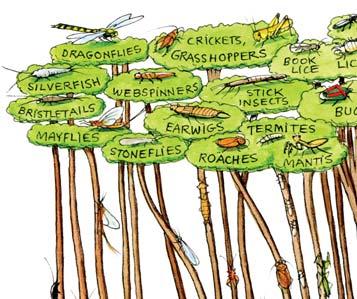

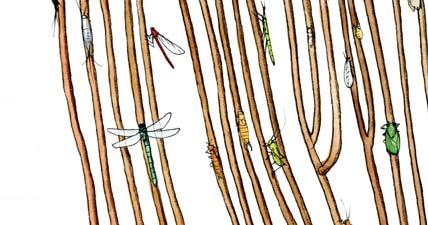


Guestimates are that perhaps 100 million insect species have lived at one or other time & clambered on this 425 million-year-old timetree.
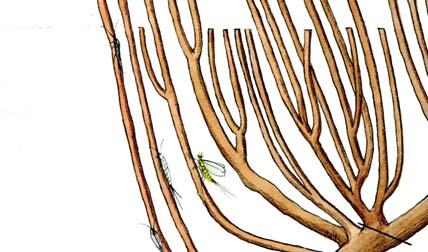
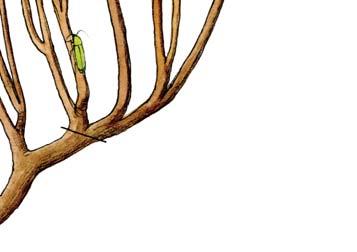

Reference (Insect Timetree)
And. J.M., Scholtz, Eardley & Bonner (2016)
Molteno Insects


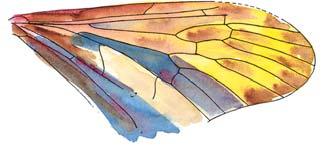




Colour in the later Carnian explosion of diversity
Surely, as in today’s world, colour must have played a significant part in the interaction of life. The early dinosaurs (p. 10) – as in the avian world of today – are widely recognized as having joined this new world of colour (Greshko, 2020). It is interesting to note that the earliest known direct evidence of insect pollination amongst the angiosperms is of a pollencovered beetle in amber (from India) at c. 100 myrs (Imbler, 2019).
Molteno insects (overview)
c. 2300 specimens from 43 of the 100 TCs (2021)
Based on a preliminary sorting of the full collection in the late 1990s: 43 TCs, 2056 indivs, 18 orders, 117 genera, 333 species. Beetles – make up almost half the total diversity, much as today’s insect world Cockroaches – make up almost half the total abundance, but show little diversity (And. & And. et al., 1996; And. J.M., Kohring & Schlüter, 1998; And. J.M. (ed.), 1999; And. J.M. et al., 1999).
Molteno
First folded wings
ODONATA (dragonflies)
BLATTODEA (cockroaches)
TRICHOPTERA (caddisflies)
HEMIPTERA (bugs, aphids, cicadas)
MECOPTERA (scorpionflies)
COLEOPTERA (beetles)
453 indivs 161 spp
91 indivs 22 spp
956 indivs 10 spp
229 indivs 69 spp
31 indivs 15 spp
9 indivs 4 spp
(selection of orders)
First wings
First folded
First larvae Firstlarvae
Continental Drift
233 xi ISSN 2410-4418 Palaeont. afr. (2023) 57 (Special Issue): i–xiv + 1–324
M lt
227
Fig. 2. Insect Timetree.
Insect tree artwork Hannah Bonner 2016
DIVISION
Chart 3. MOLTENO FLORISTICS.
HEPATOPHYTA
INCERTAE SEDIS
LYCOPHYTA
& liverworts damp/shady undergrowth
5 genera 13138v. rareherbaceouswide spectrum
SPHENOPHYTA (horsetails)
Schizoneura
Paraschizoneura
Moltenomites
Townroviamites
Non-gymnosperms: 34 genera, 98 species
Gymnosperms: 27 genera, 115 species
Total vegetative: 61 genera, 211 species
Species: based on full taxonomic review of Molteno flora
Sampling: based on the 100 sampled taphocoenoses (TCs)
Frequency: the number of TCs in which the genus occurs
updated after:




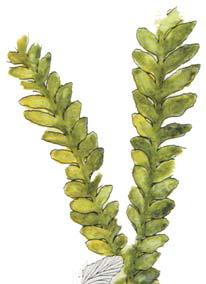


riverine forest riverine forest floodplain woodland forest to woodland floodplain woodland riverine forest lake margin forest to woodland wide spectrum


Kannaskopianthus/
d land
water margin riverine forest riverine forest riverine forest riverine forest
And., And. & Cruick. (1998, p. 393); And, J.M. (ed.) (1999, p. 76)
Abundance (the norm in the TCs in which it occurs): very rare – 1–5 individuals rare – 5–10 individuals occasional – 10 individuals to 1% common – 1%–5% dominant – dominates the communities
Sources:
Sphenobaiera

misc. scales
Bryophyta-Lycophyta: volumes in prep.
Sphenophyta: And. & And. (2018, tab. 2, p. 71)
Filicophyta: And. & And. (2008, tab. 1, p. 5)
Pinophyta: And. & And. (2003, tab. 15, p. 21)
Molteno sketches: HMA & JMA the five genera illustrated to right

xii ISSN 2410-4418 Palaeont. afr.
Tab. 1. Observed vegetative diversity.
sue): i–xiv + 1–3
Pseudoctenis
Heidiphyllum
} } } } } } } } } } } } }
Rochipteris
CLASS Genus spp fre- quency abundanceplant formpreferred habitat BRYOPHYTA Muscites 1 1 17rare
121218raremosses
Marchanitites
Thallites 2 genera 9 3 12 4 3 v. rare v. rare
Balenosetum Asinisetum Zonulamites
Equisetites 2 4 2 1 1 4 3 6 23 7 4 5 2 8 27 3 19 dominant occasional occasional occasional dominant dominant occasional dominant horsetails: reed-like, herbaceous to tall bamboo-like riverine & floodplain wetlands
(ferns) Drepanozamites Asterotheca Osmundopsis 3 genera Dictyophyllum Cladophlebis 8 genera 2 3 4 8 3 8 9 37 3 6 6 18 8 35 16 v. rare occasional v. rare common v. rare occasional rare ferns riverine forest
PINOPSIDA (conifers) Heidiphyllum Clariphyllum Rissikia Pagiophyllum 1 1 2 1 5 62 2 21 1 dominant rare common v. rare shrub to tall tree tree large tree tree floodplain
riverine forest riverine & wetland open woodland CYCADOPSIDA Pseudoctenis Jeanjacquesia Ctenis Moltenia 9 3 2 4 18 21 3 2 5 occasional v. rare v. rare v. rare cycad-like generally small forest to
riverine
riverine
GINKGOOPSIDA Lepidopteris Scytophyllum Kurtziana Dejerseya Ginkgoites Paraginkgo Sphenobaiera Dicroidium Rochipteris 2 1 16 1 6 1 9 19 12 67 30 1 13 5 19 2 43 75 26 common v. rare rare common occasional occasional dominant dominant occasional med. shrub shrub small tree shrub or small tree shrub to tall tree shrub to small tree shrub to med. tree
to large tree slender shrub
INCERTAE SEDIS Batiopteris Saportaea Linguifolium 5 1 1 7 10 1 9 rare v. rare rare creeper herbaceous undergrowth herbaceous undergrowth wide spectrum riverine forest riverine
BENNETTITOPSIDA Halleyoctenis Taeniopteris 3 8 11 10 38 common common cycad-like shrub to small tree open woodland forest to woodland GNETOPSIDA Gontriglossa Graciliglossa Cetiglossa Yabeiella Jungites 1 1 1 2 2 7 8 1 1 29 1 occasional occasional v. rare occasional rare small shrub small shrub small shrub large tree shrub or tree
FILICOPHYTA
PINOPHYTA
thicket
woodland
forest
forest riverine forest
shrub
forest
p
s): S
Dicroidium P
t cket t tland nd dland t Dicroi
s
Dordrechtites

MNSs (minimum number of species): diversity recorded for whole-plant species is a minimum
Families: for complete classification including families, see And. & And. (2003, pp 54, 55)

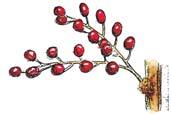
Kannaskoppia

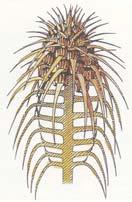
Telemachus


Fredlindia
Multi-organ genera: 16 recognized in Molteno (see And. & And., 2003, tab. 12, p. 18)
ovulate genera illustr. to right
Table: And. & And. (2003, tab. 15, p. 21)

Molteno reconstructions: And J.M. (ed.) (1999, pp 80, 81)
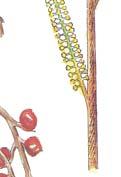
Hlatimbia
Umkomasia
Nataligma

xiii ISSN 2410-4418 Palaeont. afr. (2023) 57 (Special Issue): i–xiv + 1–324
Dordrechtites all sketches ×½
Fredlindia Nataligma Kannaskoppia Rochipteris Kannaskoppianthus Antevsia Lepidopteris Peltaspermum 1 1 12 12 5 25 4
Telemachus Umkomasia Hlatimbia
Tab. 2. Gymnosperms; observed diversity.
12 cm 0
Hlla
Umkomasia 115 145 12 145 115




















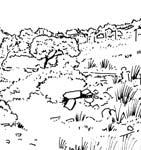

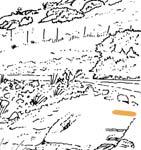






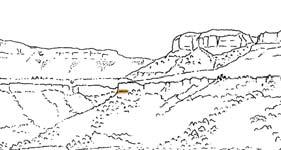




xiv ISSN 2410-4418 Palaeont. afr. (2023) 57 (Special Issue): i–xiv + 1–324 Cal 211 Gre 121 Gre Lit 111 Pen 411 Tel 111 Kom 111 Cyp 111 111 Lut 311 San 111 Kon 211 Nuw 111 Nuw Boe 112 Boe xiv ISSN 2410-4418 Palaeont. afr. (2023) 57 (Special Issue): i–xiv + 1–324

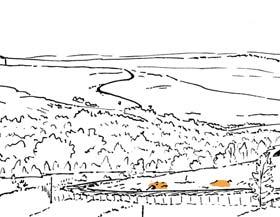

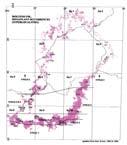



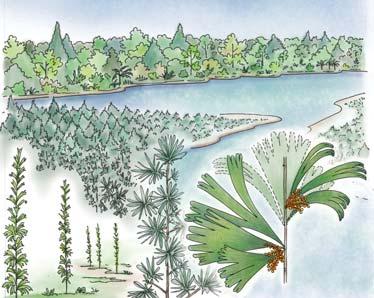
Part 1
sampling & occurrence
The three affiliated organs, Rochipteris (foliage), Kannaskoppia (ovulate) and Kannaskoppianthus (microsporangiate) of the family Petriellaceae, are recorded from 26 of the 100 Molteno assemblages (TCs). These are tabled in stratigraphic sequence with abundance data for the taxa found. The Molteno Formation sampling is set within the context of the Gondwana Triassic.
At the core of the chapter is a systematic coverage of the 26 sites, including a pen sketch of each, at which these TCs occur – listing habitat, number of slabs collected, man-hours cleaving, the fossil flora recovered (dominants, biodiversity, Petriellaceae found, affiliation) and taphonomy. The insects and plant–insect interactions found in the TC are also summarized.
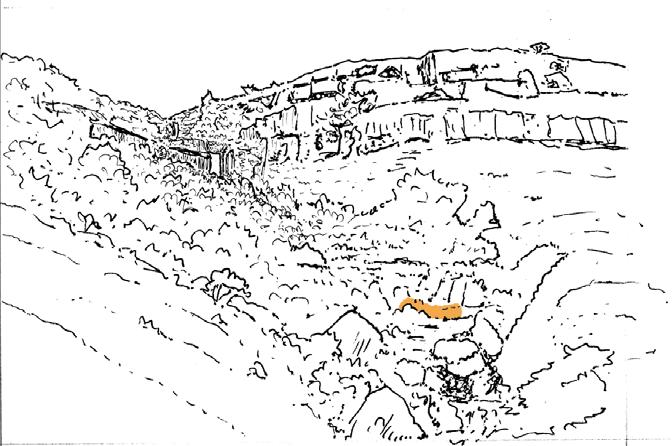


M5 M4 M3 M2 M1 16 16 Kan 111, 112 M5 M4 M3 M2 M1 6 6 Umk 111
BC TC BC TC
Chart 1. SAMPLING THE MOLTENO & GONDWANA TRIASSIC.
The Molteno Fm.
The Kannaskoppia/Kannaskoppianthus/Rochipteris material described herein is based almost exclusively on our own extensive collections – belonging to the South African National Biodiversity Institute (formerly the National Botanical Institute), Pretoria, (PRE/F/-) and the Evolutionary Studies Institute, ESI (formerly the Bernard Price Institute, Witwatersrand University, Johannesburg (BP/2/-). These fossils are presently all housed in the Molteno collection at ESI. The transfer of the collection to ESI was undertaken during March to July 2010, with the Pretoria collection (PRE/F/-) now on permanent loan to that institute. The Molteno material collected and originally described by Seward (1903, 1908) and Du Toit (1927) is housed in the Iziko Museum (formerly South African Museum), Cape Town (SAM-PV-K).
For sampling strategies, methods and approach, see And. & And. (1983, pp 2–29; 1989, pp 5–17; 2003, pp 2–11). A table and map of the 43 Superlocalities (10 km diameter grid) and the 100 assemblages (taphocoenoses, TCs) are given in And. & And. (1989, p. 29), And. & And. (2003, pp 8, 9) and repeated in this volume (Chart 3, pp 6, 7). These are referred to throughout the volume in their abbreviated form (see Glossary). Rochipteris and affiliates –rarely over 1% of the flora – occur in 26 taphocoenoses (TCs) (Chart 6, pp 12, 13).
Evenness of sampling
Geographic (Fig. 1a)
The Molteno outcrop – considering plant-bearing continental deposits on a Gondwana-wide scale – is especially extensive (c. 400 × 200 km) and well exposed. With the greatest thicknesses (up to 500 m) along the southern outcrop, the number of assemblages decreases to the north; as is clearly evident in the outcrop map.
Ecological (Fig. 1b)
In the Molteno Biome, we recognize seven primary habitats (Chart 4, pp 8, 9): some are far more prolific than others in regard to productive fossil-plant deposits. The seven Molteno habitats remain unequally represented in the collection (Chart 4, p. 9). Coverage ranges from a maximum of 32 TCs for the Dicroidium woodland, to a minimum of two TCs for the mature Dicroidium riparian forest. The Heidiphyllum thicket, most relevant in this volume, is second best covered with 24 TCs.
Stratigraphic (Fig. 1c)
As Gondwana, the southern half of Pangaea, drifted north through the Triassic (see Fig. 2, p. 3), an active margin developed between Antarctica and southern Africa. The repeated upward-fining cycles of sedimentation (members) are a consequence of pulses of uplift. The fullest sequence of members is encountered in the SE where all six cycles are recognized.
Intensity of sampling
Geographic grid (hierarchy) Grid diam. subregions100 km10 superlocalities10 km43 localities1 km69 sublocalities100 m80 supersites10 m85 TCs (assemblages)–100 Slabs (approx.)–27 200
Collecting programme: 1967–1998 (31 years); 85 field trips. Extensiveness of sampling: 100 taphocoenoses (assemblages) from 69 localities (areas to 1 km in diameter).
Intensity of sampling: c. 27 200 catalogued slabs including c. 300 000 identifiable vegetative specimens (individuals). – from And. & And. (2003, pp 2, 3)
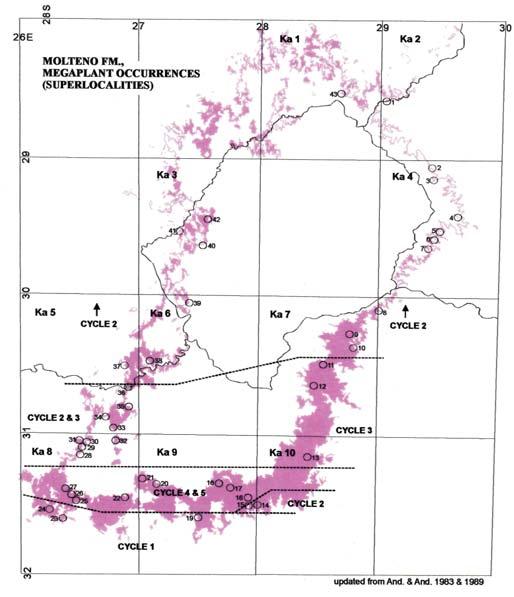
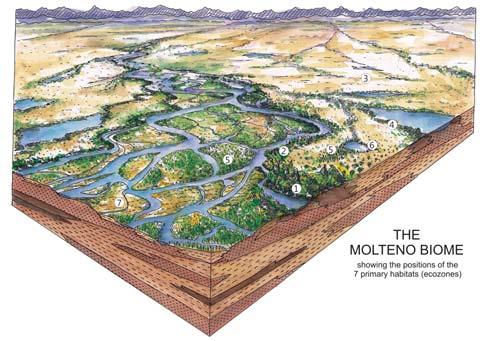







Kannaskoppia SAMPLING & OCCURRENCE 2 ISSN 2410-4418 Palaeont. afr. (2023) 57 (Special Issue): i–xiv + 1–324
Ecological The Molteno Biome showing the positions of the seven primary habitats (ecozones) – as in the southern outcrop belt of the Molteno Fm. 200 km Cape Fold Belt 5 5 7 1 1 3 4 2 6 6 1. Umk 111, Lit 111 2. Mat 111 3. Cyp 111 4. Aas 411, Kom 111 5a. Aas 111, Lut 311, Pen 311, Pen 411 5b. Tel 111, Kan 112 6. Gre 111 7. Kan 111 S a b
1b.
050100 km
Tab. 1. Molteno sampling.
outcrop c. 400 × 200 km in extent
Fig. 1. Molteno sampling.
Loskop 1–Tsomo 81 Qiba 114 Mayaputi 206 Indwe 5211 Bamboesberg 84 10026 Molteno Fm. Stratigraphic occurrence Molteno Fm. 500m thick cycles members TCs permember TCs with Rochipteris et alii Totals: Lateral extent of each member Base of Molteno Elliot Formation Beaufort Group Molteno Formation 4 1 South North 3 5 6 4 North South 1 6 5 3 2 4 2 N 050100 km 1a. Geographic 1c. Stratigraphic
The Gondwana Triassic (GT)
Although Gondwana Triassic plants have been sampled for around 175 years (Morris 1845, McCoy 1847 and later), major potential remains for further extensive collections and revision.
Colonization success (Prominence)
For Kannaskoppia – as in our earlier volumes – we consider the success of the taxon in colonizing Gondwana through the Triassic (see Part 2, Systematics, p. 50). Rochipteris ranks fourth in this regard amongst the gymnosperm plant genera through the supercontinent – following Dicroidium, Heidiphyllum and Sphenobaiera. For this purpose, clearly the more comprehensive and comparative the sampling across the supercontinent, the more meaningful the results – a sense of the disparity continent by continent follows.
Tab. 2. Gondwana Triassic sampling. regionsformationslocalities
South America4 basins18 fms49 locs
Southern Africa4 basins5 fms81 locs
India 2 basins4 fms8 locs
Antarctica2 basins5 fms21 locs
Australasia10 basins37 fms228 locs
And. & And. (2018, pt 2, tab. 4)
The level of sampling around the Gondwana Triassic (GT) has increased substantially in the past four decades since 1983 (see Hypodigm, Part 2, pp 106–115). This is especially the case for Antarctica, where new localities and collections have increased significantly (e.g. Bomfleur et al., 2013, 2014). An overview of megaplant sampling levels across the supercontinent during the Triassic is given in And. & And. (2003, pp 2, 3). “By far the fullest succession of megafloras is preserved in the series of basins stretching down the eastern tectonic margin of Australia.” It would be useful for an updated compilation to be undertaken.
On a sampling scale of 1 to 5 (reconnaissance to comprehensive), we might rate the Molteno Formation grade 4 (approaching optimal) and most other GT formations about 2 (basic).
Global Triassic correlations
The biostratigraphic and chronstratigraphic correlation of global Triassic strata is still in a considerable state of flux (Lucas et al., 2012; Ogg et al., 2014). After their recent review of the status of the Triassic Timescale, Ogg et al. (2014) concluded, “Unfortunately, there are lingering major uncertainties on the age … and durations for most of the Triassic stages. In particular, establishing a robust Late Triassic time scale requires definitive radio-isotopic dates ….”
In the few years since, as noted by Ruffell et al. (2018), our knowledge of the Triassic is clearly improving: “Dating methods and databases have improved. Importantly, correlations between late Triassic continental red beds and marine limestones are facilitated by magnetostratigraphy, carbon-isotope excursions, palynology and occasional radioisotopic dates.”
Our aim, along with several colleagues (see Introduction), is to complete the holistic study of the Molteno – megaflora and palynomorphs, insects, plant–insect interactions, radio-isotopic dating, bioand eco-stratigraphy – over the next five years or so. Included will be a review of the correlation of Gondwana Triassic plant and insectbearing strata tied as closely as possible to the global Triassic standard. We have since our latest Molteno volume on the Sphenophytes (And. & And., 2018), attempted a partial update of our ‘Gondwana Triassic, stratigraphic occurrence of megaplants’ (Chart 2, Fig. 2, p. 5).
This, then, supercedes the correlations appearing in our Brief History of the Gymnosperms (And., And. & Cleal, 2007).

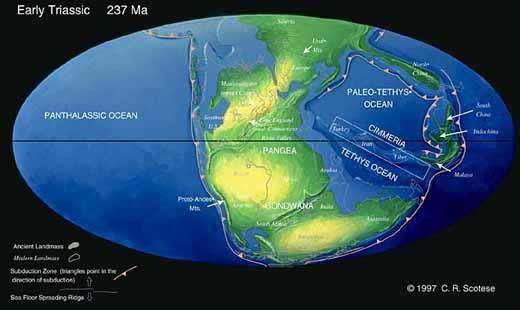

Kannaskoppia SAMPLING & OCCURRENCE 3 ISSN 2410-4418 Palaeont. afr. (2023) 57 (Special Issue): i–xiv + 1–324
Fig. 2. Gondwana Triassic in context.
From: Chris Scotese (1997) Paleomap Project
Chart 2. GONDWANA TRIASSIC MEGAPLANTS.

Updated from And. & And. (1983, 1989, 2003)
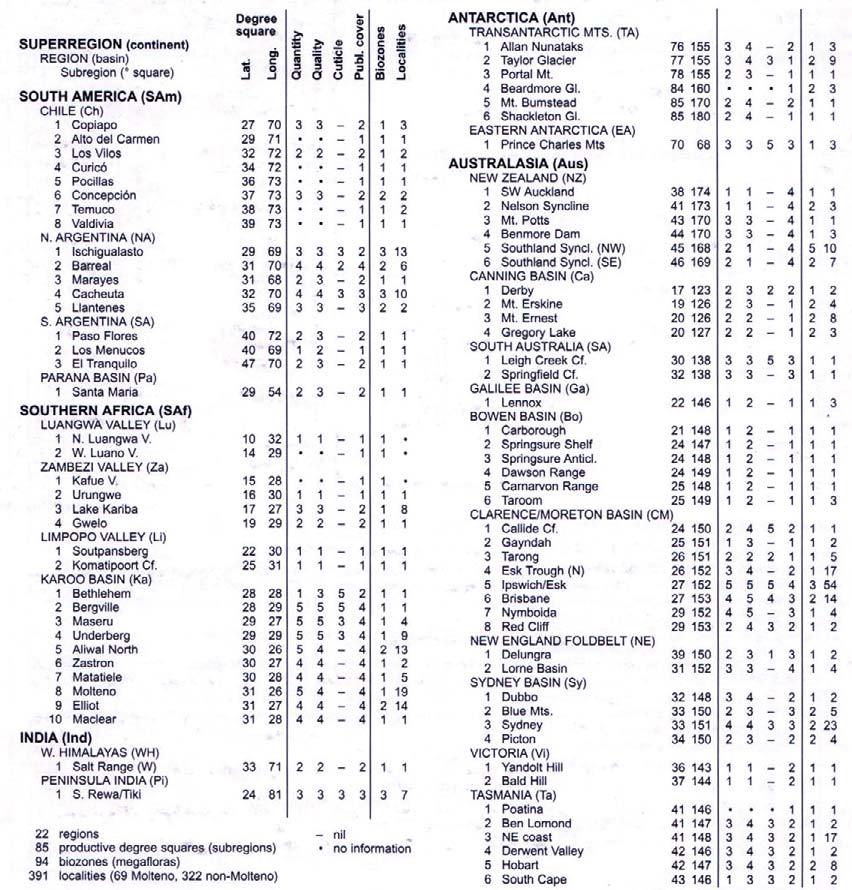
Kannaskoppia SAMPLING & OCCURRENCE 4 ISSN 2410-4418 Palaeont. afr. (2023) 57 (Special Issue): i–xiv + 1–324
Fig. 1. Geographic occurrence.
Tab. 1. Gondwana Triassic, productive degree squares.
3 Subregion (degree square), with Rochipteris (& affiliates)
SOUTH AMERICA
Chile (CH)
207 La Ternera “ El Puquen “ Gomero “ Tralcan
209 Gomero “ Tralcan
231 Quilacoya
232 Quilacoya
242 (Alto Del Carmen) “ Atacama
N. Argentina (NA)
232 Ischigualasto “ Q. de la Mina
228 C. de Piedra
230 L. Carrizal
233 Panul
Potrerillos
234 Los Rastros
238 Ischichuca
242 Las Cabras (M/U)
243 Las Cabras (L)
Fig. 2. Stratigraphic occurrence.
For discussion on the correlation & duration of the Molteno Fm. (233–227 myrs), see p. 10
S. Argentina (SA)
232 Paso Flores
235 El Tranquilo
238 Los Menucos
Parana Basin (Pa)
227 Santa Maria
SOUTHERN AFRICA
Luangwa Valley (Lu)
232 ‘U. Grit’
247 Ntawere
Zambezi Valley (Za)
232 ‘Flags’
Limpopo Valley (Li)
232 (Molteno)
Karoo Basin (Ka)
233 Molteno
247 Burgersdorp
INDIA
W. Himalayas (WH)
247 Landa
Peninsular India (Pl)
225 Tiki
232 Chicharia
247 Parsona
ANTARCTICA (TA, EA)
Transantarctic Mts.
238 Falla
“ Lashly C
242 Fremouw
249 Lashly A
Eastern Antarctica
225 Flagstone Bench
AUSTRALASIA
New Zealand (NZ)
206 (Southland)
227 (Southland)
239 Tank Gully
Adapted from And. & And. (1983, 1989, 2003, 2008, 2018) & other recent references: see below
Canning Basin (Ca)
248 Culvida
250 Erskine 251 Blina
Southern Australia (SA)
238 Leigh Creek “ Springfield
Galilee Basin (Ga)
242 Moolayember
243 Clematis
Bowen Basin (Bo)
242 Moolayember
243 Clematis
Clarence/Moreton Basin
203 Raceview 205 Aberdare
232 Callide “ Ipswich (U)
New England Foldbelt
240 Gragin
241 Gunnee
250 Camden Head
Sydney Basin (Sy)
242 Benolong “ Wianamatta
243 Hawkesbury
248 Burralow “ Gosford (U) “ Newport (U)
249 Newport (M)
250 Garie “ Newport (L)
Gosford
251 Banks Wall “ Gosford (L) “ Bald Hill
251 Patonga “ Bulgo
Victoria (Vi)
Gosford ( Tank (
“ Black Jacks “ Long Gully
240 (Southland)
250 “
Rochipteris (and affiliated strobili) are recorded from 21 Formations in the Gondwana Triassic as shown in Tab. 2 (above). Of these, the Molteno is by far the most productive, with 20 Superlocalities (Chart 3, p. 6) yielding a total of 12 species from the 26 TCs. For Gondwana species distribution, consult the Hypodigm Charts (pp 102–115).
The Triassic explosion of biodiversity In the story of life on earth, the Triassic explosion – plants, insects, tetrapods (the origin of dinosaurs) – following the end-Permian extinction, the Triassic strata tell a most compelling chapter.
233 Tarong “ Ipswich (L) “ Tingalpa “ Red Cliff
241 Esk “ Nymboida
242 Neara
243 Bryden
238 Yandoit “ Bald Hill
Tasmania (Ta)
231 Brady “ New Town
251 Knocklofty
Adapted from And. & And. (1989, p. 30; 2003, p. 7)
Recent references
Mancuso et al. (2020): origin of dinosaurs
Smith et al. (2018): Australian Triassic palynostratigraphy IUGS (2018): International geological time-scale Ruffel et al. (2018): Carnian, extinctions & biodiversity explosion Marsicano et al. (2016): origin of dinosaurs, Ischigualasto Fm.
Kannaskoppia SAMPLING & OCCURRENCE
ISSN 2410-4418 Palaeont. afr. (2023) 57 (Special Issue): i–xiv + 1–324
5
SAmSAfIndAntAus ChNASAPaLuZaLiKaWHPlTANZCaSAGaBoCMNESyViTa
UPPER R N C M L A L Triassic 201 209 227 237 242 247 252 Period Epoch Stage Ma 210 220 230 240 250 O I Rastros Triassic
R N C
M – Middle L – Lower megaplant-bearing
Ischig. Molteno
Stages
Rhaetian Norian Carnian L A Ladinian Anisian O I Olenekian Induan
formations beds with Rochipteris (& affiliated strobili)
Tab. 2. Gondwana Triassic, megaplant-bearing formations.
“ Cacheuta
“
“
Llantenes
“ Cortaderita “ Chihuiu (U)
“ Barreal
Ma – age marking base of Formation bar (rounded off to the closest million)
LaTernera
Rastros
El C Creek g
beds with Rochipteris (& affiliated strobili)
( “
Chart 3. MOLTENO Fm. MEGAPLANTS.
Fig. 1. Molteno Fm., megaplant occurrences (Superlocalities).

Kom ♂
Tel ♂ ♂ ♂ ♂
Kan 111 ♂ ♂
Cyp ♂
050100 ♀
coding
TCs with Rochipteris & affiliates
TCs with attached fruiting &/or foliage specimens
TCs with Kannaskoppia
TCs with Kannaskoppianthus
Kannaskoppia SAMPLING & OCCURRENCE 6 ISSN 2410-4418 Palaeont. afr. (2023) 57 (Special Issue): i–xiv + 1–324
♀
♂
Superlocalities (10 km diam. grid)
Molteno
Little Switzerland
1.
Champagne Castle
2.
Injasuti
3.
Valley
4.
Mooi River
Hlatimbe
5.
Valley
Umkomaas
6.
Valley
Sani
7.
Pass
8. Mngeni Valley
9.
Qachasnek
Kenegapoort
Tina Bridge
Waldeeck
Konings Kroon
Peninsula
Kannaskop
Navar 18. Cala Road
Askeaton
Greenvale
Dordrecht
Birds River 23. Bamboesberg 24. Aasvoëlberg 25. Boesmanshoek Pass 26. Cyphergat 27. Molteno 28. Kleinhoek 29. Kapokkraal 30. Kommandantskop 31. Kullfontein 32. Telemachus Spruit 33. Vineyard 34. Elandspruit
Kraai Rivier 36. Lutherskop
Nuwejaarspruit
Winnaarspuit
Qualasi Hill
Morija
Makoaneng
Mazenod
Golden Gate
10.
Matatiele 11.
12.
13.
14.
15.
16.
17.
19.
20.
21.
22.
35.
37.
38.
39.
40.
41.
42.
43.
111
111
111
& 112
updated from And. & And. (1983, 1989) km
Colour
Superlocalities with Rochipteris & affiliates


Superlocalities: numbered in clockwise order around the Molteno outcrop (see map opposite)
Supersites: arranged chronologically, within each superlocality, according to date of discovery (earliest above)
Assemblages: arranged stratigraphically for each supersite (youngest above)
Informal names: all distinct supersites within a superlocality have been given a familiar name for ease of communication (assemblages within a supersite retain only the formal code name)
From And. & And. (2003, tab. 5, p. 9)
Extensiveness of sampling
The 26 Molteno TCs with Rochipteris & affiliates
TCs with attached fruiting and/or foliage specimens
TCs with Kannaskoppia
TCs with Kannaskoppianthus
Note: our collection from Pen 222 is combined with Pen 221 (they are taken as representing the same assemblage); likewise, Kon 221 is combined with Kon 211.
Kannaskoppia SAMPLING & OCCURRENCE 7 ISSN 2410-4418 Palaeont. afr. (2023) 57 (Special Issue): i–xiv + 1–324 *
+ 222 Cutting
♂ ♂ ♀ ♂ ♂ ♂ ♂ ♂ ♂ ♂ ♂ ♂ ♂ ♂ ♀
Tab. 1. Molteno ‘localities’ & assemblages.
Chart 4. MOLTENO Fm.,
ECOLOGICAL OCCURRENCE.
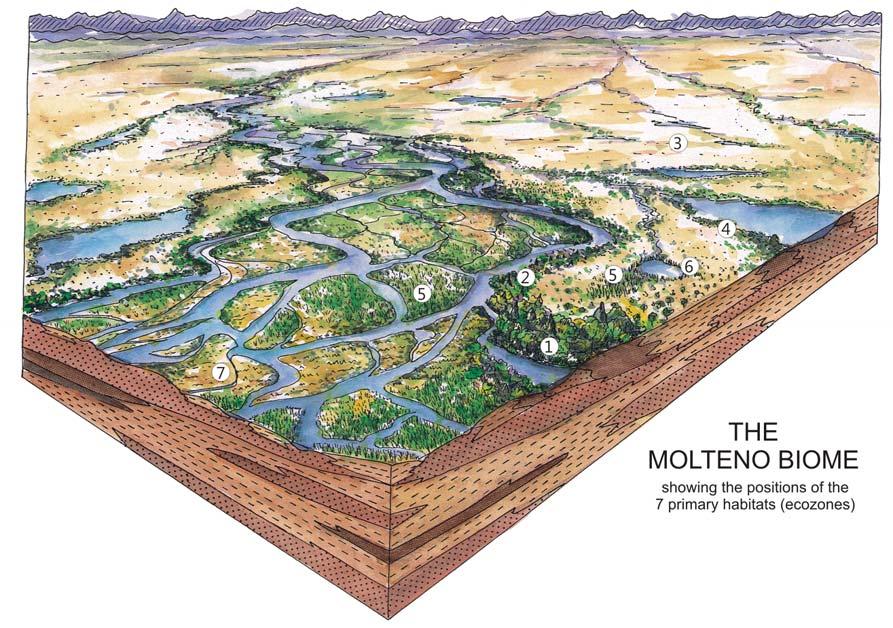
1 Dicroidium riparian forest, type 1 bordering channels in mature landscapes
2 Dicroidium riparian forest, type 2 bordering channels in immature landscapes
3 Dicroidium woodland open floodplain
4 Sphenobaiera woodland lake in floodplain

Mountains Uplands Lowlands (Euramerica undifferentiated)
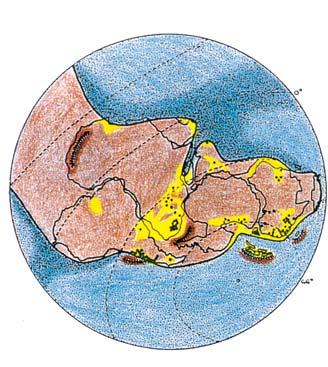

5 5 7 1 1 3 4 2 6 6 A world without icecaps
S a b
200
1. Umk 111, Lit 111
2. Mat 111
3. Cyp 111
4. Aas 411, Kom 111
5a. Aas 111, Lut 311, Pen 311, Pen 411
5b. Tel 111, Kan 112
Molteno Biome
showing the positions of the seven primary habitats (ecozones) – as in the southern outcrop belt of the Molteno Fm.
5 Heidiphyllum thicket in areas of high water table in floodplains (5a); or on channel sandbars in the braided river (5b)
6 Equisetophyte marsh marsh in floodplain
7 Fern/Kannaskoppia meadow sandbars in braided rivers
Gondwana Triassic Reconstructions
showing position of the Molteno
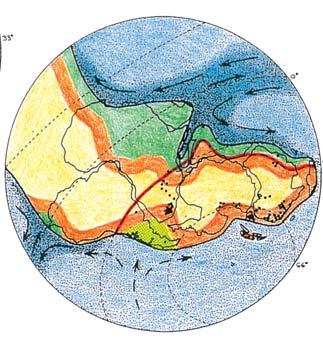
Megaplants (productive degree squares)
Gondwana Kingdom
Biome at the southern tip of extant Africa

Warm currents
Cool currents
Warm water
Cool water
Tropical rain forest
Temperate rain forest
Woodland
Semi-desert & desert
References
And. & And. (2003) And. & And. (1983, 1989, 2003)
Kannaskoppia SAMPLING & OCCURRENCE 8 ISSN 2410-4418 Palaeont. afr. (2023) 57 (Special Issue): i–xiv + 1–324
Fig. 1. Ecological.
TOPOGRAPHYVEGETATION
ns ds
33° 66° 0° 33° 66° 0°
The km
Cape Fold Belt
6. Gre 111 7. Kan 111
Blattodea
Coleoptera
Hemiptera
Conchostraca
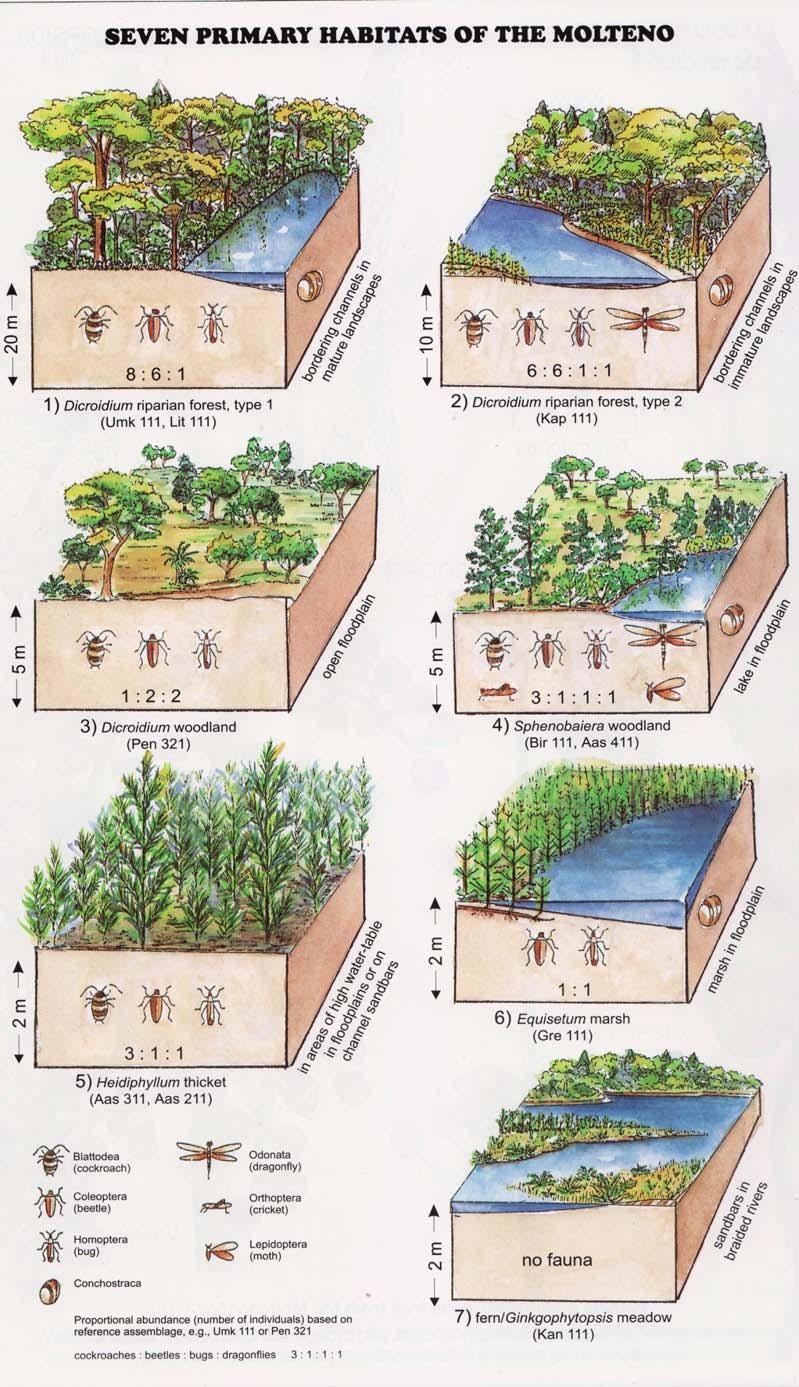
Odonata (dragonflies)
Orthoptera (crickets)
Trichoptera (caddisflies)
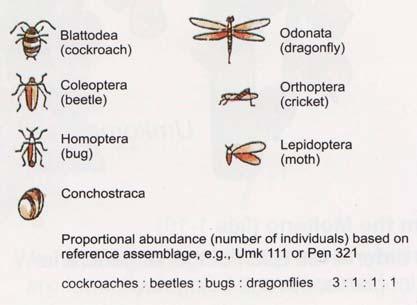
Adapted from: And. J.M. (1999, p. 79)
Seven primary habitats
Near the centre of Gondwana at around 50°S in a world without icecaps, lay the diversely vegetated Molteno Biome. It occupied an extensive inland basin spreading some 1000 km N–S between the upland hillscape of the Kaapvaal Craton to the north and the actively folding Cape Mountains to the south. Across the central portion of this depositional basin (the preserved remnant of the Molteno Fm.), we recognize the seven primary habitats illustrated here (Cairncross, And. & And., 1995, figs 12, 13).
Plants (comprising the 7 habitats)
A considerable diversity of plants made up the flora of these seven habitats. We currently recognize 211 vegetative species (Chart 3, p. xii), with a statistically calculated c. 876 species preserved in the Molteno Formation, and an estimated 2000 species existing in the Late Triassic Molteno Biome (as projected from the 204 species as recognized in 1999). This species-level (gymnosperm-dominated) diversity would be similar to that growing in an equivalent (though angiospermdominated) environment in the extant world (And., And., Fatti & Sichel, 1996; And. J.M., 1999).
Insects (reflecting the 7 habitats)
The Molteno insect collection is sufficiently numerous (c. 2300 individuals) and diverse (c. 350 species) to reveal a distinctive pattern of occurrence (or signature) for the four most prominent insect orders – cockroaches, beetles, bugs and dragonflies – in the seven habitats. Total diversity in the basin at the time of deposition is statistically estimated at 20 000 species. The insect tally –considering all 16 orders found – is shown in the following pages for the 26 TCs covered in this volume (And., Kohring & Schluter, 1998).
Conchostraca (scarce but revealing)
These small, mainly freshwater crustaceans, after the insects, are the most significant faunal element in the Molteno. With some three genera (8 species), they are known from 20 plant assemblages – in several cases ‘in relative abundance on certain bedding planes’. Though they have been found in deposits associated with most habitats, their occurrence is uneven: being most abundant in riparian forest TCs (types 1 and 2) and Sphenobaiera woodland TCs (And., And. & Cruickshank, 1998, tabs 3, 4, p. 401; Kohring, 1998).
Kannaskoppia SAMPLING & OCCURRENCE 9 ISSN 2410-4418 Palaeont. afr. (2023) 57 (Special Issue): i–xiv + 1–324
Fig. 2.
6) Equisetophyte marsh (Gre 111)
1) Dicroidium riparian forest, type 1 (Umk 111, Lit 1)
2) Dicroidium riparian forest, type 2 (Kap 111)
3) Dicroidium woodland (Pen 321)
4) Sphenobaiera woodland (Bir 111, Aas 411)
5) Heidiphyllum thicket (Aas 311, Aas 211)
(cockroaches)
(beetles)
(bugs, etc.)
7) Fern/Kannaskoppia meadow (Kan 111)
Bold numbers: tally of TCs of 100 sampled in Molteno
18 Molteno TCs
3 Molteno TCs
10 Molteno TCs
8 Molteno TCs
2 Molteno TCs
32 Molteno TCs
24 Molteno TCs
Fig. 2. Seven primary habitats of the Molteno.
Chart 5. MOLTENO Fm., STRATIGRAPHIC OCCURRENCE.
If the Molteno was deposited over 6 million years (233–227 myrs), as outlined below, then each member, on average, will represent a span of 1 million years.


Molteno Fm., age & duration
In the absence of any radiometric dates, no precise positioning of the Molteno is possible. Our updated Gondwana Triassic (GTr) correlation chart (Fig. 2, p. 5) shows the Molteno as occupying the later half of the Carnian, the Tuvalian, from 233–227 million years (an interval of 6 myrs). This is based on the correlation of plants through the GTr, and on its lithostratigraphic position within the Karoo Supergroup between the tetrapod-bearing strata of the Cynognathus Zone below and the Elliot Fm. above (see Smith et al., 2020).
The Cynognathus Zone: As with the Molteno, there are still no radiometric dates for the Cynognathus Zone, and the placing of it in the Lower to Middle Triassic, from the late Olenekian to the end of the Ladinian, possibly just into the Carnian, is based on the global correlation of tetrapod faunas (Hancoxno et al., 2020).
The Elliot Fm.: Until very recently, there were likewise no radiometric dates for the Elliot Fm. Now, with their comprehensive revision of the bio- and lithostratigraphy of the formation, Bordy et al. (2020) record a number of good U-Pb dates. These, together with their magneto-stratigraphic studies, have enabled them to constrain the formation far more confidently than previously. They plot the Elliot as running from around the mid-Norian in the Upper Triassic (at 220 Ma) to the close of the Sinemurian in the Lower Jurassic (at c. 191 Ma) – a duration of 29 myrs.













It is significant to note that disconformities separate the Molteno from these tetrapod-bearing strata above and below. Based on the current correlations of the Cynognathus Zone (ending at c. 237 Ma) and the Elliot Fm. (starting at c. 220 Ma), the maximum possible duration of the Molteno would be 17 myrs. However, considering the disconformities, it is clearly some degree less. Until radiometric dates are obtained for the Molteno, and based on current GTr plant correlations (which need major revision, including palynology), the formation is plotted in Fig. 2 (p. 5) as running 6 million years from 233–227 Ma, the duration of the Tuvalian. (In the previous Molteno volumes, the Fm. has been plotted as spanning 2 million years.)
From the global perspective, and based on the above correlations, the Molteno was deposited in the wake of the Carnian Pluvial Episode (CPE), and following the Extinction event midway through the Carnian (separating the Julian and Tuvalian substages). Early in the Tuvalian, “about 232 million years ago, the dinosaurs diversified explosively, so the CPE essentially marks the beginning of the ‘age of dinosaurs’ …. Further, and perhaps unexpectedly, this time also marks the initial expansion of nearly all modern tetrapod groups, including turtles, crocodiles, lizards and mammals ” (Ruffell et al., 2018). The explosive diversification of plants and of insects as found in the Molteno, would appear to correlate closely with this explosive diversification of the tetrapods!
Kannaskoppia SAMPLING & OCCURRENCE 10 ISSN 2410-4418 Palaeont. afr. (2023) 57 (Special Issue): i–xiv + 1–324
Loskop 1–Tsomo 81 Qiba 114 Mayaputi 206 Indwe 5211 Bamboesberg 84 10026 Molteno Fm. 500 m thick cycles members Totals: Lateral extent of each member Base of Molteno outcrop Elliot Formation Beaufort Group Molteno Formation 4 1 South North 3 5 6 4 North South 1 6 5 3 2 4 2 (max. along southern outcrop)
TCs permember TCs with Rochipteris
Fig 1. Molteno Fm., members.
N 050100 km
ISSN
M3
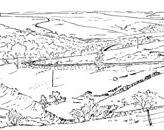


R



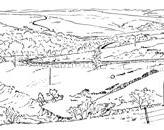



M4 M4
Umk 111








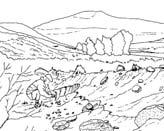
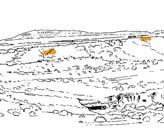

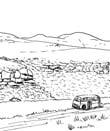


311
San 111 111
Aas 311
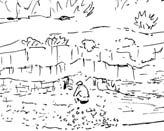
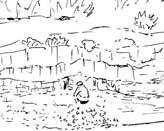
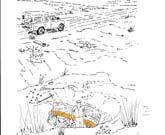
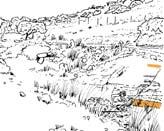



24
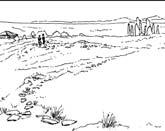

411
–() ♂
Vin 111
1 Dicroidium riparian forest, type 1
2 Dicroidium riparian forest, type 2
3 Dicroidium woodland
4 Sphenobaiera woodland
5 Heidiphyllum thicket
6 Equisetophyte marsh
7 Fern/Kannaskoppia meadow
Kannaskoppia SAMPLING & OCCURRENCE 11
2410-4418 Palaeont. afr. (2023)
Issue):
1 Cal 211 19 13 7 20 21 22 14 15 16 8 9 10 4 3 2 Pen 311 Kap 111 111 Gre 121 Tel 111 Kan 111 Gre 111 Boe 112 Vin 111 Nuw 111 San 111 Mat 111 Lit 111 Kom 111 Umk 111
57 (Special
i–xiv + 1–324
17 18 11 12 6 5 Win 111 Cyp 111 111 Kan 112 112 Kon 211 Lut 311 23 Aas 111 ♂ 1 Cal 211 Hei elo R vincularis R. 5% –() ♂ 3 Gre 111 Equ sp sp R sp indet (1) . sp. indet. –() ♂ 4 Boe 112 Dic cor cor R pusilla R. (1) –() ♂ 5 Cyp 111 111 Dic cra cra R lutifolia R. (80) –() ♂ 2 Gre 121 Hei elo R rollerii R. (22) K aasvoelensis K. (2) () ♂ 17 Win 111 111 Hei elo R rollerii R. (3) –() ♂ 16 Nuw 111 Dic zub R lutifolia R. (3) –() ♂ 15 Kap 111 111 Dic/Ris R rollerii R. (6) –() ♂ 13 Pen 311 Hei elo R rollerii R. (34) –() ♂ 14
411 Hei elo
rollerii R. (70) K aasvoelensis K. (4) () ♂ 18 Hla 213 Dic elo R switzifolia R. (4) –() ♂ 22 Lit 111 Dic/Hei R switzifolia R. (55) K switzianthus K. (9) 21 Mat 111 111 Dic dub R matatifolia R. (17) K matatiparvus K. (3) 20
Fig. 2. Key to the 26 Molteno ‘Kannaskoppia’ sites.
Pen
R
Dic
cra cra
–19
R rollerii R. (2)
Dic
Dic 2 spp
2 spp
–
Hei elo
R rollerii R. (21)
23 Aas 111 111
() ♂ 26
Dic/Sph
rollerii R. 2% K aasvoelensis K. (21)
Aas 411
♂ 25
R rollerii R. (150) K aasvoelensis K. (21) ()
Hei elo
() ♂ 24 Aas 211 Hei elo R rollerii R. (18) K aasvoelensis K. (1) () ♂ 11 Lut 311 Hei elo R lutifolia R. (66) K lutinumerus K. (16) () ♂ 7 Kan 111 Ast spA Ast R vincularis R. 5% K vincularis K. (50) () ♀ 8 Tel 111 He elo He R telefolia R. (30) K telemagnus K. (2) () ♂ 9 Kom
Sph/Dic
K komanthus K.
() ♂ 10
R rollerii R. (25) K aasvoelensis K. (4)
111
R komifolia R. (29)
(2)
Dic odo
12
Ast 2 spp Ast 2 spp
rollerii R. (5) –() ♂
He elo
R.
K
K. (5) () ♂
Kon 211
R
6 Kan 112
R distivena
(4)
irregularis
M1 M2 M3 M5 M5 M4 M3 M2 M1
24 Aas 111, 211, “ 311, 411 M1 25 Aas
M2 26 Aas
() ♂ () ♂ () ♀ () ♂
The set of 26 sites yielding ‘Kannaskoppia’ (Rochipteris & affiliates) are included here in stratigraphic sequence: youngest to oldest, and showing the members in which they occur.
Here are shown the primary affiliation between () and strobili at each of the 26 sites
24 Aas 211
R lacerata R. (2)
M5
Chart 6. ROCHIPTERIS & AFFILIATES – MOLTENO OCCURRENCE.
TCs assemblages (taphocoenosis)
Members R o c h i p t e r i s Rochipteris (Ref. pal) R. vincularis (Kan 111) “ telefolia (Tel 111) “ distivena (Kan 112) “ rollerii (Aas 111)
“ switzifolia (Lit 111) “ matatifolia (Mat 111) “ komifolia (Kom 111) “ lutifolia (Lut 311) “ obtriangulata (Umk 111) “ cf. sinuosa (Umk 111) “ penensis (Pen 411) “ pusilla (Pen 311) “ sp K a n n a s k o p p i a Kannaskoppia K a n n a s k o p p i a n t h u s Kannaskoppianthus microsporangia
K. telemagnus (Tel 111) “ irregularis (Kan 112) “ aasvoelensis (Aas 111) “ switzianthus (Lit 111) “ matatiparvus (Mat 111) “ komanthus (Kom 111) “ lutinumerus (Lut 311) “ telepentatus (Tel 111) attached organs () 123456789 10 101112 ♀ ♂ 12345678
1Cal 211Hei elo T 5 55
2Gre 121Hei elo
22–––22––––––––––21––2–––––3 “ 111Equ sp 1––––––––––––1––––––––––––
Qiba 4
4Boe 112Dic cor 1–––––––––––1–––––––––––––
5Cyp 111Dic cra 832–––1––80–––––––––––––––– ()
6Kan 112Hei elo
19–2410––––––21––51–5–––––– ♂
7 “ 111Ast spA 55 ––––––––––––50–––––––––– () ♀
8Tel 111Hei elo 33–30––––––––21––412–––––2 ()
9Kom 111Sph/Dic 30––––1–29–––––––21–––––2–– () ♂
Mayaputi 3
10Vin 111Dic odo 22––––––––––––––––––––––––11Lut 311Hei elo 66–––––––66––––––16–––––––16––
12Kon 211Ast 2spp Indwe 2
f 5–––5–––––––––––––––––––––13Pen 311Hei elo 41–––34––––––52–––––––––––––14 “ 411 “ “ 80–––70––––––10–––4–––4–––––
8–––44––––––––––––––––––––
19Umk 111Dic 2spp 50–––21–––1199–––––––––––––––
15Kap 111Dic/Ris e 6––26–––––––––––––––––––––16Nuw 111Dic zub d 3–––––––3–––––––––––––––––17Win 111Hei elo 5–––3–––1–1–––––––––––––––18Hla 213Dic elo b
20San 111Dic cra 3–––3–––––––––––––––––––––
21Mat 111Dic dub 2 – 2 –––17––––––––3–––––3––––22Lit 111Dic/Hei a 561–––55–––––––––92–––9–––––
2 2 ––––––––––215––21––––––
24 “ 211Hei elo 191––18––––––––––1–––1––––––
25 “ 311Hei elo 261––25––––––––––41––4––––––
26 “ 411Dic/Sph 150–––150––––––––––214––21––––––
23Aas 111Hei elo Bamboesberg 1


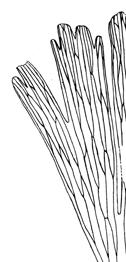
2673214411512441112811611111


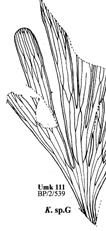
Kannaskoppia SAMPLING & OCCURRENCE 12 ISSN 2410-4418 Palaeont. afr. (2023) 57 (Special Issue): i–xiv + 1–324
Total TCs
Total individuals %%% 6 % 611729151191019515092162553932162
Foliage species (1–12)
1 4 7 5 3 8 6 2 all ×2 ♂ ♀ 3 6 12 7 11 4 5 8 all ×1 10 9 Rochipteris Kannaskoppianthus Kannaskoppia 1 2 12 cm 0
Male species (1–8)
vegetative species Dicr. rip. forest (t.1) Dicr. rip. forest (t.2) Dicr. woodland Sphenobaiera woodl. Heidiphyllum thicket SamplingDiversity Dominants
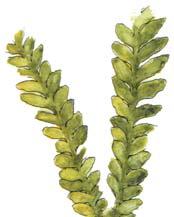
Dominants
29133405/17613––––
15444351/3347––––
Chart 7. The 26 Molteno Petriellaceae sites
Introductory notes
The column of text for each TC, tables a consistent set of information on each – including the habitat of the original ‘living community’ (biocoenosis, BC), the size of the sample and number of man-hours spent sampling the site, the make-up and diversity of the flora, and the taphonomy.
Especial attention is given to the Petriellaceae at each site; and to the question of affiliation (graded 1 to 5; see Glossary, p. 320) between the foliage and fertile elements (male or female) where relevant.
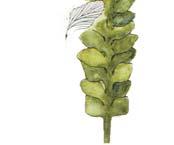

Sphenobaiera

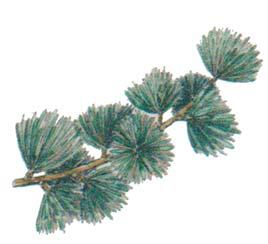

Horsetails

Key Abundance
*5 (bold) – % 22 (mild) – individuals
* number of Rochipteris indivs. indicated under descriptions for each species.
Insects & plant–insect interactions
Kannaskoppia – 1TC
varied scales
Kannaskoppianthus – 12TCs
To emphasize the mutually explosive diversity of plants and insects in the Molteno, data on the latter are included for each of the 26 TCs yielding Rochipteris. For each TC a table is given listing the insect orders present with the number of individuals collected; along with a second table listing plant–insect interactions seen for Rochipteris. Remarkably, all 26 TCs include specimens of this genus showing insect damage – as illustrated by a selection of photographs brought in from Part 4, Plates. (The notation for insectdamage types follows Labandeira, 2018, p. 14).
In a subsequent volume on the insects and other fauna (spiders, Conchostraca, fish impressions, etc., but no tetrapod bones, see And. & And. (2018, chart 7, pp 14, 15)) found in the Molteno series, a full account of the insect fauna and the plant–insect interactions will be given. Conrad Labandeira, who has spent a considerable amount of time on this research (see Acknowledgements, p. vii, and Bibliography, p. 318), will play a key role in the latter. (See Labandeira, 2006; Labandeira et al., 2007; Labandeira, And. & And., 2018).
Kannaskoppia SAMPLING & OCCURRENCE 13 ISSN 2410-4418 Palaeont. afr. (2023) 57 (Special Issue): i–xiv + 1–324
Habitat
Equisetophyte marsh fern/ Kannask. meadow Dicroidium Sphenobaiera Heidiphyllum horsetails ferns non-gymnosperms gymnosperms total 1234567 21 112– 123 ✓ 75 – 20 141 34101/1347–––– ✓ ––3– 98 2137825–5510––––– ✓ – 2 –– 97 179226–11112–– ✓ 99 –144–36246100–4812–– ✓ 75 – 24 14523153/14913–––– ✓ 1 – 98 365473020/1437–– ✓ 102263 581710901/271320–––– ✓ 6 – 89 16834102/1347–– –✓ 3960 –15 1662210–2810–– ✓ 70 4 28 58938503/141418–––– ✓ ––5829 99 3938814–6511–––––– ✓ 2052 15541135–5611–––– ✓ 25 – 75 204411701/26511–––– ✓ 13– 9423 131051065–51419– ✓ 50 2025 10 1383321–189–– ✓ 7030 ––4 642220–5611–––– ✓ 10 – 79 23 9023760–152742– ✓ 89 49 1 1132 35921020400– 294675 ✓ 695721 3033330– 31619 – ✓ 90 – 5 21 108257651/2 101828 – ✓ 89 18 4 207 217319335501/6 63238 ✓ 50123 1010
✓ ––71 77 10 20
Catalogued slabs fi eld trips days man-hours cleaving fruit abundance indivs/man-day ✓ 99 –2 5281141401/34711–––– ✓ ––159 99 –2 217611405121/382230––– ✓ 60301 7524 24421112
6 7 22 63 8 58 2
Dicroidium
Adapted from: And. & And. (2003, pp 286–313, tabs 57, 58)
Heidiphyllum
Ferns
In line with the focus on extensive and intensive sampling and on palaeodemes, pen sketches are included for each of the 26 TCs. These include, with orange bars, the position of the TCs. On each spread, a thumbnail map of the Molteno shows the location of the TCs; and their longitude and latitude is added. The number refers to the ‘Superlocality’ as listed on Chart 3, p. 6 of the large Molteno map.
Heidiphyllum thicket
27°40.68’E; 31°21.81’S

a
Cal 211
Hei elo
Cal 111
Equ sp
Habitat: Heidiphyllum thicket
Collection: 21 slabs, 2 man-hrs cleaving; impressions in thickly laminated, medium grey shale, good cleavage.
Dominants: Heidiphyllum 75%, ferns 20%
Biodiversity: vegetative total, 3 spp
Non-gymnosperms: 1 sp
Gymnosperms: 2 spp
Petriellaceae: Ref. pal
Rochipteris vincularis 5% Kan 111 Ast spA (8 slabs, 8 indivs, no clusters)
Taphonomy – parautochthonous

Gre 111 Equ sp
Gre 111 Sph pon
Gre 121 Hei elo
Insectsindivs
nil in 2 man-hrs
Blattodea (cockroaches)– 0
Coleoptera (beetles) et alii – 0 nil
Plant–insect interaction
• leaf-margin feeding –
• leaf-tip feeding –
• piercing & sucking –
• leaf mining –
• oviposition – .
HMA, 29 Aug 2011

From photo, 4 April 1992

PRE/F/9404
pl. 2(7)
×10
leaf-tip feeding, R. vincularis
c
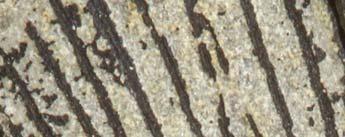
Heidiphyllum thicket
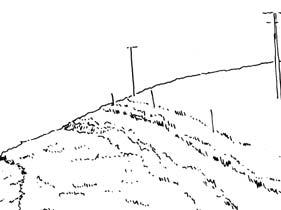

18 20
Habitat: Heidiphyllum thicket
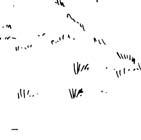
HMA, 17 June 2010

From photo, 15 March 1982
Collection: 141 slabs, 10 man-hrs cleaving; impressions in thickly laminated, medium grey shale, good cleavage.
Dominants: Heidiphyllum 98%
Biodiversity: vegetative total, 7 spp
Non-gymnosperms: 3 spp
Gymnosperms: 4 spp
Petriellaceae: Ref. pal. Rochipteris rollerii (22 indivs)* Aas 111 Hei elo Kannaskoppianthus aasvoelensis (2 indivs)* Aas 111 Hei elo – microsprorangia (1 indiv.)
()
*Affiliation (grade 4)
– the same affiliation occurs at five other sites (four also being Heidiphyllum thicket): Pen 411 Hei elo, Aas 111 Hei elo, Aas 211 He elo, Aas 311 Hei elo, Aas 411 Dic/Sph
PRE/F/9402 ×10
pl. 2(4)

PRE/F/7837b ×10
pl. 4(3)
piercing & sucking
– 1 indiv. . – nil (see glossary, p. 323) 12 cm 0
piercing & sucking, R. vincularis
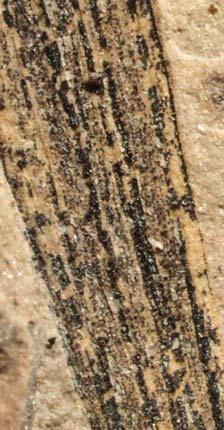
PRE/F/7839
pl. 5(5)
Insectsindivs
nil in 10 man-hrs
Blattodea (cockroaches)– 0
Coleoptera (beetles) et alii – 0 nil
Plant–insect interaction
• leaf-margin feeding – .
• leaf-tip feeding –
• piercing & sucking –
• leaf mining – .
• oviposition – .
×20
piercing & sucking,
R. rollerii
Kannaskoppia SAMPLING & OCCURRENCE 14 ISSN 2410-4418 Palaeont. afr. (2023) 57 (Special Issue): i–xiv + 1–324
Fig. 1. Cala Road (Cal 211 Hei elo), Cala Bolders.
Fig. 2. Greenvale (Gre 121 Hei elo), Telemachus Shale.
Taphonomy – parautochthonous ♂
27°08.94’E; 31°23.62’S
b c b a
Chart 7. THE 26 MOLTENO PETRIELLACEAE SITES.
ISSN 2410-4418 Palaeont. afr. (2023) 57 (Special Issue): i–xiv + 1–324
Equisetophyte marsh
27°09.6’E; 31°23.70’S

Gre 111 Equ sp
Gre 111 Sph pon
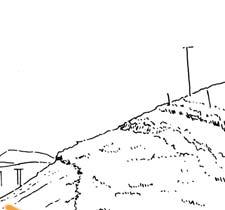
Gre 121 Hei elo

Habitat: Equisetophyte marsh

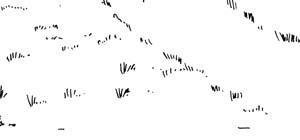

Gontriglossa/Nataligma
HMA, 17 June 2010
From photo, 15 March 1982
Collection: 213 slabs, 25 man-hrs cleaving; impressions in thickly laminated, medium grey shale, good cleavage.
Dominants: horsetails 97%, Dicroidium 2%
Biodiversity: vegetative total, 10 spp Non-gymnosperms: 5 spp
Gymnosperms: 5 spp
Petriellaceae: Rochipteris sp (1 indiv.)
Taphonomy – allochthonous
26°08.44’E; 31°29.38’S
Insectsindivs
1 per 5 man-hrs (rare)
Homoptera (bugs)– 2
Mecoptera (scorpionflies)–1
Coleoptera (beetles) – 2 5
Plant–insect interaction
• leaf-margin feeding – .
• leaf-tip feeding –
• piercing & sucking – .
• leaf mining – .
Dicroidium open woodland
Habitat: Dicroidium open woodland
Collection: 179 slabs, 6 man-hrs cleaving; impressions in thinly laminated, buff-grey shale with moderate cleavage.
Dominants: Dicroidium 99%
Biodiversity: vegetative total, 12 spp
Non-gymnosperms: 1 sp
Gymnosperms: 11 spp
Petriellaceae: Ref. pal. Rochipteris pusilla (1 indiv.) Pen 311 Hei elo
Taphonomy – allochthonous
HMA,
• oviposition – . 12 cm 0
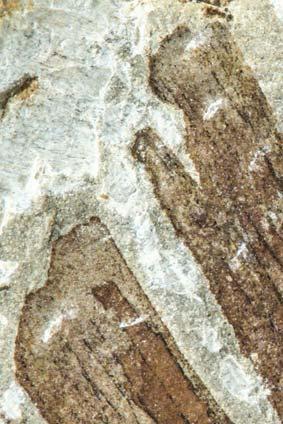
PRE/F/16568b
pl. 7(6)
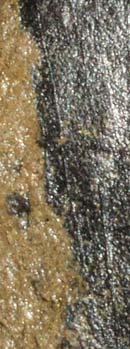
PRE/F/2762 ×20
pl. 8(6)
leaf-margin feeding, R. pusilla

Insectsindivs
nil in 6 man-hrs
Blattodea (cockroaches)– 0
Coleoptera (beetles) et alii – 0 nil
Plant–insect interaction
• leaf-margin feeding –
• leaf-tip feeding – .
• piercing & sucking –
• leaf mining – .
• oviposition – .
Kannaskoppia SAMPLING & OCCURRENCE 15
Fig. 3. Greenvale (Gre 111 Equ sp), Equisetum Cutting.
Fig. 4. Boesmanshoek Pass (Boe 112 Dic cor), Coriaceum flats.
photo, 3 Dec 1978
23 25 M5 M4 M3 M2 M1 20 18 18 Cal 211 20 Gre 111, 121 25 Boe 112
12 May 2019 From
20
×10 leaf-tip feeding, R. sp indet.
c b a c a b
Dicroidium open woodland
26°25.88’E; 31°27.14’S
26
Habitat: Dicroidium open woodland
HMA, 8 May 2019
From photo, 13 April 1995
Collection: 362 slabs, 100 man-hrs cleaving; impressions in thickly laminated dark-grey shale with moderate cleavage.
Dominants: Dicroidium 75%, Heidiphyllum 24%
Biodiversity: vegetative total: 12 spp
Non-gymnosperms: 4 spp
Gymnosperms: 8 spp
Petriellaceae: Rochipteris 3 spp (83 indivs) Ref. pal.
“ vincularis (2 indivs) Kan 111 Ast spA
“ switzifolia (1 indiv.) Lit 111 Dic/Hei
“ lutifolia (80 indivs)* Lut 111 Dic cra

() ||
*Attachment K. lutifolia – attached to shoot, ?1 indiv. – clusters of 2–10 indivs, >10 slabs – cluster of 12 indivs, 1 slab
Taphonomy
*K. lutifolia – parautochthonous other 2 spp – allochthonous

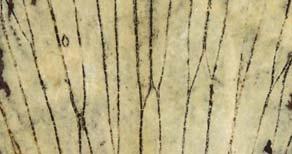



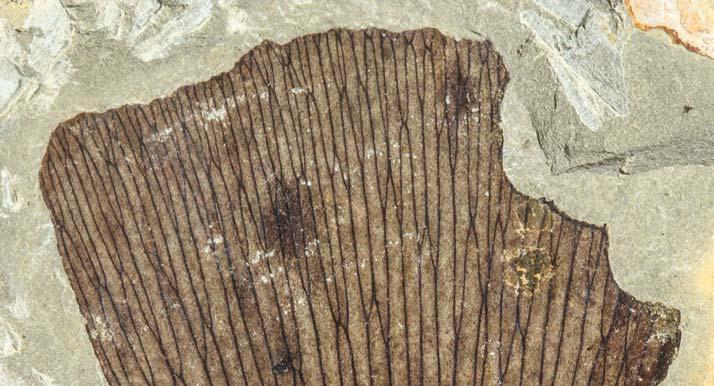
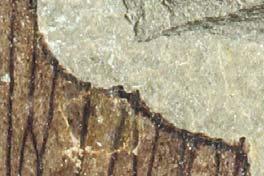
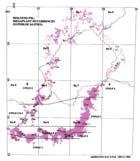
26 16
16 Kan 111, 112
26 Cyp 111
M5
M4
M3
M2
M1
Insectsindivs
1 per 3 man-hrs (rare)
Blattodea (cockroaches)– 5
Orthoptera (crickets et alii) – 2
Homoptera (bugs)–9
Coleoptera (beetles)– 11
Incertae – 3 30
Plant–insect interaction
• leaf-margin feeding –
• leaf-tip feeding –
• leaf mining –
• piercing & sucking –
• oviposition – .

Kannaskoppia SAMPLING & OCCURRENCE 16 ISSN 2410-4418 Palaeont. afr. (2023) 57 (Special Issue): i–xiv + 1–324
Fig. 5. Cyphergat (Cyp 111 Dic cra), Open cast.
() ♀
×10
PRE/F/22863
PRE/F/22846
×5 ×5
12
0
PRE/F/22873
cm
×10
leaf mining
leaf-tip & leaf-margin feeding
×10 ×5
×10
×10
leaf-tip feeding
leaf-margin feeding
piercing & sucking
PRE/F/22863
×10
PRE/F/32806
PRE/F/18899a
pl. 10(5)
pl. 14(3)
pl. 12(6)pl. 12(7)
pl. 18(8) pl. 18(7)
pl. 9(8)
pl. 10(4)
pl. 10(3)
i j h g k f e d c a b
R. lutifolia (all photos)
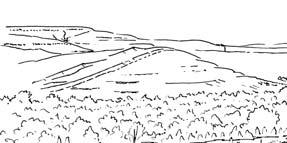
Kan 111 Ast spA
Heidiphyllum thicket
Kan 112 Hei elo
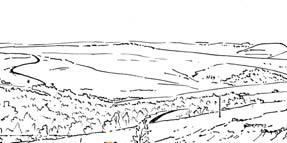
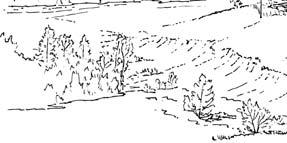
16
Insectsindivs

Fig. 6. Kannaskop (Kan 112 Hei elo), Upper End.
Habitat: Heidiphyllum thicket
Collection: 145 slabs, 15 man-hrs cleaving; impressions in very thinly bedded, moderately baked, medium-grey shale with poor cleavage.
Dominants: Heidiphyllum 98%
Biodiversity: vegetative total, 13 spp
Non-gymnosperms: 4 spp
Gymnosperms: 9 spp
Petriellaceae:
Rochipteris 5 spp (19 indivs)
Ref. pal.
“ telefolia (2 indivs) Tel 111 Hei elo
“ distivena (4 indivs)*
“ rollerii (10 indivs)
“ penensis (2 indivs)
“ pusilla (1 indiv.)
Kan 112 Hei elo
Aas 111 Hei elo
Pen 411 Hei elo
Pen 311 Hei elo
Kannaskoppianthus irregularis (5 indivs)* Kan 112 Hei elo – microsporangia (1 indiv.)
*Affilation (grade 3)
R. distivena/K. irregularis
Taphonomy
*K. distivena – parautochthonous other 4 spp – allochthonous
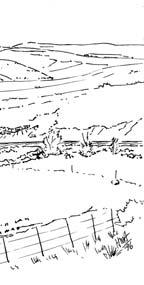
1 per 7.5 man-hrs (v. rare)
Coleoptera (beetles) – 2 2
Plant–insect interaction
• leaf-margin feeding –
• leaf-tip feeding –
• piercing & sucking –
• leaf mining – .
• oviposition – .
HMA, 15 Aug 1996
From photo, 1 Sept 1993
Kan 112

PRE/F/20118
pl. 22(10)
×10
leaf-tip feeding, R. distivena
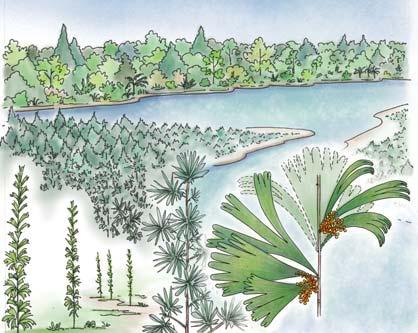
Heidiphyllum thicket; channel sandbar in braided-river system
Fern/Kannaskoppia meadow
Fig. 7. Kannaskop (Kan 111 Ast spA), Kannaskoppia Siltstone.
Habitat: Fern/Kannaskoppia meadow
Collection: 365 slabs, 30 man-hrs cleaving; impressions in thickly bedded, moderately baked, greenish grey, silty mudstone, with very poor cleavage.
Dominants: ferns 63%, horsetails 22%, Heidiphyllum 10%
Biodiversity: vegetative total, 7 spp
Non-gymnosperms: 4 spp
Gymnosperms: 3 spp
Petriellaceae:
Ref. pal.
Rochipteris vincularis 5%* Kan 111 Ast spA
Kannaskoppia vincularis (50 indivs)*
Attachment (grade 5 affiliation)
Kan 111 Ast spA
*Taphonomy – autochthonous R. vincularis/K. vincularis
– mutual attachment, 4 indivs (3 slabs)

Kan 111 Ast spA
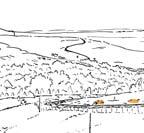

16
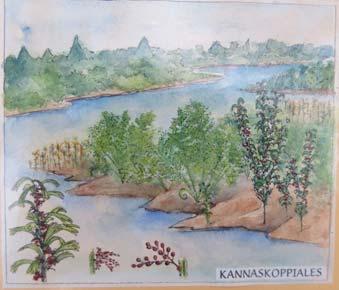
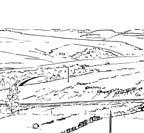

Insectsindivs

nil in 30 man-hrs
Blattodea (cockroaches)– 0
Coleoptera (beetles) et alii – 0 nil
Plant–insect interaction
• leaf-margin feeding –
• leaf-tip feeding –
• piercing & sucking –
• leaf mining – .
HMA, 15 Aug 1996


From photo, 1 Sept 1993
• oviposition – .

PRE/F/13505b
pl. 28(7)
×10
leaf-margin feeding, R. vincularis 12 cm
Kannaskoppia SAMPLING & OCCURRENCE 17 ISSN 2410-4418 Palaeont. afr. (2023) 57 (Special Issue): i–xiv + 1–324
27°56.9’E; 31°26.92’S
() ♂
27°56.9’E; 31°26.92’S
0
() ♀
BC
TC BC TC
b
Fern/Kannaskoppia meadow
b c
a c a
26°47.78’E; 31°02.86’S
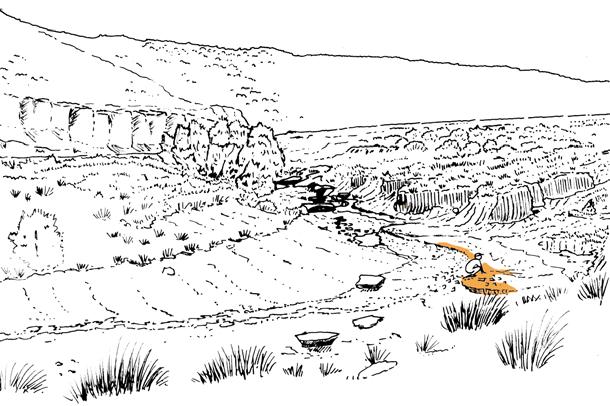
HMA,
From
Habitat: Heidiphyllum thicket; channel sandbar in braided-river system; Rochipteris telefolia, growing in patches near water’s edge.
Collection: 581 slabs, 90 man-hrs cleaving; impressions in thickly laminated, light olive-grey shale with poor cleavage.
Dominants: Heidiphyllum 89%, Dicroidium 6%, ferns 58 indivs
Biodiversity: vegetative total, 20 spp
Non-gymnosperms: 7 spp
Gymnosperms: 13 spp
Petriellaceae: Rochipteris 3 spp (33 indivs)
“ telefolia (30 indivs)*
“ penensis (2 indivs)**
“ pusilla (1 indiv.)
Ref. pal.
Tel 111 Hei elo
Pen 411 Hei elo
Pen 311 Hei elo
Kannaskoppianthus 2 spp (4 indivs) “ telemagnus (2 indivs)* Tel 111 Hei elo “ telepentatus (2 indivs)** Tel 111 Hei elo – microsporangia (1 indiv.)
** * () ♂ () ♂
Affiliation (grade 4); unique to Tel 111
Affiliation (grade 2–3)
*
Attachment
R. telefolia – att. to shoot (2 slabs) – cluster of 3 leaves (1 slab)
K. telemagnus – att. nil
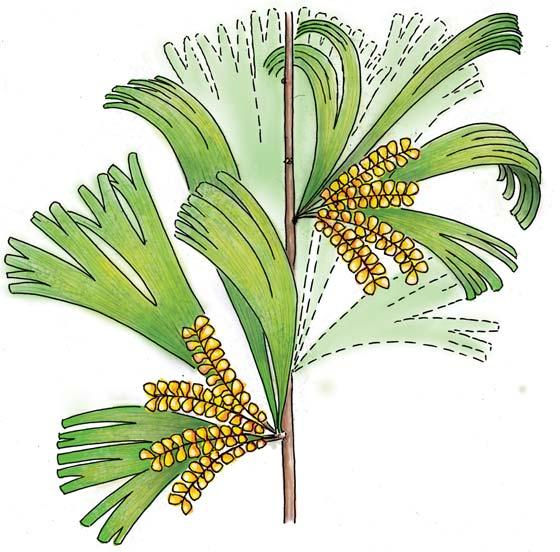

30,
Insectsindivs
c. 1 per 5 man-hrs (rare)
Odonata (dragonflies, damselflies)– 1 Blattodea (cockroaches)– 6 Homoptera (bugs)– 2 Mecoptera (scorpionflies)–1 Coleoptera (beetles) – 7 17
Plant–insect interaction
• leaf-margin feeding – .
• leaf-tip feeding –• piercing & sucking –
• leaf mining –• oviposition – .

PRE/F/17413
pl. 45(7)
×5
d

Tel 111

Kannaskoppia SAMPLING & OCCURRENCE 18 ISSN 2410-4418 Palaeont. afr. (2023) 57 (Special Issue): i–xiv + 1–324
28
2010
July
photo, 24
1982
111 Hei elo Heidiphyllum thicket
M5 M4 M3 M2 M1
April
Tel
32
32, 33
Kom 111
Tel 111 33 Vin 111
30
32
PRE/F/7711
×10
Fig. 8. Telemachus Spruit (Tel 111 Hei elo).
piercing & sucking, K. telemagnus
12 cm 0
leaf-tip feeding, R. telefolia
×12
pl. 41(6)
Kannaskoppianthus telemagnus/ Rochipteris telefolia
BC TC
TC Biocoenosis
Heidiphyllum thicket; channel sandbar in braided-river system; Rochipteris telefolia, growing in patches near water’s edge.
BC
(living comunity) Taphocoenosis (fossil deposit)
() ||
c a e
Taphonomy – *parautochthonous **parautochthonous – allochthonous other spp – allochthonous b
f
*
26°33.13’E; 31°03.35’S
Kom 111 Sph/Dic
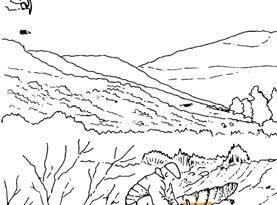

30
Dicroidium open woodland
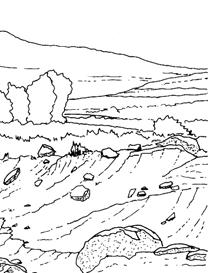
TC
Kom 111
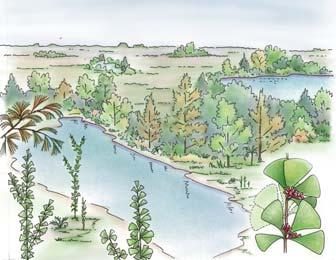
BC
Sphenobaiera woodland (lake in floodplain)
R. komifolia/ K. komanthus

Insectsindivs
1 per 5 man-hrs (rare)
HMA, 5 May 2019
From photo, MM, 10 Oct 1989
Fig. 9. Kommandantskop (Kom 111 Sph/Dic).
Habitat: Sphenobaiera woodland (lake in floodplain)
Collection: 168 slabs, 10 man-hrs cleaving; impressions in thickly laminated buff-grey shale with poor cleavage.
Dominants: Sphenobaiera 60%, Dicroidium 39%, ferns 1%
Biodiversity: vegetative total: 7 spp
Non-gymnosperms: 3 spp
Gymnosperms: 4 spp
Petriellaceae: Rochipteris 2 spp (30 indivs) Ref. pal.
“ switzifolia (1 indiv.) Lit 111 Dic/Hei “ komifolia (29 indivs)* Kom 111 Sph/Dic Kannaskoppianthus komanthus (2 indivs)* Kom 111 Sph/Dic – microsporangia (1 indiv.)
Attachment (affiliation grade 5)
K. komanthus/R. komifolia – mut.att. to shoot (2 slabs) – clusters (several slabs)
26°46.34’E; 30°56.41’S
Vin 111
Blattodea (cockroaches)– 1
Coleoptera (beetles) – 1 2
Plant–insect interaction
• leaf-margin feeding –
• leaf-tip feeding –
• piercing & sucking –
• leaf mining – .

×10
PRE/F/3236
pl. 50(4)
33
Taphonomy – parautochthonous – autochthonous allochthonous (K. switzifolia)
PRE/F/3216
pl. 49(3)
Dicroidium open woodland
Fig. 10. Vineyard (Vin 111 Dic odo), Homestead.
Habitat: Dicroidium open woodland
Collection: 166 slabs, 10 man-hrs cleaving; impressions in thinly laminated grey shale with good cleavage.
Dominants: Dicroidium 70%, Heidiphyllum 28%
Biodiverity: vegetative total, 10 spp
Non-gymnosperms: 2 spp
Gymnosperms: 8 spp
Petriellaceae: Ref. pal. Rochipteris vincularis (2 indivs) Kan 111 Ast spA
Taphonomy – allochthonous
HMA, 12 May 2019
From photo, 8 Feb 1970
piercing & sucking

×10
piercing & sucking, leaf-tip feeding
R. komifolia
Plant–insect interaction
• leaf-margin feeding –
• leaf-tip feeding –
• piercing & sucking – .
• leaf mining –
• oviposition – .
×20
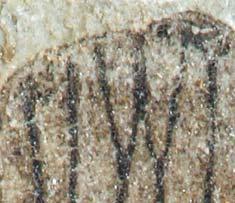
• oviposition – . BP/2/6046 ×10 12 cm 0
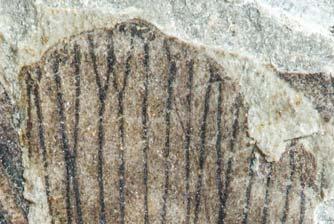
pl. 52(2,3)
R. vincularis
Kannaskoppia SAMPLING & OCCURRENCE 19 ISSN 2410-4418 Palaeont. afr. (2023) 57 (Special Issue): i–xiv + 1–324
& sucking leaf-tip & leaf-margin feeding
piercing
in 10 man-hrs
(cockroaches)– 0
(beetles) et alii – 0 nil
Insectsindivs nil
Blattodea
Coleoptera
() ♂
Dic odo d c b a c b a
26°56.84’E; 30°40.57’S
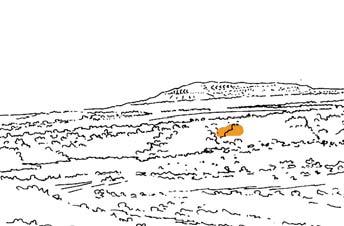
36
Lut 311
Heidiphyllum thicket

Lut 211
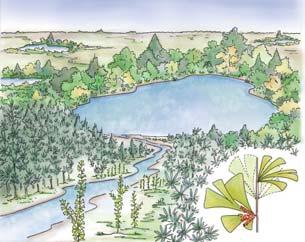
HMA, 8 May 2019
From photo, JMA,10 April 1990
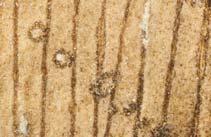
Habitat: Heidiphyllum thicket
Collection: 589 slabs, 50 man-hrs cleaving; impressions in thickly laminated, medium-grey shale with moderate cleavage.
Dominants: Heidiphyllum 99%
Biodiversity: vegetative total, 18 spp
Non-gymnosperms: 4 spp
Gymnosperms: 14 spp
Petriellaceae: Ref. pal. Rochipteris lutifolia (66 indivs)* Lut 311 Hei elo
Kannaskoppianthus lutinumerus (16 indivs)* Lut 311 Hei elo
Affiliation (grade 4; exclusive) Taphonomy – parautochthonous * () ♂
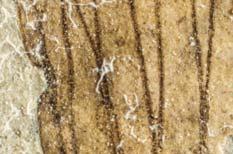
PRE/F/11355a ×10
leaf-margin feeding
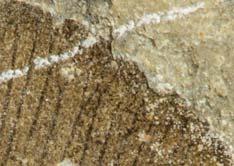
PRE/F/11378 ×10 leaf-tip feeding

PRE/F/11384 ×5
Insectsindivs
c. 1 per 2 man-hrs (rare)
Paraplecoptera (extinct)– 2 Blattodea (cockroaches)– 6
Mantodea (mantids)–4
Orthoptera (crickets et alii) – 2
Homoptera (bugs)– 1
Mecoptera (scorpionflies)– 1
Coleoptera (beetles) – 2 18
Plant–insect interaction
• leaf-margin feeding –
• leaf-tip feeding –
• piercing & sucking –
• leaf mining – .
• oviposition – . 12 cm 0
Fern/Kannaskoppia meadow
28°00.87’E; 31°29.32’S
Habitat: Fern/Kannaskoppia meadow
Collection: 393 slabs, 14 man-hrs cleaving; impressions in massive light-grey shale with poor cleavage.
Dominants: ferns 52%, horsetails 20%
Biodiversity: Vegetative total: 11 spp
Non-gymnosperms: 6 spp
Gymnosperms: 5 spp
Petriellaceae: Ref. pal.
Rochipteris rollerii (5 indivs) Aas 111 Hei elo
Taphonomy – allochthonous

HMA, 17 Nov 2019
From photo, 30 Jan 1972
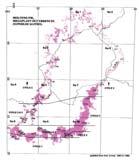

Insectsindivs
nil in 14 man-hrs
Blattodea (cockroaches)– 0
Coleoptera (beetles) et alii – 0 nil
Plant–insect interaction
• leaf-margin feeding –
• leaf-tip feeding –
• piercing & sucking – .
• leaf mining – .
• oviposition – .

PRE/F/10303a
Kannaskoppia SAMPLING & OCCURRENCE 20 ISSN 2410-4418 Palaeont. afr. (2023) 57 (Special Issue): i–xiv + 1–324
R. rollerii (both photos)
Fig. 12. Koningskroon (Kon 211 Ast 2spp), Rooipoort Donga.
M5 M4 M3 M2 M1
15
311,
14
36 14,
14 Kon 211 15 Pen
411
36 Lut 311
Fig. 11. Lutherskop (Lut 311 Hei elo), Oom Piet’s campsite.
×10 piercing & sucking leaf-tip feeding
×10
PRE/F/10303a ×5
BC
Lut 311
TC pl. 67(5) pl. 67(4)
pl. 68(8)
pl. 62(4)
70(9)
f e d c b a d c a b
R. lutifolia (all photos) pl.
70(2) pl.
Heidiphyllum thicket, marsh in floodplain
Heidiphyllum thicket
27°56.84’E; 31°29.59’S
Pen 311
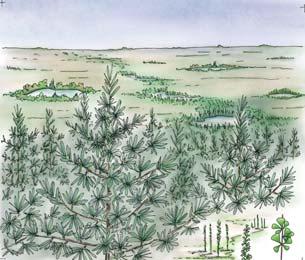
HMA, 12 May 2019
From photo, June 1992
Habitat: Heidiphyllum thicket
Collection: 155 slabs, 35 man-hrs cleaving; impressions in thinly laminated buff shale.
Dominants: Heidiphyllum 75%, Dicroidium 25%
Biodiversity: vegetative total: 11 spp
Non-gymnosperms: 5 spp
Gymnosperms: 6 spp
Petriellaceae: Rochipteris 3 spp (41 indivs) Ref. pal.
“ rollerii (34 indivs) Aas 111 Hei elo “ penensis (5 indivs) Pen 411 Hei elo “ pusilla (2 indivs) Pen 311 Hei elo
Taphonomy – R. rollerii, parautochthonous – other 2 spp, allochthonous
Insectsindivs
1 per 5 man-hrs (rare)
Plant–insect interaction
• leaf-margin feeding – .
• leaf-tip feeding –
• piercing & sucking – .
• leaf mining – .
• oviposition – .
Heidiphyllum thicket
27°56.78’E; 31°30.35’S
×10

PRE/F/18170a
leaf-tip feeding
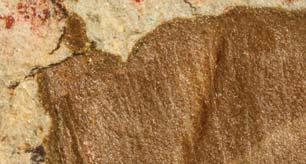
PRE/F/18167a

Habitat: Heidiphyllum thicket
Collection: 204 slabs, 70 man-hrs cleaving; impressions in thickly laminated, greenish grey shale, moderate cleavage.
Dominants: Heidiphyllum 94%, ferns 3%, horsetails 2%
Biodiversity: vegetative total: 11 spp
Non-gymnosperms: 6 spp
Gymnosperms: 5 spp
Petriellaceae: Rochipteris 2 spp (80 indivs) Ref. pal.
“ rollerii (70 indivs)* Aas 111 Hei elo
“ penensis (10 indivs) Pen 411 Hei elo
Kannaskoppianthus aasvoelensis (4 indivs)* Aas 111 Hei elo
* () ♂
Affiliation (as for the 4 Aasvoëlberg TCs)
Taphonomy – R. rollerii, parautochthonous – other spp, parautochthonous – allochthonous
Pen 411 Hei elo
HMA, 2010
From photo, 13 Aug 1996

c. 1 per 10 man-hrs (v. rare)
×10
Insectsindivs
Plecoptera (stoneflies)– 1
Blattodea (cockroaches)– 3
Mantodea (mantids)–2
Homoptera (bugs)– 1
Coleoptera (beetles) – 1 8
Plant–insect interaction
• leaf-margin feeding – .
• leaf-tip feeding –
• piercing & sucking – .
• leaf mining – .
• oviposition – .
Blattodea (cockroaches)– 4 Coleoptera (beetles) – 3 7 ×20
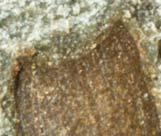
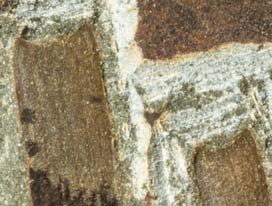
PRE/F/17978b
×10
leaf-tip feeding, R. rollerii
Kannaskoppia SAMPLING & OCCURRENCE 21 ISSN 2410-4418 Palaeont. afr. (2023) 57 (Special Issue): i–xiv + 1–324
R. penensis (both photos)
Fig. 13. Peninsula (Pen 311 Hei elo), Campsite Quarry.
15
Fig. 14. Peninsula (Pen 411 Hei elo), Lunchspot. spot.
12
cm 0
Pen 411
15
BC TC
BC TC
pl. 77(4) pl. 77(13) pl. 82(2) pl. 82(3)
d c b a c d b a
Heidiphyllum thicket, marsh in floodplain Heidiphyllum thicket, marsh in floodplain
Dicroidium riparian forest (type 2)
26°29.63’E; 31°05.81’S
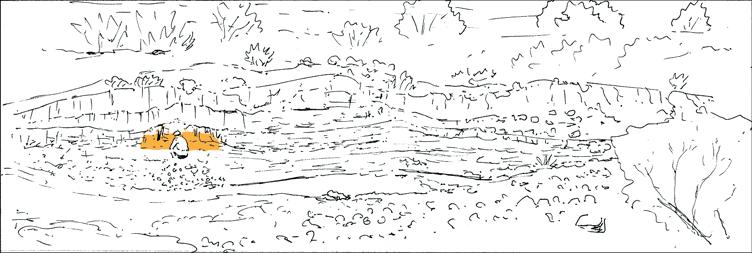
29
Habitat: Dicroidium riparian forest (immature, type 2)
Collection: 1310 slabs, 65 man-hrs cleaving; impressions in thinly laminated, moderately baked medium dark grey shale, moderate cleavage
Dominants: Dicroidium 50%, horsetails 10%, Heidiphyllum 25 indivs
Biodiversity: Vegetative total: 19 spp
Non-gymnosperms: 5 spp
Gymnosperms: 14 spp
Petriellaceae: Ref. pal.
Rochipteris rollerii (6 indivs) Aas 111 Hei elo
Taphonomy – allochthonous
26°54.28’E; 30°31.44’S


37
Habitat: Dicroidium open woodland
Kap 111 Dic/Ris
HMA, 9 April 1996
From photo, 19 Feb 1992
Insectsindivs
c. 3 per 1 man-hr (not rare)
Meganisoptera (protodrag.)– 3
Odonata (dragonflies)– 8
Paraplecoptera (extinct)–4
Plecoptera (stoneflies)– 1
Blattodea (cockroaches)– 61
Mantodea (mantids)–3
Orthoptera (crickets et alii) –5
Homoptera (bugs)– 12
Mecoptera (scorpionflies)–6
Coleoptera (beetles)– 61
Incertae – 14 178
Plant–insect interaction
• leaf-margin feeding –
• leaf-tip feeding –
• piercing & sucking – .
• leaf mining – .
• oviposition – .
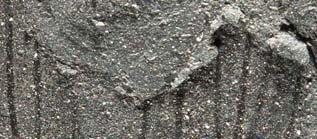
PRE/F/16173
Dicroidium open woodland


Nuw 111
Equ sp
Nuw 111 Dic zub
HMA, 28 July 2010 HMA, 28 2010
From photo, 22 Feb 1972
Collection: 138 slabs, 21 man-hrs cleaving; impressions in thinly laminated grey shale with moderate cleavage.
Dominants: Dicroidium 70%, Sphenobaiera 30%
Biodiversity: vegetative total, 9 spp
Non-gymnosperms: 1 spp
Gymnosperms: 8 spp
Petriellaceae: Ref. pal.
Rochipteris lutifolia (3 indivs) Lut 311 Hei elo
Taphonomy – allochthonous
Insectsindivs
c. 1 per 4 man-hrs (rare)
Blattodea (cockroaches)– 1
Orthoptera (crickets et alii) –2
Coleoptera (beetles)– 1
Incertae – 1 5
Plant–insect interaction
• leaf-margin feeding –
• leaf-tip feeding –
• piercing & sucking – .
• leaf mining – .
• oviposition – .


Kannaskoppia SAMPLING & OCCURRENCE 22 ISSN 2410-4418 Palaeont. afr. (2023) 57 (Special Issue): i–xiv + 1–324
Fig. 15. Kapokkraal (Kap 111 Dic/Ris).
Fig. 16. Nuwejaarspruit (Nuw 111 Dic zub), Clara’s Ditch.
×10
leaf-tip feeding, R. rollerii
×10
leaf-margin feeding ×2
leaf-tip feeding 12 cm 0
BP/2/6725
pl. 89(8) pl. 91(5)
pl. 91(7)
c a b a b
R. lutifolia (both photos)
Heidiphyllum thicket
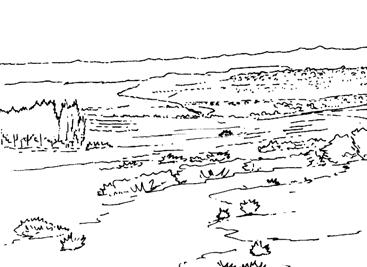

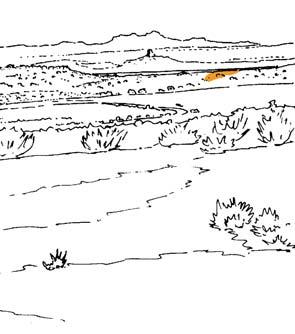
From photo, 27 Dec 1971
5 Hla 213
29 Kap 111
37 Nuw 111
38 Win 111
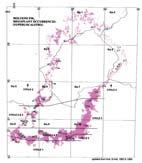
5 37, 38 29
M5 M4 M3 M2 M1
Insectsindivs
1 per 5 man-hrs (rare)
Blattodea (cockroaches)– 1 Homoptera (bugs)–1 Hymenoptera (wasps, bees, ants)–1
Coleoptera (beetles) – 1 4
Plant–insect interaction
• leaf-margin feeding –
• leaf-tip feeding –
• piercing & sucking –
• leaf mining –
• oviposition – .
Habitat: Heidiphyllum thicket
Collection: 64 slabs; 20 man-hrs cleaving; impressions in thickly laminated grey shale with poor cleavage.
Dominants: Heidiphyllum 79%, Dicroidium 10%
Biodiverity: vegetative total, 11 spp
Non-gymnosperms: 5 spp
Gymnosperms: 6 spp
Petriellaceae: Rochipteris 3 spp (5 indivs) Ref. pal
“ rollerii (3 indivs) Aas 111 Hei elo
“ lutifolia (1 indiv.) Lut 311 Hei elo “ cf. sinuosa (1 indiv.) Umk 111 Dic 2 spp
Taphonomy – allochthonous (all 3 spp)

Dicroidium riparian forest (type 2)
Insectsindivs
c. 1 per 1 man-hr (rare)
Meganisoptera (protodragonflies)–1
Odonata (dragonflies, damselflies)– 5
Paraplecoptera (extinct)– 2
Blattodea (cockroaches)– 10
Homoptera (bugs)– 6
Glosselytrodea (extinct)– 1
Mecoptera (scorpionflies)– 1
Coleoptera (beetles)– 18
Incertae – 8 52
Plant–insect interaction
• leaf-margin feeding –
• leaf-tip feeding –
• piercing & sucking –
• leaf mining – .
• oviposition – .

Habitat: Dicroidium riparian forest (immature, type 2)
Collection: 902 slabs, 60 man-hrs cleaving; compression in thinly laminated, carbonaceous (poor cuticle), medium dark-grey shale with good cleavage.
Dominants: Dicroidium 89%, Heidiphyllum 1%
Biodiversity: vegetative total, 42 spp
Non-gymnosperms: 15 spp
Gymnosperms: 27 spp
Petriellaceae: Rochipteris 3 spp (8 indivs) Ref. pal.
“ rollerii (4 indivs) Aas 111 He elo
“ switzifolia (4 indivs) Lit 111 Dic/Hei
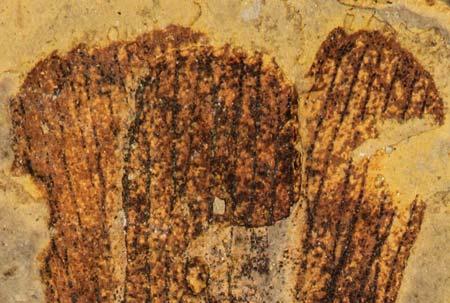
Kannaskoppia SAMPLING & OCCURRENCE 23 ISSN 2410-4418
(2023)
(Special
i–xiv +
Palaeont. afr.
57
Issue):
1–324
Fig. 17. Winnaarspruit (Win 111 Hei elo).
Fig. 18. Hlatimbe (Hla 213 Dic elo), Batiopteris Corner.
5
HMA, May 2019
From photo, 29 July 1982
29°31.47’E; 29°29.13’S
38
HMA, 8 May 2019
27°05.75’E; 30°28.65’S
BP/2/6956
×20 leaf-mining, R. lutifolia
12 cm 0
piercing & sucking; leaf-tip & leaf-margin feeding
PRE/F/8745
×10
pl. 93(6) pl. 95(6)
R. rollerii
a c a b b
Taphonomy – allochthonous (all 3 spp)
Dicroidium riparian forest (type 1)
Umk 111 Dic 2spp
6

Habitat: Dicroidium riparian forest (mature, type 1)
HMA, 9 April 1996
From photo, 24 Jan 1979
Collection: 3592 slabs, 400 man-hrs cleaving; compressions in thinly laminated, carbonaceous (cuticle), moderately baked, dark-grey shale with good cleavage.
Dominants: Dicroidium 69%, Heidiphyllum 7%, Sphenobaiera 5%
Biodiversity: vegetative total, 75 spp
Non-gymnosperms: 29 spp
Gymnosperms: 46 spp
Petriellaceae: Rochipteris 4 spp (50 indivs)
Ref. pal.
“ rollerii (21 indivs) Aas 111 Hei elo
“ lutifolia (1 indiv.) Lut 311 Hei elo
“ obtriangulata (19 indivs) Umk 111 Dic spp
“ cf. sinuosa (9 indivs) Umk 111 Dic 2 spp
Taphonomy – parautochthonous (R. rollerii & R. lutifolia)
– allochthonous (R. cf. sinuosa)
– parautochthonous-allochthonous (R. obtriangulata)
Insectsindivs
c. 1 per 2 man-hrs (rare)
Odonata (dragonflies, damselflies)– 1
Plecoptera (stoneflies)–2
Blattodea (cockroaches)– 80
Orthoptera (crickets et alii) –1
Homoptera (bugs)– 12
Megaloptera (alderflies)–1
Coleoptera (beetles)– 63
Incertae – 6
Plant–insect interaction
• leaf-margin feeding –
• leaf-tip feeding –
• piercing & sucking – .
• leaf mining –
• oviposition –
R. obtriangulata (both photos)
166
PRE/F/422
×10

pl. 103(3)
leaf-margin feeding

pl. 106(1)
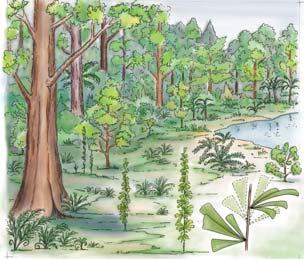
BC
Dicroidium riparian forest (type 2)
Habitat: Dicroidium riparian forest (immature, type 2)
Insectsindivs
nil in 30 man-hrs
Blattodea (cockroaches)– 0
Coleoptera (beetles) et alii – 0 nil
Plant–insect interaction
• leaf-margin feeding –
• leaf-tip feeding –
• piercing & sucking – .
• leaf mining – .
• oviposition – .
HMA, May 2019
From photo, 27 Sept 1971
Collection: 303 slabs, 30 man-hrs cleaving; compressions in thinly laminated, carbonaceous, dark-grey shale with moderate cleavage.
Dominants: Dicroidium 90%, Heidiphyllum 5%
Biodiversity: vegetative total, 19 spp
Non-gymnosperms: 3 spp
Gymnosperms: 16 spp
Petriellaceae: Rochipteris 2 spp (3 indivs) Ref. pal.
“ rollerii (2 indivs) Aas 111 Hei elo
“ switzifolia (1 indiv.) Lit 111 Dic/Hei
Taphonomy – allochthonous (both spp)
TC

1
6
7
10

pl. 111(7)
pl. 112(3)

leaf-margin feeding
12 cm 0
Kannaskoppia SAMPLING & OCCURRENCE 24 ISSN 2410-4418 Palaeont. afr. (2023) 57 (Special Issue): i–xiv + 1–324
Umk 111
Fig. 19. Umkomaas (Umk 111 Dic 2spp), Waterfall Locality.
Fig. 20. Sani Pass (San 111 Dic cra).
M5 M4 M3 M2 M1 1 6, 7 10
Lit 111
Umk 111
San 111
Mat 111
29°27.3’E; 29°33.54’S
29°24.62’E; 29°37.73’S
leaf mining PRE/F/9832
×5
7
×5 BP/2/2528 ×5 BP/2/2527
R. rollerii (both photos)
Dicroidium riparian forest (mature, type 1) c
d b
a d c a b
Dicroidium riparian forest (type 2)
28°48.34’E; 30°20.84’S

10
HMA, May 2019
From photo, 31 July 1982
29°02.87’E; 28°34.54’S

1
Insectsindivs
c. 1 per 2 man-hrs (rare)
Mat 111
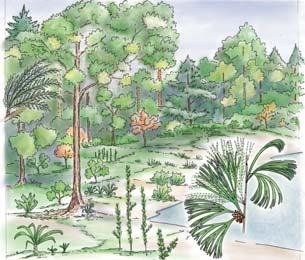
Fig. 21. Matatiele (Mat 111 Dic dub).
Habitat: Dicroidium riparian forest (immature, type 2)
Odonata (dragonflies, damselflies)– 5
Plecoptera (stoneflies)–2
Blattodea (cockroaches)– 16
Orthoptera (crickets et alii) –2
Neuroptera (lacewings, antlions)–2
Coleoptera (beetles)– 3
Incertae – 1 31
Plant–insect interaction
• leaf-margin feeding – .
• leaf-tip feeding –
• piercing & sucking – .
• leaf mining – .
• oviposition – .
Collection: 1082 slabs, 65 man-hrs cleaving; impressions in thickly laminated, olive-grey shale with moderate cleavage.
Dominants: Dicroidium 89%, Heidiphyllum 4%
Biodiversity: Vegetative total: 28 spp
Non-gymnosperms: 10 spp
Gymnosperms: 18 spp
Petriellaceae: Rochipteris 2 spp, 2% Ref. pal. “ telefolia, 2% Tel 111 Hei elo “ matatifolia (17 indivs)* Mat 111 Dic dub
Kannaskoppianthus matatiparvus (3 indivs)* Mat 111 Dic odo
Affiliation (grade 3)
Taphonomy – parautochthonous – allochthonous (R. matatifolia)
Dicroidium riparian forest (type 1)
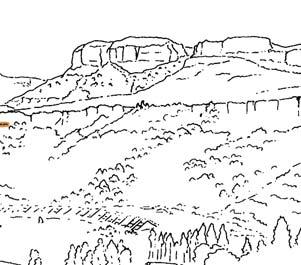
HMA, May 2019

From photo, Aug 2001
Fig. 22. Little Switzerland (Lit 111 Dic/Hei).
Habitat: Dicroidium riparian forest (mature, type 1)
Collection: 2173 slabs, 550 man-hrs cleaving; compressions in thinly laminated, carbonaceous (cuticle), dark-grey shale with moderate cleavage.
Dominants: Dicroidium 50%, Heidiphyllum 23%, Sphenobaiera 1%
Biodiversity: vegetative total: 38 spp
Non-gymnosperms: 6 spp
Gymnosperms: 32 spp
Petriellaceae: Rochipteris 2 spp (56 indivs)
Ref. pal. “ vincularis (1 indiv.) Kan 111 Ast spA
“ switzifolia (55 indivs)* Lit 111 Dic/Hei Kannaskoppianthus switzianthus (9 indivs)* Lit 111 Dic/Hei – microsporangia (2 indivs)
* () ♂ Affiliation (grade 3) (no attachments or clusters)
PRE/F/9068a
leaf-tip feeding
×10


PRE/F/9067 ×5

Insectsindivs
1 per 5 man-hrs (rare)
Paraplecoptera (extinct)–1
Blattodea (cockroaches)– 86
Homoptera (bugs)–4
Mecoptera (scorpionflies)–1
Coleoptera (beetles)– 33
Incertae – 4 129
Plant–insect interaction
• leaf-margin feeding – .
• leaf-tip feeding –
• piercing & sucking – .
• leaf mining – .
• oviposition – .
BP/2/1562
R. telefolia (both photos) pl. 123(10)
×10
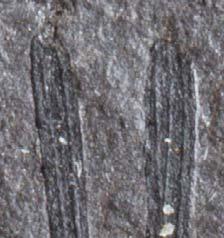
Kannaskoppia SAMPLING & OCCURRENCE 25 ISSN 2410-4418 Palaeont. afr. (2023) 57 (Special Issue): i–xiv + 1–324
*
() ♂
leaf-tip feeding, R. switzifolia
12
0
cm
Lit 111 BC TC BC TC [not on plates] pl. 118(5)
Dicroidium riparian forest (immature, type 2)
Dicroidium riparian forest (mature, type 1)
d c b a b a c
Taphonomy – parautochthonous – allochthonous (R. vincularis)
*
26°16.47’E; 31°33.81’S
Heidiphyllum thicket
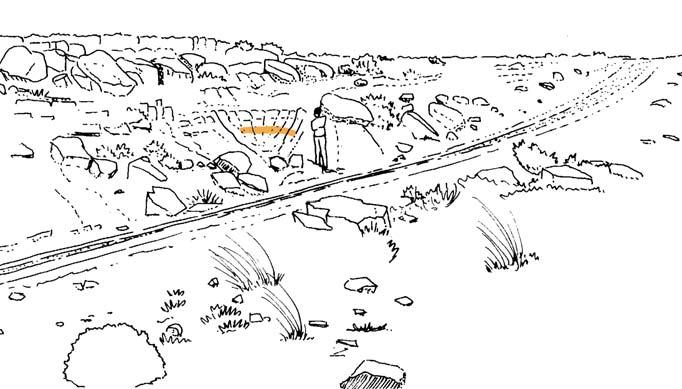
Fig. 23. Aasvoëlberg (Aas 111 Hei elo), Turner Shale.
Habitat: Heidiphyllum thicket
Collection: 291 slabs; 40 man-hrs cleaving; impressions in thickly laminated, light-grey shale with moderate cleavage.
Dominants: Heidiphyllum 77%, ferns 20%
Biodiverity: vegetative total, 13 spp
Non-gymnosperms: 7 spp
Gymnosperms: 6 spp
Petriellaceae: Ref. pal. Rochipteris rollerii, 2%* Aas 111 Hei elo (c. 50 slabs, incl. several clusters)
Kannaskoppianthus aasvoelensis (21 indivs)* Aas 111 Hei elo – microsporangia (5 indivs)
HMA, May 2019
From photo, 4 June 1971

24
M5 M4 M3 M2 M1
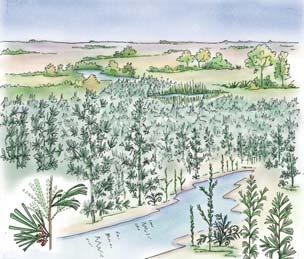
BC
Heidiphyllum thicket, marsh in floodplain
R. rollerii
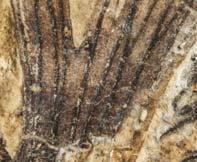
PRE/F/4307 ×5
PRE/F/15227
×5
()
♂
Affiliation (grade 4)
24 Aas 111, 211, “ 311, 411
Heidiphyllum thicket
26°13.94’E; 31°33.35’S

Fig. 24. Aasvoëlberg (Aas 211 Hei elo), Proppie Shale.
Habitat: Heidiphyllum thicket
Collection: 154 slabs; 35 man-hrs cleaving; impressions in thickly laminated light-grey shale with moderate cleavage.
Dominants: Heidiphyllum 99%,
Biodiverity: vegetative total, 7 spp
Non-gymnosperms: 3 spp
Gymnosperms: 4 spp
Petriellaceae: Rochipteris 2 spp (19 indivs) Ref. pal. “ vincularis (1 indiv.) Kan 111 Ast spA “ rollerii (18 indivs)* Aas 111 Hei elo
Kannaskoppianthus aasvoelensis (1 indiv.)* Aas 111 Hei elo
() ♂
Affiliation (grade 4)
– parautochthonous – allochthonous (K. vincularis)
Aas 111 piercing & sucking
TC pl. 134(3)pl. 139(3)
c. 1 per 1 man-hr (rare)
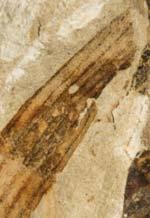
Insectsindivs
Odonata (dragonflies, damselflies)– 1 Blattodea (cockroaches)– 17
Homoptera (bugs)– 33
Coleoptera (beetles)– 8 Incertae – 1
60
Plant–insect interaction
• leaf-margin feeding –
• leaf-tip feeding –
• piercing & sucking –
• leaf mining – .
• oviposition – .
×5
pl. 144(3)
PRE/F/15278 24
JMA, 17 Nov 2019
From photo, 27 March 1989
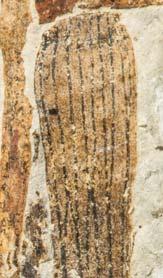
piercing & sucking
e d c a a c b b

PRE/F/15278
Insectsindivs
c. 2 per 1 man-hr (rare) Odonata (dragonflies, damselflies)– 2 Blattodea (cockroaches)– 44 Mantodea (mantids)– 1 Homoptera (bugs)– 1 Neuroptera (lacewings, antlions)– 1 Coleoptera (beetles)– 6 Incertae – 1 56
×10
pl. 144(5) R. rollerii
Plant–insect interaction
• leaf-margin feeding –
• leaf-tip feeding –
• piercing & sucking –
• leaf mining – .
• oviposition – .
12 cm 0
Kannaskoppia SAMPLING & OCCURRENCE 26 ISSN 2410-4418 Palaeont. afr. (2023) 57 (Special Issue): i–xiv + 1–324
Taphonomy – parautochthonous 6 clusters (1 of 6 indivs & c. 15 fragments) (1 of 5 indivs; 4 of 2–3 indivs) *
24
Taphonomy
26°13.3’E; 31°32.20’S
Heidiphyllum thicket

24
Habitat: Heidiphyllum thicket
Collection: 528 slabs; 140 man-hrs cleaving; impresssions in thickly laminated, light-grey shale with moderate cleavage.
Dominants: Heidiphyllum 99%
Biodiverity: vegetative total, 11 spp
Non-gymnosperms: 4 spp
Gymnosperms: 7 spp
Petriellaceae: Rochipteris 2 spp (26 indivs) Ref. pal. “ vincularis (1 indiv.) Kan 111 Ast spA “ rollerii (25 indivs)* Aas 111 Hei elo
Kannaskoppianthus aasvoelensis (4 indivs)* Aas 111 Hei elo
HMA, May 2019
From photo, 27 March 1989

PRE/F/19020b
×10
Insectsindivs
c. 1 per 1 man-hr (rare)
Odonata (dragonflies, damselflies)– 2
Paraplecoptera (extinct)– 3
Blattodea (cockroaches)– 77
Mantodea (mantids)– 5
Orthoptera (crickets et alii) –3
Homoptera (bugs)– 20
Mecoptera (scorpionflies)– 4
Coleoptera (beetles)– 23
Incertae – 9
146
Plant–insect interaction
• leaf-margin feeding – .
• leaf-tip feeding –
• piercing & sucking – .
• leaf mining –
• oviposition – .

PRE/F/11993
×20
*
Affiliation (grade 4)
×10 ()
Taphonomy – parautochthonous – allochthonous (K. vincularis)
26°12.16’E; 31°33.43’S
leaf mining

Sphenobaiera closed woodland

24
Habitat: Sphenobairea closed woodland
Collection: 2176 slabs, 512 man-hrs cleaving; impressions in thinly laminated, strongly baked yellowish grey shale, very good cleavage.
Dominants: Dicroidium 60%, Sphenobaiera 30%, Heidiphyllum 1%
Biodiverity: vegetative total, 30 spp
Non-gymnosperms: 8 spp
Gymnosperms: 22 spp
Petriellaceae: Ref. pal.
Rochipteris rollerii (150 indivs)* Aas 111 Hei elo
Kannaskoppianthus aasvoelensis (21 indivs)* Aas 111 Hei elo – microsporangia (4 indivs)
* () ♂
Affiliation (grade 4)
Taphonomy – parautochthonous
HMA, 6 Aug 1996
From photo, 11 March 1995

pl. 150(7)pl. 150(7)
PRE/F/12103a ×10
R. rollerii (all photos)
Insectsindivs
c. 1 per 4 man-hrs (rare)
Meganisoptera (protodragonflies)– 7 Odonata (dragonflies, damselflies)– 8
Paraplecoptera (extinct)–3
Blattodea (cockroaches)– 54
Mantodea (mantids)–2
Orthoptera (crickets et alii) –4
Homoptera (bugs)–9
Glosselytrodea (extinct)–1
Neuroptera (lacewings, antlions)–4
Mecoptera (scorpionflies)–1
Trichoptera (caddisflies)–1
Lepidoptera (butterflies)–2
Coleoptera (beetles)– 28
Incertae – 5 129
Plant–insect interaction
• leaf-margin feeding –
• leaf-tip feeding –
• piercing & sucking – .
• leaf mining – .
• oviposition –

160(4)
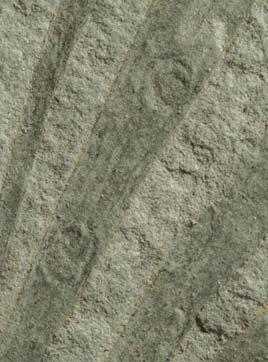
PRE/F/21062
R. rollerii
leaf mining oviposition
×5
Kannaskoppia SAMPLING & OCCURRENCE 27 ISSN 2410-4418 Palaeont. afr. (2023) 57 (Special Issue): i–xiv + 1–324
Fig. 25. Aasvoëlberg (Aas 311 Hei elo), Easter-egg Sh.
♂
Fig. 26. Aasvoëlberg (Aas 411 Dic/Sph), Fredlindia Slate.
12
0
×20
cm
pl. 151(3)
pl. 151(2)
pl.
pl. 161(6)
d c b a e c b a





 Kannaskoppia
Kannaskoppia
all
Kan 112Aas 111 Lit 111Mat 111Kom 111Lut 311 all ×1 1 2 cm 0 Lut 311 Tel 111 Kan 111 Kan 112 Mat 111 Lit 111 28 ISSN 2410-4418 Palaeont. afr. (2023) 57 (Special Issue): i–xiv + 1–324
Kannaskoppianthus
×2



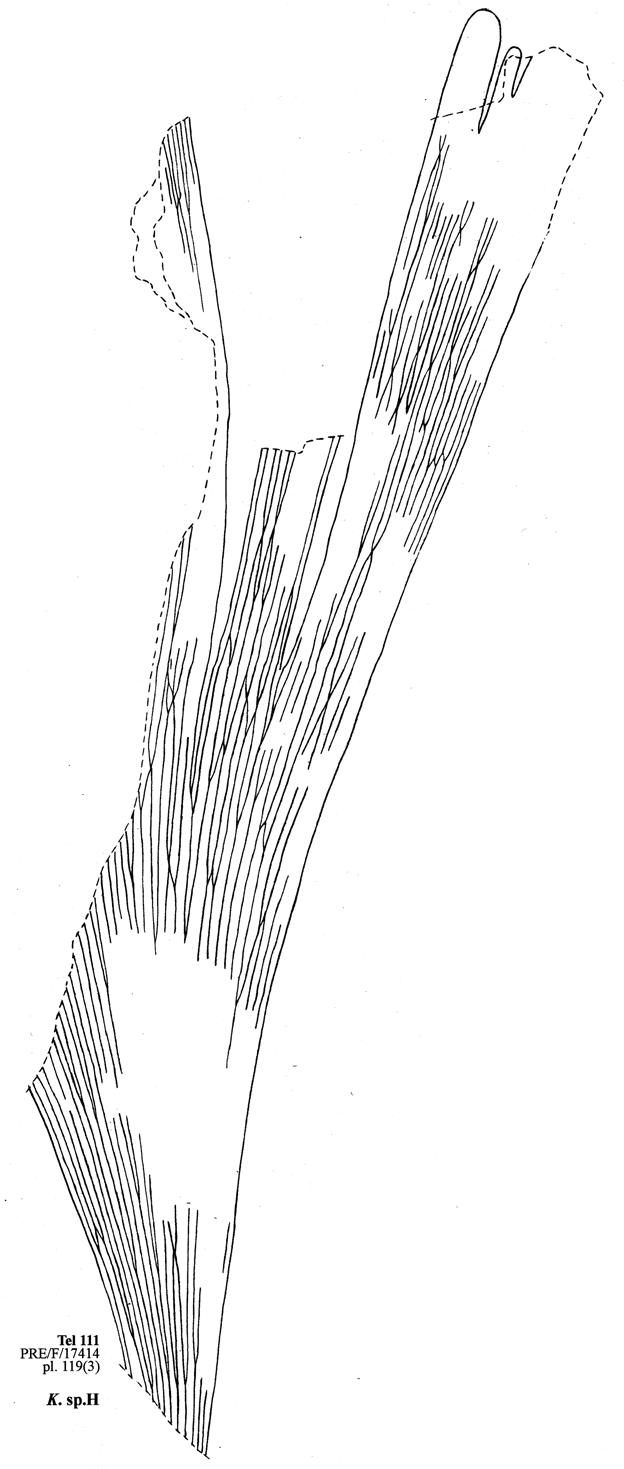
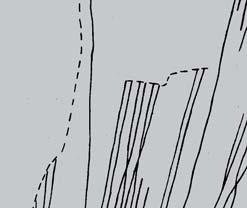





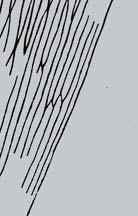
artPa
Part 2


tematics
ystematics








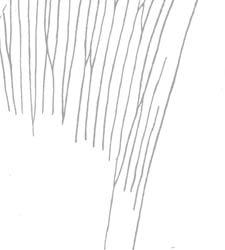

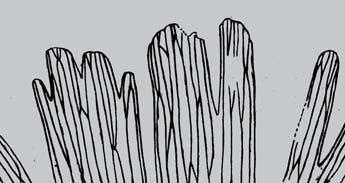

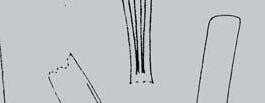


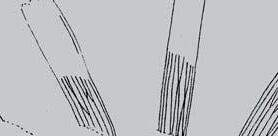






Here are provided formal descriptions of the female and male strobili and of the foliage taxa of the family Petriellaceae found within the Molteno Fm. This involves just a single species of Kannaskoppia (the ovulate strobilus), seven species of Kannaskoppianthus (the microsporangiate strobilus), and 12 species of Rochipteris (the accompanying foliage).
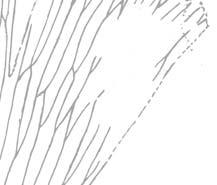



Though the affiliation of fertile and foliage species is key to this study, the three genera and their species are dealt with as separate taxonomic entities in this chapter. In the following section (Part 3), the species are linked into natural taxa –whole-plant species – as best as the data allow.
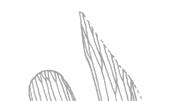





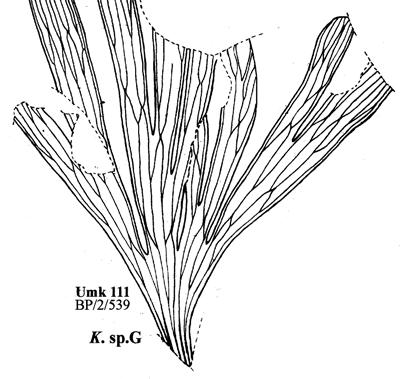
Chart 1. TAXONOMIC APPROACH.
Recognizing taxa in fossil floras
In describing the fossil flora of the Molteno, our approach has revolved around comprehensive sampling through the formation (geographic, stratigraphic and ecological); and the recognition of varying populations (palaeodemes) of specimens from the different assemblages (taphocoenoses), see p. 66 and glossary p. 320 (And & And., 1983, 1989, 2003).
Consider the two very different gymnosperm foliage genera, Dicroidium and Rochipteris, and their affiliates, as sampled in the
Dicroidium (Molteno)
Habit & habitat: large shrubs to trees, dominant in riparian forest, and lakeside or open floodplain woodland
Frequency: 75 (of 100) assemblages (TCs)
Abundance: >50% of assemblage (46 TCs); 25–49% of assemblage (6 TCs); 1–24% of assemblage (13 TCs)
Dominance: sole-dominant in 36 TCs; co-dominant in 18 TCs (25% or more of assemblage)
Diversity: 19 foliage species
Taphonomy: parautochthonous to mostly allochthonous
Attachment: no accepted cases yet found of Umkomasia or Pteruchus attached to leafy shoots
Dicroidium (foliage) – 75 (of 100) assemblages; 19 spp
Umkomasia (female) – 22 (of 100) assemblages; 503 indivs; 8 spp
Pteruchus (male) – 22 (of 100) assemblages; 425 indivs; 3 spp
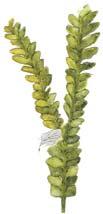
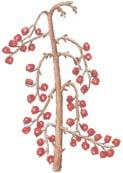

Evolution in the lifespan of a single tree
As the life sciences progress, as the breadth of research spreads and the number of papers increases, so evolution and variation are found to be ever more dynamic and complex. Consider key findings of a recent article on the Sitka spruce. Here paraphrased:
Picea sitchenensis (Sitka spruce) – to over 500 years old, and over 70 m (230 ft) in height.
• Modular organisms: plants (as opposed to animals) “grow by producing multiple copies of discrete units”.
• Mutations and genetic diversity in a single tree are common: to “100,000 genetic differences” from the base to the canopy of a single tree.
• Many mutations will be “either neutral or potentially harmful”, but others advantageous in a changing environment over 500 years.
• The “reproductive cells of trees develop from somatic cells” –“the same cells that form stems”
• Thus mutations in the stem “can be passed on” to the seeds in cones.
Such information adds another dimension to the molecular definition of plant species and the expression in the phenotype. With fossils (even abundant ones such as Dicroidium) one is restricted to rather artificial definitions of species based on morphology and associated evidence.
Molteno (tabled below). Though both are ubiquitous and diverse across the Gondwana Triassic, Dicroidium is regarded as a large shrub to tree, whilst Rochipteris is a slender herbaceous pioneering shrub. In their ubiquity and diversity, both offer particular opportunities for exploring approaches to palaeobotanical taxonomy. Dicroidium, in being far more abundant and being found in 75 of the 100 Molteno TCs, offers the best opportunity for defining subspecies and forma. Rochipteris, with its unique array of attached female and male strobili, allows the best option for focussing on whole-plant taxa.
Rochipteris (Molteno)
Fig. 1.
Habit & habitat: Slender herbaceous pioneering shrubs bordering river channels or lakes in flooplain; and on sandbars in braided rivers
Frequency: 26 (of 100) assemblages (TCs)
Abundance: <1% of assemblage (22 TCs); 2% (in 2 TCs); 5% (in 2 TCs)
Dominance: never a dominant element in a TC
Diversity: 12 foliage species
Taphonomy: autochthonous (in cases of attachment) to parautochthonous (often) to allochthonous (less often)
Attachment: specimens are found attached in 5 TCs: foliage in 4 TCs; female with foliage in 1 TC; male in 2 TCs (once with foliage)
Rochipteris (foliage) – 26 (of 100) assemblages; 12 spp
Kannaskoppia (female) – 1 (of 100) assemblages; 50 indivs; 1 spp
Kannaskoppianthus (male) – 12 (of 100) assembl.; 92 indivs; 8 spp
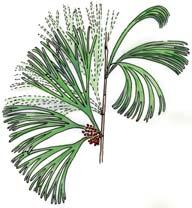
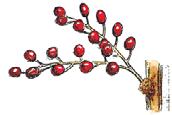


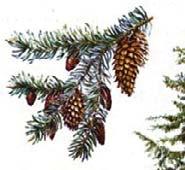

Kannaskoppia SYSTEMATICS 30 ISSN 2410-4418 Palaeont. afr. (2023) 57 (Special Issue): i–xiv + 1–324
Dicroidium Umkomasia Pteruchus
Kannaskoppia RochipterisKannaskoppianthus
Ref.: Hanlon et al. (2019a,b); Surprising genetic diversity in old growth trees (www.indefenseofplants.com/blog, 23 July 2019)
♀ ♂ ♀ ♂
Sitka spruce Picea sitchenensis
Fig. 2.
Google images
Palaeobotany & Anthropology
A taxonomic conversation with Francis Thackeray (see Acknowledgements and Bibliography)
For the greater part of our research careers within the palaeontological fraternity in South Africa, Francis Thackeray (anthropology) and ourselves (palaeobotany) have debated the tricky question of taxonomy, of defining species, based on the fossil collections at hand. Francis has worked essentially on hominin fossils found at various sites in the ‘Cradle of Humankind’ outside Johannesburg (see Fig. 4 below); and we on the fossil flora of the Molteno Fm. of the Karoo Basin. Two very different areas within the evolutionary tree of life, but posing similar challenges in sampling and the recognition of taxa.
In the following two pages, Francis provides an overview of his approach and to distinguishing between Alpha (assuming distinct boundaries between species) and Sigma (recognizing spectra of variation) taxonomy. Whether considering early Triassic mammallike reptiles such as Lystrosaurus, extant primates such as chimpanzees (Pan paniscus and Pan troglodytes), or hominin lineages (Australopithecus and Homo) over the past few million years, the pattern is similar. He finds Sigma taxonomy to be everywhere relevant.
Given reasonably comprehensive sampling, large collections from many localities, the same pattern of ‘spectra of variation’ can clearly be observed in the world of plants.


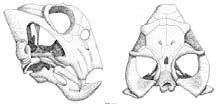





Australopithecus afarensis Homo habilis Homo erectus Homo neanderthalensis Homo sapiens

Gorilla Gorillagorilla gorilla



The Human Tree
6th

Until pretty recently there were perhaps four other species of Homo sharing the world with us.

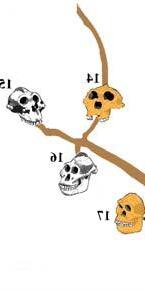







Australopithecus anamensis
Ardipithecus ramidus
Ardipithecus kadabba

Orrorin tugensis


Diversity (last 7 Myrs)
Homo, 9 spp
Australopithecus, 6 spp
Paranthropus, 3 spp
Kenyanthropus, 1 spp
Ardipithecus, 2 spp
Orrorin, 1 spp
Sahelanthropus, 1 spp

Homina (subtribe)
Homininae (hominins) (subfamily)
Panina (subtribe)
Sahelanthropus tchadensis
Hominini (tribe)
Kannaskoppia SYSTEMATICS 31 ISSN 2410-4418 Palaeont. afr. (2023) 57 (Special Issue): i–xiv + 1–324
Bonobo Pan paniscus Lystrosaurus
4 12 15 6 10 11 1 14 5 17 18 19 0 21 5 2 8 9
Adapted from Anderson, Thackeray & Visser (2016)
Today Species from the Cradle of Humankind
Paranthropus aethiopicus
prometheus A. africanus
sediba H. erectus
naledi H. neanderthalensis
Kenyanthropus platyops
A.
A.
H.
H. sapiens H. rudolfensis Homo habilis H. ergaster
A. afarensis
garhi Age (Ma) 3 2 1 4 5 6 7 8 9 10
Panpaniscus
1 2.98 7.65 ~10.0 4.00
A.
Pan
paniscus
Total: 7 genera, 23 spp
Gorillini (tribe)
E a s t e r n G o r i l l a Eastern Gorilla W e s t e r n G o r i l l a Western Gorilla C h i m p a n z e e Chimpanzee B o n o b o Bonobo
ºC Climate change
Cold 10ºC swing Hot P. boisei P. robustus H. floresiensis A possible family tree (not the only one), as adapted from B. Wood (2014) H. heidelbergensis
Extinction
Lystrosaurus declivis
Chimpanzee Pan troglodytes
Fig. 3.
2 4 6 802 c. 252–249 Ma
Fig. 4.
Ma
Ma
3–0
4–0
Chart 2. SIGMA
(AS OPPOSED TO ALPHA)
TAXONOMY:
how to define a species probabilistically without assuming clear boundaries between taxa.
Francis Thackeray, August 2019
One of the greatest problems in biology, whether one is dealing with modern or fossil animals or plants, is how to define a species. It is common enough to employ the Linnaean binomial system of nomenclature whereby a specimen is classified under the assumption that it can be pigeon-holed into a particular genus and species. This works well when one is dealing with the morphology of just a few similar specimens including a holotype, but as the sample sizes increase for one particular species, one detects a certain degree of variation that may eventually overlap with that of another species for which there is a different holotype. How would one go about quantifying the degree of similarity or difference between groups of specimens that may or may not represent the same species? In the context of morphometrics of vertebrate fauna (excluding plants for the moment), the approach recognizes the need to define a species in a probabilistic manner.
Here are two concepts, relating to Alpha and Sigma taxonomy: Alpha taxonomy –The classification of animals or plants under the assumption that there are distinct boundaries between species. Sigma taxonomy – The classification of animals or plants in terms of probabilities of conspecificity, without assuming distinct boundaries between species (Thackeray, 2018). Sigma is the Greek letter Σ (S) standing for a ‘spectrum of variation through evolutionary time’ (Thackeray & Schrein, 2017).
One possible morphometric method for Sigma Taxonomy
One method (not necessarily the best one, but a viable one for purposes of sigma taxonomy) makes use of least squares linear regression analysis in pairwise comparisons (initiated by Thackeray et al., 1997). In the case of the examples that follow, the variables under discussion are linear measurements of crania, based on standard landmarks.
Let us assume that two specimens A and B are known to represent the same extant species from a population living in one area at the same time. Linear measurements (let us say at least 25 of them) of the cranium of specimen A are compared against those of specimen B. A pairwise plot of the kind shown in Fig. 1 can be analysed using least squares linear regression analysis.
In this case, the log of the standard error of the m co-efficient (log sem) associated with the regression equation y = mx + c is –1.61. This relates to a small degree of scatter around the regression line. By
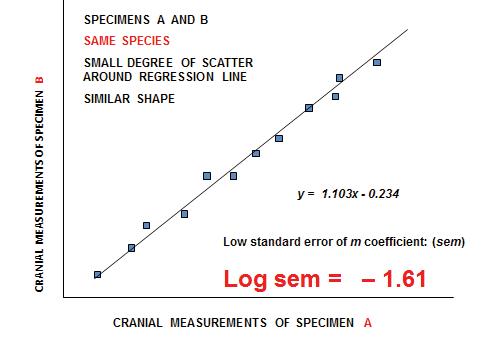
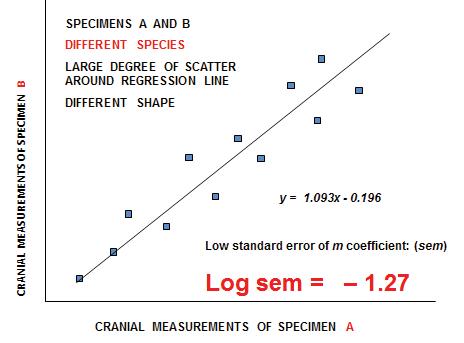
contrast (as shown in Fig. 2), log sem is higher (more positive, >–1.61) when two specimens of different species are compared.
Now let us repeat the process for many conspecific pairs, as in the case of Fig. 1, but let us do this for 100 species of vertebrate animals (mammals, birds and reptiles), using at least 25 measurements for each comparison. For any two specimens, let us obtain two log sem values: in the first analysis put specimen A on the x-axis, and conspecific specimen B on the y-axis. In the second analysis put A on the y-axis, and B on the x-axis. What we will find is that the difference between the log sem values (delta log sem) is small for conspecific pairs (circa 0.03 as demonstrated by Thackeray & Dykes (2016) for certain vertebrate mammals). Continuing this analysis, let us look at a histogram of log sem values for the pairwise comparisons of conspecifics. On the basis of results obtained from exploratory analyses, we find a normal distribution of log sem values around a mean of –1.61 (Thackeray, 2007). For discussion see Thackeray & Dykes (2016), who indicated that a standard deviation of ± 0.1 may be expected in relation to a mean log sem of –1.61 for many conspecific pairs (idealized in Fig. 3). Recognizing central tendency around –1.61 for the mean log sem value for many conspecific comparisons, whether males or females (Thackeray, 2018), it has been proposed (Thackeray, 2007) that this value is an approximation of a biological species constant (T = –1.61), here associated with a typical standard deviation (± 0.1) to reflect the typical degree of variation within a vertebrate species.

Kannaskoppia SYSTEMATICS 32 ISSN 2410-4418 Palaeont. afr. (2023) 57 (Special Issue): i–xiv + 1–324
Fig. 1. Measurements of two specimens of the same species are compared. There is a small degree of scatter around the regression line, and the log sem value is –1.61 which is a typical value when two specimens of the same species are compared (Thackeray, 2007).
Fig. 2. Measurements of two specimens of different species are compared. There is a high degree of scatter around the regression line, and the log sem value is also relatively high (more positive than –1.61).
Fig. 3. A normal distribution of log sem values for modern conspecific pairs of specimens.
We are now in a position to propose that –1.61 ± 0.1 is a probabilistic definition of a species, and it has applications in vertebrate palaeontology. If any two fossil crania have a log sem value which is exactly –1.61, or a value that falls within the 95% confidence limits of –1.61 ± 0.1 (Fig. 4), we could say that there is a high probability of conspecificity for fossil specimens A and B. By contrast, if the log sem value for two other crania (specimens C and D) is outside the upper 95% confidence limit, one could advocate that there is a low probability of them being the same species.

Applications
This approach has been applied to Plio-Pleistocene hominin fossils. For example, Thackeray & Odes (2013) have demonstrated that there was a spectrum of variation of log sem, ranging from relatively low values (< –1.61) reflecting high probabilities of conspecificity for specimens attributed to the same species, to higher values (> –1.61) reflecting lower probabilities of conspecificity as in the case when specimens of different species were compared. A pertinent observation made by Thackeray (2018) is that certain specimens attributed to Australopithecus africanus (e.g. Mrs Ples, Sts 5, from Sterkfontein in South Africa) were not necessarily different (at the level of species) from other specimens attributed to Homo habilis (e.g. OH 24 from Olduvai Gorge in Tanzania). There is evidently not a clear boundary between these two genera in the context of evolutionary time (from 2.5 to 1.6 million years).
In the context of geographical space, the same approach has been applied by Thackeray et al. (2005) in the case of anatomically modern Homo sapiens (‘CroMagnon’) and Homo neandertalensis skulls, again indicating the lack of a clear boundary between taxa. An overlap of data suggested the possibility of interbreeding, a fact
which has subsequently been confirmed on the basis of palaeogenomic analyses.
Similarly, the approach has been applied by Thackeray (2018) in the case of two species of chimpanzees (Pan paniscus, the bonobo; and P. troglodytes), indicating the lack of a clear boundary between taxa. An overlap of log sem data (Thackeray & Dykes, 2016) is entirely consistent with episodic changes in climate and habitats, coinciding with episodic interbreeding which has been demonstrated genetically. Hybridization occurred twice within the last million years.
The approach has been applied to two Triassic therapsid species, Lystrosaurus murrayi and L. declivis, postdating the Permo-Triassic extinction at 252 million years ago. Measurements from skulls of specimens attributed to one or other species were compared to obtain log sem values. In an initial exploratory study (Thackeray et al., 1998) it was suggested that only one species might be represented. In a subsequent study (Thackeray, 2019) it was recognized from log sem that the type specimen of L. declivis was probably distinct from at least one other individual attributed to L. murrayi, suggesting that not all Triassic Lystrosaurus should be lumped into one species. However, the possibility remains that near the time of divergence of the two species postdating 252 million years ago, L. murrayi and L. declivis could have interbred, which would account for the instances when it is necessary to classify certain specimens simply as L. murrayi/declivis. Unfortunately the holotype for L. murrayi is not well preserved. This creates a problem, but if a neotype is recognized, more can be done with regard to sigma taxonomy, using a probabilistic approach (Thackeray, in prep.).
Conclusion
This approach has the advantage in that it does not assume clear boundaries between taxa, as in the case of alpha taxonomy. Sigma taxonomy relates to the classification of specimens in terms of probabilities of conspecificity, where Sigma is the Greek letter Σ (S) standing for a ‘spectrum of variation through evolutionary time’ (Thackeray & Schrein, 2017).
Thus far the approach has been applied to vertebrate taxa. It has not as yet been applied to plants, but the potential exists to do this. In this regard, it is appropriate to mention that, as in the case of animal species, boundaries between plant taxa are not necessarily clear. Take roses, for example. Peter Knox-Shaw (pers. comm. to Thackeray, 28 March 2019) says “Nature is promiscuous. Rosa gigantea, the emperor of wild roses, produces single flowers the size of saucers and climbs on occasion to 80 feet. This species has sired more hybrids than Genghis Khan. In our garden alone it has crossed with R. banksia, with R. longicuspis, with R. rubus and with a number of other roses impossible to identify. And none of the progeny appear to be infertile”
Kannaskoppia SYSTEMATICS 33 ISSN 2410-4418 Palaeont. afr. (2023) 57 (Special Issue): i–xiv + 1–324
Fig. 4. Log sem values are used to assess probabilities of conspecificity for pairs of specimens.
GINKGOOPSIDA Engler, 1897
PETRIELLALES T.N.Taylor et al., 1994
PETRIELLACEAE T.N.Taylor et al., 1994
Kannaskoppia J.M.And. & H.M.And., 2003
Type species
Kannaskoppia vincularis J.M.And. & H.M.And., 2003 Kannaskop (Kan 111), Karoo Basin, S. Africa; Carnian, Triassic. Plant fossil names registry number: PFN002287 (for genus)
Generic diagnosis
A ginkgoopsid strobilus with a forked axis bearing rows of several simple megasporophylls consisting of a single, recurved, pedicellate cupule.
Generic characters
Fertile shoot: stem with short shoots in an irregular helical arrangement; leaves (l or 2) and strobili (2 or 3) borne irregularly on each shoot.
Strobilus: lax, planar; bilaterally symmetrical, small (c. 20 mm long); axis gracile, proximally forked; megasporophylls in 2 adaxial oblique rows (of 4–6 units) along each fork (limb), angle between rows c. 90°.
Megasporophyll: apparently reduced to single pedunculate cupules; ovuliferous cupules recurved; peduncles 2–3 mm long, gracile, sinuously curved.
Cupule: small (c. 2.5 × 2 mm), roundly ovoid, splitting more or less regularly into 3 lobes at maturity.
Ovule/seed: unknown.
Etymology
Kannaskoppia – after the type locality Kannaskop, an Afrikaans name for a hill bearing Canna plants (not the monocots of the family Cannaceae).
“In the 17th Century in the Cape of Good Hope, indigenous Khoisan inhabitants were known to chew or smoke a plant which had hallucinogenic properties. It has been spelt “canna” or “kanna”, with the latter in modern usage. The plant is almost certainly Sceletium as opposed to anything else” Francis Thackeray (pers. comm., Jan. 2021).
Global range: 1 sp., Gondwana, Tr. (CRN).
First & last: Molteno Fm.
Gondwana Triassic occurrence
South Africa – Karoo Basin, I TC (50 indivs).
Molteno occurrence (see Tab. 2, p. 40)
Frequency (F): 1 TC (of 100 sampled in the Molteno).
Diversity (D): 1 species.
Abundance (A): 50 indivs; rare.
Kan 111 Ast spA: 50 indivs in 30 man-hrs cleaving (c. 20 per 1 man-day), rare.
Affiliated organs
Male strobilus: Kannaskoppianthus – Grade 5 (Mor. corr., Kin. reinf.).
Foliage: Rochipteris – Grade 5 (Org. att.).
Evidence for affiliation of organs
Organic attachment
The holotype specimen of Rochipteris vincularis, together with the associated specimen on the same slab and additional material, constitutes the most convincing example of affiliated organs in the Molteno flora. Typical strobili and leaves are found attached to short shoots borne on a section of stem. Other specimens in the collection show the male strobilus, Kannaskoppianthus, attached in a similar manner to short shoots with Rochipteris leaves.
Classification & comparison
Suprageneric classification (Petriellaceae/Petriellales)
Kannaskoppia is considered to be closely allied to Petriellaea and thus placed in the order Petriellales and family Petriellaceae (Taylor et al., 1994). We now follow Bomfleur et al. (2014) although we previously placed these female cupules in their own family Kannaskoppiaceae (And. & And., 2003). Intergeneric comparison (Gondwana Triassic)
Petriellaea is known from a single permineralized peat deposit in the Middle Triassic Fremouw Fm. of Antarctica (Taylor et al., 1994). The microscopic anatomy of the ovulate organ is exquisitely preserved revealing five ovules per cupule and many other details, but the overall architecture of the cupule remains uncertain. The reflexed cupules, as well as the size and configuration of the ovulate heads, are reminiscent of Kannaskoppia. It is possible that further new finds may show Petriellaea and Kannaskoppia to be congeneric, but this is not possible to conclude at the present time. What is known of the one genus is mostly unknown of the other.
K. vincularis
secondary axis (limb)
megasporophyll cupule
bulbous short shoot

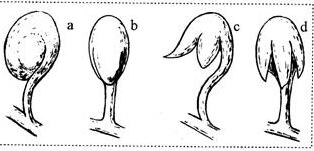
t-figs 1–3 based on full reference palaeodeme
Reconstructions
Fertile shoot
Strobilus

1 3 a
peduncle axis
R4 ×2
R4 ×5
12 cm 0
The reconstructions (t-figs 1–3 above) are based on the comprehensive palaeodeme from Kan 111 Ast spA. The shoot showing attachment of foliage and female cupule (p. 37, t-fig. 1) is largely a combination of PRE/ F/13487a‘y’and PRE/F/13487b‘x’ – the two portions of shoot illustrated on pls 23–26. These lie closely adjacent on the part and counterpart of a single cleaved slab. The arrangement of leaves and megasporophylls on the short shoots appears to show no consistent systematic pattern. However, the size and number of megasporophylls probably diminish towards the shoot apex.
The strobili, occurring in twos or threes, are found attached to bulbous short shoots which usually bear one or two leaves. Simplified reconstructions, with leaves removed, include a group of three strobili at natural size (p. 37, t-fig. 2), and a single strobilus showing characteristic fork and double row of megasporophylls at ×2 magnification (t-fig. 1 above).
Megasporophyll
The megasporophyll is taken to consist of a single cupulate unit borne on a long gracile, slightly recurved peduncle. Cupule details (t-figs 3a–d above) are based largely on three specimens, PRE/F/13489a,b, PRE/F/13508a,b and PRE/F/13518a,b; see pls 29, 33, 35, which show the cupules preserved at various angles. Due to the 3D nature of the preservation of the material shown in pls 23–26, it is possible to observe the curved peduncle with its tendency to flex downwards, and to estimate the angle of c. 90° between the cupule rows as shown in our reconstructions (t-figs 1, 2 above). The cupule is roundly ovoid and at maturity splits into three more or less regular lobes (t-figs 3c–d above).
Ovule/seed
While much is known about the gross morphology of the megasporophylls and their mode of attachment, nothing is known of the interior organization of the cupules or of the ovules. Nowhere on the many slabs bearing the cupule is there any indication that either cupules or seeds are individually dispersed.
Kan 111 Ref.:
Kannaskoppia SYSTEMATICS 34 ISSN 2410-4418 Palaeont. afr. (2023) 57 (Special Issue): i–xiv + 1–324
& figs (4-page
updated from And. & And.
text
spread)
(2003, pp 286–289)
TCs
13Pen
25
26
Comparisons beyond Gondwana Triassic
Apart from Petriellaea, the Mesozoic ovulate structure most comparable with Kannaskoppia is Caytonia (Jurassic, Eurasia) – in its size and form with lateral rows of dorsally reflexed cupules on short peduncles. ln both genera the cupules fully enclose the ovule(s), but in Kannaskoppia their nature remains unknown. Kannaskoppia differs most evidently in the strobilus being forked and in the pedunculate cupules not abscising.
Caytonia (Jurassic/Eurasia)
Geographic & stratigraphic distribution: The ovulate organ, Caytonia, is now known as a widespread element of the lower half of the Jurassic of Eurasia: Yorkshire (>9 localities, M. Jurassic, Bajocian to Bathonian); Greenland (2 localities, basal Liassic, Hettangian); Poland (1 locality, U. Liassic); Sardinia and the USSR. Foliage identified as Sagenopteris has been reported from the U. Triassic to U. Cretaceous. The first report of Caytonia made from Gondwana was by Clifford & Camilleri (1998) who described C. tierneyi affiliated with Sagenopteris leaves from the Lower Jurassic Marburg Fm., Queensland, Australia. A possible Caytonia cupule was descrbed by Elgorriaga et al. (2019) from the Lower Jurassic of Patagonia and they reviewed the other possible Gondwana finds.
Affiliation of organs: The Caytonia plant, the basis of the order Caytoniales, is one of around 20 fossil and extant gymnospermous ‘orders’ (or approximate ordinal groupings) on which cladistic analyses of the gymnosperms are based (Crane, 1985, 1986, 1988). It is one of the few fossil gymnosperm genera where most organs are known through well-established affiliations (Grade 4) from a good number of localities. The organs include Caytonia (female strobilus), Caytonanthus (male strobilus) and Sagenopteris (foliage).
Preservation: Adding value to Caytonia (and affiliated organs) is that it is often found as well-preserved compressions.
Megasporophylls (morphology): ‘Cupules’ on short peduncles, spherical, reflexed dorsally with distinctive lip, apparently fleshy and berrylike at maturity, abscising at base of pedicel, with 8–30 tiny ovules.
Abundance: Explicit abundance and frequency data on fossil taxa are rarely given and this holds generally true for the Caytonia plant. In the Yorkshire Jurassic sites where it is best known, Harris (1964, p. 3) writes that it is “by no means common”.
Diversity: No recent taxonomic revision of the Caytonia plant has been attempted, so any real sense of specific diversity is very difficult to gather. Five named species of the genus Caytonia appear to be currently valid from Eurasia.
References: Harris (1933, 1940, 1958, 1964); Reymanówna (1973); Crane (1985); Krassilov (1977).
Polyspermophyllum (Permian/Argentina)
Kannaskoppia cupules are remarkably similar to the ovuliferous component of Polyspermophyllum sergii. Archangelsky & Cuneo (1990) from the Permian of Argentina. These are described as “distally placed curved ovuliferous units (cupules?) bearing a single ovule.” However, the ?cupules are borne on repeatedly dichotomizing trusses and occur with attached leaves bearing a single medial vein and two longitudinal marginal furrows, setting them far apart from Kannaskoppia
Polyspermophyllum is included in the Dicranophyllales. Archangelsky & Cuneo also discuss the possible links of their genus to the Ginkgoales and other orders.

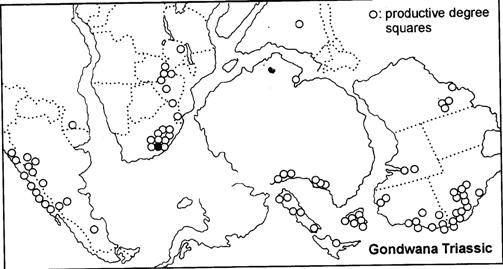
Kannaskoppia SYSTEMATICS 35 ISSN 2410-4418 Palaeont. afr. (2023) 57 (Special Issue): i–xiv + 1–324
Map 1.
assemblages
R
r
Rochipteris K
s
p
Kannaskoppia K
n
Kannaskoppianthus attached
fern/ Kannask. meadow Dicroidium Sphenobaiera Heidiphyllum horsetails ferns ()
1Cal 211Hei elo 5 75 – 20 2Gre 121Hei elo 22–2––3– 98 202 3 “ 111Equ sp 1–––– 2 – 97 1 4Boe 112Dic cor 1–––– 99 –144–5Cyp 111Dic cra 83–– () – 75 – 24 –4 6Kan 112Hei elo 19–5 ♂ – 1 – 98 67 7 “ 111Ast spA 5 50– () ♀ ✓ 102263 8Tel 111Hei elo 33–4 () – 6 – 89 4858
111Sph/Dic 30–2
3960 –15 1
111Dic odo 2–––– 70 4 28 –2
311Hei elo 66–16––5829 99 303
211Ast 2spp 4––– – 2052
(taphocoenosis)
o c h i p t e
i s
a n n a
k o
p i a
a n n a s k o p p i a
t h u s
organs
♀ ♂
9Kom
() ♂ –
10Vin
11Lut
12Kon
311Hei elo 41–––– 25
75 511
411
80–4–– 13–
111Dic/Ris 6–––– 50 2025 10 4
111Dic zub 1–––– 7030 ––4
111Hei elo 4–––– 10 – 79 23
213Dic elo 7–––– 89 49 1 1132
111Dic 2spp 50–––– 695721
111Dic cra 3–––– 90 – 5 21
111Dic dub 2 –3–– 89 18 4 207 22Lit 111Dic/Hei 56–9–– 50123 1010 23Aas 111Hei elo 2 –21––71 77 10 20
“ 211Hei elo 19–1–––– 99 –2
–
14 “
“ “
9423 15Kap
16Nuw
17Win
18Hla
19Umk
20San
21Mat
24
elo 26–4––159 99 –2
“ 311Hei
411Dic/Sph 150–21–– 60301 7524
TCs 261122
individuals % 5092 Dominants with megaplant-bearing formations with Kannaskoppia/Petriellaea Productive degree squares (GT map) Kannaskoppia Molteno Fm 1–10: degree squares : superlocalities 3 1 2 4 5 6 7 10 9 8 TA4 megaplant-bearing formations beds with Rochipteris Productive formations beds with Kannaskoppia ♀ SAmSAfIndAntAus ChNASAPaLuZaLiKaWHPlTANZCaSAGaBoCMNESyViTa UPPER R N C M L A L Triassic 201 209 227 237 242 247 252 Period Epoch Stage Ma 210 220 230 240 250 O I ♀ ♀ Molteno with Petriellaea TA4 with Kannaskoppia
“
Total
Total
Tab. 1. Kannaskoppia/Kannaskoppianthus/ Rochipteris, Molteno occurrence.
Kannaskoppia vincularis J.M.And. & H.M.And., 2003
Holotype
Specimen: PRE/F/13487 a‘y’; tf. 2 below; pls 23, 24
Assemblage: Kan 111 Ast spA, Kannaskop.
Preservation: a shoot 90 mm long with clusters of foliage and megasporophylls attached; compressed 3D mould and cast (no cuticle or carbonized material); on the counterpart slab there is an additional isotype specimen, PRE/F/13487b‘x’, from which a piece of matrix (flake) can be lifted to reveal foliage and fruit at a different level; impression in thick-bedded, moderately baked, greenish grey silty mudstone with very poor cleavage.
Isotype: tf. 1 below; see notes on p. 67; pls 25, 26
Plant fossil names registry number: PFN002288
Reference palaeodeme
Assemblage: as for holotype.
Specimens: c. 50 indivs, pls 23–34 (includes further foliage as indicated); 5 torn sections of shoot with foliage and strobili attached; >50 detached strobili or clusters of strobili; 12 torn sections of shoot with foliage only; >25 detached leaves, generally torn or twisted.
Sister palaeodemes – nil.
Specific diagnosis – as for genus.
Specific characters – as for genus.
Etymology vincularis – vinculum (Lat.), link, bond, with reference to the fruit and foliage being found in organic connection at the type locality.
Comment & comparison – as for genus.
Reference palaeodeme
PRE/F/13487b‘x’ (with flake in place) pl. 25(1–4), 26(1–3)
Isotype
PRE/F/13487a‘y’ pl. 23(1–3), 24(1–3)
PRE/F/13489a pl. 29(3)
PRE/F/13508a,b pl. 33(1–6)
PRE/F/13507a
PRE/F/13511a,b pl. 30(1–6)
PRE/F/13518a,b pl. 35(1–5)
PRE/F/13500a,b
PRE/F/13505a
PRE/F/13506a,b pl. 31(1–6) all R2 ×2
PRE/F/13513a
Kannaskoppia SYSTEMATICS 36 ISSN 2410-4418 Palaeont. afr. (2023) 57 (Special Issue): i–xiv + 1–324
pl. 27(1–6) all R2 ×1
1 3 4 5 6 7 8 9 10 11 Kan 111 cluster of 2 2 Holotype 12 cm 0


Kannaskoppia SYSTEMATICS 37 ISSN 2410-4418 Palaeont. afr. (2023) 57 (Special Issue): i–xiv + 1–324
R4
2 R4 ×1 1 Kannaskoppia vincularis Kan 111 12 cm 0
t-figs 1, 2 based on full reference palaeodeme, but largely on PRE/F/13487a‘y’ & PRE/F/13487b‘x’
×2
Kannaskoppianthus J.M.And. & H.M.And., 2003
Type species
Kannaskoppianthus lutinumerus J.M.And. & H.M.And., 2003, Lutherskop (Lut 311), Karoo Basin, S. Africa; Carnian, Triassic Plant fossil names registry number: PFN002296 (for genus)
Generic diagnosis
A ginkgoopsid strobilus comprising a forked axis bearing 2 rows of several adaxial microsporophylls with 5–10 longitudinal microsporangia in a concavity protected by an operculum.
Generic characters
Fertile shoot: strobili attached in fascicle with leaf cluster along shoot or at end of shoot.
Strobilus: lax, planar, bilaterally symmetrical, small (8–25 mm long) to rarely medium (up to 45 mm); axis gracile, proximally forked ; microsporophylls in 2 adaxial oblique rows (of 4–10 units) along each fork (limb), angle between rows c. 90°.
Microsporophyll: spathulate, dorsoventrally flattened, bilaterally symmetrical; microsporangia 5–10 per unit, longitudinally aligned in distinctive concavity, attached distally to apical arcuate scale cap, protected by a dehiscent operculum.
Microsporangia: elongate-elliptic (1.5 × 0.5 mm), with fine linear ornamentation. Pollen: unknown.
Etymology
Kannaskoppianthus – after the type locality and acknowledging certain affiliation with the female strobilus Kannaskoppia
Global range: 8 spp., Gondwana, Tr. (CRN–RHA).
First: Molteno Fm. (233–227 myrs)
Last: Chile, Ternera Fm. (207 Ma)
Gondwana Triassic occurrence
South Africa – Karoo Basin, 12 TCs (92 indivs).
Molteno occurrence
Frequency (F): 12 TCs (of 100 sampled in Molteno).
Diversity (D): 8 species.
Abundance (A): 92 indivs total; rare to extremely rare in top 8 TCs.
Aas 111 Hei elo: 21indivs in 40man-hrs (5 per 1 man-day) rare
Lut 311 Hei elo: 16 “ “ 50 “ (3 “ 1 “ ) “
Kan 112 Hei elo: 5 “ “ 15 “ (3 “ 1 “ ) “
Kom 111 Sph/Dic:2 “ “ 10 “ (2 “ 1 “ ) “
Aas 411 Dic/Sph: 21 “ “ 512 “ (1 “ 2 “ ) very rare
Mat 111 Dic dub: 3 “ “ 65 “ (1 “ 2 “ ) “ “
Tel 111 Hei elo: 4 “ “ 90 “ (1 “ 2 “ ) “ “
Lit 111 Dic/Hei: 9 “ “ 550 “ (1 “ 6 “ ) extr. rare
The abundance figures reflected here for the eight TCs with the highest Kannaskoppianthus yield, account for every specimen found, no matter how fragmentary or poorly preserved. All were retained and curated. At the four further sites not listed above, Kannaskoppianthus is even rarer (Tab. 2, p. 40).
Although very rare, the Kannaskoppianthus male occurs in 12 of the 26 TCs yielding Rochipteris foliage. This frequency ratio of 1:2 (male to foliage) is high for the Molteno. In the 12 TCs it ranges in abundance from 1 individual in 7 man-days cleaving to 5 in 1 day, with a norm at around 1 found every 2 days. There appears to be no particular pattern of abundance based on habitat.
Affiliated organs
Female strobilus: Kannaskoppia – Grade 5 (Mor. corr.).
Foliage: Rochipteris – Grade 5 (Org. att.).
From Kommandantskop (Kom 111 Sph/Dic), PRE/F3231a,b (t.fig. 5 adjacent) shows two strobili of Kannaskoppianthus attached to an axis with a whorl of four Rochipteris leaves (see also pl. 47(1–8)). From Kannaskop (Kan 112 Hei elo), PRE/F/20114a,b (pls 19–20) shows a strobilus attached to a stem with leaf/branch scars. This is similar to the stems bearing leaves and female strobili (Kannaskoppia) from Kan 111 Ast spA.
Classification & comparison
Suprageneric classification
See under Kannaskoppia
lntergeneric comparison (Gondwana Triassic)
Kannaskoppianthus is unique among known ginkgoopsid microsporangiate genera. In their size, diagnostic forking and paired erect rows of fertile units, the micro- and megasporophylls (Kannaskoppia) are remarkably alike. The latter are noticeably more gracile.
K. switzianthus (number of microsporangia) & other Molteno spp.
R5 reconstruction based on all Molteno TCs yielding ♂ strobilus (see text opposite)
K. telepentatus
Tel 111
K. komanthus
PRE/F/18277a,b pl. 42(1–8)
Aas 311
PRE/F/12001a,b pl. 147(7–10)
Kom 111
PRE/F/3231a,b pl. 47(1–8)
12 cm 0
Kannaskoppianthus SYSTEMATICS 12 cm 0 38 ISSN 2410-4418 Palaeont. afr. (2023) 57 (Special Issue): i–xiv + 1–324
3
× × × × ×
Reconstructions
The R5 reconstructions (t-figs 1, 2 opposite) of Kannaskoppianthus are based on the full set of Molteno specimens at hand, but primarily on:
Lut 311: PRE/F/11433, pl. 53(1–8): architecture of strobilus, nature of protective operculum
Aas 211: PRE/F/15280, pl. 143(1–11): angle of microsporophyll
Tel 111: PRE/F/18277a,b, pl. 42(1–8): structure of microsporophyll, attachment and number of microsporangia
Aas 411: several indivs, pls. 153–156: attachment of microsporangia
Aas 311: PRE/F/12001, pl. 147(8,9): morphology of microsporangia
Tel 111: PRE/F/7711, pl. 41(1–6): nature of protective operculum
Lit 111: PRE/F/21497, pl. 119(1–6): number of microsporangia, groove
Gre 121: PRE/F/7856, pl. 3(1–6): number of microsporangia, groove
Number of microsporangia
No specimens in the collection show microsporophylls with the full complement of microsporangia attached. A specimen from Tel 111, PRE/ F/18277a,b, clearly shows two attached microsporangia, pl. 42(1–8). The size and shape of these microsporangia suggest a full complement of five pollen sacs in the undehisced original. Furthermore, five grooves or vascular strands are seen where the microsporangia were probably attached (t-figs 2d, 3b opposite). In three species, 10 grooves or attachment scars are evident, e.g. PRE/F/7711, pl. 41(1–6).
Microsporophyll developmental & dehiscence stages (t-figs 2a–e opposite):
(a) microsporophyll with protective operculum covering the microsporangia;
(b) operculum dehisced revealing the five closely packed immature microsporangia;
(c) mature microsporangia ready to release pollen;
(d) microsporophyll with the microsporangia detached exposing five grooves or vascular strands;
(e) the woody arcuate scale cap is now detached; most specimens in the collection show this stage of preservation;
(f) microsporophyll at stage (b) in oblique view at characteristic angle (as if on intact strobilus).
Gondwana Triassic occurrence (elaborated)
From South America (Hypodigm, Chart 1, pp 106, 107), Solms-Laubach (1899) named and illustrated a fertile structure as Acrocarpus ternerae which is here regarded as a Kannaskoppianthus sp. The genus Acrocarpus does not have priority as it is an extant genus in the family Fabaceae. Artabe et al. (1998) reported fertile structures associated with these leaves but did not describe them. They are probably male and need to be described.
A doubtful record of a sporophyll was reported by Jones & De Jersey (1947, t-fig. 59) from the Ipswich Basin in Australia. Although thought to bear seeds, in size and shape the specimen comes close to Kannaskoppianthus. However, poor preservation does not allow closer comparison.
Comparisons beyond Gondw. Trias.
The only pollen-bearing structures that show some similarity to Kannaskoppianthus occur in the Carboniferous of Euramerica. The class Lagenostomopsida includes the genera Crossotheca and Feraxotheca, both of which have numerous microsporangia attached at the end of modified ultimate pinnae. Paracalathiops shows a similarity in the basic architecture of a bifurcating axis and pedunculate microsporophylls (see Taylor & Taylor, 2009).
While the megasporophyll Kannaskoppia shows some similarities to Caytonia, the microsporophyll Kannaskoppianthus differs greatly from Caytonianthus, which has a pinnate structure bearing lateral ‘branches’ and a few pedicellate microsporangia consisting of usually ‘four locules’ which dehisce towards their inner side (Crane, 1985).

Intactness & preservation (Molteno)
Microsporangia (see Tab. 2, p. 40)
The male strobilus has been found in 12 of the 26 Rochipteris-bearing TCs. Although microsporangia have been recognized from eight of these 12 TCs they remain notably rare, probably because the microsporangia are shed before or during fossilization. Of the strobili preserved with associated microsporangia, only a small proportion are seen with sacs clearly attached:
Tel 111 (PRE/F/18277a,b); Aas 411 (PRE/F/12050a,b, PRE/F/20558a,b, PRE/F/21339a,b, PRE/F/21720a,b). The best preserved of the individual microsporangia have been illustrated: pl. 147 from Aas 311, and pl. 42 from Tel 111.
Pollen
Of all the Kannaskoppianthus microsporophyll sites, only the Lit 111 Dic/Hei TC yields carbonized compression material with the potential for extracting in situ pollen. And only two of the nine available strobili (PRE/F/5939 & PRE/F/5734) from this site appear to bear a few microsporangia that could possibly yield pollen.
Cuticles
Potential sample: Lit 111, 9 indivs.
Macerated (And. & And., 2003): 2 indivs.
Preservation grade: Grade 3 (fair), a few features available, small pieces mainly from stalk area.
Diagnostic characters: cells oblong to narrowly oblong, walls straight to gently curved; stomata absent; trichome bases apparently indicated by circular marks, distribution random but towards the end of cells, on both surfaces.
Significance:
Classification – The cuticular features do not indicate any particular plant group, but also do not dispute placement in the Ginkgoopsida and family Petriellaceae.
Affiliations – The diagnostic stomata and characteristic (?)glands found in the leaf (Rochipteris) cuticle have not been found in that of the affiliated male strobilus. The cell outlines and walls, however, correspond well with those characterizing the foliage.
Adaptive radiation (Molteno diversity)
Previously four species of Kannaskoppianthus were recognized (And. & And., 2003), but a closer examination has led to eight species being recognized here. The diversity in the male fruit is less than in the foliage where 12 species are recognized. (The female fruit is represented by only one species from one TC.).The diagnostic characters of the eight male species lie in the size and forking of the strobilus and in the number of microsporophyll pairs per limb, and the number of microsporangia per head
Ref.: text & figs (4-page spread) updated (where relevant) from And. & And. (2003, pp 290, 291)
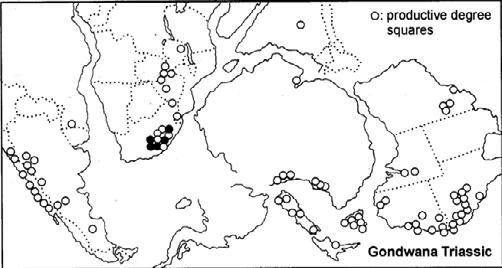
Kannaskoppianthus SYSTEMATICS 12 cm 0 39 ISSN
(2023)
Kannaskoppianthus
2410-4418 Palaeont. afr.
57 (Special Issue): i–xiv + 1–324
Ch1 NA5 TA4
with megaplant-bearing formations with Kannaskoppianthus Productive degree squares (GT map) Ch1 Kannaskoppianthus (GT) Molteno Fm 1–10: degree squares : superlocalities 3 1 2 4 5 6 7 10 9 8 Productive superlocalities (Molteno map) with Kannaskoppianthus megaplant-bearing formations beds with Rochipteris Productive formations beds with Kannaskoppianthus ♂ Molteno SAmSAfIndAntAus ChNASAPaLuZaLiKaWHPlTANZCaSAGaBoCMNESyViTa UPPER R N C M L A L Triassic 201 209 227 237 242 247 252 Period Epoch Stage Ma 210 220 230 240 250 O I ♂ ♂ ♂ ♀
Map 2.
TCs assemblages (taphocoenosis)
Members R o c h i p t e r i s Rochipteris K a n n a s k o p p i a Kannaskoppia K a n n a s k o p p i a n t h u s Kannaskoppianthus microsporangia K. telemagnus (Tel 111) “ irregularis (Kan 112) “ aasvoelensis (Aas 111) “ switzianthus (Lit 111) “ matatiparvus (Mat 111) “ komanthus (Kom 111) “ lutinumerus (Lut 311) “ telepentatus (Tel 111) attached organs Dicr. rip. forest (t.1) Dicr. rip. forest (t.2) Dicr. woodland Sphenobaiera woodl. Heidiphyllum thicket Equisetophyte marsh fern/ Kannask. meadow Dicroidium Sphenobaiera Heidiphyllum horsetails ferns () ♀ ♂ 12345678 1234567
Kannaskoppianthus
occurrence in the Molteno Fm.
Taphocoenoses: occurs in 12 of the 100 sampled TCs
Members: occurs in the lower 4 of the 6 Molteno Members; but most frequently in the Bamboesberg & Mayaputi Members
Diversity: 8 species of Kannaskoppianthus recognized.
Habitat: the genus has been found in 4 of the 7 habitats identified; but by far most frequently in the Heidiphyllum thicket (8 of 12 TCs)
Dominants: Heidiphyllum & Dicroidium are clearly the most abundant associates of Kannaskoppianthus
Abundance: bold – % regular – indivs
1. K. telemagnus And. & And., 2003
2. K. irregularis And. & And., 2003
3. K. aasvoelensis And. & And., sp. nov.
4. K. switzianthus And. & And., sp. nov.
5. K. matatiparvus And. & And., 2003
6. K komanthus And. & And., sp. nov.
7. K. lutinumerus (And. & And., 2003) emended
8. K. telepentatus And. & And., sp. nov.
Kannaskoppianthus SYSTEMATICS 40 ISSN 2410-4418 Palaeont. afr. (2023) 57 (Special Issue): i–xiv + 1–324
Tab. 2. Kannaskoppianthus – Molteno occurrence.
211Hei elo T 5
– 20 2Gre 121Hei elo Qiba 4 22–21––2––––– ✓ ––3– 98 202 3 “ 111Equ sp 1–––––––––––– –– 2 – 97 1 4Boe 112Dic cor 1–––––––––––––– – 99 –144–5Cyp 111Dic cra 83––––––––––– () – 75 – 24 –4 6Kan 112Hei elo Mayaputi 3 19–51–5–––––– ♂ ✓ 1 – 98 67 7 “ 111Ast spA 5 50–––––––––– () ♀ – 102263 8Tel 111Hei elo 33–412–––––2 () ✓ 6 – 89 4858 9Kom 111Sph/Dic 30–21–––––2–– () ♂ ✓ 3960 –15 1 10Vin 111Dic odo 2–––––––––––––– – 70 4 28 –2 11Lut 311Hei elo 66–16–––––––16–– ✓ ––5829 99 303 12Kon 211Ast 2spp Indwe 2 f 4–––––––––––– – 2052 13Pen 311Hei elo 41–––––––––––– – 25 – 75 511 14 “ 411 “ “ 80–4–––4––––– ✓ 13– 9423 15Kap 111Dic/Ris e 6–––––––––––– 50 2025 10 4 16Nuw 111Dic zub d 1–––––––––––– 7030 ––4 17Win 111Hei elo 4–––––––––––– 10 – 79 23 18Hla 213Dic elo b 7–––––––––––– 89 49 1 1132 19Umk 111Dic 2spp 50–––––––––––– – 695721 20San 111Dic cra 3–––––––––––– 90 – 5 21 21Mat 111Dic dub 2 –3–––––3––––– ✓ 89 18 4 207 22Lit 111Dic/Hei a 56–92–––9––––– ✓ 50123 1010 23Aas 111Hei elo Bamboesberg 1 2 –215––21–––––––––– ✓ ––71 77 10 20 24 “ 211Hei elo 19–1–––1–––––– ✓ 99 –2 25 “ 311Hei elo 26–41––4–––––– ✓ ––159 99 –2 26 “ 411Dic/Sph 150–214––21––––––––– ✓ 60301 7524 Total TCs 2611281161111111– 28––Total individuals % 5092162553932162 Kannaskoppianthus HabitatDominants
1Cal
5 – 75
Kannaskoppianthus SYSTEMATICS 12 cm 0 41 ISSN 2410-4418 Palaeont. afr. (2023) 57 (Special Issue): i–xiv + 1–324 R2 all ×2 1 Tel 111 PRE/F/7711 K. telemagnus 2 K. irregularis Kan 112 PRE/F/20114a,b 5
matatiparvus Mat 111 PRE/F/3205 3 K. aasvoelensis Aas 111 PRE/F/19547b 8 K. telepentatus Tel 111 PRE/F/18277a,b Kannaskoppianthus
K.
K. lutinumerus Lut 311 PRE/F/11434a 7 Type species 4 Lit 111 PRE/F/21497
switzianthus K. komanthus Kom 111 PRE/F/3231 6
Showing the 8 species of Kannaskoppianthus recognized in the Molteno
K.
Holotype
Specimen: PRE/F/7711; And. & And., 2003, pl. 118(1,2,4–6).
Assemblage (TC): Tel 111 Hei elo, Telemachus Spruit.
Preservation: cluster of 4 detached strobilus limbs, without counterpart; impression in thickly laminated, light olive-grey shale with poor cleavage.
Plant fossil names registry number: PFN002301
Reference palaeodeme
Assemblage (TC): as for holotype.
Specimens: 2 indivs (1 cluster, 1 fragment); this vol., pl. 41(1–7).
Sister palaeodemes – nil.
Specific diagnosis
A Kannaskoppianthus species with large strobili with limbs bearing 9 or 10 microsporophylls per row and c. 10 microsporangia per unit.
Specific characters
Attachment: unknown.
Strobilus: large (>40 mm long), fork unknown; microsporophylls 9 or 10 per row.
Microsporophyll: broadly convexly conate (c. 3 mm wide distally), with c. 10 microsporangial attachment scars per unit.
Etymology
telemagnus – tele, for the type locality Telemachus Spruit; magnus (Lat.), with reference to the large size of the strobilus.
Affiliation ♂() (foliage)
Rochipteris telefolia (30 indivs); Grade 4 (virtually exlusive)
The strobilis is clearly affiliated with the distinctive large-leaved Rochipteris telefolia which, with 30 individuals (from Tel 111), is relatively common. Two specimens of K. telepentatus have also been collected from the Tel 111 TC.
Comment & comparison
Molteno species
K. telemagnus differs clearly from the other seven Kannaskoppianthus species in the far larger size of its strobili and microsporophylls. The holotype is reconstructed here (p. 126, fig. 1) as a pair of forked strobili attached to a single node.
Gondwana species
The fertile structure Acrocarpus ternerae described by Solms-Laubach (1899) (Hypodigm, Chart 1, p. 106) is closest to this species in size and shape but does not show enough details to make a closer comparison. It is affiliated with the leaves Rochipteris copiapensis described from the same locality and regarded as a distinct species of Kannaskoppianthus (see p. 49 for ‘Proposed new combination’).
Petriellaceae in Tel 111 Hei elo TC
Kannaskoppianthus telemagnus (2 indivs) “ telepentatus (2 indivs)
Rochipteris telefolia (30 indivs) “ penensis (2 indivs) “ pusilla (1 indiv.)
Rarity of K. telemagnus at Tel 111 2 indivs in 90 man-hrs (1 per 4 man-days), very rare
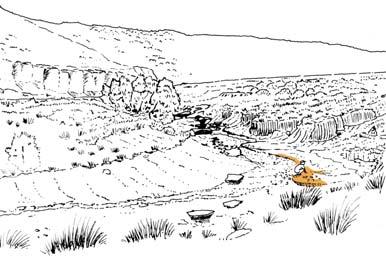
HMA, 28 July 2010
Telemachus Spruit (Tel 111 Hei elo)
Habitat: Heidiphyllum thicket Collection: 581 slabs, 90 man-hrs cleaving

M5 M4 M3 M2 M1 32
R3 ×5
R2 ×1
Rochipteris telefolia (affiliated foliage)
2
Holotype
PRE/F/7711 pl. 41(1–6)
R2 ×2
Reference palaeodeme
2nd indiv. (BP/2/5648, pl. 41(7)), not illustrated here.
Tel 111

Holotype
42 ISSN 2410-4418 Palaeont. afr. (2023) 57 (Special Issue): i–xiv + 1–324 Kannaskoppianthus SYSTEMATICS
Kannaskoppianthus telemagnus J M And & H M And , 2003 J.M.And. & H.M.And., 2003
R2 ×1
12
0
cm
PRE/F/18267 pl. 43(4–6) 1 3 4
Tel 111
PRE/F/7711 pl. 41(1–6)
32. Tel 111
From photo, 24 April 1982
Holotype
Specimen: PRE/F/20114a,b; And. & And., 2003, pl. 117(1–6).
Assemblage (TC): Kan 112 Hei elo, Kannaskop.
Preservation: intact strobilus attached to an axis, part & counterpart; impression in very thin-bedded, moderately baked, medium grey shale with poor cleavage.
Plant fossil names registry number: PFN002302
Reference palaeodeme
Assemblage (TC): as for holotype.
Specimens: 5 indivs (1 attached intact, 4 partial); this vol., pl. 19(1–6), 20(1–6).
Sister palaeodemes – nil.
Specific diagnosis
A Kannaskoppianthus species with medium irregularly forked strobili whose limbs bear 5 or 6 microsporophylls per row.
Specific characters
Attachment: strobili attached terminally to a stem (?long shoot).
Strobilus: medium (>26 mm long), irregularly forked; microsporophylls 5 or 6 per row.
Microsporophyll: broadly concavely conate (c. 2 mm wide distally), with unknown number of microsporangial attachment scars per unit.
Etymology irregularis – (Lat.), referring to the irregular branching of the strobilus.
Affiliation ♂() (foliage)
Rochipteris distivena (4 indivs); Grade 3.5 (very probable)
Amongst the 5 species of Rochipteris identified at Kan 112, aside from R. brumensis (1 indiv), the other 3 foliage species are all preoccupied as regards affiliation.
Comment & comparison
Molteno species
K. irregularis differs from the other Kannaskoppianthus species in the irregularly branching strobili. In the holotype, PRE/F/20114a,b, the stem shows leaf scars but no intact leaves and the strobili are attached seemingly terminally on the shoot.
The only other attached Kannaskoppianthus strobilis found in the Molteno to date is PRE/F/3231 from Kom 111, previously (And. & And., 2003) included in K. irregularis, but is described here as a new species, K. komanthus. It differs from K. irregularis in the shape of the microsporophylls and in their lesser number per row. It consists of a stem with four attached leaves and two strobili, but their actual point of attachment is not clear.
Petriellaceae in Kan 112 Hei elo TC
Kannaskoppianthus irregularis (5 indivs)
Rochipteris telefolia (2 indivs)
“ distivena (4 indivs)
“ rollerii (10 indivs)
“ penensis (2 indivs)
“ pusilla (1 indiv.)
Rarity of K. irregularis at Kan 112
5 indivs in 15 man-hrs (3 per 1 man-day), rare

Kannaskop (Kan 112 Hei elo), Upper End Habitat: Heidiphyllum thicket Collection: 145 slabs, 15 man-hrs cleaving
Holotype
R3 ×5
PRE/F/20114a,b pl. 20(1–6)
Reference palaeodeme
PRE/F/20114a,b pl. 19(1–6), 20(1–6)

BP/2/3386 R2 ×1
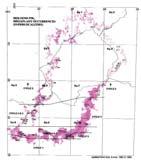
Rochipteris distivena (affiliated foliage)
43 ISSN 2410-4418 Palaeont. afr. (2023) 57 (Special Issue): i–xiv + 1–324 Kannaskoppianthus SYSTEMATICS 12 cm 0
Kannaskoppianthus irregularis J.M.And. & H.M.And., 2003 R2
×2
3 2 1
M5
M3 M2 M1 16
Kan 112 Kan 112
M4
16. Kan 112
HMA, 15 Aug 1996 From photo, 1 Sept 1993
Kannaskoppianthus aasvoelensis J.M.And. & H.M.And.,
Holotype
Specimen: PRE/F/19547a,b, pl. 125(1–9).
Assemblage (TC): Aas 111 Hei elo, Aasvoëlberg.
Preservation: mostly intact strobilus (part & counterpart); impressions in thickly laminated, light-grey shale with moderate cleavage.
Plant fossil names registry number: PFN002303
Reference palaeodeme
Assemblage (TC): as for holotype
Specimens: 21 indivs (6 intact, 15 partial); this vol., pls 125–130, 131(1–4).
Sister palaeodemes – 5
Gre 121 Hei elo: 2 indivs.
Pen 411 Hei elo: 4 indivs (2 of these have opercula attached).
Aas 211 Hei elo: 1 indiv. (intact).
Aas 311 Hei elo: 4 indivs (1 intact, 3 partial), microsporangia present.
Aas 411 Dic/Sph: 21 indivs (10 intact, 11 partial), microsporangia present. Gre 121, p. 81, fig. 12, pl. 3(1–6); Pen 411, pl. 79–80; Aas 211, p. 83, fig. 6, pl. 143(1–11); Aas 311, pl. 145–147; Aas 411, p. 87, figs 1–5, pl. 153–156.
Specific diagnosis
A Kannaskoppianthus species with small regularly forked strobili whose limbs bear 5–8 microsporophylls per row and c. 10 microsporangia per unit.
Specific characters
Attachment: unknown.
Strobilus: small to medium (c. 13–20 mm long), regularly forked; microsporophylls 5–8 per row
Microsporophyll: narrowly concavely conate, convex to end (c. 1 mm wide distally); with c. 10 microsporangial attachment scars per unit.
Etymology aasvoelensis – aasvoel, for the type locality Aasvoëlberg.
Affiliation ♂() (foliage)
Rochipteris rollerii (2% of TC); Grade 4 (mutually exclusive occurrence)
R. rollerii, being the only Rochipteris species recognized at Aas 111, is considered the almost certain affiliate of K. aasvoelensis (with 21 indivs), the sole male-strobilus species found at the site.
Comment & comparison
Molteno species
K. aasvoelensis is most like K. lutinumerus (p. 48) in the number of microsporophylls per row (and the number of microsporangia per unit); but graphs (Chart 3, p. 77) show the latter species to have a distinctly greater spread. From Aas 411 derives a good collection (21 indivs) which are very similar to the reference population; and show a few unclearly preserved microsporangia (pl. 156, figs 7, 9).
Petriellaceae in Aas 111 Hei elo TC
Kannaskoppianthus aasvoelensis (21 indivs) Rochipteris rollerii (2%)
PRE/F/15244b pl. 126(1–3)
PRE/F/19484 pl. 126(4–7)
PRE/F/15246b pl. 130(9–12)
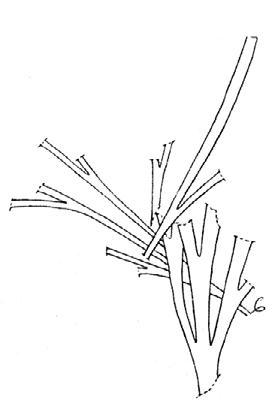
Rarity of K. aasvoelensis at Aas 111 21 indivs in 40 man-hrs (5 per 1 man-day), rare

HMA, May 2019 From photo, 4 June 1971
BP/2/4308 pl. 137(1)
BP/2/4336a pl. 129(1–5)
BP/2/4297a
PRE/F/19541 pl. 130(1–4)
BP/2/4331
PRE/F/19547b pl. 125(5–9)
PRE/F/15203a pl. 127(1–4)
PRE/F/15243a,b PRE/F/19546
R2
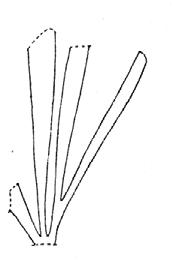
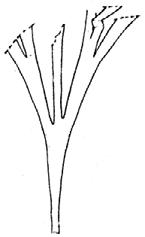
PRE/F/19545 pl. 128(5–10)
13
PRE/F/19547b pl. 125(5–9)
17
111
Aas 311
PRE/F/12001a,b pl. 147(7–10)
microsporangium (see p. 38)
×
18
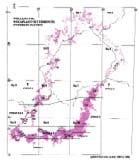
M5 M4 M3 M2 M1 24
Aasvoëlberg (Aas 111 Hei elo), Turner Shale
Habitat: Heidiphyllum thicket
24. Aas 111
PRE/F/19020b pl. 151(1–7)
Kannaskoppianthus SYSTEMATICS
ISSN 2410-4418 Palaeont. afr. (2023) 57 (Special Issue): i–xiv + 1–324
44
sp. nov.
R2 both ×1 Sister palaeodeme 12 cm 0 all ×1 Rochipteris rollerii (affiliated foliage) 19 15 16 Aas 311
all
×2
1 2 3 4 5 6 7 8 9 10 11 12 Holotype
Aas
Holotype R3 ×5 Aas
111
BP/2/4306 PRE/F/19529 pl. 141(5)
Collection: 291 slabs, 40 man-hrs cleaving
14
PRE/F/19019 pl. 152(1–3)
Reference palaeodeme
ISSN 2410-4418
Palaeont. afr. (2023) 57 (Special Issue): i–xiv + 1–324
Holotype
Specimen: PRE/F/21497a,b; pl. 119(1–6).
Assemblage (TC): Lit 111 Dic/Hei, Little Switzerland.
Preservation: intact strobilus (past & counterpart); compressions in thinly laminated, carbonaceous (with cuticle), dark-grey shale with moderate cleavage.
Plant fossil names registry number: PFN002304
Reference palaeodeme
Assemblage (TC): as for holotype.
Specimens: 9 indivs (6 intact, 3 partial), cuticle, microsporangria present; this vol., pls 119–120.
Sister palaeodemes – nil.
Specific diagnosis
A Kannaskoppianthus species with small regularly forked strobili whose limbs bear 6–10 microsporophylls per row and c. 4–5 microsporangia per unit.
Specific characters
Attachment: unknown.
Strobilus: small to medium (c. 14–25 mm long), regularly forked, microsporophylls 6–10 per row.
Microsporophyll: concavely elongate, convex to end (c. 1–1.5 mm wide distally), with c. 4–5 robust elongate microsporangial attachment scars per unit.
Etymology
PRE/F/5940 pl. 120(4)
PRE/F/5939 pl. 120(6)
PRE/F/5942a,b pl. 120(1–3)
PRE/F/5943a,b pl. 120(7–9)
Kannaskoppianthus switzianthus J M And & H M And , sp nov J.M.And. & H.M.And., sp. nov. R2 all ×2
switzianthus – switzi, for the type locality Little Switzerland; anthus (Lat.), male.
Affiliation ♂() (foliage)
Rochipteris switzifolia (55 indivs); Grade 4 (virtually exclusive)
With the only other Rochipteris species at Lit 111, R. vincularis (with 1 indiv.), being so rare, R. switzifolia is clearly the most likely affiliate of Kannaskoppianthus switzianthus
Comment & comparison
Molteno species
In And. & And. (2003), K. switzianthus was included in K. lutinumerus, but it is here recognized as distinct in having c. 5 microsporangia per microsporophyll – while K. lutinumerus and K. aasvoelensis have c. 10 microsporangia; and K. matatiparvus and K. telepentatus are distinguished by having fewer microsporophylls per row.
Petriellaceae in Lit 111 Dic/Hei TC
Kannaskoppianthus switzianthus (9 indivs)
Rochipteris vincularis (1 indiv.) “ switzifolia (55 indivs)
Rarity of K. switzianthus at Lit 111 9 indivs in 550 man-hrs (1 per 6 man-days), extr. rare
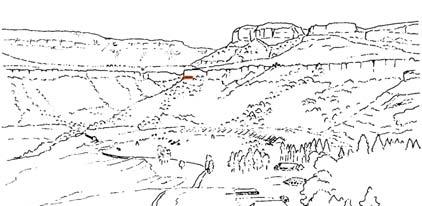
Little Switzerland (Lit 111 Dic/Hei)
HMA, May 2019 From photo, Aug 2001
Habitat: Dicroidium riparian forest (mature, type 1)
Collection: 2173 slabs, 550 man-hrs cleaving
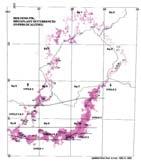
8 Lit 111 1 1. Lit 111
PRE/F/5734
Holotype R3 ×5 M5 M4 M3 M2 M1
13 10 Lit 111 BP/2/1582 pl. 124(1–5) 9 11 BP/2/1577 BP/2/1559 pl. 121(1–4) Holotype 12 BP/2/1623 4 BP/2/1582 pl. 124(1–5) R3 ×2 14 R3 ×5 15 12 cm 0 Reference palaeodeme R2 all ×1 PRE/F/1562 pl. 123 (8–10)
7 of the 9 indivs
PRE/F/21497a pl. 119(1–6)
Holotype




Kannaskoppianthus SYSTEMATICS 45
7
6 5 3
2 1 Lit 111
PRE/F/21497 pl. 119(1–6)
PB/2/1572
Holotype
Specimen: PRE/F/3205; this vol., pl. 113(1–4).
Assemblage (TC): Mat 111 Dic dub, Matatiele.
Preservation: intact strobilus, without counterpart; impression in thickly laminated, olive-grey shale with moderate cleavage.
Plant fossil names registry number: PFN002305
Reference palaeodeme
Assemblage (TC): as for holotype.
Specimens: 3 indivs (2 intact, 1 partial); this vol., pls 113–114.
Sister palaeodemes – nil.
Specific diagnosis
A Kannaskoppianthus species with small regularly forked strobili whose limbs bear 4–6 microsporophylls per row and c. 4–5 microsporangia per unit.
Specific characters
Attachment: unknown.
Strobilus: small (c. 8–10 mm long), regularly forked; microsporophylls 4–6 per row.
Microsporophyll: narrowly concavely conate (c. 1–1.5 mm wide distally); with c. 5 microsporangial attachment scars per unit.
Etymology
matatiparvus – matati, for the type locality Matatiele; parvus (Lat.), small.
Affiliation ♂() (foliage)
Rochipteris matatifolia (17 indivs); Grade 3 (most probable)
R. matatifolia is the most likely affiliate of K. matatiparvus (with 3 indivs) – R. telefolia (with 2% of the flora; rated Grade 3.5 affiliate of K. telemagnus), being the only other Rochipteris species identified at Mat 111.
Comment & comparison Molteno species
K. matatiparvus is particularly rare (3 indivs) and infrequent (1 TC) and is differentiated from K. switzianthus, the most similar species in the reduced number of microsporophyll units per limb. It is also similar to K. telepentatus which is affiliated with a very different leaf species, namely R. penensis
Petriellaceae in Mat 111 Dic dub TC
Kannaskoppianthus matatiparvus (3 indivs) Rochipteris telefolia (2%) “ matatifolia (17 indivs)
Rarity of K. matatiparvus at Mat 111 3 indivs in 65 man-hrs (1 per 2 man-days), very rare

10. Mat 111 HMA, May 2019 From photo, 31 July 1982
Matatiele (Mat 111 Dic dub)

Habitat: Dicroidium riparian forest (immature, type 2)
Collection: 1082 slabs, 65 man-hrs cleaving
Holotype
PRE/F/3205 pl. 113(1–4)
PRE/F/9082a,b pl. 115(1–4)
R2 ×5
2 1 Mat 111
PRE/F/3205 pl. 113(1–4) PRE/F/9251b pl. 113(5–10), 114 (1–5)
2 of the 3 indivs
Reference palaeodeme Reference palaeodeme
PRE/F/9080
R2 ×2
PRE/F/9076a
PRE/F/9083a,b pl. 116(5–8)













Kannaskoppianthus SYSTEMATICS 46 ISSN 2410-4418 Palaeont. afr. (2023) 57 (Special Issue): i–xiv + 1–324
10
M5 M4 M3 M2 M1
3
6
Holotype 4
7 Mat 111 5
8 BP/2/3025 PRE/F/9083b pl. 116(8) R3 ×5 9 12 cm 0
Kannaskoppianthus matatiparvus J.M.And. & H.M.And., 2003 R2 all ×1
Kannaskoppianthus komanthus J M And & H M And , sp nov J.M.And. & H.M.And., sp. nov.
Holotype
Specimen: PRE/F/3231a,b; this vol., pl. 47(1–8)
Assemblage (TC): Kom 111 Sph/Dic, Kommandantskop
Preservation: almost complete strobilis, attached with foliage, part & counterpart; impressions in thickly laminated buff-grey shale with poor cleavage.
Plant fossil names registry number: PFN002306
Reference palaeodeme
Assemblage: as for holotype.
Specimens: 2 indivs (1 fairly complete attached, 1 fragmentary); this vol., pls 47(1–8), 48(1–3).
Sister palaeodemes – nil.
Specific diagnosis
A Kannaskoppianthus species with medium irregular strobili, with c. 4 microsporophylls per row and c. 5 microsporangia per unit.
Specific characters
Attachment: strobili attached in fascicle with leaf cluster along shoot. Strobilus: medium (c. 20 mm long), irregularly forked; microsporophylls c. 4 per row.
Microsporophyll: narrowly concavely cuneate (unknown width distally), with apparently c. 5 microsporangia per unit.
Etymology
komanthus – kom, for the type locality Kommandantskop; anthus (Lat.), male
Affiliation ♂() (foliage)
Rochipteris komifolia (29 indivs); Grade 5 (certain)
This is the only attached foliage/male-strobilus pairing yet found for the Petriellales.
Comment & comparison
Molteno species
In And. & And. (2003), K. komanthus was included with K. irregularis, but is now considered a distinct species as the strobilus has less microsporophylls and the shape is cuneate. The affiliated foliage – found attached in this case – is a different species, namely R. komifolia
The leaves and strobili clearly derive from a common point of origin, but the actual point of attachment is not clear. A second specimen, PRE/F/3227, occurs closely associated with an attached cluster of leaves.
Although the tips of these attached leaves are incomplete, they compare closely in size and venation to the more complete leaves occurring at this TC, and are clearly affiliated to R. komifolia. The only other leaf is one specimen placed in R. switzifolia, with many segments.
Petriellaceae in Kom 111 Sph/Dic TC
Kannaskoppianthus komanthus (2 indivs)
Rochipteris switzifolia (1 indiv.) “ komifolia (29 indivs)
Rarity of K. komanthus at Kom 111 2 indivs in 10 man-hrs (2 per 1 man-day), rare
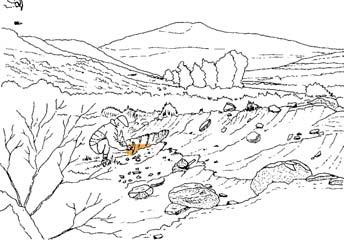
(Kom
Habitat: Dicroidium open woodland Collection: 168 slabs, 10 man-hrs cleaving

30. Kom 111
Holotype
Reference palaeodeme
PRE/F/3231a,b pl. 47(1–8)
R2 ×2
2
Rochipteris komifolia (affiliated foliage)
PRE/F/3227 ‘x’,‘y’ pl. 48(1–3) ‘y’ 3
‘x’
R2 ×2
Kom 111 4
R2 ×1
PRE/F/3227 ‘z’ pl. 48(5–8)





PRE/F/3227 ‘z’ pl. 48(6,7)
12
cm
Kannaskoppianthus SYSTEMATICS 47 ISSN 2410-4418 Palaeont. afr. (2023) 57 (Special Issue): i–xiv +
1–324
PRE/F/3231a,b pl. 47(5,8) 1 5 6
M5 M4 M3 M2 M1 30
PRE/F/3216 pl. 49(1–4)
From photo, MM, 10 Oct 1989
Kommandantskop
111 Sph/Dic),
0
HMA, 5 May 2019
Holotype
Reference palaeodeme
R3 ×5
Kannaskoppianthus lutinumerus (J.M.And. & H.M.And., 2003) emend. nov.
Holotype
Specimen: PRE/F/11433 a,b; And. & And., 2003, pl. 110(3,7,9).
Assemblage (TC): Lut 311 Hei elo, Lutherskop.
Preservation: complete very clearly preserved strobilus, part & counterpart; impression in thickly laminated, medium-grey shale with moderate cleavage.
Plant fossil names registry number: PFN002300
Reference palaeodeme
Assemblage (TC): as for holotype.
Specimens: 16 indivs (mostly intact, 1 cluster of 2); this vol., pls 53–60.
Sister palaeodemes – nil.
Specific diagnosis emended
A Kannaskoppianthus species with small regularly forked strobili whose limbs bear 5–11 microsporophylls per row and c. 10 microsporangia per unit.
Specific characters
Attachment: unknown.
Strobilus: small (c. 16–18 mm long), regularly forked; microsporophylls 5–11 per row.
Microsporophyll: narrowly concavely conate (c. 1–1.5 mm wide distally); with c. 10 very fine microsporangial attachment scars per unit.
Etymology
lutinumerus – luti, for the type locality Lutherskop; numerus (Lat.), with reference to the large number of microsporophylls per row.
Affiliation ♂() (foliage)
Rochipteris lutifolia (66 indivs); Grade 4 (exclusive)
At the type locality, the affiliation of K. lutinumerus (with 16 indivs), and Rochipteris lutifolia (with 66 indivs) is exclusive, there being no other species of either the strobilus or foliage present.
Comment & comparison
Molteno species
K. lutinumerus was previously recorded as including seven sister palaeodemes (And. & And., 2003), but with closer examination these are now placed in three newly described species, K. aasvoelensis, K. switzianthus and K. telepentatus
K. lutinumurus is similar to K. aasvoelensis in the number of microrophylls per limb (and number of microsporangia per unit). However, graphs showing the number of microsporophylls per limb for the two species plot out quite differently (Chart 3, p. 77) – with K. lutinumurus having the greater range. In detail, the best-preserved heads are distinctive (in being more obtuse and spread out than those of K. aasvoelensis) and the affiliated foliage (Grade 4, exclusive in both cases) is of a very different morphology to R. rollerii
Petriellaceae in Lut 311 Hei elo TC
Kannaskoppianthus lutinumerus (16 indivs)
Rochipteris lutifolia (66 indivs)
Rarity of K. lutinumerus at Lut 311 16 indivs in 50 man-hrs (3 per 1 man-day), rare
PRE/F/11428a pl. 58(1–6)
PRE/F/11438a,b pl. 56(1–6)
PRE/F/11427a,b pl. 60(1–8) cluster of 2
PRE/F/11429a pl. 54(1–5)
PRE/F/11431a pl. 55(1–6)
PRE/F/11433a,b pl. 53(1–8)
Holotype
PRE/F/11426b
Reference palaeodeme
PRE/F/11434a pl. 59(1–9)
9 of the 16 indivs
PRE/F/11429a,b, pl. 54(1–9)
PRE/F/11434a, pl. 59 pls 56–60 see pp 95, 138

Lutherskop (Lut 311 Hei elo), Oom Piet’s campsite Habitat: Heidiphyllum thicket Collection: 589 slabs, 50 man-hrs cleaving
Holotype
HMA, 8 May 2019 From photo, JMA, 10 April 1990 M5 M4 M3 M2 M1

R2 all ×2
PRE/F/11390a,b pl. 57(1–8)
PRE/F/11538a pl. 61(1–3)
PRE/F/11384a pl. 67(1–7)
Rochipteris lutifolia (affiliated foliage)
Reference palaeodeme
R3 ×5
PRE/F/11358a pl. 61(1–3)
Kannaskoppianthus SYSTEMATICS 48 ISSN 2410-4418 Palaeont. afr. (2023) 57 (Special Issue): i–xiv + 1–324
R2 ×2
R2 ×1
Lut 311
R4 ×5
14 13 12 11 8 7 9 6 5 4 3 2 1
Lut 311
Lut 311
Lut 311
12
36 36. Lut 311
cm 0
Kannaskoppianthus telepentatus J.M.And. & H.M.And., sp. nov.
Holotype
Specimen: PRE/F/18277a,b, pl. 42(1–8).
Assemblage (TC): Tel 111 Hei elo, Telemachus Spruit.
Preservation: intact, fairly complete strobilus (part & counterpart); impression in thickly laminated, light olive-grey shale with poor cleavage.
Plant fossil names registry number: PFN002307
Reference palaeodeme
Assemblage (TC): as for holotype.
Specimens: 2 indivs (1 intact, 1 isolated), microsporangia attached; this vol., pl. 42(1–8).
Sister palaeodemes – nil.
Specific diagnosis
A Kannaskoppianthus species with small regularly forked strobili whose limbs bear c. 5 microsporophylls per row and c. 5 microsporangia per unit.
Specific characters
Attachment: unknown.
Strobilus: small (c. 12–13 mm long), regularly forked; microsporophylls c. 5 per row.
Microsporophyll: short, concavely conate (c. 1.5 mm wide distally), with c. 5 microsporangial attachment scars per unit.
Etymology
telepentatus – tel, for the type locality Telemachus Spruit; pentatus (Lat.), referring to the 5 microsporangia.
Affiliation ♂() (foliage)
Rochipteris penensis (2 indivs); Grade 3 (probable)
Tel 111 is the only TC from which 2 species of Kannaskoppianthus have been collected (see below); it has also yielded 3 species of foliage. Given that the affiliation between K. telemagnus and R. telefolia is Graded 4 (virtually exclusive), it is most probable that K. telepentatus (with 2 indivs) and R. penensis (with 2 indivs) are affiliated. The less likely foliage affiliate, would be R. pusilla (with 1 indiv).
Comment & comparison
Molteno species
Like Kannaskoppianthus switzianthus (Lit 111) and K. aasvoelensis (Aas 111), this species was included within K. lutinumerus (Lut 311) in And. & And. (2003). However, in the detail of the microsporophylls bearing c. 5 microsporangia, it is recognized as distinct from the latter species and from K. switzianthus, in being larger than most of the nine individuals from the Lit 111 TC. It is also affiliated with a different Rochipteris species to the other three
Petriellaceae in Tel 111 Hei elo TC
Kannaskoppianthus telemagnus (2 indivs)
“ telepentatus (2 indivs)
Rochipteris telefolia (30 indivs)
“ penensis (2 indivs)
“ pusilla (1 indiv.)
Rarity of K. telepentatus at Tel 111
2 indivs in 90 man-hrs (1 per 4 man-days), very rare

32. Tel 111
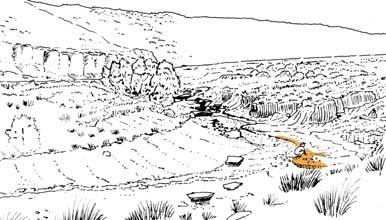
HMA, 28 July 2010
Telemachus Spruit (Tel 111 Hei elo)
Habitat: Heidiphyllum thicket Collection: 581 slabs, 90 man-hrs cleaving
Holotype
Reference palaeodeme
a b 1
R2 ×2
PRE/F/18277a,b pl. 42(1–8)
R2 ×5
dehiscent operculum immature microsporangia mature concavity arcuate scale cap
Tel 111
2
f
a b c d e R5 ×5
groove (?vascular strand)
a–e; developmental & dehiscense stages of Kannaskoppianthus microsporophylls
And. & And. (2003, p. 290)
5
8
PRE/F/17405a
PRE/F/18255
PRE/F/17405a,b
R2 all ×1
PRE/F/18255 pl. 46(8,9)
PRE/F/17405b
PRE/F/17405a,b
Tel 111 Rochipteris penensis penensis (affiliated foliage)
R2 all ×2
From photo, 24 April 1982
Proposed new combination
Kannaskoppianthus ternerae (Solms-Laubach 1899)
J.M.And. & H.M.And., comb. nov.
Basionym
Acrocarpus ternerae Solms-Laubach, 1899. pp 601–602, pl. 14(5), Q. de la Ternera, Copiapo, Chile.
Plant fossil names registry number
PFN 002310
Diagnosis/description
See Solms-Laubach (1899, pp 601, 602).
Remarks
The genus Acrocarpus belongs in the family Fabaceae and the specimen was incorrectly named. It clearly belongs to Kannaskoppianthus as described from the Molteno, but we were previously not aware of this reference (see comment, p. 42).
12 cm 0
Kannaskoppianthus SYSTEMATICS 49
ISSN 2410-4418 Palaeont. afr. (2023) 57 (Special Issue): i–xiv + 1–324
6 4 3
7
M4 M3 M2 M1
M5
32
Synonymy
Kannaskoppifolia J.M.And. & H.M.And., 2003, p. 294
Kannaskop (Kan 111), Karoo Basin, S. Africa; Carnian, Triassic.
Type species
Chiropteris lacerata sp. nov. Arber 1917, p. 27, pl. 3(8); Tank Gully, Mt Potts, New Zealand; Tank Gully Coal Measures; housed in Natural History Museum, London, catalogue number NHMUK v15671. Plant fossil names registry number: PFN002311 (for genus)
Generic diagnosis, emended
A ginkgoopsid leaf with apetiolate to partially petiolate, entire to trifidly divided cuneate to flabellate lamina with numerous segments, and subparallel, anastomosing veins with density increasing distally.
Generic characters
Attachment: several leaves borne on bulbous short shoots or spirally on slender stem.
Leaf: lamina narrowly to broadly cuneate to flabellate, apetiolate to partially petiolate, entire to trifidly deeply segmented with few to numerous segments; veins fine, forking, radiating, subparallel and anastomosing to form a variously elongated mesh, density increasing distally.
Cuticle: as described by And. & And. (2003); repeated here, p. 51.
Etymology
Rochipteris – named by Herbst et al. (2001), inverting the spelling to replace the genus name Chiropteris previously in use for some of these leaves.
Global range – 24 spp., Gondwana, Tr. (LAD–RHA).
First: Rochipteris (Ginkgoites sp.), (Walkom, 1925a); L. Newport Fm., Turrimetta Head, Sydney, Australia.
Last: Rochipteris (Chiropteris copiapensis), (Solms-Laub. & Steinm., 1899); Ternera Fm., Quebr. La Ternera, Copiapo, Chile.
Gondwana Triassic occurrence
Frequency (F): 22 degree squares (of the 84 across Gondwana). Ubiquity (U): 4 continents (of 5 comprising Gondwana).
Diversity (D): 24 foliage species.
Abundance (A): <1% (the norm in Molteno TCs).
Longevity (L): 44 myrs (Olenekian to Rhaetian).
Colonization success: FUDAL rating 22/4/24/–/44 = 94. Intermediate success (Grade 3); Rochipteris was the 4th most prominent gymnosperm foliage genus in the Gondwana Triassic (And. & And., 2003, tab. 27); it was ubiquitous, diverse, long-enduring and relatively frequent, but generally lacking in abundance.
FUDAL ratings of the top 5 gymnosperm foliage genera in the GT:
1. Dicroidium – 188
2. Heidiphyllum – 147
3. Sphenobaiera – 99
4. Rochipteris – 94
5. Taeniopteris – 69
Endemism: one species occurs widely distributed on three continents, while at the other end of the scale, four species from the Molteno are singleassemblage endemics.
Molteno occurrence
Frequency (F): 26 TCs (of 100 sampled in the Molteno).
Diversity (D): 12 species.
Abundance (A): common (3–5%) in 1 TC; occasional (2%) in 2 TCs; and <1% in the other 23 TCs.
Habit: slender, erect, woody shrubs (see Part 3).
Preferred habitat: occupied a wide range of habitats, but principally Dicroidium riparian forest, Heidiphyllum thicket and fern meadows of riverine sandbanks and floodplain wetlands.
Adaptive radiation (Molteno species, see Tab. 3, p. 52).
We currently recognize 12 species of Rochipteris, as described here. Very interestingly, the species in many instances coincide with different habitats, suggesting that they are biologically and ecologically distinct entities.
Affiliated organs
Female strobilus: Kannaskoppia – Grade 5 (Org. att.).
Male strobilus: Kannaskoppianthus – Grade 5 (Org. att.).
Classification & comparison
Suprageneric classification
As Rochipteris is known attached to both male and female affiliates, the classification is based on the ovulate strobilus Kannaskoppia (p. 34).
Intergeneric comparison
Such leaves were frequently classified as Chiropteris or Ginkgoites prior to Retallack (1980a) placing them in Ginkgophytopsis. Herbst et al. (2001) placed these leaves in a new genus Rochipteris. Concurrently And. & And. (1997, 2003) studied similar leaves from the Molteno and in view of the proven affiliation of attached leaves with male and female strobili erected the genus Kannaskoppifolia (And. & And., 2003). Holmes & Anderson (2005) later proposed that Kannaskoppifolia be used for attached leaves and Rochipteris for isolated leaves. Bomfleur et al. (2014) objected to this proposal and made Kannaskoppifolia a junior synonym of Rochipteris which is followed in this study. And. & And. (2003) suggested that Ginkgophytopsis be restricted to Devonian and Carboniferous leaves as dealt with by Høeg (1967), who included the genus in the order Palaeophyllales and placed the Gondwana Chiropteris leaves with a distinct petiole in a new genus Batiopteris. From the Early Permian of China a Chiropteris has been described in organic connection with the ovuiferous organs of Nystroemia by Wang et al. (2003). These bear bicornute platyspermic seeds which show no resemblance to the cupules of Kannaskoppia. Holmes & Anderson (2005) from the Nymboida Flora, described leaves somewhat similar to Rochipteris (also attached in whorls to a gracile axis) but with dichotomizing venation as Walkomiopteris
Other reticulate leaves from the Molteno, such as Gontriglossa, Graciliglossa and Cetiglossa, all have a distinct midrib similar to that in Glossopteris (Permian) and Sagenopteris (Jurassic) leaves.
Eoginkgoites Bock from the Upper Triassic Newark Group and the Chinle Fm., U.S.A. (Ash, 1976, 1977) has anastomosing venation and syndetocheilic stomata, but differs in the finer venation, a marginal vein, pinnate form ‘and its papillate cuticle’. Ash (1976, p. 1329) suggested a relationship with the Bennettitales rather than the Ginkgoales.
Gondwana Triassic (elaborated)
Herbst et al. (2001) erected the new genus Rochipteris for some Gondwanic leaf species previously assigned to Chiropteris Kurr ex Bronn. They describe five species of Rochipteris, two being new, from the Upper Triassic of Argentina and Chile. Kannaskoppifolia (And. & And., 2003) was considered a junior synonym of Rochipteris by Bomfleur et al. (2014) and this is accepted here. However, the South American foliage apparently yields no cuticle and there is no mention of female or male fruit affiliates.
Barone-Nugent et al. (2003) adopted the name Rochipteris for two new species and a third unnamed species from the Ipswich Coal Measures, the Leigh Creek Coal Measures and the Springfield Basin of the Upper Triassic of eastern Australia. As for the South American material, there occurs no affiliated fruit such as described here from the Molteno, but cuticle is illustrated and described for the Leigh Creek species. This cuticle is, in many respects, very different from that which we find characterizing the Molteno species. In particular, the stomata appear not to be transverse and the cells are isodiametric (almost square over the veins), not oblong. Furthermore, there are six subsidiary cells and these are clearly lappetate. The Molteno stomata are paracytic and nonlappetate. However, certain specialized cells (trichomes or glands) are remarkably similar. The leaf morphology, with its markedly expanded clasping base, is likewise rather different from the Molteno Rochipteris species.
Rochipteris is a widespread element throughout the Gondwana Triassic. It is recorded in the literature from eight ‘localities’ (c. 88 indivs illustrated) in S. America (Chile, N. Argentina, S. Argentina), 15 ‘localities’ in Australasia (Queensland, NSW, Victoria, South Australia and New Zealand) and two localities from Antarctica. Some of the published illustrations are insufficiently clear to show whether the venation anastomoses or not. In such instances one might be confusing this genus with Sphenobaiera, which can appear superficially similar (especially where specimens tend towards a bifurcating rather than trifurcating division of the lamina). The abundance of Rochipteris is rarely, if ever, clearly stated in the literature. The general impression is that it is uncommon, as in the Molteno.
SYSTEMATICS 50 ISSN 2410-4418 Palaeont. afr. (2023) 57 (Special Issue): i–xiv + 1–324
Rochipteris
Rochipteris (Herbst et al., 2001) emend. J.M.And. & H.M.And.
Cuticles
Potential sample: Lit 111, 51 indivs; Umk 111, 42 indivs.
Macerated (And. & And., 2003): Lit 111, 35 indivs; Umk 111, 30 indivs; only a few indivs yielded good cuticle.
Preservation grade: Grade 4, features clear, fair-sized pieces.
Diagnostic characters: cells isodiametric to oblong (linear over vein areas), walls gently curved; stomata hypostomatic, nonpapillate, interveinal, transversely orientated; subsidiary cells paracytic, noncutinized, nonlappetate, guard cells narrowly elliptic; specialized cells isodiametric to circular, strongly cutinized.
Comment: The specialized cells may be trichome bases or, in appearing strongly cutinized, glands. They occur scattered on the upper and lower cuticle. Such cells have not previously been recorded from the Molteno.
Significance
Classification – The transversely orientated, paracytic stomata make the cuticle of Rochipteris quite unique amongst the Ginkgoopsida. The only other taxon with clear paracytic stomata in the Molteno is Gontriglossa verticillata placed in the Gnetopsida. The latter has digitate amorphous cells and the stomata are orientated randomly in the interveinal areas.
The different species of Rochipteris from Lit 111 and Umk 111 all exhibit distinctive cuticles. That from the single specimen of R. vincularis from Lit 111 is used here to illustrate the generic characteristics. The second species, R switzifolia from Lit 111, and R rollerii from Umk 111 both show papillate epidermal cells. While the other common species from Umk 111, R obtriangulata has yielded only poorly preserved cuticle, it does show the diagnostic stomata and specialized cells. The remaining two species (each represented by one individual) yield potential cuticle but have not been macerated or studied.
Affiliations – Cuticular correspondence between the leaf and male strobilus is not clear on present evidence and affiliation is based on direct attachment.
Lit 111 PRE/F/5641 prep. no. 973 lower cuticle×100
Rochipteris

Rochipteris SYSTEMATICS 12 cm 0 51 ISSN 2410-4418 Palaeont. afr. (2023) 57 (Special Issue): i–xiv + 1–324
Kan 111 PRE/F/13536 R2 ×1 megaplant-bearing formations beds with Rochipteris (& affiliates) with megaplant-bearing formations squares with Rochipteris Productive degree squares Productive formations Rochipteris
vincularis upper cuticle 1
ChNASAPaLuZaLiKaWHPlTANZCaSAGaBoCMNESyViTa UPPER R N C M L A L Triassic 201 209 227 237 242 247 252 Period Epoch Stage Ma 210 220 230 240 250 O I Molteno Fm 1–10: degree squares : superlocalities 3 1 2 4 5 6 7 10 9 8 productive degree squares
Triassic Molteno localities with Rochipteris
SAmSAfIndAntAus
Gondwana
Map 3.
TCs assemblages (taphocoenosis)
Members R o c h i p t e r i s Rochipteris R. vincularis (Kan 111) “ telefolia (Tel 111) “ distivena (Kan 112) “ rollerii (Aas 111) “ switzifolia (Lit 111) “ matatifolia (Mat 111) “ komifolia (Kom 111) “ lutifolia (Lut 311) “ obtriangulata (Umk 111) “ cf. sinuosa (Umk 111) “ penensis (Pen 411) “ pusilla (Pen 311) “ sp. Dicr. rip. forest (t.1) Dicr. rip. forest (t.2) Dicr. woodland Sphenobaiera woodl. Heidiphyllum thicket Equisetophyte marsh fern/ Kannask. meadow Dicroidium Sphenobaiera Heidiphyllum horsetails ferns
()
123456789101112
1234567
1Cal 211Hei elo T 5 55 ✓ 75 – 20
2Gre 121Hei elo
Rochipteris occurrence in the Molteno Fm.
Taphocoenoses: occurs in 26 of the 100 sampled TCs.
Members: occurs in the 1st 5 of the 6 Molteno Members; but most frequently in the Indwe Member (2).
Diversity: 12 species of Rochipteris recognized.
Habitat: the genus occurs in all 7 habitats identified; but most frequently in the Heidiphyllum thicket (11 of 26 TCs).
Dominants: Heidiphyllum & Dicroidium are clearly the most abundant associates of Rochipteris.
Abundance: bold – % mild – indivs
1. R. vincularis And. & And., 2003
2. R. telefolia And. & And., sp. nov.
3. R. distivena And. & And., sp. nov.
4. R. rollerii (Frenguelli 1946) Bodnar et al., 2020
5. R. switzifolia And. & And., sp. nov.
6. R. matatifolia And. & And., sp. nov.
7. R. komifolia And. & And., sp. nov.
8. R. lutifolia And. & And., sp. nov.
9. R. obtriangulata Holmes & H.M.And., 2005
10. R. cf. sinuosa Holmes & H.M.And., 2005
11. R. penensis And. & And., sp. nov.
12. R. pusilla Holmes & H.M.And., 2005
Rochipteris SYSTEMATICS 52 ISSN 2410-4418 Palaeont. afr. (2023) 57 (Special Issue): i–xiv + 1–324
Tab. 3. Rochipteris – Molteno occurrence.
Qiba 4 22–––22–––––––– ✓ ––3– 98 202 3 “ 111Equ sp 1–––––––––––– 1––––– ✓ – 2 97 1 4Boe 112Dic cor 1–––––––––––1––– ✓ 99 –144–5Cyp 111Dic cra 832–––1––80––––––– ✓ 75 – 24 –4 6Kan 112Hei elo Mayaputi 3 19–2410––––––21 ✓ 1 – 98 67 7 “ 111Ast spA 55 ✓ 102263 8Tel 111Hei elo 33–30––––––––21 ✓ 6 – 89 4858 9Kom 111Sph/Dic 30––––1–29–––––––– –✓ 3960 –15 1 10Vin 111Dic odo 22–––––––––––––– ✓ 70 4 28 –2 11Lut 311Hei elo 66–––––––66–––– ✓ ––5829 99 303 12Kon 211Ast 2spp Indwe 2 f 5–––5–––––––– ✓ 2052 13Pen 311Hei elo 41–––34––––––52 ✓ 25 – 75 511 14 “ 411 “ “ 80–––70––––––10– ✓ 13– 9423 15Kap 111Dic/Ris e 6––26–––––––––– ✓ 50 2025 10 4 16Nuw 111Dic zub d 3–––––––3––––––– ✓ 7030 ––4 17Win 111Hei elo 5–––3–––1–1–– ✓ 10 – 79 23 18Hla 213Dic elo b 8–––44––––––––– ✓ 89 49 1 1132 19Umk 111Dic 2spp 50–––21–––1199––– ✓ 695721 20San 111Dic cra 3–––3–––––––––– ✓ 90 – 5 21 21Mat 111Dic dub 2 – 2 –––17–––––––– ✓ 89 18 4 207 22Lit 111Dic/Hei a 561–––55–––––––– ✓ 50123 1010 23Aas 111Hei elo Bamboesberg 1 2 2 ✓ ––71 77 10 20 24 “ 211Hei elo 191––18–––––––– ✓ 99 –2 25 “ 311Hei elo 261––25–––––––– ✓ ––159 99 –2 26 “ 411Dic/Sph 150–––150–––––––– ✓ 60301 7524 Total TCs 267321441151244 124421112 Total individuals %%% 6 % 61172915119101951 Foliage speciesHabitatDominants



Cyp

palaeodeme Tel
Rochipteris SYSTEMATICS 12 cm 0 53 ISSN 2410-4418 Palaeont. afr. (2023) 57 (Special Issue): i–xiv + 1–324 R. telefolia
BP/2/3386
Kan 112
R. distivena
PRE/F/3216
PRE/F/9082a,b
PRE/F/19020b
Kan 111 PRE/F/13545 1 2 3 4 5 6 7 Umk 111 BP/2/115 Umk 111 BP/2/539 R2 all ×1 10 9 11
311 PRE/F/16915b 12
Kom 111
Lit 111 BP/2/1559 Mat 111
R. matatifolia Aas 311
Sister palaeodeme
Pen
R. vincularis
Rochipteris
R. rollerii
R. switzifolia
R. komifolia
R. lutifolia
R. obtriangulata
R. cf. sinuosa
R. penensis
R. pusilla
Sister palaeodeme
111 PRE/F/18899a 8 Sister
Showing the 12 species of Rochipteris recognized in the Molteno (all but figs 4, 8 & 11 are illustrated by indivs from the Reference palaeodemes). 111 PRE/F/17405
Rochipteris vincularis (J.M.And. & H.M.And., 2003) comb. & emend. nov.
Holotype
Specimen: PRE/F/13521; And. & And., 2003, p. 294, pl. 106(1).
Assemblage (TC): Kan 111 Ast spA, Kannaskop.
Preservation: a portion of shoot with 7 leaves attached, without counterpart; impression in thickly bedded, moderately baked, greenish grey silty mudstone, with very poor cleavage.
Plant fossil names registry number: PFN002314
Reference palaeodeme
Assemblage (TC): as for holotype (pls 23–40; figs pp 67, 68)
Specimens: 5% of assemblage (c. 45 slabs); 4 sections of shoot with foliage and megasporophylls attached; 12 sections of shoot with foliage only; >25 detached leaves; foliage generally torn or twisted (pp 66–68).
Sister palaeodemes – 6
Cal 211 Hei elo: 5% (pls 1, 2)
Cyp 111 Dic cra: 2 indivs
Vin 111 Dic odo: 2 indivs (pls 51, 52)
Lit 111 Dic/Hei: 1 indiv.
Aas 211 Hei elo: 1 indiv.
Aas 311 Hei elo: 1 indiv.
Specific diagnosis, emended
A Rochipteris species of intermediate size with obtriangulate lamina irregularly divided to one-third depth, and with closely spaced anastomosing venation.
Specific characters
Attachment: leaves on long shoots in irregular helical arrangement; leaves on short shoots in fascicles with female strobili.
Leaf: obtriangulate, of intermediate size (up to 70 × 20 mm); lamina entire to one-third depth and divided to various segments; base sharply angled; veins closely spaced, c. 20 per cm at midway.
Etymology
vincularis – vinculum (Lat.), link, bond, with reference to the fruit and foliage being found in organic connection at the type locality.
Affiliated organs ()♀ ♀ (female strobilus)
Kannaskoppia vincularis (50 indivs); Grade 5 (attached)
The Kan 111 TC is unique in not only being the single site to have yielded female strobili, but with many specimens (50 indivs) of which 5 show mutual foliage/strobilus attachments.
Comment & comparison
Molteno species
R. vincularis is unique in the Molteno and Gondwana in having numerous ovuliferous strobili (c. 50 specimens) undoubtedly affiliated, including five specimens showing clear attachment of fruit and foliage to sections of shoot. The strobili are unique to Kan 111 Ast spA, with its abundance of foliage (5% of the assemblage) clearly of the single species. No other Rochipteris species were found at the site after 30 man-hours of cleaving.
The closest foliage species are R. obtriangulata (Umk 111 Dic 2spp) and R. telefolia (Tel 111 Hei elo), which show distinctive differences. The first being entire, the latter deeply divided.
Gondwana Triassic species (non-Molteno)
For a discussion of the somewhat similar leaves, R. lacerata and R. incisa, consult introduction to the Hypodigm (pp 102, 103).
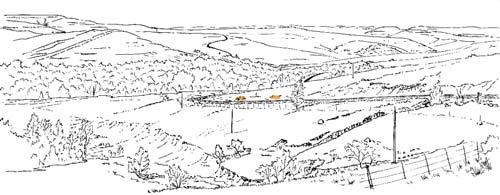
Kannaskop (Kan 111 Ast spA)
Habitat: Fern/Kannaskoppia meadow
Collection: 365 slabs, 30 man-hrs cleaving
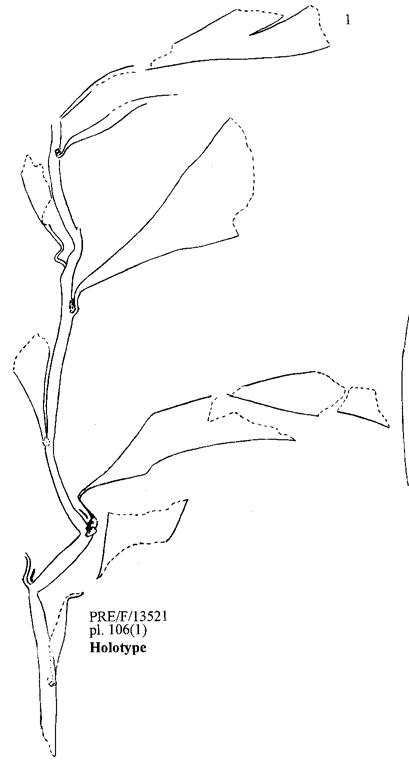
Holotype (for foliage)
PRE/F/13521 pl. 39 (1,2)
Reference palaeodeme
PRE/F/13536 pl. 37(1–5)

PRE/F/13545 pl. 36(3,4)


all R2
Holotype (for ♀ strobilis)
Kan 111
Rochipteris SYSTEMATICS 54 ISSN 2410-4418 Palaeont. afr. (2023) 57 (Special Issue): i–xiv + 1–324 PRE/F/13487a‘y’ pl. 23(1–3), 24(1–3) ×1 Kannaskoppia vincularis (attached ♀ strobilus) 4 12 cm 0
M5 M4 M3 M2 M1
HMA, 15
photo, 1
16 16. Kan 111
Aug 1996 From
Sept 1993
×1.5 3 ×1
1
2
×1
Rochipteris telefolia J.M.And. & H.M.And., sp. nov.
Holotype
Specimen: PRE/F/17414; pl. 43(1–3)
Assemblage (TC): Tel 111 Hei elo, Telemachus Spruit
Preservation: fairly complete, clear venation, without counterpart; impression in thickly laminated, light olive-grey shale with poor cleavage.
Plant fossil names registry number: PFN002316
Reference palaeodeme
Assemblage (TC): as for holotype (pls 43–46; figs pp 69–71)
Specimens: 30 slabs (27 isolated leaves, 2 attached, 1 cluster) attached (foliage only) – 1 slab; 5 leaves (3 att., 2 in clear orientation) 1 slab; c. 8 leaves (undoubted, based on orientation of leaves). clusters – 1 slab; 3 leaves.
Sister palaeodemes – 2
Kan 112 Hei elo: 2 indivs
Mat 111 Dic dub: 2% (pls 117, 118)
Specific diagnosis
A Rochipteris species of large size with broadly obtriangulate lamina irregularly divided to mid-depth, and with closely spaced anastomosing venation.
Specific characters
Attachment: leaves interpreted as being generally attached in clusters of 4 to bulbous leaf cushions (Chart 2, pp 126, 127).
Leaf: obtriangulate, of large size (up to >130 by c. 70 mm); lamina multiply and variously divided to mid-depth; veins closely spaced, c. 15 per cm midway, with anastomoses frequent throughout from petiole to distal margin.
Etymology
telefolia – tele, for the type locality Telemachus Spruit; folia (Lat.), foliage.
Affiliated organs ()♂ (male strobilus)
Kannaskoppianthus telemagnus (2 indivs); Grade 3.5 (most probable)
Though 3 species of Rochipteris and 2 species of Kannaskoppianthus occur at Tel 111, this affiliation is considered very probable considering the large size of each, and the exclusiveness of K. telemagnus (2 indivs; 1 intact, 1 partial) to Tel 111.
Comment & comparison
Molteno species
Given the excellently represented Ref. pal. from Tel 111 (30 indivs), including three specimens showing attachment or clustering (p. 70) –there is no doubt about the distinctiveness of this species. It differs from R. vincularis by the deeper divisions and larger size of the leaf. A second good palaeodeme derives from a Dicroidium riparian habitat at Mat 111 Dic dub (pls 117, 118; pp 72, 73).
Gondwana Triassic species (non-Molteno)
For a discussion of the somewhat similar leaves, R. lacerata and R. incisa, consult introduction to the Hypodigm (pp 102, 103).

Reference palaeodeme
Holotype (for foliage)
PRE/F/17414 pl. 43(1–3)
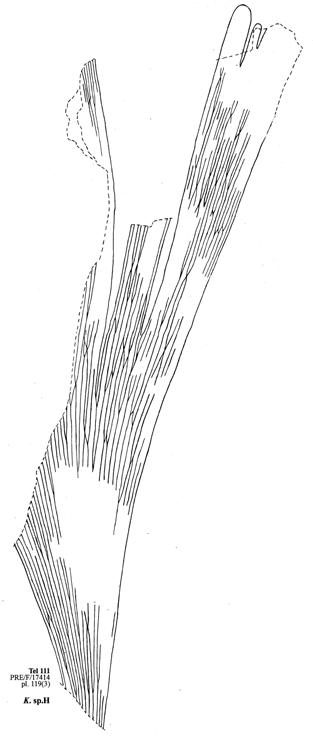
Tel 111

Tel 111
Rochipteris SYSTEMATICS 55 ISSN 2410-4418 Palaeont. afr. (2023) 57 (Special Issue): i–xiv + 1–324 12 cm 0 M5 M4 M3 M2 M1 32 32. Tel 111 From photo, 24 April 1982 Telemachus Spruit (Tel 111 Hei elo) Habitat: Heidiphyllum thicket Collection: 581 slabs, 90 man-hrs cleaving HMA, 28 July 2010 2 PRE/F/12876 pl. 46(1–3) 1 3 PRE/F/18268 pl. 43(7,8) Holotype PRE/F/7711 pl. 41(1–6) R2 ×1 Kannaskoppianthus telemagnus (affiliated ♂ strobilus) 4
Rochipteris distivena J.M.And. & H.M.And., sp. nov.
Holotype
Specimen: BP/2/3386; pl. 21
Assemblage (TC): Kan 112 Hei elo, Kannaskop (Upper end).
Preservation: complete leaf with clean venation, without counterpart; impression, in very thinly bedded, moderately baked, medium-grey shale, with poor cleavage.
Plant fossil names registry number: PFN002317
Reference palaeodeme
Assemblage (TC): as for holotype (pls 21, 22; figs p. 74)
Specimens: 4 indivs; attached and clusters nil.
Sister palaeodemes – 1
Kap 111 Dic/Ris: 2 indivs (pl. 89)
Specific diagnosis
A Rochipteris species of intermediate size with cuneate irregularly divided lamina to mid-depth, and with widely spaced anastomosing venation.
Specific characters
Attachment: unknown (for foliage); male strobili known attached to a narrow stem.
Leaf: broadly obtriangulate, of intermediate to large size (up to c. 90 by 55–75 mm); upper half of lamina divided 2–3 times into irregular segments; veins widely spaced, c. 10 veins per cm at midway, to more closely spaced at tip with c. 18 veins per cm.
Etymology
distivena – (Lat.), widely spaced veins.
Affiliated organs ()♂ (male strobilus)
Kannaskoppianthus irregularis (5 indivs); Grade 3.5 (very probable)
Both R. distivena (4 indivs) and K. irregularis (5 indivs) are unique to Kan 112, and although both are uncommon, the affiliation is very probable.
Comment & comparison
Molteno species
The leaves of this species have widely spaced veins to more closely spaced distally, fining markedly to the tips. The only other species with widely spaced veins and divided lamina is R. cf. sinuosa from Umk 111 which differs in the lamina being flabellate and deeply divided to around one-third from the base. In overall shape, it is similar to leaves with multiple segments in the upper part of the lamina such as R. telefolia and R. vincularis which have much finer venation. From Kap 111 Dic/Ris, two fragmentary leaves are provisionally compared to this species as they show widely spaced venation (pl. 89). A leaf collected by Du Toit from Umk 111 and originally described as Chiropteris copiapensis (Du Toit, 1927, t-fig. 3B) possibly belongs to this species since, although incomplete, the base is cuneate and the venation similarly widely spaced.
The single indiv. from Gre 111 Equ sp (p. 101, pl. 7(1–7)), referred to as Rochipteris sp., is closest to R. distivena, in having similar divided tips and open venation, but lacks the characteristic deep division of the leaf and is of much smaller size, which suggests it may represent a distinct species.
Gondwana Triassic species (non-Molteno)
Chiropteris lacerata Arber 1917 (p. 27, pl. 3(8)), from the Tank Gully Coal Measures, Mt Potts, New Zealand, is based on a single incomplete specimen. It has lacerate tips and is similar in overall shape and size, but is missing the lower third to the diagnostic base, and has distinctly finer venation in the upper third. See also Rochipteris lacerata (Arber, 1917) Herbst et al. (2001), S. Argentina. Consult introduction to Hypodigm (p. 102).
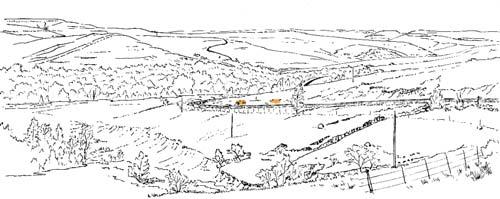
Kannaskop (Kan 112 Hei elo), Upper End Habitat: Heidiphyllum thicket Collection: 145 slabs, 15 man-hrs cleaving
Reference palaeodeme
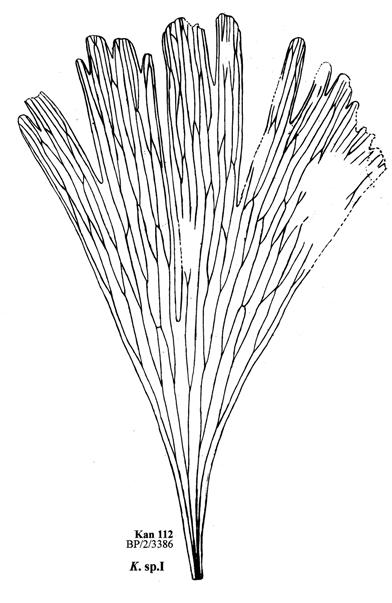
PRE/F/20120 pl. 21(1–5)
R2 ×1
Kan 112
HMA, 15 Aug 1996 From photo, 1 Sept 1993




16
16. Kan 112
PRE/F/20114a,b pl. 20(1–6)
Holotype
PRE/F/20114a,b pl. 19(1–6), 20(1–6)
R2 ×2
Kan 112
Kannaskoppianthus irregularis (affiliated ♂ strobilus)
Rochipteris SYSTEMATICS 56 ISSN 2410-4418 Palaeont. afr. (2023) 57 (Special Issue): i–xiv + 1–324
3 BP/2/3386 R2 ×1 Holotype 1 12 cm 0
M3
M5 M4
M2 M1
2
R2 ×1.5
R3
R3
4 BP/2/3386 BP/2/3386 5 6
×5
×5
Rochipteris rollerii (Frenguelli, 1946) Bodnar et al., 2020
Lectotype
Specimen: LPPB 20770a, Bodnar et al., 2020, p. 9, fig. 5A.
Assemblage (TC): Puesto Miguez, Cacheuta Hill, Mendoza Province, Argentina.
Preservation: compression in fine-grained shale.
Plant fossil names registry number: PFN002344
Plant fossil names registry number: PFN002345 (Lectotype)
Reference palaeodeme
Assemblage (TC): Aas 111 Hei elo, Aasvoëlberg (Turner shale) (pls 131–142; figs p. 84); impressions in thickly laminated, light-grey shale with moderate cleavage.
Specimens: 2% of assemblage (c. 50 slabs; c. 75 indivs). attached – nil
clusters – 6 slabs; c. 20 indivs (×1), 5 indivs (×1), 2–3 indivs (×4)
Sister palaeodemes – 13
Gre 121 Hei elo: 22 indivs (pls 4–6), 4 clusters; ♂ affil., 2 indivs (pl. 3)
Kan 112 Hei elo: 10 indivs
Kon 211 Ast 2spp: 5 indivs (pls 69–72), 4 clusters
Pen 311 Hei elo: 34 indivs (pls 73–76), 1 cluster
Pen 411 Hei elo: 70 indivs (pls 81–86); ♂ affil., 4 indivs (pls 79, 80)
Kap 111 Dic/Ris: 6 indivs (pl. 90)
Win 111 Hei elo: 3 indivs (pl. 92)
Hla 213 Dic elo: 4 indivs (pls 95, 96)
Umk 111 Dic 2spp: 21 indivs (pls 97–102)
San 111 Dic cra: 3 indivs (pls 111, 112)
Aas 211 Hei elo: 18 indivs (pl. 144); ♂ affil., 1 indiv. (pl. 143)
Aas 311 Hei elo: 25 indivs (pls 148–152); ♂ affil., 4 indivs (pls 145–147)
Aas 411 Dic/Sph: 150 indivs (pls 157–162); ♂ affil., 21 indivs (pls 153–156)
Specific concept
A Rochipteris species of small to intermediate size with flabellate lamina deeply divided mainly 1–2 times, and with closely spaced anastomosing venation.
Specific characters
Attachment: unknown.
Leaf: flabellate, of small to intermediate size (up to c. 45–50 × 35 mm); lamina deeply divided mainly 1–2 times, ranging from 2–13 segments; veins closely spaced, c. 25 per cm midway.
Etymology
rollerii – named by Frenguelli (1946, p. 103) in honour of the collector Rolleri.
Affiliated organs ()♂ (male strobilus)
Kannaskoppianthus aasvoelensis (21 indivs); Grade 4 (mutual occurrence)
At Aas 111 there occurs just the one species of Rochipteris (2%) and one species of the male strobilis (21 indivs) – both in significant numbers –providing good evidence for affiliation. The same affiliation also occurs at another 5 TCs (Gre 121, Pen 411, Aas 211, Aas 311, Aas 411, Chart 6, p. 12).
Comment & comparison
Molteno species
R. rollerii, recognized in 14 of our Molteno TCs yielding specimens of the genus, is the most frequent and abundant of the 12 Rhochipteris species in the formation. The leaves show a wide range of variation, as evident from the set of line drawings representing nine of the palaeodemes, and from the histograms plotting the degree of division of the laminae.
R. switzifolia, from 5 Molteno TCs, is closely similar, but the histogram for its Ref. pal., Lit 111 Dic/Hei (with 55 indivs), plots quite differently with many leaves far more divided. There occurs some overlap in morphology involving the smaller less-divided leaves (pp 76, 77).
Gondwana Triassic species (non-Molteno)
R. rollerii is common at the type locality in Argentina and the Molteno palaeodemes compare well with the original and subsequent collections of leaves in shape and size. As yet no fertile affiliates are known at the type locality. Consult introduction to Hypodigm (p. 103) for further discussion on this species and the similar R. alexandriana.

BP/2/4306
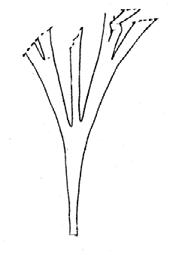
PRE/F/15222 pl. 138(12, 13)
PRE/F/19529 pl. 141(5)
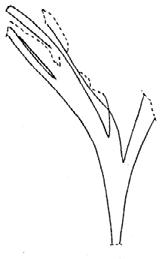
PRE/F/19019 pl. 152(1–3)
Sister palaeodeme

PRE/F/19020b pl. 151(1–7)
PRE/F/15244b pl. 126(1–3)
PRE/F/19484 pl. 126(4–7)
Kannaskoppianthus aasvoelensis (affiliated ♂ strobilus) Aas


PRE/F/19545 pl. 128(5–10)
R2 ×1
Rochipteris SYSTEMATICS 57 ISSN 2410-4418 Palaeont. afr. (2023) 57 (Special Issue): i–xiv + 1–324
Holotype 9 Aas 311 R2 all ×1 Aas 111 R2 all ×2
4
: Heidiphyllum thicket Collection: 291 slabs, 40 man-hrs cleaving M5 M4 M3 M2 M1 24 24. Aas 111 1 2 3 6 7 8
PRE/F/19547b pl. 125(5–9)
HMA, May 2019 From photo,
June 1971 Aasvoëlberg (Aas 111 Hei elo), Turner Shale Habitat
PRE/F/19547b pl. 125(5–9)
Holotype
5
4
111 R2 ×2
10 12 cm 0 Reference palaeodeme R3 ×5
Rochipteris switzifolia J.M.And. & H.M.And., sp. nov.
Holotype
Specimen: PRE/F/1559, pl. 121(1–4)
Assemblage (TC): Lit 111 Dic/Hei, Little Switzerland. Preservation: almost complete leaf, proximal end of ‘petiole’ missing, without counterpart; compression, in thinly laminated, carbonaceous (cuticle), dark-grey shale, with moderate cleavage.
Plant fossil names registry number: PFN002318
Reference palaeodeme
Assemblage (TC): as for holotype (pls 121–124; figs p. 88)
Specimens: 55 indivs; attached and clusters nil.
Sister palaeodemes – 3
Cyp 111 Dic cra: 1 indiv.
Kom 111 Sph/Dic: 1 indiv.
Hla 213 Dic elo: 4 indivs (pls 94, 95(1–3))
Specific diagnosis
A Rochipteris species of small to intermediate size with flabellate lamina deeply divided mainly 2–3 times, and with closely spaced anastomosing venation that conjoins towards base in a very short petiole.
Specific characters
Attachment: unknown.
Leaf: flabellate, small to intermediate in size (up to 50–60 mm in length and width); lamina deeply divided from 2–4 times, ranging from 5–28 segments; veins closely spaced, c. 20 per cm midway, conjoining for c. 1 mm at base in a very short petiole.
Etymology
switzifolia – switzi, for the type locality Little Switzerland; folia (Lat.), foliage.
Affiliated organs ()♂ (male strobilus)
Kannaskoppianthus switzianthus (9 indivs); Grade 4 (virtually exclusive) This well-sampled foliage palaeodeme of 55 indivduals can be clearly affiliated with the only male strobilus occurring at Lit 111. The only other foliage species present (at Lit 111) is R. vincularis, with a single specimen.
Comment & comparison
Molteno species
The smaller less-divided leaves of the palaeodeme show an overlap with the R. rollerii palaeodemes in the Molteno, while the larger more divided leaves are distinct. These larger leaves are similar to those in the palaeodeme from Mat 111 (R. matatifolia), and are separated by their distinctly shorter section of conjoined venation in the base of the leaves R. matatifolia shows a distinct ‘petiole’ with conjoined veins. Interestingly, R. rollerii is found mainly in Heidiphyllum thicket habitats.
Gondwana Triassic species (non-Molteno)
Rochipteris alexandriana Herbst et al. (2001); S. Argentina. The definition of this species is problematic as discussed in the introduction to Hypodigm (p. 103). It may belong to R. rollerii or, with further collections and study, be shown to be a valid species. However, R. alexandriana as subsequently applied to Antarctic fossils by Bomfleur et al. (2014), probably belongs here or elsewhere.
Rochipteris rollerii (Frenguelli, 1946) Bodnar et al. (2020), N. Argentina. There is some overlap with this species as discussed above.

Little Switzerland (Lit 111 Dic/Hei)
Habitat: Dicroidium riparian forest (mature, type 1)
Collection: 2173 slabs, 550 man-hrs cleaving
BP/2/1582 pl. 124(1–5)
BP/2/1559 pl. 121(1–4)

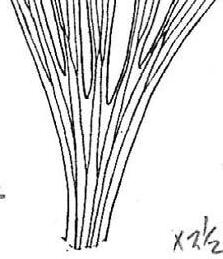
PRE/F/1562 pl. 123(8–10)
BP/2/1577
PRE/F/21497
May 2019 From photo, Aug 2001




PRE/F/5940

PRE/F/5942a,b pl. 120(1–3)
PRE/F/21497 pl. 119(2,3,6)
Rochipteris SYSTEMATICS 58 ISSN 2410-4418 Palaeont. afr. (2023) 57 (Special Issue): i–xiv + 1–324
R2 all ×2
pl. 120(4) Holotype Kannaskoppianthus switzianthus (affiliated ♂ strobilus) 12 cm 0 M5 M4 M3 M2 M1 1 1. Lit 111
119(1–6)
pl.
R3 ×5
HMA,
5 2 10 11 12 13 R2 ×2 R2 ×5 PRE/F/5638 pl. 123(1–4) 6 7 Lit 111 Lit 111 BP/2/1582
R3 ×2 8 9 Lit 111
PB/2/1572
pl. 124(1–5)
1 3
4 Reference
R2 all ×1 R3 ×5
Holotype
palaeodeme Reference palaeodeme
Rochipteris matatifolia J.M.And. & H.M.And., sp. nov.
Holotype
Specimen: PRE/F/9082a,b, pl. 115(1–4).
Assemblage (TC): Mat 111 Dic dub, Matatiele.
Preservation: almost complete leaf, proximal end of ‘petiole’ missing, part & counterpart; impression in thickly laminated, olive-grey shale with moderate cleavage.
Plant fossil names registry number: PFN002319
Reference palaeodeme
Assemblage (TC): as for holotype (pls 115, 116; figs pp 90, 91)
Specimens: 17 indivs; attached and clusters nil.
Sister palaeodemes – nil.
Specific diagnosis
A Rochipteris species of small to intermediate size with flabellate lamina deeply divided mainly 2–4 times, and with closely spaced anastomosing venation that conjoins towards base in a distinct petiole.
Specific characters
Attachment: unknown
Leaf: flabbelate, small to intermediate in size (up to 50–60 mm in length and width); lamina deeply divided mainly 2–4 times, ranging from 6–33 segments; veins closely spaced, c. 20 per cm midway, conjoining for c. 4 mm at base in a distinct petiole.
Etymology
matatifolia – matati, for the type locality Matatiele; folia (Lat.), foliage.
Affiliated organs ()♂ (male strobilus)
Kannaskoppianthus matatiparvus (3 indivs); Grade 3 (most probable)
This well-sampled foliage palaeodeme of 17 indivduals (mostly complete) can most probably be affiliated with the only male strobilus occurring in the TC. However, the other common foliage species at this site, R. telefolia (2% of TC), cannot be ruled out as a possible contender. At Tel 111, R. telefolia is most clearly affiliated with the male K. telemagnus
Comment & comparison
Molteno species
As with R. switzifolia, the smaller less divided leaves of the palaeodeme show a variable overlap with the R. rollerii palaeodemes in the Molteno, while the larger more divided leaves are distinct. These larger leaves are similar to those in the palaeodeme from Lit 111 (R. switzifolia) and are separated by their distinctly longer section of conjoined veins in the petiole.
Gondwana Triassic species (non-Molteno)
The only similar species are R. rollerii and R. alexandriana from Argentina, as discussed under R. switzifolia and in introduction to Hypodigm (p. 103).

HMA, May 2019 From photo, 31 July 1982
Matatiele (Mat 111 Dic dub)

10. Mat 111
Habitat: Dicroidium riparian forest (immature, type 2)
Collection: 1082 slabs, 65 man-hrs cleaving
1
PRE/F/9080
Holotype
PRE/F/9082a,b pl. 115(1–4)
Reference palaeodeme
Mat 111
5
4
PRE/F/9083a,b pl. 116(5–8)
BP/2/3025
Holotype
PRE/F/3205 pl. 113(1–4)
R2 both ×2
2 of the 3 indivs








Reference palaeodeme
7 8 9
PRE/F/9251b pl. 113(5–10), 114(1–5)





PRE/F/9083b pl. 116(8)
PRE/F/3205 pl. 113(1–4) R2 ×5
Mat 111
Kannaskoppianthus matatiparvus (affiliated ♂ strobilus)
Rochipteris SYSTEMATICS 59 ISSN 2410-4418 Palaeont. afr. (2023) 57 (Special Issue): i–xiv + 1–324 3
12 cm 0
PRE/F/9076a
M5 M4 M3 M2 M1 10
R2 all ×1
R3
2
×5
6
Rochipteris komifolia J.M.And. & H.M.And., sp. nov.
Holotype
Specimen: PRE/F/3227 ‘z’; pl. 48(4–8)
Assemblage (TC): Kom 111 Sph/Dic, Kommandantskop.
Preservation: almost complete leaf including petiole, clear venation, no counterpart; impression in thickly laminated buff-grey shale with poor cleavage. The holotype occurs on the reverse side of the slab PRE/F/3227 ‘x’,‘y’, which shows an attached leaf cluster ‘x’, and a separate partial male strobilus ‘y’.
Plant fossil names registry number: PFN002320
Reference palaeodeme
Assemblage (TC): as for holotype (pls 47–50; figs pp 92, 93)
Specimens: 29 slabs (8 isolated leaves, 14 attached, 7 clusters); attached (foliage & ♂) – 3 slabs
attached (foliage only) – 11 slabs (almost certain based on orientation of leaves, nil definite)
clusters – 7 slabs (of 2–5 leaves)
Sister palaeodemes – nil
Specific diagnosis
A Rochipteris species of small to intermediate size with cuneate usually entire lamina with slightly undulating convex distal margin and straight to slightly concave lateral margins, and with closely spaced anastomosing veins that conjoin toward base into a short distinctive petiole.
Specific characters
Attachment: foliage and male strobili mutually attached, with 4 leaves and 2 strobili at node.
Leaf: cuneate, small to intermediate in size (up to 60 × 45 mm); lamina usually entire, very rarely once divided to c. ½ length of leaf; veins closely spaced, c. 20 per cm midway, conjoining to form a distinct short petiole.
Etymology
komifolia – komi, for the type locality Kommandantskop; folia (Lat.), foliage.
Affiliated organs ()♂ (male strobilus)
Kannaskoppianthus komanthus (2 indivs); Grade 5 (attached)
Considering the 26 Molteno TCs yielding Rochipteris, Kom 111 is the only one with foliage and male strobilus attached to the same stem. Of the two specimens, the one shows mutual attachment, the other a clear association, or possible attachment, of leaves and a fragment of a male strobilus.
Comment & comparison
Molteno species
With its broadly spreading cuneate lamina, the species is similar to R. lutifolia, but the latter is more cuneate and lacks the section of conjoined veins at the base. In the Kom 111 palaeodeme, characterized by a high proportion of attached or clustered leaves (pl. 50(6–9); p. 92 (7–9)) there is only one leaf showing two divisions, and it is not clear whether it belongs to the whorl or not (PRE/F/3216, p. 92). R. lutifolia, Lut 311, includes occasional leaves with a single cleft in the lamina; three are illustrated on p. 94.
Gondwana Triassic species (non-Molteno)
For species that are morphologically similar see comments under R. lutifolia
PRE/F/3221
PRE/F/3227‘z’ pl. 48(4–8)

PRE/F/3227‘z’ pl. 48(4–8) (reverse of slab)
PRE/F/3227‘z’ pl. 48(4–8) (reverse of slab)
PRE/F/3230
PRE/F/3216 pl. 49(1–4)

HMA, 5 May 2019
From photo, MM, 10 Oct 1989

Kom 111





R2
×1 Holotype
PRE/F/3231a,b pl. 47(1–8)

Rochipteris SYSTEMATICS 60 ISSN 2410-4418 Palaeont. afr. (2023) 57 (Special Issue): i–xiv + 1–324
M5 M4 M3 M2 M1 30 30.
Kommandantskop (Kom 111 Sph/Dic), Habitat: Dicroidium open woodland Collection: 168 slabs, 10 man-hrs cleaving
R2 all ×1
111 R2 both ×2
Kom
7 3 2 1 4 5
Holotype
6 12 cm 0
palaeodeme Reference palaeodeme 8 Kannaskoppianthus komanthus (affiliated ♂ strobilus) R2 ×2 R3 ×5 9
Kom 111
Reference
ISSN 2410-4418 Palaeont. afr. (2023) 57 (Special Issue): i–xiv + 1–324
Rochipteris lutifolia J.M.And. & H.M.And., sp. nov.
Holotype
Specimen: PRE/F/11358a, pl. 61(1–3)
Assemblage (TC): Lut 311 Hei elo, Lutherskop
Preservation: complete leaf with good base and clear venation, with counterpart; impressions in thickly laminated medium-grey shale with moderate cleavage.
Plant fossil names registry number: PFN002321
Reference palaeodeme
Assemblage (TC): as for holotype (pls 61–68; figs pp 94, 95)
Specimens: 66 indivs; attached and clusters nil.
Sister palaeodemes – 4
Cyp 111 Dic cra: 80 indivs (pls 9–18); attachment (1 indiv.), clusters (>10)
Nuw 111 Dic zub: 3 indivs (pl. 91)
Win 111 Hei elo: 1 indiv. (pl. 93)
Umk 111 Dic 2spp: 1 indiv.
Specific diagnosis
A Rochipteris species of small to intermediate size with cuneate entire to once-divided lamina with slightly undulating convex distal margin and concave lateral margins, and with closely spaced anastomosing venation not conjoining toward base.
Specific characters
Attachment: with 3–4 leaves attached in a whorl.
Leaf: small to intermediate in size (up to 60 × 45 mm), lamina cuneate, usually entire, or once divided to c. ½ length; veins closely spaced, c. 20 per cm midway, not conjoining at base.
Etymology
lutifolia – luti, for the type locality Lutherskop; folia (Lat.), foliage.
Affiliated organs ()♂ (male strobilus)
Kannaskoppianthus lutinumerus (16 indivs); Grade 4 (exclusive)
With only one species of Rochipteris (66 indivs) and one of the male strobilus (16 indivs), the affiliation is virtually exclusive. The leaves are common at Cyp 111, which has not yielded any male strobili to date.
Comment & comparison
Molteno species
The species name, Chiropteris cuneata (a species from Australia), was previously applied to a leaf from Cyphergat (equivalent to our Cyp 111) by Seward (1903) and Du Toit (1927). Our amply sampled palaeodemes from Cyp 111 and Lut 111 reveal leaves markedly more cuneate with a narrow base (petiole), and are smaller than the original type specimen. The Molteno leaves are thus considered distinct. Consult further discussion in introduction to Hypodigm (p. 103).
R. lutifolia is similar to R. komifolia, but differs in being more cuneate in shape with the veins showing no fusion at the base.
The population at Lut 311, furthermore shows a range from simple entire leaves to larger ones with a distinct cleft – as seen in three specimens (palaeodeme, p. 94, pls 65(7), 68). The population at Cyp 111 (p. 96) does not show any notched leaves and is classified here on the basis of the cuneate shape, though the ‘petiole’ is somewhat intermediate between the two species.
Gondwana Triassic species (non-Molteno)
R. tasmanica (Walkom, 1926) Herbst et al., 2001, Tasmania.
R. nymboidensis Holmes & H.M.And., 2000, Australia.
R. turbata Holmes & H.M.And., 2005, Australia.
R. cuneata (Carruthers, 1872) Herbst et al., 2001, Australia. These four species show some similarity to R. lutifolia; their differences are discussed in introduction to Hypodigm (pp 103, 104).

Habitat: Heidiphyllum
Collection
Holotype
1 4
Reference palaeodeme
PRE/F/11364 pl. 62(9–12)
3
×1 ×1
PRE/F/11354 pl. 68(1–4)
all R2
Lut 311
6
PRE/F/11384a pl. 67(1–7)
R3 ×5
PRE/F/18899a pl. 9(3–8)
Sister palaeodeme
(80 indivs)
8 7
PRE/F/11429a pl. 54(1–5)

Holotype
PRE/F/11433a,b pl. 53(1–8)
R2 ×1
PRE/F/11434a pl. 59(1–9)
Reference palaeodeme
9 R2 ×2 cluster of two
Lut 311
R2 ×2
Kannaskoppianthus lutinumerus lutinumerus (affiliated ♂ strobilus) 12 cm 0
Rochipteris SYSTEMATICS 61
Lutherskop (Lut 311 Hei elo), Oom Piet’s campsite
thicket
man-hrs cleaving HMA, 8 May 2019 From photo, JMA, 10 April 1990 M5 M4 M3 M2 M1 36 36. Lut 311 ×2
: 589 slabs, 50
PRE/F/11358a pl. 61(1) 5
2
PRE/F/11358a pl. 61(1–3) ×1
Cyp 111
Rochipteris obtriangulata Holmes & H.M.And., 2005
Holotype
Specimen: AMF 126840; Holmes & H.M.And., p. 46, fig. 18 A,B. Assemblage (TC): Coalmine quarry, Basin Creek Fm., Nymboida, Clarence/Moreton Basin, Australia.
Preservation: carbonaceous, no cuticle, grey coarse mudstone. Plant fossil names registry number: PFN002322
Reference palaeodeme
Assemblage (TC): Umk 111 Dic 2spp, Umkomaas (pls 103–106; figs p. 98)
Specimens: 19 indivs; attached and clusters nil.
Sister palaeodemes – nil
Specific concept
A Rochipteris species of small to intermediate size with obtriangulate entire lamina with truncate distal margin, and with closely spaced anastomosing venation.
Specific characters
Attachment: close spirals or whorls of leaves.
Leaf: narrowly obtriangulate, small to intermediate in size (up to 65 × 15–23 mm); lamina entire with truncate distal margin; veins closely spaced, c. 20 per cm midway, anastomoses frequent along distal 2/3 of leaf.
Etymology
obtriangulata – (Lat.), obtriangular, referring to the reversed triangular leaf form; as named by Holmes & H.M.And. (2005, p. 46).
Affiliated organs ()♂ –– nil
Comment & comparison
Molteno species
R. obtriangulata, recognized exclusively from Umk 111 (with 19 individual leaves), is a distinctive species based on the narrow elongated wedge shape. It can be separated from the similar species R. penensis, by the much larger size of the leaf and elongated base. Leaves belonging to this palaeodeme were first collected by Du Toit and originally described as Chiropteris copiapensis (Du Toit, 1927, t-fig. 3C). He noted that there were two practically identical leaves set at an angle of 70° as in a whorl.
Gondwana Triassic species (non-Molteno)
R. obtriangulata Holmes & H.M.And., 2005; Australia.
This species was based on a remarkable slab from Nymboida, Australia, bearing a nearly complete whorl of leaves and portions of another two whorls and isolated leaves. The foliage is arranged in a close spiral or in a terminal whorl of 8–10 leaves on a narrow stem. The leaf bases are obscured by the matrix and it is not possible to observe the actual point of attachment. The wedge-shaped leaves compare closely in size and shape with the isolated leaves from the Molteno. These latter may appear to have a longer base but this is due to the Nymboida leaves being foreshortened as they curve down into the sediment.
R. copiapensis (Solms-Laubach, 1899) Herbst et al., 2001, Chile.
R. truncata (Frenguelli, 1946) Morel et al., 2011, N. Argentina.
R. turbata Holmes & H.M.And., 2005, Australia.
These three species show some similarity to R. obtriangulata; their differences are discussed in introduction to Hypdigm (p. 104).

PRE/F/423 pl. 103(4–8)
Umk 111
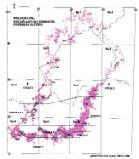
Rochipteris SYSTEMATICS 62 ISSN 2410-4418 Palaeont. afr. (2023) 57 (Special Issue): i–xiv + 1–324 R2 both ×2 HMA, 9 Apil 1996 From photo, 24 Jan 1979 Umkomaas (Umk 111 Dic 2spp), Waterfall Locality Habitat: Dicroidium riparian forest (mature, type 1) Collection: 3592 slabs, 400 man-hrs cleaving R2 all ×1 M5 M4 M3 M2 M1 6 6. Umk 111 Without male affiliate 7 6 5 4 3 2 1 PRE/F/425 pl. 104(8,9) BP/2/546 pl. 105(9)
pl.
BP/2/115 pl. 104(1–4) BP/2/422 pl. 103(1–3) 9 8
pl. 104(1–4)
BP/2/544 BP/2/547a
105(7,8)
BP/2/544 BP/2/115
12 cm 0
Reference palaeodeme
ISSN 2410-4418 Palaeont. afr. (2023) 57 (Special Issue): i–xiv + 1–324
Rochipteris cf. sinuosa Holmes & H.M.And., 2005
Holotype
Specimen: AMF126845; Holmes & H.M.And., 2005, p. 48, fig. 23 A–C.
Assemblage (TC): Coalmine Quarry, Basin Creek Fm., Nymboida, Clarence/Moreton Basin, Australia.
Preservation: carbonaceous, no cuticle, grey coarse mudstone.
Plant fossil names registry number: PFN002323
Reference palaeodeme
Assemblage (TC): Umk 111 Dic 2spp, Umkomaas (pls 107–110(1–3); fig. p. 99).
Specimens: 9 indivs; attached and clusters nil.
Preservation: fairly complete isolated leaves; with clear venation; compressions in thinly laminated, carbonaceous (cuticle), moderately baked, dark-grey shale, with good cleavage.
Sister palaeodemes – 1
Win 111 Hei elo: 1 indiv. (pl. 93)
Specific concept
A Rochipteris species of small to intermediate size with flabellate deeply irregularly divided lamina, and with widely spaced anastomosing venation.
Specific characters
Attachment: unknown
Leaf: flabellate, intermediate in size (c. 85 × 75 mm); lamina deeply divided 3 times into irregular segments (up to 2/3 length of leaf); veins widely spaced, c. 10 per cm midway, anastomoses more frequent distally.
Etymology
sinuosa – (Lat.), sinuous, referring to the venation; as named by Holmes & H.M.And. (2005, p. 48).
Affiliated organs ()♂ –– nil
Comment & comparison
Molteno species
R. cf. sinuosa, based on several leaves from Umk 111, is one of the more unusual of the 12 Rhochipteris species recognized in the Molteno. Specimen BP/2/539, in particular, is well-preserved and almost complete, and quite unlike the other species of foliage from Umk 111, or the Molteno in general. R. distivena from Kan 112 (with four individual leaves) is the nearest in having broad venation, but this is more open towards the base of the leaf. Further differences are the larger leaves, the lamina not so deeply divided and the overall shape being cuneate. Two leaves (BP/2/549, 553), of similar open anastomosing venation but with crenulate margins, were previously placed in Batiopteris sp. indet. by And. & And. (2003, p. 324) and are now included here. Similarly, another leaf from Win 111 (And. & And., 2003, fig. 3, p. 325) is now considered to belong here (pl. 93).
Gondwana Triassic species (non-Molteno)
Rochipteris sinuosa Holmes & H.M.And., 2005, Australia. The Molteno leaf is provisionally placed in this species as it is similar in size, the deeply divided lamina and in venation. However, as the bases are incomplete, it is not possible to ascertain whether the Umk 111 leaves also have the diagnostic clasping base.
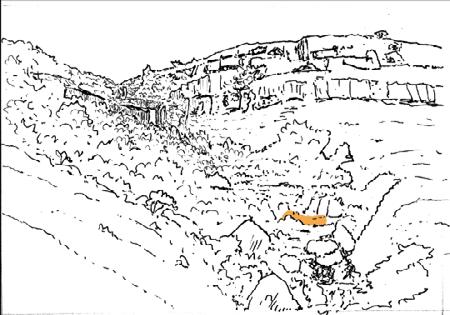
HMA, 9 Apil 1996 From photo, 24 Jan 1979
Umkomaas (Umk 111 Dic 2spp), Waterfall Locality
Habitat: Dicroidium riparian forest (mature, type 1)
Collection: 3592 slabs, 400 man-hrs cleaving
Reference palaeodeme
BP/2/539 pl. 107(1–4) both R2
×2
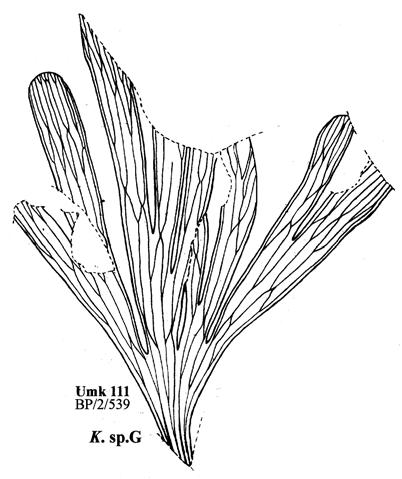
BP/2/555 pl. 108(1,2)
PRE/F/23123 pl. 110(1–3)
BP/2/554 pl. 108(3,4)
PRE/F/22501 pl. 109(1–4)
BP/2/557 pl. 108(8–10)
BP/2/556 pl. 108(5–7)
BP/2/549 pl. 107(9,10)

BP/2/553 pl. 107(6–8)
R2 all ×1 Umk 111
Rochipteris SYSTEMATICS
M5 M4 M3 M2 M1 6
Umk 111
male affiliate
6.
Without
6
9 5 3 10 4
Rochipteris cf. sinuosa
8 7
12 cm 0
×1
1
Rochipteris penensis J.M.And. & H.M.And., sp. nov.
Holotype
Specimen: PRE/F/17943a,b pls 87(8, 14), 88(5)
Assemblage (TC): Pen 411 Hei elo, Peninsula
Preservation: almost complete leaf, impression in thickly laminated, greenish grey shale, moderate cleavage.
Plant fossil names registry number: PFN002324
Reference palaeodeme
Assemblage (TC): as for holotype (pls 87, 88; figs p. 100)
Specimens: 10 indivs; attached and clusters nil.
Sister palaeodemes – 3
Kan 112 Hei elo: 2 indivs
Tel 111 Hei elo: 2 indivs (pl. 46(6–9)); ♂ affil. (2 indivs, pl. 42)
Pen 311 Hei elo: 5 indivs (pls 77, 78(1–7))
Specific diagnosis
A Rochipteris species of small size with obtriangulate entire lamina and truncate to convex distal margin, and with closely spaced anastomosing venation.
Specific characters
Attachment: unknown.
Leaf: broadly obtriangulate, of small size (up to 35 × 11 mm); lamina entire, with truncate to convex distal margin; veins closely spaced, c. 20 per cm midway, anastomoses more frequent distally.
Etymology
penensis – (Lat.), after the type locality, Peninsula.
Affiliated organs ()♂ (male strobilus)
Sister palaeodeme: Tel 111 Hei elo
Kannaskoppianthus telepentatus (2 indivs); Grade 3 (probable)
In the Pen 411 Ref. pal., there occur no affiliated strobili; but the sister palaeodeme from Tel 111 has yielded a probable male affiliate, Kanaskoppianthus telepentatus
Comment & comparison (Molteno)
Molteno species
R. penensis can be separated from the similarly shaped species R. obtriangulata by the smaller size of the leaf and the shorter base. R. pusilla and R. penensis, based on Ref. Pals from Pen 311 and Pen 411 respectively, are most similar amongst the Molteno species in view of their small size. However, in shape, R. pusilla is cuneate and the venation is widely spaced, making them quite distinctive. Note that at Pen 311, both these species occur in low numbers. Interestingly at both Pen 311 and Pen 411, the dominant Rochipteris species is R. rollerii.
Gondwana Triassic species (non-Molteno)
Reference palaeodeme
1
2
PRE/F/17945 pl. 87(2)
PRE/F/17032 pl. 87(3)
7
8
PRE/F/17047 pl. 87(5)
PRE/F/17944 pl. 87(6)
PRE/F/17050 pl. 87(7)
Pen 411
Holotype
PRE/F/17943b pls 87(8), 88(5)
PRE/F/18168 pl. 77(6–9)
PRE/F/18169 pl. 78(1–3)
PRE/F/18170a,b pl. 77(10–15)
PRE/F/18167a pl. 77(1–5)
PRE/F/16914a,b pl. 78(4–7)
PRE/F/18167a pl. 77(1–5)
PRE/F/18170a,b pl. 77(10–15)
Pen 311
19

Rochipteris truncata (Frenguelli, 1946) Morel et al., 2011, N. Argentina. The obtriangulate shape and truncate tip of this leaf is similar to R. penensis, but it is a consistently larger leaf and is broader at the base. R. truncata is considered a separate species and distinct from the Molteno populations of both R. obtriangulata and R. penensis. Consult further discussion in introduction to Hypodigm (p. 104). HMA,
Peninsula
PRE/F/16914a,b pl. 78(4–7)
23
PRE/F/17405a
PRE/F/18255 pl. 46(8,9)
PRE/F/17405a,b pl. 46(7,8)
Tell 111

PRE/F/18255 pl. 46(8,9)
PRE/F/17405b pl. 46(7,8)
PRE/F/17405a,b pl. 46(7,8)
PRE/F/18277a,b pl. 42(1–8)
Kannaskoppianthus telepentatus (affiliated ♂ strobilus, as at sister TC)
Rochipteris SYSTEMATICS 64 ISSN 2410-4418 Palaeont. afr. (2023) 57 (Special Issue): i–xiv + 1–324 12 cm 0 R2 all ×1
2010 From photo, 13 Aug 1996
M5 M4 M3 M2 M1 15 15. Pen 411 6 3 5 R2 all ×2 R2 all ×1 Sister
22 21 20 18 17
(Pen 411 Hei elo), Lunchspot spot Habitat: Heidiphyllum thicket Collection: 204 slabs, 70 man-hrs cleaving
palaeodeme
R2 ×5 R2 ×2
Tel
24 25
111
Sister
R2
R2 all ×1 16 15 14 13 11 9 10 12
palaeodeme
all ×2
PRE/F/17946a pl. 87(1) 4
PRE/F/17035 pl. 87(4)
ISSN 2410-4418
Palaeont. afr. (2023) 57 (Special Issue): i–xiv + 1–324
Rochipteris pusilla Holmes & H.M.And., 2005
Holotype
Specimen: AMF126854; p. 49, Fig. 25A–C.
Assemblage (TC): Coalmine Quarry, Basin Creek Fm., Nymboida, Clarence/Moreton Basin, Australia.
Preservation: carbonaceous, no cuticle, grey coarse mudstone.
Plant fossil names registry number: PFN002325
Reference palaeodeme
Assemblage (TC): Pen 311 Hei elo, Peninsula (pl. 78(8–15); figs p. 101)
Specimens: 2 indivs; attached and clusters nil.
Sister palaeodemes – 3
Boe 112 Dic cor: 1 indiv. (pl. 8)
Kan 112 Hei elo: 1 indiv.
Tel 111 Hei elo: 1 indiv.
Specific concept
A Rochipteris species of small size with cuneate entire lamina and convex distal margin, and with widely spaced anastomosing venation.
Specific characters
Attachment: unknown
Leaf: cuneate, of very small size (up to 20 × 14 mm); lamina entire, with convex distal margin; veins widely spaced, c. 10 per cm midway.
Etymology
pusilla – (Lat.), very small, this being the smallest species described by Holmes & H.M.And. (2005).
Affiliated organs ()♂ –– nil
Comment & comparison (Molteno)
Molteno species
The palaeodemes of R. penensis and R. pusilla, from Pen 311 and Pen 411 are, in view of their small leaf size, most similar amongst the Molteno species. However, in shape R. penensis is broadly obtriangulate and it has closely spaced venation making them quite distinctive.
Gondwana Triassic species (non-Molteno)
Rochipteris pusilla Holmes & H.M.And., 2005, Australia. Due to the small size, similar shape, and open venation, the Molteno specimens have been placed in this species based on a single specimen (with a slightly undulate upper margin) from Nymboida. As so few specimens occur from the four assemblages in the Molteno, the specific identity is somewhat uncertain.
Rochipteris tasmanica (Walkom, 1926) Herbst et al., 2001, Tasmania. The specimen described by Walkom (1926) has finer venation, is twice as large as the Molteno Pen 311 specimens, and is more than a third larger than the type specimen of R. pusilla from Nymboida.
PRE/F/16915b pl. 78(8–11)
PRE/F/16915b pl. 78(8–11)
Reference palaeodeme
PRE/F/18166a pl. 78(12–15)
R2 ×1
HMA, 12 May 2019
Peninsula (Pen 311 Hei elo), Campsite Quarry Habitat: Heidiphyllum thicket Collection: 155 slabs, 35 man-hrs cleaving
From photo, June 1992

PRE/F/17393‘y’
PRE/F/18166a pl. 78(12–15)
R2 ×2
Pen 311
PRE/F/17393‘y’
Sister palaeodeme
both R2
Tel 111 12 cm 0
Rochipteris SYSTEMATICS 65
M5 M4 M3 M2 M1
15 ×2
15. Pen 311
×1
2 3 4 5 6 1
PALAEODEME SKETCHES
Introduction
Central to our taxonomic approach – introduced in our volume on Dicroidium (And. & And., 1983) – is the palaeodeme (fossil population, see Glossary, p. 319). The focus is on the comparison of populations of specimens from particular assemblages (taphocoenoses) through the geographic, stratigraphic and ecological extent of the Molteno Fm., rather than on individual specimens.
In the following section are presented sketches of all the palaeodemes representing Rochipteris and affiliates from the Molteno. These follow the same sequence dealt with for the species descriptions and similarly for the Whole-plant species in Part 3.
What becomes very evident – especially for Rochipteris rollerii, which occurs in 14 of the 26 assemblages – is that the spread of variation in each palaeodeme is different. These differences become more apparent by compiling a series of histograms plotting the number of segments/leaflets for foliage specimens within the palaeodeme (pp 76, 77). This has been undertaken for numerous R. rollerii palaeodemes and the morphologically overlapping species, R. switzifolia and R. matatifolia. Similarly, graphs showing microsporophyll counts for the Kannaskoppianthus species have been compiled (p. 77).
What becomes apparent is evolution in action and the variations resulting from differing habitats. Taxonomy is a complex endeavour when assemblages are scattered through time (millions of years) and different habitats (riverine forest to open woodland).
The graphs (pp 76, 77) plotting leaflet numbers for R. rollerii, R. switzifolia and R. matatifolia, and microsporophyll numbers for Kannaskoppianthus, clearly show the significant variability between palaeodemes from different TCs.

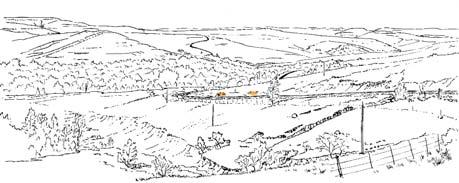
Kannaskop (Kan 111 Ast sp A), Kannaskoppia siltstone
Habitat: Fern/Kannaskoppia meadow
Collection: 365 slabs, 30 man-hrs cleaving
Rochipteris vincularis (5% of assemblage, c. 45 slabs) attached to shoots (leaves & ♀) – 4 slabs attached (leaves only) – 12 slabs clusters of leaves – 1 slab detached/isolated leaves – >25 slabs
Kannaskoppia ♀ – 50 indivs (attached, Grade 5 affil.)
Kannaskoppianthus ♂ – nil
Taphonomy (R. vincularis) – autochthonous
Kannaskoppia vincularis
PRE/F/13489a pl. 29(3)
PRE/F/13508a,b pl. 33(1–6)
PRE/F/13518a,b pl. 35(1–5)
PRE/F/13513a
PRE/F/13507a
PRE/F/13506a,b pl. 31(1–6)
PRE/F/13511a,b pl. 30(1–6)
all R2 ×2
Palaeodemes SYSTEMATICS 12 cm 0 66 ISSN 2410-4418 Palaeont. afr. (2023) 57 (Special Issue): i–xiv + 1–324
1 2 3 4 5 6 13
M5
M1 16
Kannaskop (Kan 111 Ast spA)
M4 M3 M2
111
16. Kan
27°56.9’E; 31°26.92’S
Type (& Ref. Pal.) loc.
12 cm 0
PRE/F/13487a‘y’
Kannaskoppia vincularis / Rochipteris vincularis
Isotype
PRE/F/13487b‘x’ pl. 25(1–4), 26(1–3)
Slab sketched with flake (pl. 25(2)) removed (see pls 25(1), 26(1))
See text on p. 36
Slab sketched with flake in place (see pls 25(4), 26(2))

×2
PRE/F/13505a pl. 27(1–6)
×1
PRE/F/13500a,b
Palaeodemes SYSTEMATICS 67 ISSN 2410-4418 Palaeont. afr. (2023) 57 (Special Issue): i–xiv + 1–324 12 cm 0 R2 ×1 R2 ×1 R2 ×1
Kannaskop (Kan 111 Ast spA)
1 6 5 4 2
pl. 23(1–3), 24(1–3)
PRE/F/13545 pl. 36(3,4) R2
Holotype
Rochipteris vincularis
PRE/F/13537
BP/2/3375
Palaeodemes SYSTEMATICS 12 cm 0 68 ISSN 2410-4418 Palaeont. afr. (2023) 57 (Special Issue): i–xiv + 1–324 R2 all ×1
Kannaskop (Kan 111 Ast spA)
PRE/F/13536 pl. 37(1–5)
PRE/F/13521
39(1,2) 7 6 5 1 3 2 9 11 12 10 8 4
PRE/F/13520 pl. 38(1,2)
pl.
PRE/F/13525 pl. 40(5)
PRE/F/13545 pl. 36(3,4)
PRE/F/13524 pl. 40(3,4)
BP/2/3372 pl. 36(1,2)
PRE/F/13522 pl. 39(3–6)
PRE/F/13523 pl. 40(6,7)
Holotype
BP/2/3379
Rochipteris telefolia

PRE/F/17414

32
32. Tel 111
26°47.78’E; 31°02.86’S
Type (& Ref. Pal.) loc.
M5 M4 M3 M2 M1

Telemachus Spruit (Tel 111 Hei elo)
Habitat: Heidiphyllum thicket Collection: 581 slabs, 90 man-hrs cleaving
Rochipteris telefolia (30 indivs) attached to shoots – 2 slabs (5 leaves, 8 leaves) clusters – 1 slab (3 leaves)
Kannaskoppia ♀ – nil
Kannaskoppianthus ♂ – 2 spp (4 indivs)
K. telemagnus (2 indivs); Grade 4 affil. to R. telefolia
Taphonomy (R. telefolia) – parautochthonous
Telemachus
Palaeodemes SYSTEMATICS 69 ISSN 2410-4418 Palaeont. afr. (2023) 57 (Special Issue): i–xiv + 1–324 12 cm 0 Holotype PRE/F/7711 pl. 41(1–6) R2 ×2
Spruit (Tel 111 Hei elo)
Kannaskoppianthus telemagnus
1 2
pl. 43(1–3)
Holotype 3 R3 ×5 R2 ×2
Rochipteris telefolia
PRE/F/12874b
PRE/F/18275
PRE/F/12876
Palaeodemes SYSTEMATICS 12 cm 0 70 ISSN 2410-4418 Palaeont. afr. (2023) 57 (Special Issue): i–xiv + 1–324
pl. 44(1–6)
pl. 46(1–3)
PRE/F/17416
PRE/F/17406a R2 all ×1
Telemachus Spruit (Tel 111 Hei elo)
2 1 4 3
pl. 44(7,8)
Rochipteris telefolia
Palaeodemes SYSTEMATICS 71 ISSN 2410-4418 Palaeont. afr. (2023) 57 (Special Issue): i–xiv + 1–324 12 cm 0
PRE/F/17414 pl. 43(1–3)
PRE/F/18267 pl. 43(4–6)
R2 all ×1 Telemachus Spruit (Tel 111 Hei elo)
PRE/F/17411 pl. 45(1–4)
PRE/F/17413 pl. 45(5–8)
7 6 4 5 3 2 1 8 PRE/F/18269
PRE/F/17415 pl. 46(4,5)
PRE/F/18268 pl. 43(7,8)
Holotype
found
Reference
palaeodeme
Cat. no. not
Rochipteris telefolia
Palaeodemes SYSTEMATICS 72 ISSN 2410-4418 Palaeont. afr. (2023) 57 (Special Issue): i–xiv + 1–324
Matatiele (Mat 111 Dic dub)
R2 all ×1 12 cm 0
PRE/F/9068a pl. 118(1–5)
1 2 3 4 5 8 7 6
PRE/F/1875b pl. 117(1–5)
PRE/F/10167
BP/2/3017b
BP/2/3021
BP/2/3015a,b
Cat. no. not found
PRE/F/19057
PRE/F/1880
Rochipteris telefolia
PRE/F/9045
PRE/F/10149a,b
BP/2/3098
PRE/F/10161PRE/F/9046a,b

10. Mat 111
BP/2/3014a,b
28°48.34’E; 30°20.84’S Type (& Ref. Pal.) loc.

Matatiele (Mat 111 Dic dub)
Habitat: Dicroidium riparian forest (immature, type 2)
Collection: 1082 slabs, 65 man-hrs cleaving
Rochipteris telefolia (2% of assemblage, c. 82 slabs) attached to shoots – nil clusters – nil
Kannaskoppia ♀ – nil
Kannaskoppianthus ♂ – nil affil. to R. telefolia
K. matatiparvus (3 indivs); Grade 3 affil. to R. gracilis
Taphonomy (R. telefolia) – parautochthonous
Palaeodemes SYSTEMATICS 73 ISSN 2410-4418 Palaeont. afr. (2023) 57 (Special Issue): i–xiv + 1–324 6 12 cm 0
Matatiele (Mat 111 Dic dub)
M5
10
R2 all ×1
M4 M3 M2 M1
2 1 3 4 5 7 8
BP/2/3018
Rochipteris distivena




Palaeodemes SYSTEMATICS 12 cm 0 74 ISSN 2410-4418 Palaeont. afr. (2023) 57 (Special Issue): i–xiv + 1–324
6
BP/2/3386 R2 ×2 Kannaskop (Kan 112 Hei elo)
BP/2/3387
1 3 PRE/F/20120
2 4
BP/2/3386
pl. 21(1–5)
BP/2/3421a
5 Holotype
7
BP/2/3386 R2 ×1
R3 ×5
Holotype R2 all
BP/2/3386
×1
Holotype
Rochipteris distivena
R4 ×1

Kannaskoppianthus irregularis / Rochipteris distivena 1 3

16
16. Kan 112
27°56.9’E; 31°26.92’S
R3 ×5
PRE/F/20114a,b pl. 20(1–6)
Affiliated male strobilus
Kannaskoppianthus irregularis
Kannaskop (Kan 112 Hei elo)
M5
M4
M3
M2
M1
Type (& Ref. Pal.) loc.
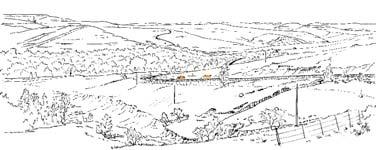
Kannaskop (Kan 112 Hei elo), Upper End Habitat: Heidiphyllum thicket
Collection: 145 slabs, 15 man-hrs cleaving
Rochipteris distivena (4 indivs) attached to shoots – nil clusters – nil
Kannaskoppia ♀ – nil
Kannaskoppianthus ♂ – 5 indivs (affil., Grade 3)
Palaeodemes SYSTEMATICS 12 cm 0 75 ISSN 2410-4418 Palaeont. afr. (2023) 57 (Special Issue): i–xiv + 1–324
Taphonomy (R. distivena) – parautochthonous 2
R2 ×2
PRE/F/20114a,b pls 19(1–6), 20(1–6)
Chart 3. Foliage (9 TCs)
With histograms showing variability between palaeodemes
Pen 311 Hei elo
34 indivs total
22 indivs drawn all 22 graphed
Pen 411 Hei elo
70 indivs total 24 indivs drawn all 24 graphed
Rochipteris rollerii
Umk 111 Dic 2spp
21 indivs total
19 individuals drawn all 19 graphed
segments (leaflets)
Kon 211 Ast 2spp
5
Gre 121 Hei elo
22 indivs total

segments (leaflets)
Aas
Aas
Aas
Aas 211 Hei elo
Segment counts
Leaflets counted if divided to clearly >25% of the distance to the primary cleft in the lamina.
Palaeodemes SYSTEMATICS 12 cm 0 76 ISSN 2410-4418 Palaeont. afr. (2023) 57 (Special Issue): i–xiv + 1–324 12 cm 0 individuals 8 7 6 5 4 3 2 1 12345678910
segments (leaflets)
individuals 8 7 6 5 4 3 2 1 12345678910
individuals 8 7 6 5 4 3 2 1 12345678910
segments (leaflets)
indivs total
indivs
individuals 8 7 6 5 4 3 2 1 12345678910
5
drawn all 5 graphed
20
13
individuals 8 7 6 5 4 3 2 1 123456789101112131415 segments (leaflets)
indivs drawn
indivs graphed
individuals 8 7 6 5 4 3 2 1 12345678910
311 Hei elo 25 indivs total 14 indivs drawn all 14 graphed
segments (leaflets)
18 indivs total 5 indivs drawn all 5 graphed
of
c.
39 indivs drawn 28 indivs graphed 9 individuals 8 7 6 5 4 3 2 1 123456789101112131415 segments (leaflets)
111 Hei elo 2%
assemblage (
50 slabs, incl. several clusters)
411 Dic/Sph 150 indivs total 31 indivs drawn 30 indivs graphed individuals 8 7 6 5 4 3 2 1 12345678910
segments (leaflets)
14 13 12 11 10 9 individuals 8 7 6 5 4 3 2 1 12345678910 segments (leaflets)
Aas 411 ×1 Aas 311 ×1 Kon 211 ×1 Pen 311 ×1
Foliage (2 TCs)
Rochipteris switzifolia
Male strobili (4 TCs)
Rochipteris matatifolia
Lut
111
PRE/F/3205
PRE/F/19484
PRE/F/21497
Microsporophyll counts
Maximum counts made along inner or outer margin of strobilus limb.
Palaeodemes SYSTEMATICS 12 cm 0 77 ISSN 2410-4418 Palaeont. afr. (2023) 57 (Special Issue): i–xiv + 1–324 individuals 8 7 6 5 4 3 2 1 1234567891011121314151617181920212223242526272829303132333435 segments (leaflets) Lit 111 Dic/Hei 55 indivs total 26 indivs drawn 26 indivs graphed individuals 8 7 6 5 4 3 2 1 1234567891011121314151617181920212223242526272829303132333435 segments (leaflets) Mat 111 Dic dub 17 indivs total 14 indivs drawn 14 indivs graphed
4 3 2 1 12345678910 microsporophylls Aas 111 Hei elo 21 indivs total 12 indivs drawn 8 indivs graphed 4 3 2 1 12345678910 microsporophylls Mat 111 Dic dub 3 indivs total 2 indivs drawn 2 indivs graphed 4 3 2 1 123456789101112 microsporophylls Lut 311 Hei elo 16 indivs total 10 indivs drawn 8 indivs graphed Kannaskoppianthus
matatiparvusK.
K. aasvoelanthus Lit 111 Dic/Hei 9 indivs total 7 indivs drawn 6 indivs graphed 4 3 2 1 123456789101112 microsporophylls
switzianthus
K.
lutinumerus
K.
PRE/F/11433a,b 311 ×2
Mat
×2
111
111
30 31 3 ×1 ×1
Lit
×2 Aas
×2
Rochipteris rollerii
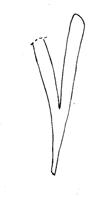
PRE/F/16912b

PRE/F/18177

PRE/F/16909a pl. 74(7–11)
PRE/F/16906a pl. 73(13–17)

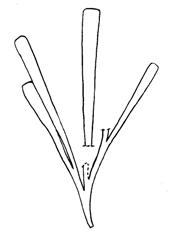
PRE/F/18186 pl. 75(1–3)

PRE/F/16913b pl. 76(1–6)
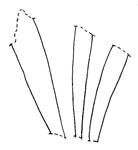

PRE/F/16908a
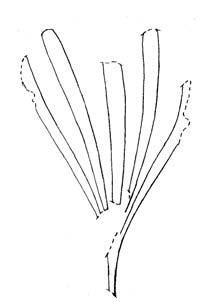

PRE/F/18181
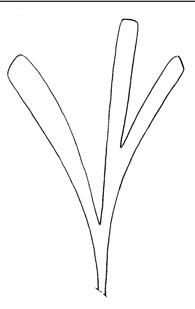
PRE/F/18174a

PRE/F/16904a,b pl. 73(3,4)
PRE/F/16903a pl. 73(5–7)

PRE/F/18179 pl. 75(5,6)
PRE/F/18178 pl. 75(4)
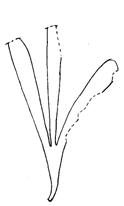
PRE/F/16905a pl. 73(8–10)
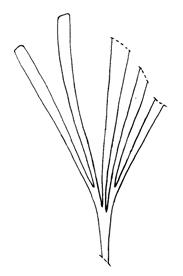
PRE/F/18180 pl. 75(7–9)
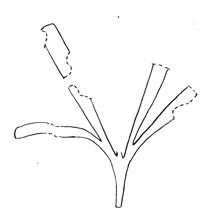
PRE/F/16910a pl.

PRE/F/18175
PRE/F/16907b
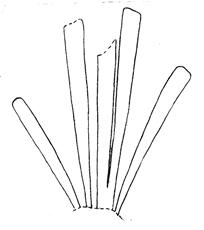
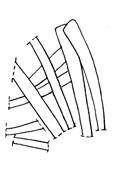
PRE/F/16911b pl. 76(7–11)

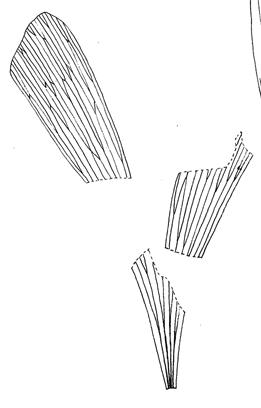
PRE/F/16913b pl. 76(1–6)
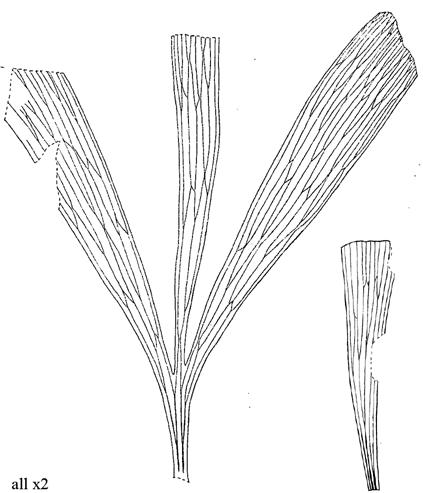
PRE/F/16909a pl. 74(7–11)
Pen 311 Hei elo
34 indivs total 22 indivs drawn all 22 graphed
12345678910 segments (leaflets)
27°56.84’E; 31°29.59’S Type (& Ref. Pal.) loc.

Peninsula (Pen 311 Hei elo), Campsite Quarry
Habitat: Heidiphyllum thicket Collection: 155 slabs, 35 man-hrs cleaving
Rochipteris rollerii (34 indivs) attached to shoots – nil clusters – 1 slab (3 leaves)
Kannaskoppia ♀ – nil
Kannaskoppianthus ♂ – nil
Taphonomy (R. rollerii) – parautochthonous
Palaeodemes SYSTEMATICS 12 cm 0 78 ISSN 2410-4418 Palaeont. afr. (2023) 57 (Special Issue): i–xiv + 1–324
Peninsula (Pen 311 Hei elo)
R2
all ×2 R2 all ×1
pl. 74(1,2)
6 5 4 3 2 1 13 12 11 10 9 8 7 19 18 17 16 15 14 21 20
74(5,6)
8 7 6 5 4 3 2 1
individuals
PRE/F/17974
PRE/F/17972
PRE/F/17976 pl. 85(7)
PRE/F/17043
12
PRE/F/17980 pl. 84(6,7)
PRE/F/17041
PRE/F/17981
PRE/F/17045a pl. 85(1–5)
PRE/F/17048a pl. 86(5)
PRE/F/17971a pl. 85(8)
PRE/F/17984
PRE/F/17973
PRE/F/17977 pl. 86(1–3)
PRE/F/17044a pl. 85(10)
PRE/F/17037
PRE/F/17046a
PRE/F/17039 pl. 85(9)
PRE/F/17986b pl. 83(1–8)
PRE/F/17025
PRE/F/17983 pl. 84(1–5)
PRE/F/17985b
Pen 411 Hei elo
individuals
70 indivs total 24 indivs drawn all 24 graphed
12345678910 segments (leaflets)
PRE/F/17948 pl. 81(1–6)

M5 M4 M3 M2 M1 15
15. Pen 311, 411
27°56.78’E; 31°30.35’S Type (& Ref. Pal.) loc.
PRE/F/17982

Peninsula (Pen 411 Hei elo), Lunchspot spot Habitat: Heidiphyllum thicket Collection: 204 slabs, 70 man-hrs cleaving Rochipteris rollerii (70 indivs) attached to shoots – nil clusters – nil
Kannaskoppia ♀ – nil
Kannaskoppianthus ♂ – 4 indivs (affil., Grade 4)
Taphonomy (R. rollerii) – parautochthonous
Peninsula (Pen 411 Hei elo)
Palaeodemes SYSTEMATICS 12 cm 0 79 ISSN 2410-4418
i–xiv
Palaeont. afr. (2023) 57 (Special Issue):
+ 1–324
R2 all ×1 11 16 15 14 13 10 9 8 7 6 5 4 3 2 1 24 23 22 21 20 19 18 17
Rochipteris rollerii
PRE/F/17978b pl. 82(1–6) 8 7 6 5 4 3 2 1
Rochipteris rollerii
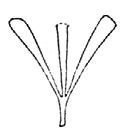

PRE/F/432

PRE/F/429
PRE/F/9811 pl. 97(1–4)
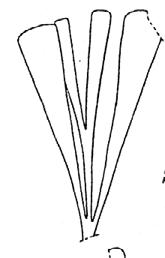
PRE/F/18762 pl. 101(7,8)

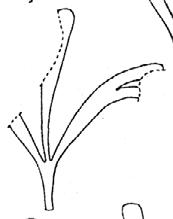
PRE/F/9816 pl. 102(6,7)

BP/2/540 pl. 99(4–6)
PRE/F/430 pl. 101(1–3)

PRE/F/426a,b pl. 98(1–6)

BP/2/537 pl. 100(1,2)
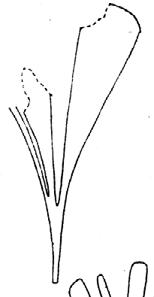
PRE/F/6446
BP/2/541 pl. 99(7–9)
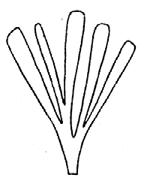
individuals
8 7 6 5 4 3 2 1
21 indivs total 19 individuals drawn all 19 graphed
PRE/F/9817 pl. 102(4,5)
M5 M4 M3 M2 M1 8 9 10
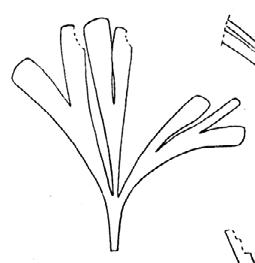


111 12 13 14
12345678910 segments (leaflets)
6 11
PRE/F/6385a

BP/2/538 pl. 99(1–3)

(& Ref. Pal.) loc.

15 16 17
PRE/F/433

PRE/F/435 pl. 98(7)
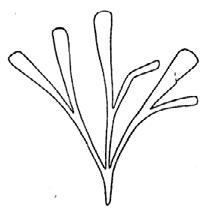
18 19
PRE/F/18758 pl. 101(4)

Umkomaas (Umk 111 Dic 2spp)
Habitat: Dicroidium riparian forest (mature, type 1)
Collection: 3592 slabs, 400 man-hrs cleaving
Rochipteris rollerii (21 indivs) attached to shoots – nil clusters – nil
Kannaskoppia ♀ – nil
Kannaskoppianthus ♂ – nil
PRE/F/428 pl. 101(5,6)
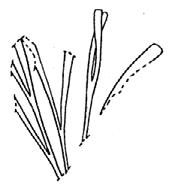
Palaeodemes SYSTEMATICS 12 cm 0 80 ISSN 2410-4418 Palaeont. afr. (2023) 57 (Special Issue): i–xiv + 1–324
R2 all ×1
29°27.3’E; 29°33.4’S
Umkomaas (Umk 111 Dic 2spp)
Type
6. Umk
Taphonomy (R. rollerii) – parautochthonous 1 2 3 4 5 6 7
Umk 111 Dic 2spp
PRE/F/9833 pl. 100(3–6)
Gre 121 Hei elo
Rochipteris rollerii
PRE/F/7842
Cat. no. not found
22 indivs total
20 indivs drawn 13 indivs graphed
individuals
PRE/F/7852
PRE/F/7837b pl. 4(1–5)
Cat. no. not found
PRE/F/7839 pl. 5(1–5)
PRE/F/7841 pl. 6(1,2)
Cat. no. not found
Cat. no. not found
Greenvale (Gre 121 Hei elo)
PRE/F/7840 pl. 6(3–5)
R2 all ×1
12345678910 segments (leaflets)
12
PRE/F/7856a pl. 3(1–6)
K. aasvoelensis
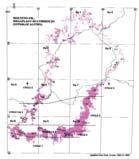
M5 M4 M3
M2 M1 20
20 Gre 111, 121
PRE/F/10302a,‘w’,‘x’ pl. 69(1–7)
2 indivs of cluster of 3
PRE/F/10302b,‘z’,a (reverse of slab) pl. 70(1–8)
PRE/F/10293a,b pl. 72(1–7)
PRE/F/10294a,b pl. 71(1–9)

Konings Kroon (Kon 211 Ast 2spp)

27°08.94’E; 31°23.62’S Type (& Ref. Pal.) loc.
Greenvale (Gre 121 Hei elo)
Habitat: Heidiphyllum thicket
Collection: 141 slabs, 10 man-hrs cleaving
Rochipteris rollerii (22 indivs) attached to shoots – nil clusters – 4 slabs (2 – c. 7 leaves)
Kannaskoppia ♀ – nil
Kannaskoppianthus ♂ – 2 indivs (Grade 4 affil.)
Taphonomy (R. rollerii) – parautochthonous
Kon 211 Ast 2spp
individuals
5 indivs total 5 indivs drawn all 5 graphed
12345678910 segments (leaflets)
28°00.87’E; 31°29.32’S Type (& Ref. Pal.) loc.
Koningskroon (Kon 211 Ast 2spp)
Habitat: Fern/Kannaskoppia meadow
Collection: 393 slabs, 14 man-hrs cleaving
Rochipteris rollerii (5 indivs; nil clusters, ♀ or ♂)
Taphonomy (R. rollerii) – allochthonous
Palaeodemes SYSTEMATICS 12 cm 0 81 ISSN 2410-4418 Palaeont. afr. (2023) 57 (Special Issue): i–xiv + 1–324
R3
R2 all ×1
×2
5 4
8 7 6
3 2 1
8 7 6 5 4 3 2 1
4 9 8 7 6 5 3 2 16 14 17 15 13 10 11 M5 M4 M3 M2 M1 14 14 Kon 211
1
‘z’ ‘w’
‘x’
Rochipteris rollerii
PRE/F/19022 PRE/F/11987
PRE/F/19021a,b pl. 150(1–4)
PRE/F/19347a
PRE/F/11986
PRE/F/19346 pl. 149(4)
PRE/F/19020a,b pl. 151(1–7)
PRE/F/12002a,b pl. 148(1–6)
PRE/F/11991
PRE/F/11988 pl. 149(5–9)
PRE/F/19348b pl. 149(1–3)
Kannaskoppianthus aasvoelensis
PRE/F/19407a,b pls 145, 146(1–6)
PRE/F/12001a,b pl. 147(1–6)
Cat. no. not found ×
PRE/F/12001a,b pl. 147(7–10)
microsporangium
PRE/F/11993 pl. 150(5–7)
PRE/F/19019 pl. 152(1–3)
PRE/F/19019 pl. 152(1–3)
PRE/F/19020b pl. 151(1–7)
Habitat
Collection

Kannaskoppianthus
Palaeodemes SYSTEMATICS 12 cm 0 82 ISSN 2410-4418 Palaeont. afr. (2023) 57 (Special Issue): i–xiv + 1–324 Aasvoëlberg (Aas 311 Hei elo)
thicket
: Heidiphyllum
attached
clusters
nil
: 528 slabs; 140 man-hrs cleaving Rochipteris rollerii (25 indivs)
to shoots – nil
– nil Kannaskoppia ♀ –
R. rollerii
parautochthonous 26°13.3’E; 31°32.20’S Type (& Ref. Pal.) loc.
♂ – 4 indivs (affil., Grade 4) Taphonomy (
) –
R2 all ×1 Aasvoëlberg (Aas 311 Hei elo) R2 ×2 R2 all ×2 Aas 311
M5 M4 M3 M2 M1 24 24. Aas 311 individuals 8 7 6 5 4 3 2 1 123456789101112131415 segments (leaflets) 25 indivs total 14 indivs drawn all 14 graphed Aas 311 Hei elo 19 18 17
PRE/F/19343b
1 2 3 4 5 6 7 8 9 10 11 12 13 14
pl. 146(7)
16
15
R2 ×2
20 –
PRE/F/19574
3
Rochipteris rollerii
individuals
Aas 211 Hei elo
PRE/F/15275 pl. 144(7–9)
18 indivs total 5 indivs drawn all 5 graphed
12345678910 segments (leaflets)
Kannaskoppianthus aasvoelensis
1 6 5 4
Cat. no. not found
PRE/F/15280a,b pl. 143(1–11)
Aas 211
R2 ×2
PRE/F/19571

26°13.94
Aasvoëlberg (Aas 211 Hei elo)
Habitat: Heidiphyllum thicket Collection: 154 slabs; 35 man-hrs cleaving
Rochipteris rollerii (18 indivs) attached to shoots – nil clusters – nil
Kannaskoppia ♀ – nil
Kannaskoppianthus ♂ – 1 indiv. (affil., Grade 4)
Aasvoëlberg (Aas 211 Hei elo)
Palaeodemes SYSTEMATICS 12 cm 0 83 ISSN 2410-4418
(2023) 57 (Special
i–xiv + 1–324
Palaeont. afr.
Issue):
×1
R2 all
M5 M4 M3 M2 M1 24
Aas
24.
211
Taphonomy (R. rollerii) – parautochthonous 8 7 6 5 4 3 2 1
’E; 31°33.35’S Type (& Ref. Pal.) loc.
2
PRE/F/15278 pl. 144(1–6)
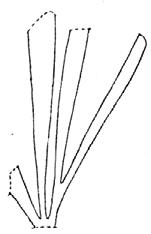
BP/2/4306


PRE/F/19481b PRE/F/15229
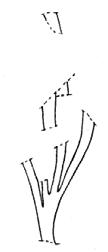
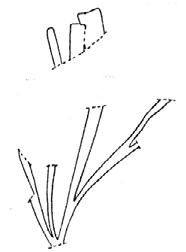
BP/2/4305a,b pl. 141(4)
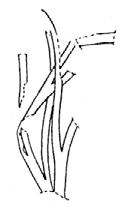
PRE/F/15235 pl. 135(1–6)

BP/2/4304 pl. 138(10,11)
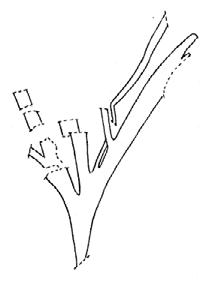
‘x’ ‘y’
Cluster of 2 indivs sketched separately here
PRE/F/15237a,b pl. 137(2,3) pl. 138(1–4)

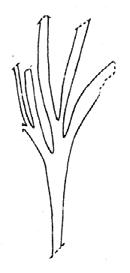
PRE/F/15227 pl. 139(1–8); pl. 140(1,2)

PRE/F/19529 pl. 141(5)

PRE/F/15221 pl. 141(7,8)
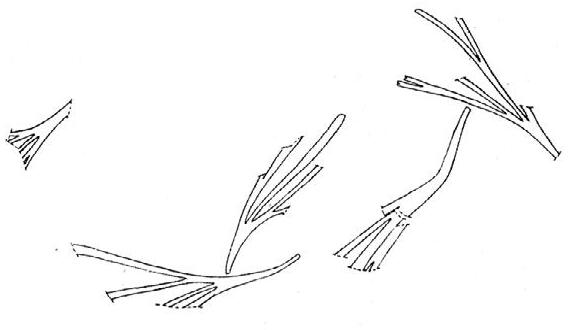
PRE/F/15228 pl. 133(1–7) pl. 138(8,9)

BP/2/4308 pl. 137(1)
BP/2/4307 pl. 134(1–6)

PRE/F/15222 pl. 138(12,13)
BP/2/4302a pl. 131(1–8); pl. 132(1–9)
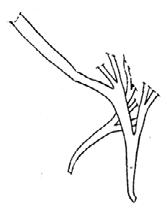
Cat. no. not found R2 all ×1

Palaeodemes SYSTEMATICS 12 cm 0 84 ISSN 2410-4418 Palaeont. afr. (2023) 57 (Special Issue): i–xiv + 1–324 Rochipteris rollerii Aasvoëlberg
13 12 11 10 7 6 5 4 1 17 16 15 14
(Aas 111 Hei elo)
3 2
8 9
Cluster of several leaves plus single Kannaskoppianthus strobilus
Aas 111 Hei elo
Rochipteris rollerii
2% of assemblage
39 indivs drawn 28 indivs graphed
12345678910 segments (leaflets)
Kannaskoppianthus aasvoelensis
PRE/F/15244b pl. 126(1–3)
BP/2/4336a pl. 129(1–5)
Reference palaeodeme
BP/2/4297a
Holotype
PRE/F/19547a,b pl. 125(1–9) PRE/F/19484 pl. 126(4–7)
PRE/F/15246 pl. 130 (9–12)
R2 all ×2
PRE/F/15203a pl. 127(1–4)
PRE/F/15243a,b
PRE/F/19546
PRE/F/19541 pl. 130(1–4)
26°16.47’E; 31°33.81’S

M5
M4
M3 M2
M1 24
24. Aas 111
Type (& Ref. Pal.) loc.

Aasvoëlberg (Aas 111 Hei elo)
Habitat: Heidiphyllum thicket
Collection: 291 slabs, 40 man-hrs cleaving Rochipteris rollerii (2% of assemblage) attached to shoots – nil clusters – 6 slabs (2 – c. 20 leaves)
Kannaskoppia ♀ – nil
Kannaskoppianthus ♂ – 21 indivs (affil., Grade 4)
Taphonomy (R. rollerii) – parautochthonous
21 indivs total 12 indivs drawn 8 indivs graphed
BP/2/4331
PRE/F/19545 pl. 128(5–10)
PRE/F/19547b pl. 125(5–9)
Aasvoëlberg (Aas 111 Hei elo)
Palaeodemes SYSTEMATICS 12 cm 0 85 ISSN 2410-4418 Palaeont. afr. (2023) 57 (Special Issue): i–xiv + 1–324 14 13 12 11 10 9 individuals 8 7 6 5 4 3 2 1
4 3 2 1
12345678910 microsporophylls
Aas 111 Hei elo 1 2 3 4 5 6 7 8 9 10 11 12
Holotype R3 ×5 13
PRE/F/20797
PRE/F/20812a
PRE/F/20523
PRE/F/20763
PRE/F/20813
PRE/F/20558a
PRE/F/20543
PRE/F/20548
PRE/F/12099
PRE/F/20541
PRE/F/20644
PRE/F/12099
PRE/F/20544b
PRE/F/12102
PRE/F/20540a
PRE/F/20526
PRE/F/20547
PRE/F/20538
PRE/F/20799
PRE/F/12098
PRE/F/20550
PRE/F/20532
PRE/F/20524b
PRE/F/20529
PRE/F/12103a
PRE/F/21062
PRE/F/12097a
PRE/F/12096
PRE/F/12100a,b
PRE/F/20557a,b

Palaeodemes 86 ISSN 2410-4418 Palaeont. afr. (2023) 57 (Special Issue): i–xiv + 1–324 1 2 cm 0 Rochipteris rollerii Aasvoëlberg (Aas 411 Dic/Sph) R2 all ×1 10 1 2 3 4 5 6 7 8 9 12 11 13 14 15 16 17 18 19 20 2122 23 24 27 25 28 29 30
PRE/F/12094b pl. 157(1–3)
pl. 162(4–7)
26
pl. 157(4,5)
pl. 161(1–7)
pl. 159(3,4)
pl. 159(5,6)
pl. 159(7,8)
pl. 159(1,2)
pl. 160(1–5)
31
SYSTEMATICS MA
pl. 158(1–7)
Rochipteris rollerii
Aas 411 Dic/Sph
150 indivs total
31 indivs drawn
30 indivs graphed
Kannaskoppianthus aasvoelensis / Rochipteris rollerii
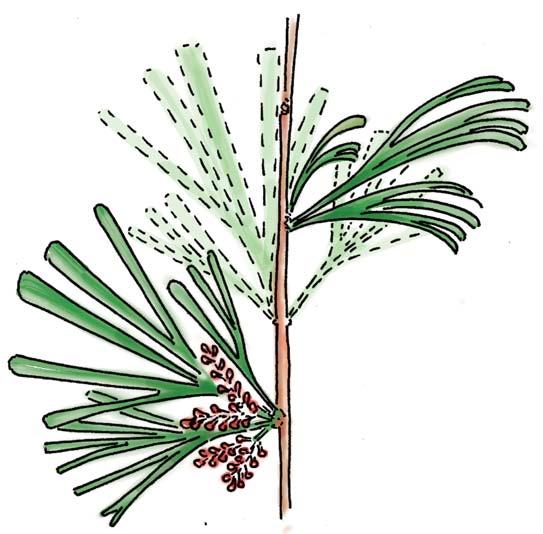
123456789101112131415 segments (leaflets)

26°12.16’E; 31°33.43’S
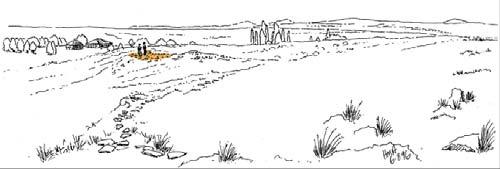
Aasvoëlberg (Aas 411 Dic/Sph)
Habitat: Sphenobairea closed woodland Collection: 2176 slabs, 512 man-hrs cleaving Rochipteris rollerii (150 indivs) attached to shoots – nil clusters – nil
Kannaskoppia ♀ – nil
Kannaskoppianthus ♂ – 21 indivs (affil., Grade 4)
Taphonomy (R. rollerii) – parautochthonous
Kannaskoppianthus aasvoelensis
PRE/F/20588a,b
PRE/F/20545a,b
Palaeodemes SYSTEMATICS 12 cm 0 87 ISSN 2410-4418 Palaeont. afr. (2023) 57 (Special Issue): i–xiv + 1–324
R2
Aasvoëlberg
(Aas 411 Dic/Sph)
all ×2
M3 M2 M1 24
411 6 5 4 3 2
M5 M4
24. Aas
9 individuals 8 7 6 5 4 3 2 1
PRE/F/12092a,b pl. 153(1–4)
PRE/F/12093 pl. 153(8,9)
PRE/F/12050a,b pl. 153(5–7)
1
R4 ×1
Rochipteris
PRE/F/5625a
PRE/F/5622
PRE/F/5642
PRE/F/5643
PRE/F/5640a
BP/2/1577
PRE/F/5620
PRE/F/5633
PRE/F/5628
BP/2/1564
BP/2/1568
BP/2/1569
BP/2/1581
BP/2/1558a
PRE/F/5637 pl. 123(7) BP/2/1561
PRE/F/5626
BP/2/1572
Reference palaeodeme
Palaeodemes SYSTEMATICS 12 cm 0 88 ISSN 2410-4418 Palaeont. afr. (2023) 57 (Special Issue): i–xiv + 1–324
Switzerland (Lit 111 Hei elo) R2 all ×1
switzifolia Little
BP/2/1565 pl. 122(1–3)
PRE/F/5638 pl. 123(1–4)
BP/2/1556
BP/2/1559 pl. 121(1–4)
BP/2/1562 pl. 123(8–10)
1 2 3 4 5 6 7 8 9 10 11 12 13 26 25 24 23 22 21 20 19 18 17 16 15 14 Holotype
PRE/F/5636 pl. 121(5,6)
BP/2/1557a,b pl. 122(4–9)
BP/2/1582 pl. 124(1–5)
Lit 111 Dic/Hei
Rochipteris switzifolia
55 indivs total
26 indivs drawn 26 indivs

PRE/F/5638 pl. 123(1–4)




BP/2/1582 pl. 124(1–5)

R3 R2
Kannaskoppianthus switzianthus
PRE/F/5940 pl. 120(4)
PRE/F/5939 pl. 120(6)
PRE/F/5942a,b pl. 120(1–3)
PRE/F/5943a,b pl. 120(7–11)
BP/2/1623
Holotype
PRE/F/5734 PRE/F/21497a pl. 119(1–6)

1. Lit 111
M5
Type (& Ref. Pal.) locality 29°02.87’E; 28°34.54’S
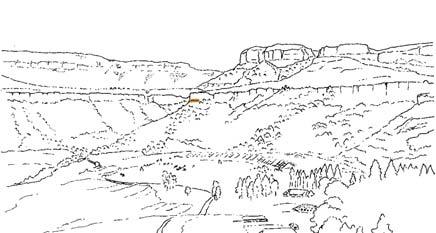

Little Switzerland (Lit 111 Dic/Hei)
Habitat: Dicroidium riparian forest (mature, type 1)
Collection: 2173 slabs, 550 man-hrs cleaving Rochipteris switzifolia (55 indivs) attached to shoots – nil clusters – nil
Kannaskoppia ♀ – nil
Kannaskoppianthus ♂ – 9 indivs (affil., Grade 3)
Taphonomy (R. switzifolia) – parautochthonous
9 indivs total 7 indivs drawn 6 indivs graphed
PRE/F/21497 pl. 119 (2,3,6)
Little Switzerland (Lit 111 Hei elo)
Palaeodemes SYSTEMATICS 12 cm 0 89 ISSN 2410-4418 Palaeont. afr. (2023) 57 (Special Issue): i–xiv + 1–324 R3 ×5
M4 M3 M2 M1 1
4 3 2 1
microsporophylls
111 Dic/Hei individuals 8 7 6 5 4 3 2 1 1234567891011121314151617181920212223242526272829303132333435 segments (leaflets)
123456789101112
Lit
graphed
R2
×2
all
11 10 7 9 8 6 5 ×2 ×2 ×5 ×5 4 3 2 1 12
PRE/F/9067
PRE/F/10168a
Rochipteris matatifolia
PRE/F/9076a
PRE/F/9081
PRE/F/9080
PRE/F/10169
PRE/F/9079a
PRE/F/9075
Holotype
5 indivs appear on the colour plates (all are illustr. here)
Palaeodemes SYSTEMATICS 12 cm 0 90 ISSN 2410-4418 Palaeont. afr. (2023) 57 (Special Issue): i–xiv + 1–324 R2 all ×1
Matatiele (Mat 111 Dic dub)
PRE/F/9074 pl. 116(9–12)
PRE/F/9083a,b pl. 116(5–8)
PRE/F/1881 pl. 116(1–3)
10 9 8 7 6 5 4 3 2 1 13 12 14 11
PRE/F/9082a,b pl. 115(1–4)
PRE/F/9077 pl. 116(4)
BP/2/3025
Mat 111
113(1–4)
17 indivs total
14 indivs drawn
14 indivs graphed
Type (& Ref. Pal.) loc. 8 7 6 5 4 3 2 1 1234567891011121314151617181920212223242526272829303132333435 segments (leaflets)
28°48.34’E; 30°20.84’S


















Matatiele (Mat 111 Dic dub)

10. Mat 111
Habitat: Dicroidium riparian forest (immature, type 2)
Collection: 1082 slabs, 65 man-hrs cleaving
Rochipteris matatifolia (17 indivs) attached to shoots – nil clusters – nil
Kannaskoppia ♀ – nil
Kannaskoppianthus ♂ – 3 indivs (affil. Grade 3 to R. matatifolia)
R2 ×2
R3 ×5
111
Dic dub
4 3 2 1 12345678910 microsporophylls 3 indivs total 2 indivs drawn 2 indivs graphed
Palaeodemes SYSTEMATICS 91 ISSN 2410-4418 Palaeont. afr. (2023) 57 (Special Issue): i–xiv + 1–324 12 cm 0
Kannaskoppianthus matatiparvus
M5 M4 M3 M2 M1 10
Matatiele (Mat 111 Dic dub)
Taphonomy (R. matatifolia) – allochthonous individuals
4 3
Mat 111 Dic dub
Mat
PRE/F/3205 pl. 113(1–4)
PRE/F/9251a,b pl. 113(5–10); pl. 114(1–5)
pl.
Rochipteris matatifolia
Mat 111 PRE/F/3205
1 5 Holotype Holotype 2 R3 ×5
PRE/F/9083b pl. 116(8)
PRE/F/9077 pl. 116(4)
PRE/F/3221
Rochipteris komifolia
PRE/F/3236 pl. 50(1–5)
PRE/F/3216 pl. 49(1–4)
PRE/F/3230
Holotype
PRE/F/3231a,b pl. 47(1–8)
Reference Palaeodeme
PRE/F/3225 pl. 50(6–9)
Holotype
PRE/F/3227 ‘z’ pl. 48(4–8)
PRE/F/3232a,b
PRE/F/3216
9 indivs appear on the colour plates (5 of which are illustrated here)
Palaeodemes SYSTEMATICS 12 cm 0 92 ISSN 2410-4418 Palaeont. afr. (2023) 57 (Special Issue): i–xiv + 1–324
Kommandantskop (Kom 111 Sph dic) 1 2 3 4 5 6 7 8 9
Kom 111 TC R2 all ×1
R2 ×2
PRE/F/3216 pl. 49(1–4)
Rochipteris komifolia
Kannaskoppianthus komanthus
PRE/F/3227 ‘x’,‘y’ pl. 48(1–3) (reverse of holotype slab)
R2 ×1 Holotype Holotype ‘x’ ‘y’ R3 ×5
5 4 6





26°33.13’E; 31°03.35’S

30. Kom 111
Type (& Ref. Pal.) locality
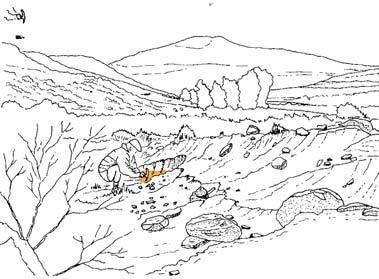
Kommandantskop (Kom 111 Sph/Dic),
Habitat: Dicroidium open woodland
Collection: 168 slabs, 10 man-hrs cleaving
Rochipteris komifolia (29 indivs) attached to shoots (leaves & ♂) – 3 slabs attached to shoots (leaves only) – 11 slabs clusters – 7 slabs (2–5 leaves)
Kannaskoppia ♀ –nil
Kannaskoppianthus ♂ – 2 indivs (affil., Grade 5)
Taphonomy (R. komifolia) – paraut.-autochthonous
Kommandantskop (Kom 111 Sph dic)
Palaeodemes SYSTEMATICS 12 cm 0 93 ISSN 2410-4418 Palaeont. afr. (2023) 57 (Special Issue): i–xiv + 1–324
M5 M4 M3 M2 M1
30
PRE/F/3227 ‘z’ pl. 48(4–8) R2 ×2 2 1 3
PRE/F/3231a,b pl. 47(1–8) R2 ×1
PRE/F/11350a pl. 63(1)
PRE/F/11351 pl. 63(2)
PRE/F/11360 pl. 63(4)
Rochipteris lutifolia
PRE/F/11378 pl. 62(1–4)
PRE/F/11359 pl. 63(6)
PRE/F/11397 pl. 63(8)
PRE/F/11374a pls 63(5), 66(4)
Cat. no. not found Cat.
PRE/F/11392a
PRE/F/11374 pl. 63(5)
Cat. no. not found
PRE/F/11412 pl. 63(9)
PRE/F/11389a pls 62(5–8), 63(7), 64(6)
PRE/F/11352 pl. 65(1,2)
PRE/F/11364 pl. 62(9–12)
Reference Palaeodeme

PRE/F/11384a pl. 67(1–7)
Holotype
PRE/F/11358a pl. 61(1–3)
PRE/F/11410
PRE/F/11377b pl. 63(13)
PRE/F/11418 pl. 63(11)
PRE/F/11387 pl. 66(1)
PRE/F/11388a pl. 66(4,5)
PRE/F/11404 pl. 63(12)
PRE/F/11401 pl. 66(2,3)
PRE/F/11354 pl. 68(1–4)
PRE/F/11355a,b pl. 68(5–9)
PRE/F/11425 pl. 65(7)
Palaeodemes SYSTEMATICS 12 cm 0 94 ISSN 2410-4418 Palaeont. afr. (2023) 57 (Special Issue): i–xiv + 1–324 R2 all ×1
Lutherskop (Lut 311 Hei elo) 1 2 3 4 5 6 7 8 19 18 17 16 9 10 11 1213 14 15 29 28 27 26 25 24 23 22
Cat. no. not found 21 20
no. not found
PRE/F/11389

Kannaskoppianthus lutinumerus
PRE/F/11426a,b pl. 58(1–6)
PRE/F/11427a,b pl. 60(1–8)
PRE/F/11438a,b pl. 56(1–6)
Holotype
Reference Palaeodeme
PRE/F/11431a pl. 55(1–6)
Holotype
PRE/F/11433a,b pl. 53(1–8)
PRE/F/11426b
PRE/F/11390a,b pl. 57(1–8)
26°56.84’E; 30°40.57’S Type (& Ref. Pal.) loc.

Lutherskop (Lut 311 Hei elo)
Habitat: Heidiphyllum thicket
Collection: 589 slabs, 50 man-hrs cleaving
Rochipteris lutifolia (66 indivs) attached to shoots – nil clusters – nil
Kannaskoppia ♀ – nil
Kannaskoppianthus ♂ – 16 indivs (affil., Grade 4)
Taphonomy (R. lutifolia) – parautochthonous
Lut 311
PRE/F/11429a,b, pl. 54(1–9)
PRE/F/11434a, pl. 59 pls 56–60 see pp 48, 138
Palaeodemes SYSTEMATICS 12 cm 0 95 ISSN 2410-4418 Palaeont. afr. (2023) 57 (Special Issue): i–xiv + 1–324 R4 ×5 16
pl. 67(1–7) all ×2 (except fig. 6) 1 R2 all ×2
PRE/F/11384a
pl. 54(1–5) 14 11 PRE/F/11434a pl. 59(1–9) 15 13 12 10 9 8 7
pl. 65(5,6) 3
4 4 3 2 1 123456789101112 microsporophylls 16 indivs total 10 indivs drawn 8 indivs graphed
311 Hei elo
Lutherskop (Lut 311 Hei elo) PRE/F/11429a
PRE/F/11386a
PRE/F/11358a pl. 61(1–3)
Lut
5 R3 ×5 6
Rochipteris lutifolia
2
M3
M5 M4
M2 M1 36 36. Lut 311
PRE/F/19754
PRE/F/19751 pl. 15(1,2)
Rochipteris lutifolia
PRE/F/2484
PRE/F/19750
PRE/F/18896 pl. 16(1,2)
PRE/F/2485
PRE/F/19744
PRE/F/18893a,b pl. 12(1–3)
Cat. no. not found
PRE/F/19745 14 15
PRE/F/18897
PRE/F/19747b pl. 16(3,4)
16
Palaeodemes SYSTEMATICS 12 cm 0 96 ISSN 2410-4418 Palaeont. afr. (2023) 57 (Special Issue): i–xiv + 1–324
Cyphergat (Cyp 111 Dic cra)
10 11 1 2 3 5 6 4 7 12 89 17
PRE/F/18894b
R2 all
×1
Cluster of 12 indivs
PRE/F/23337 13
PRE/F/18899a pl. 9(3–8)
Rochipteris lutifolia
26°25.88’E; 31°27.14’S Type (& Ref. Pal.) loc.
Cyphergat (Cyp 111 Dic cra), Open cast
Habitat: Dicroidium open woodland
Collection: 362 slabs, 100 man-hrs cleaving
Rochipteris lutifolia (80 indivs) attached to shoots – ?1 indiv. clusters of 2–10 indivs – >10 slabs clusters of 12 indivs – 1 slab
Kannaskoppia ♀ – nil
Kannaskoppianthus ♂ – nil
Taphonomy (R. lutifolia) – parautochthonous

26
26. Cyp 111
M5
Palaeodemes SYSTEMATICS 12 cm 0 97 ISSN 2410-4418 Palaeont. afr. (2023) 57 (Special Issue): i–xiv + 1–324
R2 ×2
PRE/F/18899a pl. 9(3–8)
PRE/F/18893a,b pl. 12(1–3)
2 1
Cyphergat (Cyp 111 Dic cra)
M4 M3 M2 M1
BP/2/423 pl. 103(4–8)
BP/2/546 pl. 105(9)
BP/2/425 pl. 104(8,9)
Rochipteris obtriangulata
BP/2/115 pl. 104(1–4)
BP/2/422 pl. 103(1–3)
BP/2/544
BP/2/547a pl. 105(7,8)
BP/2/115 pl. 104(1–4)
10 indivs appear on colour plates; 5 are illustr. here
(& Ref. Pal.) loc.

Umkomaas (Umk 111 Dic 2spp)
Habitat: Dicroidium riparian forest (mature, type 1)
Collection: 3592 slabs, 400 man-hrs cleaving
Rochipteris obtriangulata (19 indivs, no clusters) attached & clusters – nil
Kannaskoppia ♀ – nil
Kannaskoppianthus ♂ – nil
Taphonomy (R. obtriangulata) – parautochthonous (R. cf. sinuosa) – allochthonous
Umkomaas (Umk 111 Dic 2spp)
BP/2/544

Palaeodemes SYSTEMATICS 12 cm 0 98 ISSN 2410-4418 Palaeont. afr. (2023) 57 (Special Issue): i–xiv + 1–324
29°27.3’E;
R2 all ×1
R2
both ×2
29°33.54’S Type
M5
M3
6
12 3 4 5 6 7 8 9
M4
M2 M1
6. Umk 111
6
Rochipteris cf. sinuosa
1

6. Umk 111
M5 M4 M3 M2 M1

Umkomaas (Umk 111 Dic 2spp)
Habitat: Dicroidium riparian forest (mature, type 1)
Collection: 3592 slabs, 400 man-hrs cleaving
Rochipteris cf. sinuosa (9 indivs) attached & clusters – nil
Kannaskoppia ♀ – nil
Kannaskoppianthus ♂ – nil
Palaeodemes SYSTEMATICS 12 cm 0 99 ISSN 2410-4418 Palaeont. afr. (2023) 57 (Special Issue): i–xiv + 1–324
29°27.3’E; 29°33.54’S
Umkomaas (Umk 111 Dic 2spp)
Type (& Ref. Pal.) loc.
Taphonomy (R. obtriangulata) – parautochthonous (R. cf. sinuosa) – allochthonous 6
BP/2/539 pl. 107(1–4)
R2 all ×1
Holotype
PRE/F/23123 pl. 110(1–3)
BP/2/555 pl. 108(1,2)
BP/2/549 pl. 107(9,10)
BP/2/553 pl. 107(6–8)
BP/2/556 pl. 108(5–7)
9 5 3 10 4
PRE/F/22501 pl. 109(1–4)
BP/2/554 pl. 108(3,4)
8 7 R2 ×1 R2
2
BP/2/557 pl. 108(8–10)
×2
PRE/F/17946a pl. 87(1)
PRE/F/17945 pl. 87(2)
Reference
Rochipteris
penensis J.M.And. & H.M.And.,
sp. nov.
PRE/F/17032 pl. 87(3)
PRE/F/17035 pl. 87(4)
PRE/F/17047 pl. 87(5)
PRE/F/17944 pl. 87(6)
Peninsula (Pen 411 Hei elo )
PRE/F/17050 pl. 87(7)
Holotype
pl. 87(8) pl. 88(5)
PRE/F/17943b
PRE/F/18168 pl. 77(6–9)
PRE/F/18169 pl. 78(1–3) PRE/F/18170a,b pl. 77(10–15)
PRE/F/18167a pl. 77(1–5)
PRE/F/16914a,b pl. 78(4–7)
Sister palaeodeme
PRE/F/18255 pl. 46(8,9)
PRE/F/17405a,b
2 indivs appears on colour plates; as illustr. here
PRE/F/16914a,b pl. 78(4–7)
PRE/F/18170a,b pl. 77(10–15)
5 indivs appear on colour plates; all are illustr. here
Peninsula (Pen 311 Hei elo )
PRE/F/18255 pl. 46(8,9)
Tel 111
PRE/F/17405a
PRE/F/17405b pl. 46(6,7)
PRE/F/17405a,b
Sister palaeodeme
PRE/F/18277a,b pl. 42(1–8)
Kannaskoppianthus telepentatus (affiliated ♂ strobilis, as at sister TC)
PRE/F/18167a pl. 77(1–5)

15
15. Pen 311, 411
M5 M4 M3 M2 M1
27°56.78’E; 31°30.35’S Type (& Ref. Pal.) loc.

Peninsula (Pen 411 Hei elo), Lunchspot spot
Habitat: Heidiphyllum thicket
Collection: 204 slabs, 70 man-hrs cleaving
Rochipteris penensis (10 indivs)
attached & clusters – nil
Kannaskoppia ♀ – nil
Kannaskoppianthus ♂ – 4 indivs (not affil. here)
Taphonomy (R. penensis) – allochthonous

27°56.84’E; 31°29.59’S Type (& Ref. Pal.) loc.
Peninsula (Pen 311 Hei elo), Campsite Quarry
Habitat: Heidiphyllum thicket
Collection: 155 slabs, 35 man-hrs cleaving
Rochipteris penensis (5 indivs)
attached & clusters – nil
Kannaskoppia ♀ – nil
Kannaskoppianthus ♂ – nil
Taphonomy (R. penensis) – allochthonous
Palaeodemes SYSTEMATICS 12 cm 0 100 ISSN 2410-4418 Palaeont. afr. (2023) 57 (Special Issue): i–xiv + 1–324
×1
Telemachus Spruit (Tel 111 Hei elo ) all ×2
all
R2 all ×1 1 2 3 4 5 6 R2 all ×1 9 10 11 12 13 R2 all ×2 1415 16 17 19 18 20 21 22
R2
R2 ×5
×2
palaeodeme 24 25
23
7
8
1
Rochipteris pusilla Holmes & H.M.And., 2005
PRE/F/16915b pl. 78(8–11)
Reference palaeodeme
2
PRE/F/16915b pl. 78(8–11)
Peninsula (Pen 311 Hei elo )
PRE/F/17393‘y’
Sister palaeodeme
×2
This single virtually complete specimen is closest to R. distivena, in having similar divided tips and open venation, but lacks the characteristic deep division of the leaf and is of much smaller size, which suggests it may represent a distinct species.
4 3 5 6 7
PRE/F/18166a pl. 78(12–15)
×2
all R2
PRE/F/16568a,b pl. 7(1–7)
R2
×2
Greenvale (Gre 111 Equ sp)
all R2

M5 M4 M3 M2 M1 32
26°47.78’E; 31°02.86’S Type (& Ref. Pal.) loc.

Telemachus Spruit (Tel 111 Hei elo)
Habitat: Heidiphyllum thicket
Collection: 581 slabs, 90 man-hrs cleaving
Rochipteris pusilla (1 indiv.)
attached & clusters – nil
Kannaskoppia ♀ – nil
Kannaskoppianthus ♂ – 4 indivs (not affil. here)
Taphonomy (R. pusilla) – allochthonous
27°08.94’E; 31°23.62’S Type (& Ref. Pal.) loc.

Greenvale (Gre 111 Equ sp)
Habitat: Equisetophyte marsh
Collection: 213 slabs, 25 man-hrs cleaving
Rochipteris sp. indet. (1 indiv.)
Kannaskoppia ♀ – nil
Kannaskoppianthus ♂ – nil
Taphonomy (R. sp. indet.) – allochthonous

M5 M4 M3 M2 M1 20
20 Gre 111, 121
Palaeodemes SYSTEMATICS 12 cm 0 101 ISSN 2410-4418 Palaeont. afr. (2023) 57 (Special Issue): i–xiv + 1–324
Telemachus Spruit (Tel 111 Hei elo ) ×1 ×1
Rochipteris sp.
32. Tel 111
PRE/F/17393‘y’
PRE/F/18166a pl. 78(12–15)
HYPODIGM CHARTS; GONDWANA TRIASSIC (GT)
Petriellales/Kannaskoppia, illustrations & identification
The concept of the hypodigm chart was introduced in And. & And. (1983, p. 74) for our Dicroidium monograph, and followed in subsequent Molteno volumes (And. & And., 1989, 2003, 2008, 2018). It aims at documenting all illustrations (photographs or sketches) in the published Gondwana Triassic (GT) literature for the group of plants being described – in this case the Petriellales/ Kannaskoppia and affiliates. Each specimen is identified according to our current taxonomic review and arranged by geographic and stratigraphic occurrence.
Our species identifications, as per the present volume, appear in the final column of the hypodigm.
The hypodigm is a fundamental aid to establishing nomenclature following the rules of priority according to ICN 2018.
Gondwana Triassic occurrence
The layout focuses attention on assemblages and palaeodemes, and provides the data for the GT distributions plotted on the genus pages. The subregion gives the names and numbers for the productive degree squares listed; details are given elsewhere. While the formation and number codes (age, millions of years) refer to Fig. 2 (p. 5) as followed here (see Part 1, ‘Sampling & Occurrence’; Chart 2, pp 4, 5).
Gondwana Triassic correlations
At stage level, global and Gondwana Triassic floral correlations were updated by And., And. & Cleal (2007). Though the correlations have been further updated here, they are still in need of thorough revision based on the most recent absolute dating and palynological data around the Gondwana Triassic (Mancuso et al., 2020 & other references as listed, Chart 2, p. 5).
Accessability
In the current volume the aim is to make the hypodigm more readily accessible, more user-friendly. The hypodigm tables have been elaborated on by accompanying them, continent by continent, with relevant parts of the Gondwana Triassic map and correlation chart, and of the ‘productive degree squares’ and ‘Megaplant-bearing Formations’ tables. In the case of the Africa tables, sketches of the foliage and strobilus species (female and male) are also added.
Gondwana Triassic Rochipteris species
Those species described from around the Gondwana Triassic from Carruthers (1872) on, are discussed below under five general morphological groups (these could be considered subgenera). Reference to the Molteno species described in this volume is made where relevant.
Group 1 – R. lacerata; large leaves variously divided to about half the length of lamina
Rochipteris lacerata (Arber, 1917) Herbst et al., 2001
The type specimen from New Zealand (Hypodigm, Chart 3, pp 110, 111) was first reported and figured as Chiropteris lacerata by Arber (1913) and then described and refigured at a later date (1917). This single leaf has a deep division, is fairly complete on one side with clear lacerate tips, whilst the other half is incomplete and the diagnostic base is missing. The size exceeds 50 mm in length and 30 mm in breadth. The venation shows clear anastomose on the lamina to near the leaf tips. Retallack (1980) made new collections from various localities in New Zealand, placed Chiropteris lacerata in the genus Ginkgophytopsis and synonymized it with the two species Chiropteris biloba and Chiropteris waitakiensis, described as new by Bell et al. (1956); and transferred the leaf described as Ginkgo digitata. These collections and further ones (Retallack 1981, 1983) show deeply dissected to fairly entire leaves – all showing the characteristic anastomosing venation. Based on the illustrations, they appear to have much finer venation than the type specimen (there may be an error in the size as printed). Two leaf whorls are recorded by Retallack (1980, fig. 9C; 1983, fig, 7E). Herbst et al. (2001, p. 262) discussed the leaf Cyclopteris lacerata Quenstedt, which was later transferred to Chiropteris Kustatcher & Van Konijnenburg-Van Cittert (2011, p. 232) described further Chiropteris lacerata leaves from Germany and regarded the New Zealand species as a junior synonym. This was an error because they had not referred to the papers of Retallack (1980) and Herbst et al. (2001).
From South America (Hypodigm, Chart 1, pp 106, 107), Llantenes Basin, Menendez (1951) described leaves as Chiropteris copiapensis; subsequently identified as R. lacerata by Retallack (1980) and Herbst et al. (2001).
Further leaves were descriped from the Llantenes Basin by Artabe et al. (1998) as Ginkgophytopsis lacerata. Later, Herbst et al. (2001) described leaves from the Copiapo and El Tranquilo basins as R. lacerata. These records from various localities in South America show a diverse morphology of dissected leaves and need to be re-evaluated as to whether they all belong to R. lacerata
At this stage it is difficult to establish the circumscription (borders/limits) of this species which has been applied to a variety of leaves. The incomplete type specimen, lacking the diagnostic base, has resulted in variable interpretation. The majority of the collections from New Zealand are regarded here as belonging to R. lacerata, while the usage in South America is questioned. From the Molteno there is some overlap in morphology with R. telefolia, but R. lacerata leaves are generally smaller with finer venation, and similarly R. distinerva has more open venation, while R. lacerata has finer venation especially towards the tips. The Molteno fossils which were previously called R. lacerata have been placed elsewhere (Hypodigm, Chart 2, pp, 108, 109). The two New Zealand species, Chiropteris waitakiensis and C. biloba (Bell et al., 1956), synonymized with R. lacerata by Retallack (1980), are accepted.
Rochipteris incisa Holmes & H.M.And.,
2005
This species described from Australia, Nymboida Basin, is based on 11 specimens from two localities. The type is somewhat similar to the type of R. lacerata figured by Arber (1917) but is
HypodigmSYSTEMATICS 102 ISSN 2410-4418 Palaeont. afr. (2023) 57 (Special Issue): i–xiv + 1–324
much more dissected with leaf tips broadly obtuse. There is some overlap in morphology with R. telefolia from the Molteno, but the leaves are generally smaller and have not been found attached or associated with male strobili.
Group 2 – R. rollerii; small to medium leaves variously divided to more than half the length of lamina
Rochipteris rollerii (Frenguelli, 1946) Bodnar et al., 2020
Frenguelli (1946) originally described his material, from Cacheuta, Argentina, as a species of Baiera. A study of the specimens by one of the authors (HMA, 12 October1999, La Plata) confirmed that the leaves had anastomosing venation and did not belong to Baiera. Bodnar et al. (2020) have now restudied the Frenguelli (1946) specimens, described further ones from Cacheuta and nominated a lectotype. They regarded some leaves, identified by Frenguelli (1946) as Baiera cuyana, on the same slab as the lectotype, to belong to R. rollerii. They still considered B. cuyana as a valid species of Baiera, as the original leaf from Barreal (Frenguelli, 1942) did not show anastomosing venation; however, in shape, it is rather similar to Rochipteris leaves. The Molteno palaeodemes compare well with the Cacheuta collection of leaves in shape and size. Note that the reconstruction of the leaf by Frenguelli (1946, fig. 1b) has an extra four segments and that none of the leaves photographed have that many segments. The other leaf (Frenguelli 1946, fig. 1a) was reconstructed with bifurcating venation instead of anastomosing veins and this leaf, nominated as the lectotype, has been re-illustrated by Bodnar et al. (2020, fig. 5A). This species is common at the type locality and overlaps with R. truncata occurring at the same horizon.
Rochipteris alexandriana Herbst et al., 2001
This species was based on two leaves from El Tranquilo, Argentina, by Herbst et al., 2001. The type specimen of Rochipteris alexandriana nominated by Herbst et al. (2001, fig. 8D) has up to two divisions of the lamina and fairly narrow segments. It is similar to leaves in the R. rollerii population in the more divided and thinner end of the range; and is also similar to leaves in the R. switzifolia range that are not up to four times divided and with broader segments. In the Molteno, these two species are regarded as distinct palaeodemes in assemblages deriving from separate habitats, and being associated with distinct male strobilli. It could be that in Argentina, once more specimens are known, a separate palaeodeme exists to support the retention of this species. At present, the two leaves described by Herbst et al. (2001), fall more closely in R. rollerii and the diagnosis does not cover the deeply divided leaves with multiple segments (up to 28) of R. switzifolia In their synonymy they included two unnamed leaves from the Molteno (now described as two new species). They did not mention or compare their leaves with similar ones described by Frenguelli (1946) from Cacheuta and seem to have been unaware of that literature. Frenguelli’s (1946) leaves were placed by Bodnar et al. (2020) in R. rollerii with a lectotype nominated from the original material. This type has somewhat broader leaf segments than the Herbst et al. (2001, fig. 8D) type specimen but is very similar to the second specimen (fig. 8H). Based on the palaeodemes from the Molteno, both specimens could belong in one or other population of Molteno R. rollerii leaves but as only two specimens have been described, it is difficult to decide.
An attached group of leaves from Antarctica were identified as R. alexandriana by Bomfleur et al. (2014). These would now fit better into one of the Molteno species, R. switzifolia or R. matatifolia that are more deeply divided, up to four times, resulting in finer segments. However, as the detail of the venation in the petiole is not clear enough in their illustrations, it is difficult at present to place them in either.
Group 3 – R. cuneata; small to medium leaves, mainly entire
Rochipteris cuneata (Carruthers, 1872) Herbst et al., 2001
This is the earliest species to be described from Gondwana (Tivoli Coal Mine, Ipswich Basin, Australia), originally under the genus Cyclopteris by Carruthers (1872, p. 355, pl. 27 (fig. 5)) and has been applied to various subsequent finds. It is unfortunate that the type specimen (housed in the Natural History Museum, London; catalogue number V. 4197, Rozefelds, 1986) is incomplete, with the diagnostic base missing. A subsequent leaf described from the same locality (Tivoli Coal Mine) is recorded by Jack & Etheridge (1892, p. 378), though not figured, it is described as complete and “more or less petiolate-like”. Another leaf described by this name (Shirley 1898, pl. 23) has neither the tip nor base preserved but clearly shows anastomosing venation. Seward (1903) described a leaf under this name from the Molteno Formation at Cyphergat (equivalent to Cyp 111). Du Toit (1927) redescribed the same leaf and exposed the base to show a narrow petiole. Subsequent collections from this locality and the reference palaeodeme (Lut 311) have resulted in a good population of leaves which are all smaller than the type specimen of Carruthers (1872) and have a distinct cuneate shape. This population from Cyp 111 is now placed in R. lutifolia. Note that Du Toit (1927, t-fig. 3B) placed a second incomplete leaf from Umk 111 in this species which is here classified as belonging to R. cf. sinuosa due to the characteristic widely spaced venation. Subsequently Retallack (1980; 1983, fig. 7A) described a single incomplete specimen from New Zealand as R. cuneata which is here placed in R. lacerata (Hypodigm, Chart 3, pp 110, 111). The specimens described as R. cuneata by Herbst et al. (2001, p. 264, fig. 3(A–C), pl. 8(F,G)) from Chile and Argentina are also close to R. copiapensis but show a more obtuse distal margin.
Rochipteris tasmanica (Walkom, 1926) Herbst et al., 2001 (as per Squires, 2012)
This species was based on a single specimen from Tasmania by Walkom (1926). In a previous paper Walkom (1925b) regarded a similar leaf described by Johnston (1888) as Sagenopteris salisburioides as not having anastomosing veins and belonging to Ginkgoites. Walkom (1926) said his leaf was similar to R. cuneata described from Cyphergat in the Molteno by Seward (1903, pl. 9(4)).
The Walkom specimen is similar in shape and size to the population of leaves collected from Cyphergat but as it lacks the defining characters of the base and petiole it is not possible to say if it is the same. The species requires further study from the type locality. Retallack (1983) described two leaves (the larger one is fragmentary and the other is small with a semi-circular shape) as Ginkgophytopsis tasmanica (p. 145, fig. 7B,C). They are close to R. tasmanica, in being small and entire, but the very fine venation sets them apart from the type specimen. These two leaves are placed as Rochipteris sp. indet. in the hypodigm table.
Rochipteris nymboidensis Holmes & H.M.And., 2005
This species from Nymboida, Clarence-Moreton Basin, Australia, is based on one almost complete specimen with very fine venation (c. 30–35 per 10 mm across the mid-upper portion of the lamina. It is larger (> 63 mm long) and has finer venation than the leaves of R. lutifolia from Lut 311 and is considered distinct. It shows some similarity to the type of R. cuneata (Ipswich Basin) but is larger and the shape is clearly more cuneate. The venation is probably finer but is difficult to compare in more detail with the type specimen.
Rochipteris obtriangulata Holmes & H.M.And., 2005
This species was based on a remarkable slab from Nymboida, Australia, bearing a nearly complete whorl of leaves and portions of another two whorls and isolated leaves. The foliage is arranged
Hypodigm SYSTEMATICS 103 ISSN 2410-4418 Palaeont. afr. (2023) 57 (Special Issue): i–xiv + 1–324
in a close spiral or in a terminal whorl of 8–10 leaves on a narrow stem. The leaf bases are hidden in the matrix and it is not possible to observe the actual point of attachment. The wedge-shaped leaves compare closely in size and shape with the isolated leaves from the Molteno (Umk 111). They may appear to have a longer base, but this is due to the Nymboida leaves being foreshortened as they curve down into the sediment.
Rochipteris truncata (Frenguelli, 1946) Morel et al., 2011
Frenguelli (1946) originally described this material, from Cacheuta, Argentina, as a species of Ginkgoites. A study of this material by one of the authors (HMA, 12.10.1999, La Plata) confirmed that the leaves had anastomosing venation and did not belong to Ginkgoites. Morel et al. (2011, fig. 2(1)) described further specimens and nominated a lectotype from Frenguelli’s (1946, fig. 7(1)) material and refigured it. Bodnar et al. (2020), in describing further specimens, included dissected leaves in this species; which would be better placed in R. rollerii. The undivided cuneate lamina and truncate tip of this leaf sets it apart from R. rollerii in the Molteno and, while similar to R. obtriangulata, it is a shorter leaf and not as narrow at the base. R. truncata is regarded as a separate species, with the population from Cacheuta being morphologically between R. obtriangulata and the similar species R. penensis
From the Cretaceous of Australia, McLoughlin et al. (2000) described Ginkgophytopsis truncata, which is a similar but much larger leaf and is here considered a separate species – although Gnaedinger & Zavattieri (2017) regarded it as conspecific with Rochipteris truncata from Argentina.
Rochipteris turbata Holmes & H.M.And., 2005
This single whorl of leaves from Nymboida, Australia, bears two virtually complete and another five partial leaves. Due to the 3D nature of the specimen, the actual attachment to a stem is hidden in the matrix and it is not possible to see the base of the leaves. The species was separated from R. obtriangulata on the basis of the expanding lamina, cuneate shape and rounded leaf apex (not truncate). It has a similar shape and venation density (20–25 per 10 mm) to R. lutifolia and R. komifolia in the Molteno. As the defining character of the veins in the petiole of the Molteno species is not visible in this Nymboida specimen, it is retained as a distinct species.
Rochipteris pusilla Holmes & H.M.And., 2005
Due to the small size, similar shape and open venation, the Molteno specimens have been placed in this species which is based on a single specimen from Nymboida and has a slightly undulate upper margin. As so few specimens occur in the four assemblages from the Molteno, the specific identity is somewhat provisional.
Group 4 – R. copiapensis; large leaves entire to occasionally partly divided
Rochipteris copiapensis (Solms-Laubach, 1899) Herbst et al., 2001
The original collection from Chile (Solms-Laubach, 1899, pl. 13 (1–4)) is illustrated by three large, incomplete leaves. Two show the basal area and are entire, while the third, lacking the base, shows a few notches at the distal end. Herbst et al. (2001) revised R. copiapensis and made a new species, R. chilensis (SolmsLaubach, 1899) Herbst et al. (2001) nominating the notched leaf (Solms-Laubach, 1899, pl. 13(3–4)) as the type. In the latter species, they included further specimens which are all entire (Herbst et al., 2001, fig. 6(A–H), pl. 8(L)), and which could readily be placed in
R. copiapensis. These specimens should all be restudied so that a correct assessment can be made on the validity of R. chilensis. However one interprets these species, they are clearly apart from the Molteno specimens in being about twice as large and in not showing any deep division of the lamina. Herbst et al. (2001, p. 266) remarked that the Du Toit (1927) specimen, originally described as Chiropteris copianpensis, is a different species. The subsequent collection of a further 19 individuals from the same Molteno locality, is now placed in R. obtriangulata
Rochipteris chilensis (Solms-Laubach, 1899) Herbst et al. 2001
Consult text for R. copiapensis.
Group 5 – R. etheridgei; large leaves variously divided with clasping base.
Rochipteris etheridgei (Arber, 1917) Barone-Nugent et al., 2003
This species from Leigh Creek, Australia, was first described by Arber (1917) as a Chiropteris. It was later transferred to Psygmophyllum by Chapman & Cookson (1926) and more recently to Rochipteris by Barone-Nugent et al. (2003). This species has a distinct auriculate clasping base/flange 4–6 mm wide. Incomplete leaves, without the base, show similarities to R. lacerata in the flabellate shape and dissected lamina. The cuticle as described by Barone-Nugent et al. (2003), with papillate epidermal and subsidiary cells, is rather different to that obtained for Molteno leaves by And. & And. (2003). Consult Part 2 (p. 51).
Rochipteris ginkgoides Barone-Nugent et al., 2003
This species, described from the Ipswich Basin, Australia, is based on four variable specimens (a small portion of a fifth exists) from two localities. The holotype (QMF 12586) is similarly dissected to a second more complete leaf (QMF 12588) but in neither is the base preserved. A smaller leaf (QMF 182630) has a relatively broad lamina and narrow base with the suggestion of a clasping base/flange. Another leaf (QMF 26012), with only the base figured, has a distinct clasping base/flange. This is referred to as “base expanded into a broad but short sheath” in the description by Barone-Nugent et al. (2003, p. 281) and is similar to the clasping base/flange occurring in R. etheridgei. These leaves show an overall similarity to R. telefolia (Tel 111), but the characteristic clasping base/flange of the base is unknown in this assemblage and in any other leaves from the Molteno. The leaves are known attached (in two specimens) for R. telefolia and are thus separated from this somewhat similar-shaped species.
Rochipteris sinuosa Holmes & H.M.And., 2005
This species was based on a single unique leaf from Nymboida, Australia, primarily on the widely spaced sinuous venation. The base of the leaf shows an expansion, suggesting a clasping base which although not preserved in its entirety is considered natural and not an artifact. The Molteno leaf is provisionally placed in this species as it is similar in size, with a deeply divided lamina, and venation. However, as the base is incomplete, it is not possible to ascertain whether it also has the clasping characteristic. Clasping bases or flanges are found in R. etheridgei (Arber, 1917) BaroneNugent et al., 2003, a large leaf with numerous divisions in the upper part of the lamina, and in R. ginkgoides Barone-Nugent et al., 2003, also a large leaf with variable deep divisions. Holmes & H.M.And. (2005) compared R. sinuosa to leaves of similar size (40–60 mm) from the Llantenes, Argentina, described by Menendez (1951) which differ in being more cuneate in shape and not deeply divided.
HypodigmSYSTEMATICS 104 ISSN 2410-4418 Palaeont. afr. (2023) 57 (Special Issue): i–xiv + 1–324
SAmSAfIndAntAus
Molteno species ChNASAPaLuZaLiKaWHPlTANZCaSAGaBoCMNESyViTa
1 R. vincularis
2 R. telefolia
3 R. distivena
4 R. rollerii
5 R. switzifolia
6 R. matatifolia
7 R. komifolia
8 R. lutifolia
9 R. obtriangulata
10 R. cf. sinuosa
11 R. penensis
12 R. pusilla
R. sp. indet.
Other Gondwana Triassic species
1 R. alexandriana ?
2 R. copiapensis
3 R. cuneata ?? ? cf.
4 R. etheridgei
5 R. ginkgoides
6 R. incisa
7 R. lacerata ? cf.
8 R. nymboidensis
9 R. sinuosa
10 R. tasmanica
11 R. truncata
12 R. turbata
R. sp. indet. ?

SAm South America
Ch Chile
NA N. Argentina
SA S. Argentina
Pa Parana Basin
SAf Southern Africa
Lu Luangwa Valley
Za Zambezi Valley
Li Limpopo Valley
Ka Karoo Basin
Ind India
WH W. Himalayas
PI Peninsula India
Ant Antarctica
TA Transantarctic Mts
GEOGRAPHIC OCCURRENCE
Updated from And. & And. (1983, 1989, 2003)
Aus Australia
NZ New Zealand
Ca Canning Basin
SA S. Australia
Ga Galilee Basin
Bo Bowen Basin
CM Clarence/Moreton B.
NE New England Fold belt
Sy Sydney Basin
Vi Victoria
Ta Tasmania
Hypodigm SYSTEMATICS 105 ISSN 2410-4418 Palaeont. afr. (2023) 57 (Special Issue): i–xiv + 1–324
Fig. 1. Gondwana Triassic megaplants.
3 Subregion (degree square), with Rochipteris (& affiliates)
Tab. 1. Rochipteris: Geographic occurrence of species, Gondwana Triassic.
Hypodigm charts; Rochipteris et alii, Gondwana Triassic (GT) occurrences
Chart 1.
SOUTH AMERICA
Chile (Ch) Ma
1899 Solms-Lau. & Stein. CopiapoCh1207La TerneraQ. de la Ternera Chiropteris copiapensis sp. nov.
2001 Herbst et al “““ “Q. Cachivarita Rochipteris lacerata comb. nov.
“ “ “““ “ “ Rochipteris copiapensis comb. nov.
“ “ “““ “ “ Rochipteris chilensis sp. nov.
“ “ “““Las BreasPunto del Vento Rochipteris cuneata comb. nov.
“ “ “““La Ternera?Q. Cachivarita Rochipteris sp.
1970Azcárate & FasolaLos VillosCH3207?Los MollesLos Molles Chiropteris copiapensis
2012Herbst & TroncosoAtacamaCh ?242Q. del SalitreQ. de Dõna Ines Chica cf. Rochipteris sp. N. Argentina (NA)
2011 Lutz et al. IschigualastoNA1234Los RastrosQ. del León Rochipteris alexandriana
1946Frenguelli (87)CacheutaNA4233PotrerillosCacheuta Hill Baiera rollerii sp. nov.
2011 Morel et al. ““ “ “ Baiera rollerii
2020 Bodnar et al “““ “ Rochipteris rollerii comb. nov.
1946Frenguelli (87) “““ “ “ Baiera cuyana
2011 Morel et al “““ “ “ Baiera cuyana
1946Frenguelli (87) “““ “ “ Ginkgoites truncata sp. nov.
2020 Bodnar et al “““ “ Rochipteris truncata
1946Frenguelli (87) “““ “El Challao Baiera bidens
““ “““ “ “ Ginkgoites truncata sp. nov.
2011 Morel et al. “““ “ “ Rochipteris truncata comb. nov.
2007 Artabe et al. “““ “Perfil cerro Bayo Rochipteris sp.
1951MenendezLlantenesNA5233LlantenesArroya Llantenes Chiropteris copiapensis
1998 Artabe et al ““233 “ “ Ginkgophytopsis lacerata
S. Argentina (SA)
2001 Herbst et al. El TranquiloSA3235Cãnadõn LargoEstancia Cãnadõn Rochipteris cuneata comb. nov.
“ “ “““ “ “ Rochipteris alexandriana sp. nov.
“ “ “““Laguna ColoradoEstancia Cãnadõn Rochipteris lacerata comb. nov.
“ “ “““ “ “ Rochipteris copiapensis comb. nov.
JurassicS. Argentina (SA)
2017Gnaed. & Zavat.NeuquénSANestaresdownstream of Alicurá Dam Rochipteris copiapensis
SAm, Productive degree squares
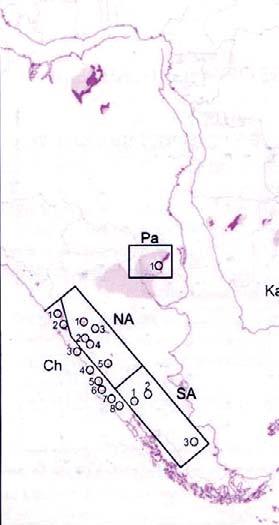
SAm, Productive degree squares (megaplants)

outcrop subsurface
Triassic regions subregions (° squares) with Rochipteris

• map, correlation chart & tables (lower half of page) extracted from Part. 1 ‘Sampling & Occurrence’ (Chart 2, p. 4)
HypodigmSYSTEMATICS 106 ISSN 2410-4418 Palaeont. afr. (2023) 57 (Special Issue): i–xiv + 1–324
AUTHOR REGION & SUBREGION FORMATION (beds, horizons) LOCALITYNAME (as in literature)
IDENTIFICATION (this volume)
sketches (s) photos (p) indivs ILLUSTRATIONS R. vincularis R. telefolia R. distivena R. rollerii R. switzifolia R. matatifolia R. komifolia R. lutifolia R. obtriangulata R. cf. sinuosa R. penensis R. pusilla R. alexandriana R. copiapensis R. cuneata R. etheridgei R. ginkgoides R. incisa R. lacerata R. nymboidensis R. sinuosa R. tasmanica R. truncata R. turbata R. sp. indet. 123456789101112123456789101112–Molteno speciesOther Gondwana Triassic species
s3pl 13(1–4)
s1fig 2(F) ?
1not illustrated
s3fig 6(A–H), p. 8(L)
1not illustrated?
s1fig 7(A–C), pl 8(E)
p1fig 2 *?
sp1fig 4 (C–E)
sp1figs 3(25), 7(10) ?
p>6t.fig 1, pl 1(a–e)
p1fig 2 (7)
p6pl 5(A–C,E,G,H)
p>3pl 1, (1A, 2 part)
p27fig 2 (4)
p3pls 4(4), 7(1,2)
p4pl 5 (D,F,I,J)
p2pl 2(2,3)
p9pls 1(1B, 2part), 6 (2 part)
p1fig 2 (1)
p1fig 5(H)
p3pl 3(1–4)
p6fig 5 (I)
sp3fig 3(A–C), pl 8(F,G)?
sp2fig 5(A,B), pl 8(D,H)
sp5fig 2(A–E), pl 8(A–C)
sp4fig 4(A–K), pl 8(I,K)
p3pl 3(A–G)
SAm, Megaplants, Trias.
SAm, Megaplant-bearing Formations (beds, horizons)
Chile (CH)
207 La Ternera
“ El Puquen
“ Gomero “ Tralcan
209 Gomero “ Tralcan
231 Quilacoya
232 Quilacoya
242 (Alto Del Carmen) “ Atacama
N. Argentina (NA)
227 Ischigualasto “ Q. de la Mina
228 C. de Piedra
230 L. Carrizal “ Cacheuta
233 Panul “ Potrerillos “ Llantenes
235 Los Rastros “ Cortaderita “ Chihuiu (U)
238 Ischichuca “ Barreal
242 Las Cabras (M/U)
243 Las Cabras (L)
Ma – age marking base of Formation bar
SAm species
S. Argentina (SA)
232 Paso Flores
235 El Tranquilo
El
238 Los Menucos
Parana Basin (Pa)
227 Santa Maria
beds with Rochipteris (& affiliates)
Adapted from And. & And. (1989, p. 30; 2003, p. 7)
Footnotes (see column under Illustrations): pl 1, 1(A, 2part) – ‘part’ indicates only a part of the figure is relevant.
Hypodigm SYSTEMATICS 107 ISSN 2410-4418 Palaeont. afr. (2023) 57 (Special Issue): i–xiv + 1–324
occurrence SAm ChNASAPa UPPER R N C M L A L Triassic 201 209 227 237 242 247 252 Period Epoch Stage Ma 210 220 230 240 250 O I Ischig. Rastros Triassic Stages R N C Rhaetian Norian Carnian L A Ladinian Anisian O I Olenekian Induan
beds with Rochipteris
megaplant-bearing fms
Hypodigm charts; Rochipteris, Gondwana Triassic (GT) occurrences
AFRICA
1889FeistmantelKaroo BasinKa 8233MoltenoCyphergat Anthrophyopsis (?) sp.
1903Seward “““ “ “ Chiropteris cuneata
1927Du Toit “““ “ “ Chiropteris cuneata
“ “ “Ka 4“ “Upper Umkomaas Chiropteris cuneata
“ “ “““ “ “ Chiropteris copiapensis
“ “ “““ “ ““
1983And. & And.Karoo Basin““MoltenoUmkomaas (Umk 111) Ginkgophytopsis sp. A
“ “ “Ka 8“ “ Kommandantskop (Kom 111) “ cuneata
“ “ “Ka 7“ “Matatiele (Mat 111) “ lacerata
“ “ “““ “ ““ sp. B
“ “ “Ka 4“ “Umkomaas (Umk 111)“ sp. C
“ “ “““ “ ““ sp. D
1985And. & And. “Ka 7“ “Matatiele (Mat 111) “ lacerata
2003And. & And.Karoo BasinKa 9“MoltenoKannaskop (Kan 111) Kannaskoppifolia vincularis sp. nov.
“ “ “““ “Peninsula (Pen 311)“ sp. A
“ “ “““ “ ““ sp. B
“ “ “Ka 4“ “Umkomaas (Umk 111)“ sp. C
“ “ “Ka 8“ “Cyphergat (Cyp 111)“ sp. D
“ “ “Ka 5“ “Lutherskop (Lut 311)“ sp. D
“ “ “Ka 8“ “ Kommandantskop (Kom 111) “ sp. D
“ “ “Ka 9“ “Peninsula (Pen 311)“ sp. E
“ “ “Ka 8“ “Aasvoëlberg (Aas 211)“ sp. E
“ “ “““ “Aasvoëlberg (Aas 311)“ sp. E
“ “ “““ “Aasvoëlberg (Aas 411)“ sp. E
“ “ “Ka 2“ “Little Switzerland (Lit 111)“ sp. F
“ “ “Ka 7“ “Matatiele (Mat 111)“ sp. F
“ “ “Ka 4“ “Umkomaas (Umk 111)“ sp. G
“ “ “Ka 8“ “Telemachus Spruit (Tel 111)“ sp. H
“ “ “Ka 9“ “Kannaskop (Kan 112)“ sp. I
“ “ “Ka 8“ “Aasvoëlberg (Aas 111) Kannaskoppianthus lutinumerus sp. nov.
2007And., And. & Cleal “Ka 9“ “Kannaskop (Kan 111) Kannaskoppia vincularis
““ “Ka 9“ “Peninsula (Pen 311) Kannaskoppifolia sp. E



HypodigmSYSTEMATICS 108 ISSN 2410-4418 Palaeont. afr. (2023) 57 (Special Issue): i–xiv + 1–324 Lit 111 BP/2/1559 5
3 AUTHOR REGION & SUBREGIONFORMATIONLOCALITYNAME
in literature)
R. switzifolia
(as
1
PRE/F/13545 12 cm 0
2 R2 all ×1
PRE/F/9082a,b
R.
vincularis Kan 111
Aas 311 PRE/F/19020b Sister palaeodeme 4 R. rollerii R. telefolia
Mat 111
Ma
R. matatifolia 6
Chart 2.
sketches (s) photos (p)
s1pl 2(4)
s1pl 9 (4)
s* t.fig 3(A)
s1t-fig 3(B)
s1t.fig 3(C,E)
s1t.fig 3(D)
sp1pl 10(1)
p1pl 10(2)
p1pl 10(3)
p1pl 10(4)
p1pl 10(5)
p1pl 10(6)
p*pl 192(3)
s14pp 295,297, pls 106,107
s1p 296(5)
s1p 296(4)
s1p 297(1)
s1p 296(3)
s1pl 111
p1pls 108(4,5)
s1p 297(3)
p1pl 113(5,6)
p1pl 114(6)
p1pl 115(9)
s1p 297(6)
p2pl 114(11,12)
s1p 297(7)
s6p 297(2), pl 119
s1p 297(5)
p1pl 112(7,10)
s1p 185(1)
s1p 185(9)
123456789101112
Molteno species


Cyp 111 PRE/F/18899a
Tel 111
SAf, Productive degree squares (megaplants)
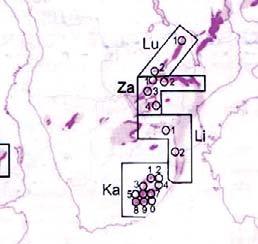
Triassic
outcrop subsurface

regions subregions (° squares) with Rochipteris
SAf, Productive degree squares (megaplants)



SAf, Megaplants, Trias. occurrence
Pen 311 PRE/F/16915b
SAf, Megaplant-bearing Formations
SOUTHERN AFRICA
Luangwa Valley (Lu)
232 ‘U. Grit’
247 Ntawere
Zambezi Valley (Za)
232 ‘Flags’
Limpopo Valley (Li)
232 (Molteno)
Karoo Basin (Ka)
233 Molteno
247 Burgersdorp
Ma – age marking base of Formation bar beds with Rochipteris (& affiliated strobili)
Hypodigm SYSTEMATICS 109
Palaeont. afr. (2023) 57 (Special Issue): i–xiv + 1–324
ISSN 2410-4418
indivs ILLUSTRATIONS R. vincularis R. telefolia R. distivena R. rollerii R. switzifolia R. matatifolia R. komifolia R. lutifolia R. obtriangulata R. cf. sinuosa R. penensis R. pusilla
R2 all ×1
111 PRE/F/3227 (reverse) 7
komifolia
111 BP/2/115 9
obtriangulata
Kom
R.
Umk
R.
10
Umk 111 BP/2/539
R. cf. sinuosa
12
8
R. pusilla
0
R. lutifolia Sister palaeodeme 12 cm
11 R. penensis Sister palaeodeme
SAf LuZaLiKa UPPER R N C M L A L Triassic 201 209 227 237 242 247 252 Period Epoch Stage Ma 210 220 230 240 250 O I
formations beds
Rochipteris
PRE/F/17405a,b IDENTIFICATION (this volume)
megaplant-bearing
with
(& affiliated strobili)
Hypodigm charts; Rochipteris, Gondwana Triassic (GT) occurrences
Chart 3.
ANTARCTICA
Ma
Trans-Antarctic Mts (TA)
2014 Bomfleur et al. Allan NunatakTA1238LashlyAllan Hills Rochipteris alexandriana
“ “ Shackleton Gl. TA 6“?FallaAlfie’s Elbow, Shackleton Gl. Rochipteris sp. cf. R. lacerata
NEW ZEALAND
New Zealand (NZ)
Ma
1985 Retallack Nelson Syncl. NZ2 206 Otapirian Stage nr. Highfield Homestead Ginkgophytopsis lacerata
“ “ “ ““ “ “ Ginkgophytopsis sp.
1913 Arber Mt Potts NZ3 239 Tank Gully CM Tank Gully Chiropteris lacerata
1917 “ “ ““ “ “ Chiropteris lacerata sp. nov.
1980 Retallack Canterbury NZ3 “ Tank Gully CM Tank Gully Ginkgophytopsis lacerata comb. nov.
1956 Bell et al. S. Canterbury NZ4 “ Black Jacks Congl. Black Jacks, Waitaki R Chiropteris biloba sp. nov.
“ “ “ ““ “ “ Chiropteris waitakiensis sp. nov.
“ “ “ ““ “ “ Ginkgo digitata
1983 Retallack “ ““ “ Benmore Dam Ginkgophytopsis cuneata
“ “ “ ““ “ “ Ginkgophytopsis tasmanica comb. nov.
“ “ “ ““ “ “ Ginkgophytopsis lacerata
1981 “ N Otago NZ4 “ Long Gully Long Gully nr. Otematata Ginkgophytopsis lacerata
1985 “ S.land Syncl.NW NZ5 240 Taringatura Grp Lake Gunn Ginkgophytopsis lacerata
“ “ S.land Syncl.SE NZ6 206 Otapirian Grp Taylors Stream Ginkgophytopsis lacerata
1994 Pole & Raine “ ““ Murihiku Supergrp. Pollock Road Ginkgophytopsis sp.
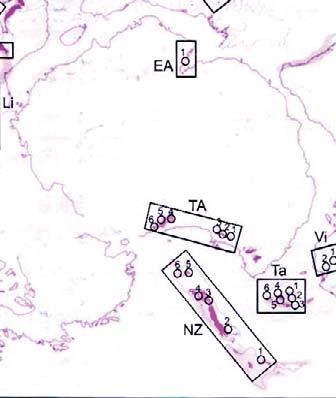
outcrop subsurface

Triassic regions subregions (° squares) with Rochipteris



beds with Rochipteris (& affiliated strobili)
HypodigmSYSTEMATICS 110 ISSN 2410-4418 Palaeont. afr. (2023) 57 (Special Issue): i–xiv + 1–324
AUTHOR REGION & SUBREGIONFORMATIONLOCALITYNAME (as in literature)
Ant, NZ, Productive degree squares
Ant, NZ, Productive degree squares (megaplants)
ISSN 2410-4418 Palaeont. afr. (2023) 57 (Special Issue): i–xiv + 1–324
IDENTIFICATION
sketch (s) photo (p) indivs ILLUSTRATIONS R. vincularis R. telefolia R. distivena R. rollerii R. switzifolia R. matatifolia R. komifolia R. lutifolia R. obtriangulata R. cf. sinuosa R. penensis R. pusilla R. alexandriana R. copiapensis R. cuneata R. etheridgei R. ginkgoides R. incisa R. lacerata R. nymboidensis R. sinuosa R. tasmanica R. truncata R. turbata R. sp. indet.
123456789101112123456789101112–Molteno species Other Gondwana Triassic species
s p20figs 2(A–C), 3(A–C)
p11fig 3(D–F) cf.
s 3 fig 9 (B2–B3) ...
s 2 fig 9 (C1,C2) ...
1 pl 8(6)
p 1 pl 3(8)
sp 3 figs 9(A–C), 10(J)
s 2 t.fig 4(11, 12)
s 2 t.fig 4(10, 14)
s 2 t.fig 4(16)
s 1 fig 7(A)
s 1 fig 7(B,C)
s 4 fig 7 (D–G)
s 1 fig 10(C)
s 2 fig 8 (B1,B2) ...
s 3 fig 9 (D1–D3) ...
p 8 figs 4A, 6C
Hypodigm SYSTEMATICS
111
(this volume) Ma – age marking base of Formation bar beds with Rochipteris (& affiliated strobili) ANTARCTICA (TA, EA) Transantarctic Mts. 238 Falla “ Lashly C 242 Fremouw 249 Lashly A Eastern Antarctica 225 Flagstone Bench New Zealand (NZ) 206 (Southland) 227 (Southland) 239 Tank Gully “ Black Jacks “ Long Gully 240 (Southland) 250 “ LashlyC ( TankGully y BlackJacks y Ant, NZ, Megaplant-bearing Formations Ant, NZ, Megaplants, Trias. occurrence Ant TANZ UPPER R N C M L A L Triassic 201 209 227 237 242 247 252 Period Epoch Stage Ma 210 220 230 240 250 O I Triassic Stages R N C Rhaetian Norian Carnian L A Ladinian Anisian O I Olenekian Induan megaplant-bearing formations beds with Rochipteris (& affiliated strobili) Ant & NZ species ( gy
Hypodigm charts; Rochipteris, Gondwana Triassic (GT) occurrences
Chart 4.
AUSTRALIA
South Australia (SA) Ma
1895 Etheridge Leigh Creek SA1238 Leigh Creek CM ? (Sweet collection) Anthrophyopsis ? sp. ind.
1926 Chapm. & Cooks. “ ““ “ ? (Sweet collection) (?) Psygmophyllum etheridgei
1969 Amtsberg “ ““ “ Telford Open Cut Psygmophyllum cf. etheridgei
2003 Barone-Nug. et al “““ “ “ Pit M13 Rhochipteris etheridgei comb. nov.
1969 Amptsberg Springfield B.SA2238 (unnamed) Central Mesa Ginkgo antartctica
2003 Barone-Nug. et al “ ““ “ “ Rochipteris sp.
Clarence-Moreton Basin (CM)
1872 Carruthers Ipswich/Esk CM5 232 Tivoli Tivoli Coal Mine Cyclopteris cuneata sp. nov.
1898 Shirley “ ““ ? Brisbane (no details) Sagenopteris (Cyclopteris) cuneata
1924Walkom ““241 Esk Por. 42 Wivenhoe Ginkgoites sp.
2003 Barone-Nug. et al. “CM6 233 Brassall subgroup Springwood, S of Brisbane Rochipteris ginkgoides sp. nov.
“ “ “““ “ Petrie’s Q., N of Brisbane“ “
2005 Holmes & H.M.And. Nymboida CM7 241 Basin Creek Coalmine quarry Rochipteris obtriangulata sp. nov.
“ “ “ ““ “ “ Rochipteris turbata sp. nov.
“ “ “ ““ “ “ Rochipteris sinuosa sp. nov.
“ “ “ ““ “ “ Rochipteris nymboidensis sp. nov.
“ “ “ ““ “ “ Rochipteris pusilla sp. nov.
“ “ “ ““ “ Reserve Quarry Rochipteris incisa sp. nov.
Sydney Basin (Sy)
1894 Etheridge Sydney Sy3? ? Cremorne bore Sagenopteris salisburioides
1925a Walkom “ “248 Narrabeen-Gosford Turrimetta Head ?Rhipidospsis narrabeenesis sp. nov.
Victoria (Vi)
1927 Chapman Victoria Vi2238 Council Trench Bacchus Marsh (Bald Hill) Psygmophyllum fergusoni sp. nov.
2006 Webb & Mitchell “““ “ “ Rochipteris sp.
Tasmania (Ta)
1888 Johnston Hobart Ta5 231 Brady equivalent Lords Hill Ginkgophyllum? australis sp. nov
1926 Walkom “ ““ “ “ Chiropteris tasmanica sp. nov.
Aus, Productive degree squares (megaplants)
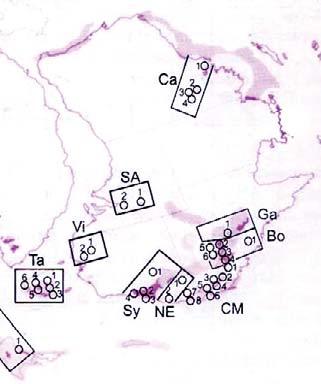



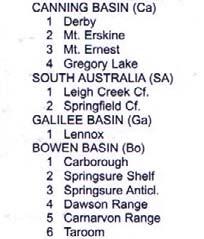


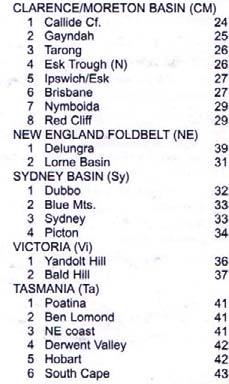

Triassic regions subregions (° squares)
outcrop subsurface

Aus, Productive degree squares (megaplants) with Rochipteris
beds with Rochipteris (& affiliated strobili)
HypodigmSYSTEMATICS 112 ISSN 2410-4418 Palaeont. afr. (2023) 57 (Special Issue): i–xiv + 1–324
&
AUTHOR REGION
SUBREGION FORMATION (beds, horizons) LOCALITYNAME (as in literature)
ISSN 2410-4418 Palaeont. afr. (2023) 57 (Special Issue): i–xiv + 1–324
sketch (s) photo (p) indivs ILLUSTRATIONS R. vincularis R. telefolia R. distivena R. rollerii R. switzifolia R. matatifolia R. komifolia R. lutifolia R. obtriangulata R. cf. sinuosa R. penensis R. pusilla R. alexandriana R. copiapensis R. cuneata R. etheridgei R. ginkgoides R. incisa R. lacerata R. nymboidensis R. sinuosa R. tasmanica R. truncata R. turbata R. sp. indet.
123456789101112123456789101112–Molteno species Other Gondwana Triassic species
s 1 pl 4(2)
s 2 pls 23(20), 24(21)
p 3 pl 4(22–24)
sp 13 fig 3B, pls 1, 2
s 1 fig 2 sp * fig 3C, pl. 4
s 1 pl 27(5)
s 1 pl 23
p1 pl 21(3B)
sp 4 fig 3A, pl 3(1,2,4–6)
p1 pl 3(3)
p 2 figs 18(A–C), 19(A–D)
p 1 fig 20(A–C)
p 1 fig 23(A–C)
p 1 fig 24(A–D)
p 1 fig 25(A–C)
p 2 figs 21(A–C), 22(A)
s >2 pl 7(2)
pl 30(3,4)
sp 2 pls 12(39), 13(44,45) s 1 fig 6(D)
s 1 pl 27(3)
s 1 pl 9(2)
cf.
cf.
Australia species
Aus, Megaplant-bearing formations (beds, horizons)
Canning Basin (Ca)
248 Culvida
250 Erskine 251 Blina
Southern Australia (SA)
New England Foldbelt
240 Gragin
241 Gunnee 250 Camden Head
Sydney Basin (Sy)
238 Leigh Creek “ Springfield
Galilee Basin (Ga)
242 Moolayember 243 Clematis
Bowen Basin (Bo)
242 Moolayember
243 Clematis
Clarence/Moreton Basin
203 Raceview
205 Aberdare
232 Callide “ Ipswich (U)
Creek Ipswich g
233 Tarong “ Ipswich (L) “ Tingalpa “ Red Cliff
241 Esk “ Nymboida
242 Neara
243 Bryden
242 Benolong “ Wianamatta
243 Hawkesbury
248 Burralow “ Gosford (U) “ Newport (U)
249 Newport (M)
250 Garie
“ Newport (L)
Gosford
251 Banks Wall “ Gosford (L) “ Bald Hill
251 Patonga “ Bulgo
Victoria (Vi)
238 Yandoit “ Bald Hill
Tasmania (Ta)
Gosford (
231 Brady “ New Town
251 Knocklofty
Ma – age marking base of Formation bar beds with Rochipteris (& affiliated strobili)
Hypodigm SYSTEMATICS 113
IDENTIFICATION (this volume)
occurrence Aus CaSAGaBoCMNESyViTa UPPER R N C M L A L Triassic 201 209 227 237 252 Period Epoch Stage Ma 210 220 230 240 250 O I Triassic Stages R N C Rhaetian Norian Carnian L A Ladinian Anisian O I Olenekian Induan L – Lower M – Middle megaplant-bearing formations beds with Rochipteris (& affiliated strobili)
Aus, Megaplants, Trias.
247 242
SOUTH AMERICA
1899 Solms-Lau. & Stein. CopiapoCh1207La TerneraQ. de la Ternera Acrocarpus ternerae sp. nov. (male)
1998 Artabe et al. LlantenesNA5207LlantenesArroya Llantenes fertile material at level LLA15
ANTARCTICA
1994 Taylor et al. Trans. Antarctic MtsTA4242 FremouwFremouw Peak Petriellaea triangulata sp. nov.
1996Taylor “““ “ ““ ‘cupule’
2009Taylor & Taylor “““ “ “ “ triangulata
AFRICA
1995 Cairncross et al Karoo BasinKa9233MoltenoKannaskop (Kan 111) Ginkgophytopsis sp.
1997And. & And.Karoo BasinKa9233MoltenoKannaskop (Kan 111) Ginkgophytopsis (leaf & ♂)
“ “ “““ “Little Switzerland (Lit 111) “ (♂)
2003And. & And.Karoo BasinKa9233MoltenoKannaskop (Kan 111) Kannaskoppia vincularis sp. nov.
“ “ “““ “ ““ “
2003And. & And.Karoo BasinKa5“MoltenoLutherskop (Lut 311) Kannaskoppianthus lutinumerus sp. nov.
“ “ “““ “Aasvoëlberg (Aas 111)“ “
“ “ “““ “Aasvoëlberg (Aas 211)“ “
“ “ “““ “Aasvoëlberg (Aas 311)“ “
“ “ “““ “Aasvoëlberg (Aas 411)“ “
“ “ “Ka2“ “Little Switzerland (Lit 111) “ “
“ “ “Ka7“ “Matatiele (Mat 111) “ matatiparvus sp. nov.
“ “ “Ka8“ “ Kommandantskop (Kom 111) “ irregularis sp. nov.
“ “ “““ “ ““ “
“ “ “Ka9“ “Kannaskop (Kan 112)“ “
“ “ “Ka8“ “Telemachus Spruit (Tel 111) “ lutinumerus
“ “ “““ “ “ “ telemagnus sp. nov.
2007And., And. & ClealKaroo BasinKa9“MoltenoKannaskop (Kan 111) Kannaskoppia vincularis
“ “ “Ka8“ “Telemachus Spruit (Tel 111) Kannaskoppianthus lutinumerus
“ “ “““ “Aasvoëlberg (Aas 311)“ “
2009Taylor & TaylorKaroo BasinKa9233MoltenoKannaskop (Kan 111) Kannaskoppia vincularis
Ma 2
Note: where leaves occur attached to a stem with fertile organs, they are not listed again under leaves.

HypodigmSYSTEMATICS 114 ISSN 2410-4418 Palaeont. afr. (2023) 57 (Special Issue): i–xiv + 1–324 Kan 111 PRE/F/13487a‘y’ 1 12 cm 0 R2 ×2 AUTHOR REGION & SUBREGIONFORMATIONLOCALITYNAME
R4 ×1
Kannaskoppia vincularis
Chart 5. Hypodigm; Kannaskoppia & Kannaskoppianthus, Gondwana Triassic (GT) occurrences.
ISSN 2410-4418 Palaeont. afr. (2023) 57 (Special Issue): i–xiv + 1–324
sketch (s) photo (p) indivs ILLUSTRATIONS K. vincularis K. telemagnus “ irregularis “ aasvoelensis “ switzianthus “ matatiparvus “ komanthus “ lutinumerus “ telepentatus
K. ternerae P. triangulata
1 12345678SAm & Ant Molteno speciesspecies
s1pl 14(5)
sp>4figs 1–31
p1pl 4(4)
sp*figs 30–32
sp2p 472(c,d)
s1fig 2
s1fig 5
sp12p 286(1–3),288(1,2),289(1–12)
pls 104,105,106(1,2,6)
sp5p 290(1), 292(1,2), pl 110
p8p 292(5), pl 112(1–6,8,9,11)
p2pl 113(1–4)
p2pl 114(1–5,7)
p7p 292(4), pl 115(1–8)
s1p 290(3)
sp1p 292(9), pl 144(8–10)
sp2p 290(5), 293(1,2)
pl 108(1–3), 109
sp1p 298(1), pl 117
sp2p 290(6), pl 116
sp1p 293(3), pl 118
s1p 185(1)
s1p 185(7)
111
Tel 111
s1p 185(8) p2fig 33 R2
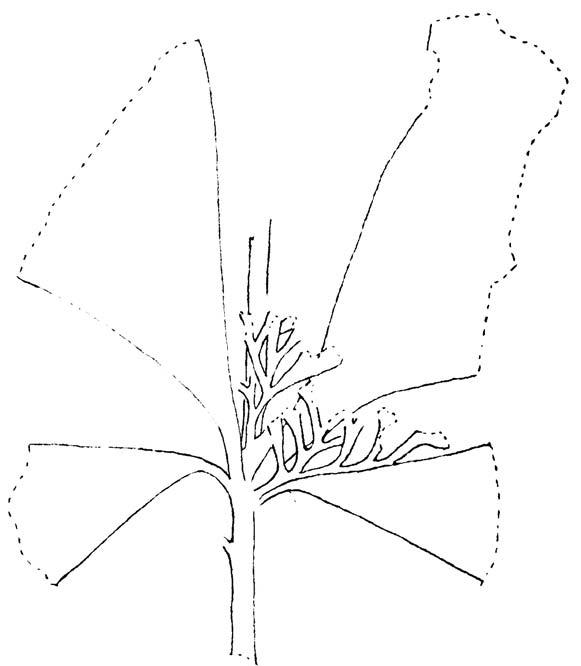
Kan 112
Hypodigm SYSTEMATICS 115
×2 1
all
PRE/F/7711
telemagnus 2
irregularis
PRE/F/20114a,b
Kannaskoppianthus
K.
311 PRE/F/11434a 7 8
K.
lutinumerus Lut
telepentatus
PRE/F/18277a,b 12 cm 0 ♀ Kannaskoppia ♂ Kannaskoppianthus 3
aasvoelensis Aas
PRE/F/19547b 4
switzianthus 5 K. matatiparvus
PRE/F/3205 6
K.
Tel 111
K.
K.
Mat 111
PRE/F/3231
K. komanthus Kom 111

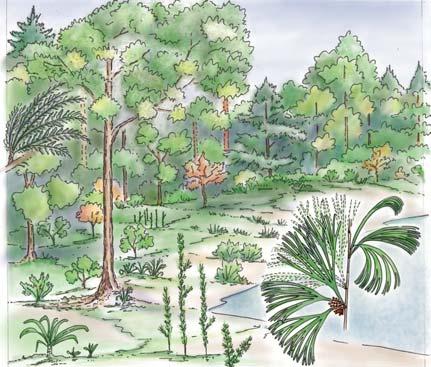


116 ISSN 2410-4418 Palaeont. afr. (2017) 52 (Special Issue): i–xiv + 1–324
Aasvoëlberg (Aas 111 Hei elo)
Telemachus Spruit (Tel 111 Hei elo)
Matatiele (Mat 111 Dic dub)
Kommandantskop (Kom 111 Sph/Dic)


Part 3

the whole-plant genus & species

Ultimately, it is the whole-plant that we wish to visualize. As realistically as possible, let us imagine we’re exploring the Molteno landscape live, 230 million years ago around midway through the Triassic during the Heyday of the Gymnosperms. Like botanists today, during the Heyday of the angiosperms, we’re out there sampling the flora, experiencing its extraordinary diversity.
We note how each species within a genus has adapted to its own particular habitat. And we appreciate how each is in symbiotic harmony with the vertebrate and invertebrate faunas that have co-evolved with them during the explosive diversification of renewed life following the end-Permian Extinction. Colour, as in today’s world, adds greatly to the beauty of this terrestrial panorama.
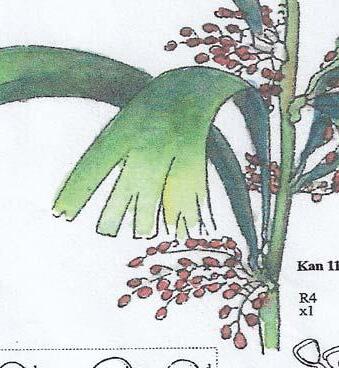

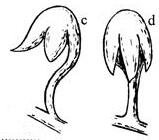
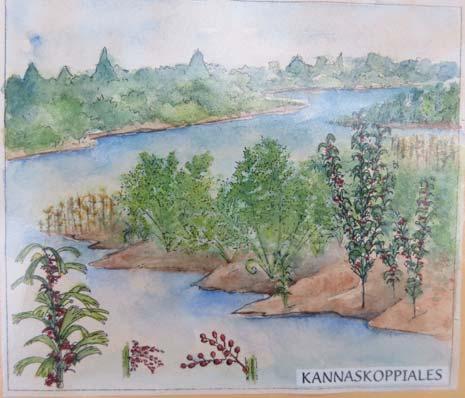
MOLTENO HABIT & HABITAT RECONSTRUCTIONS
Introduction
The habitats (Triassic scenarios showing where the plants grew) presented here are based on contextual information gleaned from taphonomic factors (how and where the fossils were deposited) and other clues (related deposits, extant plants, etc.). A similar exercise was undertaken in reconstructing the Molteno sphenophytes (And. & And., 2018). Reconstructing the form and habitat of these Molteno fossil plants is problematic as the basic information is often limited and various assumptions have to be made. However, it is a useful exercise as it forces the researcher to record what is known and to point out where gaps in knowledge exist.
It is fortunate that the Molteno Fm. has a good example of a crevasse splay deposit (locality Kannaskop, Kan 111, Cairncross et al., 1995) where rapid burial has reduced taphonomical biases and led to the discovery of unique stems with attached leaves and female fruits (And. & And., 2003). All other Molteno localities show evidence of variously slower accumulation of fossils in rivers and lakes or through periodic flooding in the floodplain. To date, there is no evidence of volcanic ash having been preserved in the Molteno. Where this does occur over a broad extent, it is possible to accurately reconstruct the ancient landscape, as has been undertaken by Oplustil et al. (2014) for a peat-forming plant assemblage in the Middle Pennsylvanian from the Czech Republic; and by Wang et al. (2012) from the Permian of Mongolia. A useful review of reconstructions of past floras is provided by DiMichele & Gastaldo (2008) in their paper “Plant Palaeoecology in Deep Time”.
A summary of the evidence used to reconstruct the Antarctic Rochipteris plant is presented below, followed by that for the Molteno.
Antarctica habit reconstruction
Bomfleur et al. (2013) and Bomfleur et al. (2014, fig. 8, p. 1070) reconstructed the petriellalean (Rochipteris) plants as “low-growing, shade-adapted, perennial evergreens” and regarded them as pioneers and colonizers that “litter large quantities of seeds through ballistic dispersal”. Their reconstruction was based on the following considerations.
Link of stem to leaf
From their study of silicified peat (uppermost part of Member C, Fremouw Formation, Beacon Supergroup, Antarctica) the affiliation of stems described as Rudoxylon serbetianum and Rochipteris leaves was established. This was based on the similarities of the “basal leaf cross sections” and the “leaf traces in the cortical cushions of the foliated stem portions”
In support of this is a comparison of the other stems in the peat, namely Kykloxylon (Dicroidium wood) and Notophytum (Heidiphyllum wood) which differ in morphology and size.
Nature of stem
Stems are “diminutive (<3 mm thick)”.
Contain up to four growth rings (see Fig. 4A,F).
Growth ring anatomy (gradual transition).
From this they inferred that the plants were less than a metre tall, perennial (grew up to four years) and evergreen.
Leaf anatomy
Shade-adapted leaves indicated by cellular structure of leaves found in peat.
Glands indicate durability.
Incurved leaf margins indicate ability to “acclimatise to unfavourable conditions”.
Seeds
Reported are the “vast number and small size of their seeds—borne in dehiscent seedpods” indicating a pioneer plant (but this is not substantiated with a reference).
Taphonomic features
The localities, namely Allan Hills and Alfie’s Elbow, both show evidence of “high-energy depositional events” based on the “assortment of otherwise rare plant taxa and the extraordinary high proportion of attached organs”.
Molteno habit reconstructions for Kannaskoppia/ Kannaskoppianthus/Rochipteris whole-plants
For the plant-reconstruction drawings that follow, six points were taken into consideration. The evidence available for each is listed according to place of origin.
1. Nature of leaf attachment to stem
Molteno
Kan 111 – there are five sections of stem with foliage and strobili attached, and 12 sections with only foliage attached. These all show the leaf attached to a bulbous leaf cushion which is interpreted as a possible young short shoot by analogy to extant species with long/ short shoot morphology, e.g. Ginkgo biloba
Tel 111 – many leaves (c. 10) are attached to a stem (PRE/F/17406 & 17416, p. 70(1)), but due to their overlapping nature, the stem is not visible. The leaves are clustered into about four groups, indicating that each cluster arises from a common point of origin. A second specimen (PRE/F/12876, p. 70(4)) has three leaves attached to a bulbous leaf cushion and two other leaves closely associated.
Nymboida
Leaf whorls have been described in three species, but the actual attachment to the stem is difficult to decipher as in each case it is partly obscured by matrix.
Antarctica
In describing a specimen with leaves similarly attached, Bomfleur et al. (2014) used a different terminology (details below).
2. Number of leaves in a whorl/group attached to a bulbous leaf cushion
We assume there are generally about four leaves per group and this is shown in most of the reconstructions.
Molteno
Kan 111 – often less, usually two leaves (pp 67, 68).
Tel 111 – about four leaves per group in PRE/F/17406 & 17416 (p. 70(1)), three plus two in PRE/F/12876 (p. 70(4)).
Cyp 111 – four leaves attached in PRE/F/18751 (p. 96(1))
Nymboida
Leaves have been described as attached in close spirals along the stem in three species. The actual attachment is difficult to interpret. In Holmes & Anderson (2005, fig. 18B) up to seven leaves occur in a whorl and these may be grouped into three plus four leaves each, while another whorl shows six leaves all about equally spaced with some from a lower level (fig. 20).
Antarctica
Leaves attached to a stem were described by Bomfleur et al. (2014) as “each arising at an angle from a short (c. 1 mm long), apically inclined, cone shaped cushion-like protrusion of the cortex”. Based on the drawing (fig. 2C), the stem is 37 mm long (in their text it is given as 6 cm, but it is not clear how that was measured or if it included the leaves. From the photograph (fig. 2A), three leaves appear to arise from the same point on the stem (possibly at the tip) while some others appear to be individually attached.
New Zealand
Retallack (1980, fig. 9C; 1983, fig. 7E) illustrated two groups of 2–3 leaves that arise from a common point of origin.
Kannaskoppia THE WHOLE-PLANT 118 ISSN 2410-4418 Palaeont. afr. (2023) 57 (Special Issue): i–xiv + 1–324
Argentina
Herbst. et al. (2001, fig. 8L) illustrated a slab which shows two leaves lying almost parallel and possibly having a common origin.
3. Distance (spread) between leaves or bulbous leaf cushions along the stem
Molteno
Kan 111 – from 8–13 mm on mature stems bearing strobili and leaves; 5–25 mm on stems bearing only leaves (some of these may be regarded as long shoots, i.e. first year of growth).
Kan 112 – the stem with an attached male strobilus shows a similar morphology and 5–13 mm between leaf cushions. Tel 111 – see discussion above.
Antarctica
Bomfleur et al. (2014, fig. 2A) show leaves attached at 5–10 mm (possibly up to 15 mm) intervals.
4. Size variation of leaves
Molteno
The attached leaves or those in a cluster are fairly constant in size and shape. However, the collections for a population (palaeodeme) show variable leaf sizes, beyond that chosen for the reconstruction which is regarded as representative for the palaeodeme.
Nymboida
Leaves occur in close spirals or whorls in three species. In R. obtriangulata Holmes & Anderson (2005, fig. 18B), the complete leaves are remarkably similar in size and this probably holds for the other two species; but as some leaves are incomplete this cannot be ascertained.
Antarctica
Bomfleur et al. (2014, fig. 2A): the attached and associated leaves are all very similar in size.
5. Width of stem
All known stems are of relatively small diameter as indicated.
Molteno
Kan111 – 2–4 mm; various known stems, some with female strobili attached (PRE/F/13487,13505) and others with leaves only (PRE/F/13521,13522).
Kan112 – 2.5 mm; one stem with male strobilus attached (PRE/F/ 20114).
Kom111 – 2 mm; one stem with male strobilus and leaves attached (PRE/F/3231a,b).
Antarctica
Allan Hills – c. 1 mm; one stem with leaves attached, Bomfleur et al. (2014, fig. 2A).
Alfie’s Elbow – 1–3 mm; and permineralized stems, Bomfleur et al. (2014, fig. 4).
6. Branching
There is no evidence of branching available from any Gondwana Triassic deposits, but it has been introduced in some reconstructions to add variety and show the possibility of such.
Molteno Habitat
General; Habitats 1–7
The molteno habitats were first described by Anderson et al (1998) and are summarized here in Part. 1 (pp 8, 9). There is a strong link between particular habitats and different Kannaskoppia/ Rochipteris whole-plant species, as this discussion elaborates, and as is reflected in Tab.1 (pp 12, 13).
Heidiphyllum thicket (Habitat 5)
The most common habitat for the Kannaskoppia/Rochipteris
plant is the Heidiphyllum thicket; represented by 11 TCs. Two species occur in the Heidiphyllum thicket on channel sandbars in the braided-river system (Type 5b) and four species in the floodplain (Type 5a). The two species (R. telefolia and R. distivena) in Type 5b have relatively large leaves, while species with smaller leaves generally occur in Type 5a. In the latter, the leaves are undivided in R. penensis and R. pusilla, partly divided in R. lutifolia, and have up to two divisions in R. rollerii. Within this extensive habitat on the floodplain, these species are considered as occupying different niches.
Heidiphyllum was reconstructed by Anderson et al. (1998) and And. & And. (2003, p. 91) as belonging to a large erect shrub to small conical tree. Subsequently, Bomfleur et al. (2013) using information from permineralized fossils, reconstructed it as a conical tree 10–15 m tall and suggested the whole-plant should be called Telemachus after the female cone. Their proposal that the affiliated male cone is Switzianthus appears very unlikely as was discussed by Anderson et al. (2019b). The male cone is most probably Odyssianthus as initially suggested by And. & And. (2003, p. 84). In the Molteno habitat reconstructions, the Telemachus/Heidiphyllum plant is represented as a small immature tree in the flood plains or sand banks and as a tall mature tree elsewhere in the riverine forests.
Dicroidium riparian forest (Habitats 1 & 2)
A fairly common habitat for the K/Rochipteris plant is the Dicroidium riparian forest: three of the species, R. switzifolia, R. obtriangulata and R. cf. sinuosa, occur in the mature (type 1) and one, R. matatifolia, in the immature (type 2) versions of the forest.
Fern/Kannaskoppia meadow (Habitat 7)
A distinct habitat was named after the K/Rochipteris plant as the Fern/Kannaskoppifolia meadow by Anderson et al. (1998); and is here updated to Fern/Kannaskoppia meadow. The specimens with the unique attached female fruit and leaves from the Kan 111 TC are from this habitat. Only from one other TC (Kom 111), have we found attached fruit (in this case male) and foliage (R. komifolia). Of interest is that in the Heidiphyllum thicket (Habitat 5), Rochipteris often occurs in association with ferns (e.g. Tel 111 Hei elo, Aas 111 Hei elo).
Dicroidium woodland (Habitat 3)
From the Dicroidium woodland there occurs only one species, R. lutifolia (Cyp 111 Dic cra), that is well represented; while three further TCs have yielded isolated leaves from various other species.
Sphenobaiera woodland (Habitat 4)
From the Sphenobaiera woodland two species occur: R. komifolia from Kom 111 Sph/Dic, and R. rollerii from Aas 411 Dic/Sph. The latter is also the most common species in the Heidiphyllum thicket.
Equisetophyte marsh (Habitat 6)
From the Equisetophyte marsh there occurs only a single leaf from Gre 111 Equ sp recorded as species indet.
Molteno habit reconstruction notes
For each species of whole-plant the evidence and considerations used for the reconstructions are discussed.
Kannaskoppia vincularis / Rochipteris vincularis
Ref. pal.: Kannaskop Kan 111 Ast spA
Habit: Based on the collection of five sections of shoot with foliage and megasporophylls attached, plus 12 sections of shoot with foliage, this is the most secure of all the reconstructions. It was the first to be reconstructed and placed in its habitat (Cairncross et al.,
Kannaskoppia THE WHOLE-PLANT 119
ISSN 2410-4418 Palaeont. afr. (2023) 57 (Special Issue): i–xiv + 1–324
1995; And. et al., 1998; And. & And., 2003). The initial concept is here retained. It is reconstructed as a slender erect woody shrub up to 1 m in height. Branching has been added as a possibility but there is no evidence for it.
Habitat: The K. vincularis plants are reconstructed as growing in Fern/Kannaskoppia meadows on channel sandbars in the braidedriver system (Habitat 7). Subsequent to the initial publication of this habitat the fern element has been described as Rooitodites integra by And. & And. (2008, p. 56). This is now one of the few ferns in the Molteno and Gondwana Triassic known as a whole-plant with complete fronds attached to in situ rhizomes.
Kannaskoppianthus telemagnus / Rochipteris telefolia
Ref. pal.: Telemachus Spruit, Tel 111 Hei elo
Habit: Reconstructed as slender erect woody shrubs up to 1.5 m. This is regarded as the tallest of the Molteno Rochipteris species. The R. telefolia leaves in the Tel 111 TC range from 80–140 mm in length. The reconstructed leaf shoot (shown at ×1 and ×1/2) reflects this size range. One particular specimen (in two parts, PRE/ F/17406a,b; PRE/F/17416, p70(1)) shows four to five groups of leaves, though none with their points of attachment are preserved. The lower portion shows the base, or near-base, of four leaves which, by their close proximity, suggests a common point of origin. These are depicted in the reconstruction as attached to a bulbous leaf cushion (as seen in specimens from Kan 111, pp 67, 68). As the actual attachment to the stem is not visible, these leaves could also be arranged spirally, as occurs on a long shoot in the extant Ginkgo The attachment of a single clear cluster is evident in PRE/F/12876 (p. 70, fig. 4; pl. 43(4–6)). In the whole-plant reconstruction (p. 127), the leaves are depicted in a spiral arrangement near the tip and on a lower side-branch, whilst elsewhere as clusters spirally attached. Though evidence of branching is as yet unknown, it is considered a possibility as the plant is known to be woody (Bomfleur et al. 2014) and probably perennial.
Habitat: The R. telefolia plants are envisaged as growing in patches near the water’s edge alongside a Heidiphyllum thicket (Habitat 5b, p. 127) on channel sandbars in a braided-river system. Some distance beyond the sandbars is a Dicroidium (Type 2) riparian forest. The ferns recorded are Rooitodites integra (1 indiv.), Elantodites turneri (51 indivs) (see And. & And., 2008, p. 86 for species description; p. 89 for position in Molteno floodplain biome), Dictyophyllum bremerense (4 indivs) and Cladophlebis rosemariae (2 indivs). E. turneri is well-represented in the collection with both fertile (7 indivs) and sterile fronds (44 indivs) and regarded as growing on the channel sandbars and probably in association with R. telefolia. The other three fern species could derive from the sandbars, where they would be very rare, but are considered as more likely derived from further afield in the Dicroidium riparian forest where they would be more common. The other gymnosperm species in the Tel 111 TC are considered to be mainly derived from this riparian forest: Dicroidium four species (6%), Lepidopteris stormbergenis (1%), Ginkgoites telemachus (23 indivs) and Taeniopteris two species (2%).
Kannaskoppianthus irregularis / Rochipteris distivena
Ref. pal.: Kannaskop, Kan 112 Hei elo (Upper End)
Habit: Reconstructed as slender erect woody shrubs up to 1 m in height. Only four leaves are known from the Kan 112 TC with this distinctive open venation and these range from 60 to an estimated 100 mm in length. The most complete leaf is the smallest (BP/2/3386); a nearly complete one (BP/2/3387) has the tips missing; and the largest (PRE/F/20120) has the base and tips missing. In the shoot reconstruction these three leaves are represented with the affiliated male strobilus. As the true length of these leaves is unknown, the reconstructed leaves in the ×1/10 view have mainly been based on the length of the most complete leaves (60–80 mm) In general outline these leaves are similar to R. telefolia, but in venation they are clearly distinct.
Habitat: These Rochipteris plants are considered to be growing in clearings in a Heidiphyllum thicket (Habitat 5b, p. 8 (Fig. 1)) on channel sandbars in a braided-river system. Some distance beyond the sandbars is a Dicroidium (Type 2) riparian forest. The other very rare floral elements recorded from this TC are considered as being derived from this forest. This species, depicted as growing in a Heidiphyllum-clearing, is thus similar to R. penensis which also grows in such clearings but in the floodplain (Habitat 5a).
Kannaskoppianthus aasvoelensis / Rochipteris rollerii
Ref. pal.: Aasvoëlberg, Aas 111 Hei elo (Turner Shale)
Habit: Reconstructed as slender erect woody shrubs up to 1 m in height. Evidence of branching is unknown for this species but considered a possibility. This is by far the most common of the Molteno Rochipteris species, occurring in a total of 14 TCs. The palaeodemes reflect a broad range of leaf shape, with from few to many segments. The reconstructed leaves are depicted with 3–6 segments.
Habitat: For the Reference palaeodeme, it is regarded as growing in an area of high water table in the Heidiphyllum thicket of the floodplain. Here it is shown scattered near the water’s edge around a small lake or marshland within the thicket. The dominants in the associated flora consist of Heidiphyllum elongatum (77%) and the fern Cladphlebis janetae (20%). This fern is shown as growing beside R. rollerii with fronds up to 400 mm in length. R. rollerii is also fairly common in a further two TCs in quite different habitats – namely Umk 111 Dic 2spp (21 indivs, riverine forest, Habitat 1) and Aas 411 Dic/Sph (2%, Sphenobaiera woodland, Habitat 4). This possibly reflects the taxonomic complexity in an ever-evolving flora and shifting habitats over one or two million years.
Kannaskoppianthus switzianthus / Rochipteris switzifolia
Ref. pal.: Little Switzerland, Lit 111 Dic/Hei
Habit: Reconstructed as slender erect woody shrubs up to 0.8 m in height with possible branching. The leaves in this palaeodeme show a wide range of variation, from those with two divisions as occur in R. rollerii to the more complex ones with up to four divisions and numerous segments (see pp 88, 89). In the reconstruction, the more divided leaves are depicted. The leaf species shows relatively minor differences from R. matatifolia and the main reason for considering them as separate species is the affiliation of the male strobili which show more distinct differences (as discussed elsewhere, pp 45, 46).
Habitat: This species is considered to be growing along the river margin bordered by Dicroidium riparian forest (type 1, mature). The forest is dominated by Dicroidium (50%), with D. odontopteroides the most common of the many species (And. & And., 1983). Lit 111 differs from Umk 111 and Mat 111, which also occur in this habitat, by having a far higher percentage of Heidiphyllum elongatum (23%) and is the only one to include Dejerseya lunensis (20%) (And. & And., 1989, p. 259). So far there are few clues as to what kind of plant Dejerseya may have been (And. & And., 1989, p. 256). Elsewhere it occurs in TCs dominated by Heidiphyllum (Aas 411, 80%; Win 111, 79%; Gre 121, 81%). At Lit 111, the probability is that both Heidiphyllum and Dejerseya washed in from a Heidiphyllum thicket habitat on a nearby riverine sandbank opposite the riverine forest. The habitat reconstruction sketch shows only the riverine forest with a great variety of plants (25 genera as recorded by And. & And., 2003, p. 10) and dominated by Dicroidium trees.
Kannaskoppianthus matatiparvus / Rochipteris matatifolia Ref. pal.: Matatiele, Mat 111 Dic dub
Habit: Reconstructed as slender erect woody shrubs up to 0.8 m in height with possible branching. See notes given for the similar species R. switzifolia.
Habitat: This is considered to be growing along the edge of a river
Kannaskoppia THE WHOLE-PLANT 120 ISSN 2410-4418 Palaeont. afr. (2023) 57 (Special Issue): i–xiv + 1–324
ISSN 2410-4418 Palaeont. afr. (2023) 57 (Special Issue): i–xiv + 1–324
alongside the Dicroidium riparian forest (type 2, immature) habitat. It occurs in a similar habitat to Lit 111 with R. switzifolia and hence the reconstruction shows many parallels. Dicroidium is dominant (89%), with D. dubium the most common species. In the reconstruction a twig with leaves of D. dubium has been inserted and is represented by the large tree in the foreground. A shrub of the longleaved Taeniopteris anavolans (2%, And. & And., 1989, p. 374) is depicted in the foreground (front left).
Kannaskoppianthus komanthus / Rochipteris komifolia
Ref. pal.: Kommandantskop, Kom 111 Sph/Dic
Habit: Reconstructed as slender erect woody shrubs up to 0.8 m in height with possible branching. The reconstruction of the leaf shoot is based on two attached specimens (PRE/F/3227 and PRE/ F/3231a,b). The latter specimen also has male strobili, Kannaskoppianthus komanthus, attached.
Habitat: This is considered to be a pioneer plant along the margin of small lakes, bordered by Sphenobaiera woodland, in the floodplain (Habitat 4). At this TC, Sphenobaiera schenckii (60%) is the dominant leaf species; and a twig with leaves is shown close up with many such trees in the background. The co-dominant, Dicroidium crassinervis (39%) is also depicted as a tree in the lakeside vegetation. The fern Cladophlebis katherinae (1%) is quite common and probably grew associated with R. komifolia near the water’s edge, as depicted in the reconstruction.
Kannaskoppianthus lutinumerus / Rochipteris lutifolia
Ref. pal.: Lutherskop, Lut 311 Hei elo (Oom-Piet’s Campsite)
Habit: Reconstructed as slender erect woody shrubs up to 0.6 m in height. The extensive palaeodeme (66 indivs) reflects a broad range of leaf size from small to medium and occasionally with a cleft The reconstructed leaf shoot reflects this range. To date, no attached leaves are known from this TC.
Habitat: Based on the reference palaeodeme, the species is regarded as growing in the Heidiphyllum thicket of the floodplain close to a seasonal stream draining into a small lake. This TC is dominated by Heidiphyllum elongatum (99%), but due to intensive sampling (50 man-hrs cleaving), a diverse flora of 19 species in 12 genera is known (And. & And., 2003, 2008, 2018). Many of these plants are seen as growing fairly distant from the deposition site across the small lake – as depicted in the habitat reconstruction. This species also occurs commonly at Cyp 111 Dic cra, a Dicroidium woodland site (Habitat 3, p. 8 (Fig. 1)).
Rochipteris obtriangulata
Ref. pal.: Umkomaas, Umk 111 Dic. 2spp (Waterfall Locality)
Habit: Reconstructed as slender erect woody shrubs up to 0.6 m in height. This species is represented by two attached leaf clusters from the Nymboida Flora (Australia). The reconstruction is partly based on these, with four leaves per cluster being considered most likely.
Habitat: As this species occurs in relatively low numbers, it is considered to be growing some distance from the deposition site, and possibly near the edge of, or in the undergrowth of, the riparian forest. Dicroidium (69%) is dominant at this TC, with D. orbiculoides and D. elongata being about equally common. The large tree to the left represents D. orbiculoides. The fern Cladophlebis moltenensis possibly grew alongside Rochipteris and has been added in the foreground of the sketch. The great diversity of plants occurring at Umk 111 (31 genera, 75 species) is reflected in the reconstruction sketch – though none of the others are singled out as representing any particular species.
Rochipteris cf. sinuosa
Ref. pal.: Umkomaas, Umk 111 Dic 2spp (Waterfall Locality)
Habit: Reconstructed as slender erect woody shrubs up to 0.4 m in height. The reconstruction is based on the leaves (with missing bases) from the Molteno. The only known leaf from Nymboida (Australia) shows a flanged base – which is not reflected in this reconstruction.
Habitat: This is a fairly rare species in the Molteno and is considered to be growing far from the deposition area, possibly in the undergrowth of the riparian forest. Being from the same TC as R. obtriangulata, the habitat reconstruction shows many similarities.
Rochipteris penensis
Ref. pal.: Peninsula, Pen 411 Hei elo (Lunchspot)
Habit: Reconstructed as slender erect woody shrubs up to 0.25 m in height. This is based on a small collection of 10 leaves and is a particularly small Rochipteris plant.
Habitat: Regarded as growing within clearings in the Heidiphyllum thicket of the floodplain. These clearings are possibly formed because they are either drier or wetter than the surroundings.The associated flora is comprised largely of Heidiphyllum elongatum (94%), sphenophytes (2%), ferns (3%, mostly Cladophlebis rosemariae) and a Kurtziana species awaiting description (50 indivs). The latter possibly grew in close proximity to Rochipteris penensis. They have not been depicted in the habitat reconstruction, the intent being to emphasize the clearing in the thicket.
Rochipteris pusilla
Ref. pal.: Peninsula, Pen 311 Hei elo (Campsite Quarry)
Habit: Reconstructed as slender erect woody shrubs up to 0.2 m in height. This is the smallest Rochipteris species in the Molteno and, although it occurs at four TCs, it is extremely rare.
Habitat: Regarded as growing in the undergrowth of the Heidiphyllum thicket of the floodplain. Besides Heidiphyllum elongatum (75%), Dicroidium coriaceum (25%) is recorded. However, this always occurs on separate bedding planes to Rochipteris and is regarded as having grown further afield and deposited in times of minor floods. D. coriaceum has thus not been depicted in the habitat sketch. An additional few non-gymnosperms have been recorded from this locality (And. & And., 2003, 2008, 2018).
TCs with attached organs
A total of five (of the 26) have yielded attached foliage and/or strobili specimens.
Stratigraphic occurrence – interestingly, they occur in sequence in the upper part of the Mayaputi M, and lowest part of the overlying Qiba M.
Geographic occurrence – all five of these TCs occur in the southern outcrop belt (Cyp 111, Kan 111, Kan 112), or just to its north (Kom 111, Tel 111).
Ecological occurrence
Kan 111 Ast spA: the only TC with female strobili (and includes 5 indivs with foliage mutually attached)
Kom 111 Sph/Dic: the only TC with male strobili and foliage mutually attached
Cyp 111 Dic cra: with many attached or clustered leaves (but with no affiliated strobili)
Tel 111 Hei elo: with attached & clustered foliage; and affiliated male (2 indivs)
Kan 112 Hei elo: with no attached or clustered foliage; and with one attached affiliated male.
Kannaskoppia THE WHOLE-PLANT
121
Colour renderings of the Molteno whole-plant Petriellales species
Portraying the Carnian heyday of the gymnosperms in the Triassic explosion of diversity following the end-Permian extinction.
Colour renderings of the foliage and fruiting organs are added as an integral part of the habit and habitat of the 12 Molteno whole-plant species recognized. Like with the angiosperms today, where the foliage of every species of tree or shrub within any genus or stretch of countryside appears to show a different variation of green, so it might be expected amongst the gymnosperms during their heyday of diversity. We reflect that concept in the reconstructions that follow, depicting the leaves showing a range of possible green colours for each species; and likewise for the fruiting bodies: in this case the spectrum from red, through orange to yellow is adopted
Original ink-sketch reconstructions by HMA; colour rendering by Clara Anderson.
1. Kannaskoppia vincularis / Rochipteris vincularis

The 12 Molteno whole-plant Petriellales species (Reference palaeodemes in brackets)
1. Kannaskoppia vincularis/Rochipteris vincularis (Kan 111)
2. Kannaskoppianthus telemagnus/Rochipteris telefolia (Tel 111)
3. Kannaskoppianthus irregularis/Rochipteris distivena (Kan 112)
4. Kannaskoppianthus aasvoelensis/Rochipteris rollerii (Aas 111)
5. Kannaskoppianthus switzianthus/Rochipteris switzifolia (Lit 111)
6. Kannaskoppianthus matatiparvus/Rochipteris matatifolia (Mat 111)
7. Kannaskoppianthus komanthus/Rochipteris komifolia (Kom 111)
8. Kannaskoppianthus lutinumerus/Rochipteris lutifolia (Lut 311)
9. Rochipteris obtriangulata (Umk 111)
10. Rochipteris cf. sinuosa (Umk 111)
11. Rochipteris penensis (Pen 411)
12. Rochipteris pusilla (Pen 311)
2. Kannaskoppianthus telemagnus / Rochipteris telefolia

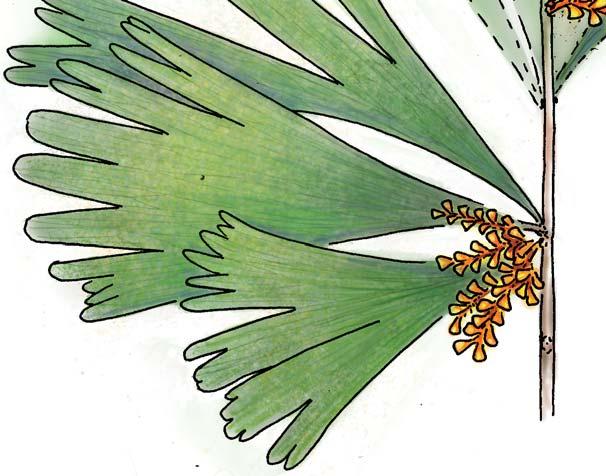
4. Kannaskoppianthus aasvoelensis / Rochipteris rollerii
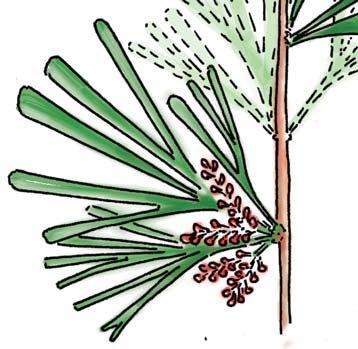
Kannaskoppia THE WHOLE-PLANT 122 ISSN 2410-4418 Palaeont. afr. (2023) 57 (Special Issue): i–xiv + 1–324
3. Kannaskoppianthus irregularis / Rochipteris distivena
Kan 111
Tel 111
Aas 111
all ×1 12 cm 0
Kan 112 R4


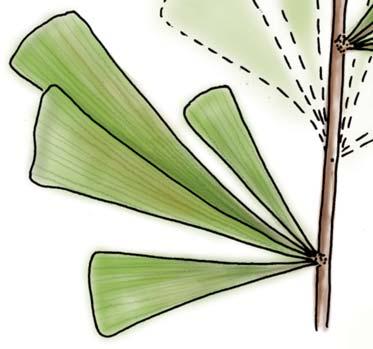
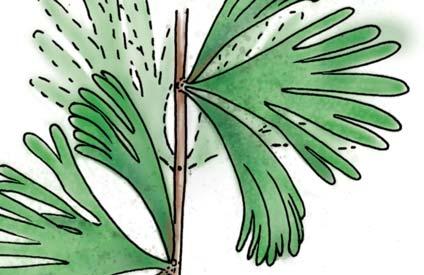
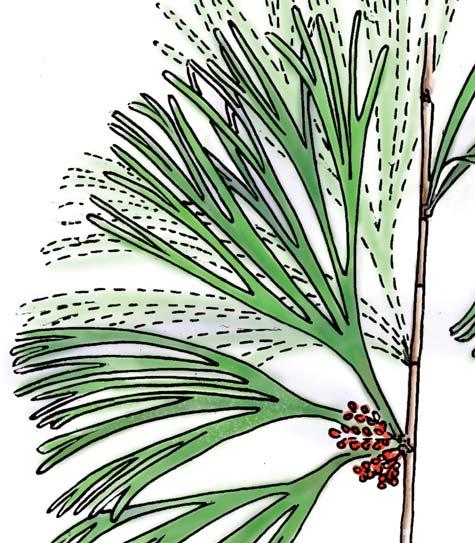
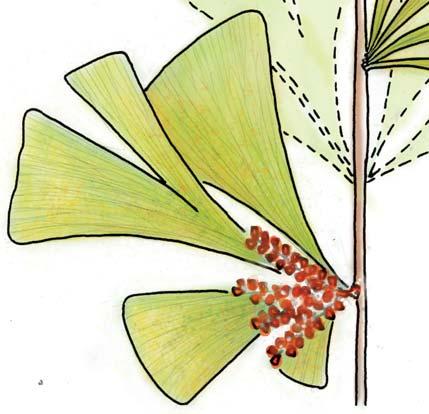

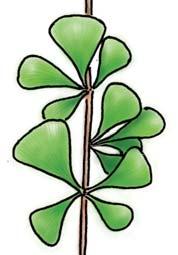
Kannaskoppia THE WHOLE-PLANT 123 ISSN 2410-4418 Palaeont. afr. (2023) 57 (Special Issue): i–xiv + 1–324 R4 all ×1
5. Kannaskoppianthus switzianthus / Rochipteris switzifolia
6. Kannaskoppianthus matatiparvus / Rochipteris matatifolia
7. Kannaskoppianthus komanthus / Rochipteris komifolia
8. Kannaskoppianthus lutinumerus / Rochipteris lutifolia
9. Rochipteris obtriangulata
10. Rochipteris cf. sinuosa
11. Rochipteris penensis
12. Rochipteris pusilla
Umk 111
Umk 111
Pen 311
Pen 411
Kom 111
Lut 311
Mat 111
12 cm 0
Lit 111





Kannaskoppia THE WHOLE-PLANT 124 ISSN 2410-4418 Palaeont. afr. (2023) 57 (Special Issue): i–xiv + 1–324 M5 M4 M3 M2 M1 16 16 Kan 111 Kan 111 Ast spA Kannaskoppia vincularis / Rochipteris vincularis R4 ×5 6 a 4 3 2 1 7 5 Kannaskoppianthus
1 2 cm 0
Chart 1.
Kannaskoppia vincularis / Rochipteris vincularis
Kannaskoppia (Kan III Ast spA)
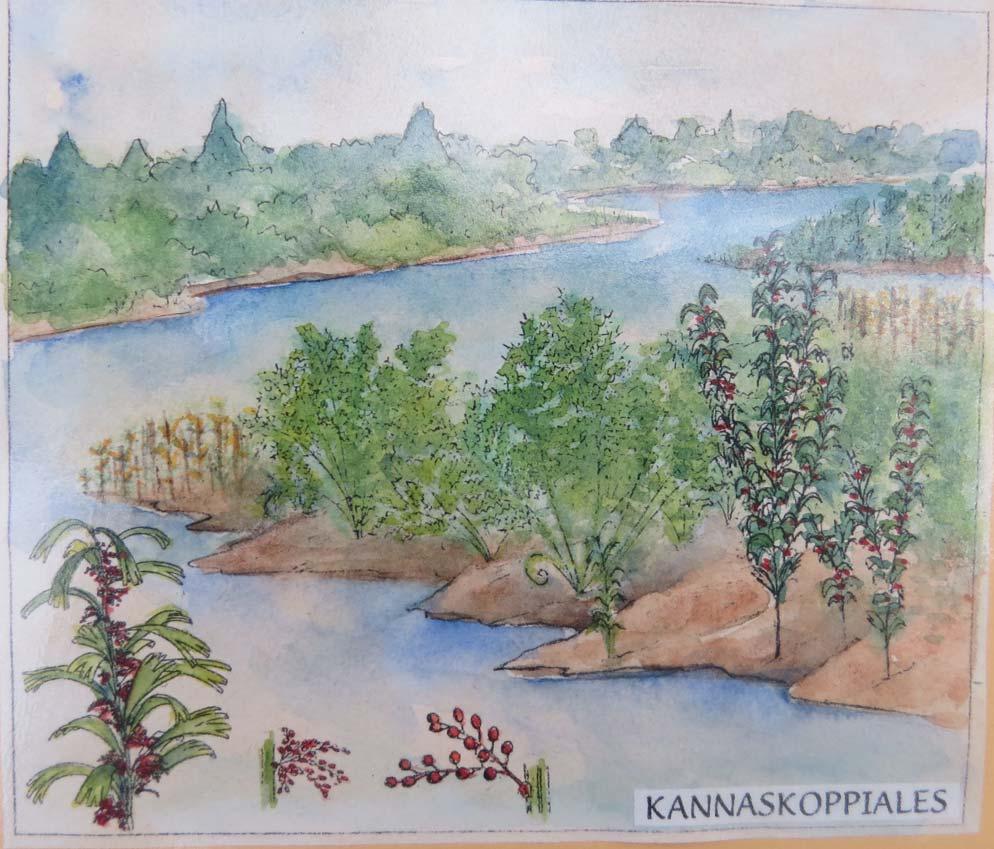
Whole-plant species (male-foliage)
Foliage – Rochipteris vincularis And. & And., 2003
Ref. pal.: Kan 111 Ast spA – 5% of assemblage (c. 45 slabs; 4 att. leaves & ♀; 12 att. leaves only; >25 indiv. leaves)
Female strobilis – Kannaskoppia vincularis
Ref. pal.: Kan 111 Ast spA – 50 indivs (4 att. ♀ & leaves)
Affiliation (female/foliage) – Grade 5 (attached)
Rarity () – 5% of assemblage (common)
Taphonomy – autochthonous
Habit – slender erect woody shrubs up to 1.0 m in height
Habitat – Fern/Kannaskoppia meadow; channel sandbar in braided-river system
Kannaskop (Kan 111 Ast spA) TC
Collection – 365 slabs, 30 man-hrs cleaving
Dominants – ferns 63%, horsetails 22%, Heidiphyllum 10%
Biodiversity – vegetative total, 6 spp
Non-gymnosperms 4 spp; gymnosperms 3 spp
Other Kannaskoppiaceae: nil
1 2 cm 0
References And. & And. (2003): general “ “ (2008): ferns “ “ (2018): sphenophytes
Molteno foliage taxaTC as @ Kan 111
Non-gymnosperms gensppindivs
Muscites
Marchantites
Thallites, etc.
Lycopods Horsetails 22 22% Ferns 11 63%
Gymnosperms
Pinopsida
Heidiphyllum 11 10%
Rissikia
Other genera (×2)
Cycadopsida
Pseudoctenis
Other genera (×3)
Ginkgoopsida
Lepidopteris
Ginkgoites
Sphenobaiera
Dicroidium
Rochipteris 1 1 5%
Other genera (×4) 112
Classes indet.
Genera (×3)
Bennettitopsida
Halleyoctenis
Taeniopteris
Gnetopsida
Genera (×5) 66
Key 5%: of TC 2 indivs in TC
Kannaskoppia THE WHOLE-PLANT 125 ISSN 2410-4418 Palaeont. afr. (2023) 57 (Special Issue): i–xiv + 1–324
1
HMA, 1995













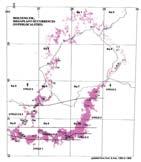
Kannaskoppia THE WHOLE-PLANT 126 ISSN 2410-4418 Palaeont. afr. (2023) 57 (Special Issue): i–xiv + 1–324
R3
M5 M4 M3 M2 M1 32 32 Tel 111
R4 ×1
PRE/F/7711 pl. 41(1–6)
×5
Kannaskoppianthus
telemagnus
Kannaskoppianthus telemagnus / Rochipteris telefolia
1 2
Chart 2.
R2 ×2 Tel 111 Tel 111
PRE/F/7711 pl. 41(1–6)
Hei elo Holotype
1 2 cm 0 R2 ×1
PRE/F/12875 pl.44(3,6)
Kannaskoppianthus telemagnus / Rochipteris telefolia
Telemachus Spruit (Tel 111 Hei elo)
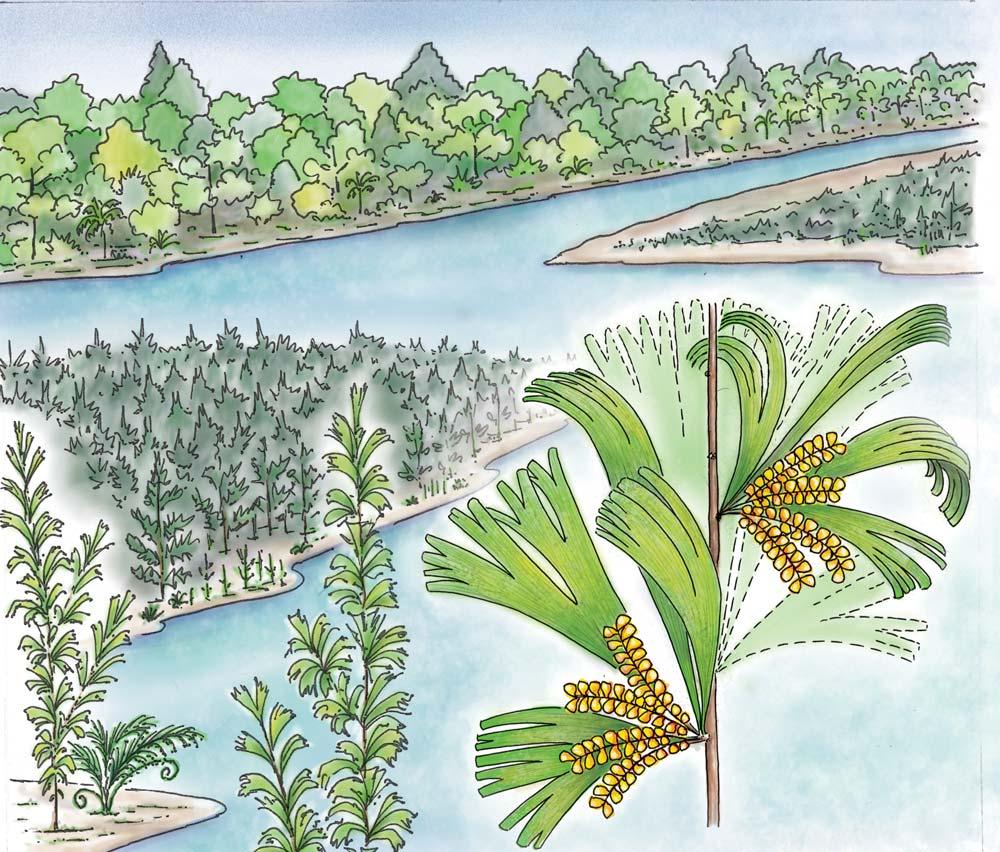
Whole-plant species (male-foliage)
Foliage – Rochipteris telefolia And. & And., sp. nov.
Ref. pal.: Tel 111 Hei elo – 30 indivs (2 att., 1 cluster, 27 isol. leaves)
Male strobilis – Kannaskoppianthus telemagnus And. & And., 2003
Ref. pal.: Tel 111 Hei elo – 2 indivs (1 cluster of 4 detached strobilus limbs, 1 fragment)
Affiliation (male/foliage) – Grade 4 (good), both spp unique to Tel 111
Rarity () – 30 indivs in 90 man-hrs (1 per 3 man-hrs); rare
Taphonomy – autochthonous-parautochthonous; medium-energy flow regime
Habit – slender erect woody shrubs up to 1.5 m in height
Habitat – Heidiphyllum thicket; channel sandbar in braided-river system; growing in patches near the water’s edge.
Telemachus Spruit (Tel 111 Hei elo) TC
Collection – 581 slabs, 90 man-hrs cleaving
Dominants – Heidiphyllum 89%, Dicroidium 6%, ferns 58 indivs
Biodiversity – vegetative total, 20 spp
Non-gymnosperms 7 spp, gymnosperms 13 spp
Other Kannaskoppiaceae:
Foliage: R. pusilla (1 indiv), R. penensis (2 indivs)
Strobili: Kannaskoppianthus telemagnus (2 indivs)
K. telepentatus (2 indivs)
References
And. & And. (2003): general “ “ (2008): ferns “ “ (2018): sphenophytes 1 2 cm 0
Molteno foliage taxaTC as @ Tel 111
Non-gymnosperms gensppindivs
Muscites
Marchantites 11 1%
Thallites, etc.
Lycopods
Horsetails 3348 Ferns *358
Gymnosperms
Pinopsida
Heidiphyllum 11 89%
Rissikia
Other genera (×2)
Cycadopsida
Pseudoctenis
Other genera (×3)
Ginkgoopsida
Lepidopteris 11 1%
Ginkgoites 1123
Sphenobaiera
Dicroidium 14 6%
Rochipteris 1 3 33
Other genera (×4)
Classes indet. Genera (×3) 111
Bennettitopsida
Halleyoctenis
Taeniopteris 12 2%
Gnetopsida Genera (×5) 11 gen20 spp
Key 6%: of TC 33 indivs in TC
Kannaskoppia THE WHOLE-PLANT 127 ISSN 2410-4418 Palaeont. afr. (2023) 57 (Special Issue): i–xiv + 1–324
× 1 10 × 1 100 × 1 20
living community (BC)
fossil deposit (TC)
× 1 2 1
HMA & Clara A., June 2020
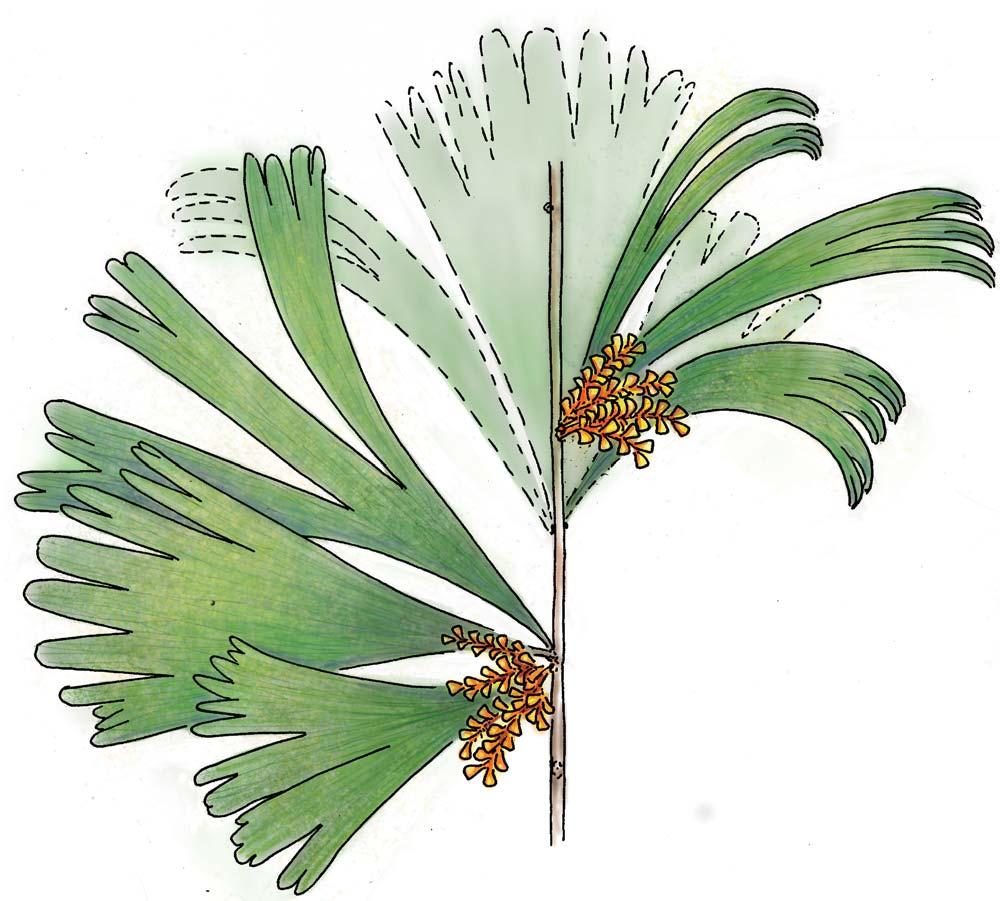





Kannaskoppia THE WHOLE-PLANT 128 ISSN 2410-4418 Palaeont. afr. (2023) 57 (Special Issue): i–xiv + 1–324 R3 ×5 R2 ×1
BP/2/3387
M5
M1 16 16 Kan 112
BP/2/3386
R2 ×1
M4 M3 M2
Kannaskoppianthus irregularis R2 ×1
PRE/F/20120
pl. 21(1–5)
R4 ×1 5 4 1 R3 ×5 PRE/F/20114a,b pls 19,20 3 7 6 R2
2 PRE/F/20114a,b
1 2 cm 0
Kannaskoppianthus irregularis / Rochipteris distivena
×2
pls 19,20 BP/2/3386 Kan 112 Hei elo Holotype
Chart 3.
Kannaskoppianthus irregularis / Rochipteris distivena
Kannaskop (Kan 112 Hei elo)
living community (BC)
fossil


Whole-plant species (male-foliage)
Foliage – Rochipteris distivena And. & And., sp. nov.
Ref. pal.: Kan 112 Hei elo – 4 indivs (attached & clusters nil)
Male strobilis – Kannaskoppianthus irregularis And. & And., 2003
Ref pal.: Kan 112 Hei elo – 5 indivs
Affiliation (male/female) – Grade 3 (fair), other options less likely Rarity () – 4 indivs in 13 man-hrs (1 per 3 man-hrs); rare
Taphonomy – parautochthonous
Habit – slender erect woody shrubs up to c. 50 cm in height
Habitat – Heidiphyllum thicket; channel sandbar in braided-river system.
Kannaskop (Kan 112 Hei elo) TC
Collection – 145 slabs, 13 man-hrs cleaving
Dominants – Heidiphyllum 98%
Biodiversity – vegetative total, 13 spp
Non-gymnosperms 4 spp, Gymnosperms 9 spp
Other Kannaskoppiaceae:
Foliage: R. rollerii (10 indivs), R. telefolia (2 indivs), R. pusilla (1 indiv), R. penensis (2 indivs)
Strobili: nil
× 1 2 1 1 2 cm 0
References
Molteno foliage taxaTC as @ Kan 112
Non-gymnosperms gensppindivs
Muscites
Marchantites
Thallites, etc.
Lycopods
Horsetails 116
Ferns 227
Gymnosperms
Pinopsida
Heidiphyllum 11 98%
Rissikia
Other genera (×2)
Cycadopsida
Pseudoctenis
Other genera (×3)
Ginkgoopsida
Lepidopteris
Ginkgoites
Sphenobaiera
Dicroidium 11 1%
Rochipteris 1 5 19
Other genera (×4)
Classes indet. Genera (×3) 112
Bennettitopsida
Halleyoctenis
Taeniopteris 111
Gnetopsida
Genera (×5)
8 gen13 spp
Kannaskoppia THE WHOLE-PLANT 129 ISSN 2410-4418 Palaeont. afr. (2023) 57 (Special Issue): i–xiv + 1–324
And. & And. (2003): general “ “ (2008): ferns “ “ (2018): sphenophytes deposit (TC)
× 1 10 × 1 100 × 1 20
Key 1%: of TC 19 indivs in TC
HMA & Clara A., June 2020
PRE/F/15244b pl. 126(1–3)
Kannaskoppianthus aasvoelensis / Rochipteris rollerii
PRE/F/19547b pl. 125(5–9) 4
Kannaskoppianthus aasvoelanthus
10 indivs total 7 indivs drawn 6 indivs graphed Aas 111 Hei elo
4 3 2
1 12345678910 microsporophylls


24
24 Aas 111
8
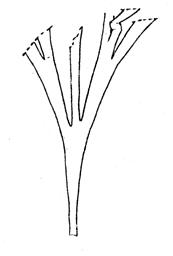
pl. 138(12,13) 6
PRE/F/19529 pl. 141(5) R2 all ×1

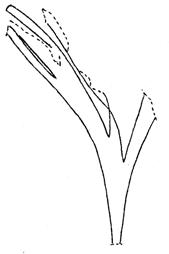
PRE/F/19019 pl. 152(1–3)

R2 ×1
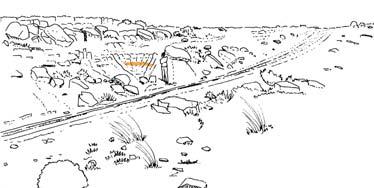
Aas 111 Taphonomy (elaborated)
A counterpart to the two Heidiphyllum-thicket Peninsula sites (Pen 311 and Pen 411) near the eastern corner of the southern outcrop belt of the Molteno, are three Heidiphyllum-thicket Aasvoëlberg sites (Aas 111, Aas 211, Aas 311) at the western corner of the outcrop. They likewise occur along strike, in this case, with some 7 km separating them. It is relevant to consider the rarity of Dicroidium and Sphenobaiera, dominants in the woodland further afield:
Aas 111: Dicoidium (7 indivs), Sphenobaiera (1 indiv) – in 40 man-hrs cleaving
Aas 211: Dicoidium (0 indivs), Sphenobaiera (0 indivs – in 35 man-hrs cleaving
Aas 311: Dicroidium (15 indivs), Sphenobaiera (9 indivs) – in 140 man-hrs cleaving
In each case, these dominant genera out in the woodland beyond the Heidiphyllum thickets, are very rare to absent in the assemblages (TCs). Our interpretation, as suggested in the habitat sketch, is that the fossil deposit occurred in an area of high water table (with small transitory lakes) largely surrounded by the coniferous thicket.
Kannaskoppia THE WHOLE-PLANT 130 ISSN 2410-4418 Palaeont. afr. (2023) 57 (Special Issue): i–xiv + 1–324 R2 ×2
2
M5
M3 M2 M1
M4
R4
11 1 5
3 9
×1
PRE/F/19484 pl. 126(4–7)
10
PRE/F/15222 Holotype
PRE/F/19545 pl. 128(5–10)
BP/2/4306
12
PRE/F/19020b pl. 151(1–7)
Aas 111
Sister palaeodeme Aas 311 Hei elo
Aas 111
Aas 111 Hei elo
Chart 4.
1 2 cm 0
BP/2/4297a
7 R2
PRE/F/19547b pl. 125(5–9) R3 ×5
all ×2
Kannaskoppianthus aasvoelensis / Rochipteris rollerii
Aasvoëlberg (Aas 111 Hei elo)
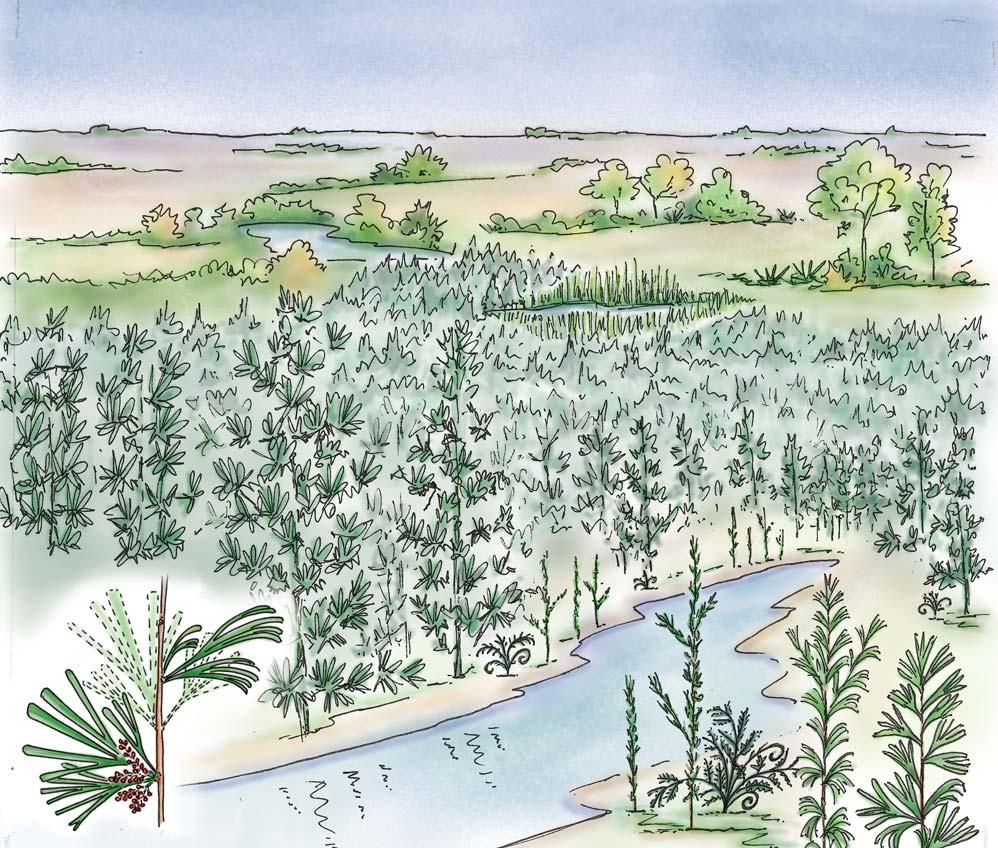
Whole-plant species (male-foliage)
Foliage – Rochipteris rollerii
Ref. pal.: Aas 111 Hei elo – 2% (c. 50 slabs, att. nil, clusters 6)
Male strobilis – Kannaskoppianthus aasvoelanthus
Ref. pal.: Aas 111 Hei elo – 21 indivs (nil clustered or attached)
Affiliation (male/foliage) – Grade 4 (good)
Rarity () – 2% of assemblage; sparse
Taphonomy – parautochthonous
Habit – slender erect woody shrubs up to 1.0 m in height
Habitat – Heidiphyllum thicket; in area of high water table in the floodplain; scattered near water’s edge around small lake or marshland within the thicket.
Aasvoëlberg (Aas 111 Hei elo) TC
Collection – 291 slabs, 40 man-hrs cleaving.
Dominants – Heidiphyllum 77%, ferns 20%
Biodiversity – vegetative total, 13 spp
Non-gymnosperms 7 spp, gymnosperms 6 spp
Other Kannaskoppiaceae: nil
References And. & And. (2003): general “ “ (2008): ferns “ “ (2018): sphenophytes

living community (BC)
Molteno foliage taxaTC as @ Aas 111
Non-gymnosperms gensppindivs
Muscites
Marchantites *217
Thallites, etc.
Lycopods
Horsetails 1110
Ferns 34 20%
Gymnosperms
Pinopsida
Heidiphyllum 11 77%
Rissikia
Other genera (×2)
Cycadopsida
Pseudoctenis
Other genera (×3)
Ginkgoopsida
Lepidopteris
Ginkgoites
Sphenobaiera 111
Dicroidium 12 7
Rochipteris 1 1 2%
Other genera (×4)
Classes indet. Genera (×3)
Bennettitopsida
Halleyoctenis
Taeniopteris 112
Gnetopsida Genera (×5)
Key 2%: of TC 2 indivs in TC
10 gen13 spp
Kannaskoppia THE WHOLE-PLANT 131
ISSN 2410-4418 Palaeont. afr. (2023) 57 (Special Issue): i–xiv + 1–324
fossil deposit (TC)
× 1 10 × 1 20
× 1 2 × 1 5 1 1 2 cm 0
HMA & Clara A., June 2020
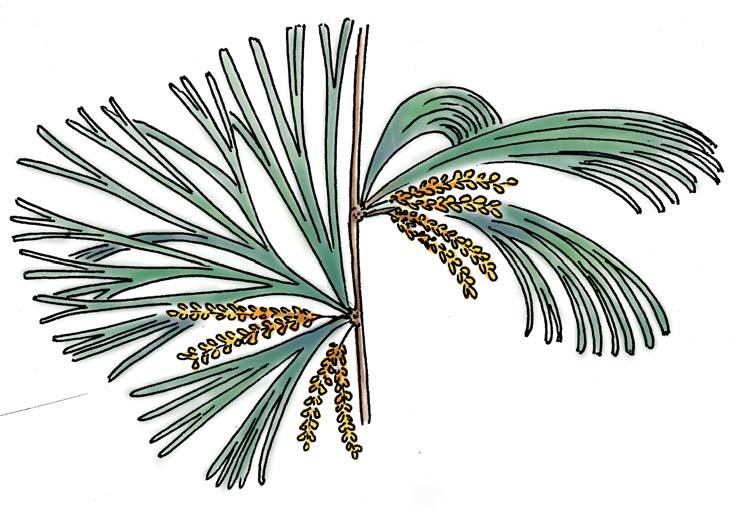
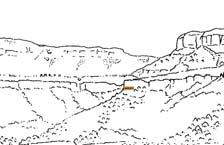











Kannaskoppia THE WHOLE-PLANT 132 ISSN 2410-4418 Palaeont. afr. (2023) 57 (Special Issue): i–xiv + 1–324 PB/2/1572 13 4 3 2 1 123456789101112 microsporophylls PRE/F/21497a pl. 119(1–6) 8 Holotype
M5 M4 M3 M2 M1 1 1 Lit 111 Kannaskoppianthus switzianthus 9 indivs total 7 indivs drawn 6 indivs graphed Lit 111 Dic/Hei PRE/F/5939 pl. 120(6) 2 R4 ×1 1 PRE/F/5940 pl. 120(4) 3 PRE/F/5943a,b pl. 120(7–11) 6 BP/2/1623 5 PRE/F/5942a,b pl. 120(1,2) 4 14 R3 ×5 PRE/F/21497 pl. 119(2,3,6) 9 7 PRE/F/5734 Lit 111 R2 all ×2 Lit 111 17 BP/2/1582 pl. 124(1–5)
×2 16 R2 ×2
15 10 BP/2/1577
pl.
Holotype 12
Kannaskoppianthus switzianthus / Rochipteris switzifolia
R2
PRE/F/5638 pl. 123(1–4)
BP/2/1559
121 (1–4)
1 2 cm 0 R3 ×5 R2 all ×1 BP/2/1564 BP/2/1581
Lit
111 Dic/Hei
Chart 5.
Kannaskoppianthus switzianthus / Rochipteris switzifolia
Little Switzerland (Lit 111 Dic/Hei)
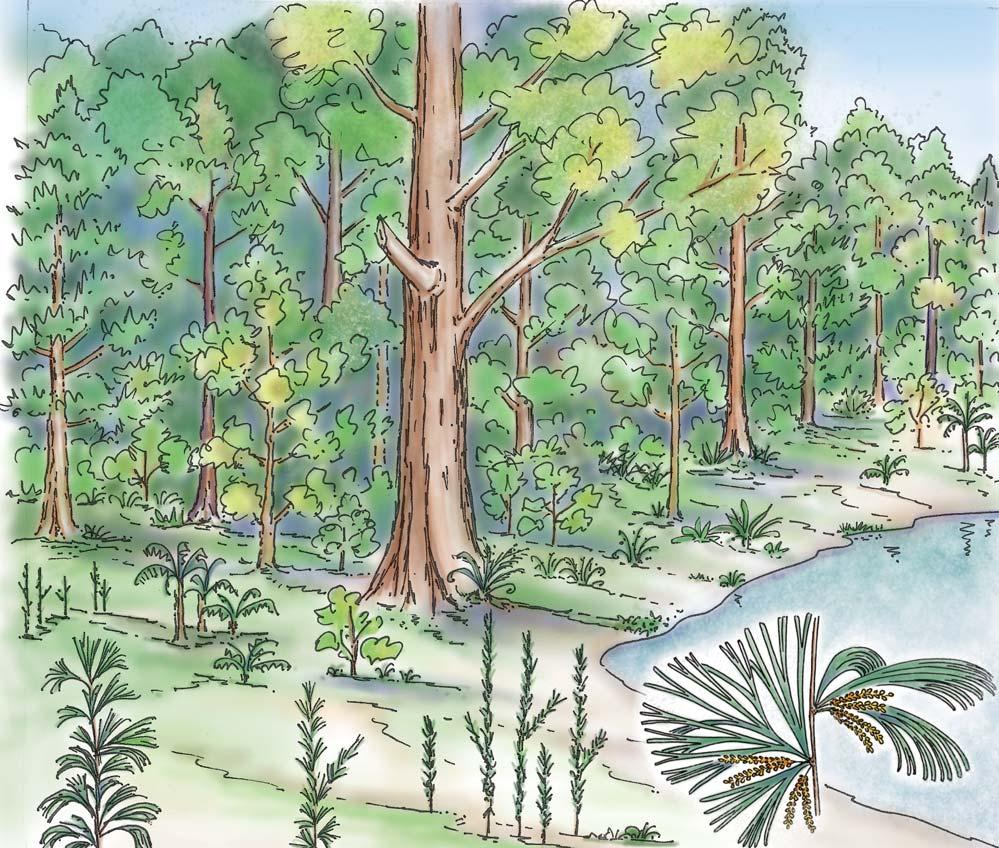

Whole-plant species (male-foliage)
Foliage – Rochipteris switzifolia And. & And., sp. nov.
Ref. pal.: Lit 111 Dic/Hei – 55 indivs (attached & clusters nil)
Male strobilis – Kannaskoppianthus switzianthus And. & And., sp. nov. Ref. pal.: Lit 111 Dic/Hei – 9 indivs (attached & clusters nil)
Affiliation (male/foliage) – Grade 3–4 (virtually exclusive), backed up at other sites
Rarity () – 55 indivs in 550 man-hrs (1 per 1 man-hr); rare
Taphonomy – strictly allochthonous
Habit – slender erect woody shrubs up to 0.8 m in height; scattered patches a little in from water’s edge
Habitat – Dicroidium-dominated mature riparian forest;
Little Switzerland (Lit 111 Dic/Hei) TC
Collection – 2173 slabs, 550 man-hrs cleaving
Dominants – Dicroidium 50%, Heidiphyllum 23%, Sphenobaiera 1%
Biodiversity – vegetative total, 38 spp
Non-gymnosperms 6 spp, gymnosperms 32 spp
Other
Key 50%: of TC 55 indivs in TC 1 2 cm 0
References And. & And. (2003): general “ “ (2008): ferns “ “ (2018): sphenophytes
Kannaskoppia THE WHOLE-PLANT 133 ISSN 2410-4418 Palaeont. afr. (2023) 57 (Special Issue): i–xiv + 1–324
Kannaskoppiaceae: Foliage: R.
Strobili: nil Molteno foliage taxaTC as
111 Non-gymnosperms gensppindivs Muscites 1114 Marchantites 112 Thallites, etc. Lycopods Horsetails 1110 Ferns 3310 Gymnosperms Pinopsida Heidiphyllum 11 23% Rissikia 1140 Other genera (×2) Cycadopsida Pseudoctenis 1248 Other genera (×3) 227 Ginkgoopsida Lepidopteris 11 1% Ginkgoites 124 Sphenobaiera 12 1% Dicroidium 18 50% Rochipteris 1 2 56 Other genera (×4) 22 20% Classes indet. Genera (×3) 2218 Bennettitopsida Halleyoctenis 118 Taeniopteris 1278 Gnetopsida Genera (×5) 3454 25 gen38 spp living community (BC) fossil deposit (TC) × 1 10 × 1 20
vincularis (1 indiv)
@ Lit
× 1 2 × 1 5 1
HMA
& Clara A., June 2020
PRE/F/3205
PRE/F/9251a,b

PRE/F/9082a,b pl. 115(1–4)
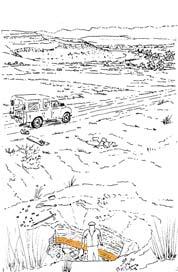

PRE/F/9083a,b pl. 116(5–8)
PRE/F/9083b pl. 116(8)













Kannaskoppia THE WHOLE-PLANT 134 ISSN 2410-4418 Palaeont. afr. (2023) 57 (Special Issue): i–xiv + 1–324
M5 M4 M3 M2 M1 10 10 Mat 111 4 3 2 1 12345678910 microsporophylls 2 indivs total 2 indivs drawn 2 indivs graphed R2 ×2
Mat 111
R4 ×1
Kannaskoppianthus matatiparvus
Mat 111 Dic dub
Kannaskoppianthus matatiparvus / Rochipteris matatifolia
Mat 111 Dic dub
Mat 111
pl. 113(1–4)
1
pl. 113(5–10) pl. 114(1–5)
5 2
7
Holotype
PRE/F/9076a
8
9
R3 ×5
R3
Holotype 6 BP/2/3025 3 1 2 cm 0 R2
PRE/F/3205 pl. 113(1–4)
×5
4
all ×1
Chart 6.
Kannaskoppianthus matatiparvus / Rochipteris matatifolia
Matatiele (Mat 111 Dic dub)

living community (BC)

Whole-plant species (male-foliage)
Foliage – Rochipteris matatifolia And. & And., sp. nov.
Ref. pal.: Mat 111 Dic dub – 17 indivs (attached & clusters nil)
Male strobilis – Kannaskoppianthus matatiparvus And. & And., 2003
Ref. pal.: Mat 111 Dic dub – 3 indivs (attached & clusters nil)
Affiliation (male/foliage) – Grade 3 (alternative less likely)
Rarity () – 17 indivs in 65 man-hrs (c. 1 per 3 man-hrs); rare
Taphonomy – parautochthonous-allochthonous
Habit – slender erect woody shrubs up to 1.0 m in height
Habitat – Dicroidium riparian forest (type 2), bordering channels in immature landscape; in patches along rather broader, flatter ground adjacent to the river.
Matatiele (Mat 111 Dic dub) TC
Collection – 1082 slabs, 65 man-hrs cleaving
Dominants – Heidiphyllum 4%, Dicroidium 89%, horsetails 20 indivs
Biodiversity – vegetative total, 25 spp
Non-gymnosperms 7 spp, gymnosperms 18 spp
Other Kannaskoppiaceae:
Foliage: R. telefolia 2%
Strobili: nil
References
And. & And. (2003): general “ “ (2008): ferns “ “ (2018): sphenophytes
Molteno foliage taxaTC as @ Mat 111
Non-gymnosperms gensppindivs
Muscites 111
Marchantites
Thallites, etc. 111
Lycopods 111
Horsetails 2220
Ferns 227
Gymnosperms
Pinopsida
Heidiphyllum 11 4%
Rissikia
Other genera (×2)
Cycadopsida
Pseudoctenis 1212
Other genera (×3)
Ginkgoopsida
Lepidopteris 11 1%
Ginkgoites 1125
Sphenobaiera 1118
Dicroidium 15 89%
Rochipteris 1 2 2%
Other genera (×4) 133
Classes indet. Genera (×3)
Bennettitopsida
Halleyoctenis
Taeniopteris 11 2%
Gnetopsida
Genera (×5) 112 17gen25spp
Key 2%: of TC 3 indivs in TC
Kannaskoppia THE WHOLE-PLANT 135 ISSN 2410-4418 Palaeont. afr. (2023) 57 (Special Issue): i–xiv + 1–324
× 1 10 × 1 20
× 1 2
HMA & Clara A., June 2020
1 1 2 cm 0
fossil deposit (TC)
Kannaskoppianthus komanthus / Rochipteris komifolia

PRE/F/3231a,b

PRE/F/3227
PRE/F/3216

PRE/F/3221
PRE/F/3230






Kannaskoppia THE WHOLE-PLANT 136 ISSN 2410-4418 Palaeont. afr. (2023) 57 (Special Issue): i–xiv + 1–324 M5 M4 M3 M2 M1 30 30 Kom 111
PRE/F/3227 ‘z’ pl. 48(4–8)
PRE/F/3227 ‘z’ (reverse of slab) pl. 48(4–8)
R2 ×2
Kom 111 Sph/Dic
R2
×1
R2 ×1
PRE/F/3231a,b pl. 47(1–8)
R2 ×1
R2
Kannaskoppianthus komanthus R2
4 3 2 9 10 11 Kom 111 R2 ×1 7
PRE/F/3227 ‘x’,‘y’ pl. 48(1–3)
×1
×2
pl. 49(1–4)
6
8
‘z’ pl. 48(4–8) R2 ×1
Kom 111
Holotype Holotype Holotype 1 2 cm 0
Chart 7.
R3
5 ‘x’
1 R4
pl. 47(1–8)
×5
‘y’
×1
Kannaskoppianthus komanthus / Rochipteris komifolia
Kommandantskop (Kom 111 Sph/Dic)


Whole-plant species (male-foliage)
Foliage – Rochipteris komifolia And. & And., sp. nov. Ref. pal.: Kom 111 Sph/Dic – 29 indivs (14 attached, 7 clusters)
Male strobilis – Kannaskoppianthus komanthus And. & And., sp. nov. Ref. pal.: Kom 111 Sph/Dic – 2 indivs (both attached with foliage)
Affiliation (male/female) – Grade 5 (excellent), attachment (both indivs attached with foliage)
Rarity () – 29 indivs in 10 man-hrs (3 per man-hr); sparse to rare
Taphonomy – parautochthonous-autochthonous
Habit – slender erect woody shrubs up to c. 80 cm in height
Habitat – Sphenobaiera woodland bordering small lakes in floodplain; pioneers in patches along edge of lake.
Kommandantskop (Kom 111 Sph/Dic) TC
Collection – 168 slabs, 10 man-hrs cleaving
Dominants – Sphenobaiera 60%, Dicroidium 39%, ferns 1%
Biodiversity – vegetative total: 8 spp
Non-gymnosperms 3 spp; gymnosperms 5 spp
Other Kannaskoppiaceae:
Foliage: R. switzifolia (1 indiv)
Strobili: nil
Molteno TCs (of 26 TCs total with Rochipteris) – Aas 411 Dic/Sph is the only other TC representing this habitat, but it has Dicroidium as dominant (69%) & Sphenobaiera as a sub-dominant (5%).
Molteno foliage taxaTC as @ Kom 111
Non-gymnosperms gensppindivs
Muscites Marchantites 111
Thallites, etc.
Lycopods Horsetails 1115
Ferns 22 1%
Gymnosperms
Pinopsida
Heidiphyllum
Rissikia
Other genera (×2)
Cycadopsida
Pseudoctenis
Other genera (×3)
Ginkgoopsida
Lepidopteris
Ginkgoites
Sphenobaiera 11 60%
Dicroidium 12 39%
Rochipteris 1 2 30
Other genera (×4)
Classes indet. Genera (×3)
Bennettitopsida
Halleyoctenis
Taeniopteris
Gnetopsida
Genera (×5) 7 gen8 spp
Key 39%: of TC 30 indivs in TC
References And. & And., 2003 “ “ 2008 “ “ 2018
Kannaskoppia THE WHOLE-PLANT 137 ISSN 2410-4418 Palaeont. afr. (2023) 57 (Special Issue): i–xiv + 1–324
living community
fossil deposit (TC)
(BC) (BC)
× 1 10 × 1 20
× 1 2 × 1 5 1 1 2 cm 0
HMA & Clara A., June 2020
PRE/F/11429a
PRE/F/11434a pl. 59(1–9)
Kannaskoppianthus lutinumerus / Rochipteris lutifolia
PRE/F/11433a,b pl. 53(1–8)
PRE/F/11364 pl. 62(9–12)
PRE/F/11538a pl. 61(1–3)
PRE/F/11390a,b pl. 57(1–8)
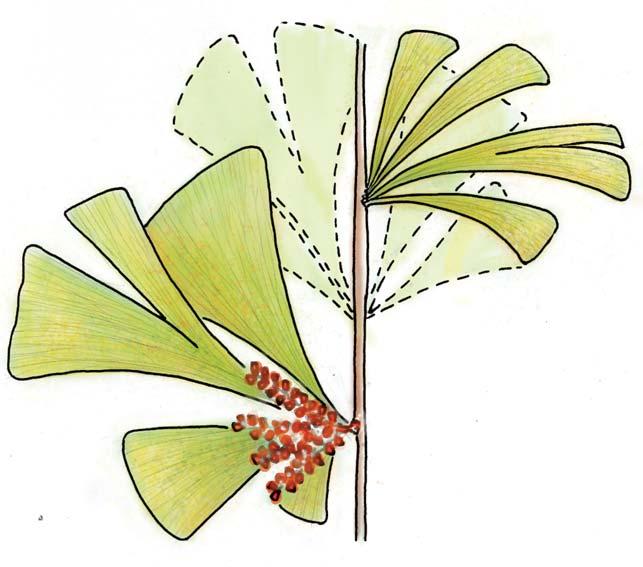
PRE/F/11384a
R2
all ×1
PRE/F/11354 pl. 68(1–4)
PRE/F/11355a,b pl. 68(5–9)







PRE/F/11358a pl. 61(1–3)
Kannaskoppia THE WHOLE-PLANT 138 ISSN 2410-4418 Palaeont. afr. (2023) 57 (Special Issue): i–xiv + 1–324 4 3 2 1 123456789101112 microsporophylls
indivs total 10 indivs drawn 8 indivs graphed
16
R2 ×2 M5 M4 M3 M2 M1 36 Lut 311 36 Lut Lu 1 311 R2 all ×2
Kannaskoppianthus lutinumerus
Holotype R2 ×5 R4 ×1 1
R2 ×2 11 8 10 7 5 4 3 2 13 12 Lut 311
pl. 67(1–7)
6 9
pl. 54(1–5)
Lut 311 Hei elo
Lut 311 Hei elo Holotype 1 2 cm 0
Chart
8.
PRE/F/11429a,b, pl. 54(1–9)
R4 ×5
PRE/F/11434a, pl. 59 pls 56–60 see pp 48, 95
Kannaskoppianthus lutinumerus / Rochipteris lutifolia
Lutherskop (Lut 311 Hei elo)
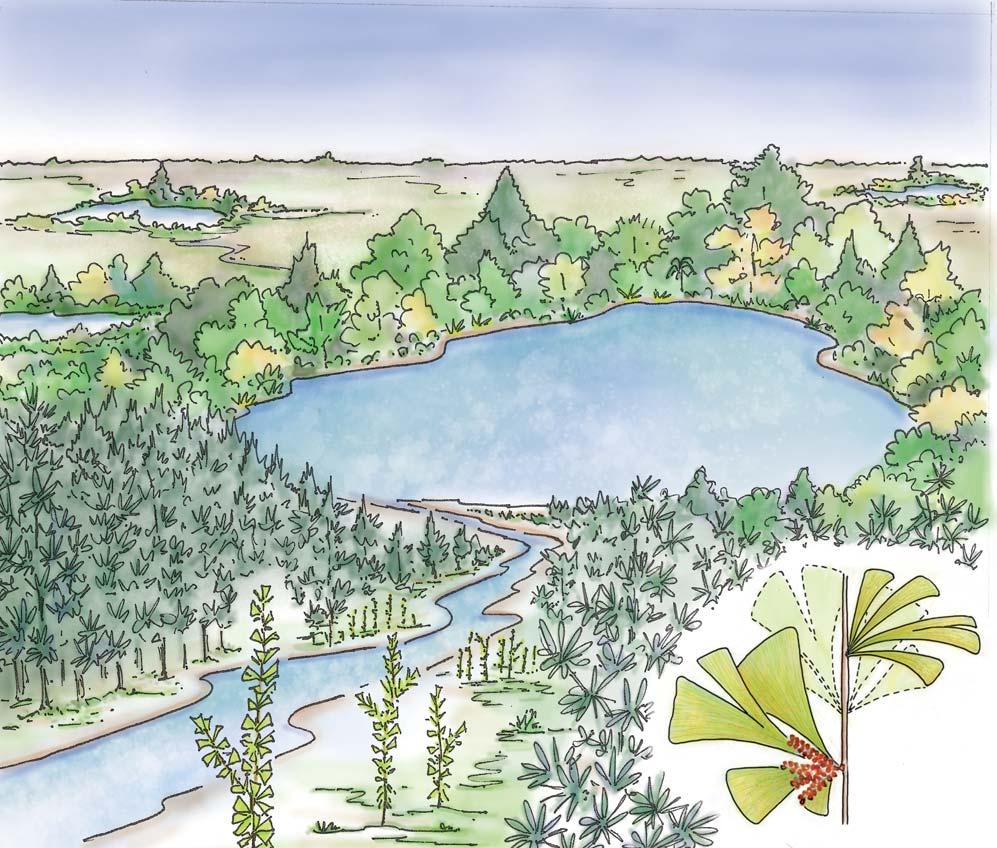

Whole-plant species (male-foliage)
Foliage – Rochipteris lutifolia And. & And., sp. nov.
Ref. pal.: Lut 311 Hei elo – 66 indivs (attached & clusters nil)
Male strobilis – Kannaskoppianthus lutinumerus And. & And., 2003
Ref. pal.: Lut 311 Hei elo; 16 indivs (attached nil, 2 small clusters)
Affiliation (male/foliage) – Grade 4, (exclusive, no other Kannaskoppiaceae in the TC)
Rarity () – 66 indivs in 50 man-hrs (c.1 per man-hr); rare
Taphonomy – parautochthonous
Habit – slender erect woody shrubs up to 0.6 m in height
Habitat – Heidiphyllum thicket; in area of high water table in the floodplain; scattered near water’s edge around small lake and adjacent to thicket; Dicroidium & Sphenobaiera dominate the far side of the quite large lake.
Lutherskop (Lut 311 Hei elo) TC
Collection – 589 slabs, 50 man-hrs cleaving
Dominants – Heidiphyllum 99%, Dicroidium 58 indivs, Horsetails 30 indivs
Biodiversity – vegetative total, 19 spp
Non-gymnosperms 5 spp, gymnosperms 14 spp
Other Kannaskoppiaceae:
Foliage: nil
Strobili: nil
References And. & And. (2003): general “ “ (2008): ferns “ “ (2018): sphenophytes
Molteno foliage taxaTC as @ Lut 311
Non-gymnosperms gensppindivs
Muscites 116
Marchantites 111
Thallites, etc.
Lycopods
Horsetails 2230
Ferns 113
Gymnosperms
Pinopsida
Heidiphyllum 11 99%
Rissikia
Other genera (×2)
Cycadopsida
Pseudoctenis
Other genera (×3)
Ginkgoopsida
Lepidopteris 1219
Ginkgoites
Sphenobaiera 1229
Dicroidium 1358
Rochipteris 1 1 66
Other genera (×4) 125
Classes indet. Genera (×3) 112
Bennettitopsida
Halleyoctenis
Taeniopteris 1123
Gnetopsida Genera (×5) 129 12 gen19 spp
Key 99%: of TC 66 indivs in TC
Kannaskoppia THE WHOLE-PLANT 139 ISSN 2410-4418 Palaeont. afr. (2023) 57 (Special Issue): i–xiv + 1–324
× 1 10 × 1 20
× 1 2
HMA & Clara A., June 2020
living community (BC)
1 1 2 cm 0
fossil deposit (TC) (TC)
Rochipteris obtriangulata
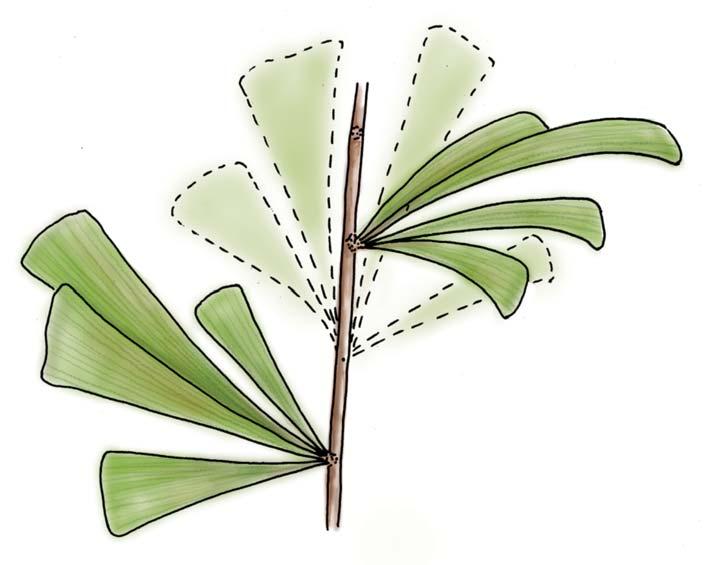

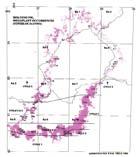
Kannaskoppia THE WHOLE-PLANT 140 ISSN 2410-4418 Palaeont. afr. (2023) 57 (Special Issue): i–xiv + 1–324 R4 ×1 1
Umk 111 Dic 2spp
R2
BP/2/544 R2 ×2
all ×1
M5 M4 M3 M2 M1 6 6 Umk 111 10 8 7 6 9 45 3 2
BP/2/423 pl. 103(4–8)
BP/2/425 PL. 104(8,9)
BP/2/546 pl. 105(9)
BP/2/544
BP/2/547a pl. 105(7,8)
BP/2/115 pl. 104(1–4)
BP/2/422 pl. 103(1–3)
BP/2/115 pl. 104(1–4)
R2 ×2
Umk 111
Umk 111
1 2 cm 0
Chart 9.
Rochipteris obtriangulata
Umkomaas (Umk 111 Dic 2spp)
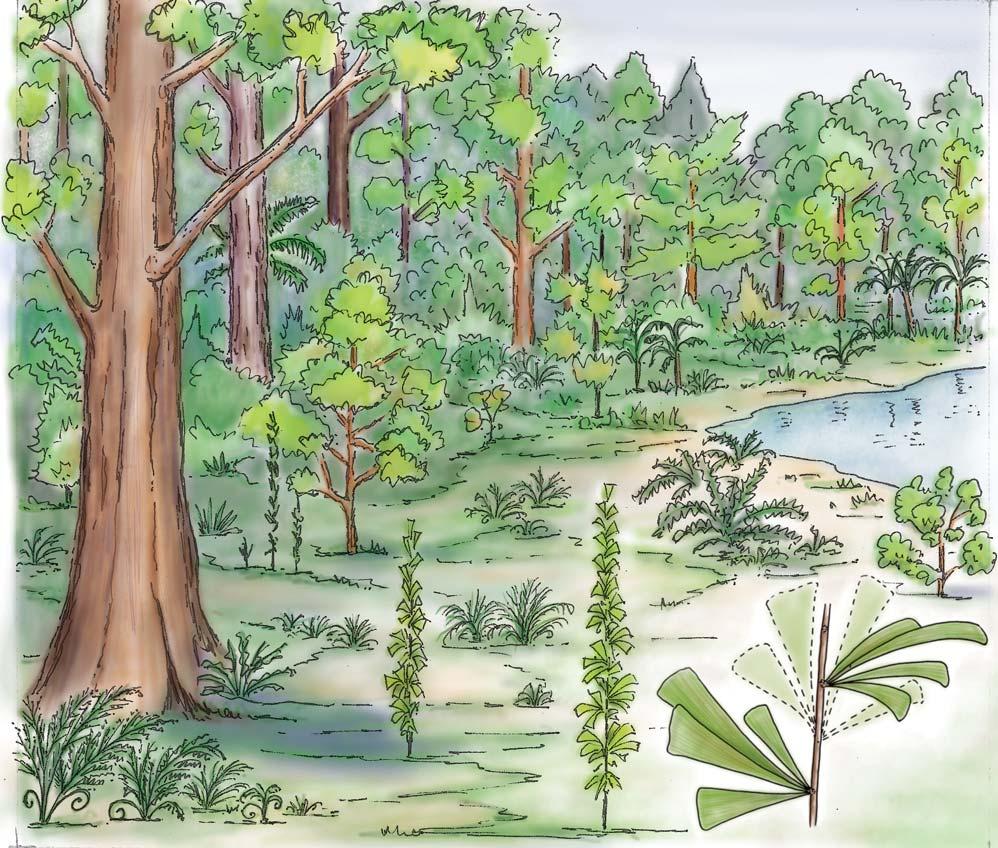
Whole-plant species (foliage)
Foliage – Rochipteris obtriangulata Holmes & And., 2005
Ref. pal.: Umk 111 Dic 2spp – 19 indivs (attached & clusters nil)
Male strobilis – nil
Affiliation (male/foliage) – nil
Rarity () – 19 indivs in 400 man-hrs (1 per 20 man-hrs); v. rare
Taphonomy – parautochthonous to allochthonous
Habit – slender erect woody shrubs up to c. 60 cm in height
Habitat – Dicroidium-dominated mature riparian forest; pioneer in a relatively open clearing fairly close to the river’s edge.
Umkomaas (Umk 111 Dic 2spp) TC
Collection – 3592 slabs, 400 man-hrs cleaving
Dominants – Dicroidium 69%, Heidiphyllum 7%, Sphenobaiera 5%
Biodiversity – vegetative total, 75 spp
Non-gymnosperms 29 spp, gymnosperms 46 spp
Other Kannaskoppiaceae:
Foliage: R. rollerii (21 indivs), R, lutifolia (1 indiv.), R. cf. sinuosa (9 indivs)
Strobili: nil
References And. & And. (2003):

Molteno
Kannaskoppia THE WHOLE-PLANT 141 ISSN 2410-4418 Palaeont. afr. (2023) 57 (Special Issue): i–xiv + 1–324
foliage
111 Non-gymnosperms gensppindivs Muscites 1141 Marchantites 1126 Thallites, etc. Lycopods Horsetails 38 2% Ferns 813 1% Gymnosperms Pinopsida Heidiphyllum 11 7% Rissikia 11 5% Other genera (×2) 1120 Cycadopsida Pseudoctenis 14 1% Other genera (×3) 2342 Ginkgoopsida Lepidopteris 11 1% Ginkgoites Sphenobaiera 15 5% Dicroidium 18 69% Rochipteris 1 4 50 Other genera (×4) 2819 Classes indet. Genera (×3) 111 Bennettitopsida Halleyoctenis Taeniopteris 1455 Gnetopsida Genera (×5) 45 5% 31 gen75 spp living community (BC) fossil deposit (TC)
taxaTC as @ Umk
general
ferns
sphenophytes
69%: of TC 50 indivs in TC × 1 10 × 1 20
& Clara A., June 2020 × 1 2 1 1 2 cm 0
“ “ (2008):
“ “ (2018):
Key
HMA
Rochipteris cf. sinuosa




Taphonomy (elaborated)
As we know of species within a genus out in nature, each occupies a somewhat different habit, however subtle. In this light, and in view of the fact that we have 19 indivs of R. obtriangulata versus 9 of R. cf. sinuosa, our rendered sketches for these two species aim to portray these distinctions
– R. obtriangulata being a pioneer in clearings closer to the river’s bank; and R. cf. sinuosa, also a pioneer, but in clearings deeper within the forest.
Kannaskoppia THE WHOLE-PLANT 142 ISSN 2410-4418 Palaeont. afr. (2023) 57 (Special Issue): i–xiv + 1–324 R4 ×1
M5 M4 M3 M2 M1 6
Umk 111 Dic 2spp
6
Umk 111
R2
R2 ×1 3 2 1
BP/2/539 pl. 107(1–4)
×2
Holotype 1 2 cm 0 R2 all ×1
Chart 10.
6
PRE/F/23123 pl. 110(1–3)
BP/2/555 pl. 108(1,2)
BP/2/549 pl. 107(9,10)
BP/2/553 pl. 107(6–8)
BP/2/556 pl. 108(5–7)
11 10
PRE/F/22501 pl. 109(1–4)
BP/2/554 pl. 108(3,4)
8 7 5 4 9
BP/2/557 pl. 108(8–10)
Rochipteris cf. sinuosa
Umkomaas (Umk 111 Dic 2spp)

Whole-plant species (foliage)
Foliage – Rochipteris cf. sinuosa And. & And., sp. nov.
Ref. pal.: Umk 111 Dic 2spp – 9 indivs (isolated leaves)
Male strobilis – nil
Affiliation (male/foliage) – nil
Rarity () – 9 indivs in 400 man-hrs (1 per 40 man-hrs); v. rare
Taphonomy – allochthonous
Habit – slender erect woody shrubs up to c. 40 cm in height
Habitat – Dicroidium-dominated mature riparian forest; pioneer in a relatively small clearing fairly deep in the forest and relatively distant from the river’s edge.
Umkomaas (Umk 111 Dic 2spp) TC
Collection – 3592 slabs, 400 man-hrs cleaving
Dominants – Dicroidium 69%, Heidiphyllum 7%, Sphenobaiera 5%
Biodiversity – vegetative total, 75 spp
Non-gymnosperms 29 spp, gymnosperms 46 spp
Other Kannaskoppiaceae:
Foliage: R. rollerii (21 indivs), R, obtriangulata (19 indivs), R. lutifolia (1 indiv.)
Strobili: nil
References And. & And. (2003): general “ “ (2008): ferns “ “ (2018): sphenophytes

Molteno
Key 69%: of TC 50 indivs in TC
Kannaskoppia THE WHOLE-PLANT 143 ISSN 2410-4418 Palaeont. afr. (2023) 57 (Special Issue): i–xiv + 1–324
foliage taxaTC
111 Non-gymnosperms gensppindivs Muscites 1141 Marchantites 1126 Thallites, etc. Lycopods Horsetails 38 2% Ferns 813 1% Gymnosperms Pinopsida Heidiphyllum 11 7% Rissikia 11 5% Other genera (×2) 1120 Cycadopsida Pseudoctenis 14 1% Other genera (×3) 2342 Ginkgoopsida Lepidopteris 11 1% Ginkgoites Sphenobaiera 15 5% Dicroidium 18 69% Rochipteris 1 4 50 Other genera (×4) 2819 Classes indet. Genera (×3) 111 Bennettitopsida Halleyoctenis Taeniopteris 1455 Gnetopsida Genera (×5) 45 5% 75 living community (BC) fossil deposit (TC)
as @ Umk
× 1 10
A., June 2020 × 1 2 × 1 5 1 1 2 cm 0
HMA & Clara
Chart 11.
Reference palaeodeme
PRE/F/17946a pl. 87(1)
PRE/F/17945 pl. 87(2)
PRE/F/17032 pl. 87(3)
Rochipteris penensis
PRE/F/17035 pl. 87(4)
9
PRE/F/17047 pl. 87(5)
R2 all ×1
PRE/F/17944 pl. 87(6)
PRE/F/17050 pl. 87(7)
Pen 411
Tel 111
Holotype
PRE/F/17943b pls 87(8), 88(5)
PRE/F/18277a,b pl. 42(1–8)
Kannaskoppianthus telepentatus (affiliated ♂ strobilis, as in sister palaeodeme)
Taynult (Mr. Brummer) N

Peninsula

1 : 50,000 1 km
Outcrop (other sites along strike) See Pen 311 for text (p. 146)

upper fossiliferous horizon (whitish chert)
lower fossiliferous horizon (baked shales)
JMA, 12 April 1990 (sketches made
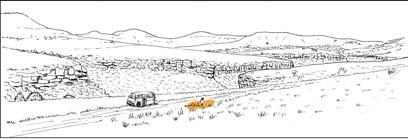
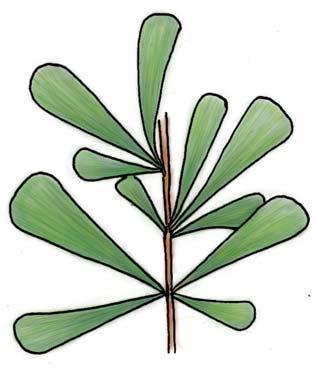
R4
PRE/F/18255 pl. 46(8,9) PRE/F/17405a,b
Sister palaeodeme Tell 111 Hei elo
R2 ×1
PRE/F/17405a
PRE/F/18255 pl. 46(8,9) PRE/F/17405b
PRE/F/18168 pl. 77(6–9)
PRE/F/18169 pl. 78(1–3)
PRE/F/18170a,b pl. 77(10–15)
PRE/F/18167a pl. 77(1–5)
PRE/F/16914a,b pl. 78(4–7)
Sister palaeodeme Pen 311 Hei elo

R2 all ×1
PRE/F/16914a,b pl. 78(4–7)
PRE/F/18170a,b pl. 77(10–15)
PRE/F/18167a pl. 77(1–5)
R2
R2 all ×2
Kannaskoppia THE WHOLE-PLANT 144 ISSN 2410-4418 Palaeont. afr. (2023) 57 (Special Issue): i–xiv + 1–324
Pen 411 Hei elo
M5 M4 M3 M2 M1 15 15 Pen 311,
411
in the field)
all ×2
×1
R2 ×2 R2 ×5 10 11 15 14 13 12 1 16 24 23 22 21 20 19 18 17
1 2 cm 0
7 4 6 8
2 5
3
Rochipteris penensis
Peninsula (Pen 411 Hei elo)
deposit (TC)
living community (BC)

× 1 10 × 1 20
Whole-plant species (foliage)
Foliage – Rochipteris penensis And. & And., sp. nov.
Ref. pal.: Pen 411 Hei elo – 10 indivs (isolated leaves)
Male strobilis – nil
Affiliation (male/foliage) – nil
Rarity () – 10 indivs in 70 man-hrs (1 per 7 man-hrs); v. rare
Taphonomy – parautochthonous-allochthonous
Habit – slender erect woody shrubs up to c.30 cm in height
Habitat – Heidiphyllum thicket; in area of high water table in the floodplain; in limited clearings within the thicket, relatively close (20–50 m) to a small lake or marshland/wetland.
Peninsula (Pen 411 Hei elo) TC
Collection – 204 slabs, 70 man-hrs cleaving
Dominants – Heidiphyllum 94%, ferns 3%, horsetails 2%
Biodiversity – vegetative total, 11 spp
Non gymnosperms 6 spp, gymnosperms 5 spp
Other Kannaskoppiaceae:
Foliage: R. rollerii (70 indivs)
Strobili: Kannaskoppianthus (4 indivs); Grade 4 affil. (with R. rollerii)
Taphonomy (elaborated)
× 1 2 × 1 5 1 1 2 cm 0
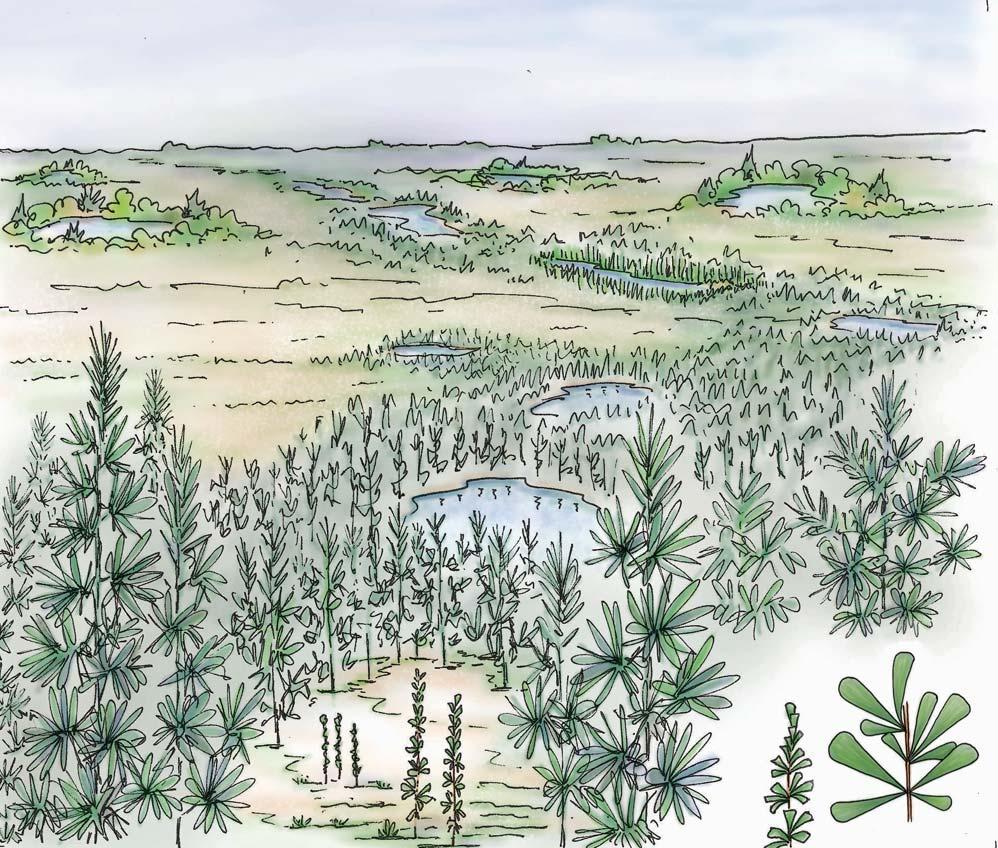
Molteno foliage taxaTC as @ Pen 411
Non-gymnosperms gensppindivs
Muscites 111
Marchantites 113
Thallites, etc.
Lycopods
Horsetails 11 2%
Ferns 11 3%
Gymnosperms
Pinopsida
Heidiphyllum 11 94%
Rissikia
Other genera (×2)
Cycadopsida
Pseudoctenis
Other genera (×3)
Ginkgoopsida
Lepidopteris
Ginkgoites
Sphenobaiera
Dicroidium 1113
Rochipteris 1 2 80
Other genera (×4) 1150
Classes indet. Genera (×3)
Bennettitopsida
Halleyoctenis
Taeniopteris
Gnetopsida
Genera (×5) 811
Kannaskoppia THE WHOLE-PLANT 145 ISSN 2410-4418 Palaeont. afr. (2023) 57 (Special Issue): i–xiv + 1–324
References And. & And. (2003): general “ “ (2008): ferns “ “ (2018): sphenophytes fossil
Key 94%: of TC 80 indivs in TC
See Pen 311 for text (p. 146)
HMA & Clara A., June 2020

15
15 Pen 311, 411
M1
PRE/F/16915b
PRE/F/16915b pl. 78(8–11)
Rochipteris pusilla
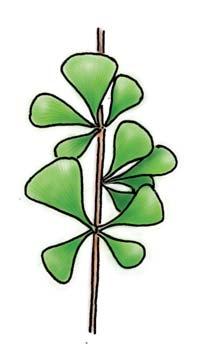
PRE/F/18166a
PRE/F/18166a
Sister palaeodeme
Tel 111 Hei elo
PRE/F/17393‘y’
Pen 311 Outcrop (for other sites along strike, see sketch (p. 144)
Pen 411 lies 1.25 km along contour/outcrop south of Pen 311. Though we only collected from these two sites, we traced the winding contour on which they occur along a narrow sand road noting seven Heidiphyllum thicket sites across a 1.6 km north–south stretch of sloping grassland. In nature, the Heidiphyllum thicket occurred particularly commonly, either over long stretches or over repeated shorter stretches.
For comparison, see the text (p. 130) for the Aasvoëlberg sites (Aas 111, Aas 211, Aas 311), occurring along strike.
Pen 311 Taphonomy (elaborated)
Interestingly, all three Rochipteris species (41 indivs) occur on bedding surfaces packed with Heidiphyllum. No single specimen of Dicroidium (very largely D. coriaceum) – though it is a co-dominant (at 25%) along with Heidiphyllum (75%) in the TC – is found in our collection on any slab with Rochipteris
Our interpretation of this is that the Dicroidium foliage will have been washed into the deposit from the Dicroidium-woodland further afield (to the right in our sketch) during storm/flooding events from that side. Note that the area of high water table adjacent (to the right) of the Heidiphyllum thicket in which the deposit occurs is shown clear of the conifers.
In clear contrast, Pen 411 Hei elo, occurring just ‘1.25 km along contour/ strike south of Pen 311’, is exclusively dominated by Heidiphyllum (94%) and includes no Dicroidium foliage. Our habitat sketch in this case (for Pen 411, p. 145) differs in detail, particularly with the fossil deposit (TC) shown surrounded by Heidiphyllum thicket preventing any Dicroidium from the woodland further afield getting swept in by storm water.
Kannaskoppia THE WHOLE-PLANT 146 ISSN 2410-4418 Palaeont. afr. (2023) 57 (Special Issue): i–xiv + 1–324
R4 ×1
Pen 311 Hei elo
M5 M4 M3 M2
R2 ×2
×1
Pen 311 Hei elo R2 ×2 R2
7 6 5 4 3 2 1
pl. 78(12–15)
1 2 cm 0
Chart 12.
R2 ×1
Peninsula (Pen 311 Hei elo)
Rochipteris pusilla

Whole-plant species (foliage)
Foliage – Rochipteris pusilla Holmes & And., 2005
Ref. pal.: Pen 311 Hei elo – 2 indivs (isolated leaves)
Male strobilis – nil
Affiliation (male/foliage) – nil
Rarity () – 2 indivs in 35 man-hrs (1 per 17 man-hrs); v. rare
Taphonomy – allochthonous
Habit – slender erect woody shrubs up to c. 20 cm in height
Habitat – Heidiphyllum thicket; in area of high water table in the floodplain; in limited clearings within the thicket, relatively distant (100–150 m) from a small lake or marshland/wetland.
Peninsula (Pen 311 Hei elo) TC
Collection – 155 slabs, 35 man-hrs cleaving
Dominants – Heidiphyllum 75%, Dicroidium 25%
Biodiversity – vegetative total, 11 spp
Non-gymnosperms 5 spp, gymnosperms (6 spp)
Other Kannaskoppiaceae:
Foliage: R. rollerii (34 indivs), R. penensis (5 indivs)
Strobili: nil
fossil deposit (TC)
References
And. & And. (2003): general “ “ (2008): ferns “ “ (2018): sphenophytes
living community (BC) (BC)
Molteno foliage taxaTC as @ Pen 311
Non-gymnosperms gensppindivs
Muscites 116
Marchantites 112
Thallites, etc.
Lycopods
Horsetails 115
Ferns 2211
Gymnosperms
Pinopsida
Heidiphyllum 11 75%
Rissikia
Other genera (×2)
Cycadopsida
Pseudoctenis
Other genera (×3)
Ginkgoopsida
Lepidopteris
Ginkgoites
Sphenobaiera
Dicroidium 12 25%
Rochipteris 1 3 41
Other genera (×4)
Classes indet. Genera (×3)
Bennettitopsida
Halleyoctenis
Taeniopteris
Gnetopsida
Genera (×5)
Key 25%: of TC 41 indivs in TC
Kannaskoppia THE WHOLE-PLANT 147 ISSN 2410-4418 Palaeont. afr. (2023) 57 (Special Issue): i–xiv + 1–324
× 1 10
× 1 2 × 1 5 1 1 2 cm 0
HMA & Clara A., June 2020
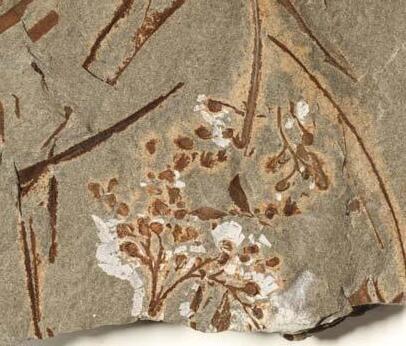
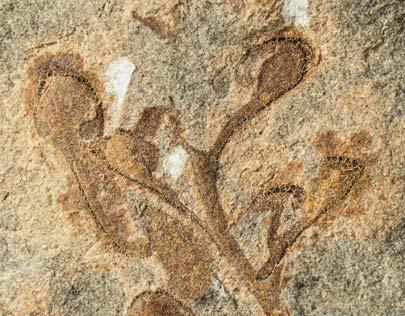
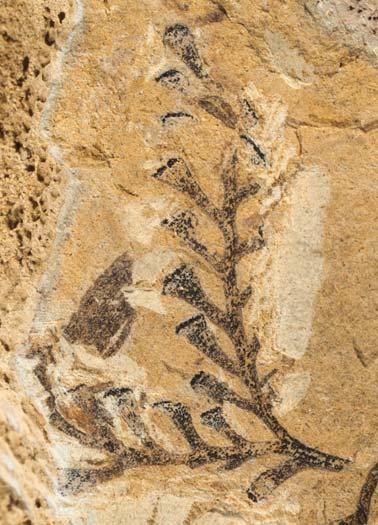
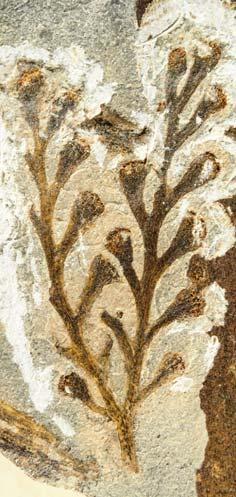

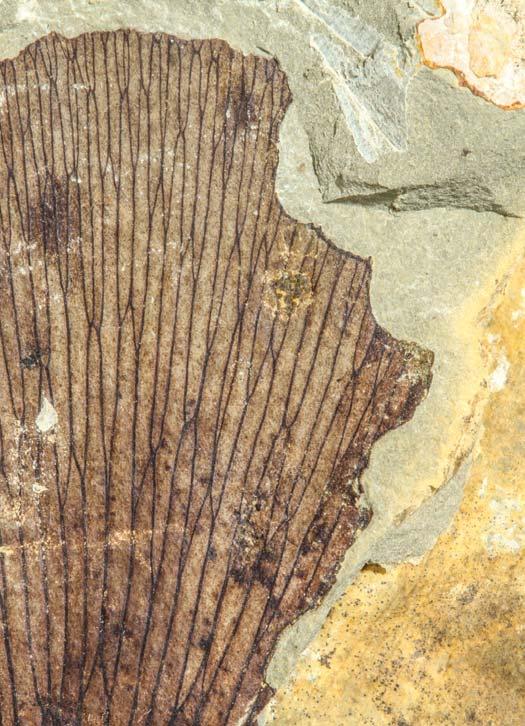
148 ISSN 2410-4418 Palaeont. afr. (2023) 57 (Special Issue): i–xiv + 1–324 ×1 ×5 1 4 ×5 2 ×5 6 ×5 5 Aas 111 Cyp 111 Kan 111 Kan 111 Lut 311 ×2 3 Cyp 111 12 cm 0

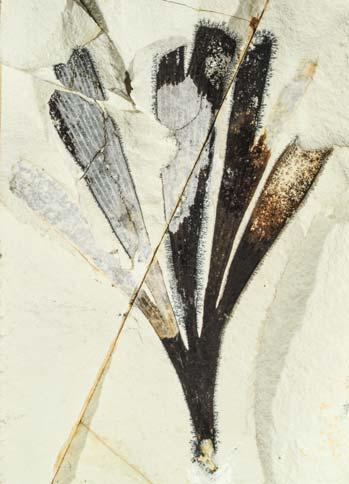






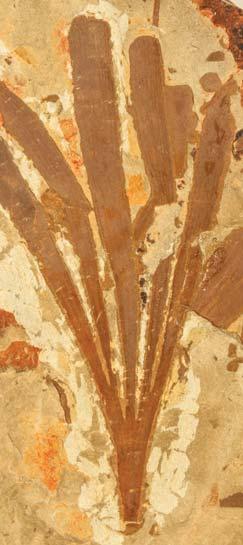

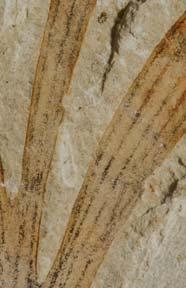
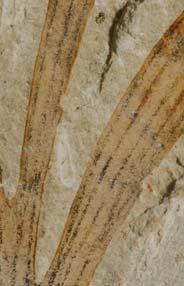



Part 4
colour plates
olour pl ates
strobili foliage
strobili & foliage
With the focus in this volume being on one particular family and on the whole-plant genus (and species), the layout of these 162 plates – very largely in colour – follows the stratigraphic sequence of the 26 productive assemblages (TCs), rather than taxonomic classification.
The 26 TCs are laid out in stratigraphic sequence, youngest The 26 TCs are laid out in sequence, youngest to oldest, down through the five members of the formation; to down the five members of the and within each TC, the strobili – with fuller coverage – and within each TC, the strobili – with fuller coverage –appear first, followed by the foliage appear first, followed the foliage.
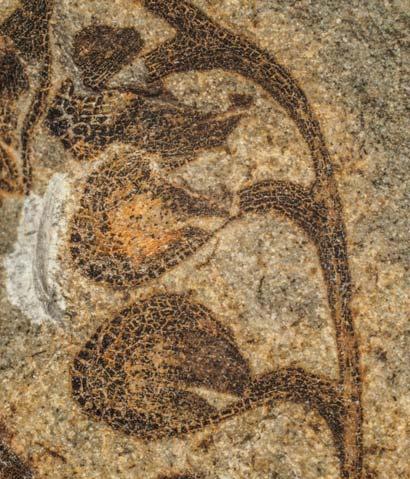


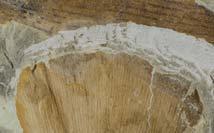

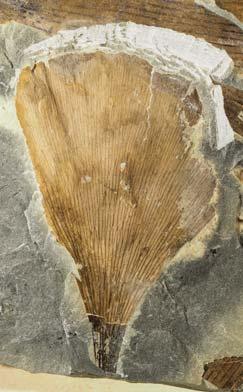
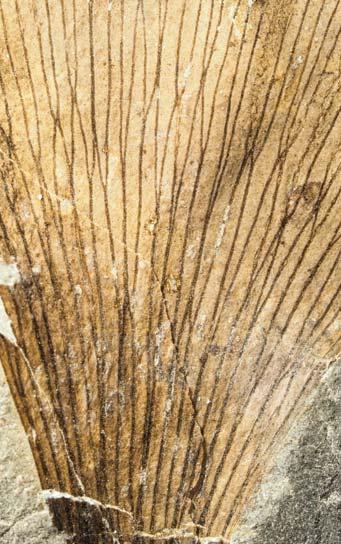
(2023) 57 (Special Issue): i–xiv + 1–324
×2
Aas
111 ×5
×5 Lut 311
×1
Lut 311 Kan 111 ×10 Kan 111 ×3
111 ×2
Kan 111 ×2 Kon 211 Aas 111 1 2 10 9 8 7 6 3 4
Aas
×10
149 12 cm 0
COLOUR PLATES
Coverage
Included is a generous coverage of both fertile and foliage species from the 26 Molteno sites (TCs) from which material of the Kannaskoppiaceae family have been found. Unlike in our previous two volumes (on the ferns & horsetails) – where we had separate sections on black-and-white and colour plates – in this volume we have focussed largely on colour.
Colour vs black & white (bl. & wh.)
Of the 162 plates, the large majority (109 plates) are exclusively colour; 20 plates are exclusively bl. & wh.; whilst 33 are mixed, with colour and bl. & wh. For some TCs, e.g. Lit 111, Umk 111 in dark carbonaceous rock, the original bl. & wh. photos (processed pre-digital era in the darkroom) are difficult to distinguish and marked by an asterisk.
Arrangement
Sites: The 26 Molteno sites are laid out through the chapter in stratigraphic sequence, youngest above, oldest below, matching the arrangement of data elsewhere in the volume – notably the coverage of sites (sketches and text).
Taxa: For those sites where both fertile specimens and foliage occur, we cover first the strobili. Where more than one species within either occurs, the order is as per our taxonomic coverage – from the best represented whole-plant taxa to those least securely defined.
Specimens: Where multiple (two or more) specimens appear on a plate, they are clearly grouped for easy visualization; and numbered accordingly. The order – for any particular specimen – is from smaller to larger magnification. Part and counterpart (indicated by an a and b) are included where these complement one another, and/or as quality warrants it.
Magnification
A standard set of magnifications – ×1, ×2, ×5, ×10, ×15, ×20, ×40 (rarely ×15, ×30, ×80) – is followed, facilitating ready comparison of specimens from different species or sites. A 2 cm scale is added to each plate, negating the need of a scale bar on each photograph.
Plant–insect interaction
Based on the work of Conrad Labandeira, Smithsonian, Washington, as outlined in our latest Molteno volume on the sphenophytes (And. & And. 2018), all plant groups found in the formation “were affected by plant herbivores”; and all basic modes of insect herbivory found in the modern world occur in Molteno plants. This is clearly evidenced by the insect damage types preserved amongst the Kannaskoppiaceae plants, as illustrated in the colour plates that follow, and in the selection of images lining this page.
Quite evident is that some sites show more insect damage than others. A high proportion of foliage specimens from Cyphergat (Cyp 111), for instance, show well-preserved marginal feeding (e.g. figs 1, 2 to the right).
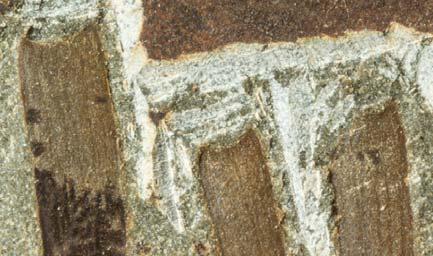


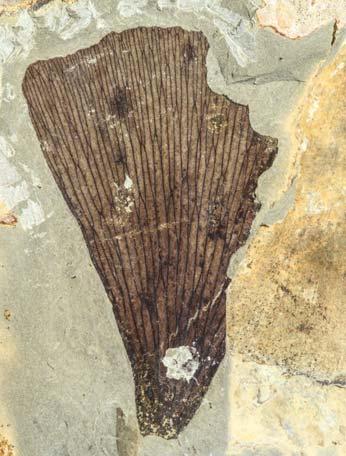

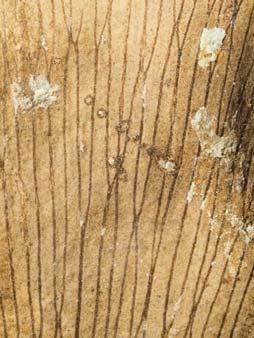
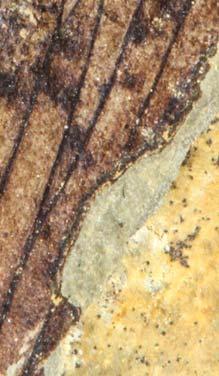
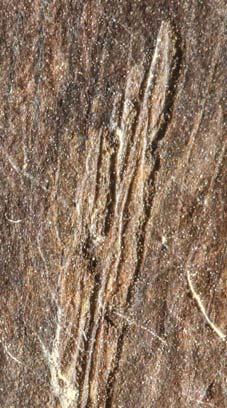
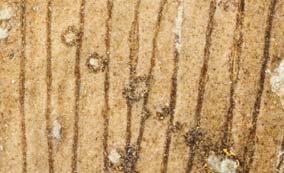
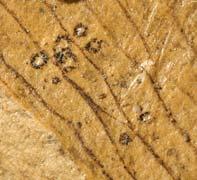

COLOUR PLATES 150 ISSN 2410-4418 Palaeont. afr. (2023) 57 (Special Issue): i–xiv + 1–324
×2
Cyp 111
×10
Cyp 111 ×5
×10
Lut 311 ×5
×10
×10
Pen 411
×20 ×10
×10 ×10 Kom 111
Hla 213
leaf-margin feeding leaf mining piercing & sucking leaf-tip feeding oviposition 11 10 9 8 7 6 5 4 3 2 1 12 cm 0
Aas 411
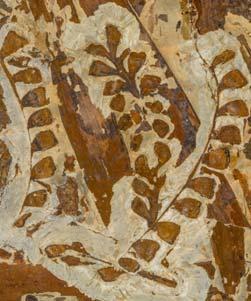
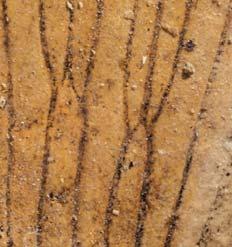



Of the 100 Molteno assemblages (TCs) sampled, 26 have yielded specimens of the Kannaskoppia family.
All 26 TCs have yielded foliage; 12 TCs, close on half, have yielded male strobili, whilst just a single TC (Kan 111) has yielded female strobili. –

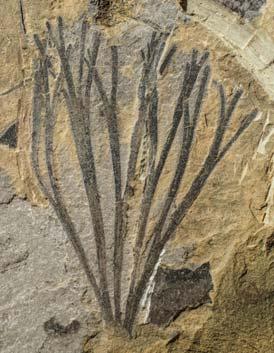
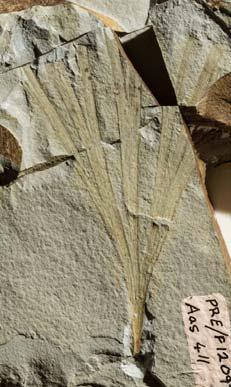
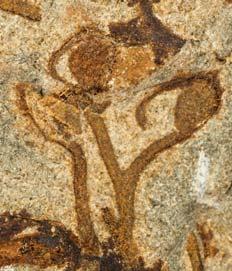
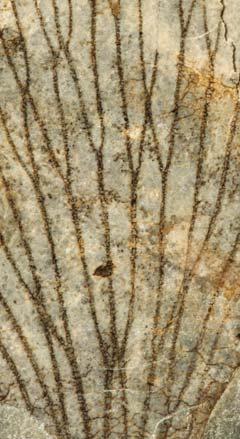

COLOUR PLATES 151 ISSN 2410-4418 Palaeont. afr. (2023) 57 (Special Issue): i–xiv + 1–324 TCs Locality Assemblages (taphocoenosis) Members man-hours cleaving Kannaskoppia Kannaskoppianthus Rochipteris attached organs plate numbers (1st pl. of TC) ♀ ♂ () 1Cala RoadCal 211Hei elo T 5 2–– 5 1 2GreenvaleGre 121Hei elo Qiba 4 10–222 3 3“ “ 111Equ sp 25––1 7 4Boesmanshoek PassBoe 112Dic cor 6––1 8 5CyphergatCyp 111Dic cra 100––83 () 9 6KannaskopKan 112Hei elo Mayaputi 3 15–519 ♂ 19 7“ “ 111Ast spA 3050– 5 () ♀ 23 8Telemachus SpruitTel 111Hei elo 90–433 () 41 9KommandantskopKom 111Sph/Dic 10–230 () ♂ 47 10VineyardVin 111Dic odo 10––2 51 11LutherskopLut 311Hei elo 50–1666 53 12KoningskroonKon 211Ast 2spp Indwe f 393––4 69 13PeninsulaPen 311Hei elo 35––41 73 14“ “ 411 “ “ 70–480 79 15KapokkraalKap 111Dic/Ris e 65––6 89 16NuwejaarspruitNuw 111Dic zub d 2 21––1 91 17WinnaarspruitWin 111Hei elo 20––4 92 18HlatimbeHla 213Dic elo b 60––7 94 19UmkomaasUmk 111Dic 2spp 400––50 97 20Sani PassSan 111Dic cra 30––3 111 21MatatieleMat 111Dic dub 65–3 2 113 22Little SwitzerlandLit 111Dic/Hei a 550–956 119 23AasvoëlbergAas 111Hei elo Bamboesberg 1 40–21 2 125 24“ “ 211Hei elo 35–119 143 25“ “ 311Hei elo 140–426 145 26“ “ 411Dic/Sph 512–21150 153 Total TCs 26 11226 Total individuals 5092 %
of
TABLE
CONTENTS
Mat 111
Tell 111
Kom 111
Lut 311
Aas 111
Aas 411
×5
Kan 111
×1 ×10 ×2
×1
Kan 112 ×2
×5 ×5
Tsomo Total: 162 plates
Mat 111
×1 T:
female strobili ♀ (1 TC) 5 – % of assemblage (TC) – male strobili ♂ (12 TCs) 4 – indivs in assemblage (TC) – foliage () (26 TCs)
×1
11 10 9 8 7 4 6 5 3 2 1 12 cm 0
Cyp 111
×5
Cyp 111

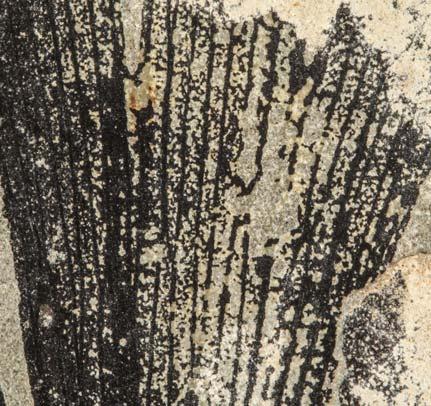





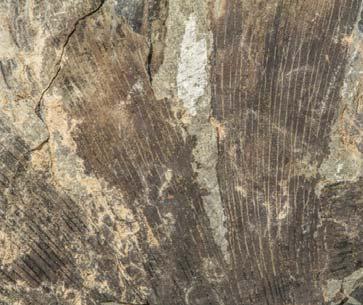

COLOUR PLATES 152 ISSN 2410-4418 Palaeont. afr. (2023) 57 (Special Issue): i–xiv + 1–324 12 cm 0 Cala Road (Cal 211) ×1 ×5 ×1 ×5
PRE/F/9302
PRE/F/9302
PRE/F/9386
×2
PRE/F/9386
vincularis Cal 211 Hei elo Plate 1 1 2 3 5 6
PRE/F/9401 Rochipteris
×1
7 ×2
PRE/F/9390
8 ×5 9
4 ×5
PRE/F/9390
PRE/F/9390
PRE/F/9401

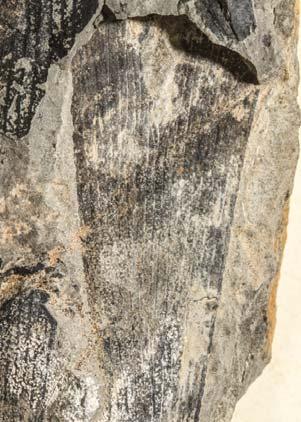


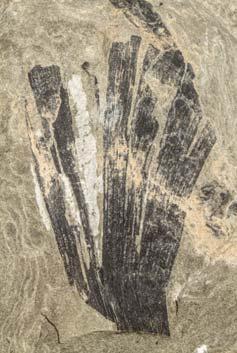

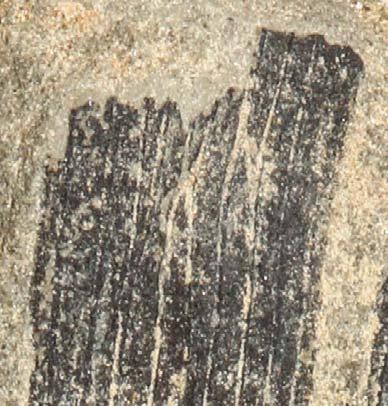
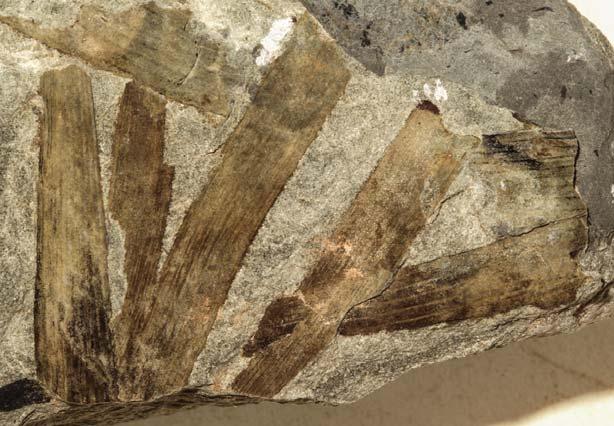

12 cm 0 COLOUR PLATES 153 ISSN 2410-4418 Palaeont. afr. (2023) 57 (Special Issue): i–xiv + 1–324 12 cm 0 Cala Road (Cal 211)
PRE/F/9404
PRE/F/9404
PRE/F/9405
PRE/F/9405
×1 ×2 ×5 ×5
Rochipteris vincularis
Plate 2 5 6 8 9
Cal 211 Hei elo
PRE/F/9404
7
×10
PRE/F/9402
PRE/F/9402
×1 ×2
1 2 3 ×10 4
PRE/F/9402
×5



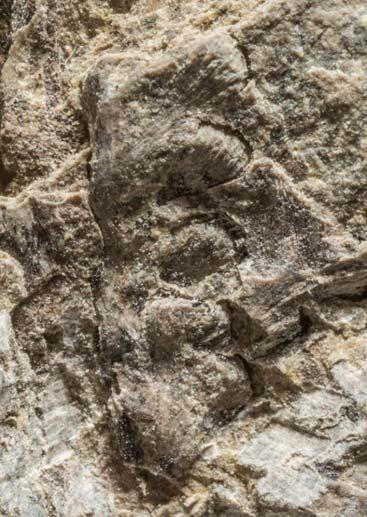
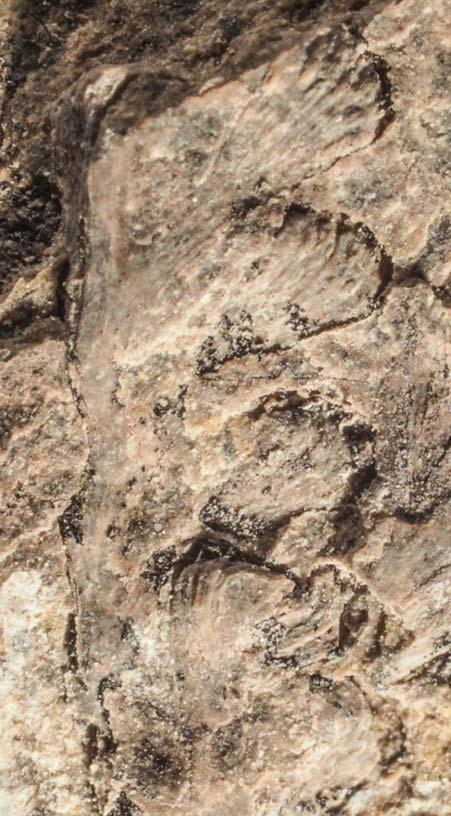


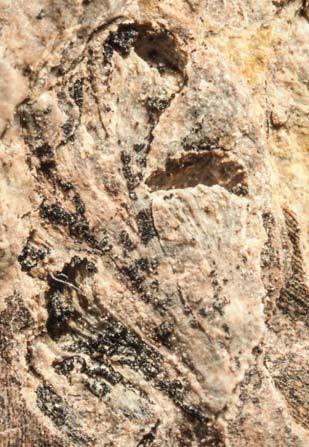
COLOUR PLATES 154 ISSN 2410-4418 Palaeont. afr. (2023) 57 (Special Issue): i–xiv + 1–324 Greenvale (Gre 121)
Kannaskoppianthus aasvoelensis
Gre 121 Hei elo
7
PRE/F/7845 ×10
PRE/F/7845
8
×20
PRE/F/7856a
×10
PRE/F/7856a
5 2
×10
PRE/F/7856a
3 Plate 3 12 cm 0
×20
6
×20
1
4
PRE/F/7856a
×5
×5



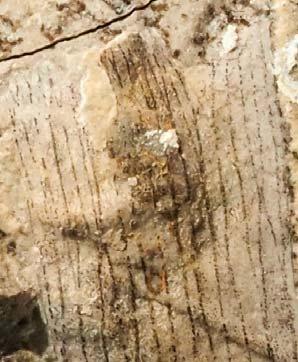
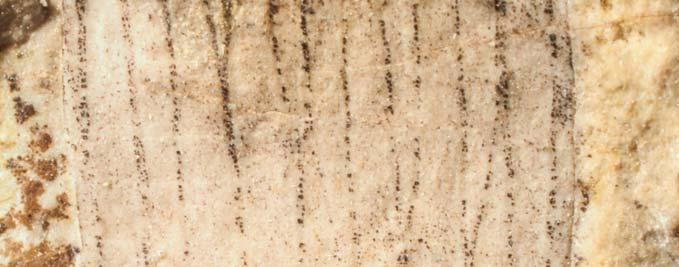
12 cm 0 COLOUR PLATES 155 ISSN 2410-4418 Palaeont. afr. (2023) 57 (Special Issue): i–xiv + 1–324 Plate 4
×10
2
PRE/F/7837b
PRE/F/7837b
1
×2
×20
5
PRE/F/7837b
Rochipteris rollerii
4
PRE/F/7837b
Greenvale (Gre 121)
Gre 121 Hei elo
×10
3
PRE/F/7837b
×5

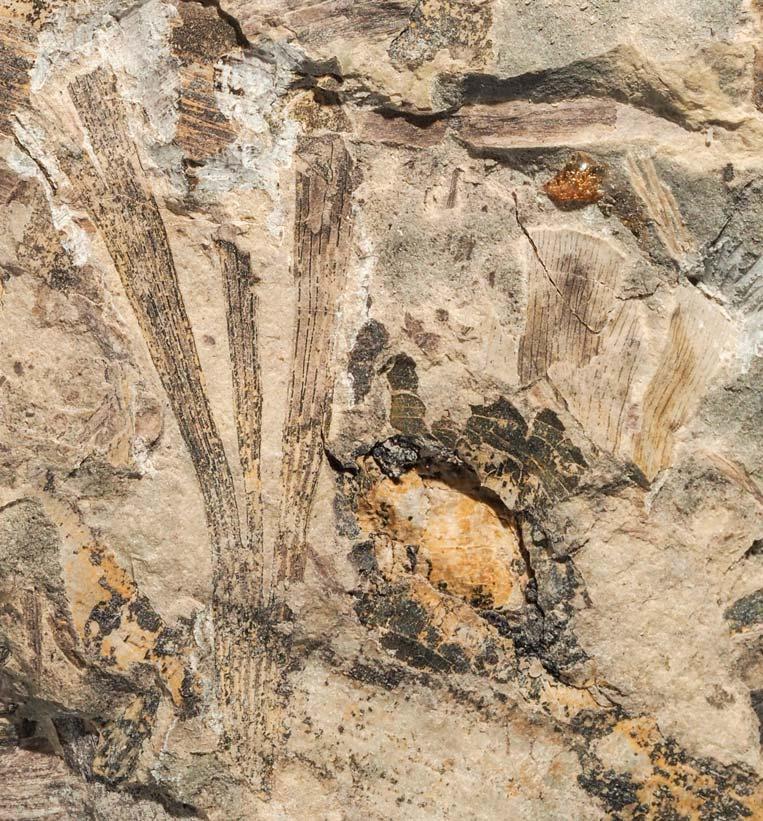

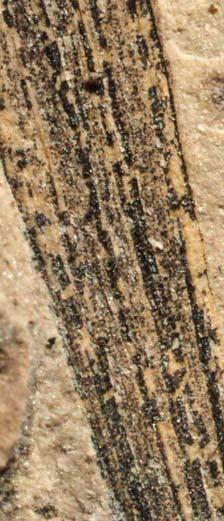
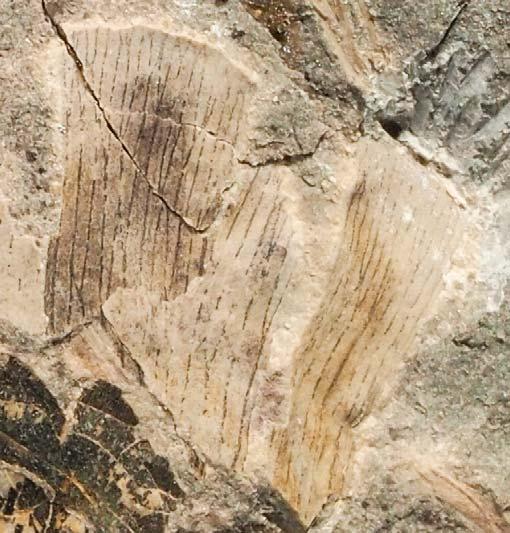
COLOUR PLATES 156 ISSN 2410-4418 Palaeont. afr. (2023) 57 (Special Issue): i–xiv + 1–324
PRE/F/7839,‘x’,‘y’
Greenvale (Gre 121)
×5
PRE/F/7839,‘x’ ×10
1
PRE/F/7839,‘x’,‘y’ ×2
Rochipteris rollerii
Plate 5
Gre 121 Hei elo
2 4 3 12
0
5
PRE/F/7839,‘y’ ×10
cm
×20
‘y’
‘x’ ‘y’
‘x’ ‘y’ ‘x’
Rochipteris rollerii

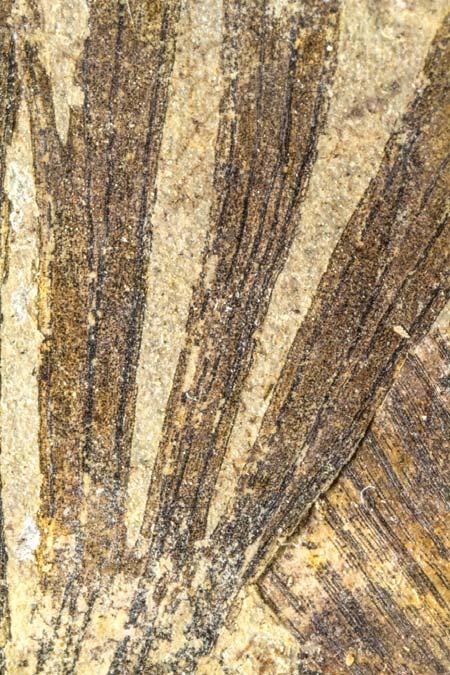


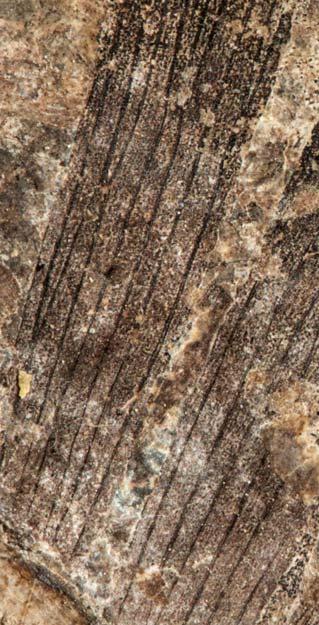
12 cm 0 COLOUR PLATES 157 ISSN 2410-4418 Palaeont. afr. (2023) 57 (Special Issue): i–xiv + 1–324 Greenvale (Gre 121)
PRE/F/7841
1
×2
×10
2
PRE/F/7841
PRE/F/7840
3
×2
4
PRE/F/7840 ×5
Gre 121 Hei elo
PRE/F/7840
5 Plate 6
×10
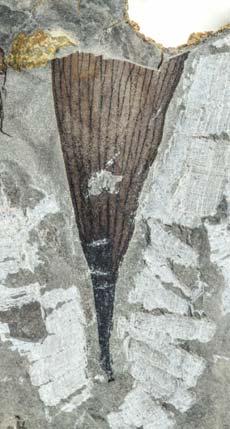



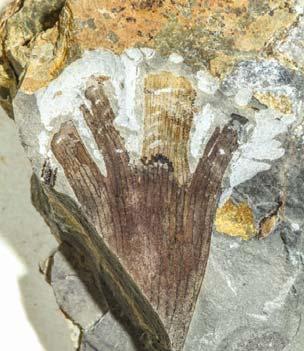


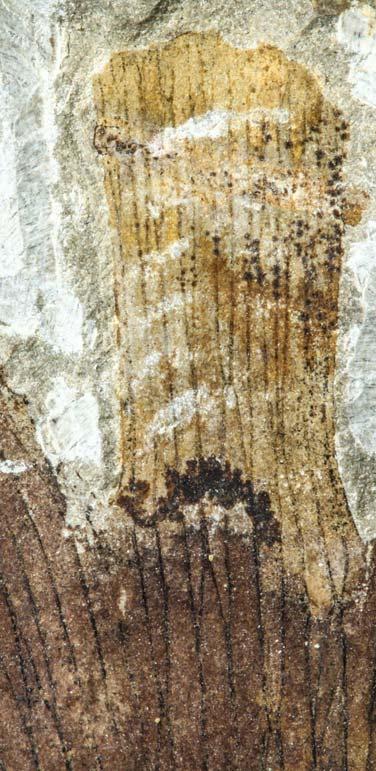
COLOUR PLATES 158 ISSN 2410-4418 Palaeont. afr. (2023) 57 (Special Issue): i–xiv + 1–324 Greenvale (Gre 111) Plate 7
Rochipteris sp. indet.
PRE/F/16568a ×2
×10
1 4
PRE/F/16568a
3
PRE/F/16568b ×2
×5
5
111 Equ
PRE/F/16568b
Gre
sp
PRE/F/16568b
7
0
×10
12 cm
×2
* PRE/F/16568b PRE/F/16568a
2
* part & counterpart combined (PRE/F/16568a flipped to match)
PRE/F/16568b
6
×10
Rochipteris pusilla



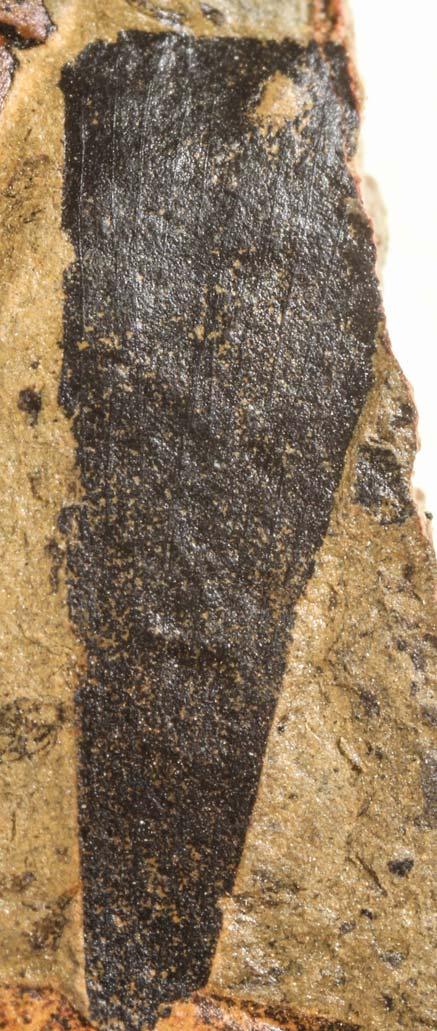
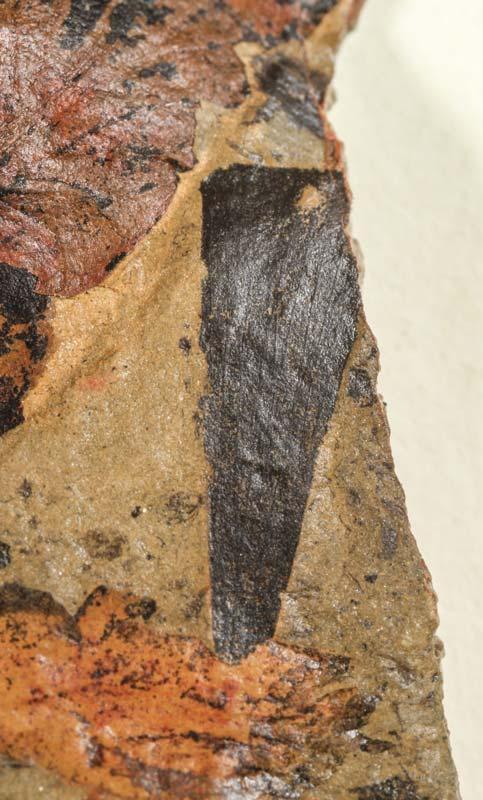

COLOUR PLATES 159 ISSN 2410-4418 Palaeont. afr. (2023) 57 (Special Issue): i–xiv + 1–324 12 cm 0 Boesmanshoek Pass (Boe 112)
Plate 8
Boe 112 Dic cor
×20
×10
×20
×5
PRE/F/2762
PRE/F/2762
3 4 5 6 1 ×1 ×2 2
PRE/F/2762
PRE/F/2762
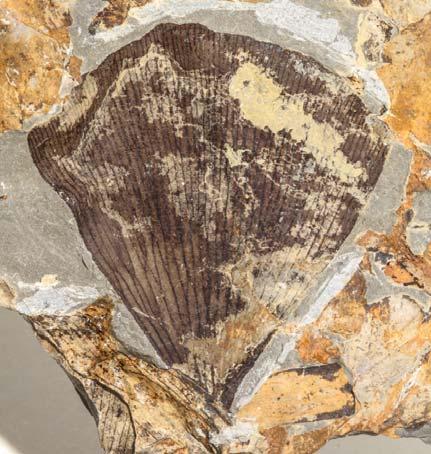
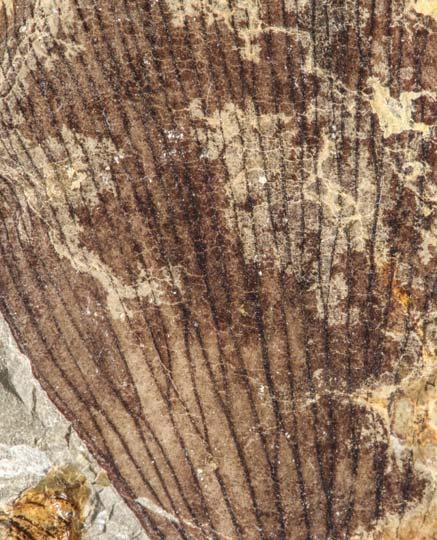

Rochipteris lutifolia

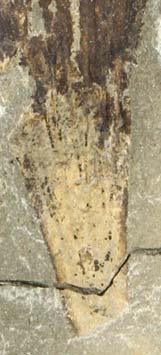



COLOUR PLATES 160 ISSN 2410-4418 Palaeont. afr. (2023) 57 (Special Issue): i–xiv + 1–324
Plate 9
Cyphergat (Cyp 111)
×2 PRE/F/18899a
PRE/F/18899a
×5
PRE/F/18899a ×5
×2 ×5
PRE/F/22843
PRE/F/22843
Cyp 111 Dic cra
1 2 4 6 7 8 12 cm 0 ×1 3 ×5 5
PRE/F/18899a
×10
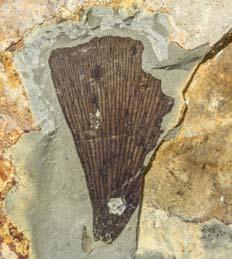

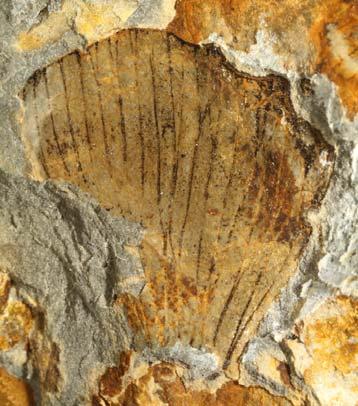
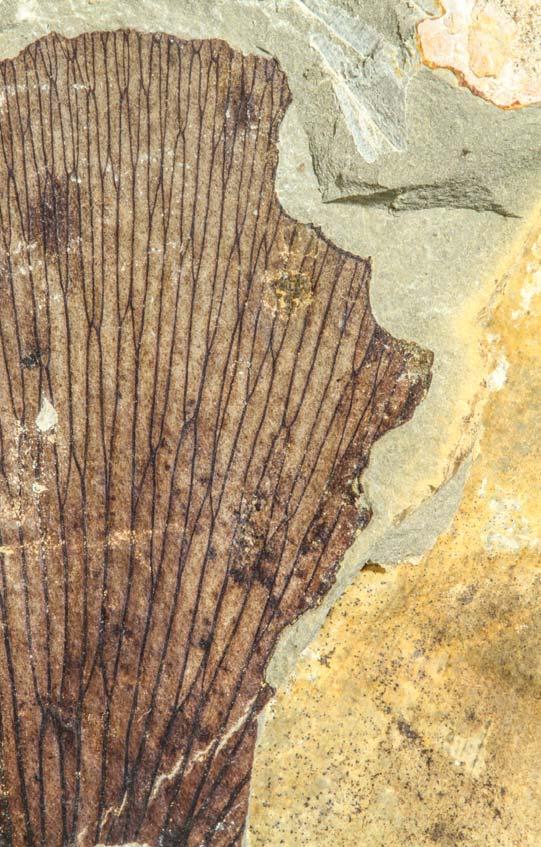
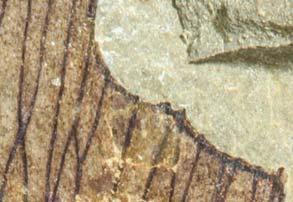
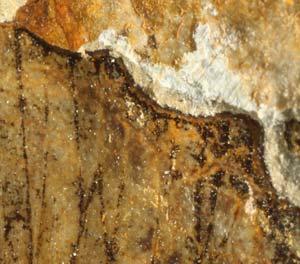


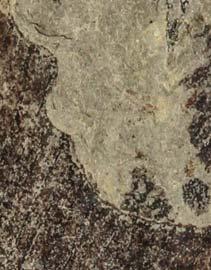
12 cm 0 COLOUR PLATES 161 ISSN 2410-4418 Palaeont. afr. (2023) 57 (Special Issue): i–xiv + 1–324 ×2 ×5 ×1 Cyphergat (Cyp 111)
PRE/F/22803
PRE/F/22863
PRE/F/22863
PRE/F/22863 ×2
Rochipteris lutifolia
Cyp 111 Dic cra
1 2 5 8 9 Plate 10 ×5
×10
6 ×10 7
PRE/F/19745
3 ×10 4
PRE/F/19745
×5

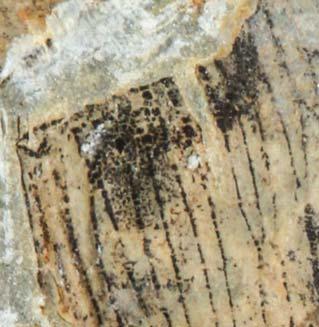
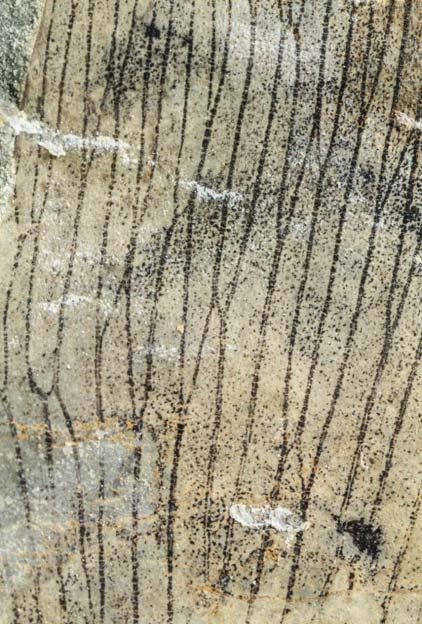


COLOUR PLATES 162 ISSN 2410-4418 Palaeont. afr. (2023) 57 (Special Issue): i–xiv + 1–324
Plate 11
Cyphergat (Cyp 111)
PRE/F/22847
PRE/F/22847
×2
×10
PRE/F/22847
×5
Rochipteris lutifolia
PRE/F/22847 1 2 3 4 5
×10 ×10 PRE/F/22847
1 2 cm 0
Cyp 111 Dic cra

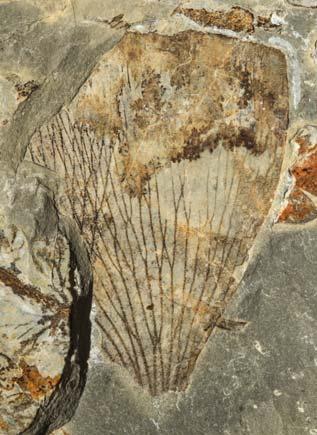

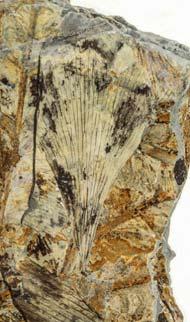
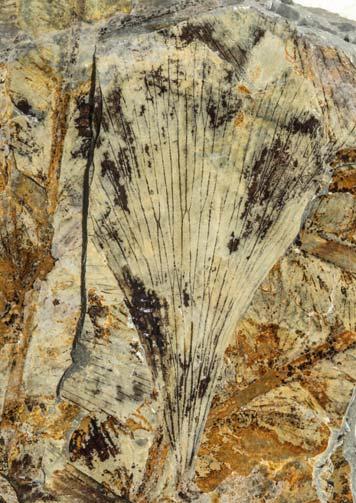
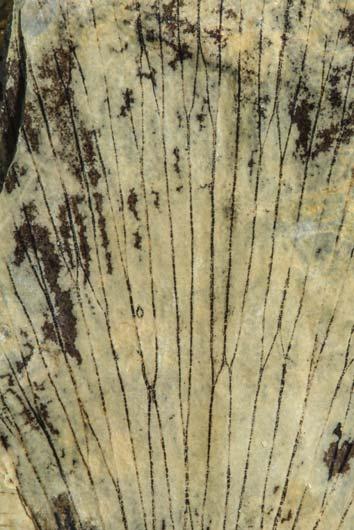

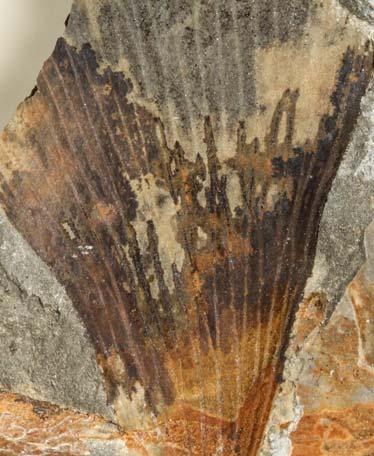

COLOUR PLATES 163 ISSN 2410-4418 Palaeont. afr. (2023) 57 (Special Issue): i–xiv + 1–324 12 cm 0 Cyphergat (Cyp 111) ×5
Cyp 111 Dic cra
Plate 12 ×2 ×1 4 5 6
Rochipteris lutifolia
×2
8 ×5 9
PRE/F/22876
PRE/F/22876
PRE/F/18893a
PRE/F/18893a
×2
2 3
×5
×1
1
PRE/F22846
7
×10
PRE/F22846
PRE/F22846

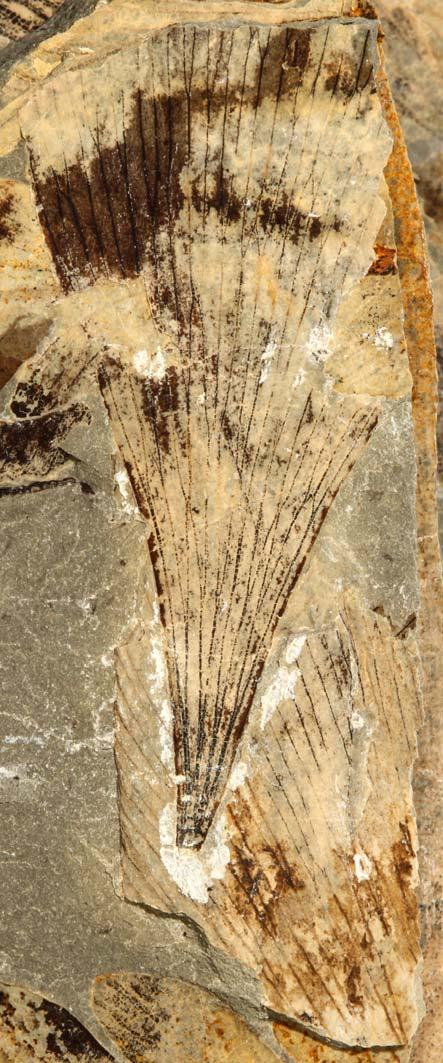

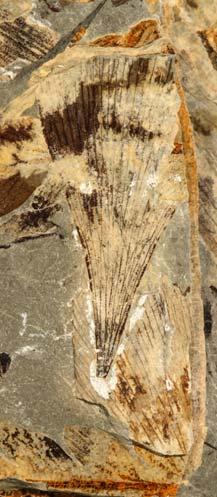



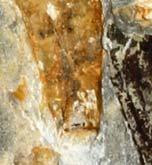

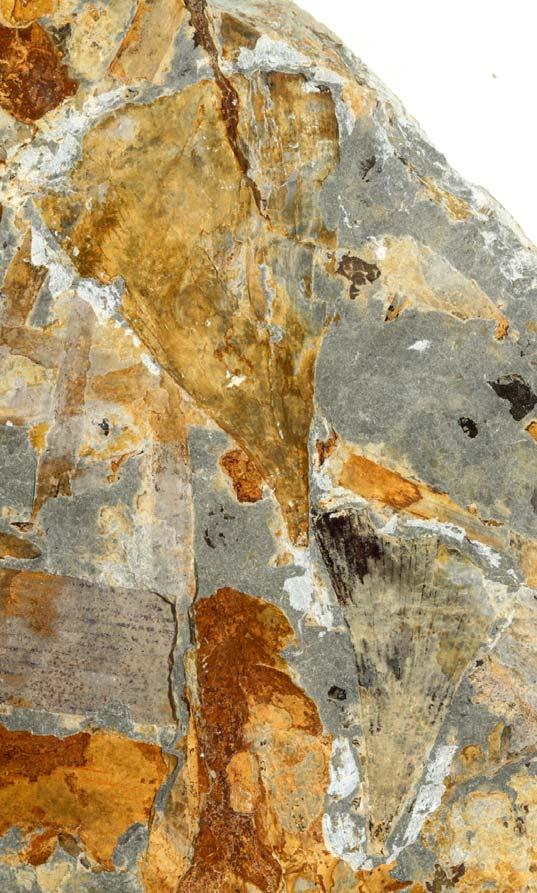
COLOUR PLATES 164 ISSN 2410-4418 Palaeont. afr. (2023) 57 (Special Issue): i–xiv + 1–324
(Cyp
Plate 13
Cyphergat
111)
Cyp 111 Dic cra
10
PRE/F/22857,‘y’
Rochipteris lutifolia
2 ×5 ×2 PRE/F/2485 4
1 6 7
PRE/F/22870 ×2
×1 ×2
×5 ×5 ×10 ×5 8 9 3 12 cm 0 ×5 5
PRE/F/22870
PRE/F/22857,‘x’,‘y’
PRE/F/22857,‘x’,‘y’
‘x’ ‘y’
‘x’ ‘y’
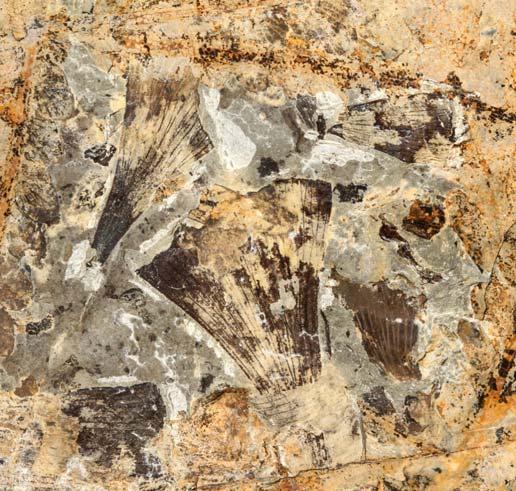

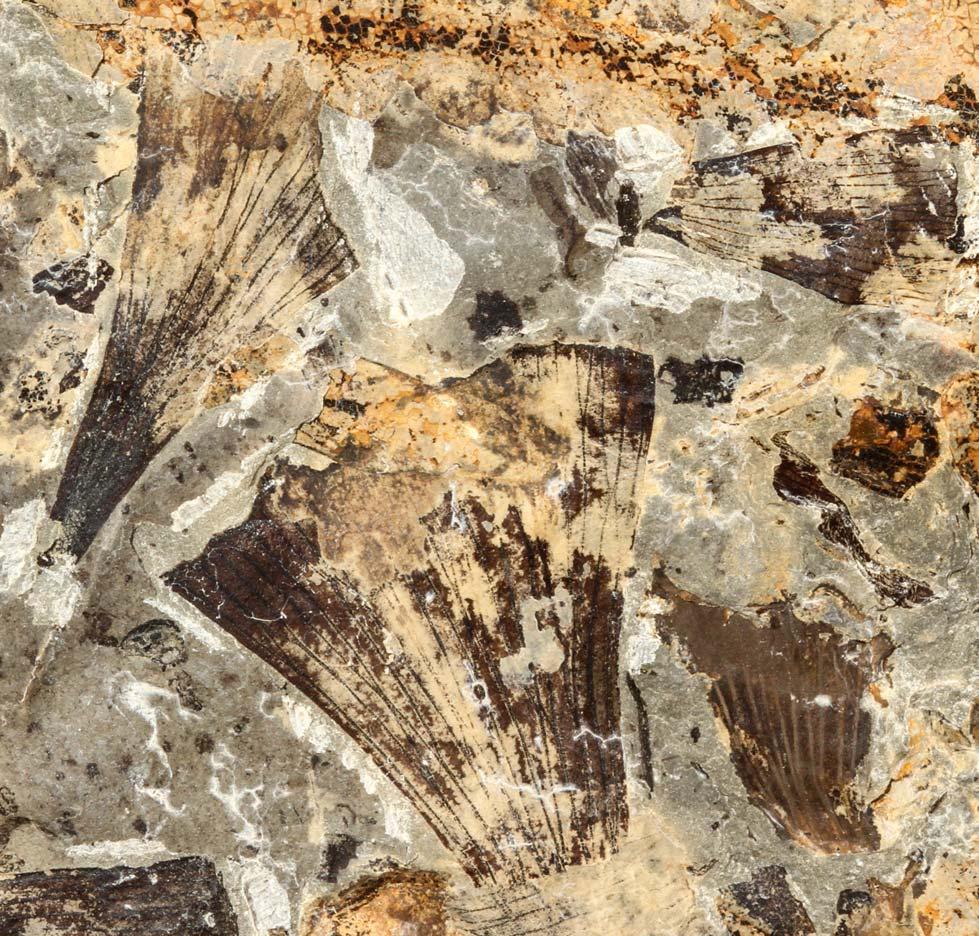

COLOUR PLATES 165 ISSN 2410-4418 Palaeont. afr. (2023) 57 (Special Issue): i–xiv + 1–324
12 cm 0 ×2
Rochipteris lutifolia
1 ×5 ×10 ×10
PRE/F/22873
2 3 4 Cyphergat (Cyp 111)
PRE/F/22873
Plate 14
Cyp 111 Dic cra
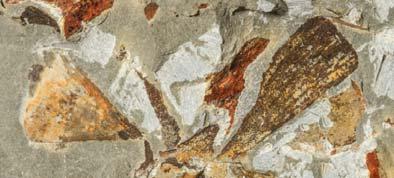
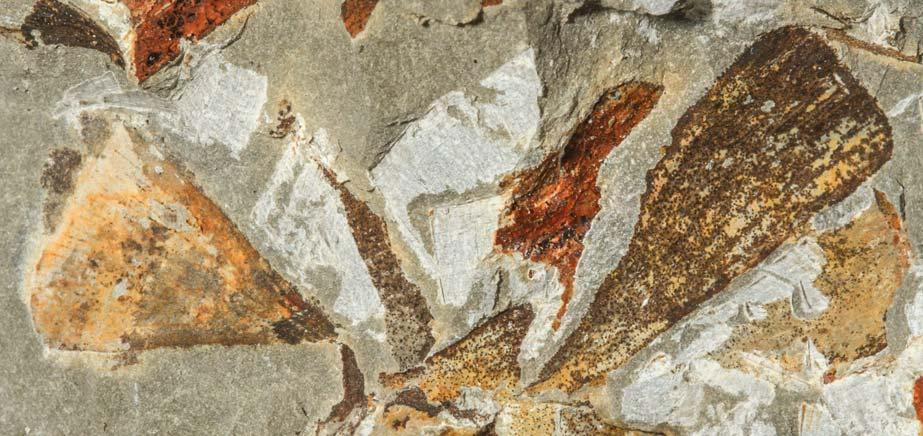


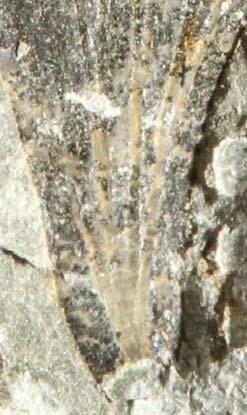

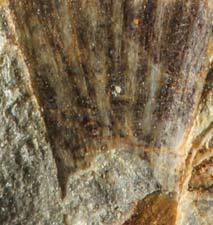

COLOUR PLATES 166 ISSN 2410-4418 Palaeont. afr. (2023) 57 (Special Issue): i–xiv + 1–324 Cyphergat (Cyp 111)
PRE/F/18897 ‘x’
PRE/F/18897 ‘y’
×5
×5
Plate 15
Cyp 111 Dic cra
Rochipteris lutifolia
4 5 7
PRE/F/18897 ‘x’
×1
PRE/F/19751 1
×2
12 cm 0 2 3
PRE/F/18897 ‘x’,‘y’
PRE/F/19751
×10 8 6 ×10
×5
×2
‘x’ ‘y’
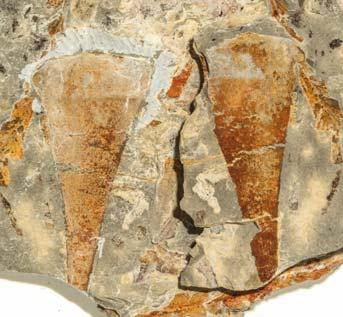


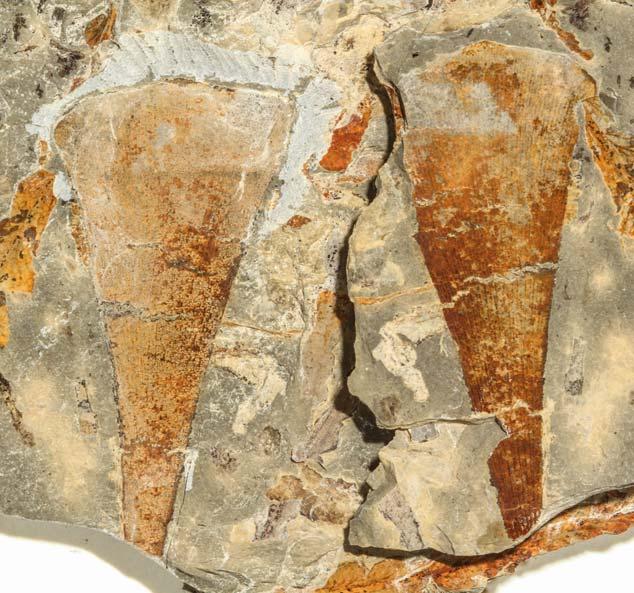


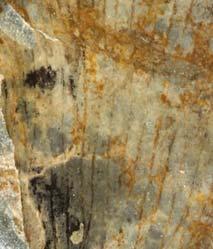


COLOUR PLATES 167 ISSN 2410-4418 Palaeont. afr. (2023) 57 (Special Issue): i–xiv + 1–324 Cyphergat (Cyp 111) Plate 16
3
PRE/F/19747b ×2
Rochipteris lutifolia
×2
PRE/F/22849b,‘x’,‘y’
×5
2 4
PRE/F/19747b
×2
1
PRE/F/18896a,b ×1
×1 5 6 8
×2
Cyp 111 Dic cra
×5 7
PRE/F/18896a,b
12 cm 0 ×5 9 a b b a
PRE/F/22849a,‘x’,‘y’
‘x’
‘y’ ‘y’ ‘x’
‘y’ ‘x’
‘y’ ‘x’
‘y’ ‘y’
‘x’
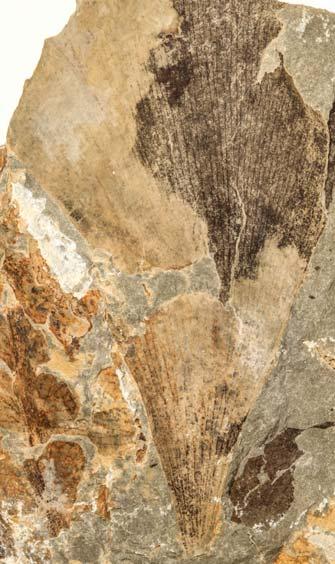




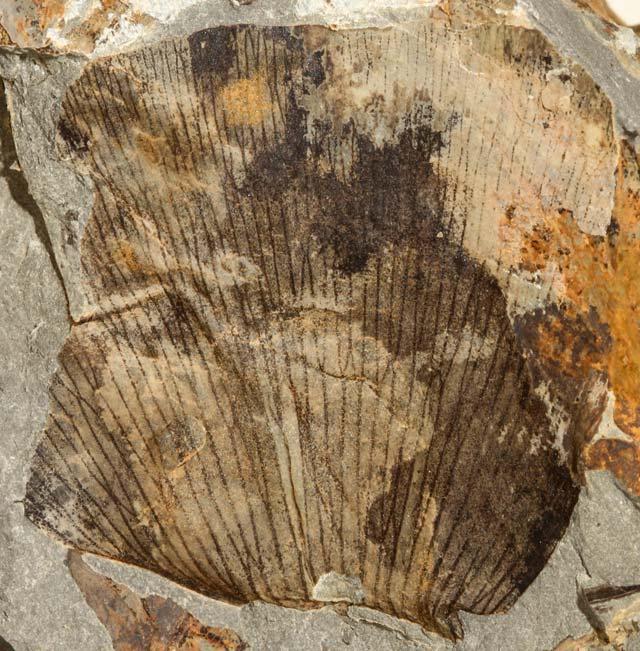
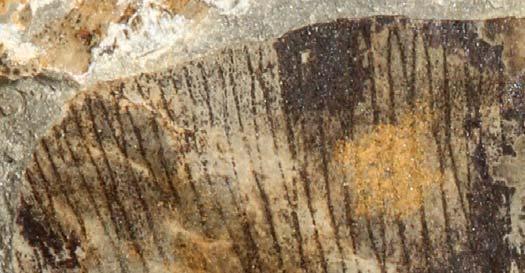
COLOUR PLATES 168 ISSN 2410-4418 Palaeont. afr. (2023) 57 (Special Issue): i–xiv + 1–324
Cyphergat (Cyp 111)
×5
×5
PRE/F/22878
PRE/F/22878
PRE/F/22878
Rochipteris lutifolia
17 1 4 2
Cyp 111 Dic cra Plate
×2
×5
PRE/F/22877
0
12 cm
×2
5
PRE/F/22877
×10
6 7
PRE/F/22877
3 ×10
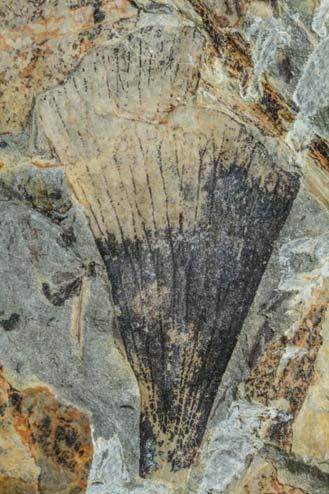
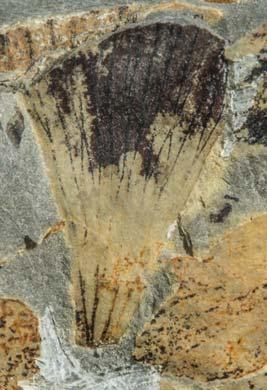




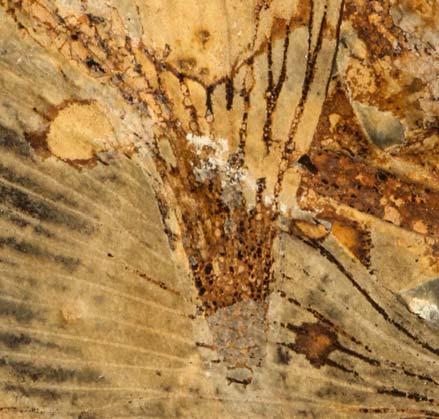
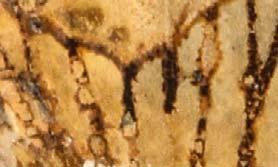
COLOUR PLATES 169 ISSN 2410-4418 Palaeont. afr. (2023) 57 (Special Issue): i–xiv + 1–324
×5
5
PRE/F/22850‘y’
12 cm 0 Cyphergat (Cyp 111)
Rochipteris lutifolia
×5
Plate 18
PRE/F/22850‘x’
1 ×2 6 ×5 7
Cyp 111 Dic cra
8
×10
2
×10
4 3
PRE/F/22850‘x’
×20 ×20
PRE/F/22806


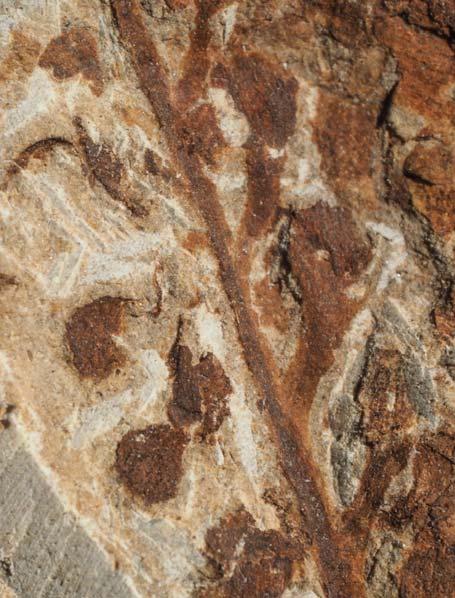

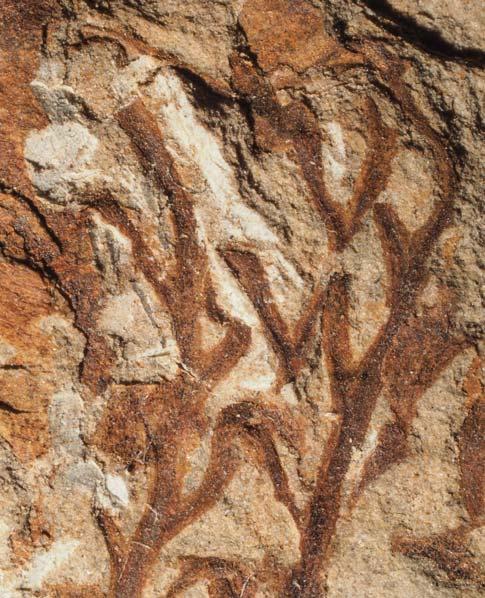
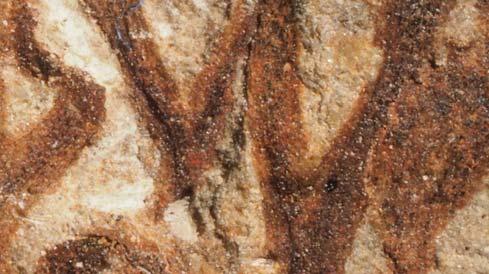
COLOUR PLATES 170 ISSN 2410-4418 Palaeont. afr. (2023) 57 (Special Issue): i–xiv + 1–324 12 cm 0 Kannaskop
(Kan 112)
PRE/F 20114b
×1
×5
×10
PRE/F 20114b
PRE/F 20114b
PRE/F 20114b
irregularis 3 1 4 5
×10
Kannaskoppianthus
Kan 112 Hei elo ×2
2 Plate 19
PRE/F 20114b
×20
6
PRE/F 20114b
Reference palaeodeme (pls 19–20)
Holotype
Kannaskoppianthus irregularis
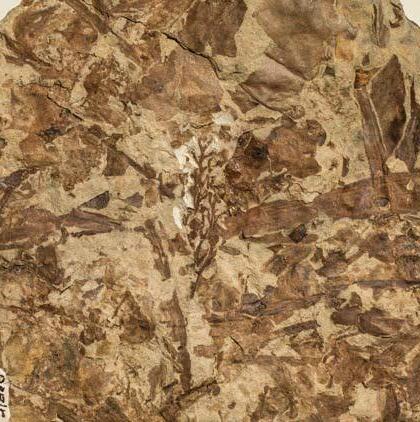
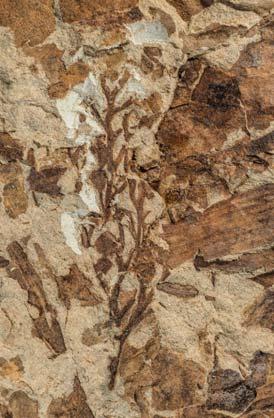
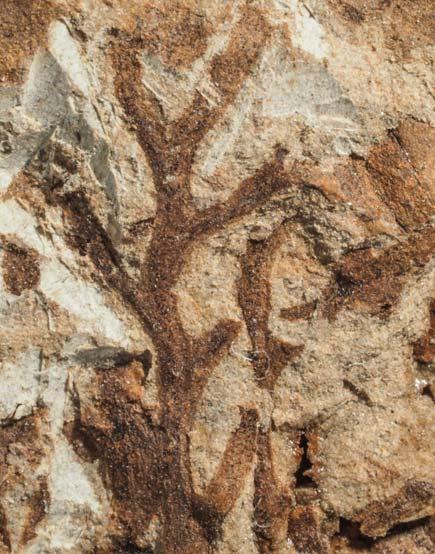
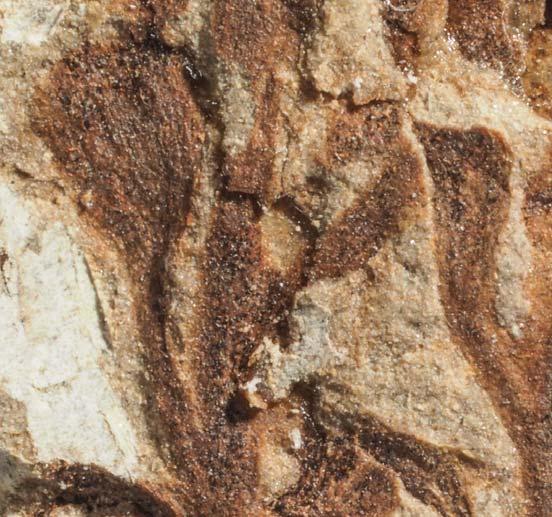


COLOUR PLATES 171 ISSN 2410-4418 Palaeont. afr. (2023) 57 (Special Issue): i–xiv + 1–324 Kannaskop (Kan 112) Plate 20
×10
PRE/F 20114a
×2
2 5
PRE/F 20114a
PRE/F 20114a
1
×1
Kan 112 Hei elo
×10
4
PRE/F 20114a
×20
6
PRE/F 20114a
×5
3 12 cm 0
PRE/F 20114a
Holotype


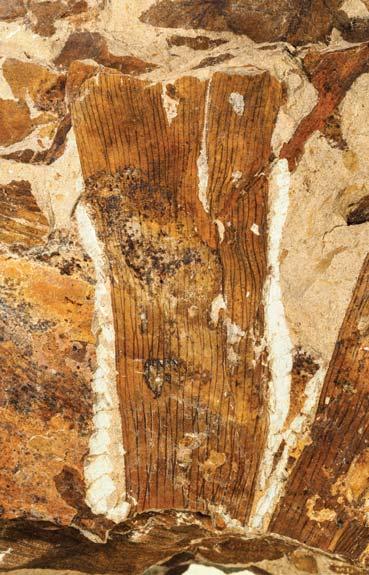
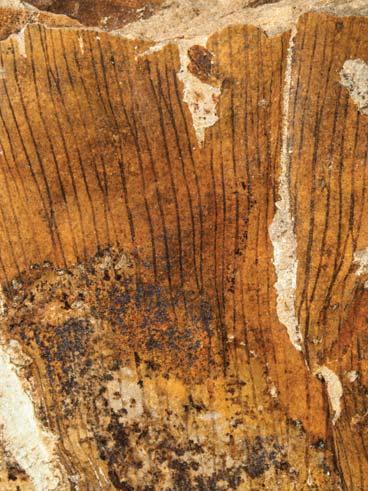





COLOUR PLATES 172 ISSN 2410-4418 Palaeont. afr. (2023) 57 (Special Issue): i–xiv + 1–324 12 cm 0 Kannaskop (Kan 112) Plate 21
PRE/F/20120
PRE/F/20120
PRE/F/20120 ×2 ×5
Rochipteris distivena 3 4 5
×10
Kan 112 Hei elo
PRE/F/20120
1
×1
2
×1
PRE/F/20120
BP/2/3386
×1
×5 BP/2/3386
Holotype
8 7 6
Reference palaeodeme (pls 21–22)
×1
Rochipteris distivena
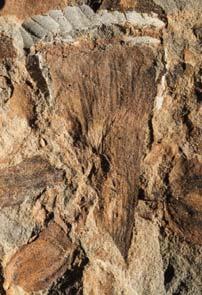
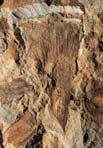

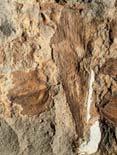
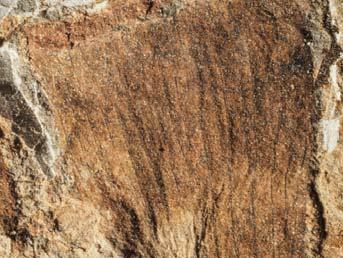
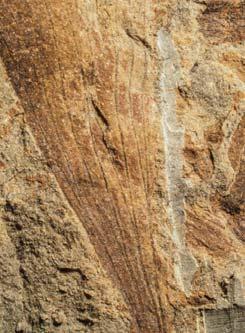
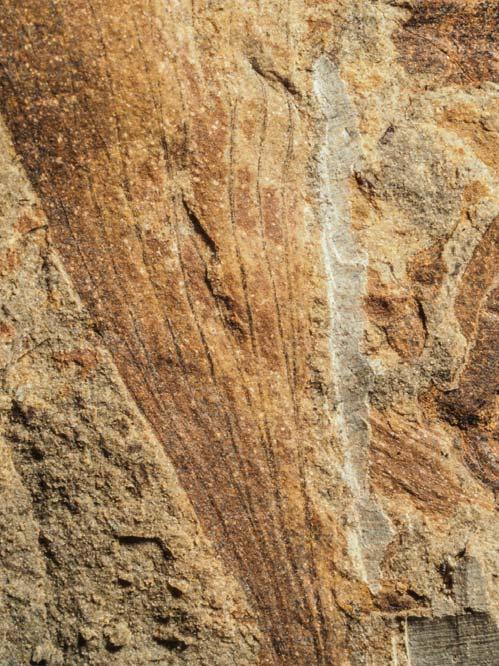

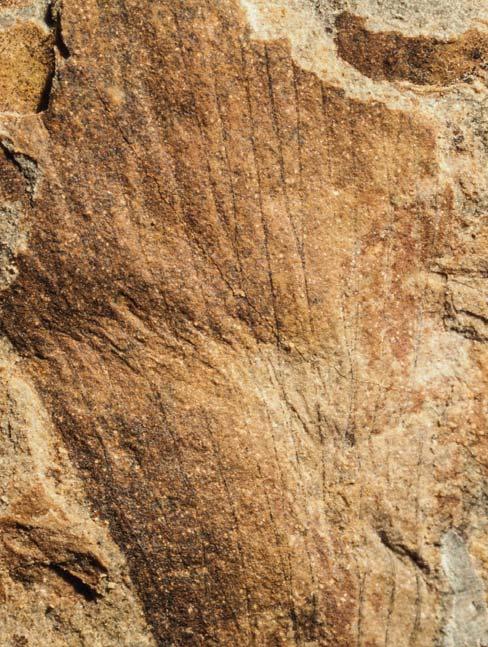
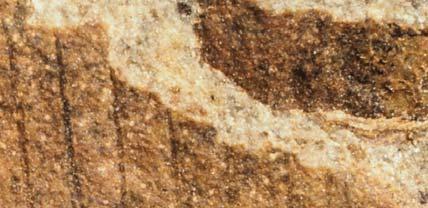
COLOUR PLATES 173 ISSN 2410-4418 Palaeont. afr. (2023) 57 (Special Issue): i–xiv + 1–324 Kannaskop (Kan 112)
PRE/F/20118b
2 3
PRE/F/20118b ×2 ×5
PRE/F/20118a
6
PRE/F/20118a ×2 ×5
PRE/F/20118a
9 7
×10
Kan 112 Hei elo
PRE/F/20118b
4
×10
PRE/F/20118a
8 Plate 22 12 cm 0 5
1
×10
×1 ×1
×20
10
PRE/F/20118a
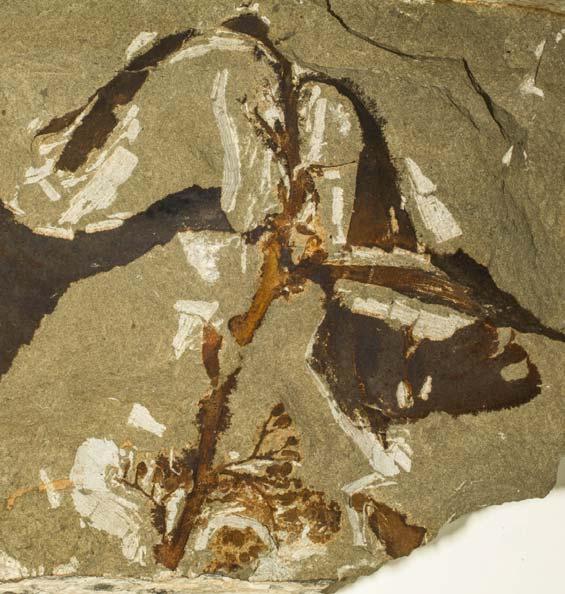


COLOUR PLATES 174 ISSN 2410-4418 Palaeont. afr. (2023) 57 (Special Issue): i–xiv + 1–324
Kan 111 Ast spA Plate 23 12 cm 0
Kannaskoppia vincularis / Rochipteris vincularis
PRE/F/13487a‘y’
×1
×2
1
PRE/F/13487a‘y’
2
×5
3
PRE/F/13487a‘y’
Holotype
Reference palaeodeme (pls 23–40)
Kannaskoppia vincularis / Rochipteris vincularis
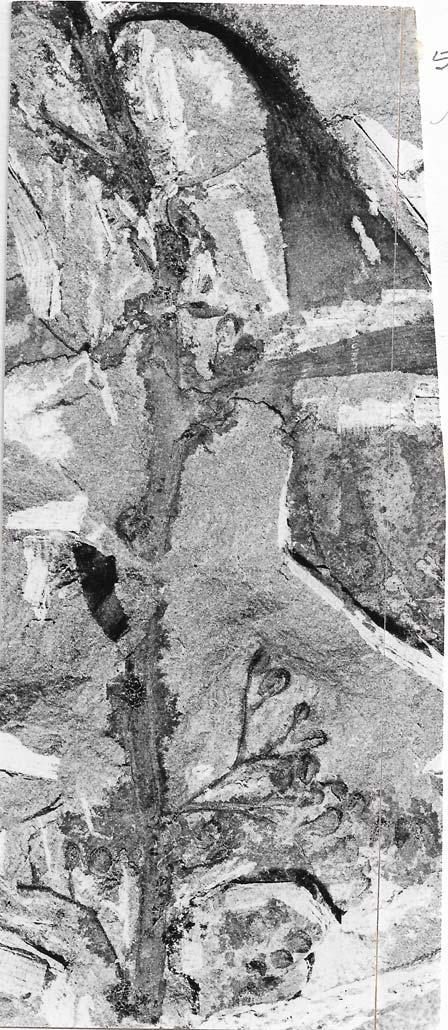
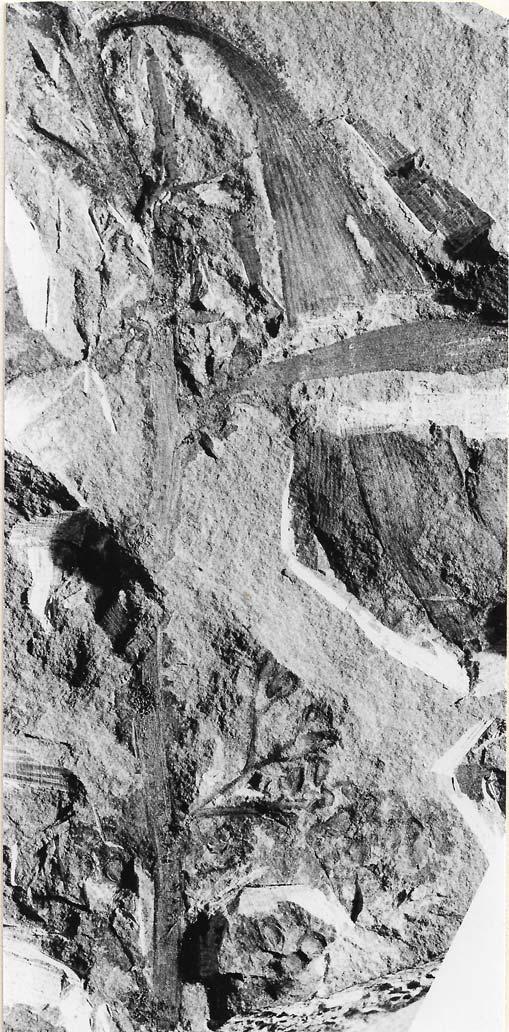
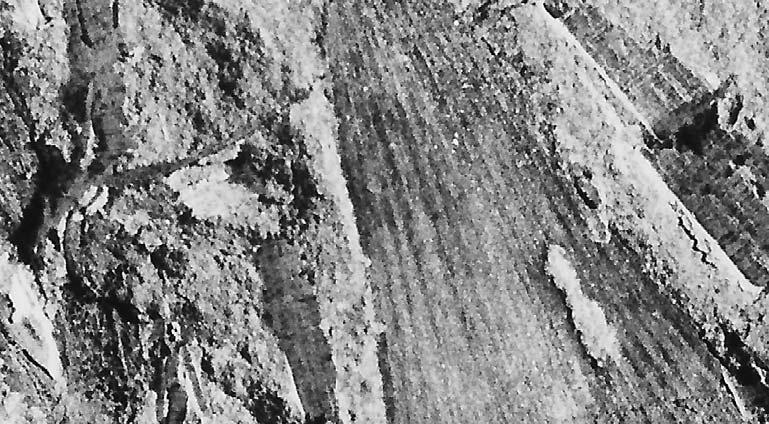
12 cm 0 COLOUR PLATES 175 ISSN 2410-4418 Palaeont. afr. (2023) 57 (Special Issue): i–xiv + 1–324
Kannaskop (Kan 111) Plate 24
Kan 111 Ast spA
PRE/F/13487a‘y’
×2 PRE/F/13487a‘y’
×2
2 1
3
×5
PRE/F/13487a‘y’
Holotype
Kannaskoppia vincularis / Rochipteris vincularis
×1


PRE/F/13487b‘x’

COLOUR PLATES 176 ISSN 2410-4418 Palaeont. afr. (2023) 57 (Special Issue): i–xiv + 1–324
PRE/F/13487b‘y’
1 4
PRE/F/13487b‘x’ ×2
3
Plate 25
Kan 111 Ast spA *
×2 1 2
×1
*
* * 1 2 2
flake removed from slab (see *1 & *2 for original fit)
flake (fig. 2 above) shown in place
PRE/F/13487b‘x’
12 cm 0
Fig. 1 shows the counterpart of the Holotype slab (pl. 23(1)); the specimen ‘y’ to the top left is a portion of the Holotype specimen.
Isotype
PRE/F/13487b‘y’
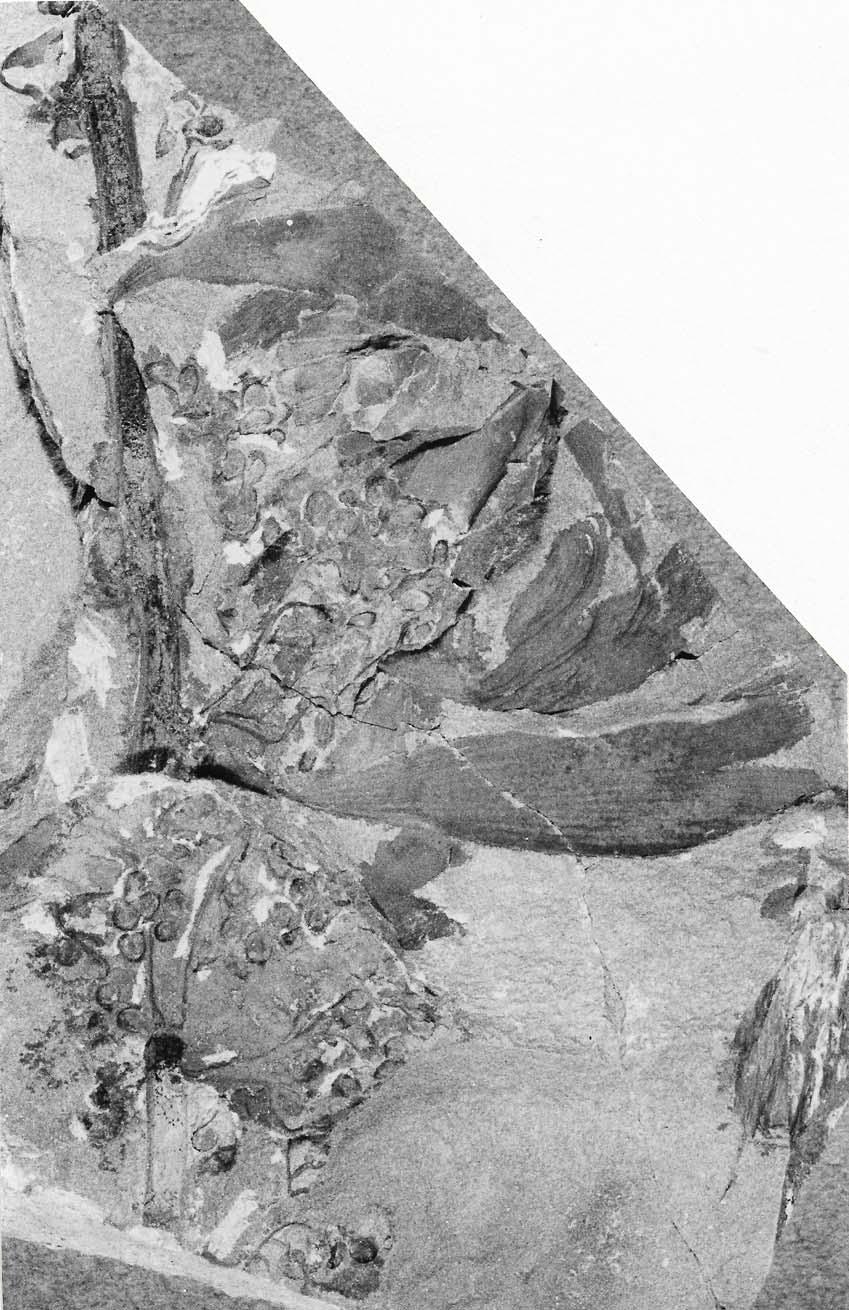
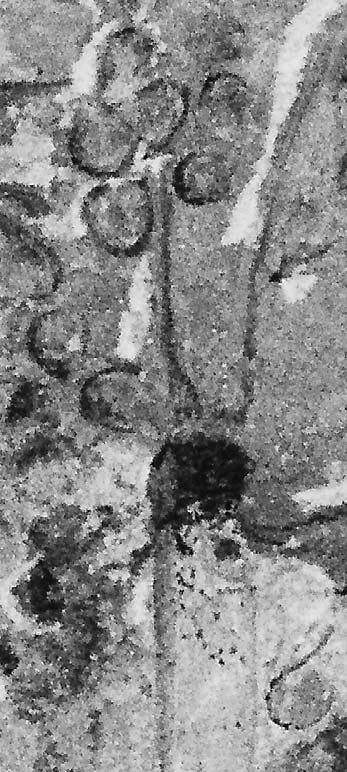

12 cm 0 COLOUR PLATES 177 ISSN 2410-4418 Palaeont. afr. (2023) 57 (Special Issue): i–xiv + 1–324
Kannaskop (Kan 111)
Kan 111 Ast spA
PRE/F/13487b‘x’
×2
2 3 1
×2
PRE/F/13487b‘x’
×5
Plate 26
Kannaskoppia vincularis / Rochipteris vincularis
slab with flake (pl. 25, fig. 2) removed
Isotype
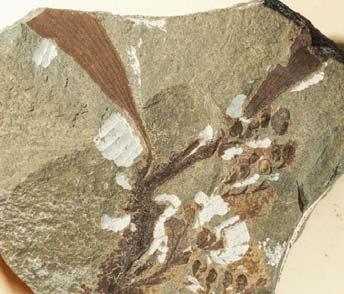
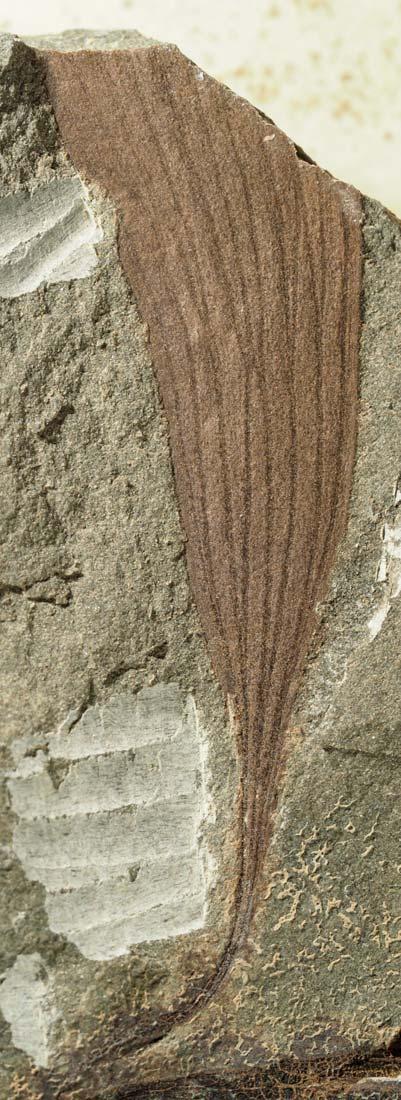



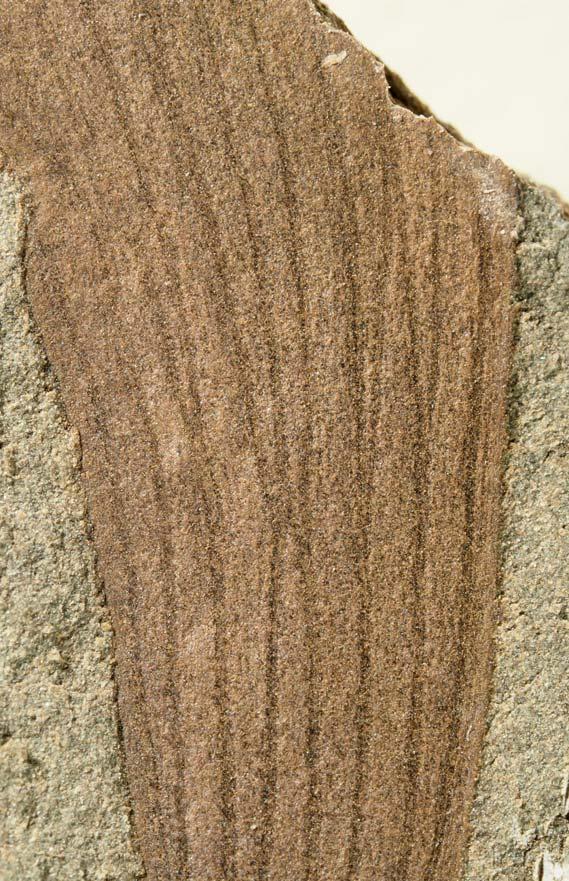
COLOUR PLATES 178 ISSN 2410-4418 Palaeont. afr. (2023) 57 (Special Issue): i–xiv + 1–324
Plate 27
Kannaskop (Kan 111)
PRE/F/13505a
×1
×10
Kannaskoppia vincularis / Rochipteris vincularis
×2
PRE/F/13505a
1 2
PRE/F/13505a
×5
5
PRE/F/13505a
0 4 6 ×5 3
Kan 111 Ast
spA
×5 12 cm
Kannaskoppia vincularis / Rochipteris vincularis
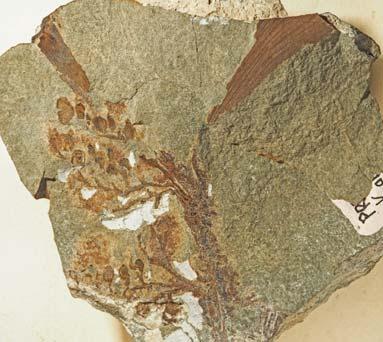
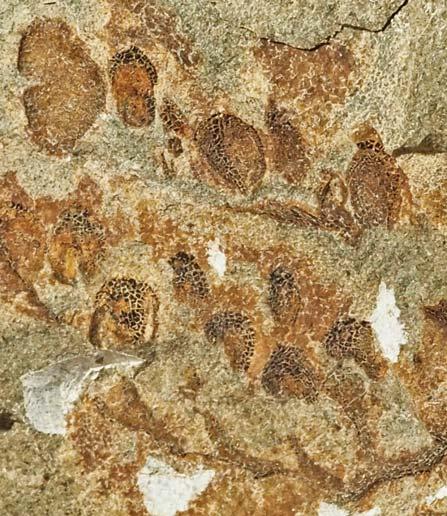

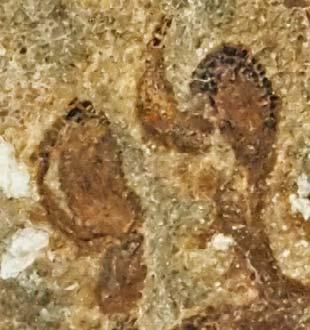

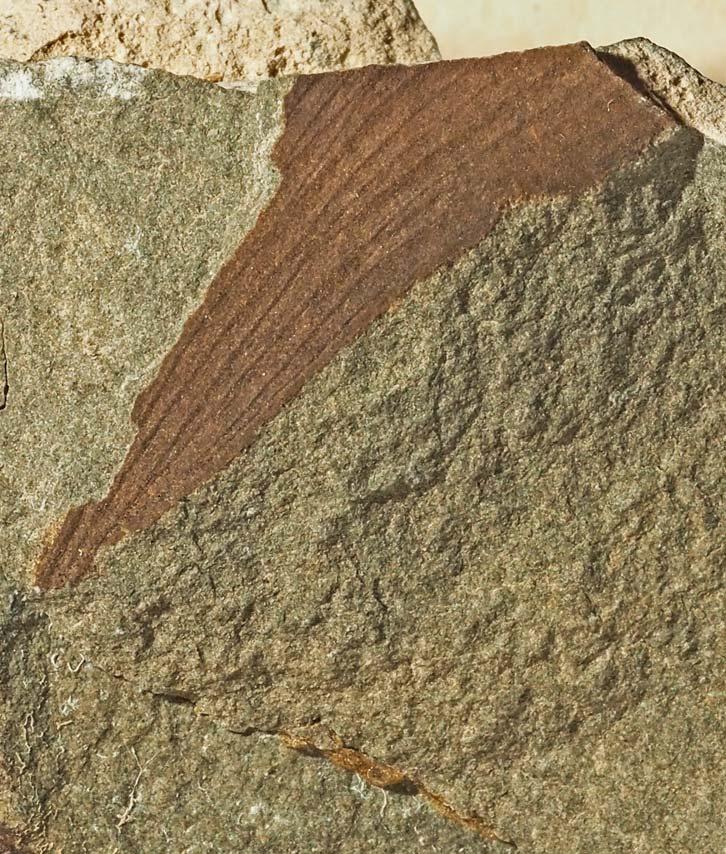

12 cm 0 COLOUR PLATES 179 ISSN 2410-4418 Palaeont. afr. (2023) 57 (Special Issue): i–xiv + 1–324 Kannaskop (Kan 111) Plate 28
1 2
PRE/F/13505b ×1 ×2
PRE/F/13505b
×5
×5 ×5
PRE/F/13505b
×10
×10
3 4 5 6 7
Kan
111 Ast spA
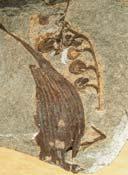
Kannaskoppia vincularis / Rochipteris vincularis



Kan 111 Ast spA



COLOUR PLATES 180 ISSN 2410-4418 Palaeont. afr. (2023) 57 (Special Issue): i–xiv + 1–324 Kannaskop (Kan 111) Plate 29
PRE/F/13489a
PRE/F/13489a
PRE/F/13489b
PRE/F/13489b
×2
PRE/F/13489b
×5
×10
×5
×10
×2 2 3 4 5 6 7
PRE/F/13489b
1 ×1 12 cm 0
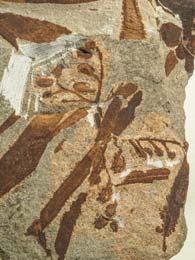


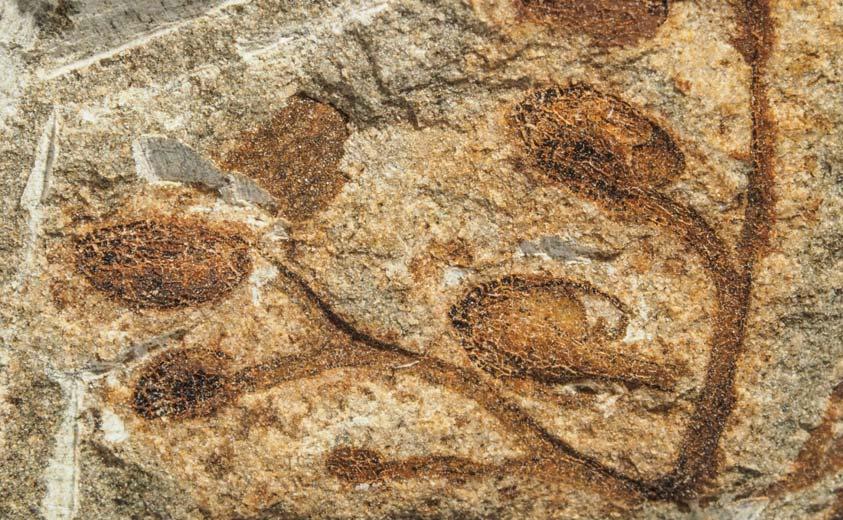

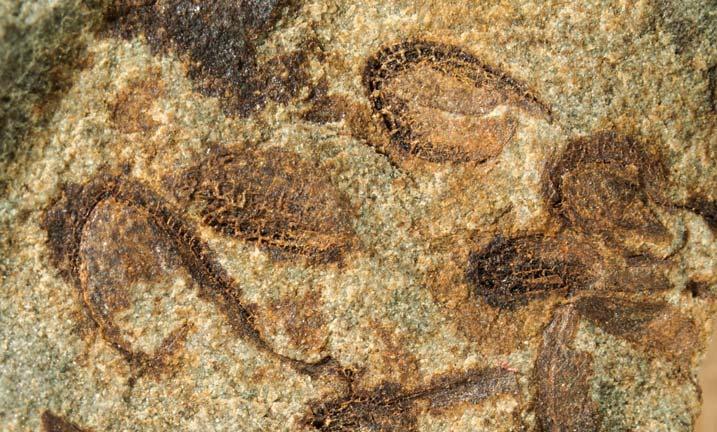
COLOUR PLATES 181 ISSN 2410-4418 Palaeont. afr. (2023) 57 (Special Issue): i–xiv + 1–324 Kannaskop (Kan 111) Plate 30
PRE/F/13511a
PRE/F/13511a
PRE/F/13511b
×5
×2
vincularis
×5
Kannaskoppia
2 3 5
Kan 111 Ast spA
PRE/F/13511a
×10
×10
4 6
cm 0 1 ×1
PRE/F/13511b
12
Kannaskoppia vincularis
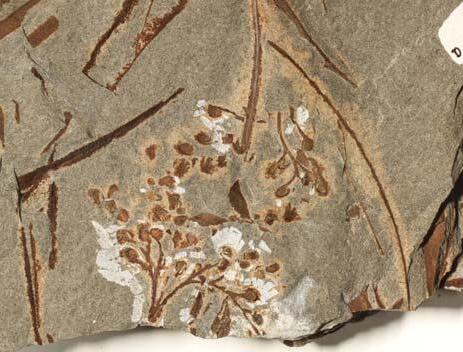

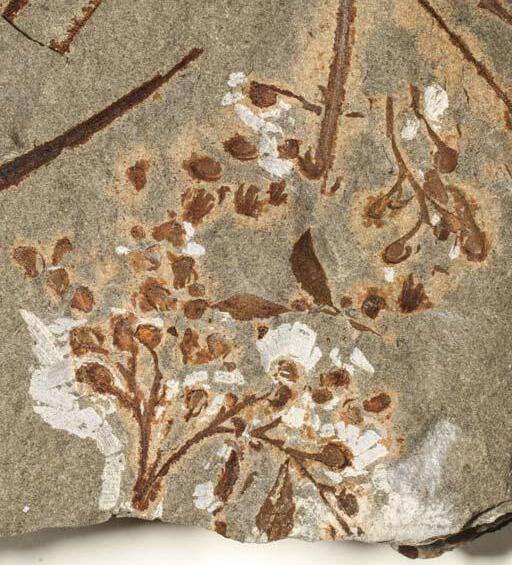
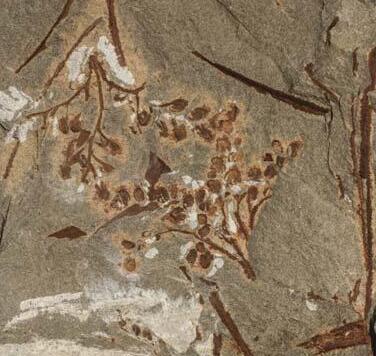


COLOUR PLATES 182 ISSN 2410-4418 Palaeont. afr. (2023) 57 (Special Issue): i–xiv + 1–324 Kannaskop (Kan 111) Plate 31
PRE/F/13506a
×1
PRE/F/13506b
×1
PRE/F/13506a
×5
PRE/F/13506b
×2
×2
1 2 3 4 5
PRE/F/13506a
Kan 111 Ast spA
PRE/F/13506a
6 12 cm 0
×10
Kannaskoppia vincularis

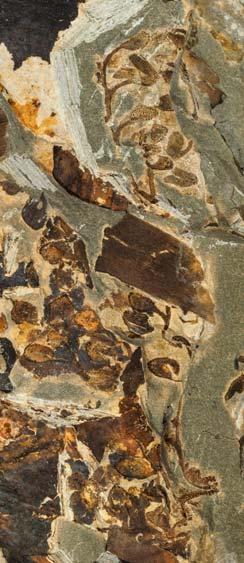
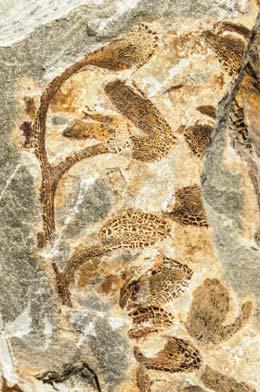
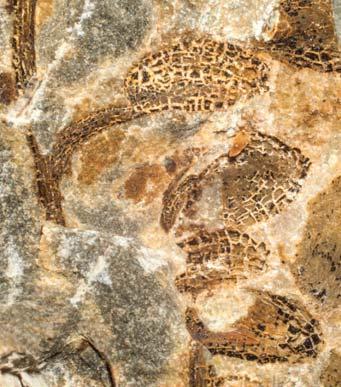


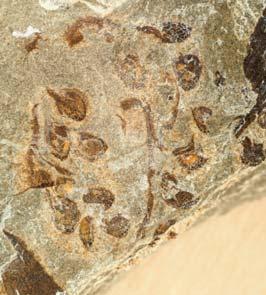

12 cm 0 COLOUR PLATES 183 ISSN 2410-4418 Palaeont. afr. (2023) 57 (Special Issue): i–xiv + 1–324 Kannaskop (Kan 111) Plate 32
×5
PRE/F/13497a
PRE/F/13497a
×10
×2
7 6 8
PRE/F/13497a
Kan 111 Ast spA
×1
1
PRE/F/13568b
3
PRE/F/13568b ×5
PRE/F/13568b
4
×10
×2
5 2
×20
PRE/F/13568b

Kannaskoppia vincularis
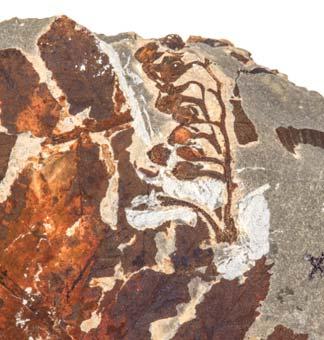


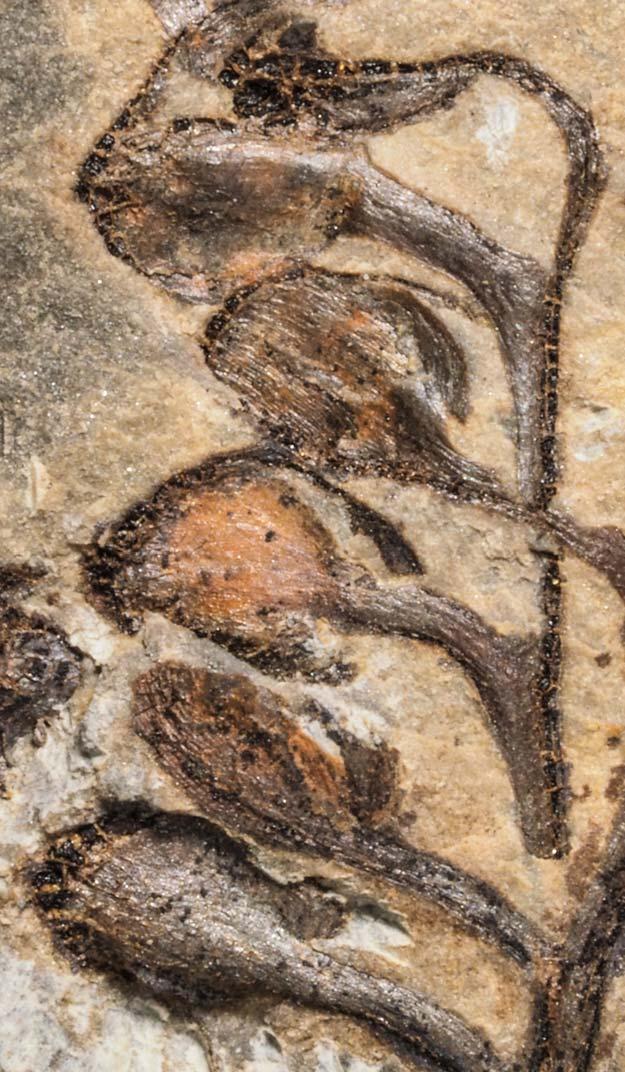

COLOUR PLATES 184 ISSN 2410-4418 Palaeont. afr. (2023) 57 (Special Issue): i–xiv + 1–324 12 cm 0
Kannaskop (Kan
Plate 33
111)
PRE/F/13508a
PRE/F/13508a
×2
2 4
×10
Kan 111 Ast spA
×5
×20
3 5 6
1
×30
×1
PRE/F/13508a
PRE/F/13508a
PRE/F/13508a


Kannaskoppia vincularis
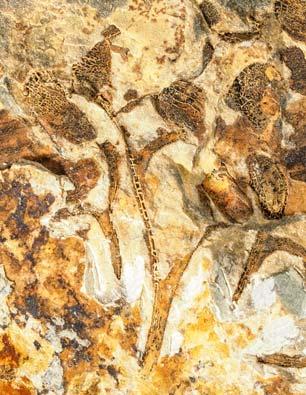





COLOUR PLATES 185 ISSN 2410-4418 Palaeont. afr. (2023) 57 (Special Issue): i–xiv + 1–324
Kannaskop (Kan 111) Plate 34 12 cm 0 ×2
2
PRE/F/13512
×2
5 ×5
PRE/F/13514
×5 3 6 ×10 4
PRE/F/13512
×10
×10
1 7 8 ×1
Kan 111 Ast spA
PRE/F/13514
PRE/F/13514
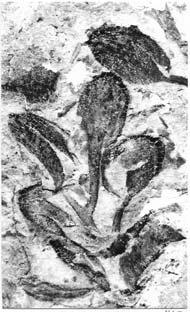
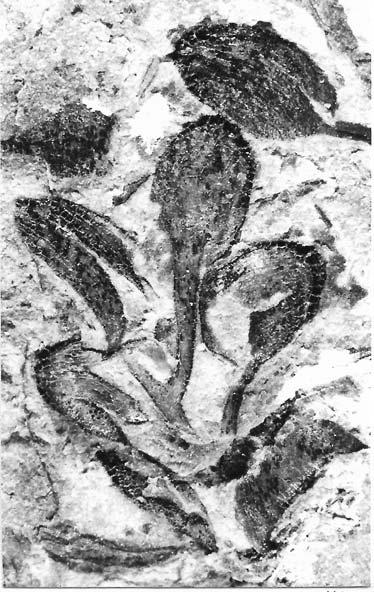
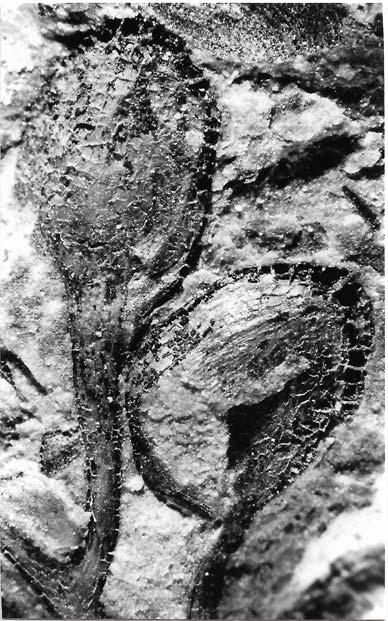
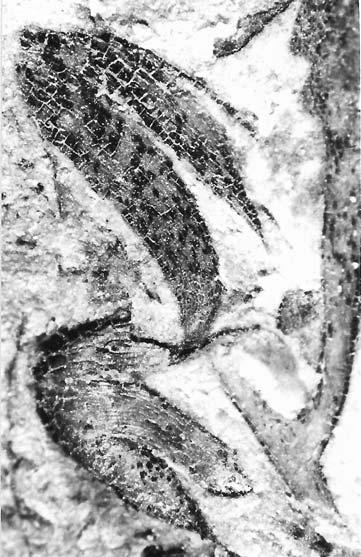

COLOUR PLATES 186 ISSN 2410-4418 Palaeont. afr. (2023) 57 (Special Issue): i–xiv + 1–324 12 cm 0 Kannaskop (Kan 111)
PRE/F/13518
×10
PRE/F/13518
×20
PRE/F/13518
×20
Kan 111 Ast spA
Kannaskoppia vincularis
×30
PRE/F/13518
×5
Plate 35 3 2 5 4 1
PRE/F/13518



Reference palaeodeme (pls 36–40)

COLOUR PLATES 187 ISSN 2410-4418 Palaeont. afr. (2023) 57 (Special Issue): i–xiv + 1–324 12 cm 0 ×5 PRE/F/13545 ×5 PRE/F/13545 ×5
Kannaskop (Kan 111)
Kan 111 Ast spA
BP/2/3372 ×2
BP/2/3372
Plate 36 4 3 2 1
Rochipteris vincularis

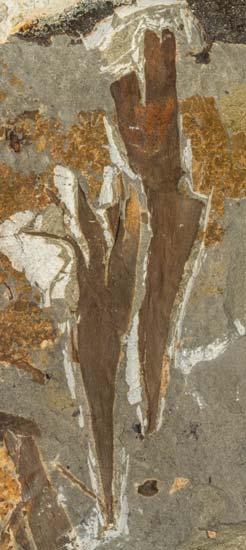

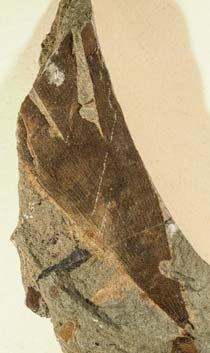
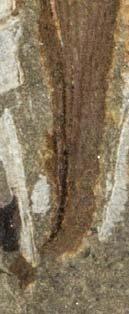
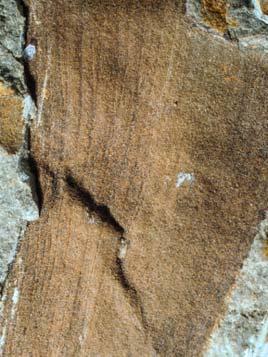
Rochipteris vincularis
Reference palaeodeme (pls 36–40)
Kan 111 Ast spA
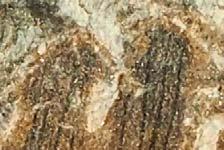

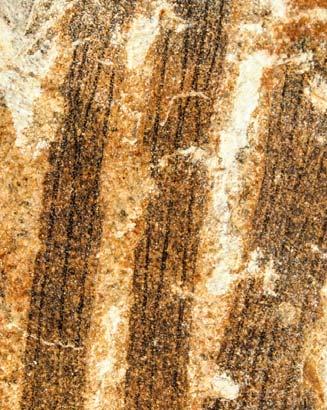

COLOUR PLATES 188 ISSN 2410-4418 Palaeont. afr. (2023) 57 (Special Issue): i–xiv + 1–324 Kannaskop (Kan 111) Plate 37
PRE/F/13536
PRE/F/13536 ×5
×1
×10
BP/2/3416b
1 5
10
PRE/F/13532 ×1
×2
6
BP/2/3416b
×5
8 9 2
BP/2/3416b
12
0
×5
PRE/F/13536
×2
cm
×5
×10
4 3 7
BP/2/3416b
PRE/F/13536

Rochipteris vincularis

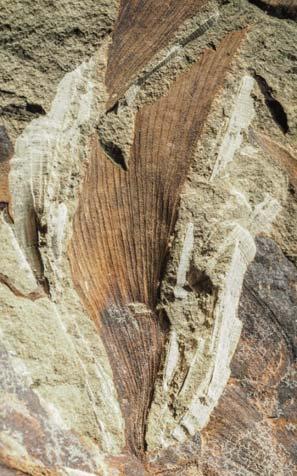
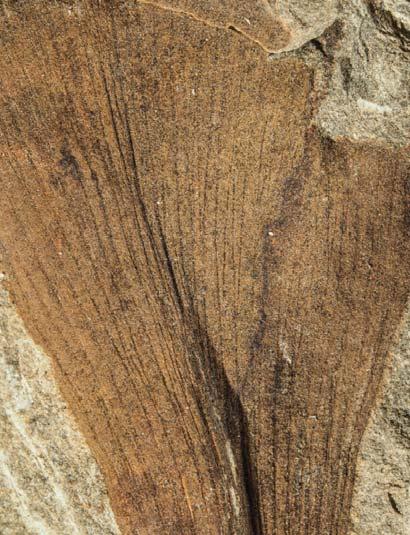

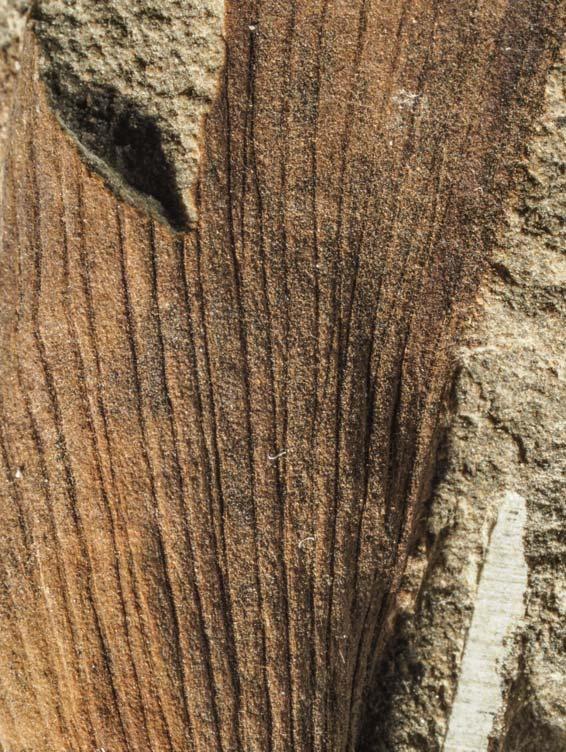
COLOUR PLATES 189 ISSN 2410-4418 Palaeont. afr. (2023) 57 (Special Issue): i–xiv + 1–324 Kannaskop (Kan 111) Plate 38 12 cm 0
PRE/F/13520
PRE/F/13521
PRE/F/13520
PRE/F/13521
PRE/F/13521
×1
×1
×2
PRE/F/13521
×10
×5
×5
1 2 3 4 6 5
Kan 111 Ast spA
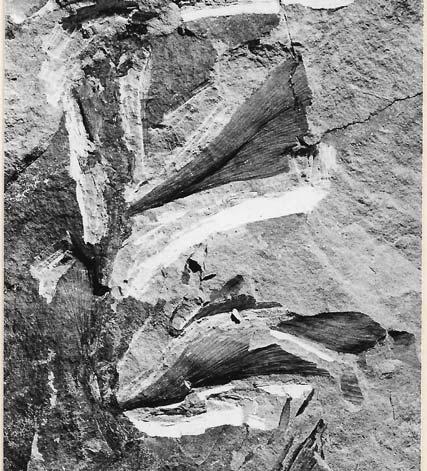
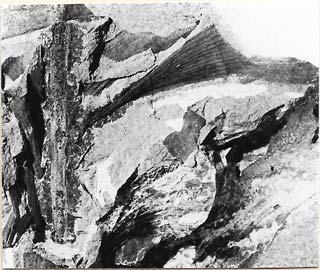

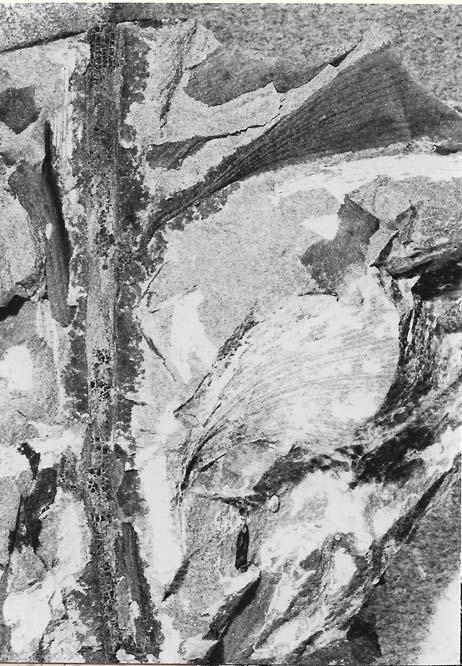
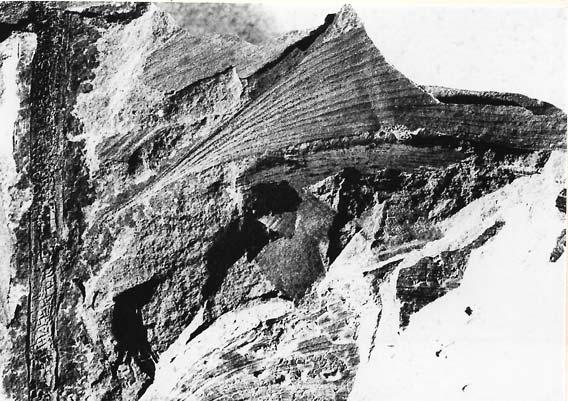

COLOUR PLATES 190 ISSN 2410-4418 Palaeont. afr. (2023) 57 (Special Issue): i–xiv + 1–324
Kan 111 Ast spA
PRE/F/13521
×1
PRE/F/13522
×1
PRE/F/13522 ×2
PRE/F/13521
×2
Kannaskop
Rochipteris vincularis Plate 39 5 4 3 2 1 1 2 cm 0
PRE/F/13522 ×2
(Kan 111)
×5 6
PRE/F/13522
Holotype
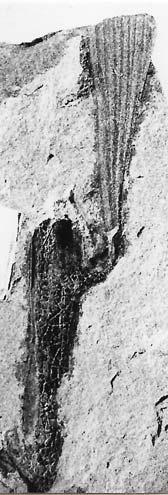



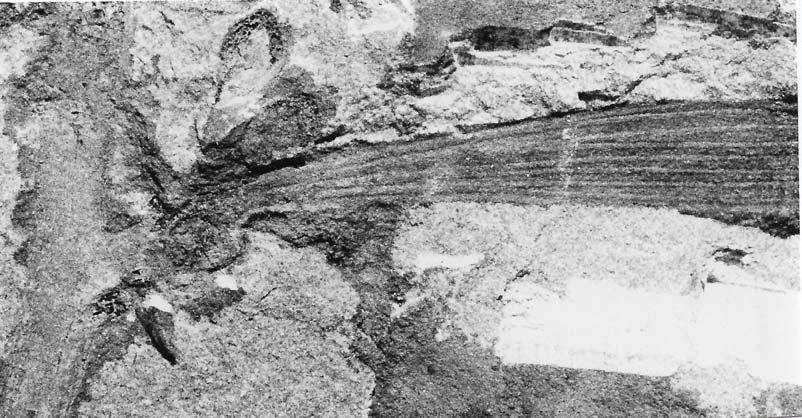

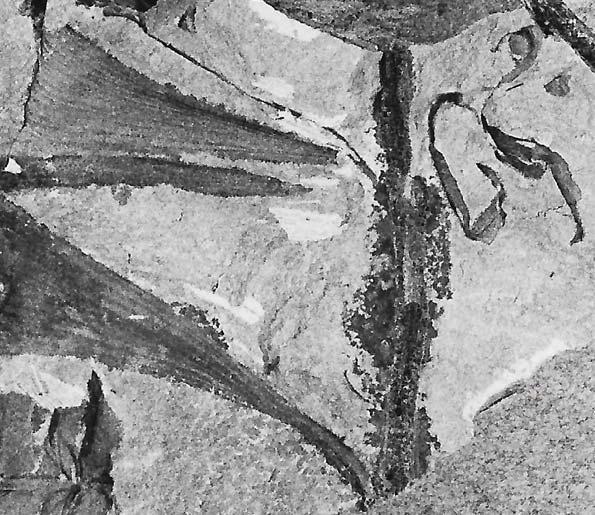
COLOUR PLATES 191 ISSN 2410-4418 Palaeont. afr. (2023) 57 (Special Issue): i–xiv + 1–324 12 cm 0
PRE/F/13487
×5
PRE/F/13523
×1
×1 Kannaskop (Kan 111)
PRE/F/13525
Kan 111 Ast spA
×2
Rochipteris vincularis
×2
×2 ×5
PRE/F/13524
Plate 40 6 7 5 4 1 3 2
PRE/F/13524
PRE/F/13523
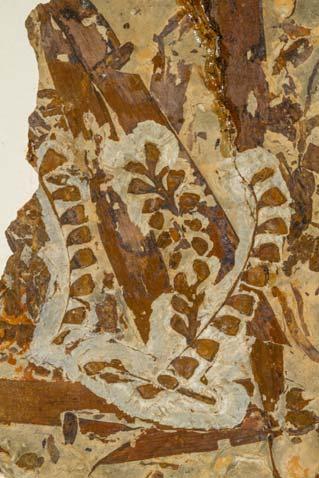
Kannaskoppianthus telemagnus
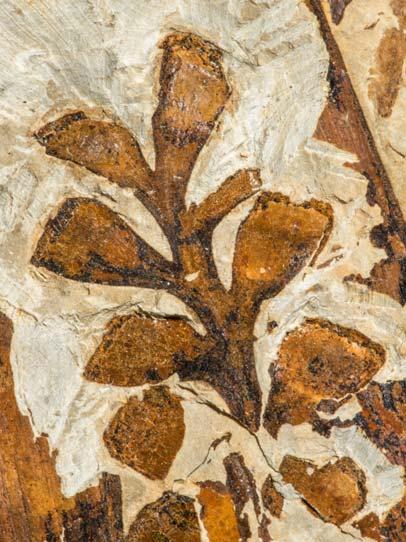
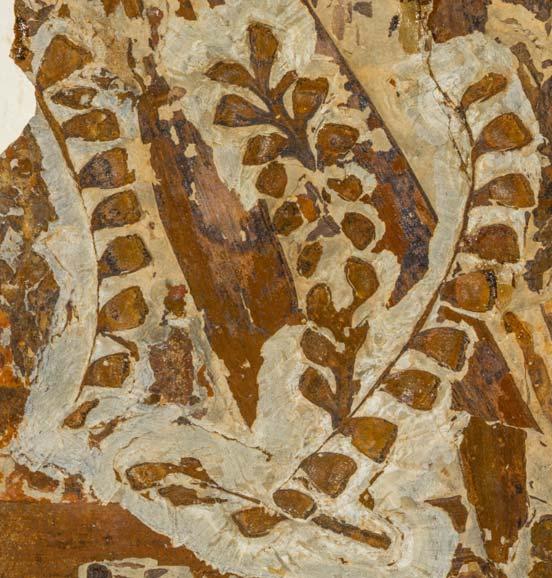



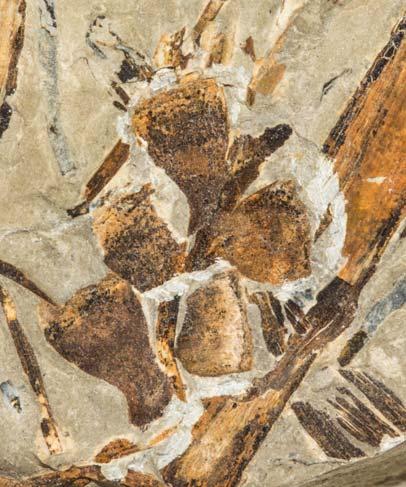
COLOUR PLATES 192 ISSN 2410-4418 Palaeont. afr. (2023) 57 (Special Issue): i–xiv + 1–324
PRE/F/7711
5
×5
PRE/F/7711
1
×1
PRE/F/7711
3
×5
PRE/F/7711
4
×5
PRE/F/7711
6
×10
BP/2/5648
7 Plate 41
×5
PRE/F/7711
2
×2
Telemachus Spruit (Tel 111) 12 cm 0
Tel 111 Hei elo
Holotype Reference palaeodeme

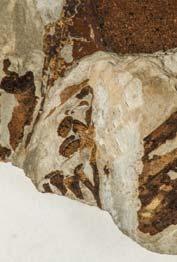
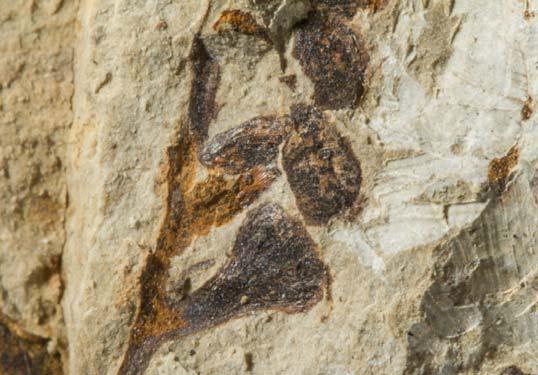

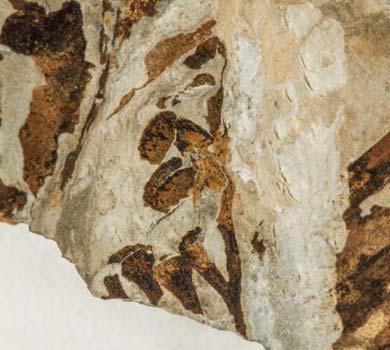


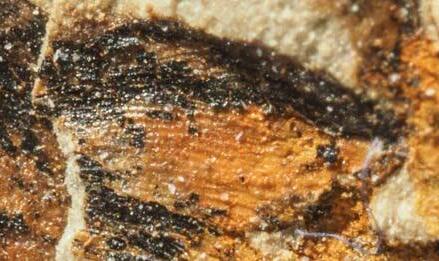
12 cm 0 COLOUR PLATES 193 ISSN 2410-4418 Palaeont. afr. (2023) 57 (Special Issue): i–xiv + 1–324 Telemachus Spruit (Tel 111)
×20
Kannaskoppianthus telepentatus
PRE/F/18277b
×10
PRE/F/18277b
×2
PRE/F/18277a ×2
1 2 3 7
PRE/F/18277a
×20
6 Plate 42
PRE/F/18277a
×5
PRE/F/18277a
×5
5 4 Tel 111 Hei elo
PRE/F/18277b
×40
8
Holotype
PRE/F/18277b
Reference palaeodeme
* * * *
Enlargement of inset in fig. 4, with asterisks showing attached microsporangium
Microsporangium











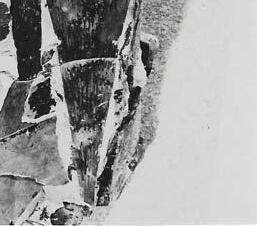
COLOUR PLATES 194 ISSN 2410-4418 Palaeont. afr. (2023) 57 (Special Issue): i–xiv + 1–324
Rochipteris telefolia Plate 43
Telemachus Spruit (Tel 111)
Reference palaeodeme (pls 43–46)
Tel 111 Hei elo
×1
1
PRE/F/17414
×5
2 3
PRE/F/17414
PRE/F/17414
×10
12 cm 0
Holotype
×1 4 ×2 ×5 6 5 ×1 7 ×2 8
PRE/F/18267
PRE/F/18268

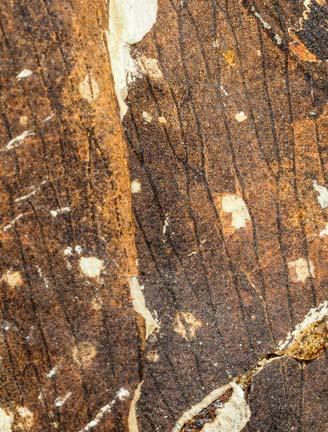
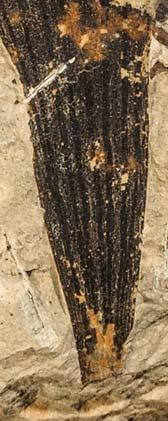

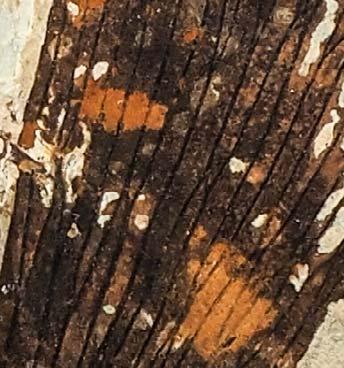


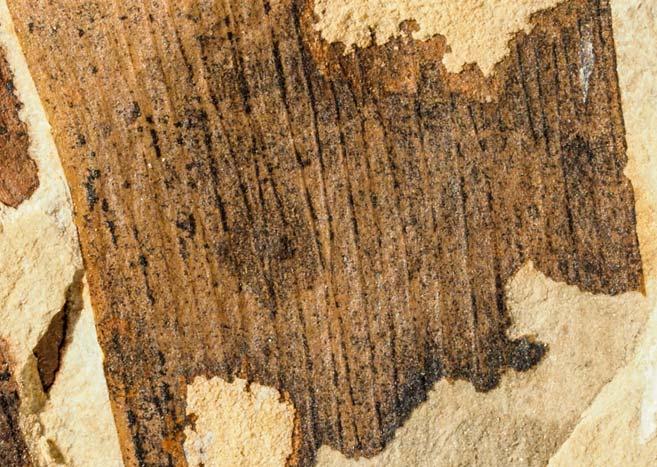
12 cm 0 COLOUR PLATES 195 ISSN 2410-4418 Palaeont. afr. (2023) 57 (Special Issue): i–xiv + 1–324 Telemachus Spruit (Tel 111) Plate 44
2
PRE/F/12875 ×1
Tel 111 Hei elo
PRE/F/12874b
7
×1
×10
8
PRE/F/12874b
×5
4
PRE/F/12875
×2
1
PRE/F/12875
3
×5
Rochipteris telefolia 6
×10
×5
5
PRE/F/12875
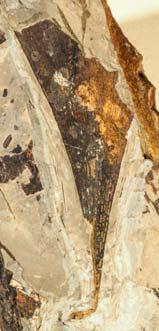
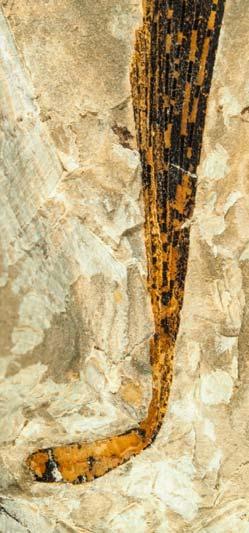
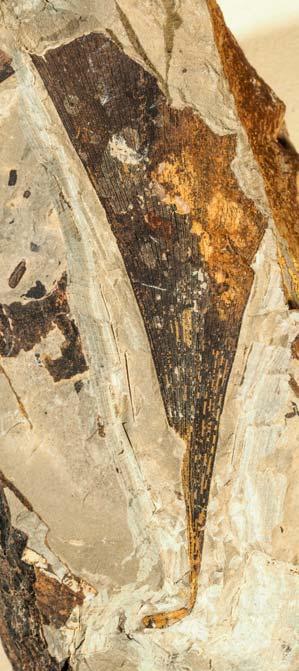
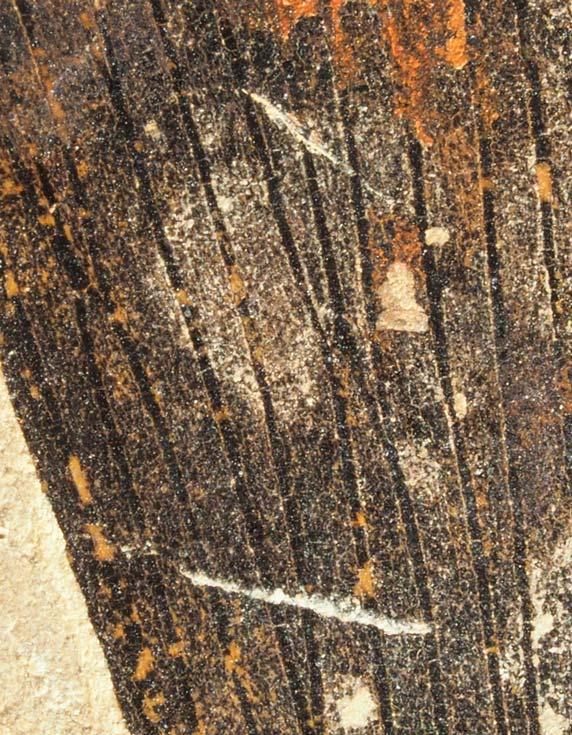
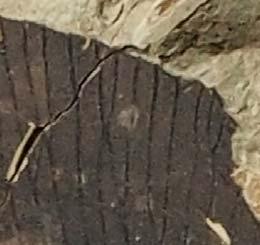



COLOUR PLATES 196 ISSN 2410-4418 Palaeont. afr. (2023) 57 (Special Issue): i–xiv + 1–324
Plate 45
Telemachus Spruit (Tel 111)
PRE/F/17413
×10
PRE/F/17411
×5
×2
Rochipteris telefolia 2 4 8
5
Tel 111 Hei elo
×1
PRE/F/17413
3
×20
PRE/F/17411
PRE/F/17411
×1 1 12 cm 0
6 7
PRE/F/17411
×2
×5
Rochipteris telefolia

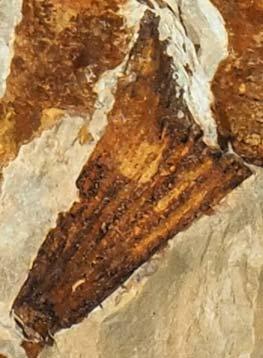
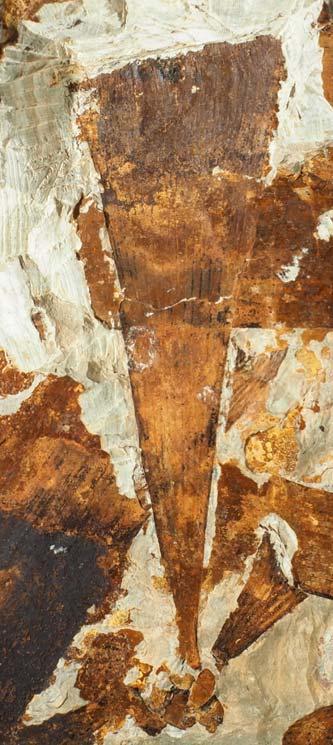
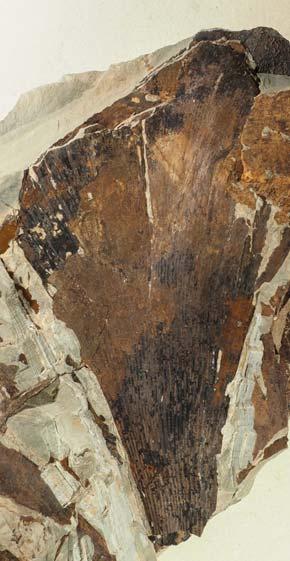

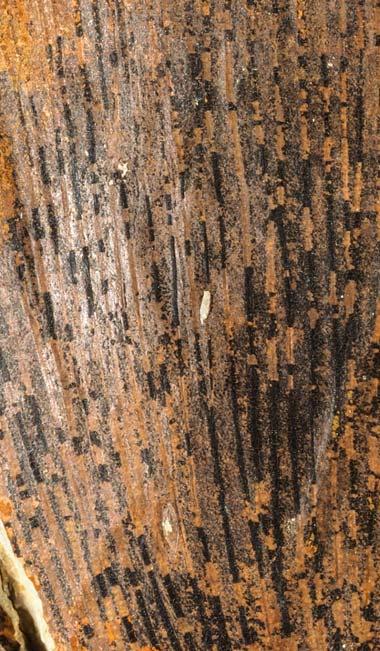
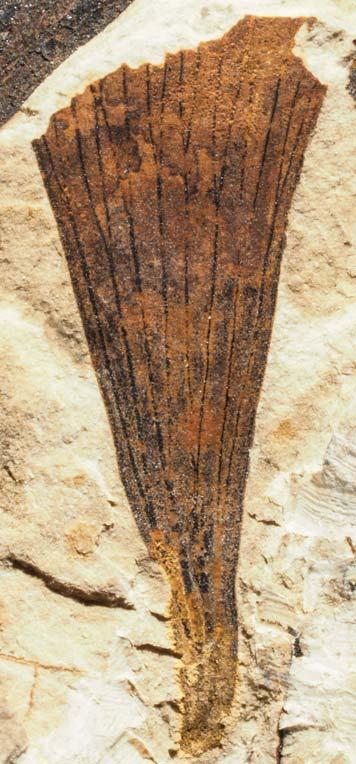


12 cm 0 COLOUR PLATES 197 ISSN 2410-4418 Palaeont. afr. (2023) 57 (Special Issue): i–xiv + 1–324 Telemachus Spruit (Tel 111)
Tel 111 Hei elo
PRE/F/17415
5 4
×1 ×5
PRE/F/17415
8
9
PRE/F/18255 ×10
×2
Rochipteris penensis
PRE/F/17405b
6
7 ×2
×10
×2
2 ×1
PRE/F/12876
1
3 Plate 46
PRE/F/12876
×5

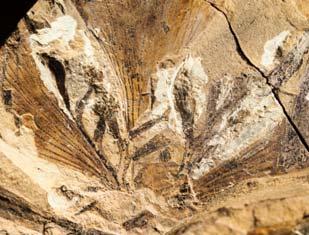
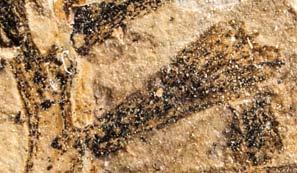
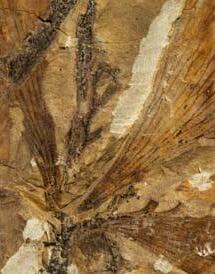

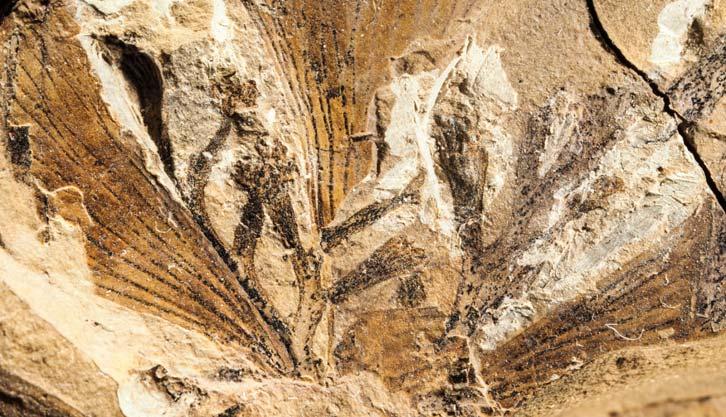
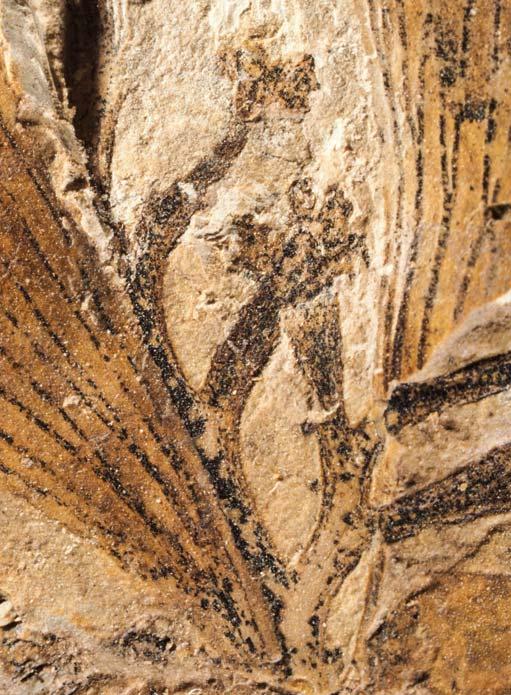
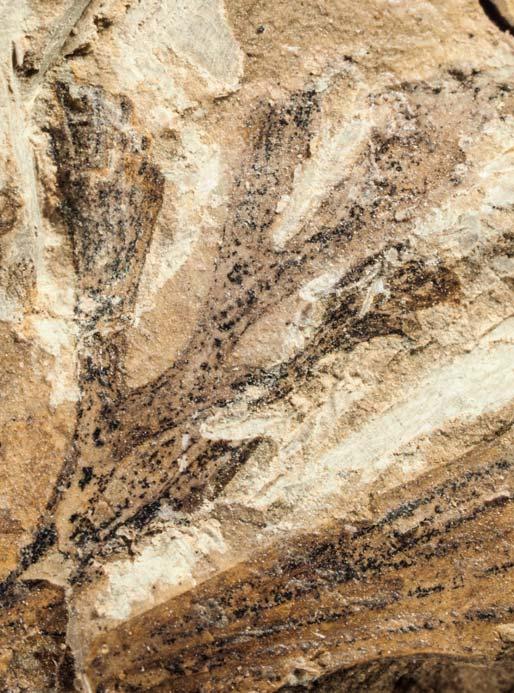

Plate 47 COLOUR PLATES 198 ISSN 2410-4418 Palaeont. afr. (2023) 57 (Special Issue): i–xiv + 1–324 Kommandantskop (Kom 111)
PRE/F/3231a
PRE/F/3231a
PRE/F/3231a
PRE/F/3231a
×2
×2
×10
×10
3
Kannaskoppianthus komanthus / Rochipteris komifolia
1 4 7 8
5
PRE/F/3231b ×1
×5
PRE/F/3231a
×10
6
PRE/F/3231a
Kom 111 Sph/Dic
2
PRE/F/3231b ×2
Reference palaeodeme (pls 47–50)
12 cm 0 ×20 9
Holotype
Kannaskoppianthus komanthus / Rochipteris komifolia




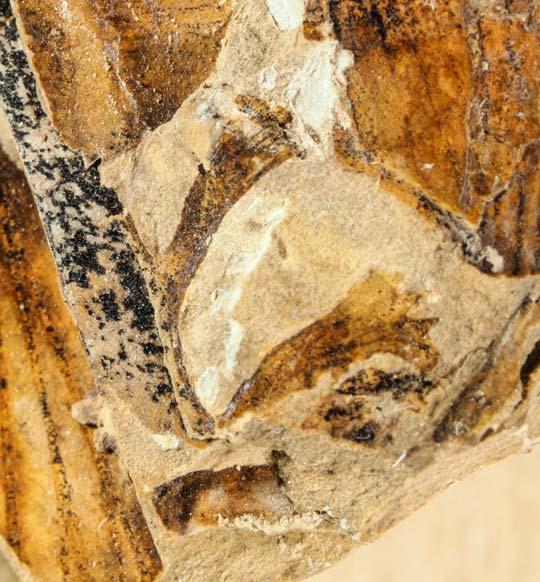
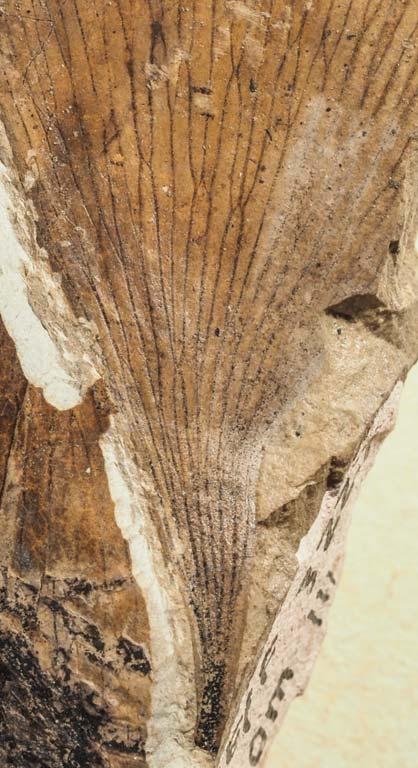
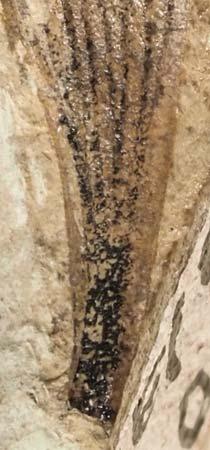
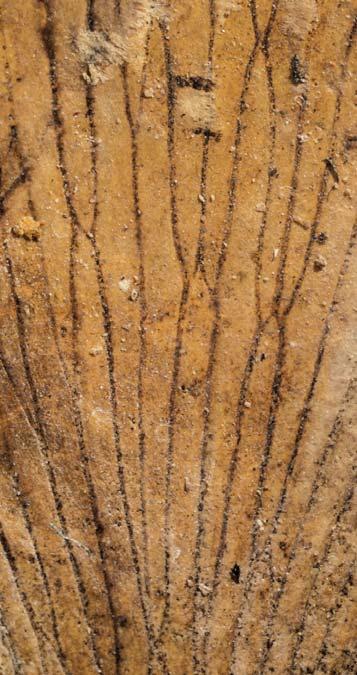
Plate 48 12 cm 0 COLOUR PLATES 199 ISSN 2410-4418 Palaeont. afr. (2023) 57 (Special Issue): i–xiv + 1–324 Kommandantskop (Kom 111)
PRE/F/3227 ‘x’,‘y’ ×2
2
Kom 111 Sph/Dic
PRE/F/3227 ‘z’
PRE/F/3227 ‘z’
4 6
×2 ×5
PRE/F/3227 ‘z’
8
×10
reverse of slab
×5 5 ×10 7
PRE/F/3227 ‘x’,‘y’ above (figs 1–3)
3
1
PRE/F/3227 ‘y’ ×10
×1
Holotype
enlargement of inset in fig. 2
‘x’ ‘y’

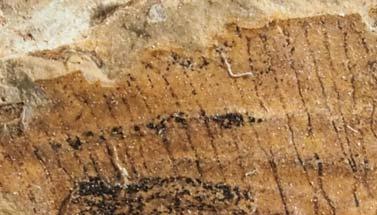

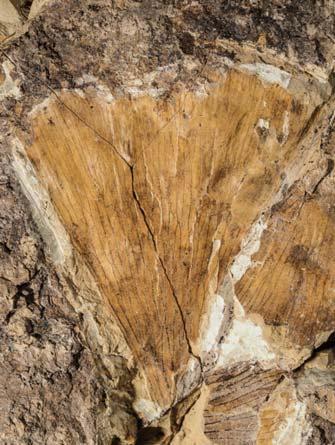


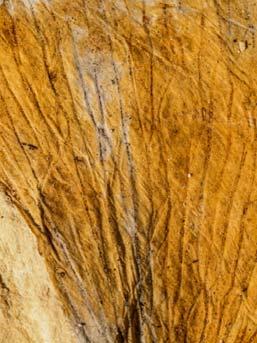
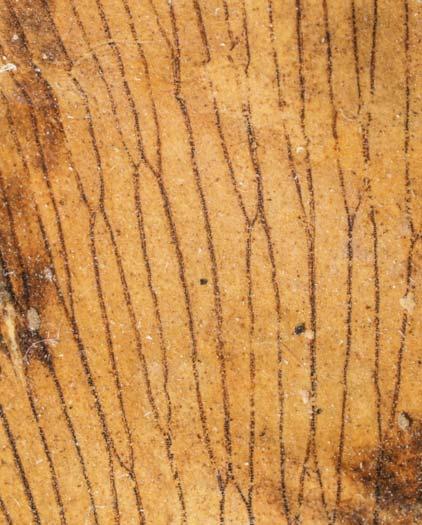
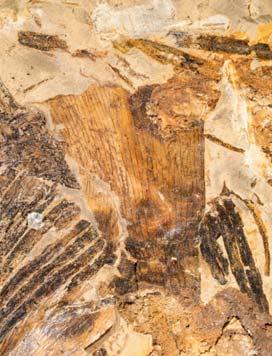

COLOUR PLATES 200 ISSN 2410-4418 Palaeont. afr. (2023) 57 (Special Issue): i–xiv + 1–324 Kommandantskop (Kom 111)
PRE/F/3220
×10
PRE/F/3220
Rochipteris komifolia
Kom 111 Sph/Dic
PRE/F/3215
×2
7
PRE/F/3215 ×5
PRE/F/3216
PRE/F/3216
×2
2 4
×10
PRE/F/3222
5 6 9 10 8 Plate 49
1 ×1 ×10 3 12 cm 0
PRE/F/3222
×5 ×2
×2




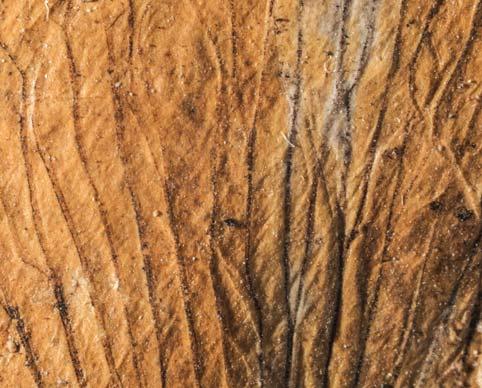
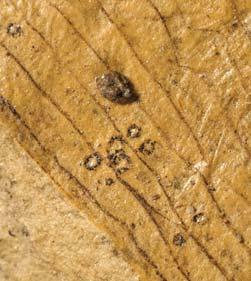





COLOUR PLATES 201 ISSN 2410-4418 Palaeont. afr. (2023) 57 (Special Issue): i–xiv + 1–324
PRE/F/3236
Kommandantskop (Kom 111)
×10
PRE/F/3236
PRE/F/3236
×2
×5
1 2
Kom 111 Sph/Dic
3
PRE/F/3236 ×10
7
×2
×5 8 12 cm 0
PRE/F/3225
5 4 Plate 50
×20
×1 6 9 ×5
Rochipteris komifolia
PRE/F/3225


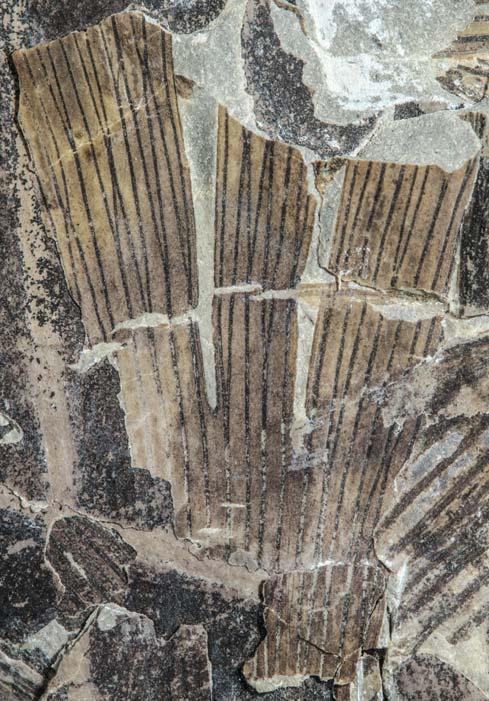
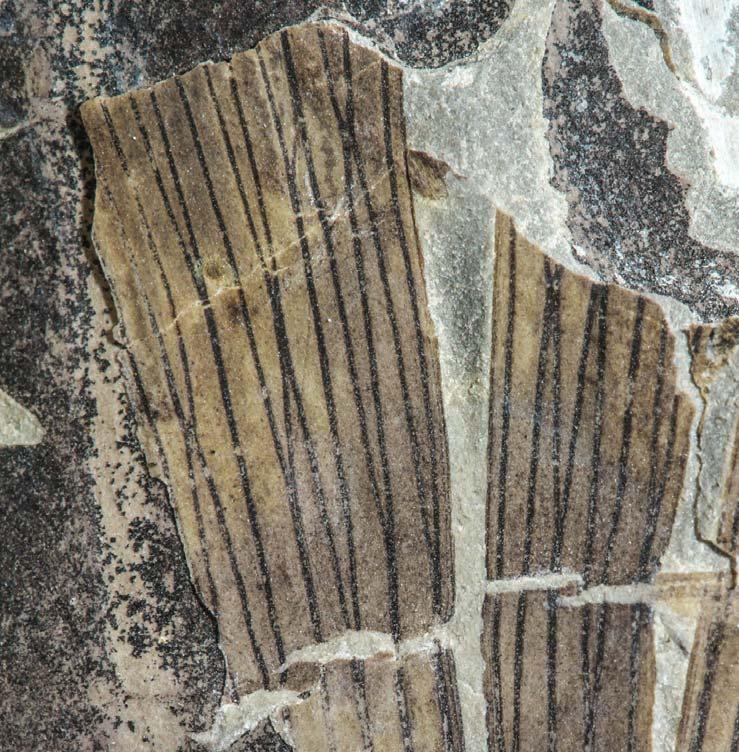
COLOUR PLATES 202 ISSN 2410-4418 Palaeont. afr. (2023) 57 (Special Issue): i–xiv + 1–324
Vineyard (Vin 111)
BP/2/6045
BP/2/6045
BP/2/6045
×2
×10
×5
Rochipteris vincularis 1 3 4 Plate 51 12 cm 0
Vin 111 Dic odo
2
×5


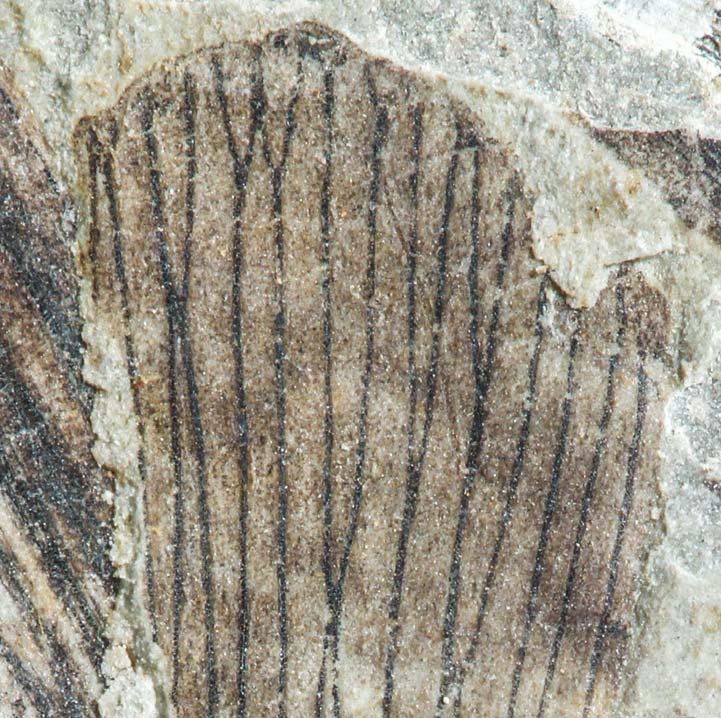
12 cm 0 COLOUR PLATES 203 ISSN 2410-4418 Palaeont. afr. (2023) 57 (Special Issue): i–xiv + 1–324 Vineyard (Vin 111)
BP/2/6046
BP/2/6046 ×5
×10
Rochipteris vincularis 1 2 Plate 52
Vin 111 Dic odo
3
BP/2/6046
×20

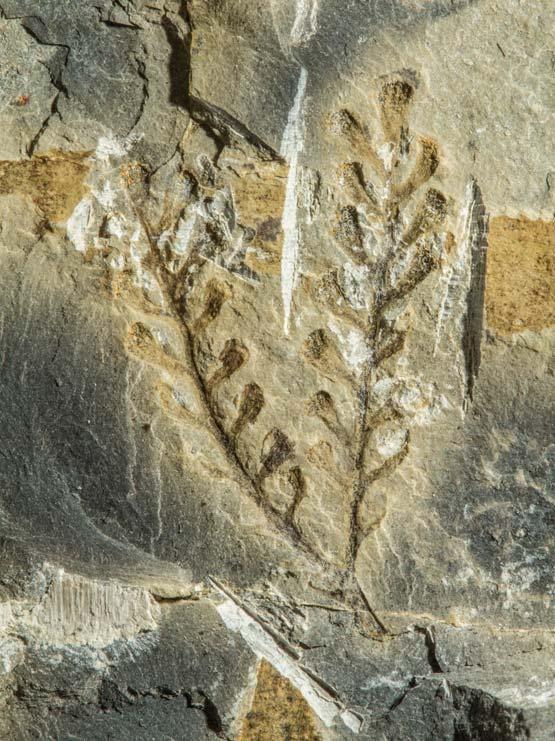
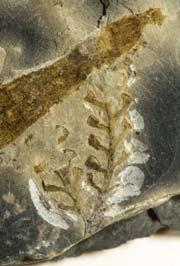
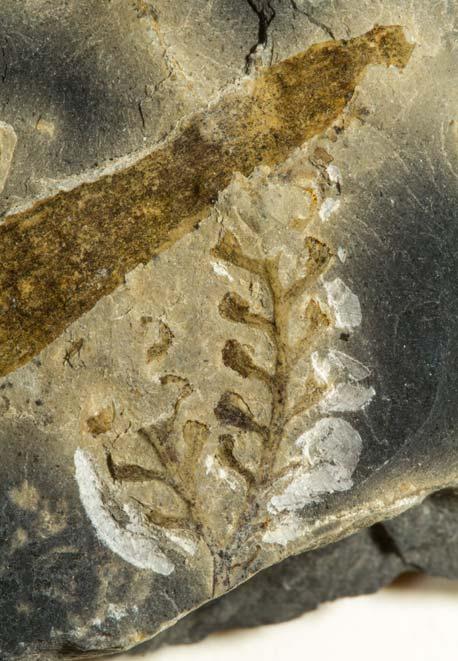
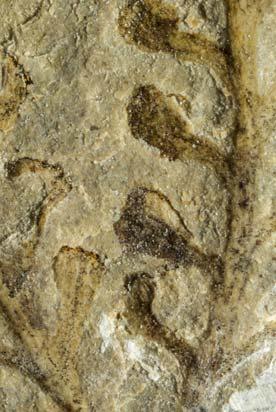
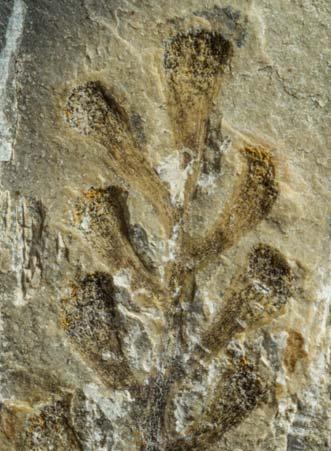
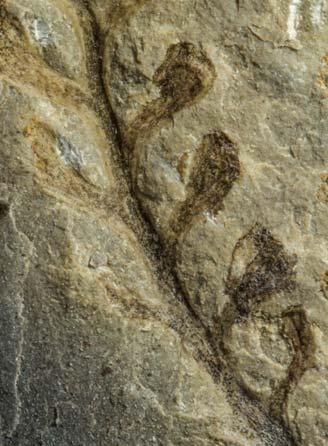
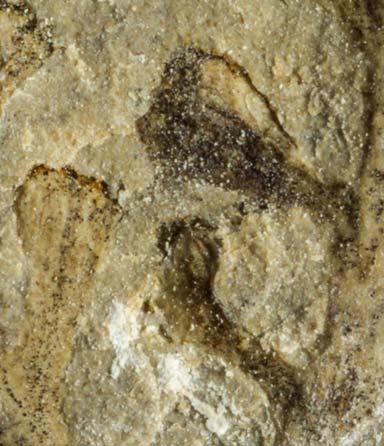
COLOUR PLATES 204 ISSN 2410-4418 Palaeont. afr. (2023) 57 (Special Issue): i–xiv + 1–324
Plate 53 Lutherskop (Lut 311)
Kannaskoppianthus lutinumerus
PRE/F/11433a
×10
PRE/F/11433a
×10
×5
×2
PRE/F/11433b ×5
PRE/F/11433b
×10
PRE/F/11433a ×2
5 1 2 3 4 7 6
Lut 311 Hei elo
8
×20
PRE/F/11433a
0
Holotype 12 cm
Reference palaeodeme (pls 53–60)
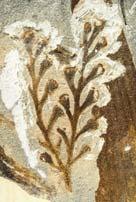

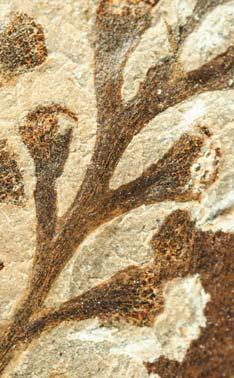
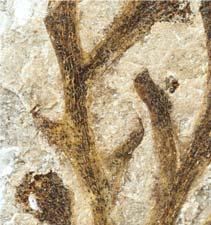






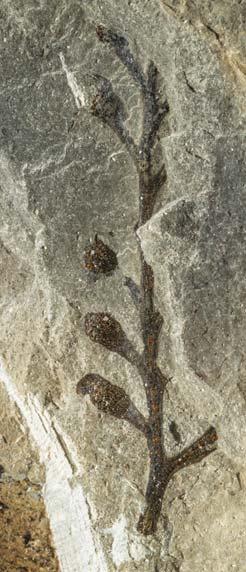
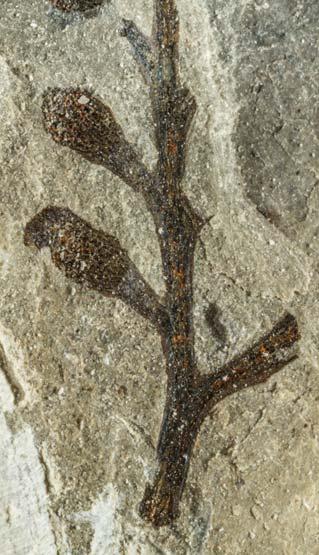



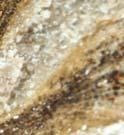



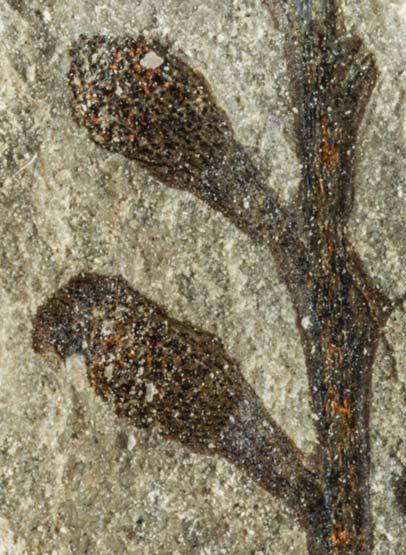
COLOUR PLATES 205 ISSN 2410-4418 Palaeont. afr. (2023) 57 (Special Issue): i–xiv + 1–324 Lutherskop (Lut 311) Plate 54
×5
×2
×10
PRE/F/11429a
PRE/F/11429a
PRE/F/11429a
×10
PRE/F/11429b
×5
×10
×15
×2
PRE/F/11429b
PRE/F/11429b
PRE/F/11432
×2
×5
PRE/F/11432
Lut 311 Hei elo Kannaskoppianthus lutinumerus 1 12 11 10 9 8 7 6 4 3 2
×10
13
×20
12 cm 0 ×20 5
PRE/F/11432

Kannaskoppianthus lutinumerus
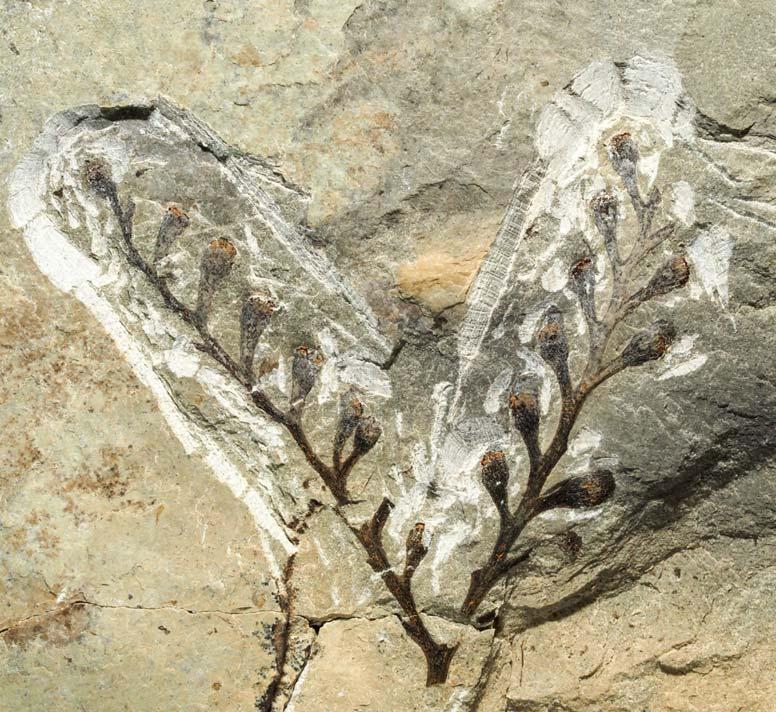


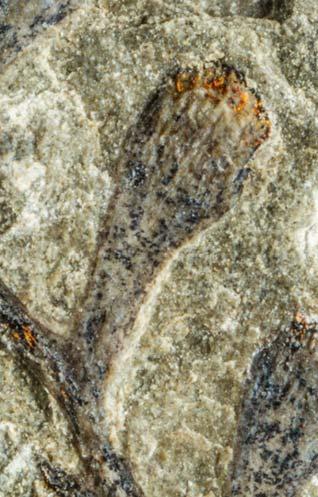

COLOUR PLATES 206 ISSN 2410-4418 Palaeont. afr. (2023) 57 (Special Issue): i–xiv + 1–324 12 cm 0
Lutherskop (Lut 311) Plate 55
×10
PRE/F/11431a
PRE/F/11431a
×2
PRE/F/11431a
Lut 311 Hei elo
1 2 3
6
PRE/F/11431a
×20
5
×20
PRE/F/11431a
Kannaskoppianthus lutinumerus
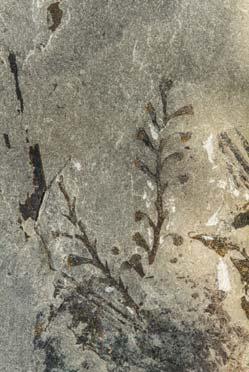
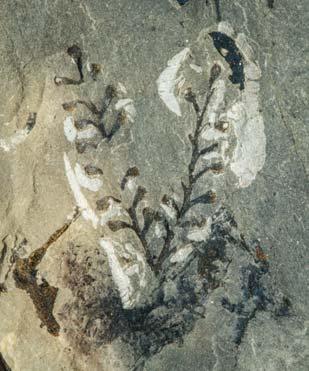

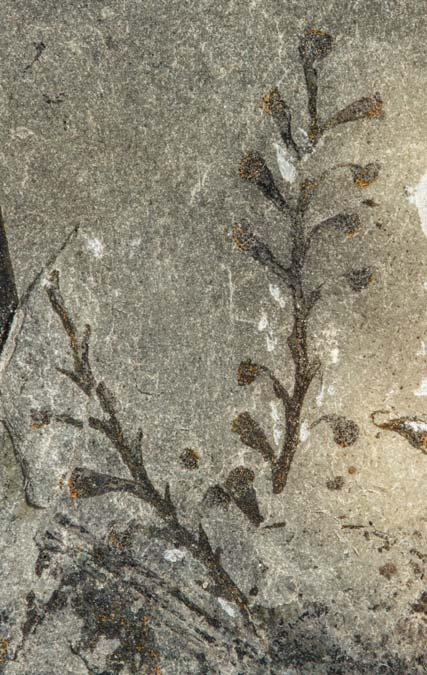
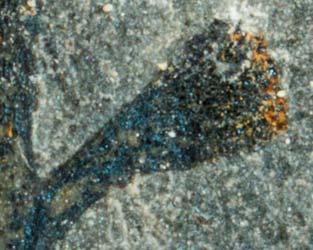
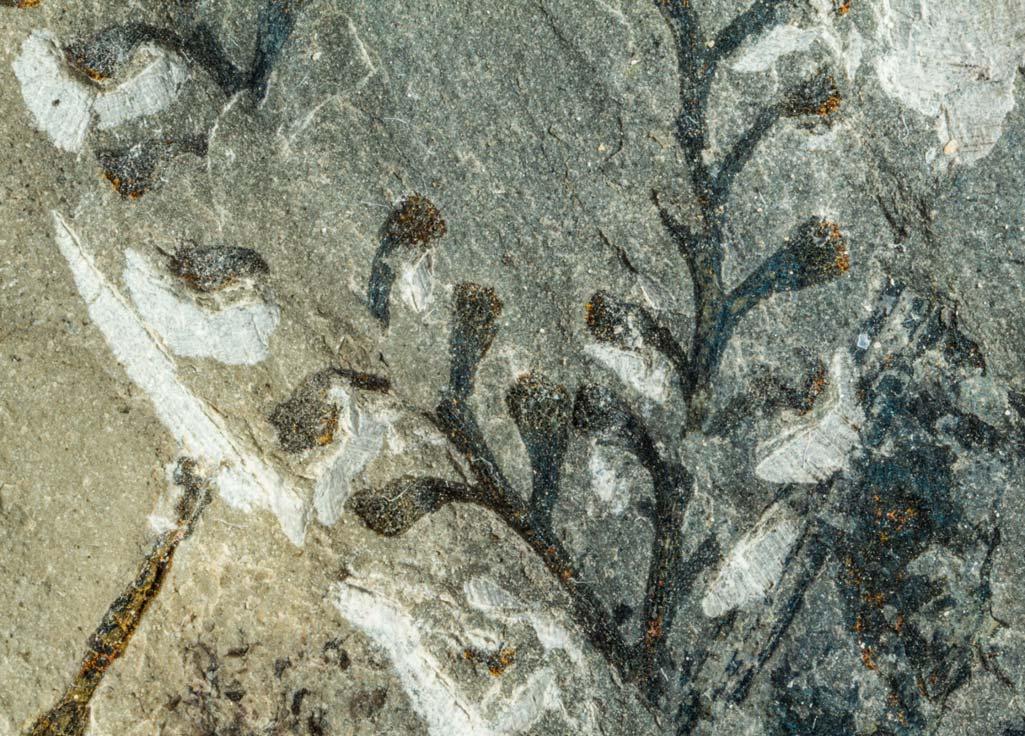
COLOUR PLATES 207 ISSN 2410-4418 Palaeont. afr. (2023) 57 (Special Issue): i–xiv + 1–324 Plate 56 Lutherskop (Lut 311)
Lut 311 Hei elo
PRE/F/11438a
×2
PRE/F/11438a
PRE/F/11438a
PRE/F/11438b
PRE/F/11438b ×2 ×10
×5
5 4 3 2 1 12 cm 0
6
×10
×20



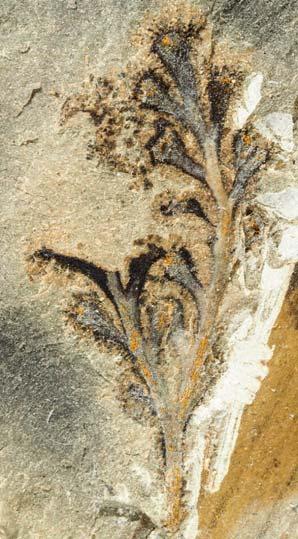
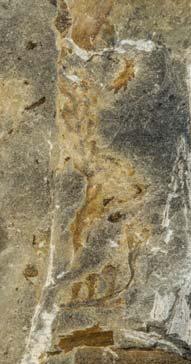


PRE/F/11390b


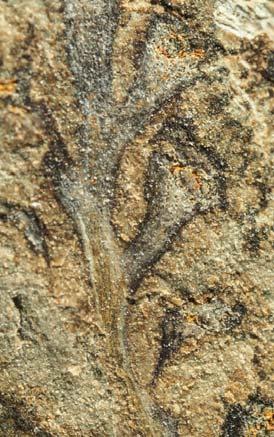

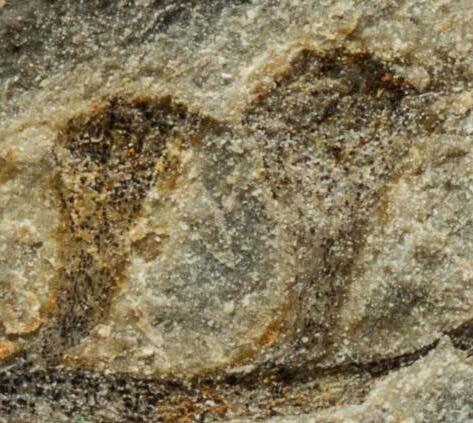
COLOUR PLATES 208 ISSN 2410-4418 Palaeont. afr. (2023) 57 (Special Issue): i–xiv + 1–324 Lutherskop (Lut 311) Plate 57
PRE/F/11391a ×5
×2
9 10 ×10
Kannaskoppianthus lutinumerus
×10
PRE/F/11390a
PRE/F/11390a
PRE/F/11390a
PRE/F/11390b
×10
×10 ×5
PRE/F/11390b
×5
×10
2 3 4 6 8 7 1 5 ×2 ×2 11
Lut 311 Hei elo
12 12 cm 0
PRE/F/11391a ×20


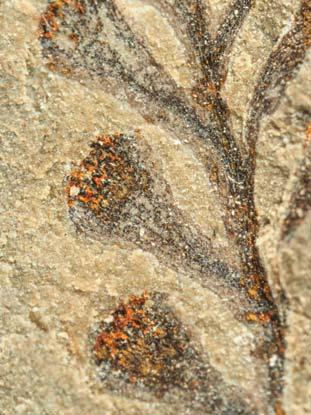

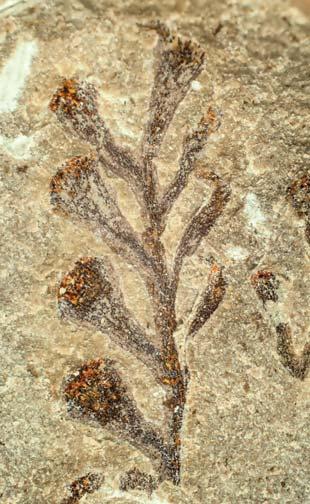


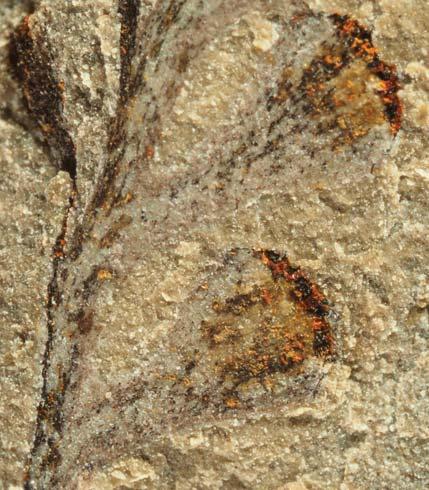
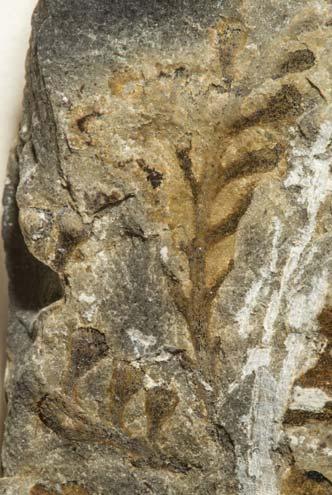

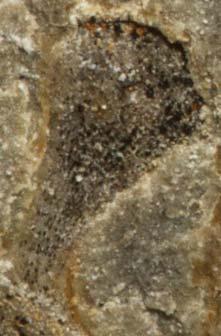
COLOUR PLATES 209 ISSN 2410-4418 Palaeont. afr. (2023) 57 (Special Issue): i–xiv + 1–324 Lutherskop (Lut 311) Plate 58
PRE/F/11391b ×2
PRE/F/11391b ×5
PRE/F/11428a
PRE/F/11428a
PRE/F/11428b ×10
×10
×15
PRE/F/11428a
PRE/F/11428b
×5
PRE/F/11428b ×20
1 2 3 4 5 6 7 8 ×5 Kannaskoppianthus lutinumerus 10 9
×10
Lut 311 Hei elo
×20
PRE/F/11391b 12 cm 0
PRE/F/11391b
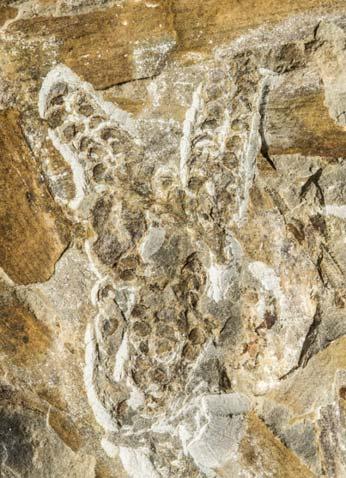


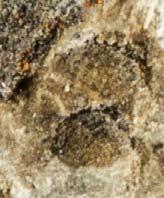
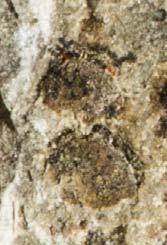
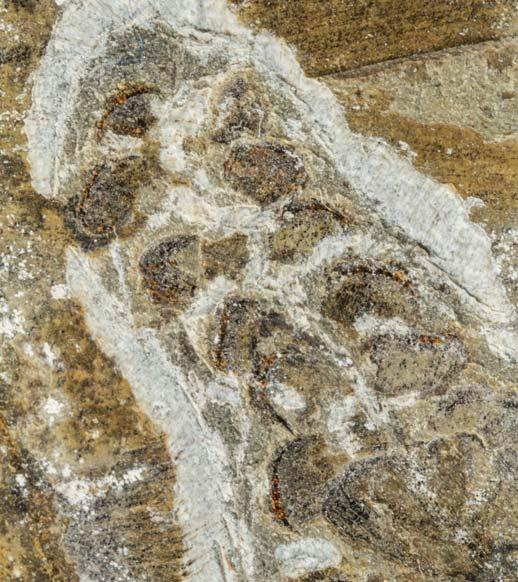
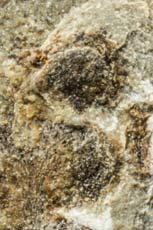
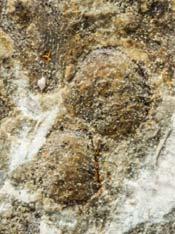
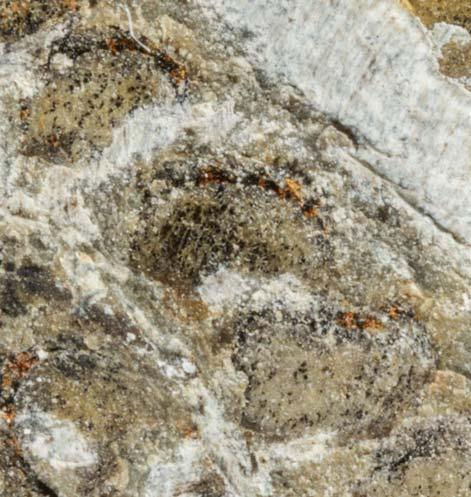
COLOUR PLATES 210 ISSN 2410-4418 Palaeont. afr. (2023) 57 (Special Issue): i–xiv + 1–324 Lutherskop (Lut 311)
PRE/F/11434a
×2 Kannaskoppianthus lutinumerus
1
Plate 59 ×5
×10
Lut 311 Hei elo
×10
×5
×20 ×10 ×10 ×10
PRE/F/11434a
PRE/F/11434a
PRE/F/11434a
PRE/F/11434a
PRE/F/11434a
PRE/F/11434a
PRE/F/11434a
9 8 7 6 5 4 3 2 12 cm 0
PRE/F/11434a
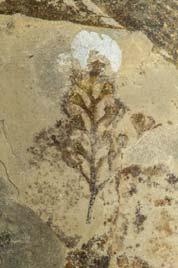
Kannaskoppianthus lutinumerus

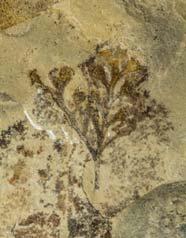
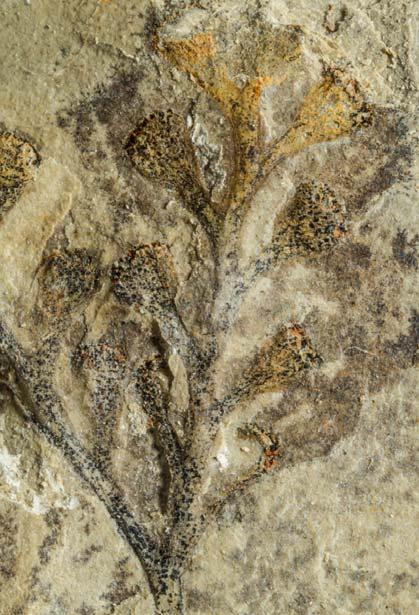
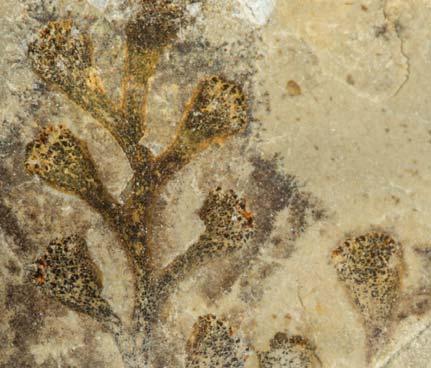


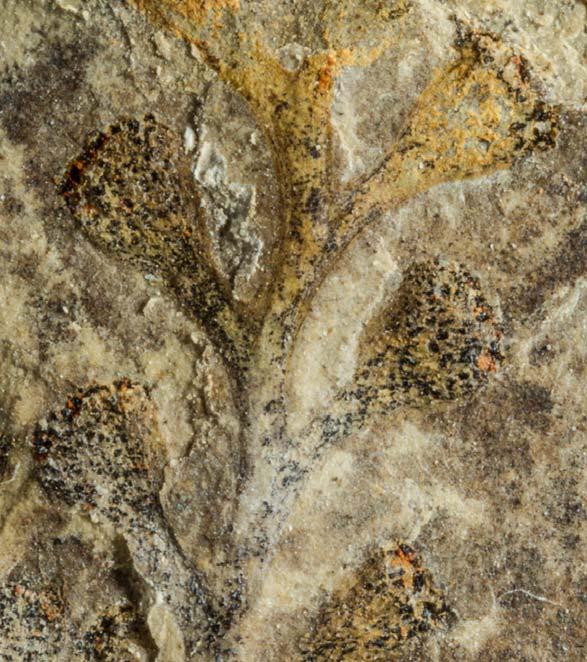
12 cm 0 COLOUR PLATES 211 ISSN 2410-4418 Palaeont. afr. (2023) 57 (Special Issue): i–xiv + 1–324 Lutherskop (Lut 311)
PRE/F/11427b
×10
PRE/F/11427a
×5
PRE/F/11427b
×5
PRE/F/11427b
×20
PRE/F/11427a
×2
PRE/F/11427b ×2
1 2 5 6 7 8 Plate 60
×20 3 4
Lut 311 Hei elo
×10

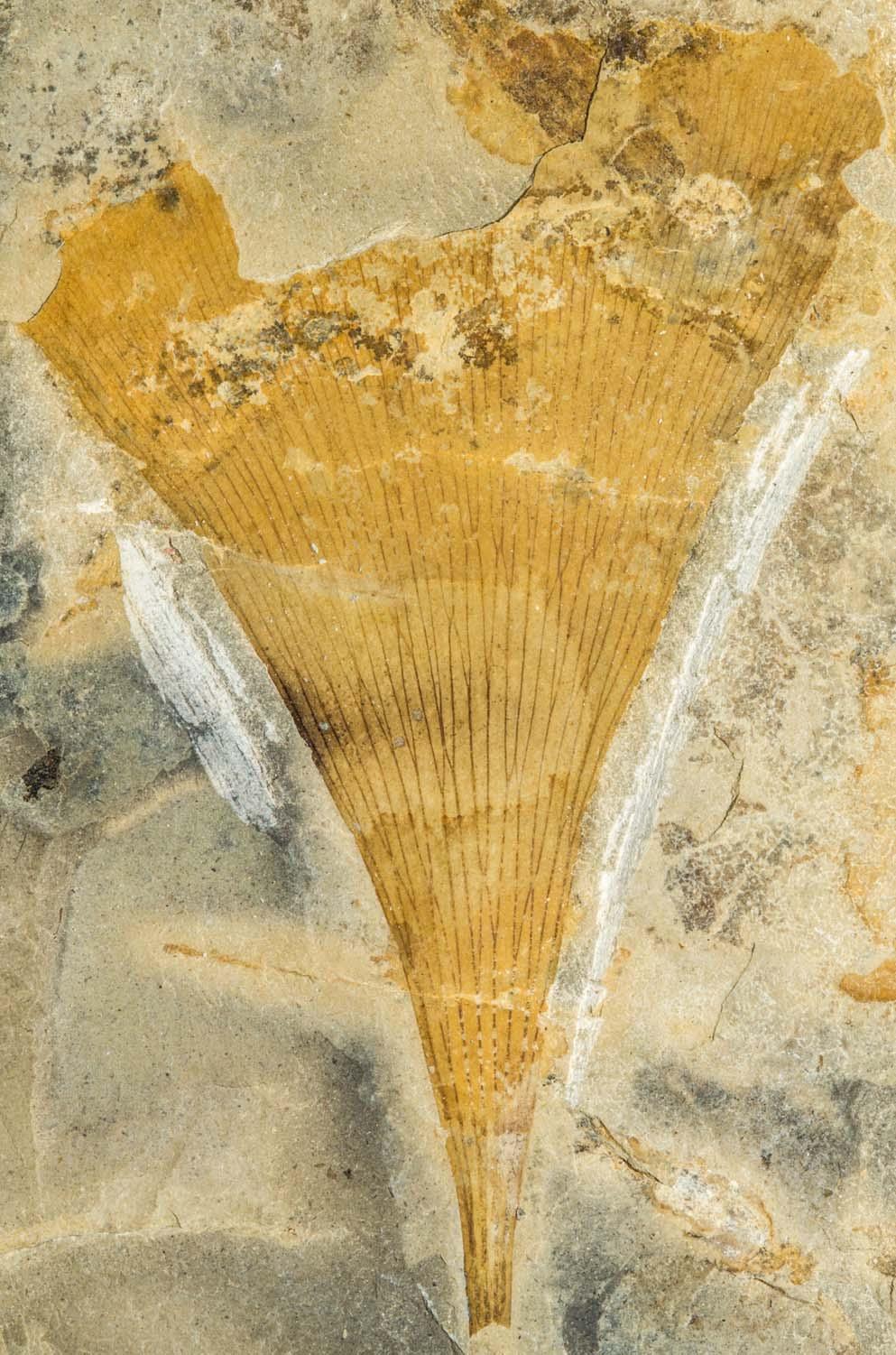

COLOUR PLATES 212 ISSN 2410-4418 Palaeont. afr. (2023) 57 (Special Issue): i–xiv + 1–324
Plate 61 1 ×2
Rochipteris lutifolia
2 12 cm 0
PRE/F/11358a
×1 3
PRE/F/11358a
Lut 311 Hei elo
PRE/F/11358a
Holotype
Lutherskop (Lut 311)
×5
Reference palaeodeme (pls 61–68)



Rochipteris lutifolia
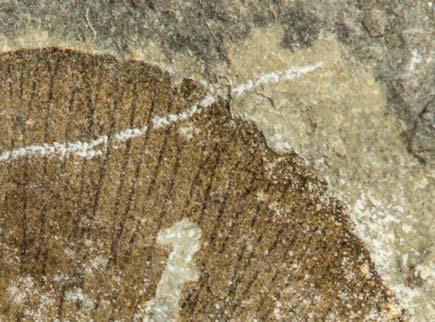
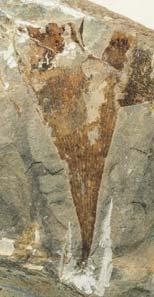
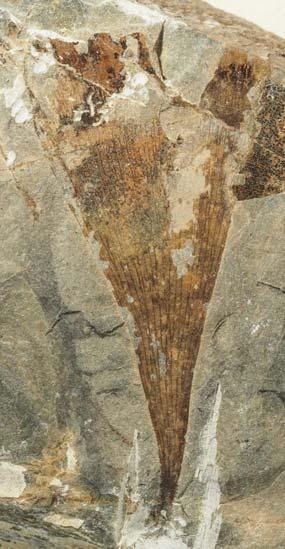
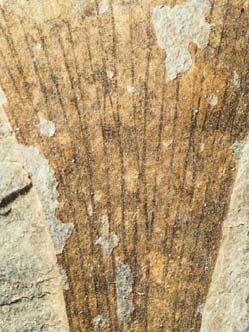
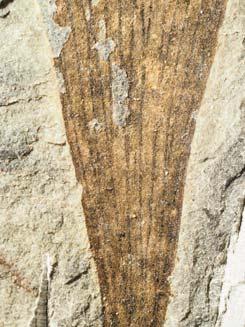
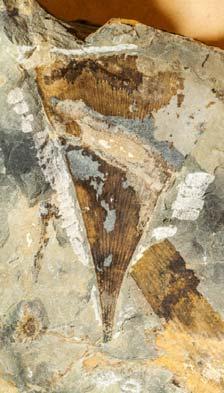
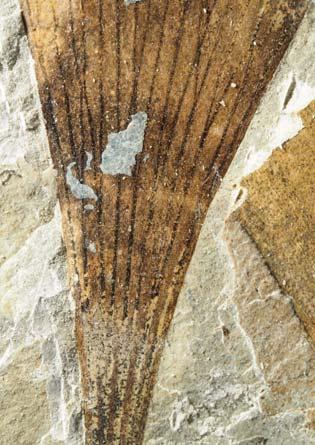




12 cm 0 COLOUR PLATES 213 ISSN 2410-4418 Palaeont. afr. (2023) 57 (Special Issue): i–xiv + 1–324 Plate 62 PRE/F/11364 PRE/F/11364
×5 ×5
PRE/F/11364
×1
9 10 11
PRE/F/11364 12
×5
PRE/F/11389a
×5 ×2 ×2 PRE/F/11378 ×5 5 6 7 2 3 1 ×1
4
PRE/F/11389a
×1
×10
Lut 311 Hei elo
PRE/F/11378
8 Lutherskop (Lut 311)
PRE/F/11389a
×10 PRE/F/11389a
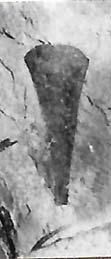

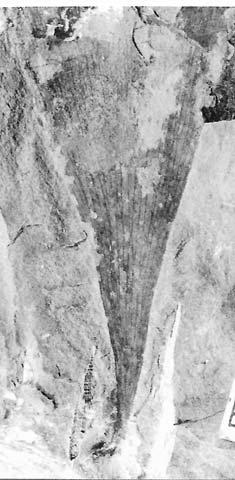
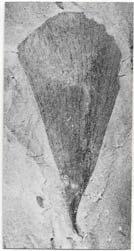

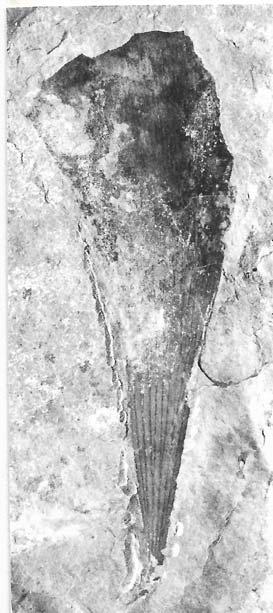
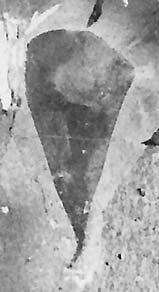
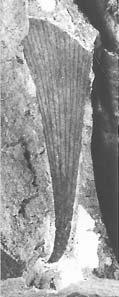
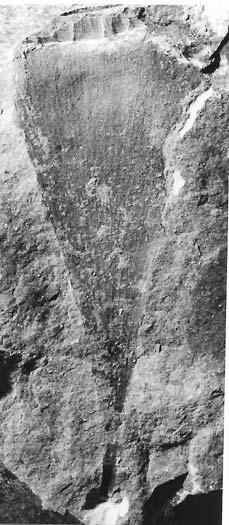


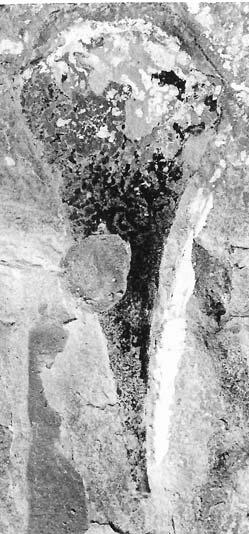
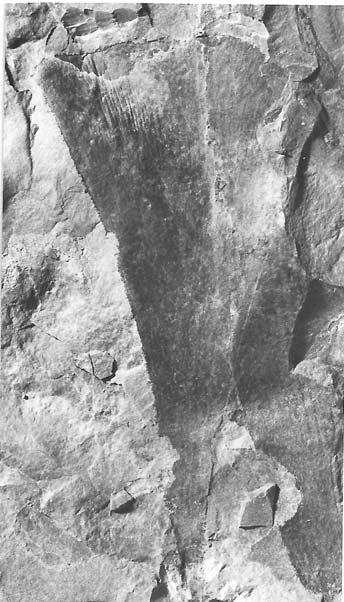
COLOUR PLATES 214 ISSN 2410-4418 Palaeont. afr. (2023) 57 (Special Issue): i–xiv + 1–324
PRE/F/11377b ×2
PRE/F/11404 ×2
PRE/F/11418 ×2
PRE/F/11394 ×2
PRE/F/11412 ×2
PRE/F/11397 ×2
PRE/F/11389a ×2
×2 ×2 ×2 ×2 ×2
PRE/F/11374a
PRE/F/11361 ×2 Lut 311 Hei elo 13 12 11 10 9 8 7 6 5 4 3 2 1 PRE/F/11360 Plate 63 Lutherskop (Lut 311) 12 cm 0
PRE/F/11359
Rochipteris lutifolia
PRE/F/11351 PRE/F/11350b p.94(1) p.94(2)
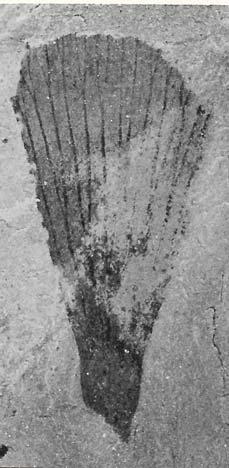

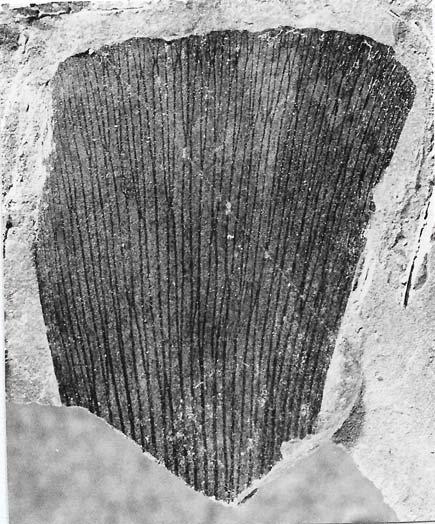
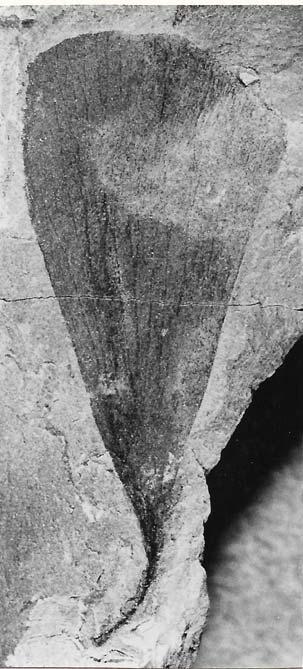


12 cm 0 COLOUR PLATES 215 ISSN 2410-4418 Palaeont. afr. (2023) 57 (Special Issue): i–xiv + 1–324
PRE/F/11351
×5
PRE/F/11360
×5
Lut 311 Hei elo
PRE/F/11361
×5
PRE/F/11374a
×5
PRE/F/11389a
×5
PRE/F/11359
Rochipteris lutifolia 6 5 4 3 2 1 Plate 64 Lutherskop (Lut 311)
×5



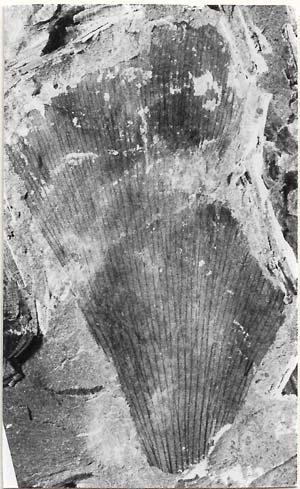

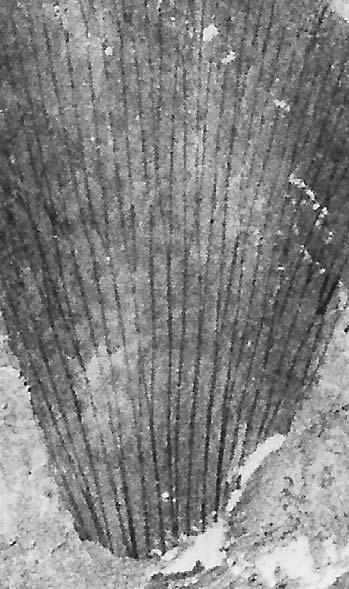
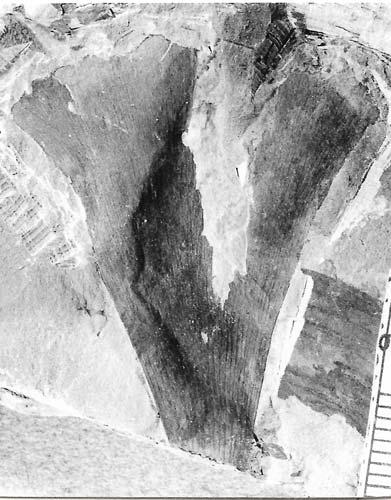
COLOUR PLATES 216 ISSN 2410-4418 Palaeont. afr. (2023) 57 (Special Issue): i–xiv + 1–324
Lutherskop (Lut 311)
PRE/F/11386a
×2
Lut 311 Hei elo
PRE/F/11425
×2
PRE/F/11352 ×2
PRE/F/11386a
×5
Rochipteris lutifolia
×5
PRE/F/11398
×2
7 6 5 4 3 2 1 Plate 65 12 cm 0
×5
PRE/F/11352
PRE/F/11398
Rochipteris lutifolia
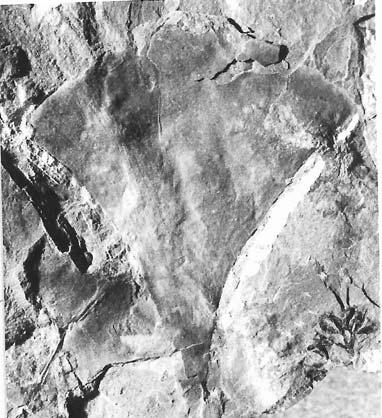
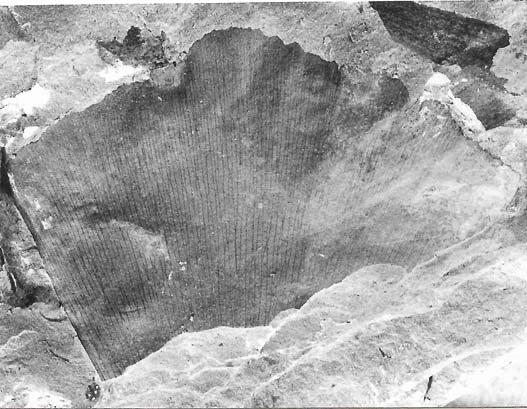



COLOUR PLATES 217 ISSN 2410-4418 Palaeont. afr. (2023) 57 (Special Issue): i–xiv + 1–324 12 cm 0 Lutherskop (Lut 311)
Lut 311 Hei elo
PRE/F/11387a
×2
PRE/F/11401
×2
×5
PRE/F/11388a
×2
PRE/F/11401
5 4 3 2 1 Plate 66
×5
PRE/F/11388a
Rochipteris lutifolia





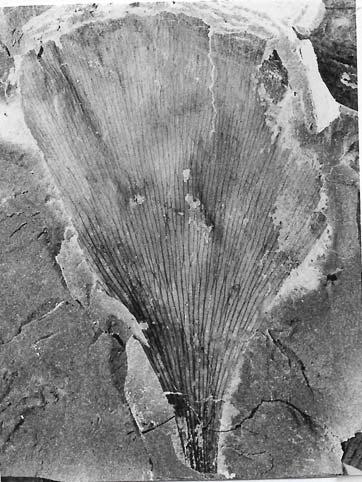
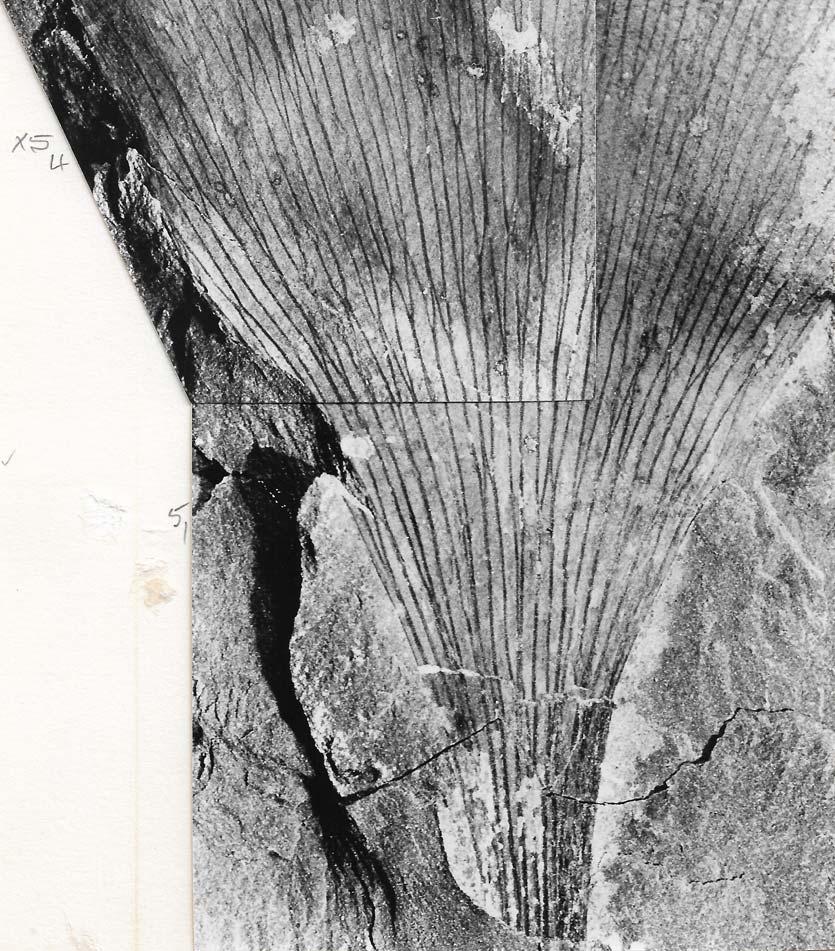
COLOUR PLATES 218 ISSN 2410-4418 Palaeont. afr. (2023) 57 (Special Issue): i–xiv + 1–324
(Lut 311)
Lutherskop
Lut 311 Hei elo
PRE/F/11384a
×2
PRE/F/11384a
PRE/F/11384a
1 3 4
PRE/F/11384a
×1 ×5 ×5
5
2
PRE/F/11384a ×10
×5 PRE/F/11384a
PRE/F/11384a
6 7 Plate 67
cm 0
×5
12
Rochipteris lutifolia

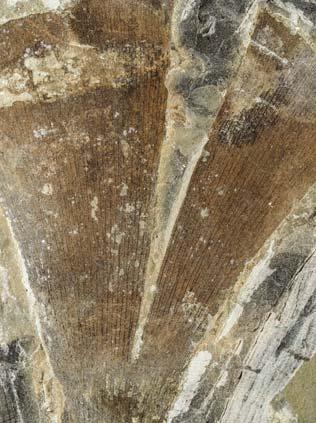
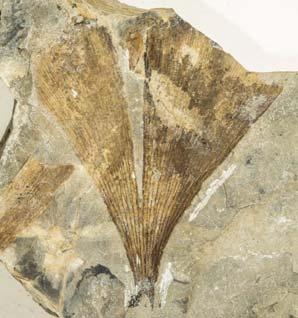
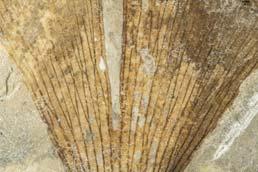
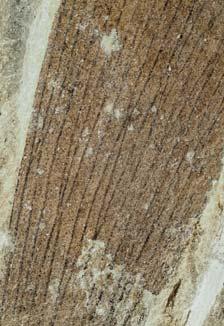
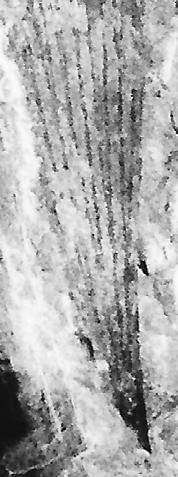
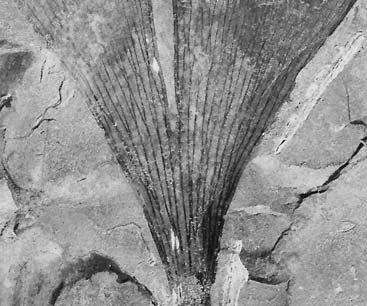
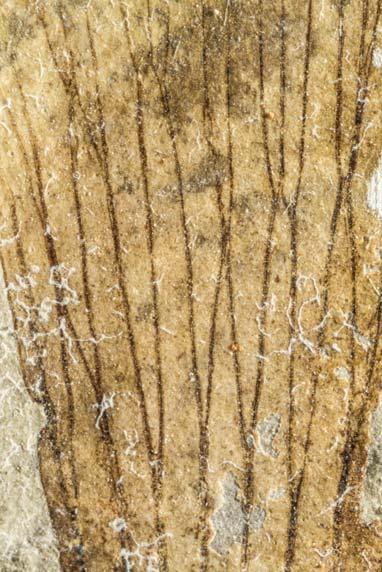

12 cm 0 COLOUR PLATES 219 ISSN 2410-4418 Palaeont. afr. (2023) 57 (Special Issue): i–xiv + 1–324 Lutherskop (Lut 311)
PRE/F/11354
1
×1
PRE/F/11354
2
×2
3
PRE/F/11354 ×5
PRE/F/11354
×5
PRE/F/11355a
PRE/F/11355a
PRE/F/11355a
×2
5 6 8
×10
×1
PRE/F/11355a
×5
PRE/F/11355a ×2
4 7 9 Plate 68
Lut 311 Hei elo

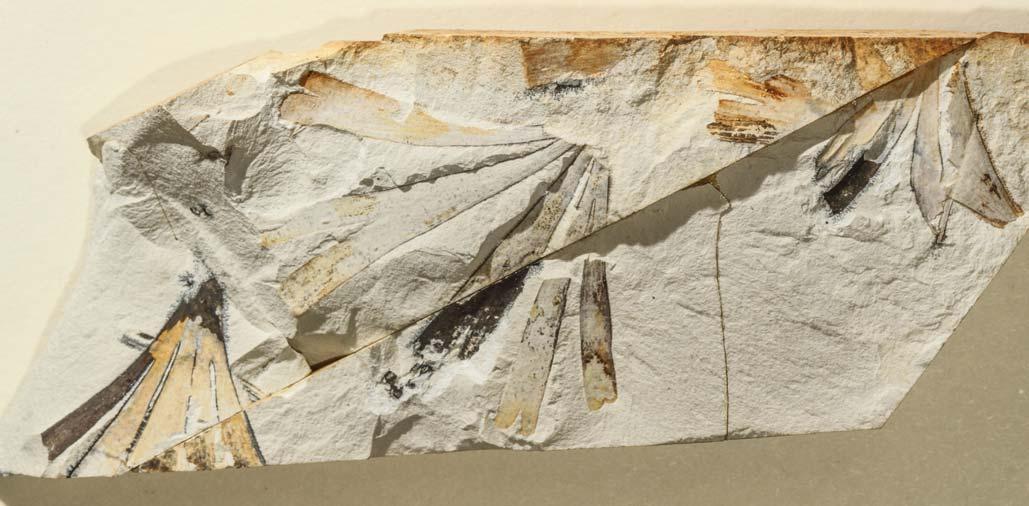

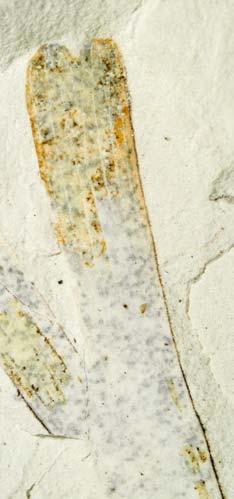

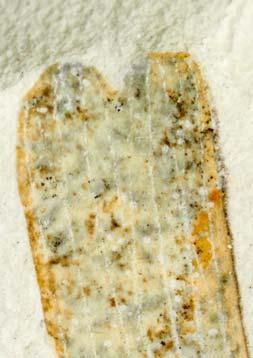

COLOUR PLATES 220 ISSN 2410-4418 Palaeont. afr. (2023) 57 (Special Issue): i–xiv + 1–324
Kroon
Konings
(Kon 211)
PRE/F/10302a
PRE/F/10302a
PRE/F/10302b
PRE/F/10302a
×2 ×1 ×5 ×2
Rochipteris rollerii
1 4 5 2
Kon 211 Ast 2pp
7 Plate 69 ×5 3 ×10 PRE/F/10302a 6 12 cm 0 ‘w’
‘y’ ‘w’
‘x’
PRE/F/10302b
×1
‘x’
‘x’ ‘y’
‘x’ ‘w’ ‘x’ ‘x’ ‘x’

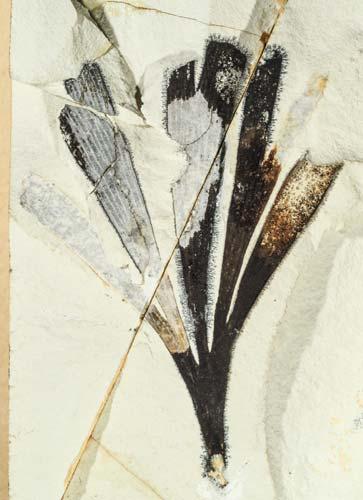



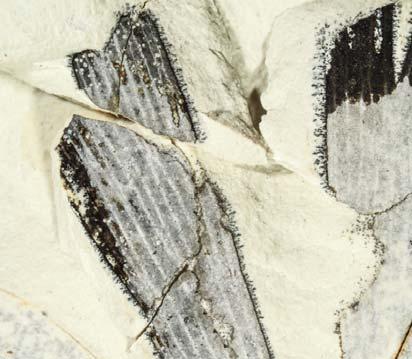

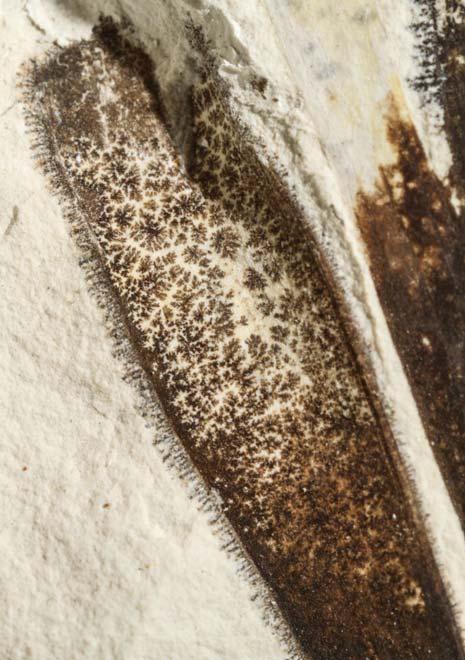
12 cm 0 COLOUR PLATES 221 ISSN 2410-4418 Palaeont. afr. (2023) 57 (Special Issue): i–xiv + 1–324 Konings Kroon (Kon 211)
×1
PRE/F/10302b
×5
Rochipteris rollerii
6
2 4 Plate 70
Kon 211 Ast 2pp
×2
×10
5
PRE/F/10302b
PRE/F/10302b ‘z’(b) 1
×1
(reverse side of slab)
PRE/F/10302b ‘z’(b)
3 8
PRE/F/10302b ‘z’(b)
×2 ×10
(reverse side of slab)
7
PRE/F/10302b ‘z’(b)
×5
PRE/F/10302b ‘z’(a) (reverse side of slab)
*1 *1
*2 *2
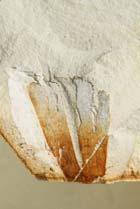
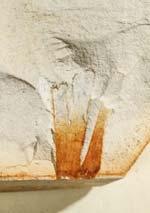

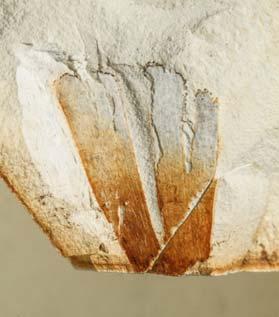
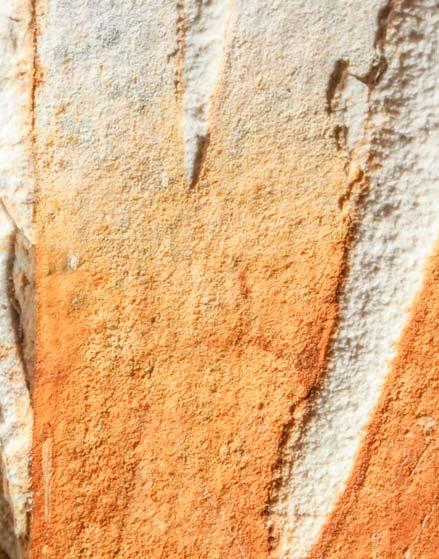

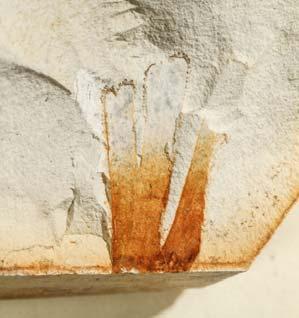

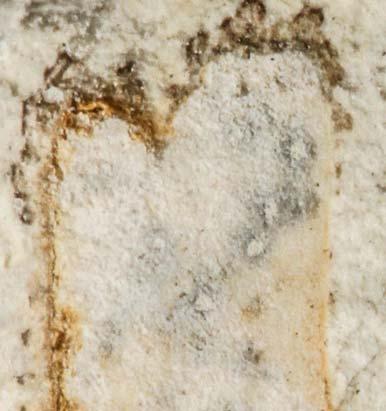
COLOUR PLATES 222 ISSN 2410-4418 Palaeont. afr. (2023) 57 (Special Issue): i–xiv + 1–324
×2
Konings Kroon (Kon 211)
PRE/F/10294b
×5
PRE/F/10294b
PRE/F/10294b
3 4 5 6 8 Plate 71 ×20 1 2 ×1 ×1
7 9 ×10 PRE/F/10294b 12 cm 0
Kon 211 Ast 2pp
Rochipteris rollerii
×20 PRE/F/10294b
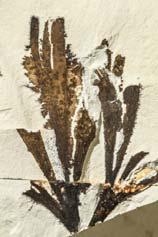
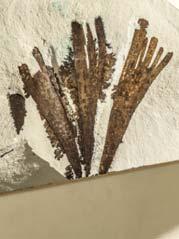
Rochipteris rollerii
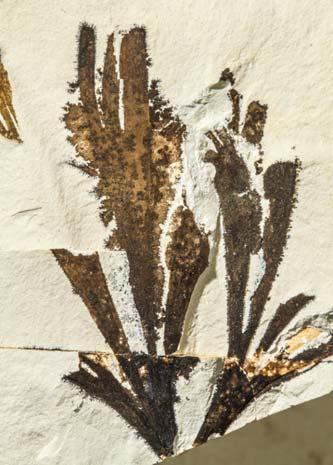




12 cm 0 COLOUR PLATES 223 ISSN 2410-4418 Palaeont. afr. (2023) 57 (Special Issue): i–xiv + 1–324 Konings Kroon (Kon 211) ×2 ×2 ×5 ×5
PRE/F/10293a
PRE/F/10293a
PRE/F/10293b
PRE/F/10293b
3 4 5 6 Plate 72
Kon 211 Ast 2pp
PRE/F/10293a
×1 ×1 1 2 7 ×10
PRE/F/10293b
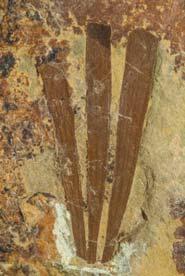

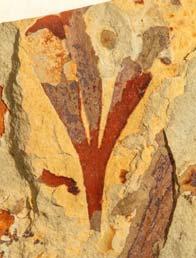

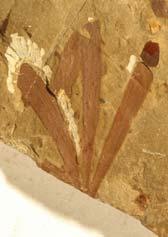
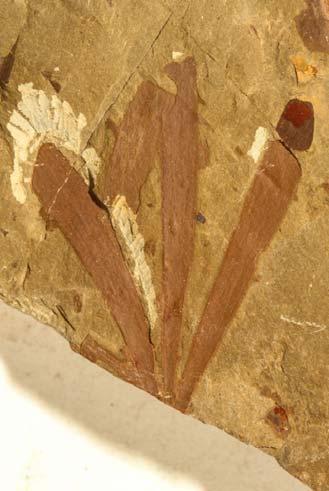



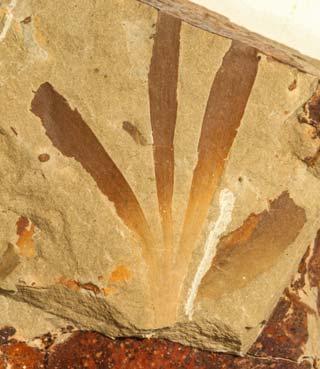

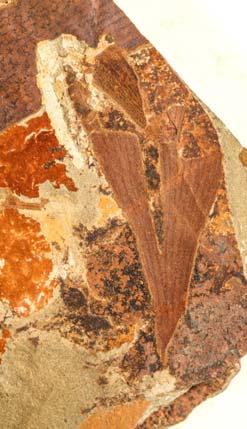


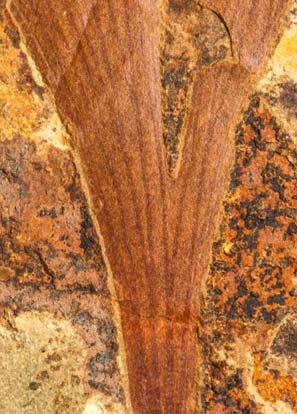


COLOUR PLATES 224 ISSN 2410-4418 Palaeont. afr. (2023) 57 (Special Issue): i–xiv + 1–324 Peninsula (Pen 311)
PRE/F/14134a
PRE/F/16906a
PRE/F/16906a
PRE/F/16906b
PRE/F/16906b
PRE/F/16903a
PRE/F/16903a
PRE/F/16905a
×5 Rochipteris rollerii
311
elo 2 6 7 9 10 12 14 15 17 4 Plate 73
PRE/F/16905b
×10 ×2 ×2 ×2 ×2 ×2 ×2 ×5 ×2
Pen
Hei
×1 ×1 ×1 ×1
×1 1 13 11 8 5 3 ×10
PRE/F/16904a
×1
16 12 cm 0
PRE/F/16906a

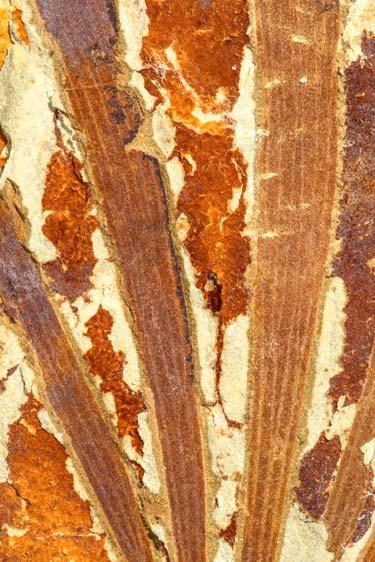



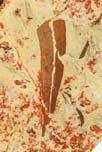



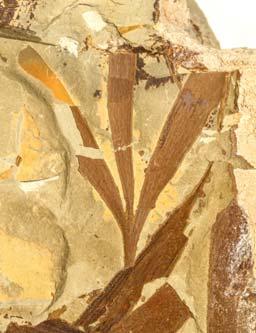
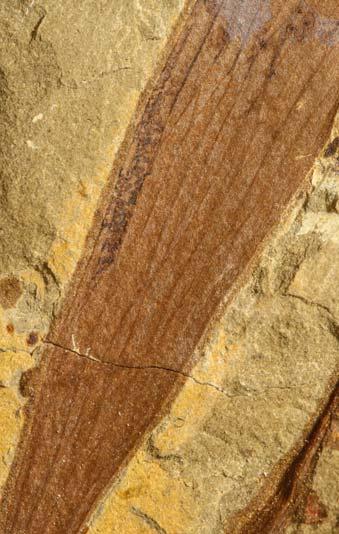
12 cm 0 COLOUR PLATES 225 ISSN 2410-4418 Palaeont. afr. (2023) 57 (Special Issue): i–xiv + 1–324 Peninsula (Pen 311)
PRE/F16925
PRE/F/16908a
PRE/F/16908a
×2
×5
×1
PRE/F/16909a
PRE/F/16909a
×1
×1
×5
PRE/F/16909b
PRE/F/16909b
×5
PRE/F/16910a
×5
Rochipteris
PRE/F/16910a ×1
rollerii
1 2 6 7 8 5 10 11 4 Plate 74 ×5 ×1 3 9
Pen 311 Hei elo

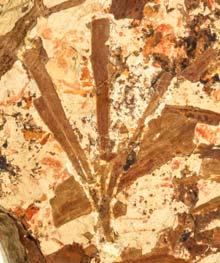


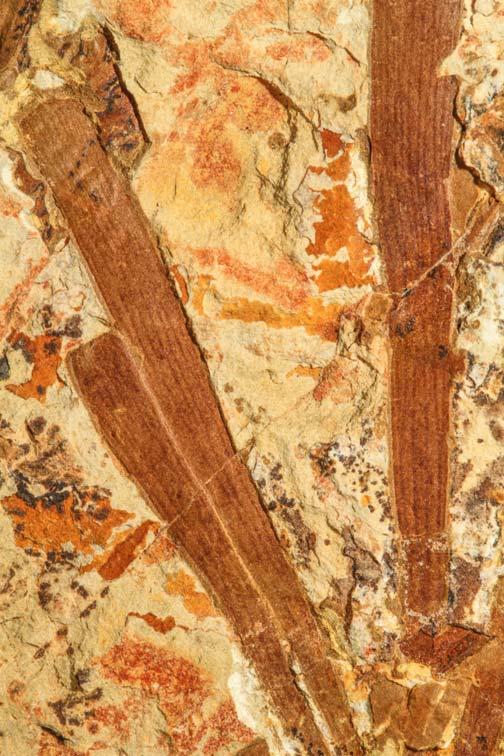




COLOUR PLATES 226 ISSN 2410-4418 Palaeont. afr. (2023) 57 (Special Issue): i–xiv + 1–324
PRE/F/18180
Peninsula (Pen 311)
×5
PRE/F/18186
PRE/F18186
×5
×2
PRE/F/18178 ×1
PRE/F/18179 ×1
PRE/F/18180 ×1
PRE/F/18179
×5
Rochipteris rollerii
2 3 4 5 6 8 7 Plate 75 ×1 1 ×5 9 12 cm 0
Pen 311 Hei elo

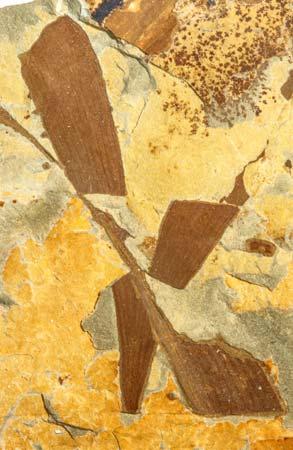

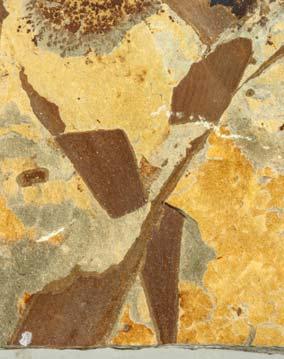


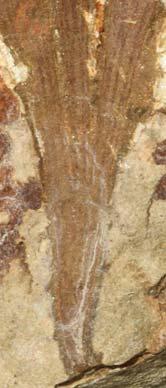


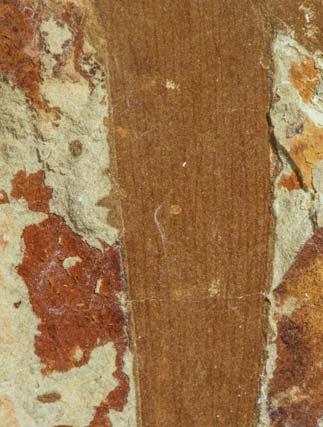
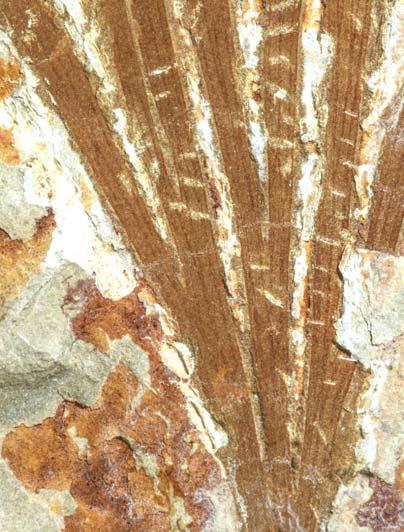
COLOUR PLATES 227 ISSN 2410-4418 Palaeont. afr. (2023) 57 (Special Issue): i–xiv + 1–324 12 cm 0 Peninsula (Pen 311)
PRE/F/16911b
×5 ×2
PRE/F/16911b
×5
PRE/F/16913a
PRE/F/16913b
×2 ×2
PRE/F/16913b ×5
×10
PRE/F/16913a
Rochipteris rollerii
1 2 5 6 10 11 Plate 76
Pen 311 Hei elo
8 ×1 ×1 7 4 ×5 9 ×5 3
PRE/F/16911b



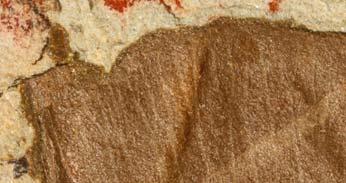
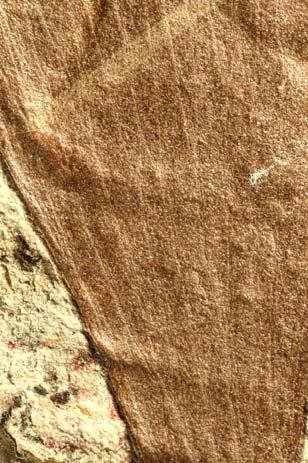



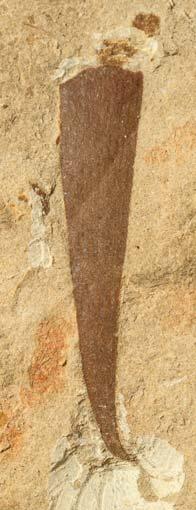


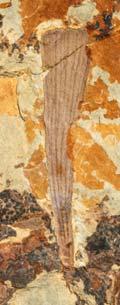

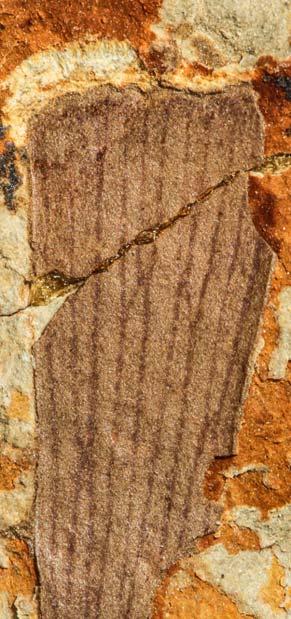

COLOUR PLATES 228 ISSN 2410-4418 Palaeont. afr. (2023) 57 (Special Issue): i–xiv + 1–324
PRE/F/18167a
PRE/F/18167a ×5
PRE/F/18168
PRE/F/18168
×5 ×10
PRE/F/18170a
PRE/F/18170b
PRE/F/18170b
×5
×5
×10
Peninsula (Pen 311)
Rochipteris penensis
3 8 9 5 15 12 13 Plate 77 ×1 ×2 ×1 ×2 ×10 1 2 4 6 7 ×2 ×1 10 11 ×20 14
Pen 311 Hei elo
PRE/F/18170b 12 cm 0
×10
Rochipteris penensis


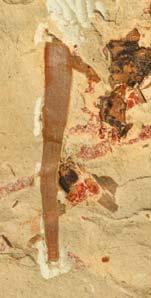


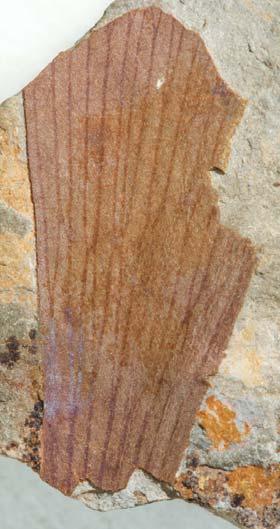
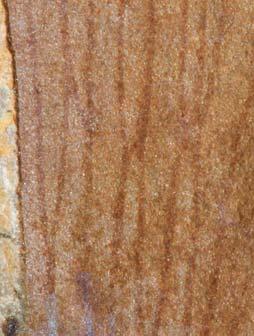





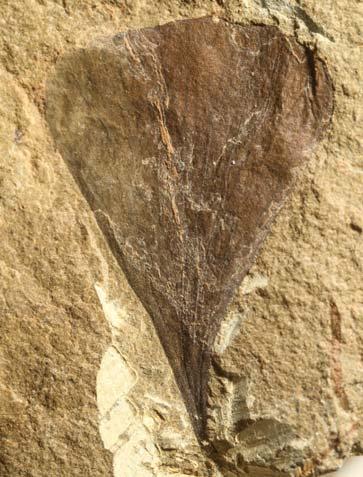
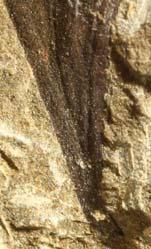
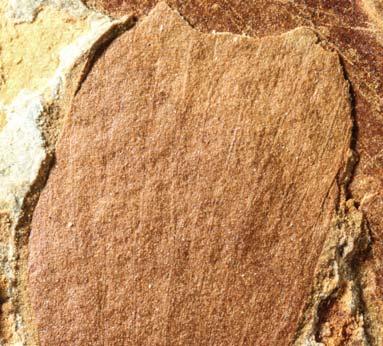
COLOUR PLATES 229 ISSN 2410-4418 Palaeont. afr. (2023) 57 (Special Issue): i–xiv + 1–324 12 cm 0
PRE/F/18166a ×5
PRE/F/18166a
×10
Peninsula (Pen 311)
Rochipteris pusilla
14 15 Plate 78
12 13
Pen 311 Hei elo
×2 ×1
×1
1 2 3
PRE/F/18169
×2 ×5
×2 10 ×1
9 8
11
PRE/F/16915b
×5
×10
PRE/F/16914b
×2 ×5 5 6 4
PRE/F/16914b
×10
×1 7
PRE/F/16914b
Reference palaeodeme (pl. 78)
Kannaskoppianthus aasvoelensis
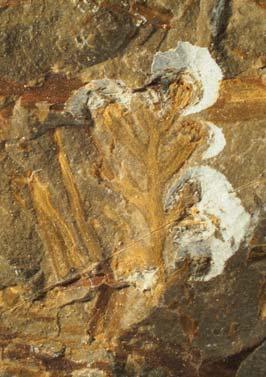

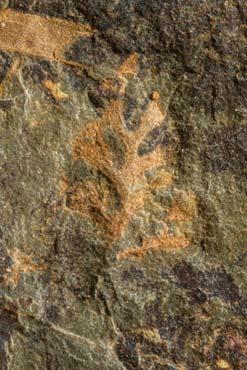


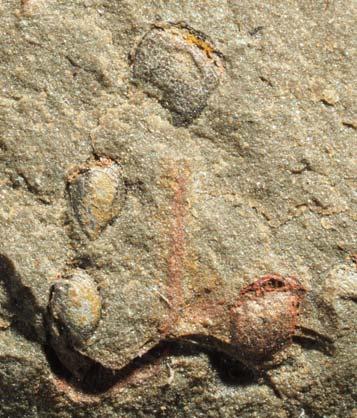
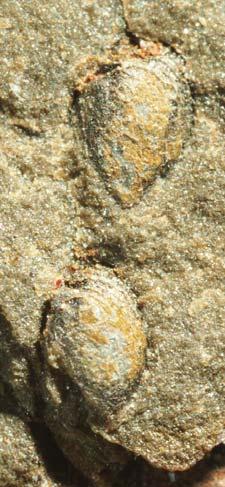
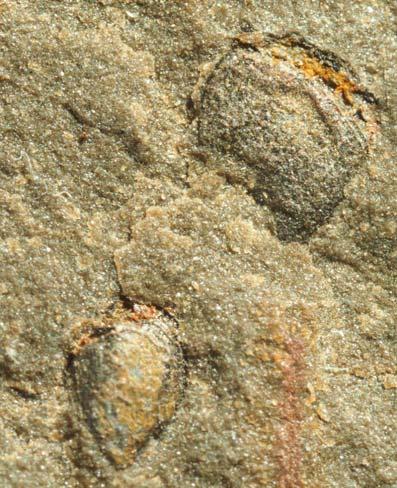
COLOUR PLATES 230 ISSN 2410-4418 Palaeont. afr. (2023) 57 (Special Issue): i–xiv + 1–324
Peninsula (Pen 411)
PRE/F/17938
PRE/F/19663a
PRE/F/17251
×5
PRE/F/17938
×10
PRE/F/19663b
×10
×5
×20
PRE/F/17938
×20
1 3 4 6 7 8
Plate 79
Pen 411 Hei elo
PRE/F/17251
2
×20
×20
5
0
PRE/F/19663b
12 cm
PRE/F/17938, pl. 79(6–8) shows microsporophylls with opercula attached (see p. 38; text-figs 1, 2)
Kannaskoppianthus aasvoelensis
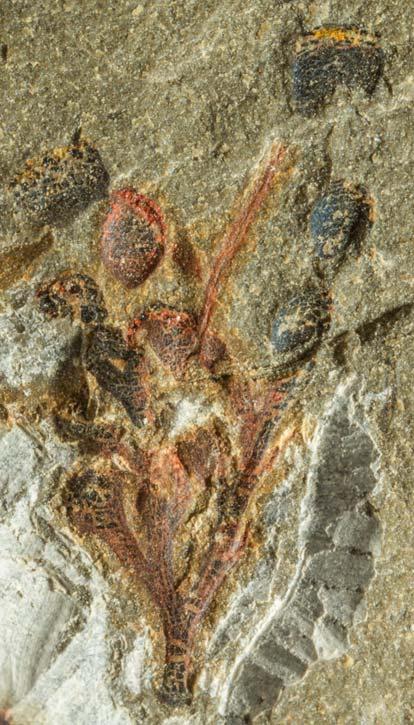
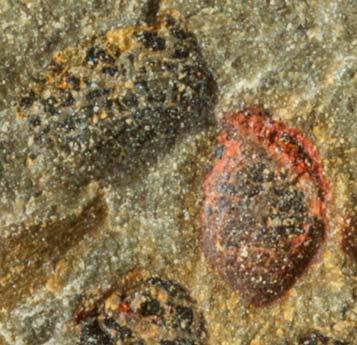


PRE/F/17937, pl. 80(1–7) shows microsporophylls with opercula attached (see p. 38; text-figs 1, 2)
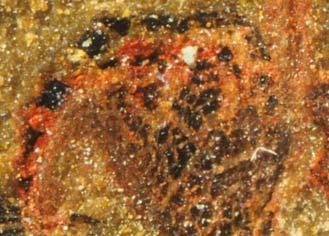
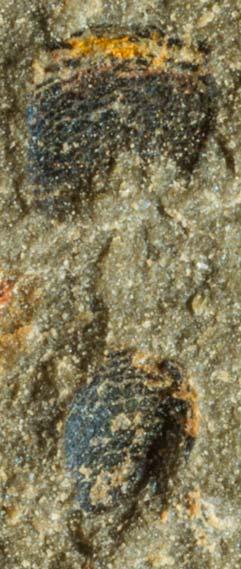
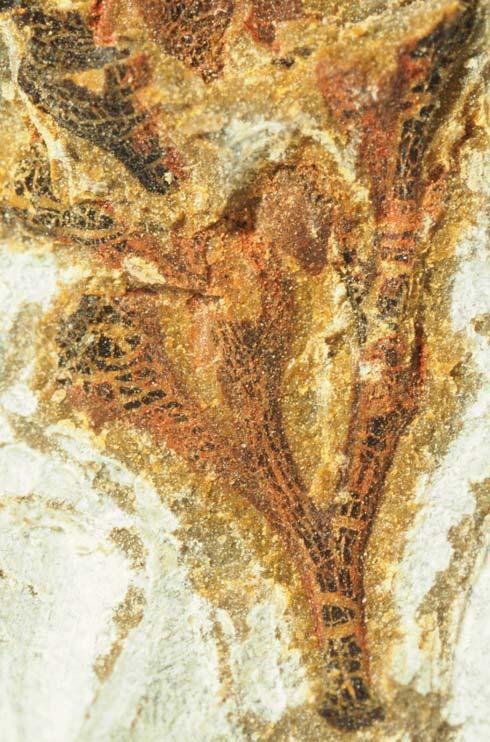
12 cm 0 COLOUR PLATES 231 ISSN 2410-4418 Palaeont. afr. (2023) 57 (Special Issue): i–xiv + 1–324
Peninsula (Pen 411)
×20
PRE/F/17937
PRE/F/17937 ×20
1 5 6
PRE/F/17937
Plate 80
Pen 411 Hei elo
×10
3
PRE/F/17937
×20
×20
×20
PRE/F/17937
2 4 ×40 7
PRE/F/17937
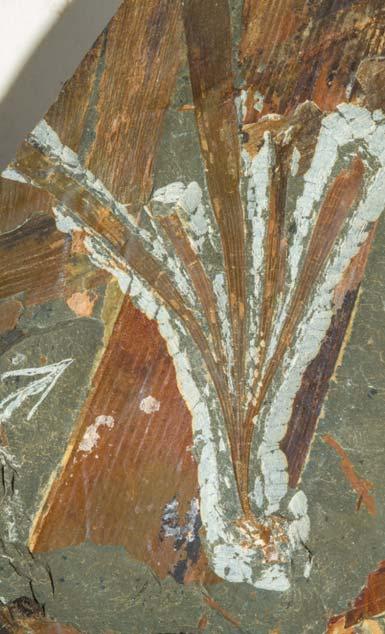
Rochipteris rollerii

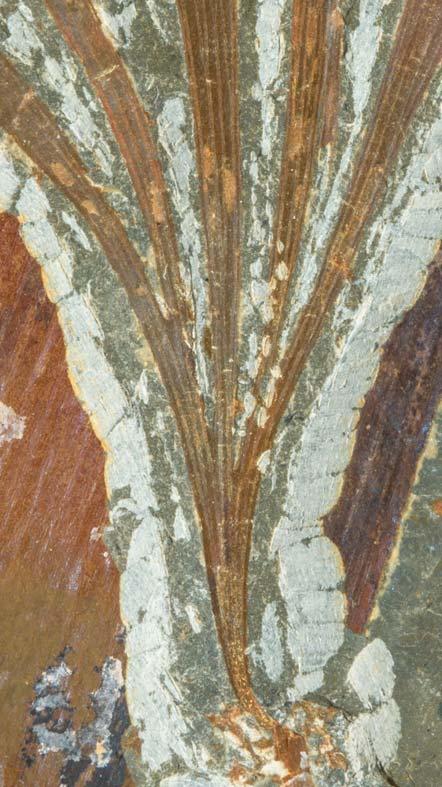
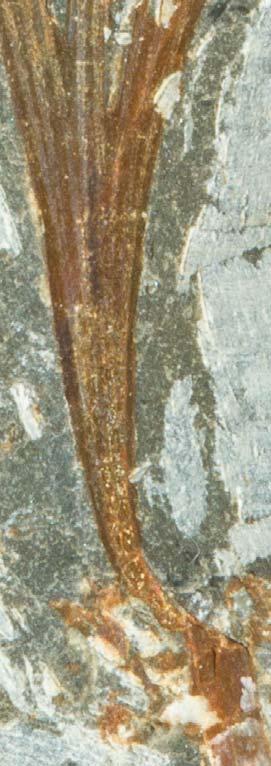

COLOUR PLATES 232 ISSN 2410-4418 Palaeont. afr. (2023) 57 (Special Issue): i–xiv + 1–324 Peninsula (Pen 411)
PRE/F/17948
×2
×10
1 4
PRE/F/17948
12 cm 0 5 ×20 ×5 2 ×10
Pen 411 Hei elo
PRE/F/17948
3 Plate 81
PRE/F/17948
Rochipteris rollerii
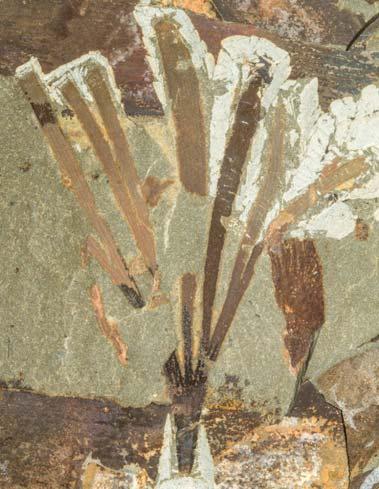
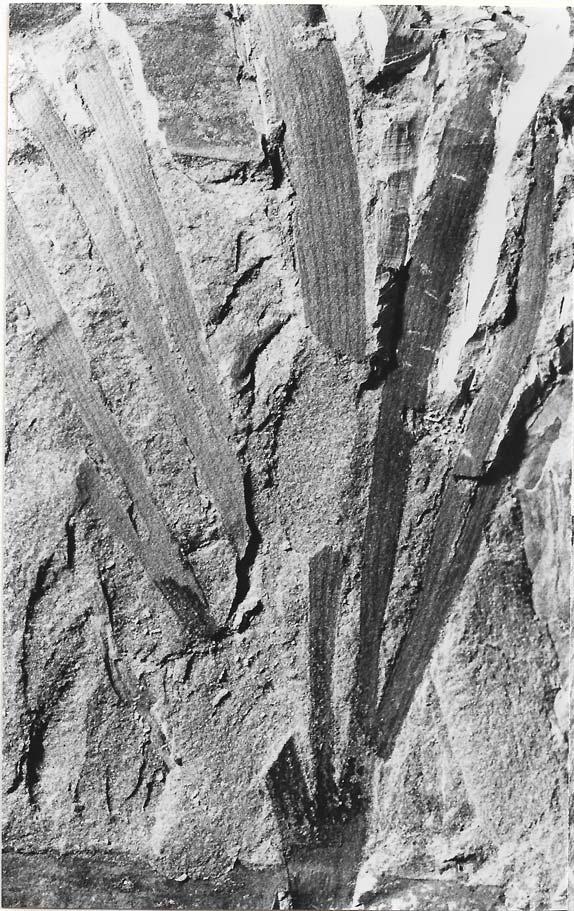
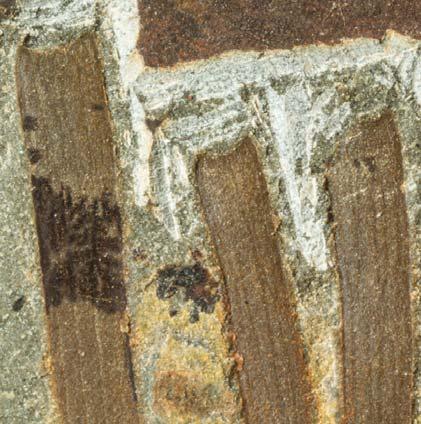
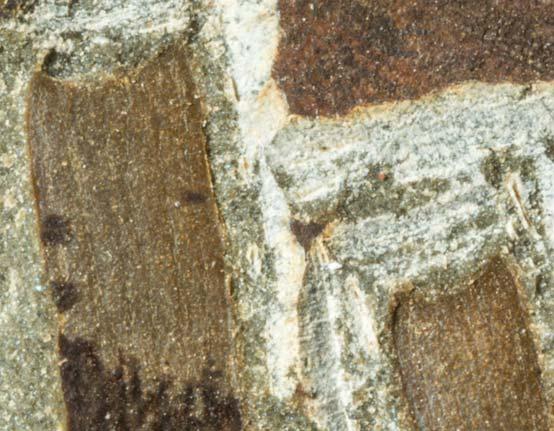


COLOUR PLATES 233 ISSN 2410-4418 Palaeont. afr. (2023) 57 (Special Issue): i–xiv + 1–324 12 cm 0 Peninsula (Pen 411)
×2
1 ×5 5
PRE/F/17978b
4
PRE/F/17978b
×5
PRE/F/17978b
6
×10
×10
2
PRE/F/17978b
3
×20
Plate 82
PRE/F/17978b
PRE/F/17978b

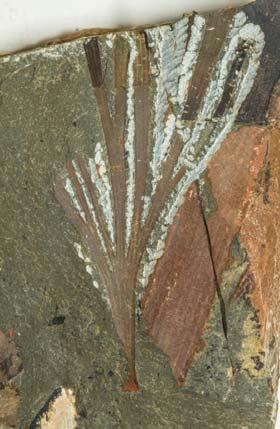





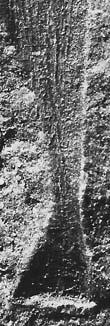
COLOUR PLATES 234 ISSN 2410-4418 Palaeont. afr. (2023) 57 (Special Issue): i–xiv + 1–324
×2
PRE/F/17986b
×10
2 4 ×1 1 3 Rochipteris
PRE/F/17986b
rollerii
PRE/F17986b 6
×10 5 12 cm 0
PRE/F/17986a
×10
8 7 Peninsula (Pen 411) Plate 83
PRE/F/17986a ×10

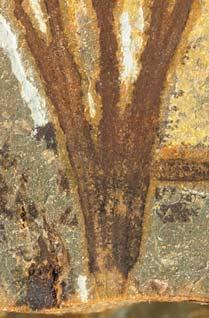
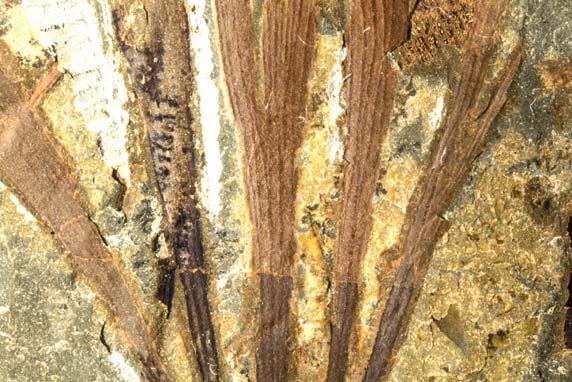

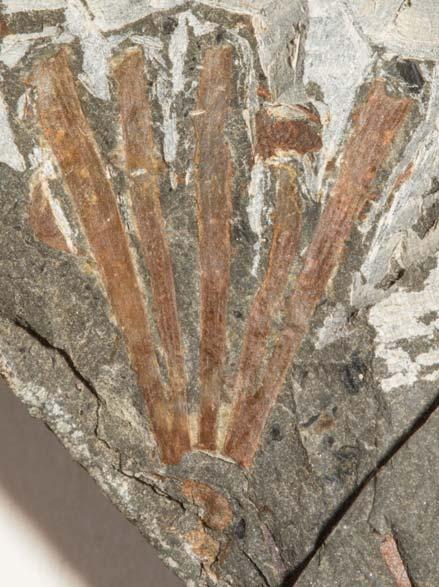
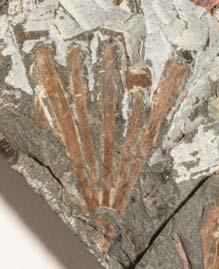
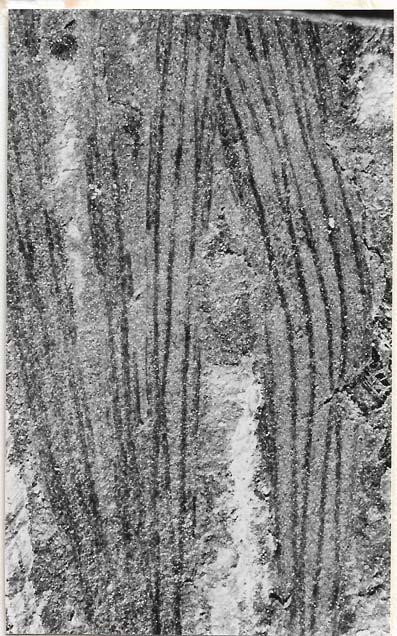
COLOUR PLATES 235 ISSN 2410-4418 Palaeont. afr. (2023) 57 (Special Issue): i–xiv + 1–324 12 cm 0
PRE/F/17983
PRE/F/17983
×2
Rochipteris rollerii 1 2
×5
Pen 411 Hei elo 3
×5
PRE/F17983
5
×10
×5 ×2
6 7 4
PRE/F/17980
×10
PRE/F17983
PRE/F17983
Peninsula (Pen 411) Plate 84
PRE/F/17980






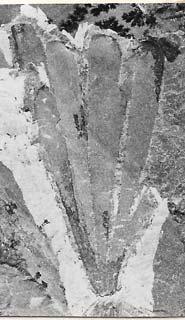


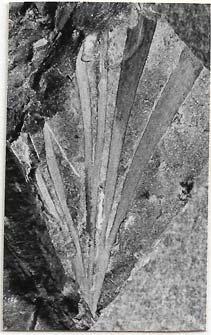
COLOUR PLATES 236 ISSN 2410-4418 Palaeont. afr. (2023) 57 (Special Issue): i–xiv + 1–324
×5 Peninsula (Pen 411)
PRE/F/17045a
2 ×10
Rochipteris rollerii
×2 1 3
PRE/F/17045a
PRE/F/17045a
PRE/F/17045a
×10
PRE/F/17045a
5
×10
4
Pen 411 Hei elo
PRE/F/17045b
6
cm 0 Plate 85
×10
12
×2
PRE/F/17039
×2
PRE/F/17044a
×2
PRE/F/17976
×2 7 8 9 10
PRE/F/17971a
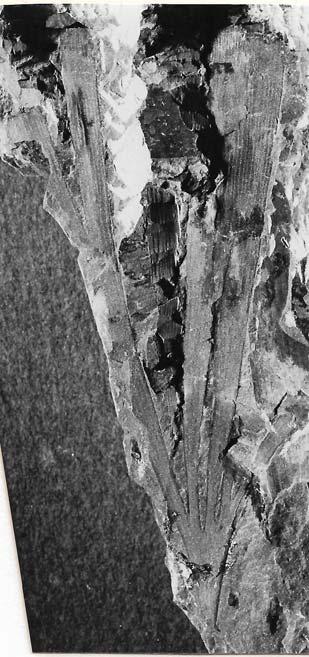

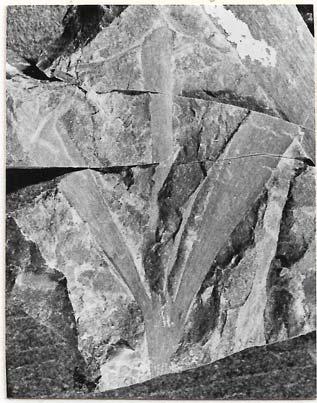
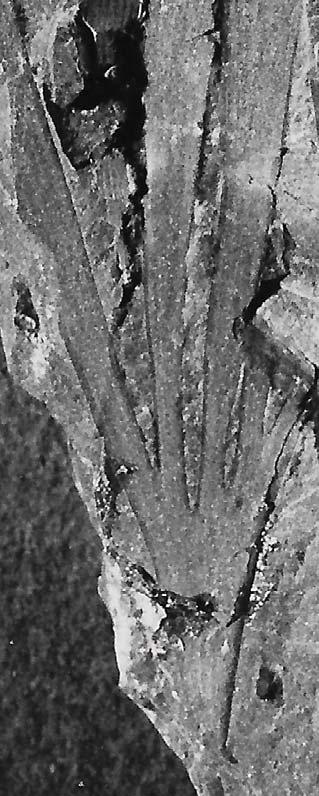
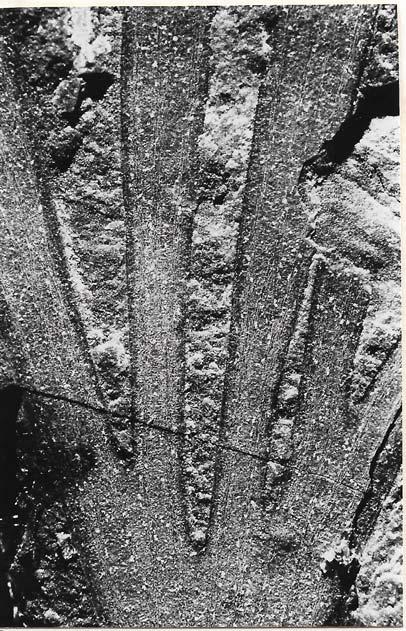
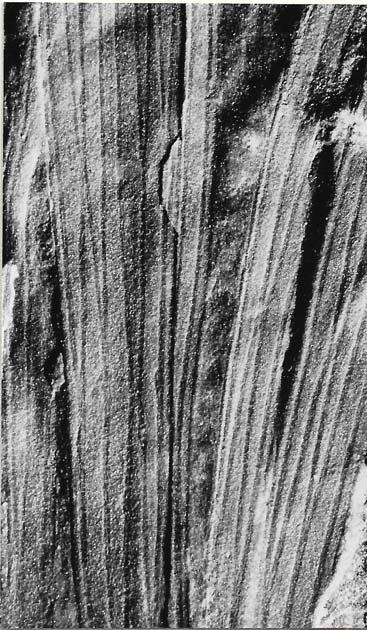

COLOUR PLATES 237 ISSN 2410-4418 Palaeont. afr. (2023) 57 (Special Issue): i–xiv + 1–324 12 cm 0 Peninsula (Pen 411)
PRE/F/17038 ×10
4
Pen 411 Hei elo
Rochipteris rollerii
PRE/F/17046a
7 Plate 86
×10
PRE/F/17977
1
×2
PRE/F/17977
3
×10
PRE/F/17046a
6 2
×10
PRE/F/17977
×5
PRE/F/17048a
5
×2

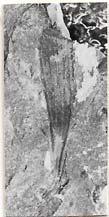


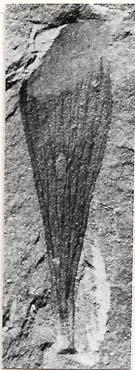




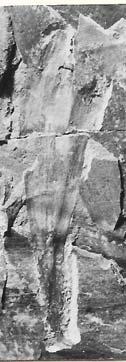
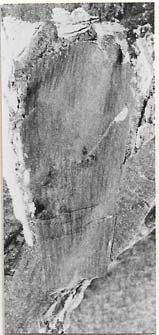

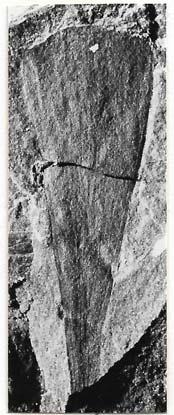
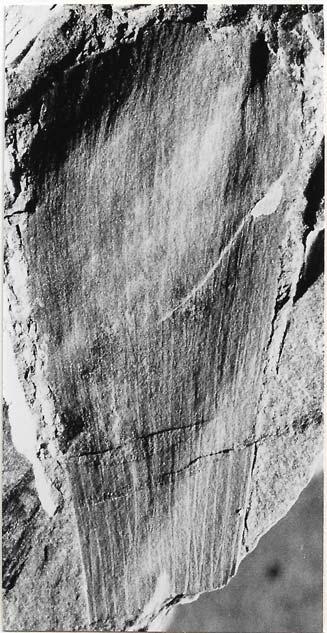
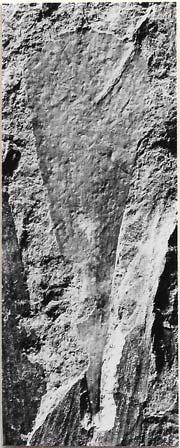

COLOUR PLATES 238 ISSN 2410-4418 Palaeont. afr. (2023) 57 (Special Issue): i–xiv + 1–324
PRE/F/17943b
×5
PRE/F/17050
×5
PRE/F/17047
×5
×5
PRE/F/17032
×5
PRE/F/17946b
PRE/F/17946a
×5
PRE/F/17945
×5
PRE/F/17035
×5
PRE/F/17050 ×2
PRE/F/17944
×2
PRE/F/17047
×2
×2
PRE/F/17035
PRE/F/17032
×2
PRE/F/17945
Peninsula (Pen 411)
×2 PRE/F/17946a ×2
12 cm 0 Rochipteris penensis 1 11 7
×2 8 6 5 3 2 16 15 14 13 12 10 9 4
Pen 411 Hei elo
PRE/F/17943b
Holotype
Plate 87
Holotype
Reference palaeodeme (pls 87–88)
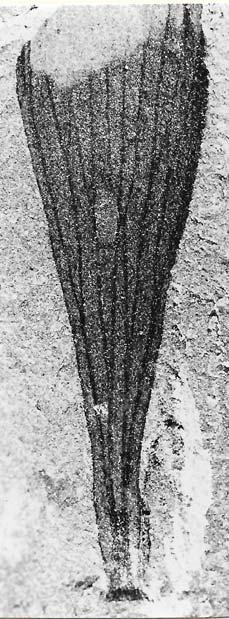
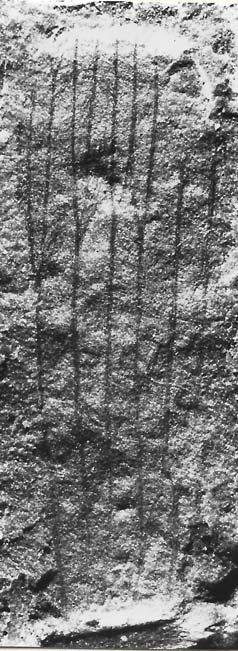
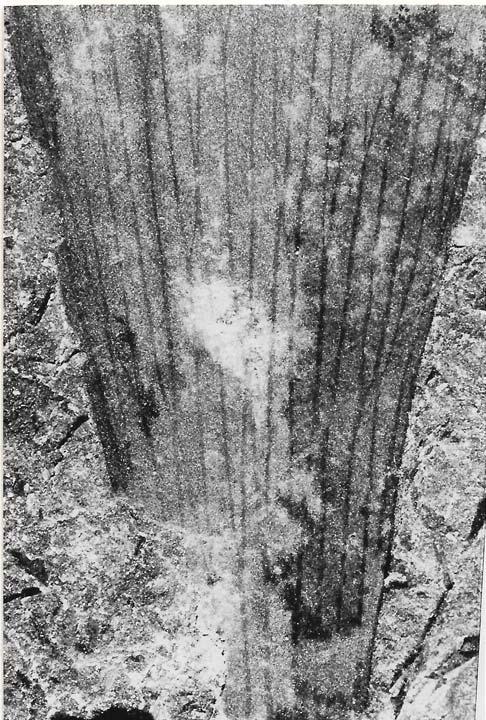
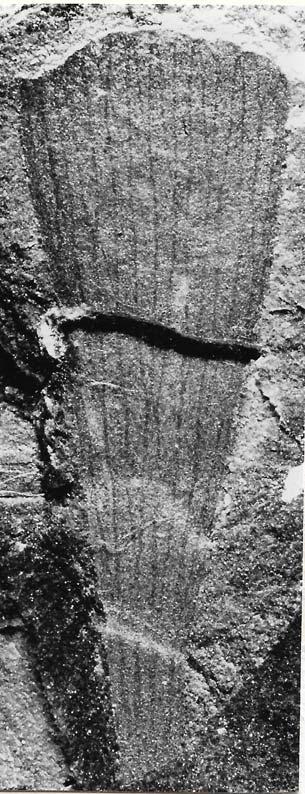



COLOUR PLATES 239 ISSN 2410-4418 Palaeont. afr. (2023) 57 (Special Issue): i–xiv + 1–324 12 cm 0
PRE/F/17050 ×10
PRE/F/17032 ×10
PRE/F/17035
×10
PRE/F/17945 ×10
PRE/F/17946a
Peninsula (Pen 411)
×10
Pen 411 Hei elo
PRE/F/17943b
×10 1 7
Rochipteris penensis 6
5
4 3 2 ×20
PRE/F/17050
Plate 88
Holotype





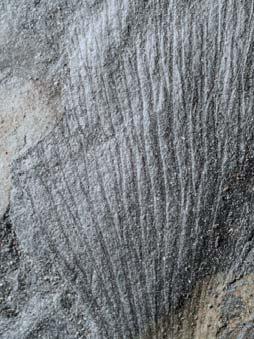

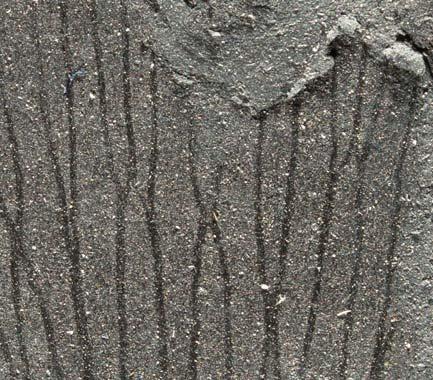
COLOUR PLATES 240 ISSN 2410-4418 Palaeont. afr. (2023) 57 (Special Issue): i–xiv + 1–324
Kapokkraal (Kap 111)
×20
×10
PRE/F/19321
PRE/F/19321
PRE/F/16173
PRE/F/19321
×5 ×2 ×2 ×5
PRE/F/16173
Rochipteris cf. distivena
Plate 89 12 cm 0 7 6 4 3 2 1 ×2 5
Kap 111 Dic/Ris
PRE/F/16173
8
×10




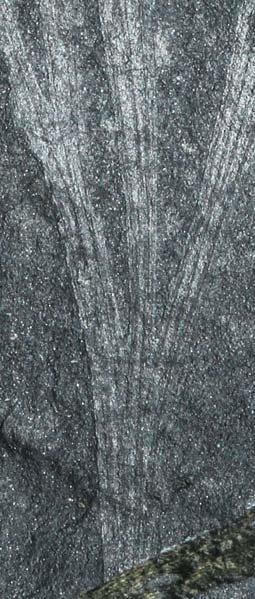

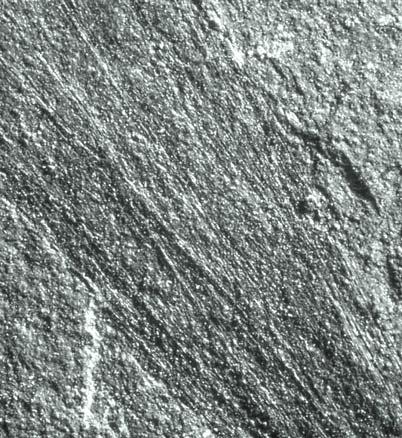

12 cm 0 COLOUR PLATES 241 ISSN 2410-4418 Palaeont. afr. (2023) 57 (Special Issue): i–xiv + 1–324
Kapokkraal (Kap 111)
×10
×20 ×10 ×10
PRE/F/19320a
PRE/F/19320a
PRE/F/16262
PRE/F/16262
PRE/F/16262
PRE/F/19320a
PRE/F/16262
×1
×2
×2
Rochipteris rollerii
Plate 90 ×5 7 5 3 6 4 2 1 8
Kap 111 Dic/Ris
PRE/F/16262


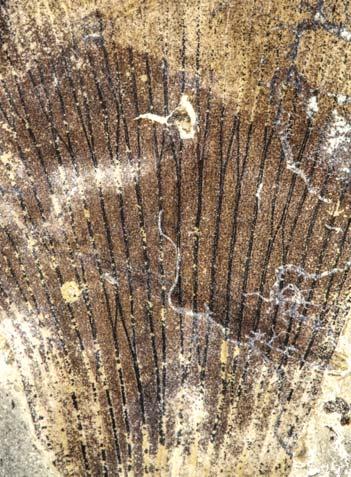

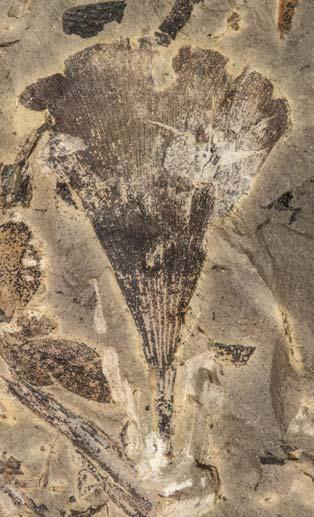
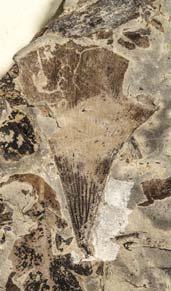
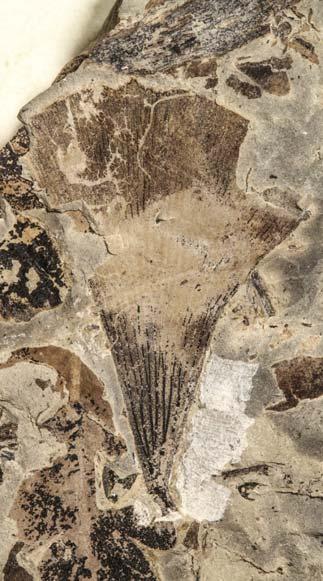

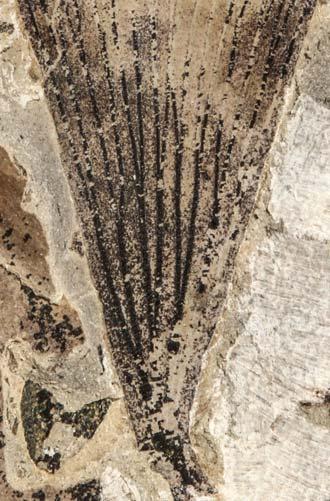

COLOUR PLATES 242 ISSN 2410-4418 Palaeont. afr. (2023) 57 (Special Issue): i–xiv + 1–324
(Nuw
×2 ×2 ×2 ×5 ×5
Nuwejaarspruit
111)
BP/2/6670
BP/2/6725
BP/2/6725
PRE/F/23044
PRE/F/23044
lutifolia 2 5 6 9 10 Plate 91 12 cm 0 ×5
Nuw 111 Dic zub 3 8 ×1
Rochipteris 1 ×1 ×1
BP/2/6670
4 ×10 7
BP/2/6725
BP/2/6725

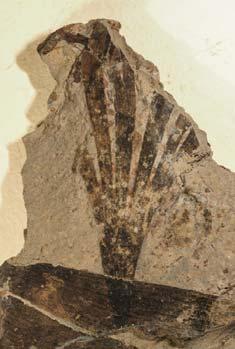
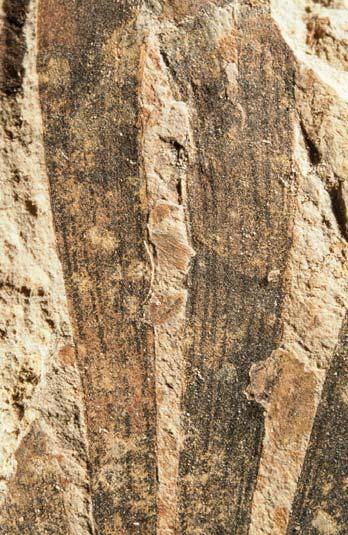


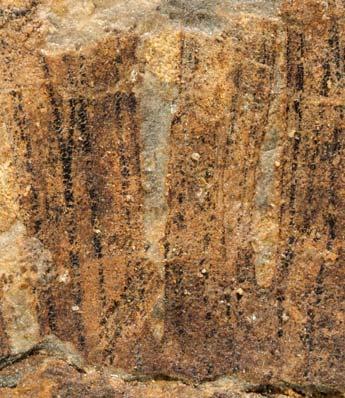

12 cm 0 COLOUR PLATES 243 ISSN 2410-4418 Palaeont. afr. (2023) 57 (Special Issue): i–xiv + 1–324
×5
×2
BP/2/6955
BP/2/6955
BP/2/6955
Winnaarspruit (Win 111)
×10
5 6 7 Plate 92
Win 111 Hei elo
×5
×1
×1
×1
BP/2/6957a
BP/2/6957b
BP/2/6957b
rollerii 1 2 3 4
BP/2/6976
Rochipteris
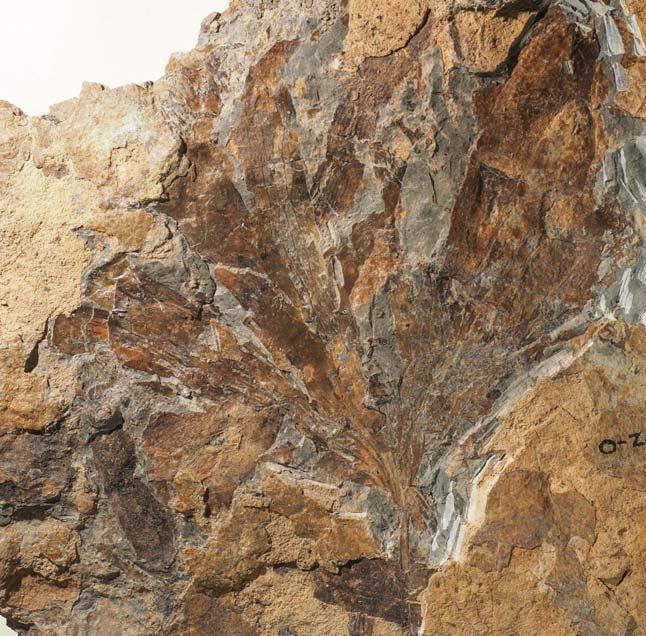




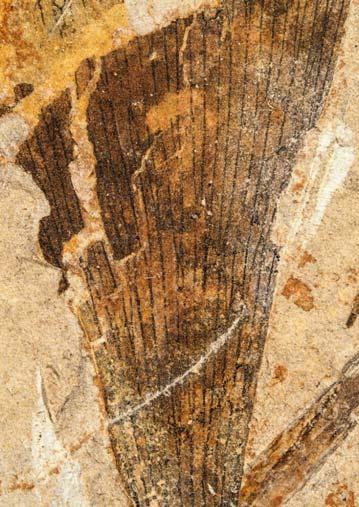
COLOUR PLATES 244 ISSN 2410-4418 Palaeont. afr. (2023) 57 (Special Issue): i–xiv + 1–324 12 cm 0 Winnaarspruit (Win 111)
×2
×5
BP/2/6956
BP/2/6956
4 5 Plate 93
Rochipteris lutifolia
×1
1
BP/2/6954a
×5
BP/2/6954a
×5
Rochipteris cf. sinuosa
3 2
BP/2/6954a
Win 111 Hei elo
6
×20

Rochipteris switzifolia
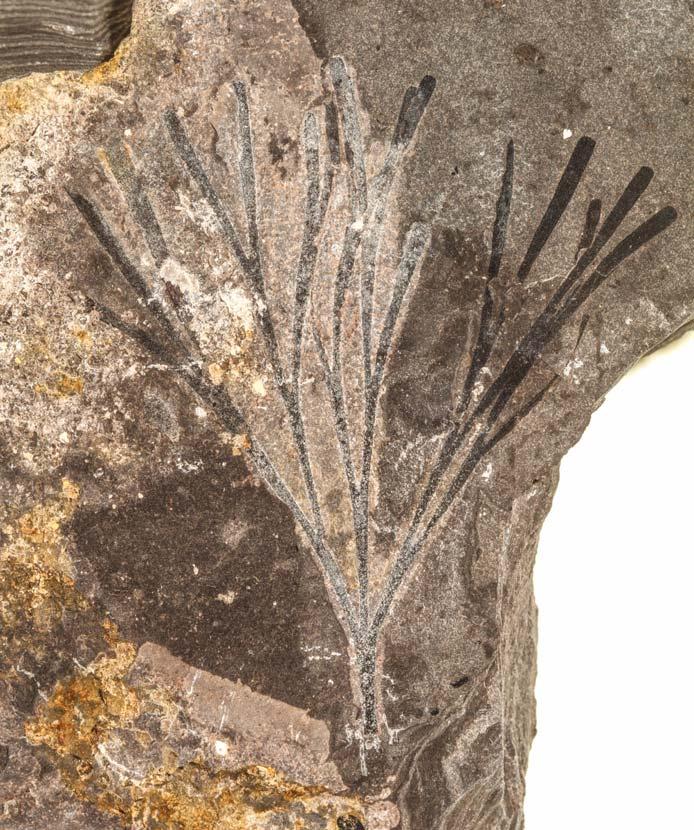

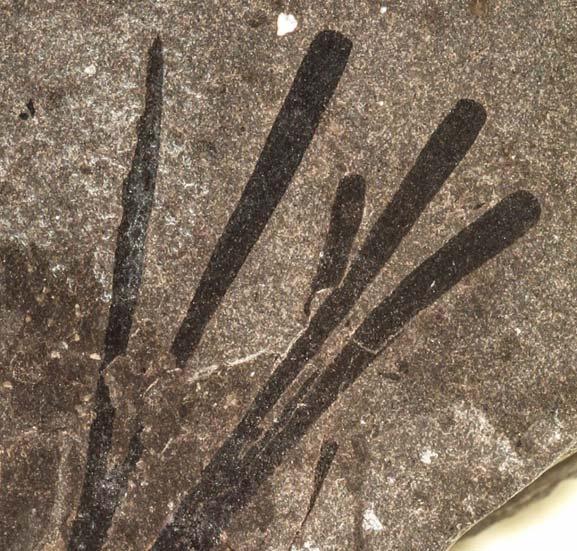
COLOUR PLATES 245 ISSN 2410-4418 Palaeont. afr. (2023) 57 (Special Issue): i–xiv + 1–324 Hlatimbe Valley (Hla 213) Plate 94
12 cm 0
×2 2 4 3 1 ×5
PRE/F/8741
×5
PRE/F/8741
PRE/F/8741
PRE/F/8741
×1
Hla 213 Dic elo

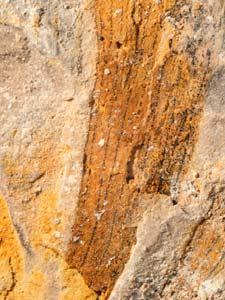


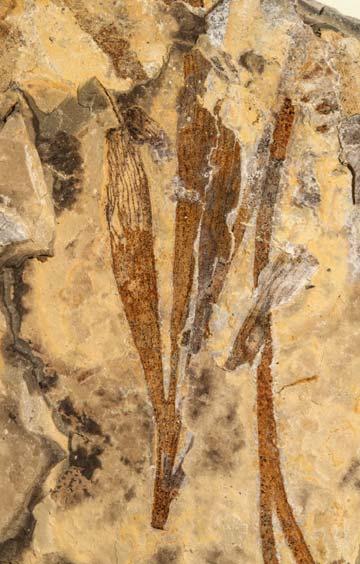



COLOUR PLATES 246 ISSN 2410-4418 Palaeont. afr. (2023) 57 (Special Issue): i–xiv + 1–324
Hlatimbe Valley (Hla 213)
PRE/F/8743
PRE/F/8743
PRE/F/8745
PRE/F/8745
PRE/F/8746
PRE/F/8746
PRE/F/8746
×1 ×5
×5
×5 ×5 ×2 ×2
Hla 213 Dic elo
8 7 5 4 3 2 1
Rochipteris switzifolia
PRE/F/8745
6 Plate 95 12 cm 0
×10
Rochipteris rollerii
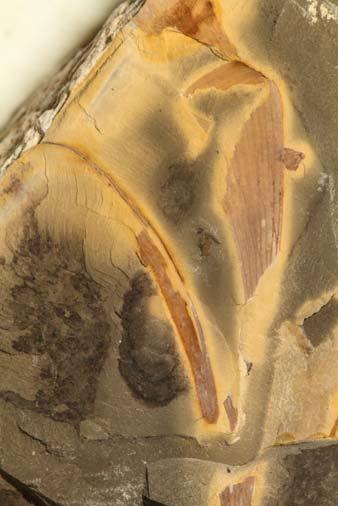

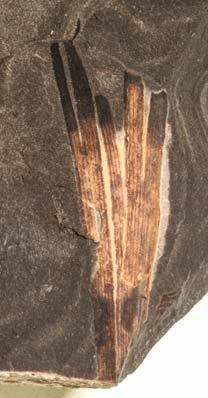

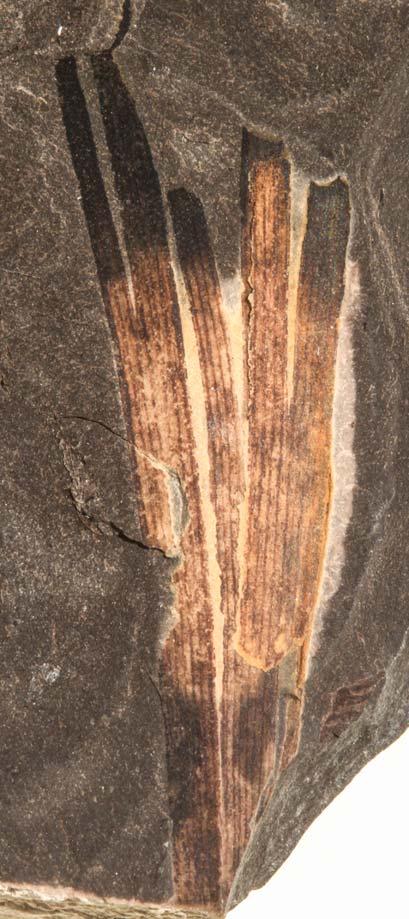


12 cm 0 COLOUR PLATES 247 ISSN 2410-4418 Palaeont. afr. (2023) 57 (Special Issue): i–xiv + 1–324 Hlatimbe Valley (Hla 213)
PRE/F/8744
PRE/F/8744
×2
×10
PRE/F/8671a
PRE/F/8671a
PRE/F/8671a
×10 ×5
×2
Rochipteris rollerii 3 2 1 5 7 Plate 96
Hla 213 Dic elo
6 4
×1
×5
PRE/F/8744


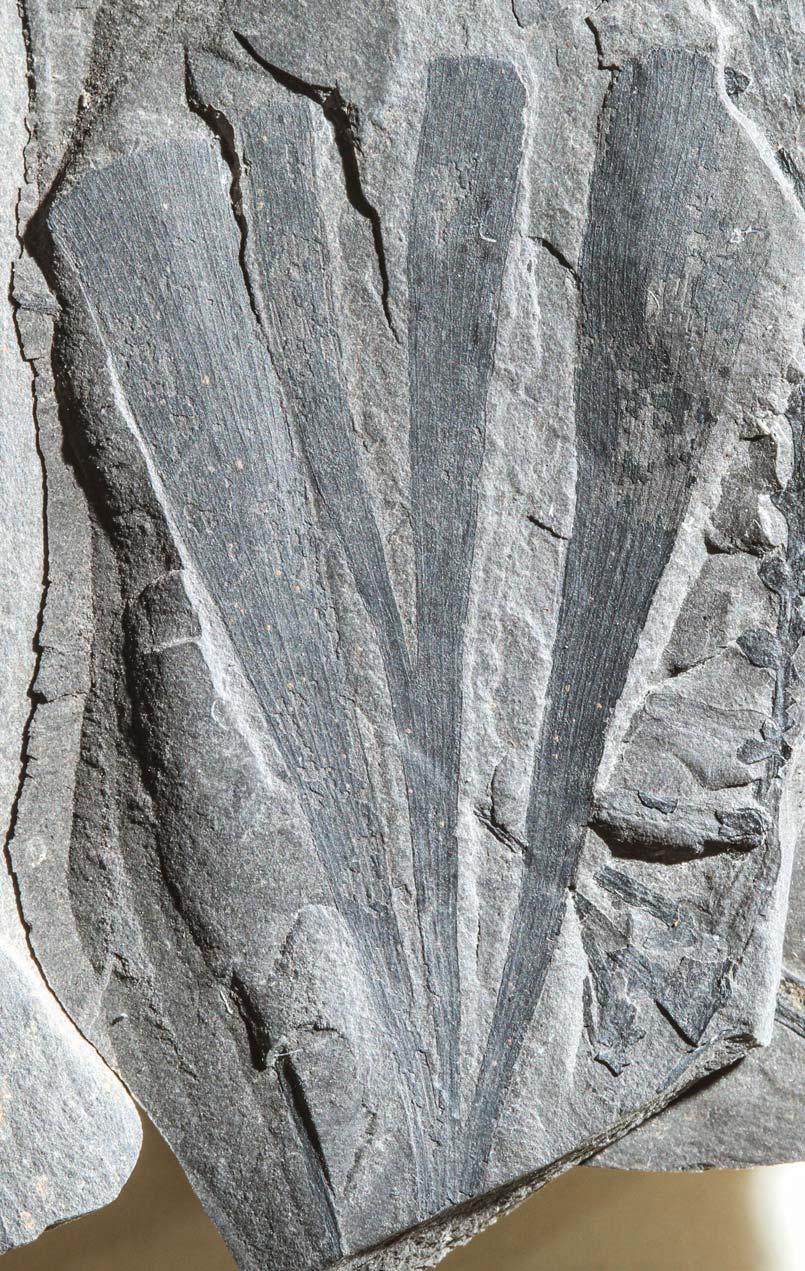
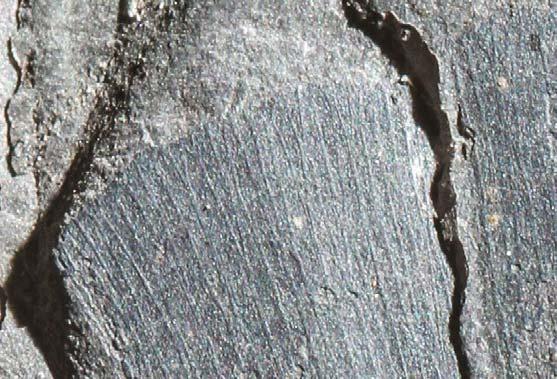
COLOUR PLATES 248 ISSN 2410-4418 Palaeont. afr. (2023) 57 (Special Issue): i–xiv + 1–324
Plate 97
Umkomaas Valley (Umk 111)
PRE/F/9811
×1
×2
PRE/F/9811
×5
×10
Rochipteris rollerii
4 3 2 1
0
Umk 111 Dic 2spp
12 cm

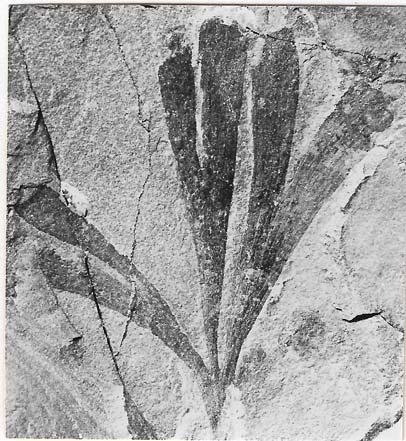
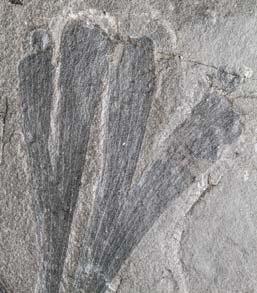


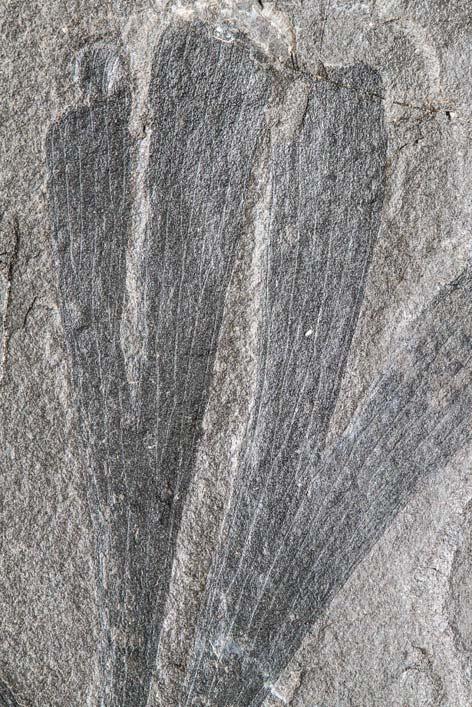
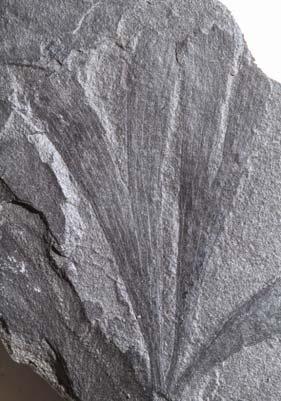


COLOUR PLATES 249 ISSN 2410-4418 Palaeont. afr. (2023) 57 (Special Issue): i–xiv + 1–324 12 cm 0 2
×2 * ×1
Umkomaas Valley (Umk 111) Plate 98
PRE/F/426a
PRE/F/426a
PRE/F/431
PRE/F/431
×5 ×2 ×2 ×1 Rochipteris rollerii Umk 111 Dic 2spp 9 8 6 5 1 ×5 4
* ×5 PRE/F/426a ×2 3
PRE/F/426b
PRE/F/426a
7
PRE/F/435
PRE/F/426b

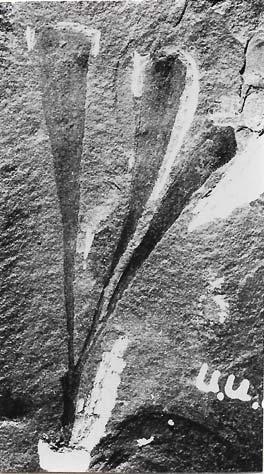

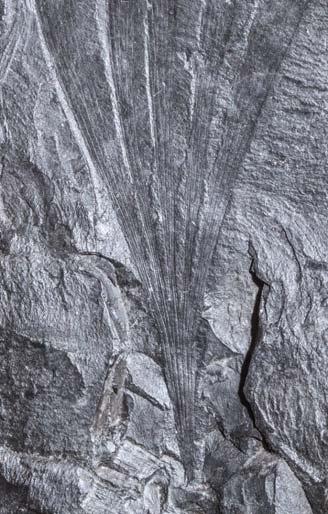



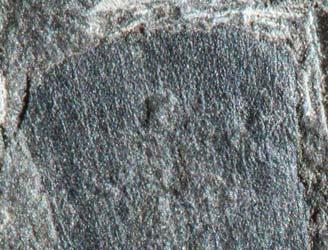

COLOUR PLATES 250 ISSN 2410-4418 Palaeont. afr. (2023) 57 (Special Issue): i–xiv + 1–324
0
12 cm
BP/2/538
BP/2/541
BP/2/540
BP/2/541
BP/2/538
×5 ×2
×2
×1
×5
BP/2/541
×10
Rochipteris rollerii
Plate 99 Umkomaas Valley (Umk 111)
Umk 111 Dic 2spp
×10
9 8 7 6 4 3 1 ×2
BP/2/540
2
BP/2/538
×5 5 *
BP/2/540

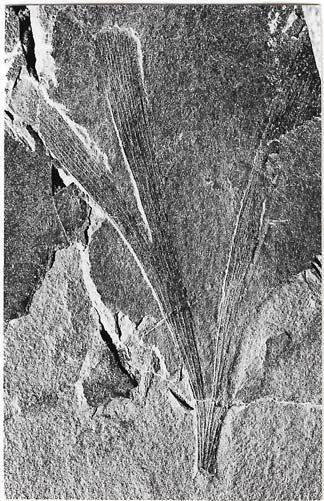



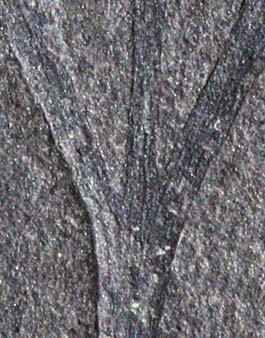
12 cm 0 COLOUR PLATES 251 ISSN 2410-4418 Palaeont. afr. (2023) 57 (Special Issue): i–xiv + 1–324 Umkomaas Valley (Umk 111) Plate 100 PRE/F/9833 ×2
Rochipteris rollerii 4 ×5 PRE/F/9833 ×10 5 6 PRE/F/9833 ×5 2
Umk 111 Dic 2spp
1 ×2
BP/2/537
×2 PRE/F/9833 3 * * *
BP/2/537
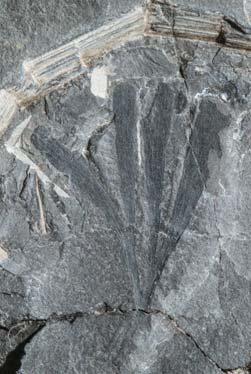
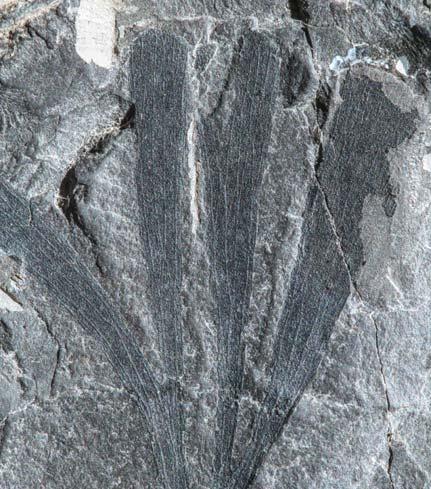



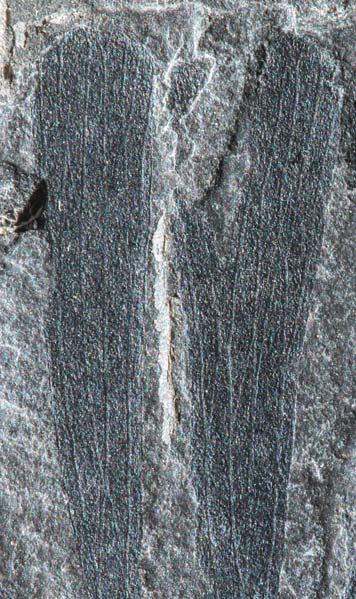
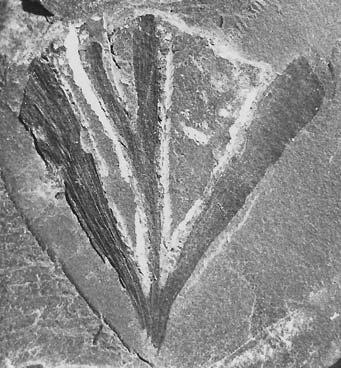
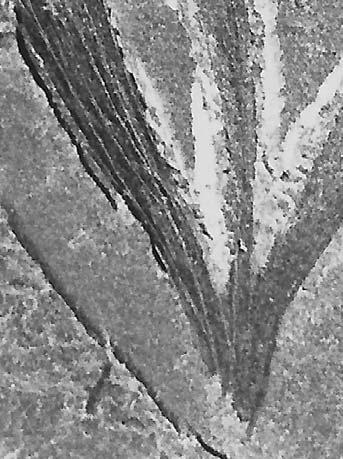
COLOUR PLATES 252 ISSN 2410-4418 Palaeont. afr. (2023) 57 (Special Issue): i–xiv + 1–324 Umkomaas Valley (Umk 111) Plate 101
×5
PRE/F/430 PRE/F/430 ×2
Rochipteris rollerii
12 cm 0 2 1 ×10 3 ×2 PRE/F/18758 * 4 PRE/F/18762 ×2 ×5
8 7 PRE/F/428 PRE/F/428 ×2 ×5 6 5 * * *
Umk 111 Dic 2spp
PRE/F/18762

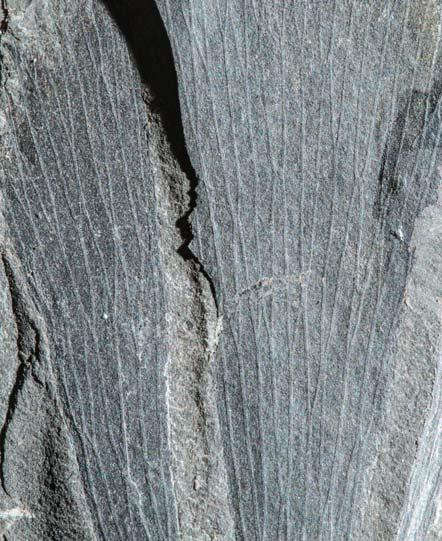




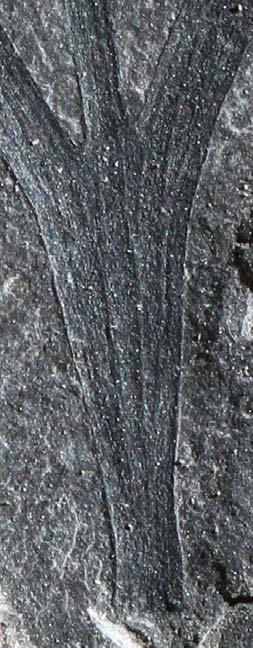
COLOUR PLATES 253 ISSN 2410-4418 Palaeont. afr. (2023) 57 (Special Issue): i–xiv + 1–324 Umkomaas Valley (Umk 111) Plate 102 12 cm 0
PRE/F/6384b
×1
×5
PRE/F/6384b
Rochipteris rollerii
Umk 111 Dic 2spp
×10
×10
PRE/F/9816
×5
7 5 3 2 1
PRE/F/9817
PRE/F/6384b
4
6 ×2 * *
PRE/F/9817 ×2
PRE/F/9816
Rochipteris obtriangulata
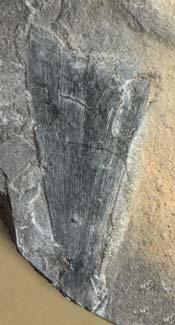

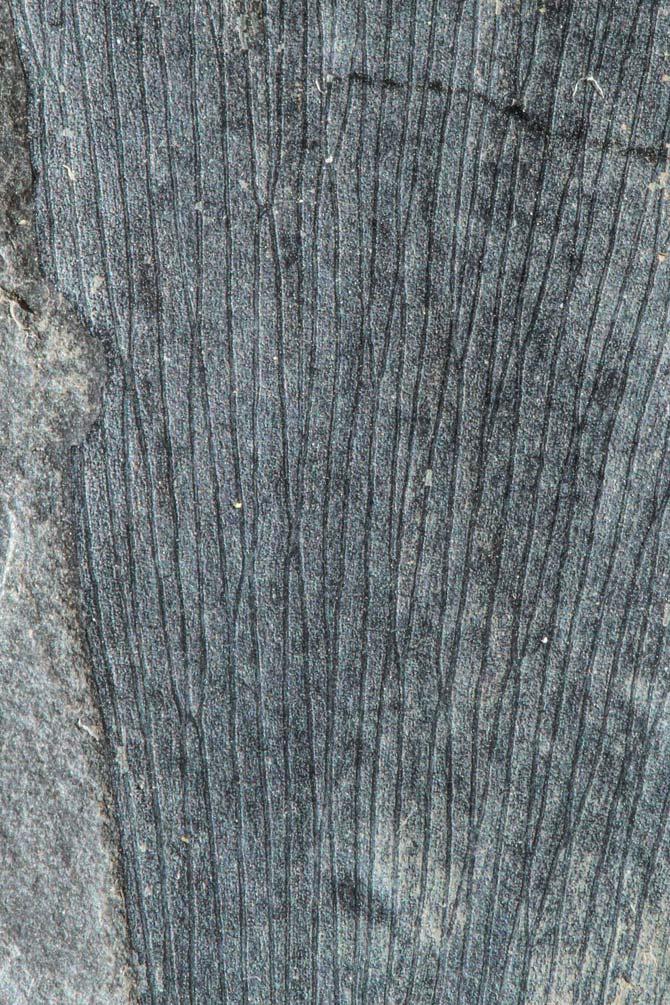
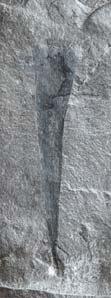

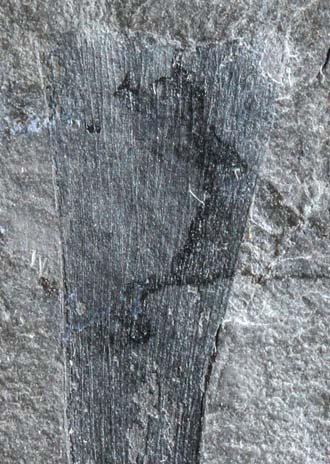
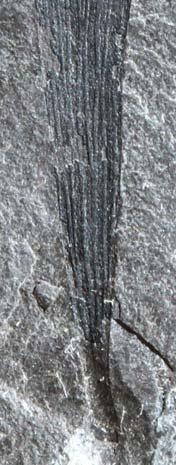

COLOUR PLATES 254 ISSN 2410-4418 Palaeont. afr. (2023) 57 (Special Issue): i–xiv + 1–324
×1 ×5
PRE/F/422
PRE/F/423
PRE/F/423
×1
×5
×5 ×5
Umkomaas Valley (Umk 111) Plate 103 1 7 6 5 4 3 2
PRE/F/422
PRE/F/422 ×10
PRE/F/423
8
12 cm 0
Umk 111 Dic 2spp
×10
Reference palaeodeme (pls 103–106)


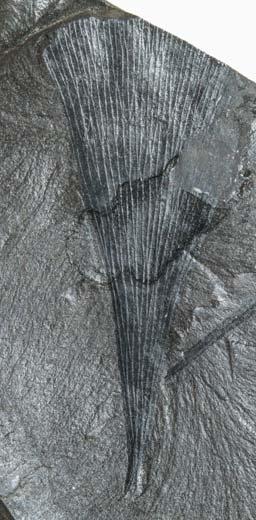

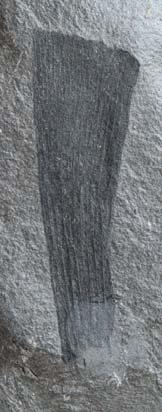



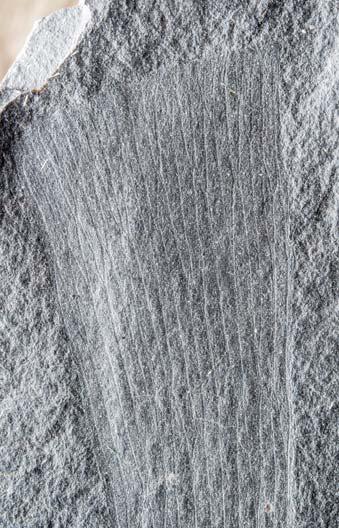
12 cm 0 COLOUR PLATES 255 ISSN 2410-4418 Palaeont. afr. (2023) 57 (Special Issue): i–xiv + 1–324
PRE/F/419
PRE/F/425
PRE/F/425 ×1
×2 ×5
BP/2/115
×5
×5
×5
BP/2/115 ×2
Umk 111 Dic 2spp ×5 ×5 Umkomaas Valley (Umk 111) Plate 104
Rochipteris 9 8 7
obtriangulata 6 5
4 1 3
2
BP/2/115
BP/2/115
PRE/F/419
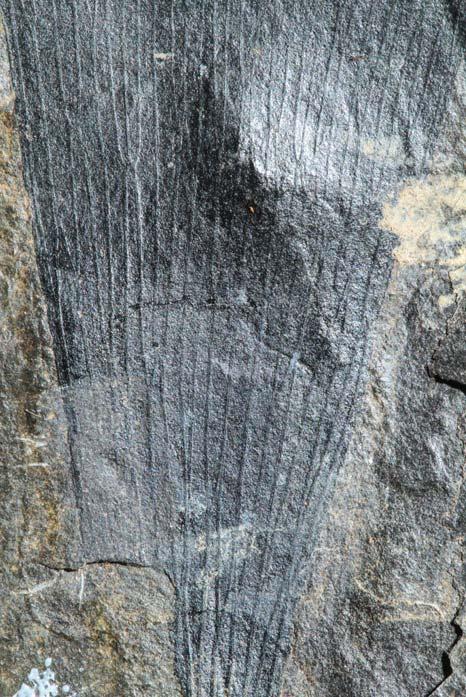
Rochipteris obtriangulata
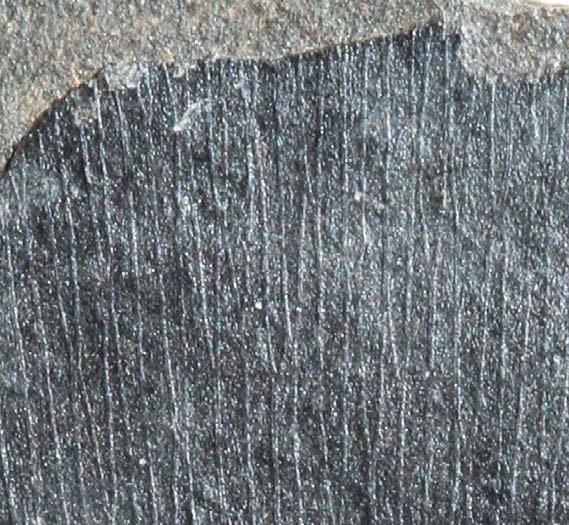
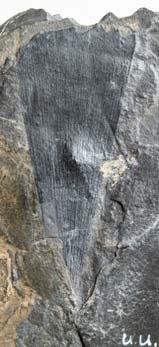

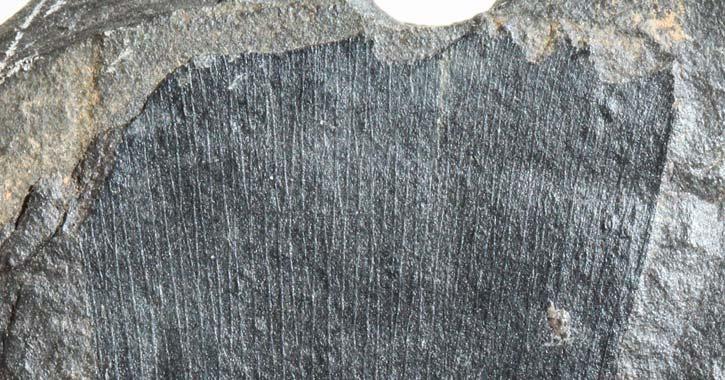

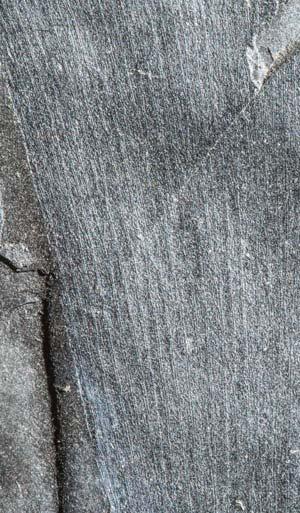
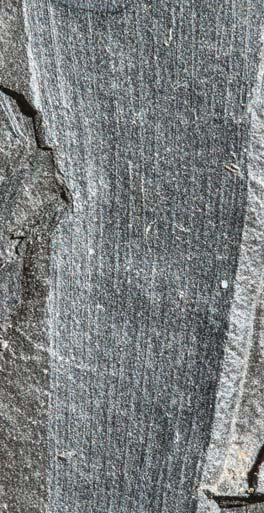

COLOUR PLATES 256 ISSN 2410-4418 Palaeont. afr. (2023) 57 (Special Issue): i–xiv + 1–324
Plate 105
Umkomaas Valley (Umk 111)
PRE/F/6381 ×2
BP/2/546
BP/2/547a
BP/2/547a
×2 ×5 ×5
×5 ×5 ×5
Umk 111 Dic 2spp
BP/2/545
×1 3 9 8 7 4 6 5 2 1 ×10 12 cm 0
BP/2/545

Rochipteris obtriangulata




12 cm 0 COLOUR PLATES 257 ISSN 2410-4418 Palaeont. afr. (2023) 57 (Special Issue): i–xiv + 1–324 Umkomaas Valley (Umk 111) Plate 106
×2
PRE/F/9832
Umk 111 Dic 2spp
×5
×1 3 5 4 2 1
PRE/F/9832
×10 ×10 PRE/F/9832 PRE/F/9832


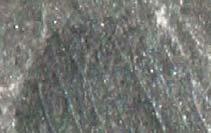
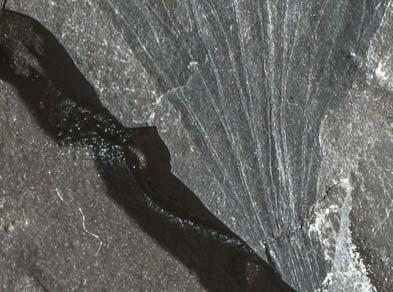



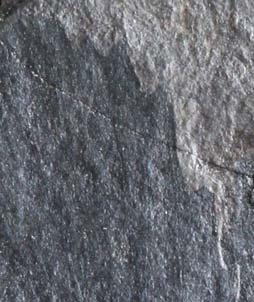
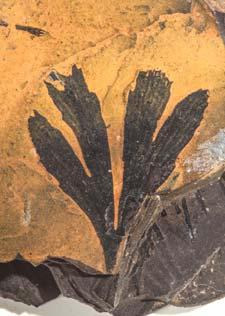
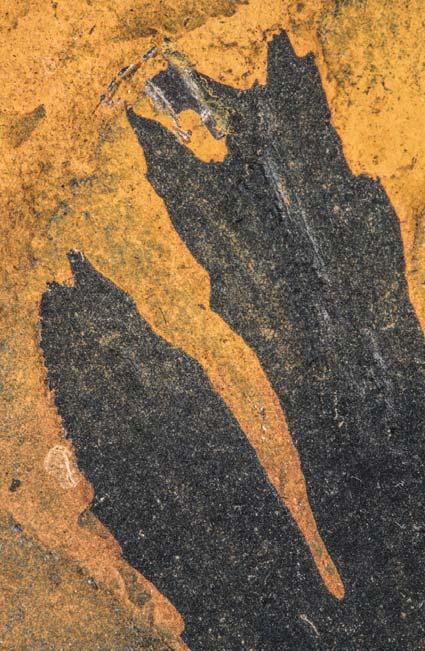
COLOUR PLATES 258 ISSN 2410-4418 Palaeont. afr. (2023) 57 (Special Issue): i–xiv + 1–324
(Umk
Plate 107 12 cm 0
Umkomaas
Valley
111)
BP/2/549
×5
BP/2/549
×1
BP/2/539
×2 Rochipteris cf. sinuosa ×5 ×5
BP/2/539 ×5
BP/2/553 ×1
×5
3 10 9 8 6 4 2 1
BP/2/553
BP/2/539
111 Dic 2spp Umk 111 Dic
BP/2/539
Umk
×5
7
5
BP/2/553
×10
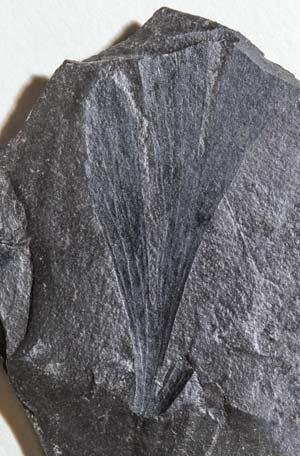

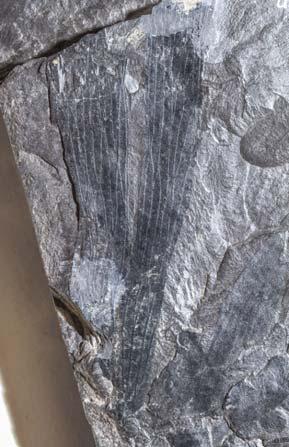
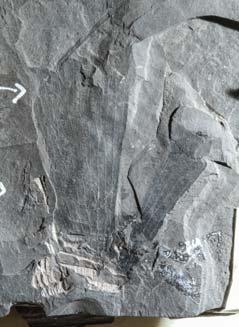
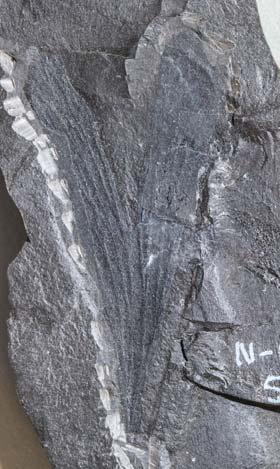




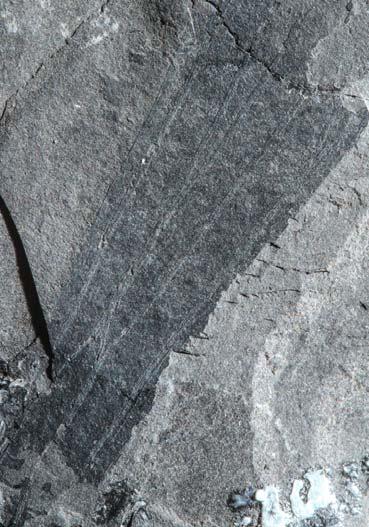
COLOUR PLATES 259 ISSN 2410-4418 Palaeont. afr. (2023) 57 (Special Issue): i–xiv + 1–324 Umkomaas Valley (Umk 111) Plate 108
BP/2/554
BP/2/557
BP/2/557
BP/2/557
BP/2/556
BP/2/555
BP/2/556
BP/2/556
×2 ×1 ×5 ×5 ×2 ×5 ×1
Rochipteris ×5 4 3 2 1 5 6 7 10 9 8 ×5 12 cm 0
Umk 111 Dic 2spp
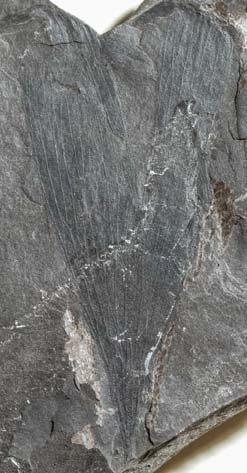



COLOUR PLATES 260 ISSN 2410-4418 Palaeont. afr. (2023) 57 (Special Issue): i–xiv + 1–324
PRE/F/22501
×2
PRE/F/22501
3
×5
Rochipteris cf. sinuosa
Plate 109 4 2 1
Umkomaas Valley (Umk 111)
Umk 111 Dic 2spp
PRE/F/22501
PRE/F/22501 ×5
12 cm 0
×10
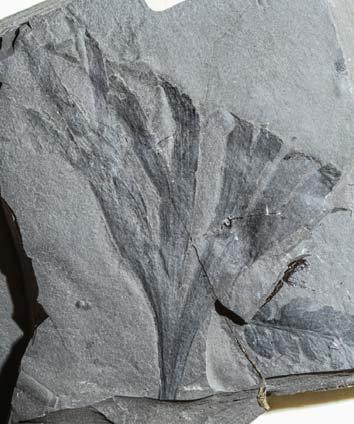
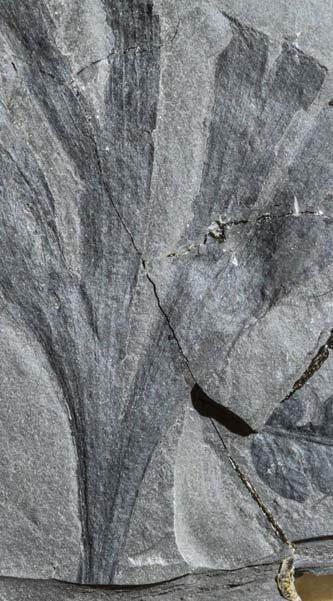
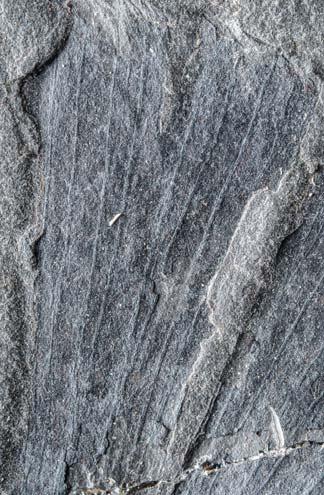


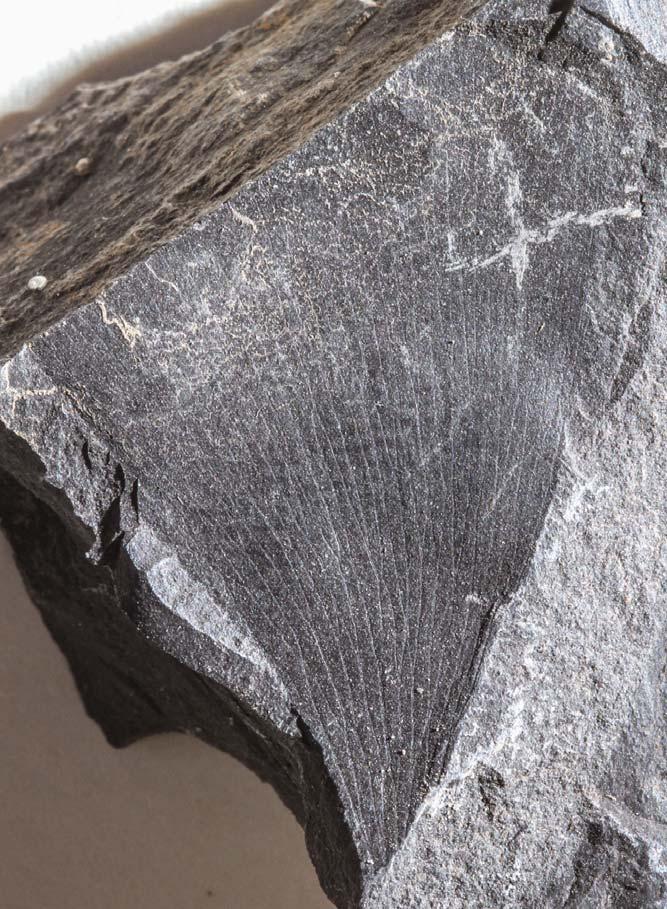
12 cm 0 COLOUR PLATES 261 ISSN 2410-4418 Palaeont. afr. (2023) 57 (Special Issue): i–xiv + 1–324 Umkomaas Valley (Umk 111) Plate 110
Rochipteris cf. sinuosa
PRE/F/23123
PRE/F/23123
×1 ×2 ×5 1 2 3
PRE/F/23123
PRE/F/441a
×2
×5
5
Rochipteris lutifolia
PRE/F/441a
×1 4 6
Umk 111 Dic 2spp






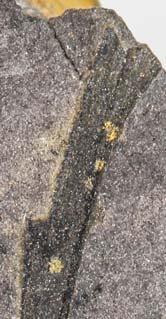
COLOUR PLATES 262 ISSN 2410-4418 Palaeont. afr. (2023) 57 (Special Issue): i–xiv + 1–324
Plate 111 12 cm 0
Sani Pass (San 111)
BP/2/2526
BP/2/2526
BP/2/2527
BP/2/2527
×1
×5
Rochipteris
×5 ×2
rollerii
1 3 5 6
San 111 Dic cra
×1
BP/2/2527
2 4
×2
BP/2/2526
7
×5

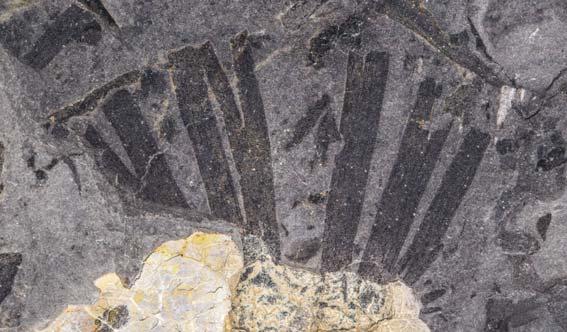
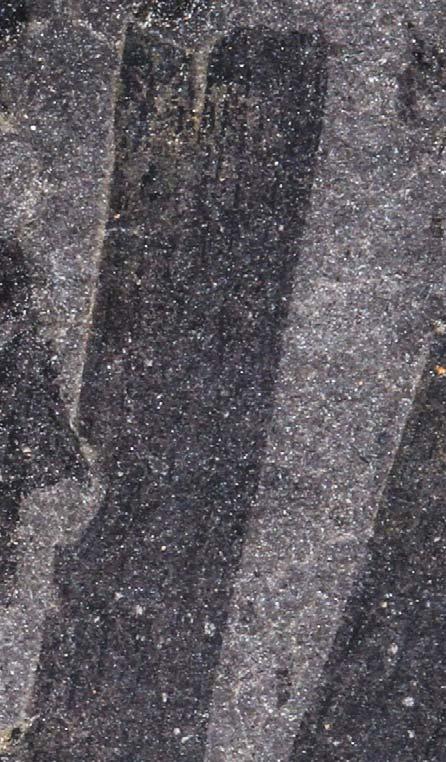

12 cm 0 COLOUR PLATES 263 ISSN 2410-4418 Palaeont. afr. (2023) 57 (Special Issue): i–xiv + 1–324 Sani Pass (San 111)
2 Plate 112 ×5
BP/2/2528
×2
San 111 Dic cra
Rochipteris rollerii
1 4 3
×10
BP/2/2528
BP/2/2528
BP/2/2528
×1

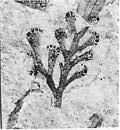
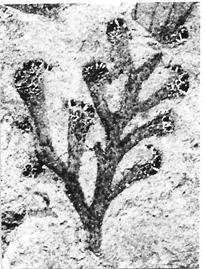

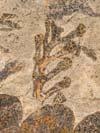

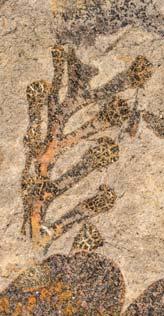
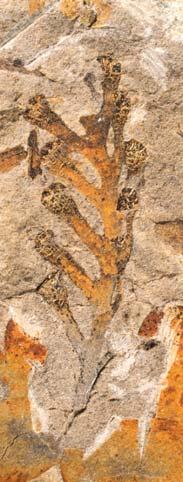


COLOUR PLATES 264 ISSN 2410-4418 Palaeont. afr. (2023) 57 (Special Issue): i–xiv + 1–324
(Mat 111) Plate 113
Matatiele
Mat 111 Dic dub
Kannaskoppianthus matatiparvus
10
PRE/F/9251b ×10
9 ×2 ×2 ×5 ×5 5
PRE/F/9251a
×10
PRE/F/9251b
7 6 8 12 cm 0 ×10
4 ×5 PRE/F/3205 Holotype 3 ×2 PRE/F/3205 2 ×1 1
PRE/F/9251a
PRE/F/3205
Reference palaeodeme (pls 113–114)
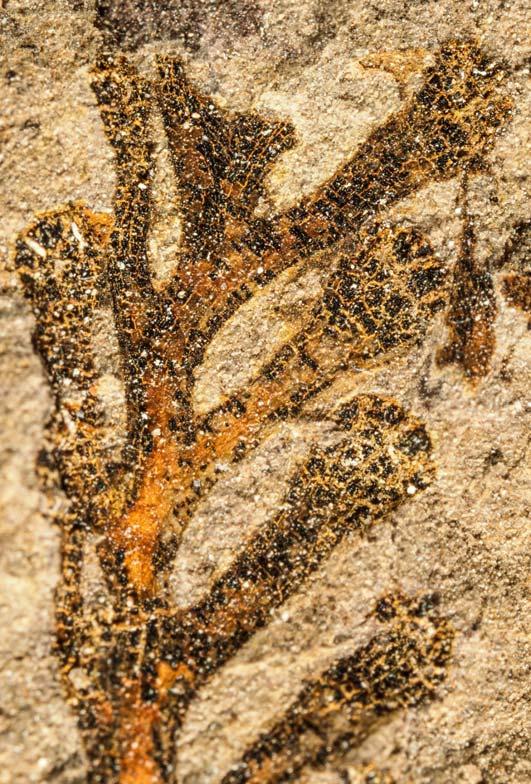

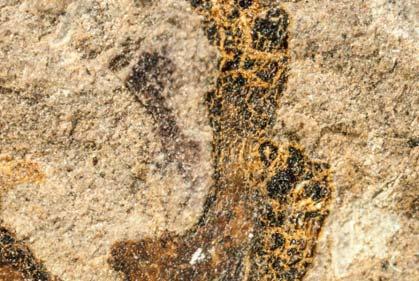

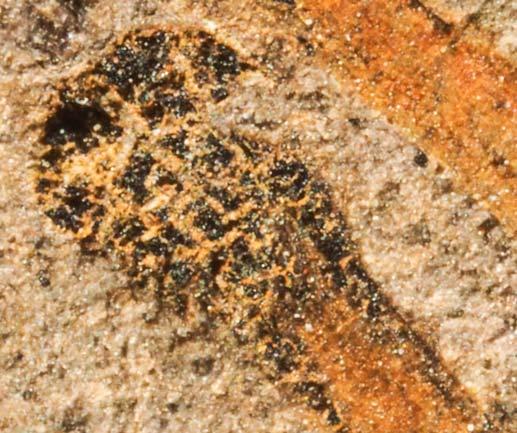
COLOUR PLATES 265 ISSN 2410-4418 Palaeont. afr. (2023) 57 (Special Issue): i–xiv + 1–324 3 12 cm 0 Plate 114 Matatiele (Mat 111) Kannaskoppianthus
matatiparvus
Mat 111 Dic dub
PRE/F/9251b
2
×20
PRE/F/9251a
1
×20
PRE/F/9251b
×20
PRE/F/9251a
×40
PRE/F/9251b
4 5
×40

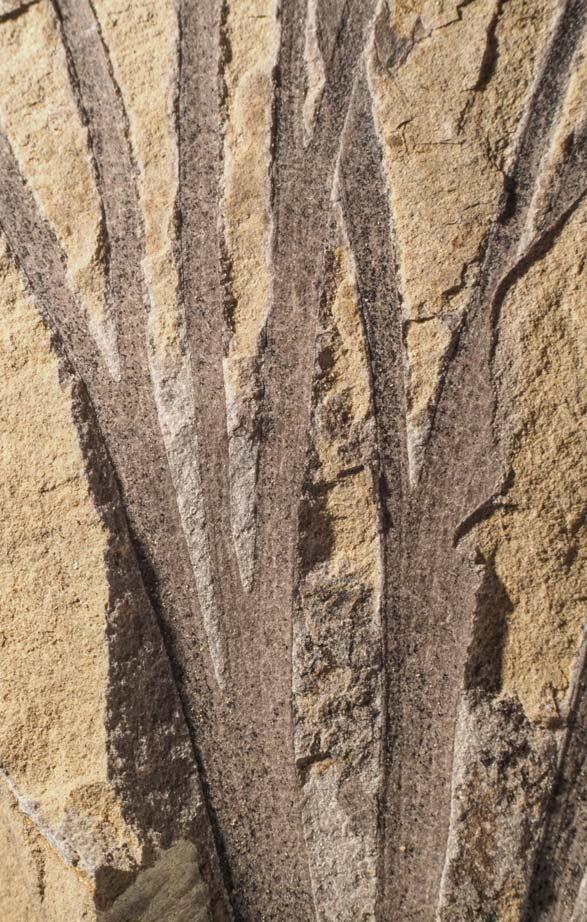


COLOUR PLATES 266 ISSN 2410-4418 Palaeont. afr. (2023) 57 (Special Issue): i–xiv + 1–324
Plate 115
Matatiele (Mat 111)
PRE/F/9082a
×2
×1
PRE/F/9082a ×5
PRE/F/9082a
×10
PRE/F/9082a
Rochipteris matatifolia
12 cm 0 1 2 3
Mat 111 Dic dub
4
Reference palaeodeme (pls 115–116)
Holotype

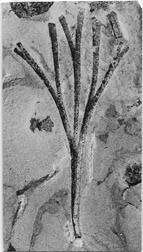
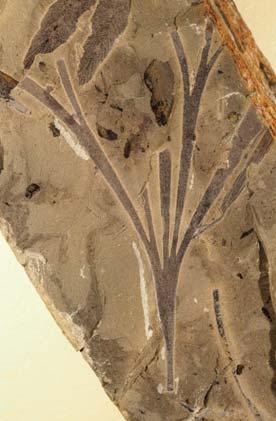
Rochipteris matatifolia

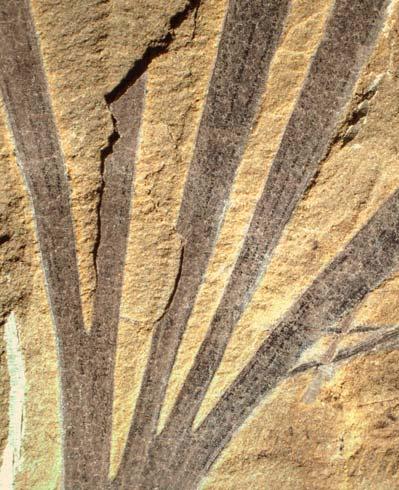


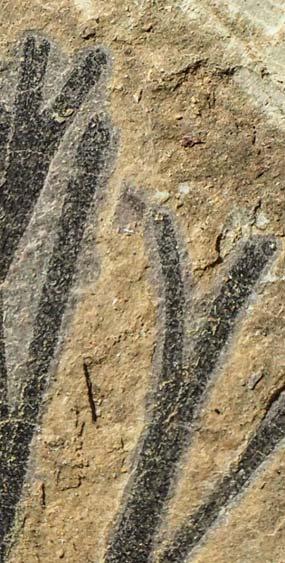



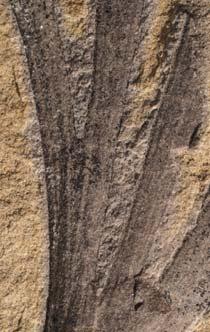
COLOUR PLATES 267 ISSN 2410-4418 Palaeont. afr. (2023) 57 (Special Issue): i–xiv + 1–324
Matatiele (Mat 111)
9 Plate 116 12 cm 0 ×5 ×10
PRE/F/9074
×1
PRE/F/9083b
6 7
PRE/F/9083b
11
Mat 111 Dic dub
×2
8
PRE/F/9074
×5
12
×5
PRE/F/9083b
5
×1
PRE/F/1881
1
×1
PRE/F/1881
2 3 ×1 4 ×2 10
PRE/F/1881
×5 ×2
PRE/F/9077
PRE/F/9074

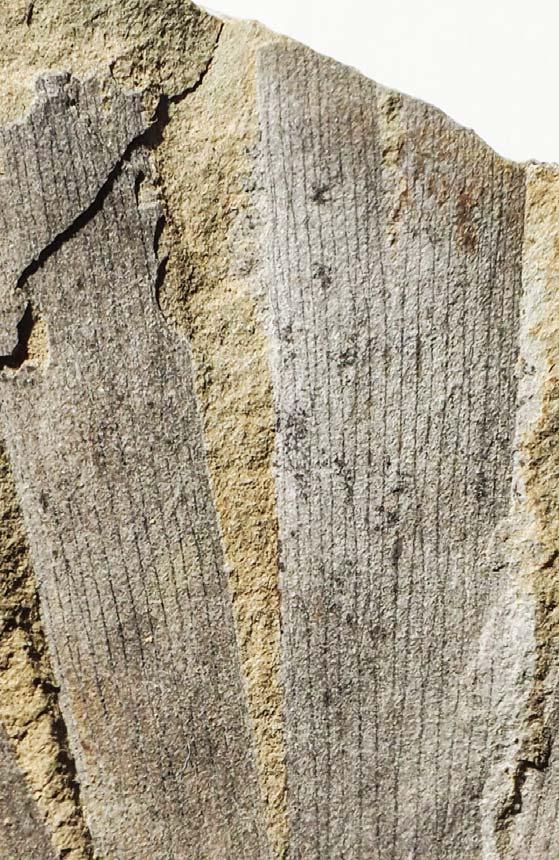
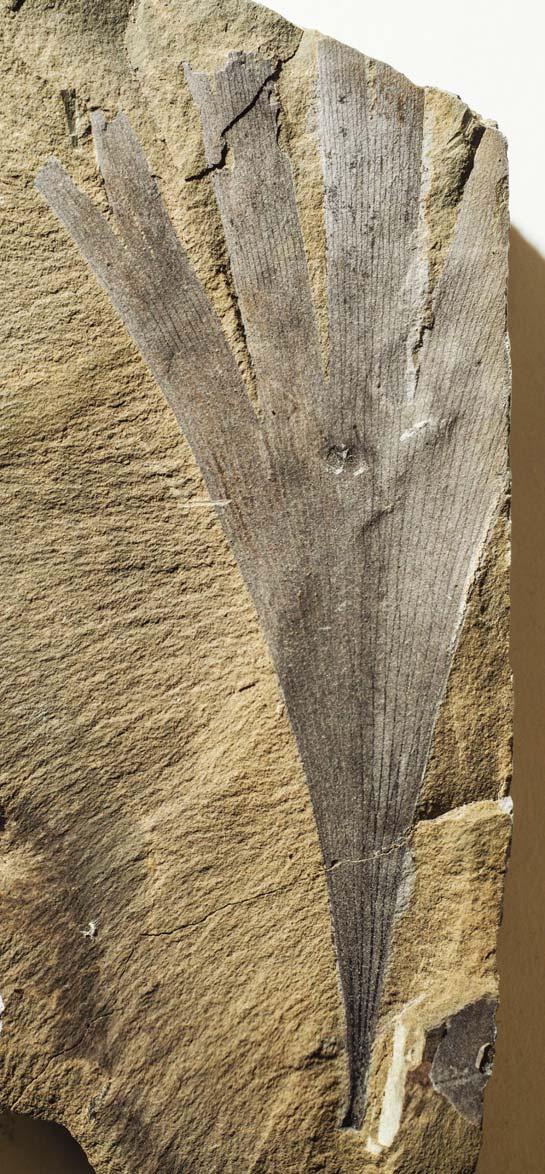


COLOUR PLATES 268 ISSN 2410-4418 Palaeont. afr. (2023) 57 (Special Issue): i–xiv + 1–324
Plate 117
Matatiele (Mat 111)
×10
PRE/F/1875b
×1
4
×5
PRE/F/1875b
Rochipteris telefolia
×2 2 3 5 1 ×5
PRE/F/1875b
12 cm 0
PRE/F/1875b
Mat 111 Dic dub
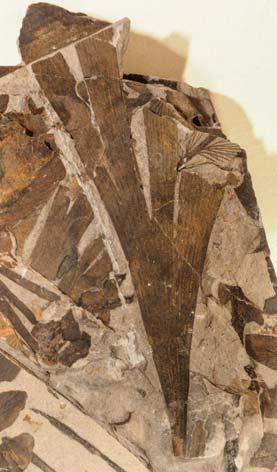



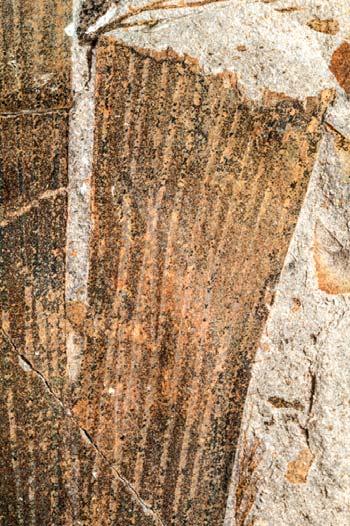
12 cm 0 COLOUR PLATES 269 ISSN 2410-4418 Palaeont. afr. (2023) 57 (Special Issue): i–xiv + 1–324 Matatiele (Mat 111) Plate 118
PRE/F/9068a
×5
1
PRE/F/9068a
4 Rochipteris telefolia 2
×10
5
Mat 111 Dic dub
×1
PRE/F/9068a
PRE/F/9068a
3
×5
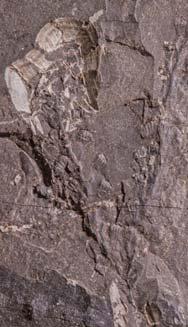

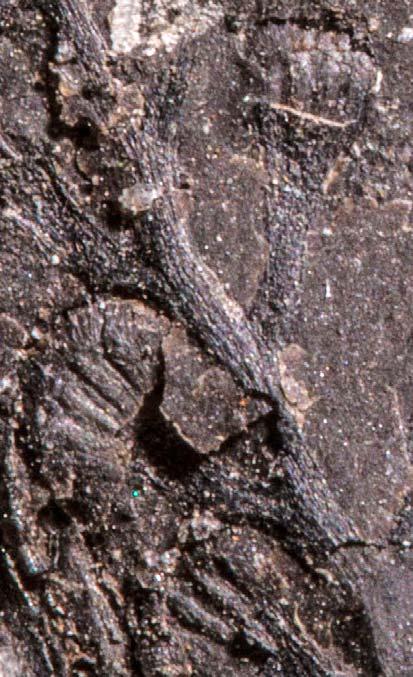


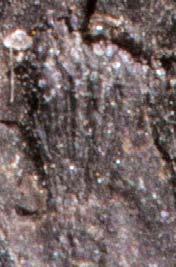
COLOUR PLATES 270 ISSN 2410-4418 Palaeont. afr. (2023) 57 (Special Issue): i–xiv + 1–324 Plate 119 12 cm 0 Kannaskoppianthus switzianthus
2
PRE/F/21497a
Lit
111 Dic/Hei
×20
1
×2 PRE/F/21497a
×5
×10
PRE/F/21497a
×20
PRE/F/21497a
PRE/F/21497a
4 3 6 5
×20
Little Switzerland (Lit 111)
Holotype
Reference palaeodeme (pls 119–120)



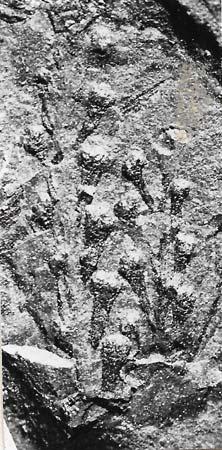

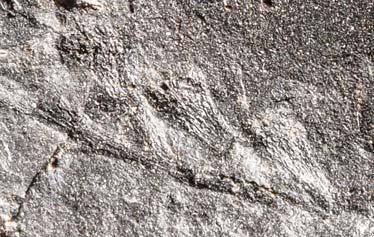
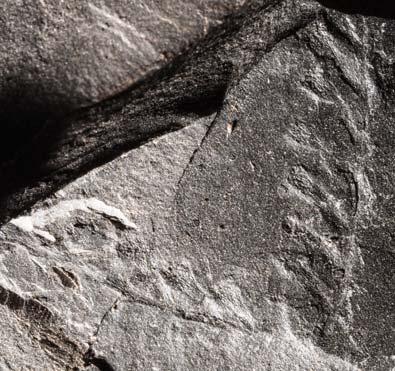




12 cm 0 COLOUR PLATES 271 ISSN 2410-4418 Palaeont. afr. (2023) 57 (Special Issue): i–xiv + 1–324 Little Switzerland (Lit 111) Plate 120
×5 5 ×5
PRE/F/5941
8
PRE/F/5943a
×5
PRE/F/5943b
Kannaskoppianthus switzianthus
Lit 111 Dic/Hei
1 2
PRE/F/5942b
×10
11 10 ×10 9 7
PRE/F/5943b
PRE/F/5943a
×5 ×5
PRE/F/5943a
* * * ×5
PRE/F/5942a
4 * ×5
PRE/F/5940
6 *
PRE/F/5939
×10
* ×5 3
PRE/F/5942a
Rochipteris switzifolia
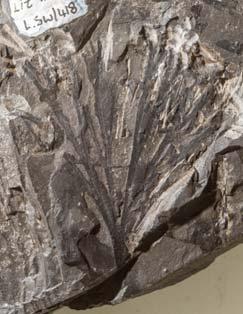
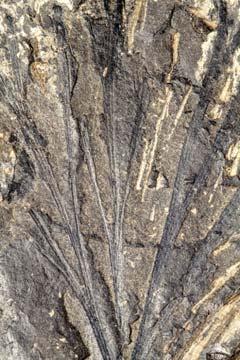

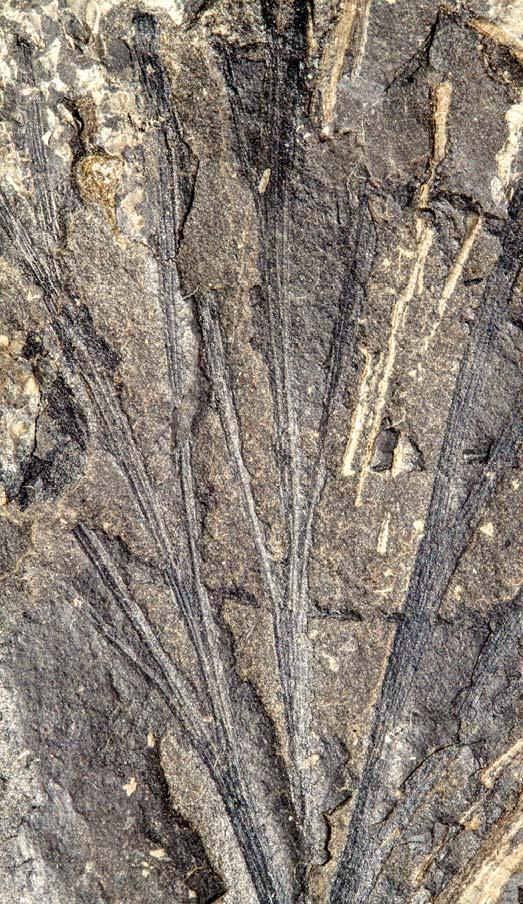
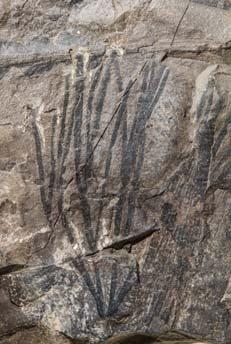
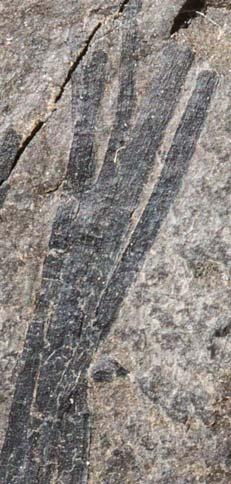
COLOUR PLATES 272 ISSN 2410-4418 Palaeont. afr. (2023) 57 (Special Issue): i–xiv + 1–324 Little Switzerland (Lit 111) Plate 121
Lit 111 Dic/Hei
BP/2/1559
1
×1
BP/2/1559
2 3
×2
BP/2/1559
×5
×10
4
BP/2/1559
PRE/F/5636
5
×1
6
PRE/F/5636 ×5
0
Holotype 12 cm
Reference palaeodeme (pls 121–124)
Rochipteris switzifolia


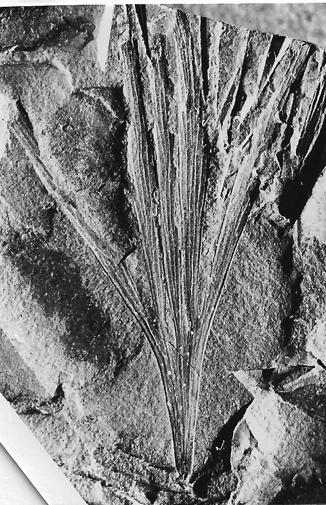




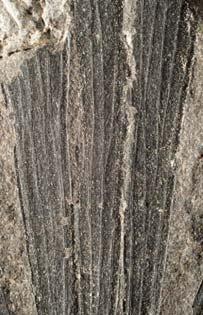
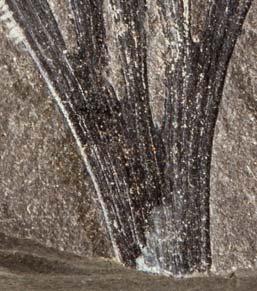
12 cm COLOUR PLATES 273 ISSN 2410-4418 Palaeont. afr. (2023) 57 (Special Issue): i–xiv + 1–324 Little Switzerland (Lit 111) Plate 122
12 cm 0 ×5
1
BP/2/1565 ×2
×2 7 ×5 8 ×10
BP/2/1557
BP/2/1565
×5 9 3 2
BP/2/1557
×2
Lit 111 Dic/Hei
×5 ×5 6 5 4 * * *
BP/2/1557b


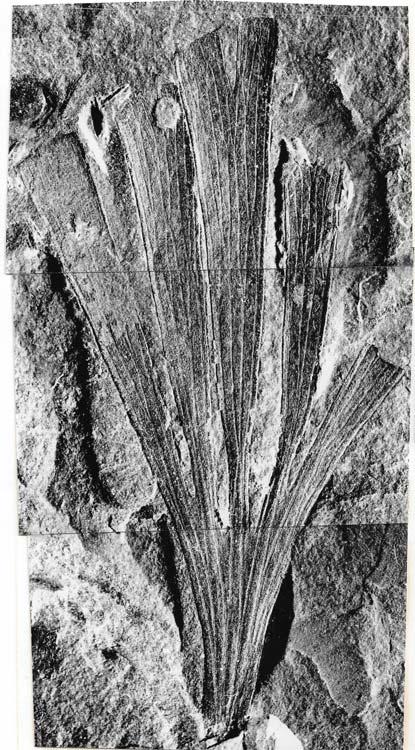

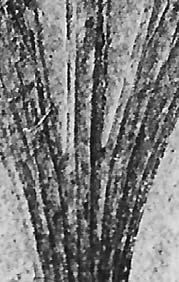


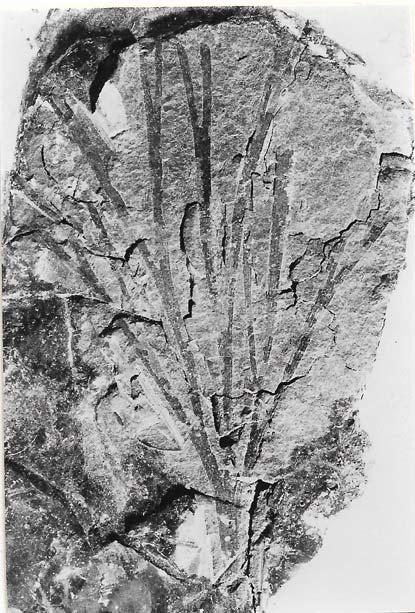


COLOUR PLATES 274 ISSN 2410-4418 Palaeont. afr. (2023) 57 (Special Issue): i–xiv + 1–324 Little Switzerland (Lit 111) Plate 123 ×10 3
×2
8
×10 10 ×5 2
BP/2/1562
Lit 111 Dic/Hei
PRE/F/5638
×5 6 5
Rochipteris switzifolia ×2
1 4 ×10 * * * * * * * ×5 9
PRE/F/5638
×2
×2 7 *
PRE/F/5637
BP/2/1562
PRE/F/5638
PRE/F/5638
12 cm 0
BP/2/1555
BP/2/1555





12 cm 0 COLOUR PLATES 275 ISSN 2410-4418 Palaeont. afr. (2023) 57 (Special Issue): i–xiv + 1–324 Little Switzerland (Lit 111) Plate 124
2
BP/2/1582 ×2
Rochipteris switzifolia ×5
×10
3 4
Lit 111 Dic/Hei
BP/2/1582
BP/2/1582
×10
5 1
BP/2/1582
Kannaskoppianthus aasvoelensis
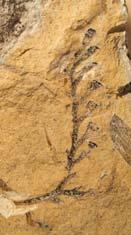
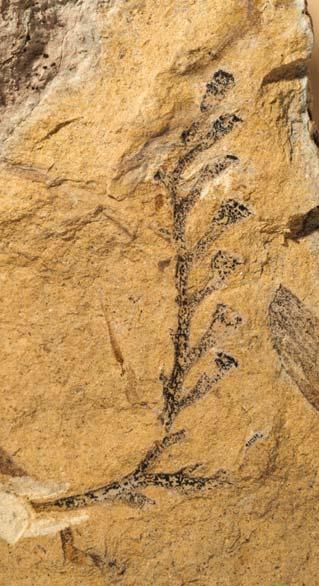



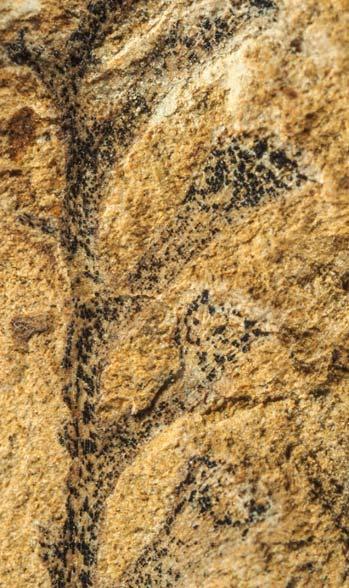
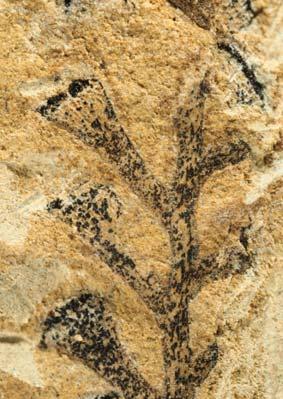

PRE/F/19547b

PRE/F/19547b
COLOUR PLATES 12 cm 0 276 ISSN 2410-4418 Palaeont. afr. (2023) 57 (Special Issue): i–xiv + 1–324 Aasvoëlberg (Aas
Plate 125
111)
PRE/F/19547a
×5
×10 ×5
×15
×15
PRE/F/19547a
PRE/F/19547a
PRE/F/19547b
×10
PRE/F/19547b
×20
2 3 4 6 7 8 9 1 5 ×2
Aas 111 Hei elo
×2
Holotype
Holotype
Reference palaeodeme (pls 125–130)
Kannaskoppianthus aasvoelensis
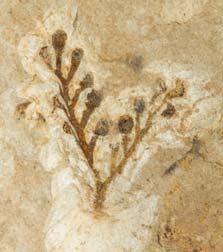
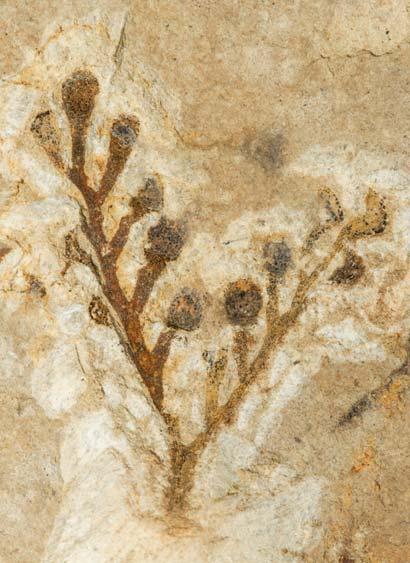

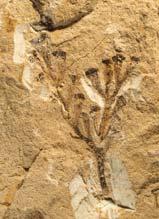
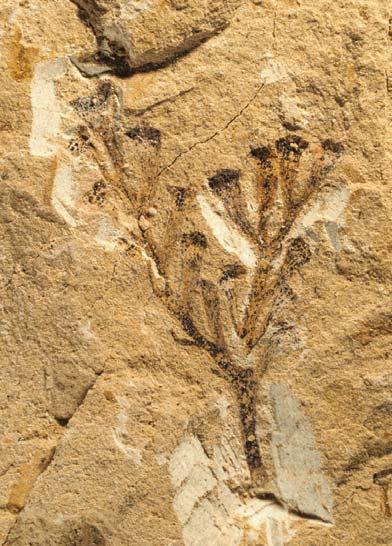


12 cm 0 COLOUR PLATES 277 ISSN 2410-4418 Palaeont. afr. (2023) 57 (Special Issue): i–xiv + 1–324
PRE/F/15244b
PRE/F/15244b
×2
×10
PRE/F/19484
×2
PRE/F/19484
×10
PRE/F/15244b ×5
PRE/F/19484 ×5
Aasvoëlberg (Aas 111)
1 2 3 4 5 6 Plate 126
Aas 111 Hei elo
PRE/F/19484
7
×20
Kannaskoppianthus aasvoelensis

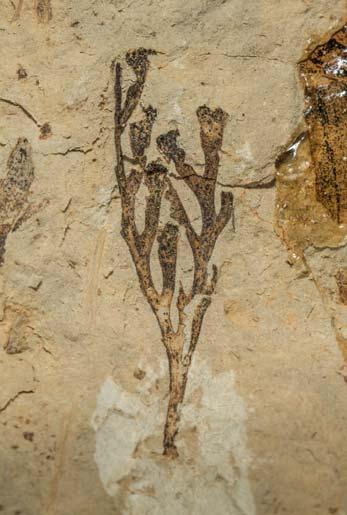
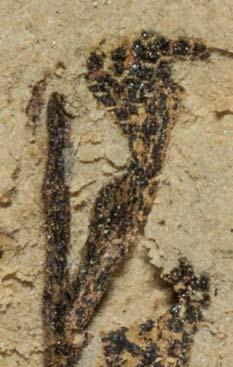


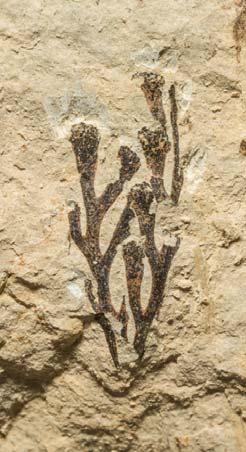


COLOUR PLATES 12 cm 0 278 ISSN 2410-4418 Palaeont. afr. (2023) 57 (Special Issue): i–xiv + 1–324
12
PRE/F/15203a
×2
PRE/F/15203a
×5
PRE/F/15203a
Aasvoëlberg
×10
(Aas
111)
PRE/F/15203b
×5
PRE/F/15203b
×2
Aas 111 Hei elo
1 2 3 4 5 6 Plate 127
PRE/F/15203a ×20
PRE/F/15203b 7 8
×10
×20
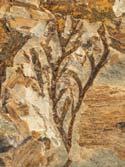
Kannaskoppianthus aasvoelensis
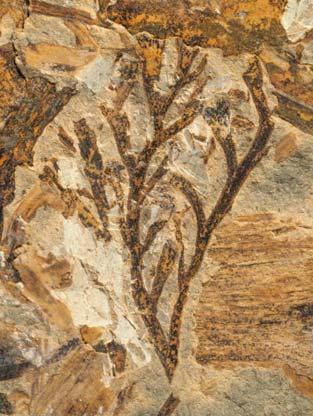

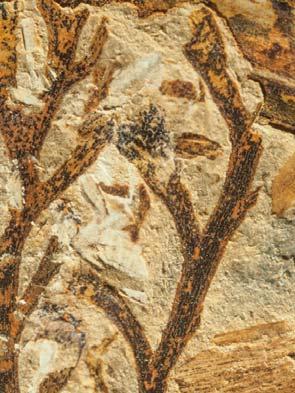
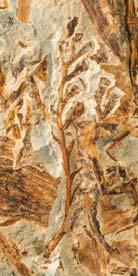
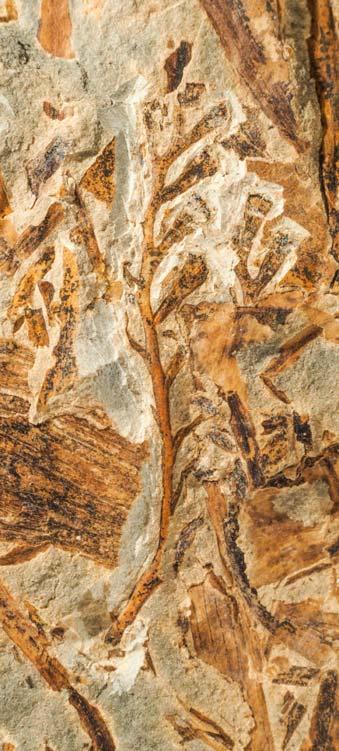
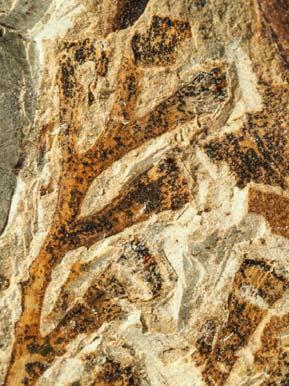

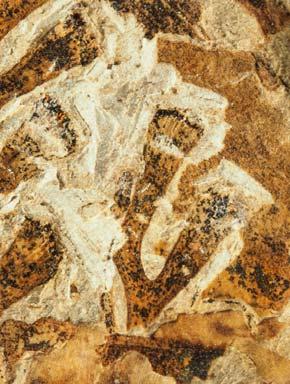
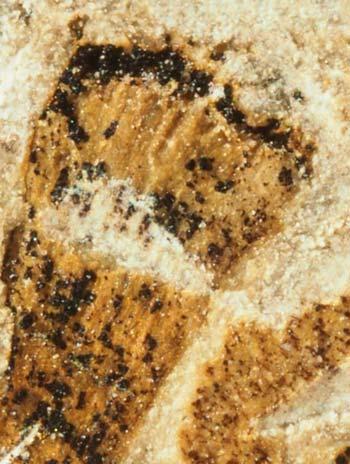
12 cm 0 COLOUR PLATES 279 ISSN 2410-4418 Palaeont. afr. (2023) 57 (Special Issue): i–xiv + 1–324 Plate 128
PRE/F/19540
PRE/F/19545
×5
×5
×10
×10
×10
×10
PRE/F/19545
PRE/F/19545
PRE/F/19540
PRE/F/19540
×20
PRE/F/19545
×50
Aas
elo 2 3 4 6 7 8 9 10 ×2 ×2 1 5 Aasvoëlberg (Aas 111)
PRE/F/19545
111 Hei


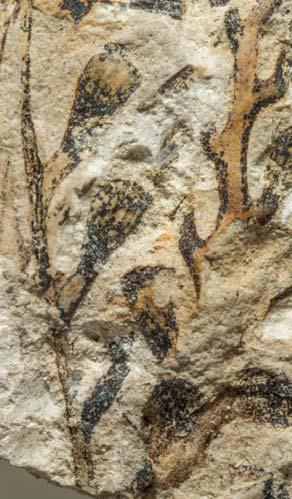

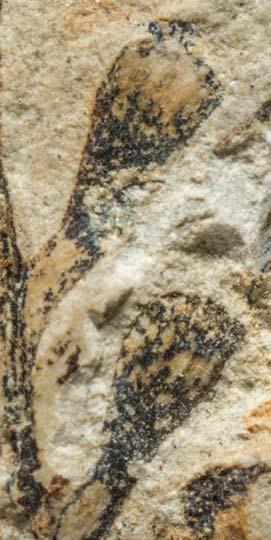
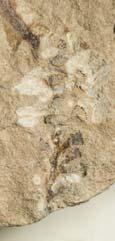
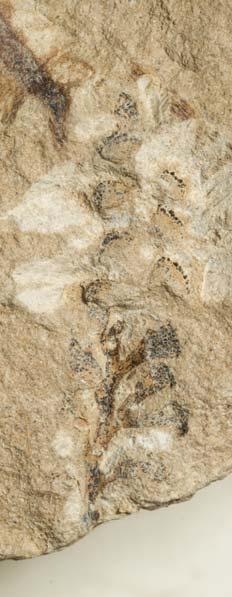


COLOUR PLATES 280 ISSN 2410-4418 Palaeont. afr. (2023) 57 (Special Issue): i–xiv + 1–324 12 cm 0 Aasvoëlberg (Aas 111) Plate 129
BP/2/4336a
BP/2/4336a
BP/2/4336a
×5
×10 ×10
PRE/F/15242b
×5
PRE/F/15242b
2 3 4 7 8
×10
Kannaskoppianthus aasvoelensis
×2
1 6
Aas 111 Hei elo
×2
BP/2/4336a
5
×10
9
×20
PRE/F/15242b

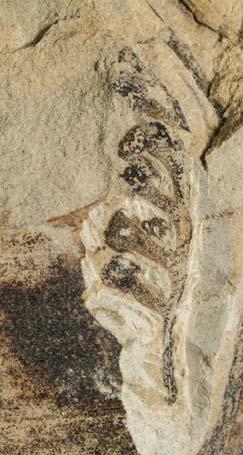
Kannaskoppianthus aasvoelensis




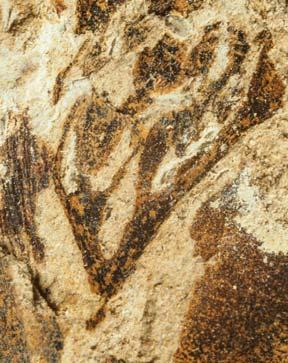
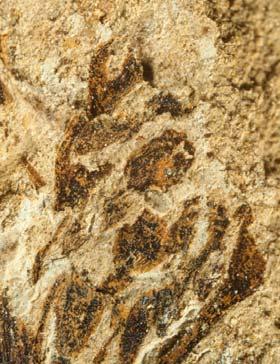

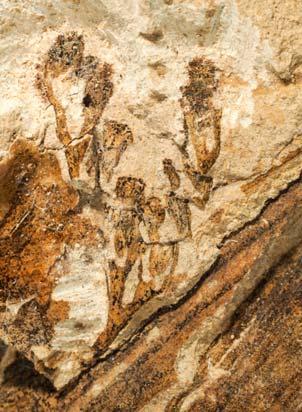


12 cm 0 COLOUR PLATES 281 ISSN 2410-4418 Palaeont. afr. (2023) 57 (Special Issue): i–xiv + 1–324 Aasvoëlberg (Aas 111) Plate 130 9
×2
PRE/F/15246a
PRE/F/15246a
PRE/F/15246a
×5
×10
×10
PRE/F/15246b
PRE/F/15246b
×5
×20
PRE/F/19541
2 3 6 7 8 10 12
PRE/F/19541 ×5 ×10
5 11 1
Aas 111 Hei elo
×10
PRE/F/15246b
×2
4
×2
×20
PRE/F/19541
Rochipteris rollerii
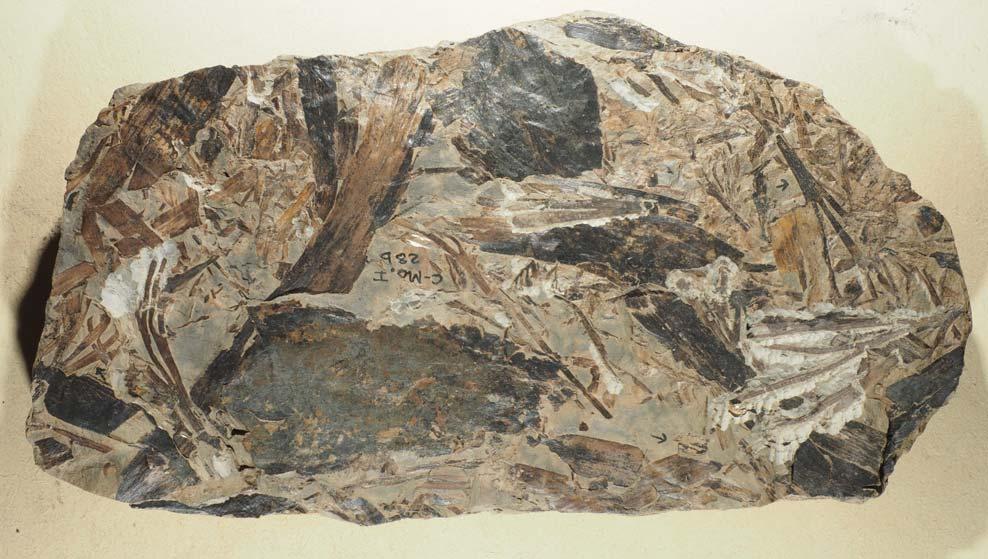

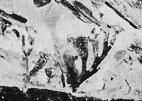
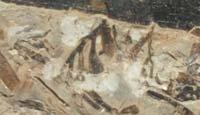
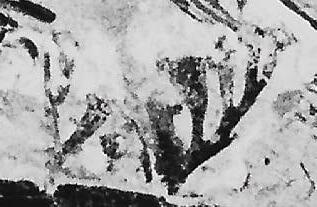


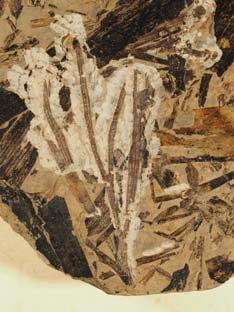

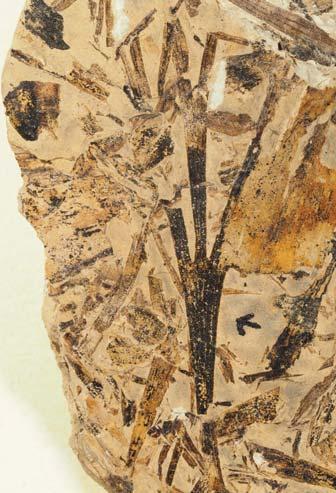
of 6 intact leaves & at least 15 fragmentary indivs; & 1 Kannaskoppianthus strobilus.
Reference palaeodeme (pls 131–142)
COLOUR PLATES 12 cm 0 282 ISSN 2410-4418 Palaeont. afr. (2023) 57 (Special Issue): i–xiv + 1–324 ×2 ×5 1 6 7 ×5 3
×5 8
BP/2/4302a ×1
×2
×1 5
BP/2/4302a
BP/2/4302a
BP/2/4302a
BP/2/4302a
2 4
BP/2/4302a
×2
Aasvoëlberg (Aas 111) Plate 131
Cluster
Aas 111 Hei elo



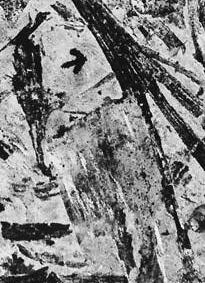
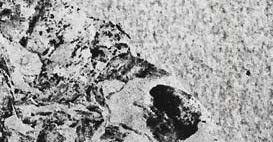


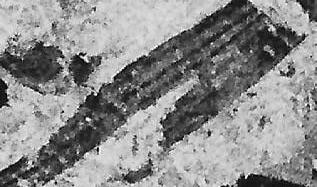
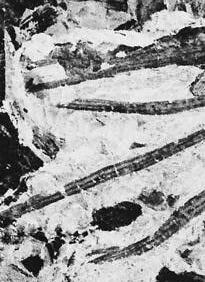


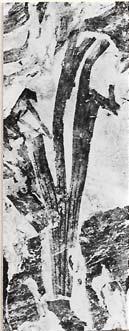





12 cm 0 COLOUR PLATES 283 ISSN 2410-4418 Palaeont. afr. (2023) 57 (Special Issue): i–xiv + 1–324 ×5 ×5 ×5 9 5 8 ×2 ×2 ×2 ×2 ×2 6 ×5 Rochipteris rollerii 7 3 2 1 4
BP/2/4302a
BP/2/4302a
BP/2/4302a
BP/2/4302a
BP/2/4302a
BP/2/4302a
BP/2/4302a
BP/2/4302a
Aasvoëlberg (Aas 111) Plate 132
BP/2/4302a
Aas 111 Hei elo


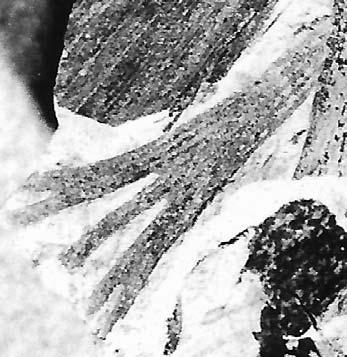
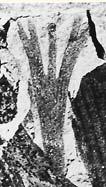

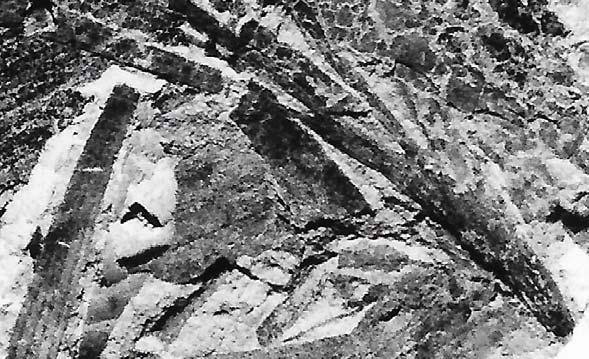

COLOUR PLATES 12 cm 0 284 ISSN 2410-4418 Palaeont. afr. (2023) 57 (Special Issue): i–xiv + 1–324 Aasvoëlberg (Aas 111) ×2 ×5 ×5 ×5 ×5
Rochipteris rollerii
7 6 5 3 1
Aas 111 Hei elo
PRE/F/15228
PRE/F/15228
PRE/F/15228
PRE/F/15228
Plate 133
PRE/F/15228
×2
4 2
×5
Cluster of 5 intact leaves

Rochipteris rollerii
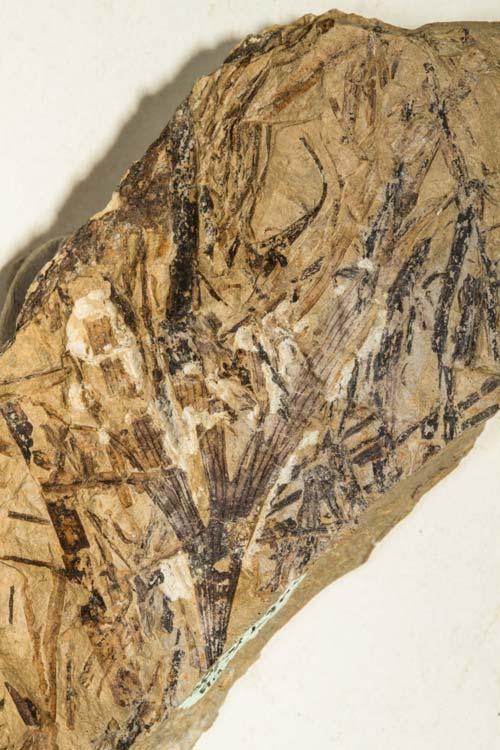

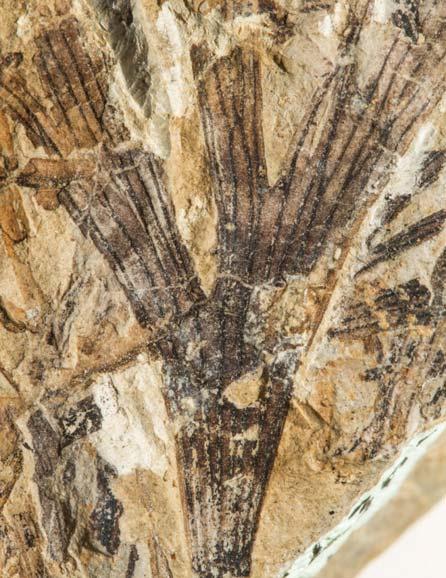
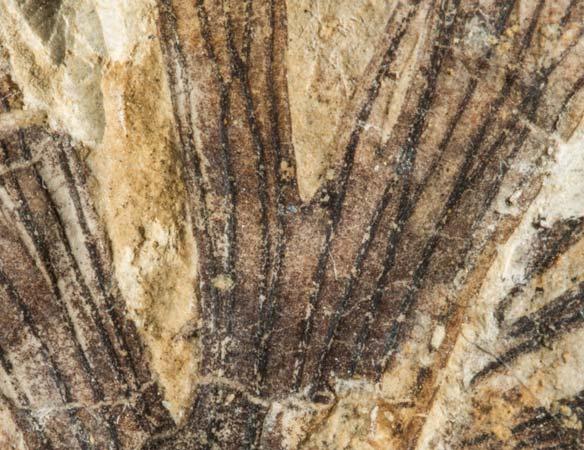
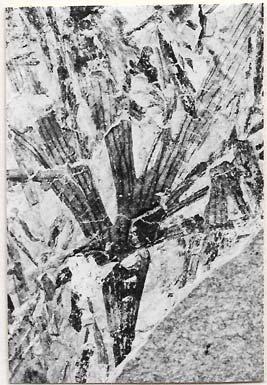
COLOUR PLATES 285 ISSN 2410-4418 Palaeont. afr. (2023) 57 (Special Issue): i–xiv + 1–324 12 cm 0 Aasvoëlberg (Aas 111)
5 Plate 134
BP/2/4307
×2
Cluster of 3 intact leaves
BP/2/4307
BP/2/4307
2 3
×5
×2
BP/2/4307
4 1
×10
×1
×5
6
BP/2/4307
Aas 111 Hei elo

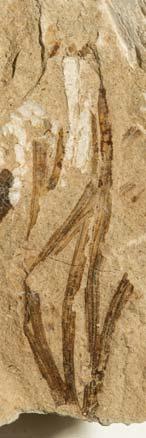


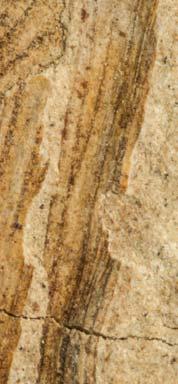
Rochipteris rollerii

COLOUR PLATES 12 cm 0 286 ISSN 2410-4418 Palaeont. afr. (2023) 57 (Special Issue): i–xiv + 1–324
6
×10
Aasvoëlberg (Aas
PRE/F/15235
111)
Plate 135
PRE/F/15235
2 ×5
×2
×10
3 4 ×1 1
PRE/F/15235
5
×5
PRE/F/15235
Aas 111 Hei elo


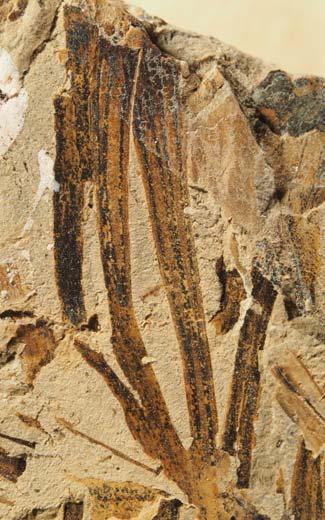




COLOUR PLATES 287 ISSN 2410-4418 Palaeont. afr. (2023) 57 (Special Issue): i–xiv + 1–324 Aasvoëlberg (Aas 111) Plate 136 12 cm 0
Aas 111 Hei elo
PRE/F/15220
PRE/F/15220 ×5
×2 2 3
4
1
×10
×1
×5
PRE/F15220 5 6
×2
7
PRE/F15220
PRE/F15220
×10
Rochipteris rollerii
PRE/F15220
BP/2/4308


×2

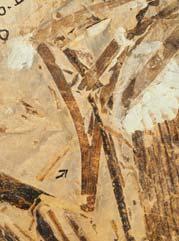
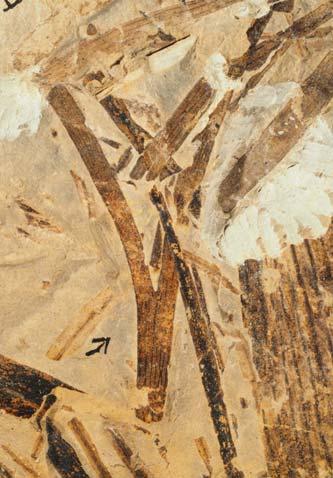


COLOUR PLATES 288 ISSN 2410-4418 Palaeont. afr. (2023) 57 (Special Issue): i–xiv + 1–324 Aasvoëlberg (Aas 111) Plate 137 12 cm 0
BP/2/4303
BP/2/4303 Rochipteris rollerii 5 6
×5 ×2
7
4
BP/2/4303
×10
×1
Aas 111 Hei elo
×2 ×2
2 3 1
PRE/F/15237a,‘x’,‘y’
PRE/F/15237b,‘x’,‘y’
Cluster of 3 intact leaves
Cluster of 2 intact leaves
‘x’ ‘y’
‘x’ ‘y’


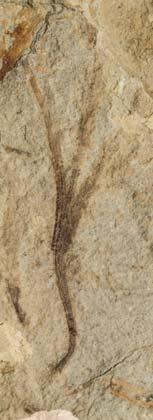

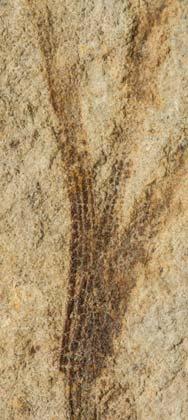
Rochipteris rollerii

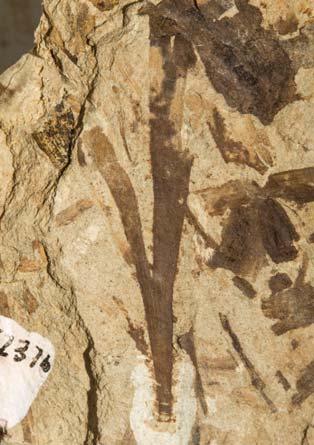
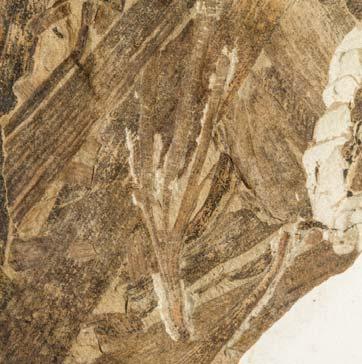

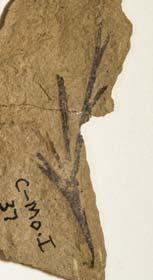
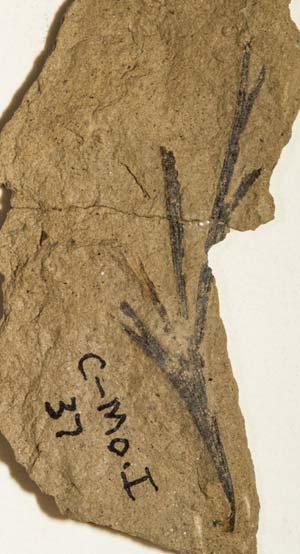

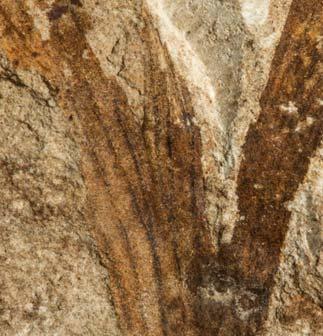
COLOUR PLATES 289 ISSN 2410-4418 Palaeont. afr. (2023) 57 (Special Issue): i–xiv + 1–324 Aasvoëlberg (Aas 111) Plate 138
BP/2/4304 ×2
Aas 111 Hei elo
PRE/F/15222
11 12 13
10 12 cm 0
PRE/F/15222 ×1 ×5
×1
PRE/F/15228
PRE/F/15237b,‘x’
PRE/F/15237a,‘y’
PRE/F/15237a,‘y’
×5
×2 ×5 ×2 2 3 4 8 9 1 ×1
PRE/F/15228
×2
×5 6 7
PRE/F/15233 PRE/F/15233 5
×2
×1
See pl.133(1,5)
‘y’
‘y’ ‘y’ ‘x’
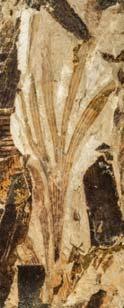

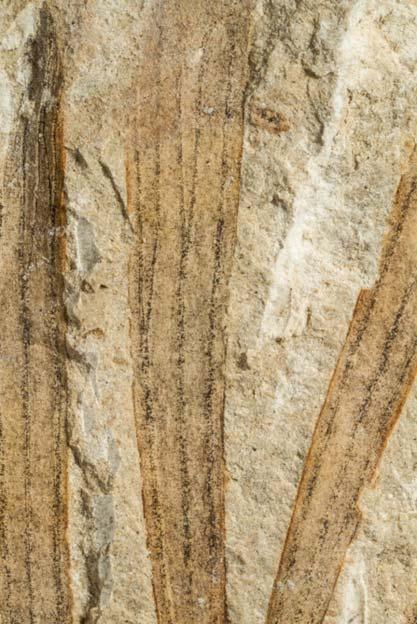



COLOUR PLATES 12 cm 0 290 ISSN 2410-4418 Palaeont. afr. (2023) 57 (Special Issue): i–xiv + 1–324
×10
×10
PRE/F/15227
PRE/F/15227
PRE/F/15227 ×2
2 5 6 1
Aas 111 Hei elo
×1
3
Plate 139 Aasvoëlberg (Aas 111) 4
PRE/F/15227
Rochipteris rollerii
×5
×5
PRE/F/15227
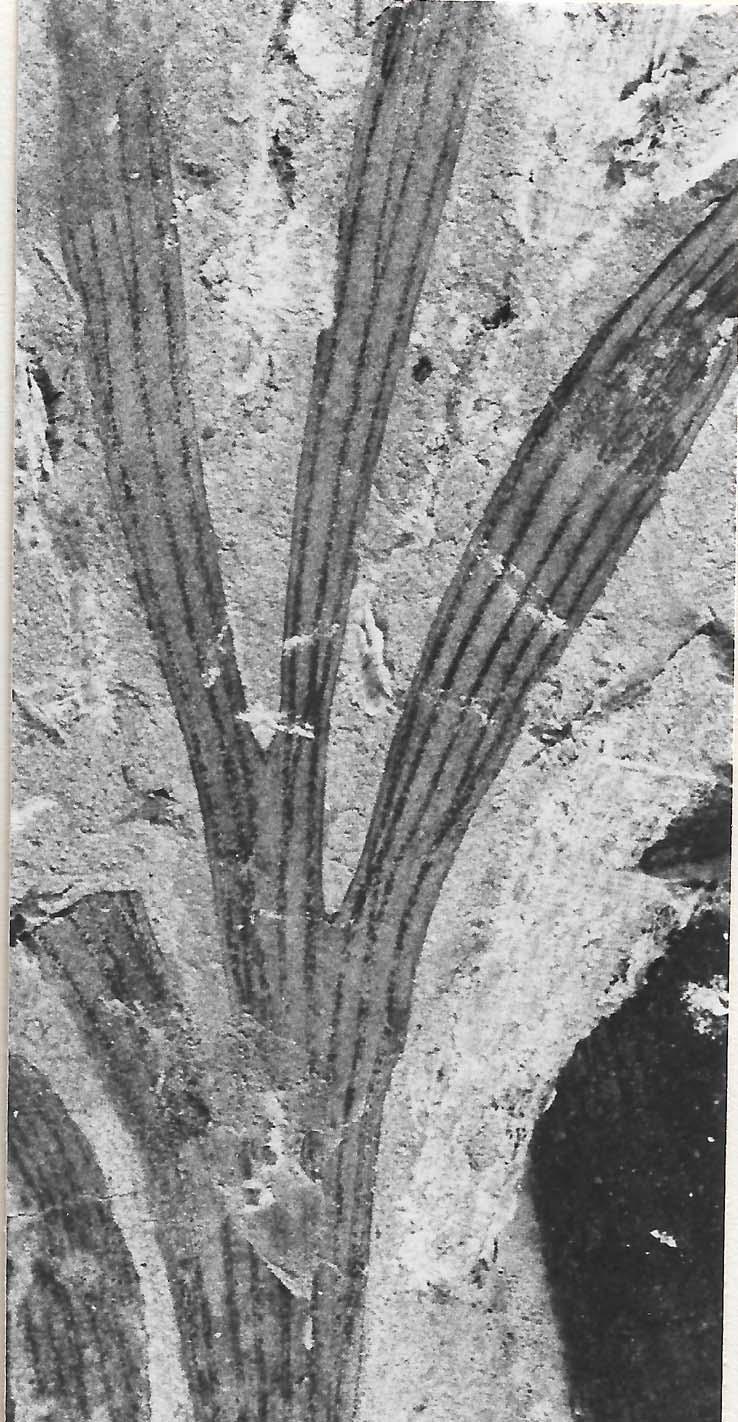

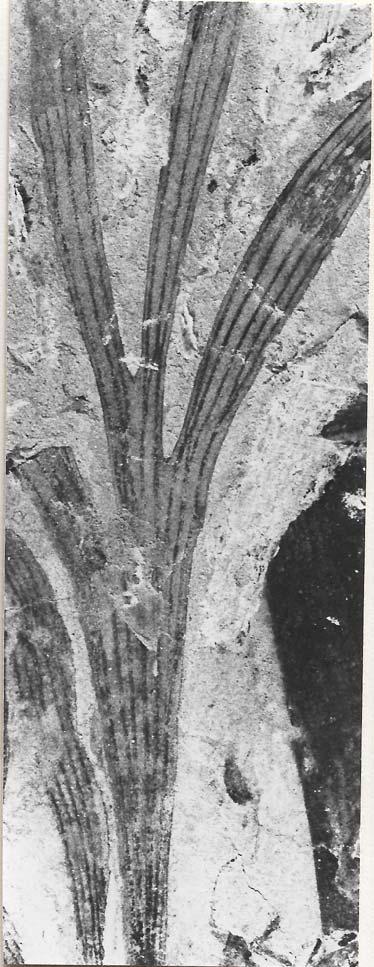
12 cm 0 COLOUR PLATES 291 ISSN 2410-4418 Palaeont. afr. (2023) 57 (Special Issue): i–xiv + 1–324
2
×5
3
PRE/F/15227
×10
PRE/F/15227
PRE/F/15227
1
×2
Plate 140
Rochipteris rollerii
Aasvoëlberg (Aas 111)
Aas 111 Hei elo
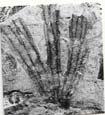
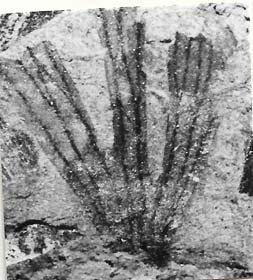

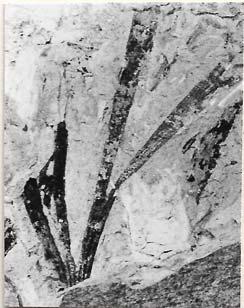
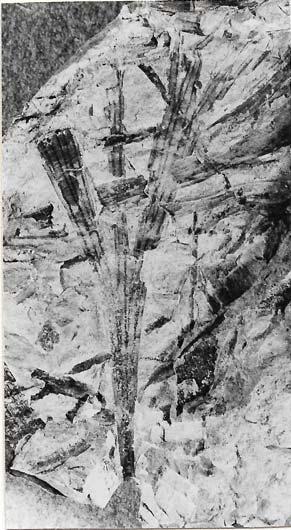

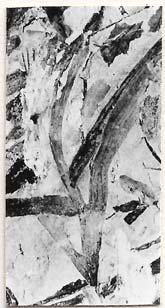

COLOUR PLATES 12 cm 0 292 ISSN 2410-4418 Palaeont. afr. (2023) 57 (Special Issue): i–xiv + 1–324
3
×5
PB/2/4301a ×10
Aasvoëlberg (Aas 111)
×2
PRE/F/15226
PRE/F/15221
×2
PRE/F/4305
×2
Rochipteris rollerii
×5
PB/2/4301a
×2
BP/2/4301a
7 4 1 6 2 8
Aas 111 Hei elo
Plate 141
PRE/F/15221
5
PRE/F/19529 ×2
Rochipteris rollerii


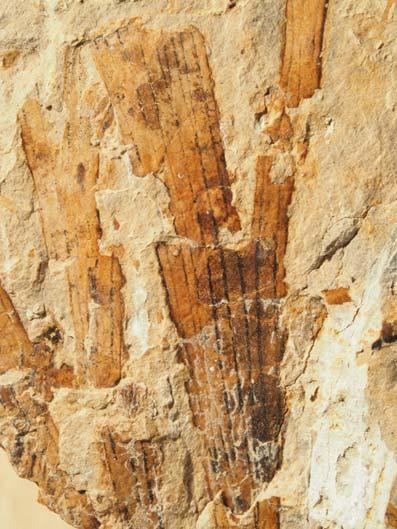

COLOUR PLATES 293 ISSN 2410-4418 Palaeont. afr. (2023) 57 (Special Issue): i–xiv + 1–324 Aasvoëlberg (Aas 111)
Aas 111 Hei elo
12 cm 0 Plate 142 PRE/F/15236 PRE/F/15236 ×5 ×2 2 3
1
×1
PRE/F/15236
PRE/F/15236
4
×10
Kannaskoppianthus aasvoelensis


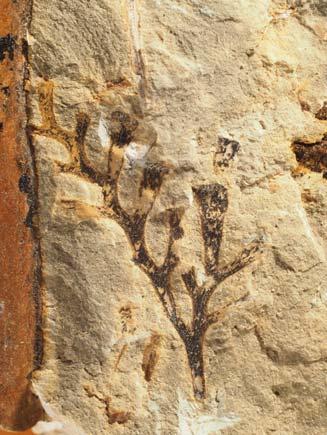





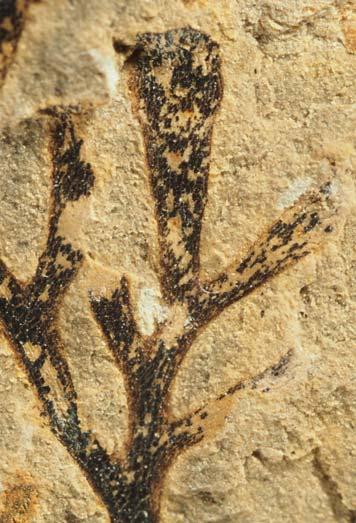


COLOUR PLATES 12 cm 0 294 ISSN 2410-4418 Palaeont. afr. (2023) 57 (Special Issue): i–xiv + 1–324
×5
×5
PRE/F/15280b
PRE/F/15280a
×10
×15
×2
PRE/F/15280a
×10
×2
×10
PRE/F/15280b
PRE/F/15280b
PRE/F/15280a
PRE/F/15280a
1 2 11 10 6 4 3 9 Aasvoelberg (Aas 211) Plate 143
PRE/F/15280b
×20
PRE/F/15280a
×20
5 7
PRE/F/15280a
8
Aas 211 Hei elo
×1


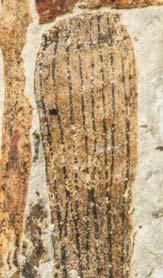

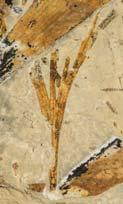
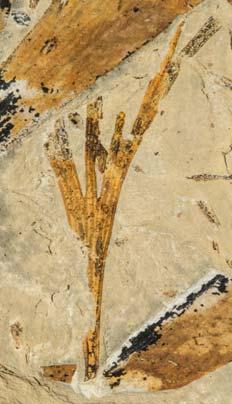
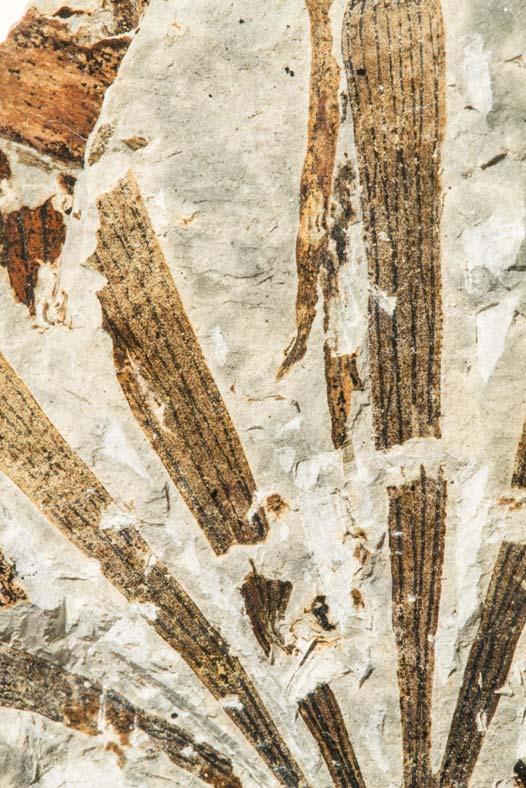
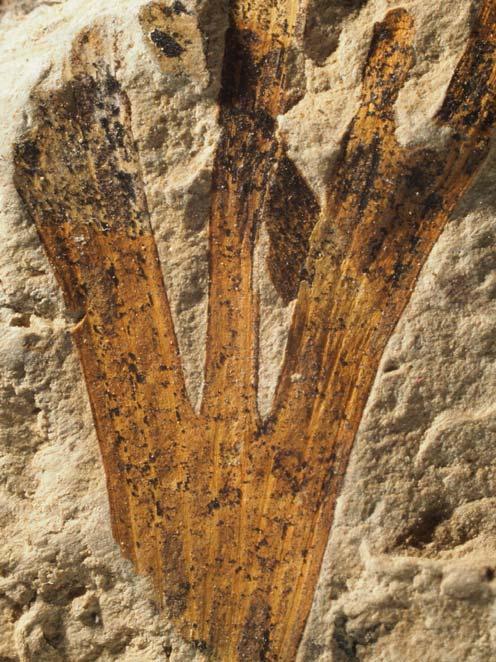

COLOUR PLATES 295 ISSN 2410-4418 Palaeont. afr. (2023) 57 (Special Issue): i–xiv + 1–324 Aasvoelberg (Aas 211)
PRE/F/15278
×2
×5
PRE/F/15278
PRE/F/15275
×2
×10
rollerii 2 4 9 8 Plate 144 ×5 12 cm 0 3
×1
PRE/F/15275
Rochipteris
×1
1 7 ×10 5
Aas 211 Hei elo
PRE/F/15278
6
×10
Kannaskoppianthus aasvoelensis

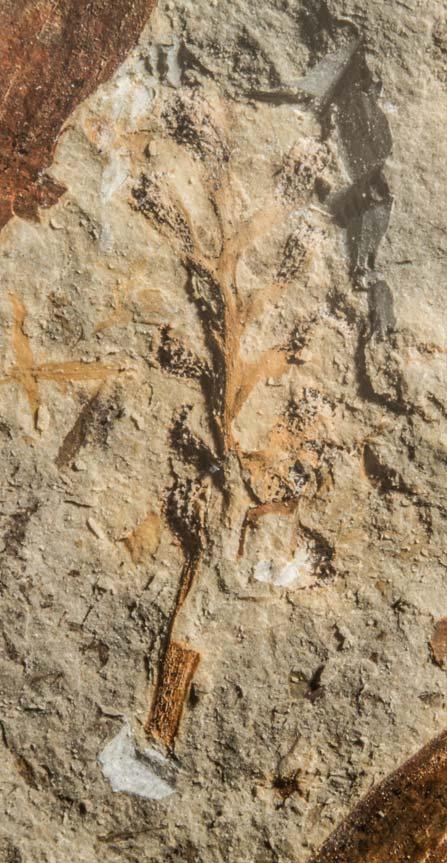


COLOUR PLATES 12 cm 0 296 ISSN 2410-4418 Palaeont. afr. (2023) 57 (Special Issue): i–xiv + 1–324
×2
PRE/F/19407a
×20
×10
×5
PRE/F/19407a
PRE/F/19407a
PRE/F/19407a
Aasvoëlberg (Aas 311) 1 2 4 3 Plate 145
Aas 311 Hei elo

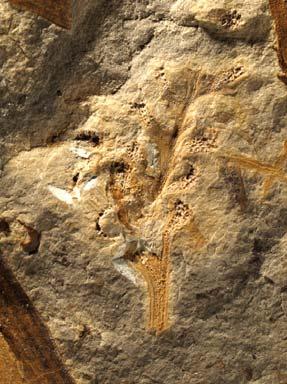
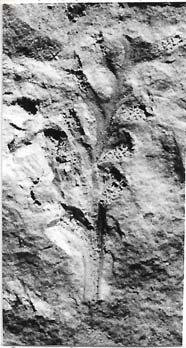


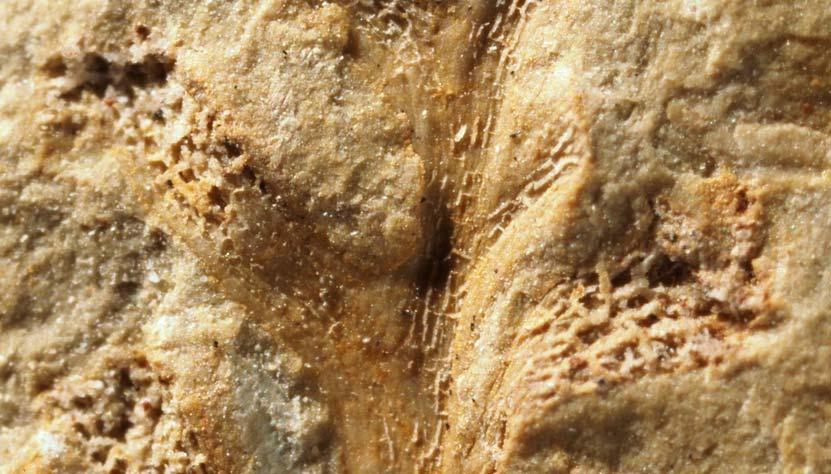

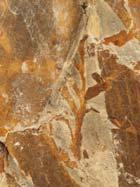
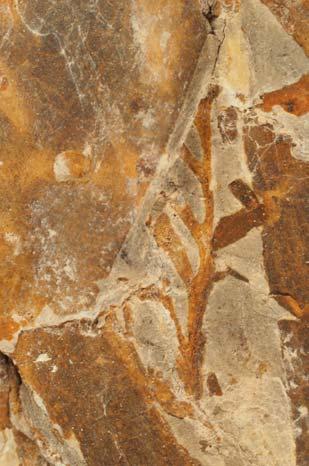

12 cm 0 COLOUR PLATES 297 ISSN 2410-4418 Palaeont. afr. (2023) 57 (Special Issue): i–xiv + 1–324 Aasvoëlberg (Aas 311) Plate 146
Kannaskoppianthus aasvoelensis
7 9 10
Aas 311 Hei elo
PRE/F/22078
PRE/F/22078
PRE/F/19343b
×20
×5
×2 8 3
×5
PRE/F/19407b ×10
2 ×2 1 4
PRE/F/19407b ×5
PRE/F/19407b
×20
6
PRE/F/19407b ×5
PRE/F/19407b
5
×40


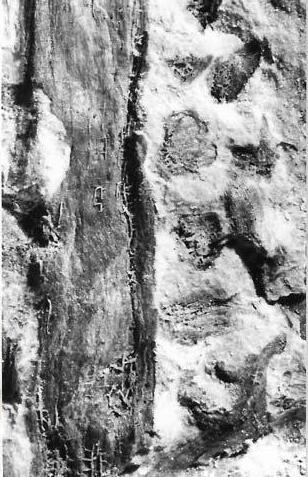


Kannaskoppianthus aasvoelensis

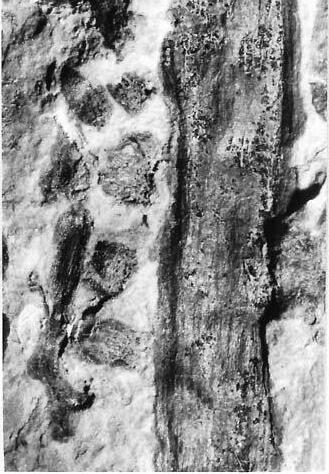

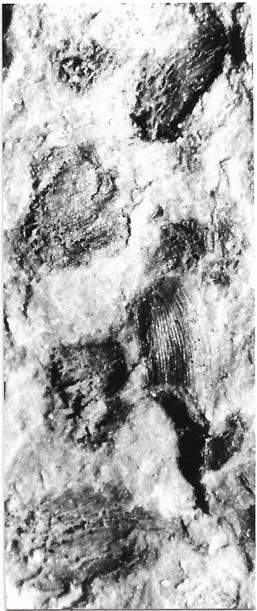

COLOUR PLATES 298 ISSN 2410-4418 Palaeont. afr. (2023) 57 (Special Issue): i–xiv + 1–324 12 cm 0
PRE/F/12001a
×40
PRE/F/12001a ×40
PRE/F/12001b
×10
PRE/F/12001a
×10
1
PRE/F/12001a ×20
2
Aasvoëlberg (Aas 311)
PRE/F/12001a ×2 ×5
Aas 311 Hei elo
PRE/F/12001a
PRE/F/12001a
×80
PRE/F/12001a
×80
3 4 5 6 10 9 8 7 Plate 147
PRE/F/12001a ×10
* * *
Insets in figs 2 & 6 show the location (see asterisk) of the microsporangium enlarged in figs 7–10.
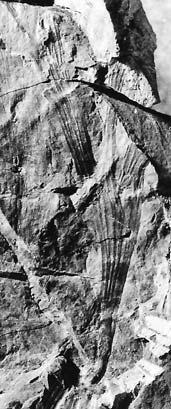
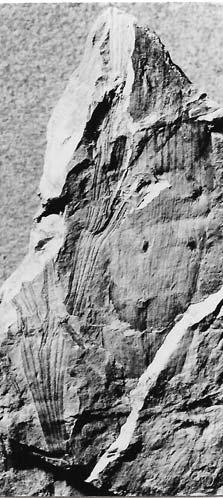

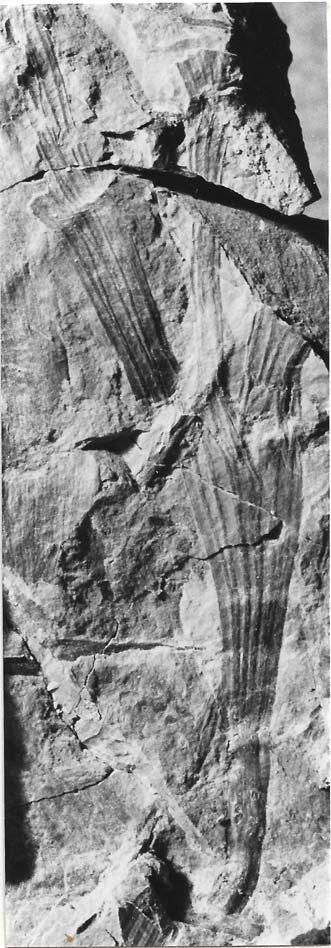


0 COLOUR PLATES 299 ISSN 2410-4418 Palaeont. afr. (2023) 57 (Special Issue): i–xiv + 1–324 Aasvoëlberg (Aas 311) 12 cm 0
PRE/F/12002 ×5
PRE/F/12002
×5
PRE/F/12002
×2
PRE/F/12002
×2
PRE/F/12002
×10
PRE/F/12002
×10
Rochipteris rollerii
1 6 5 4 3 2 Plate 148
Aas 311 Hei elo
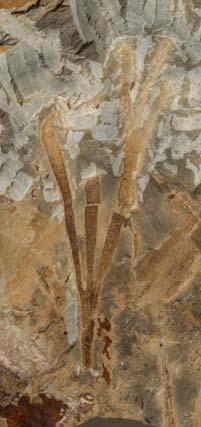



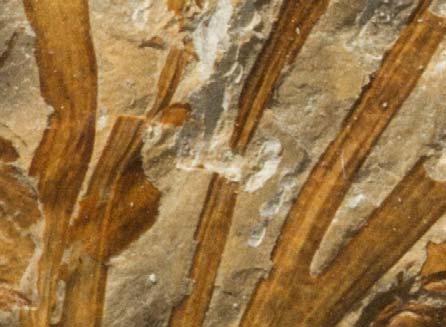
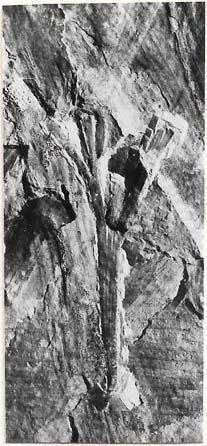

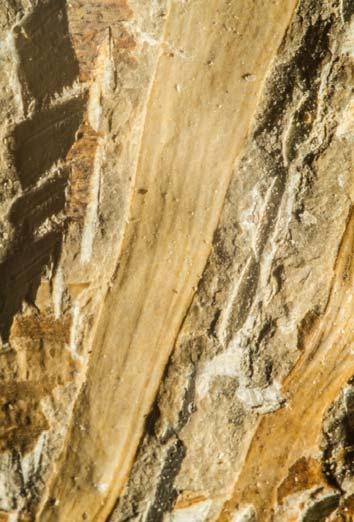

COLOUR PLATES 300 ISSN 2410-4418 Palaeont. afr. (2023) 57 (Special Issue): i–xiv + 1–324
(Aas
Plate 149
8 5 ×2 ×10 ×10 9
Aasvoëlberg
311)
Rochipteris rollerii
PRE/F/11988
PRE/F/11988
1
PRE/F/11988
×2
PRE/F/19348b
Aas 311 Hei elo
PRE/F/19346 ×2
PRE/F/19348b
×2
×5
PRE/F/19348b
12 cm 0
×5
×10
PRE/F/11988
7 6 4 2 3
PRE/F/11988


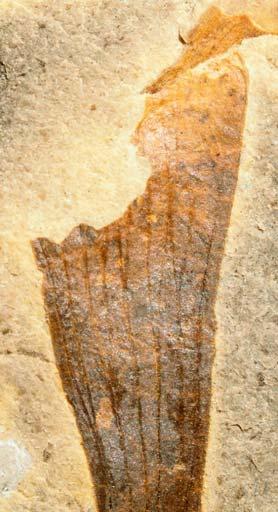
See p. 82 (fig. 1) for sketch combining PRE/F/19021a & b

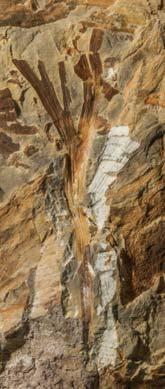

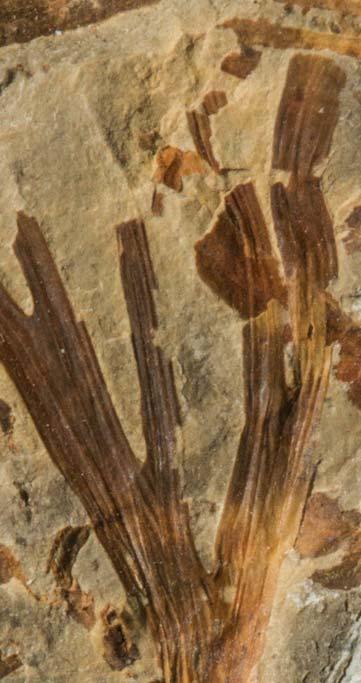
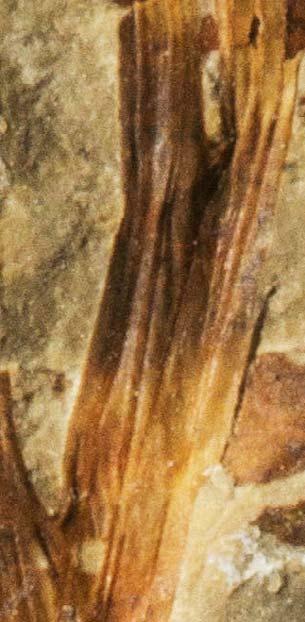
COLOUR PLATES 301 ISSN 2410-4418 Palaeont. afr. (2023) 57 (Special Issue): i–xiv + 1–324 Aasvoëlberg (Aas 311) Plate 150 12 cm 0
1
Rochipteris rollerii
×2
PRE/F/19021a
×5
PRE/F/19021a
PRE/F/11993
6 2
×2
×5
×10
7 5
PRE/F/11993
Aas 311 Hei elo
×10
3
PRE/F/19021a
4
×20
×20
8
PRE/F/11993
Rochipteris rollerii

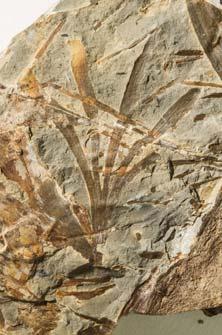



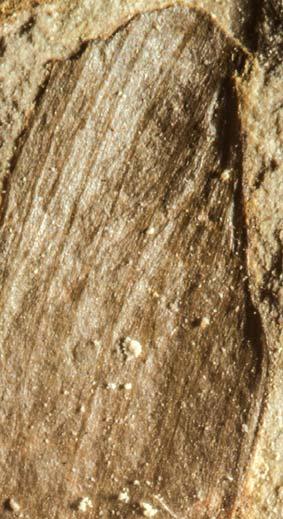
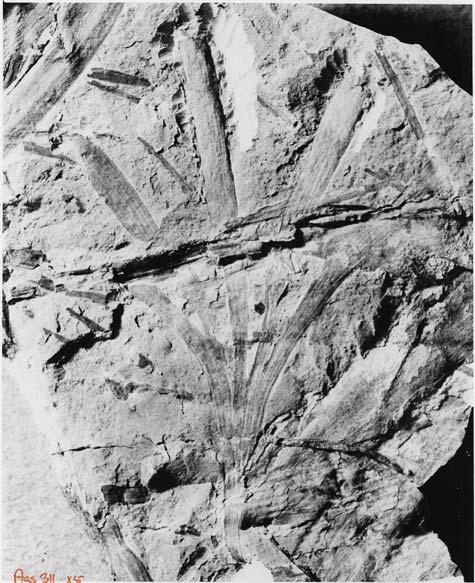
COLOUR PLATES 12 cm 0 302 ISSN 2410-4418 Palaeont. afr. (2023) 57 (Special Issue): i–xiv + 1–324
PRE/F/19020a
×2
PRE/F/19020a
×1
PRE/F/19020b
×1
×2
1
×10
PRE/F/19020b
3 2
×20
PRE/F/19020b
PRE/F/19020b
×1
PRE/F/19020b
7 6 5 4 Aasvoëlberg (Aas 311) Plate 151
Aas 311 Hei elo
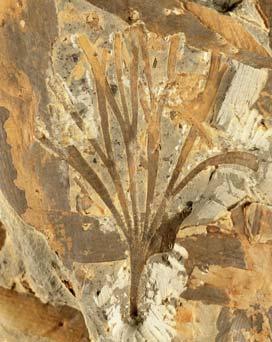

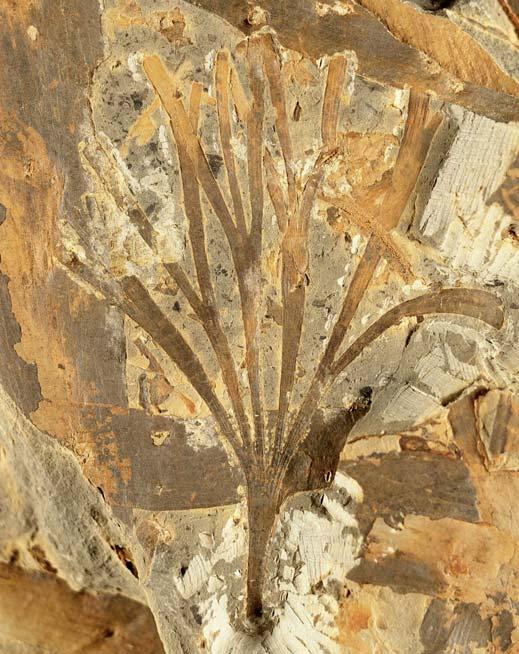
COLOUR PLATES 303 ISSN 2410-4418 Palaeont. afr. (2023) 57 (Special Issue): i–xiv + 1–324
PRE/F/19019
×5
PRE/F/19019
×2
PRE/F/19019
×1
Aas 311 Hei elo
1 3 2
Plate 152 12
0
Rochipteris rollerii
Aasvoëlberg (Aas 311)
cm
Fabiany Herrera (photo, Sept. 2022)
Kannaskoppianthus aasvoelensis
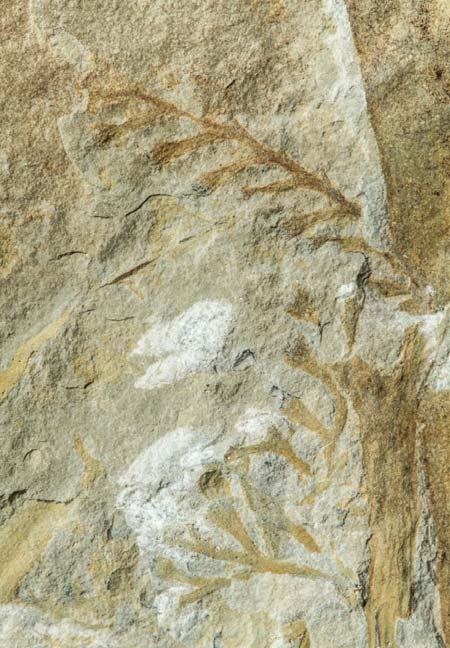
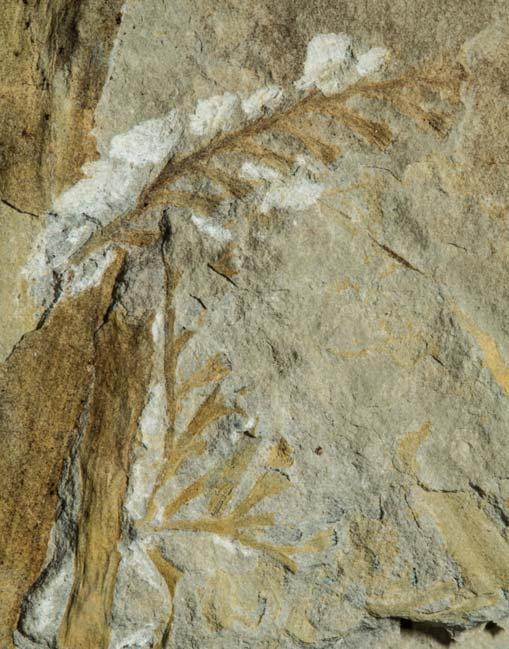

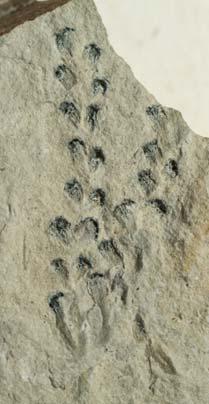





COLOUR PLATES 304 ISSN 2410-4418 Palaeont. afr. (2023) 57 (Special Issue): i–xiv + 1–324 12 cm 0
Plate 153
Aasvoëlberg (Aas 411)
PRE/F/12050b
PRE/F/12050b
PRE/F/12093
×5
PRE/F/12092a
PRE/F/12092b
×5 ×5
×10
1 2 4 6 7 8
×5
PRE/F/12092b
×10
PRE/F/12093
9
×10
Aas 411 Dic/Sph 3 5 ×2
×2

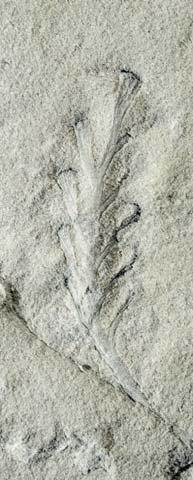




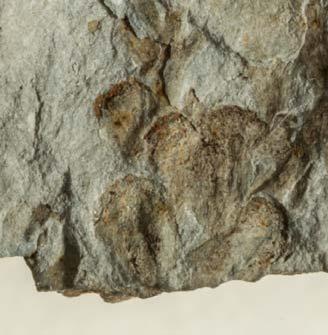
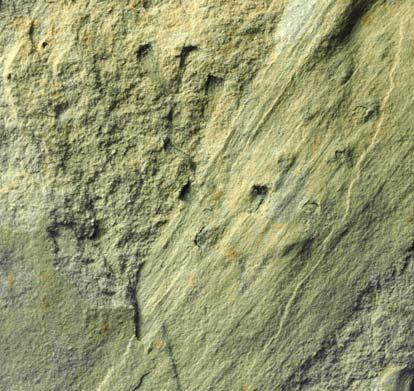

12 cm 0 COLOUR PLATES 305 ISSN 2410-4418 Palaeont. afr. (2023) 57 (Special Issue): i–xiv + 1–324 Aasvoëlberg (Aas 411)
Plate 154
Kannaskoppianthus aasvoelensis
Aas 411 Dic/Sph
×5
PRE/F/21337b
×20
×5
PRE/F/21337a
×10
PRE/F/21337a
PRE/F/21337b
×5
PRE/F/21727a
×2
PRE/F/20557b
×5
1 2 5
PRE/F/21339a
×10
3 4 9 6 8 7 ×10
PRE/F/21339a
PRE/F/21337b

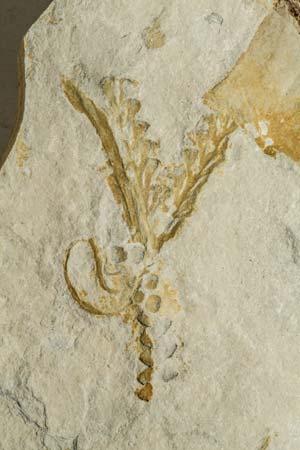
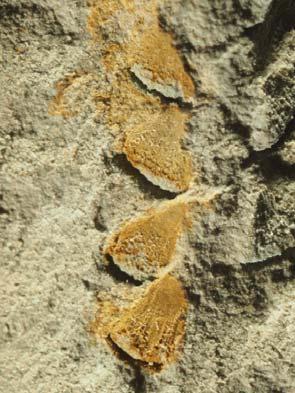

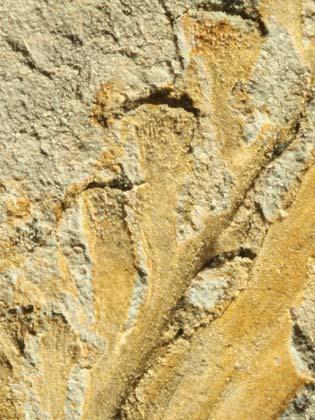



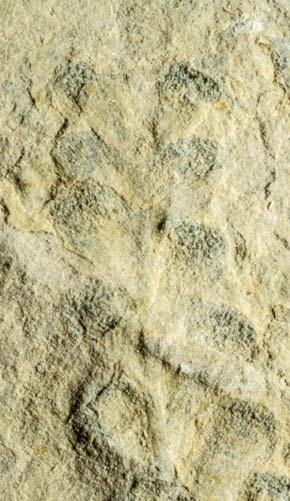
COLOUR PLATES 12 cm 0 306 ISSN 2410-4418 Palaeont. afr. (2023) 57 (Special Issue): i–xiv + 1–324
aasvoelensis Aasvoëlberg (Aas 411) Plate 155
Kannaskoppianthus
PRE/F/21726b
PRE/F/21726b
PRE/F/21717b ×5
×10
×5 ×2
×10
PRE/F/21717a
PRE/F/21717a
PRE/F/21717a
PRE/F/21717b
PRE/F/21717b
×5 ×2 1 2 3 4 5 7 8 9
×10
Aas 411 Dic/Sph
×10
6
PRE/F/21717b
Enlargement of inset in fig. 4
Fig. 9. Upper five microsporophylls show attached (unclearly preserved) microsporangia
Kannaskoppianthus aasvoelensis

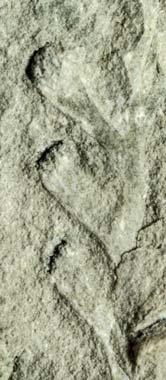
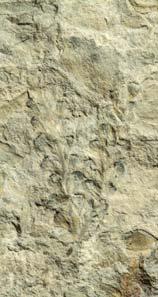

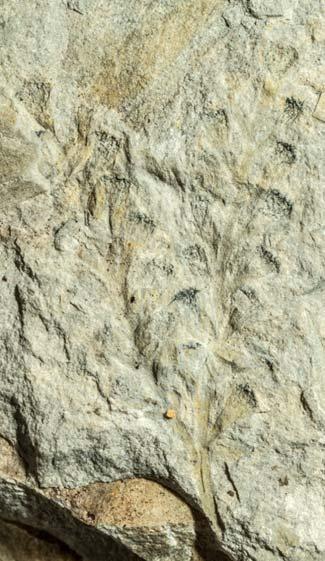

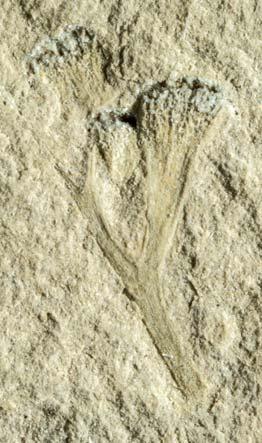



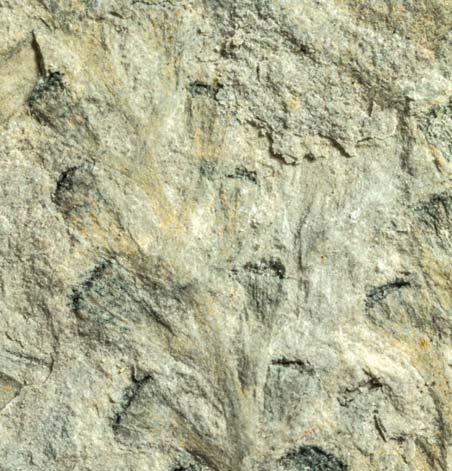


12 cm 0 COLOUR PLATES 307 ISSN 2410-4418 Palaeont. afr. (2023) 57 (Special Issue): i–xiv + 1–324 Aasvoëlberg (Aas 411) Plate 156
PRE/F/21719a
PRE/F/21720a
×20
×10 ×10 ×10 ×5 ×5
PRE/F/21720b PRE/F/21721b
PRE/F/21721a PRE/F/21721b
×2
×5 PRE/F/21720a 1 3 6 7 9 11 13 12 Aas
4 2 ×10 PRE/F/21719a ×10 ×20 10 PRE/F/21720b ×20 5
PRE/F/21720a
411 Dic/Sph
* *
* 8
Inset shows microsporophylls with attached (unclearly preserved) microsporangia
* * ×10
* shows position of microsporangia

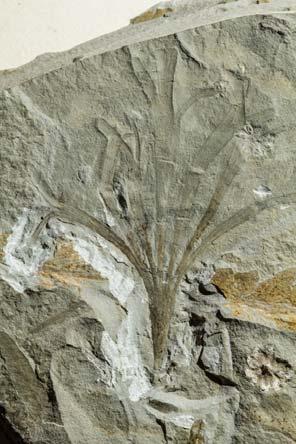
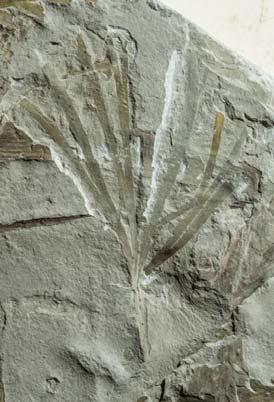

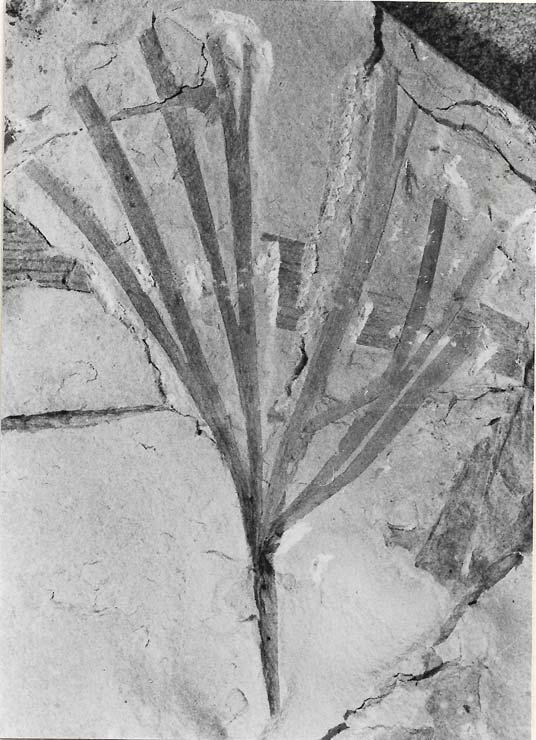
COLOUR PLATES 12 cm 0 308 ISSN 2410-4418 Palaeont. afr. (2023) 57 (Special Issue): i–xiv + 1–324
1
PRE/F/12094b ×1
×2
PRE/F/12094b
×2
PRE/F/12102
×1 4 Aasvoëlberg (Aas
PRE/F/12102
411) Rochipteris rollerii
×10
PRE/F/12094b
2 3 5 Plate 157
Aas 411 Dic/Sph

Rochipteris rollerii

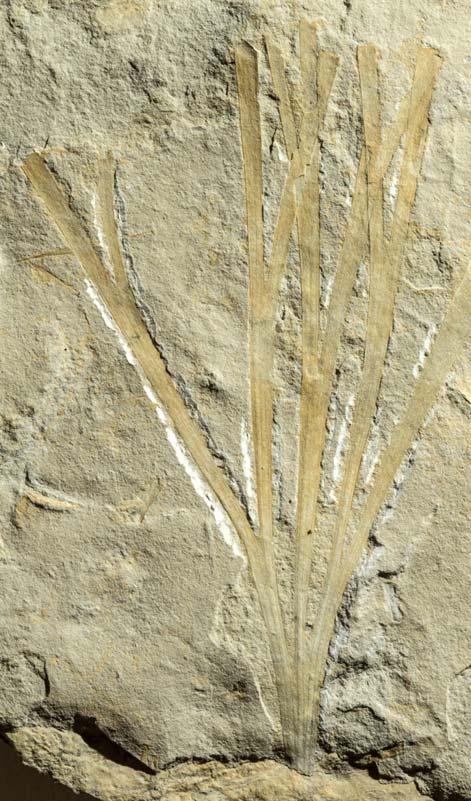


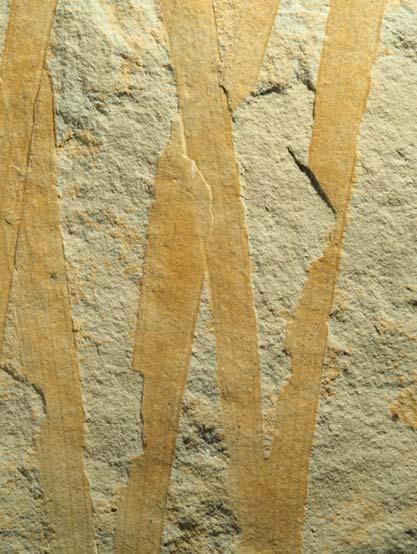

COLOUR PLATES 309 ISSN 2410-4418 Palaeont. afr. (2023) 57 (Special Issue): i–xiv + 1–324 12 cm 0
×1
×5
PRE/F/20557b
PRE/F/20557b
Plate 158 ×5
PRE/F/20557b
×5
PRE/F/20557a ×1 6 7 1 3 5 4 ×10 ×2 Aasvoëlberg (Aas 411) 2
Aas 411 Dic/Sph
PRE/F/20557a

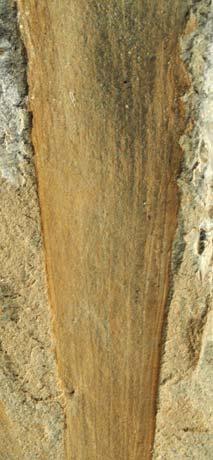
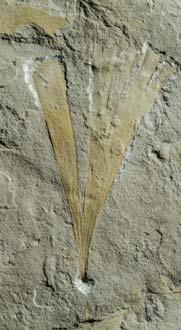

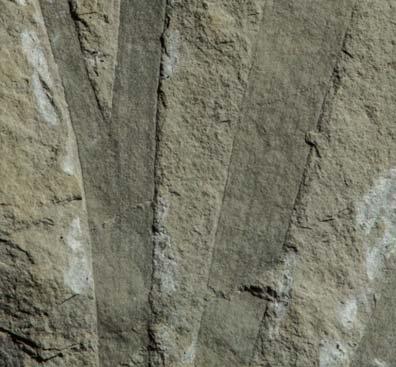

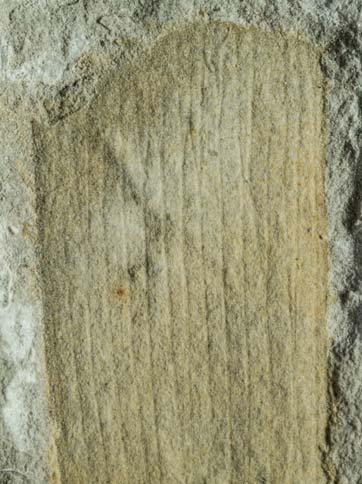
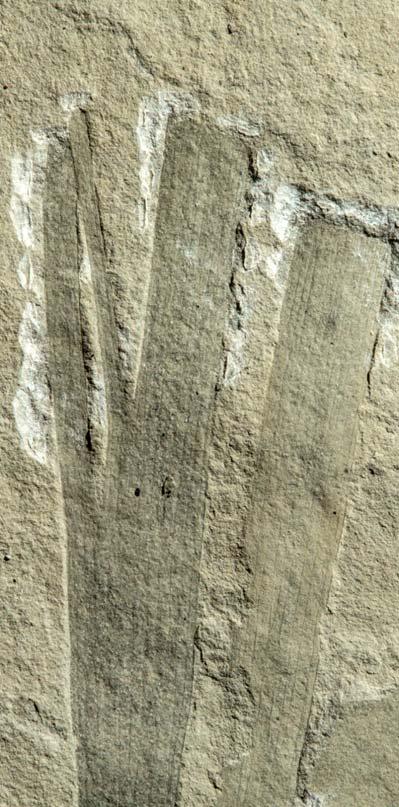
COLOUR PLATES 12 cm 0 310 ISSN 2410-4418 Palaeont. afr. (2023) 57 (Special Issue): i–xiv + 1–324 Plate 159
Aas 411 Dic/Sph
PRE/F/20543
PRE/F/20543
PRE/F/20538
PRE/F/20538
PRE/F/20529
×10
Rochipteris rollerii 3 4 5 6 7 8
PRE/F/20529
×5 ×1 ×1 ×1
×5
×1
PRE/F/20558a
×5
1 2 Aasvoëlberg (Aas 411)
PRE/F/20558a
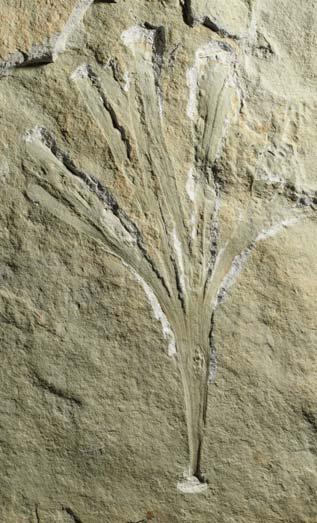
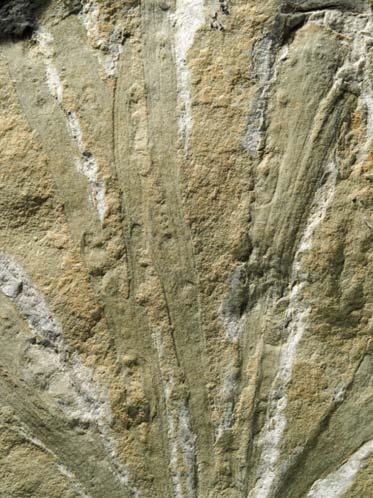



COLOUR PLATES 311 ISSN 2410-4418 Palaeont. afr. (2023) 57 (Special Issue): i–xiv + 1–324 Aasvoëlberg (Aas 411) Plate 160 ×2 PRE/F/21062
Rochipteris rollerii ×10
×5
1 4 5 12 cm 0
PRE/F/21062
×5 PRE/F/21062 ×10 PRE/F/21062 2 3
Aas 411 Dic/Sph
PRE/F/21062

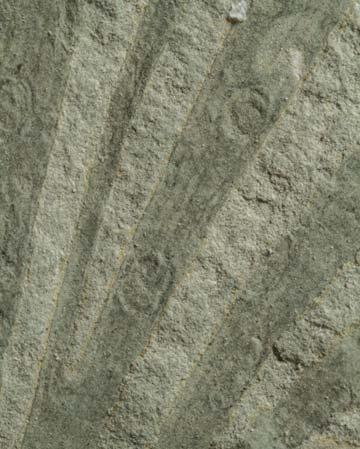



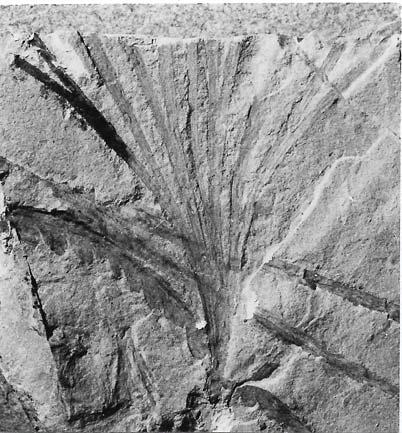

COLOUR PLATES 12 cm 0 312 ISSN 2410-4418 Palaeont. afr. (2023) 57 (Special Issue): i–xiv + 1–324
PRE/F/12103a
×5
6 7
PRE/F/12103a
PRE/F/12103a
×20
1
PRE/F/12103a ×1
×10
PRE/F/12103a
×2
×5
Aasvoëlberg (Aas 411) Rochipteris rollerii
Aas 411 Dic/Sph
5 3 2 4 Plate 161
PRE/F/12103a




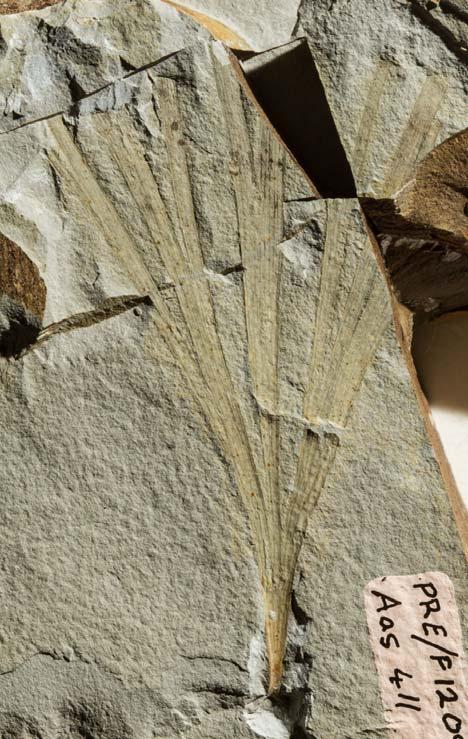


12 cm 0 COLOUR PLATES 313 ISSN 2410-4418 Palaeont. afr. (2023) 57 (Special Issue): i–xiv + 1–324 Plate 162
×5
PRE/F/12097a rollerii 6
Rochipteris PRE/F/12103b ×2
1
×5 2
PRE/F/12103b
7
Aas 411 Dic/Sph
PRE/F/12097a
3
×10
×10
PRE/F/12103b
PRE/F/12097a
×2
PRE/F/12097a
5 4 Aasvoëlberg (Aas 411)
×1
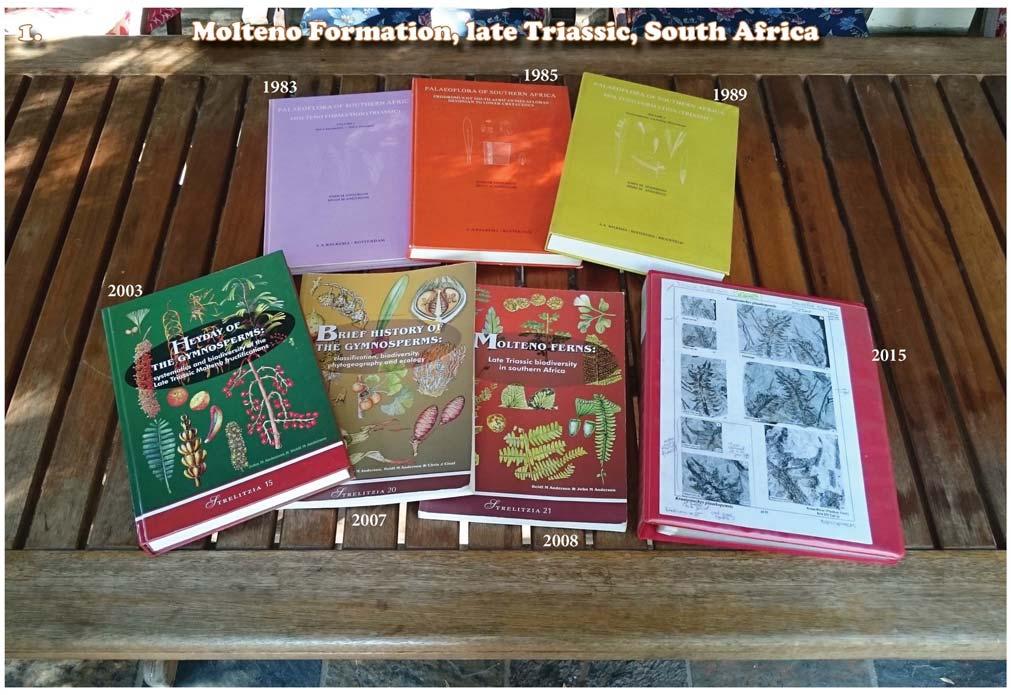
Our previous 7 Molteno Palaeoflora volumes (with a draft of the Sphenophyte volume)
1983 – ‘Dicroidium’ (Molteno, vegetative)
1985 – ‘Prodromus of South African megafloras’, Devonian to Lower Cretaceous
1989 – ‘Gymnosperms’, (excluding Dicroidium)
2003 – ‘Heyday of the gymnosperms’ (‘Molteno, fructifications’)
2007 – ‘Brief history of the gymnosperms’ (global review, Late Devonian to Present)
2008 – ‘Molteno ferns’
2018 – ‘Molteno sphenophytes’
314 JMA 2015 (with text adaptation since)
glossary,
315
Bibliography,
index
BIBLIOGRAPHY
AMTSBERG, H. 1969. A contribution to the mesophytic flora of South Australia (Springfield and Leigh Creek). Transactions of the Royal Society of South Australia 93, 79–85.
ANDERSON, J.M. (ed.) 1999. Towards Gondwana Alive; Promoting Biodiversity and Stemming the 6th Extinction. Gondwana Alive Society, 140 pp.
ANDERSON, J.M. & ANDERSON, H.M. 1983. Palaeoflora of Southern Africa: Molteno Formation (Triassic), Vol. 1: Part 1, Introduction, Part 2. Dicroidium. Rotterdam, Balkema. 227 pp.
ANDERSON, J.M. & ANDERSON, H.M. 1985. Palaeoflora of Southern Africa: Prodromus of South African Megafloras, Devonian to Lower Cretaceous. Rotterdam, Balkema. 423 pp.
ANDERSON, J.M. & ANDERSON, H.M. 1989. Palaeoflora of southern Africa: Molteno Formation (Triassic), Vol. 2: Gymnosperms (excluding Dicroidium). Rotterdam, Balkema. 567 pp.
ANDERSON, H.M. & ANDERSON, J.M. 1997. Why not look for proangiosperms in the Molteno Formation? Proceedings of the 4th European Palaeobotanical and Palynological Conference, Heerlen, Netherlands 58, 73–80.
ANDERSON, J.M. & ANDERSON, H.M. 2003. Heyday of the Gymnosperms: Systematics and Biodiversity of the Late Triassic Molteno Fructifications. Strelitzia 15. Pretoria, National Botanical Institute. 398 pp.
ANDERSON, H.M. & ANDERSON, J.M. 2008. Molteno Ferns: Late Triassic Biodiversity in Southern Africa. Strelitzia 21. Pretoria, South African National Biodiversity Institute, 258 pp.
ANDERSON, H.M., & ANDERSON. J.M. 2018. Molteno Sphenophytes: Late Triassic Biodiversity in Southern Africa. Palaeontologia africana, 53 (Special Issue), 1–391. Johannesburg, Evolutionary Studies Institute, Witwatersrand University. http://wiredspace.wits.ac.za/handle/10539/24672
ANDERSON, H.M., BARBACKA, M., BAMFORD, M., HOLMES, W.B.K. & ANDERSON, J.M. 2019a. Umkomasia (megasporophyll): Part 1 of a reassessment of Gondwana Triassic plant genera and a reclassification of some previously attributed. Alcheringa 43, 43–70.
ANDERSON, H.M., BARBACKA, M., BAMFORD, M., HOLMES, W.B.K. & ANDERSON, J.M. 2019b. Pteruchus (microsporophyll): Part 2 of a reassessment of Gondwana Triassic plant genera and a reclassification of some previously attributed. Alcheringa 43, 511–533.
ANDERSON, H.M., BARBACKA, M., BAMFORD, M., HOLMES, W.B.K. & ANDERSON, J.M. 2020. Dicroidium (foliage) and affiliated wood: Part 3 of a reassessment of Gondwana Triassic plant genera and a reclassification of some previously attributed. Alcheringa 44, 64–92.
ANDERSON, J.M., ANDERSON. H.M. & CLEAL, C.J. 2007. Brief History of the Gymnosperms: Classification, Biodiversity, Phytogeography and ecology. Strelitzia 20. Pretoria, National Botanical Institute. 280 pp.
ANDERSON, J.M., ANDERSON, H.M. & CRUICKSHANK, A.R.I. 1998. Late Triassic ecosystems of the Molteno/Elliot biome of southern Africa. Palaeontology 41, 387–421.
ANDERSON, J.M., ANDERSON, H.M., FATTI, L.P. & SICHEL, H. 1996. The Triassic explosion (?): a statistical model for extrapolating biodiversity based on the terrestrial Molteno Formation. Palaeobiology 22, 318–328.
ANDERSON, J.M., ANDERSON, H.M. & MACRAE, C.S. 1999. Freezing cold to searing heat. Plant and insect life of the Karoo Basin, pp. 140–166. In: MacRae, C.S., Life Etched in stone. Johannesburg, The Geological Society of South Africa,
ANDERSON, J.M., KOHRING, R. & SCHLÜTER, T. 1998. Was insect biodiversity in the Triassic akin to today?—a case study from the Molteno Formation (South Africa). Entomologia Generalis—Journal of General and Applied Entomology 23(1–2), 15–26.
ANDERSON, J.M., SCHOLTZ, C., EARDLEY, C. & BONNER, H. 2016. Biodiversity & extinction, Part 5, Insects. Supernova 5(3), 34–35.
ANDERSON, J.M., THACKERAY, F. & VISSER, K. 2016. Biodiversity & Extinction, Part 7, Hominins. Supernova 5(5), 34–35.
ARBER, E.A.N. 1913. A preliminary note on the fossil plants of the Mount Potts Beds, New Zealand. Proceedings of the Royal Society of New Zealand 86B, 344–347.
ARBER, E.A.N. 1917. The earlier Mesozoic floras of New Zealand. New Zealand Geological Survey Palaeontological Bulletin 6, 81 pp.
ARCHANGELSKY & CUNEO. 1990. Polyspermophyllum, a new Permian gymnosperm from Argentina, with considerations about the Dicranophyllales. Review of Palaeobotany and Palynology 63, 117–135.
ARTABE, A., MOREL, E.M., GANUZA, D.G., ZAVATTIERI, A.M. & SPALLETTI, L.A. 2007. La paleoflora Triásica de Potrerillos, provincia de Mendoza, Argentina. Ameghiniana 44(2), 279–301.
ARTABE, A.E., MOREL, E.M., SPALLETTI, L.A. & BREA, M. 1998. Paleoambientas sedimentarios y paleoflora asociada en al Triásico tardío de Malargüe, Mendoza. Revista de la Asociacion Geologica Argentina 53(4), 526–548.
ASH, S.R. 1976. The systematic position of Eoginkgoites American Journal of Botany 63, 1327–1331.
ASH, S.R. 1977. An unusual bennettitalean leaf from the Upper Triassic of the south-western United States. Palaeontology 20, 77–79.
AZCÁRATE, V. & FASOLA, A. 1970. Sobre formas nuevas para la flora triásica de Los Molles. Museo Nacional de Historia Natural, Chile, Boletín 29, 249–269.
BARONE-NUGENT, E.D., McLOUGHLIN, S. & DRINNAN, A.N. 2003. New species of Rochipteris from the Upper Triassic of Australia. Review of Palaeontology and Palynology 123, 273–287.
BEHRENSMEYER , A.K., DAMUTH, J.K., DIMICHELLE, W.A., POTTS, R., SUES, H.D. & WING, S.L. 1992. Terrestrial Ecosystems through Time: Evolutionary Paleoecology of Terrestrial Plants and Animals. Chicago, University of Chicago Press.568 pp.
BELL, S., HARRINGTON, H.J. & McKELLAR, I.C. 1956. Lower Mesozoic fossils from the Black Jacks, Waitaki River, South Canterbury. Transactions of the Royal Society of New Zealand 83(4), 663–672.
BODNAR, J., MOREL, E.M., COTUREL, E.P. & GANUZA, D.G. 2020, New plant fossil records and biostratigraphic analysis from the Uspallata Group (Late Triassic) at Cacheuta Hill, Cuyo Basin, west-central Argentina. Geobios 60, 3–27.
BOMFLEUR, B., DECOMBEIX, A-L., ESCAPA, I.H., SCHWENDEMANN, A.B., AXSMITH, B. 2013. Whole-plant concept and environment reconstruction of a Telemachus conifer (Voltziales) from the Triassic of Antarctica. International Journal of Plant Sciences 174, 425–444.
BOMFLEUR, B., DECOMBEIX, A-L., SCHWENDEMANN, A.B., ESCAPA, I.H., TAYLOR, E.L., TAYLOR, T.N. & McLOUGHLIN, S. 2014. Habit and ecology of the Petriellales, an unusual group of seed plants from the Triassic of Gondwana. International Journal of Plant Science 175(9), 1062–1075.
BONNER, H. 2016. The insect timetree, pp. 34–35. In: Anderson, J.M., Scholtz, C. & Eardley, C., Biodiversity & extinction, Part 5 Insects. Supernova, The Mag for Curious Kids 5(3).
BONNER, H., JOVERO, S., & ANDERSON., J.M. 2018. Plant & Insect Timetrees (Posters). Helsinki Botanical Garden, Finland.
BORDY, E., ABRAHAMS, M., SHARMAN, G.R., VIGLIETTI, P.A., BENSON, R.B.J., McPHEE, B.W., BARRETT, P.M., SCISCIO, L., CONDON, D., MUNDIL, R., RADEMAM, Z., JINNAH, Z. CLARK, J.M., SUAREZ, C.A., CHAPELLE, K.E.J. & CHOINIERE, J.N. 2020. A chronostratigraphic framework for the upper Stormberg Group: implications for the Triassic-Jurassic boundary in southern Africa. Earth-Science Reviews 203, 1–24.
CAIRNCROSS, B., ANDERSON, J.M. & ANDERSON, H.M. 1995. Palaeoecology of the Triassic Molteno Formation, Karoo Basin, South Africa—sedimentological and palaeoecological evidence. South African Journal of Geology 98, 452–478.
CARRUTHERS, W. 1872. Notes on fossil plants from Queensland, Australia. Quarterly Journal of the Geological Society of London 28, 350–359.
CHAPMAN, F. & COOKSON, I.C. 1926. A revision of the ‘Sweet’ collection of Triassic plant remains from Leigh’s Creek, South Australia. Transactions of the Royal Society of South Australia 1, 163–178.
Bibliography 316 ISSN 2410-4418 Palaeont. afr. (2023) 57 (Special Issue): i–xiv + 1–324
CHAPMAN, F. 1927. Monograph on the Triassic flora of Bald Hill, Bacchus Marsh, Victoria. Memoirs of the National Museum, Melbourne 7, 121–155.
CLIFFORD, H.T. & CAMILLERI, N. 1998. A mature cupule of Leptostrobus (Czekanowskiales) from the Late Triassic of Queensland. Memoirs of the Queensland Museum 42, 445–447.
CRANE, P.R. 1985. Phylogenetic analysis of seed plants and the origin of angiosperms. Annals of the Missouri Botanical Garden 72, 716–793.
CRANE, P.R. 1986. The morphology and relationships of Bennettitales, . In: Spicer, R.A. & Thomas, B.A. (eds), Systematic and Taxonomic Approaches in Palaeobotany, 163–175. Oxford, Clarendon Press.
CRANE, P.R. 1988. Major clades and relationships in the “higher” gymnosperms. In: Beck, C.B. (ed.), Origins and Evolution of Gymnosperms, 218–272. New York, Columbia University Press.
CUNEO, N.R., ISBELL, J, TAYLOR. E.L. & TAYLOR, T.N. 1993. The Glossopteris flora from Antarctica: taphonomy and paleoecology. Proceedings of the IXth International Congress on Carboniferous/Permian Stratigraphy and Geology, Buenos Aires Vol. 2, 13–40.
DiMICHELE, W.A. & GASTALDO, R. A. 2008. Plant paleoecology in deep time. Annals Missouri Botanical Garden 95, 144–198.
DOYLE, J.A. 2008. Integrating molecular phylogenetic and paleobotanical evidence on origin of the flower. International Journal of Plant Sciences 169(7), 816–843.
DU TOIT, A.L. 1927. The fossil flora of the Upper Karroo beds. Annals of the South African Museum 22, 289–420.
ELGORRIAGA, A., ESCAPA, I.H. & CÚNEO, N.R. 2019. Southern hemisphere Caytoniales: vegetative and reproductive remains from the Lonco Trapial Formation (Lower Jurassic), Patagonia. Journal of Systematic Palaeontology 17(17), 1477–1495.
ENGLER, A. 1897. Die natürlichen pflanzenfamilien Nachthäge zum II–IV Teil. Leipzig, Engelmann. 380 pp.
ETHERIDGE, R. Jr. 1894. Occasional descriptions of New South Wales fossils, No. 1: 1. Further traces of Schizoneura. Records of the Geological Survey of New South Wales 4(1), 32–33.
ETHERIDGE, R. Jr. 1895. Additional plant remains from the Leigh Creek Coal-field, central Australia. Transactions Royal Society South Australia 19, 138–145.
FEISTMANTEL, O. 1889. Übersichtliche Darstellung der geologischpalaeontologischen Verhältnisse Süd-Afrikas. Th 1: Die Karroo Formation und die dieselbe unterlagernden Schichten. Abhandlungen der Königlichen böhmischen Gesellschaft der Wissenschaften. (Rozpravy třídy matematiko-přírodově decké Král České spol ečnosti náuk). Prague 7(3), 1–89.
FERGUSON, D.K. 1992. Understanding plant taphonomic processes, or how to turn information losses into gains. In: Gall, J.C. & GrauvogelStamm, L. (eds), Taphonomy: Processes and Products, 2–4. Strasbourg, European Palaeontological Association (workshop).
FRENGUELLI, J. 1942. Contribuciones al conocimiento de la flora del Gondwana superior en la Argentina. I–X Notas del Museo de la Plata, Paleontología 7(42–51), 265–353.
FRENGUELLI, J. 1946. Contribuciones al conocimiento de la flora del Gondwana superior en la Argentina, XXXIII. Notas del Museo la Plata II, Paleontologia 87, 100–127.
GNAEDINGER, S.C. & ZAVATTIERI, A.M. 2017. Nuevos registros paleobotánicos de la Formación Nestares (Jurásico Temprano), extremo austral de la Cuenca Neuquina, Argentino. Revista Museo Argentino Ciencias Naturales, n.s 19(2), 101–112.
GRESHKO, M. 2020. Reimagining dinosaurs; from rainbow feathers to river monsters, prehistoric icons get a modern reboot. National Geographic 10(2020), 38–89.
HANCOX, P.J., NEVELING, J. & RUBIDGE, B.S. 2020. Biostratigraphy of the Cynognathus Assemblage Zone (Beaufort Group, Karoo Supergroup), South Africa. South African Journal of Geology 123(2), 217–238.
HANLON, V.C.T., OTTO, S.P. & AITKEN, S.N. 2019a. Somatic mutations substantially increase the per-generation mutation rate in the conifer Picea sitchensis Evolution Letters 3(4), 348–358.
HANLON, V.C.T., OTTO, S.P. & AITKEN, S.N. 2019b. Surprising genetic diversity in old growth trees. www.indefenseofplants.com/blog, 23 July 2019 (researchers at University of British Colombia).
HARRIS, T.M. 1933. A new member of the Caytoniales. The New Phytologist 32, 97–173.
HARRIS, T.M. 1940. Caytonia Annals of Botany 4, 713–734.
HARRIS, T.M. 1958. The seed of Caytonia The Palaeobotanist 7, 93–106.
HARRIS, T.M. 1964. The Yorkshire Jurassic Flora. 2. Caytoniales, Cycadales and Pteridosperms. London, British Museum of Natural History. 191 pp.
HERBST, R., TRONCOSO, A. & GNAEDINGER, S.C. 2001. Rochipteris nov. gen., hojas incertae sedis (= Chiropteris pro parte) del Triásico Superior de Argentina y Chile. Ameghiniana 38(3), 257–269.
HERBST. R. & TRONCOSO, A. 2012. La flora Triásica de la Quebrada Doña Inés Chica, Región de Atacama, Chile. GAEA, Journal of Geoscience 8(2), 55–66.
HILGER, H.H. 2014. Angiosperm Phylogeny Poster. Freie Universität Berlin.
HOEG, O.A. 1967. Psilophyta. In: Boureau, E. (ed.). Traité de Paléobotanique, Vol. 2, 193–433. Paris, Masson et Cie.
HOLMES, W.B.K. & ANDERSON, H.M. 2005. The Middle Triassic megafossil flora of the Basin Creek Formation, Nymboida Coal Measures, New South Wales, Australia. Part 5. The genera Lepidopteris, Kurtziana, Rochipteris and Walkomiopteris Proceedings of the Linnaean Society of New South Wales 126, 39–79.
IMBLER, S. 2019. Found: pollen on a 99-million-year old beetle, in amber. https://www.atlasobscura.com/articles/found-ancient-beetlepollen-amber
IRMIS, R.B, MUNDIL, R., MARTZ, J.W. & PARKER, W.G., 2011. High resolution U-Pb ages from the Upper Triassic Chinle Formation (New Mexico, USA) support a diachronous rise of dinosaurs. Earth and Planetary Science Letters 309, 258–267.
IUGS, 2018. International Chrono Stratigraphic Chart. International Comission on Stratigraphy (July 2018). www.stratigraphy.org
JACK, R.L. & ETHERIDGE, R., Jr. 1892. The geology and palaeontology of Queensland and New Guinea. Queensland Department of Mines, Geological Survey of Queensland Publications 92, 1–768.
JOHNSTON, R.M. 1888. A Systematic Account of the Geology of Tasmania. Hobart, Government Printer. 408 pp.
JONES, O.A. & DE JERSEY, N.J. 1947. The flora of the Ipswich Coal Measures—morphology and floral succession. Papers from the Department of Geology, University of Queensland 3, 1–88.
JONES, T.P. & ROWE, N.P. (eds) 1999. Fossil Plants and Spores: Modern Techniques. London, The Geological Society. 396 pp.
KOHRING, R.R. 1998. Conchostraca (Arthropoda: Crustacea) from the Molteno Formation (Upper Triassic, South Africa): palaeoecological suggestions. Journal of African Earth Sciences, Special Abstracts Issue 27(1A), 124–125.
KOHRING, R.R. & HÖRNIG, A.C.F. 1998. The earliest freshwater Bryozoa: evidence from the Upper Triassic Molteno Formation (South Africa). Journal of African Earth Sciences, Special Abstracts Issue 27(1A), 125.
KRASSILOV, V.A. 1977. Contributions to the knowledge of the Caytoniales. Review of Palaeobotany and Palynology 24, 155–178.
KUSTATSCHER, E,. & VAN KONlJNENBURG-VAN ClTTERT, H.A., 2011. The ferns of the Middle Triassic flora from Thale (Germany). Neues Jahrbuch für Mineralogie, Geologie und Palaeontologie 261, 209–248.
LABANDEIRA, C.C. 2006. Silurian to Triassic plant and hexapod clades and their associations: new data, a review, and interpretations Arthropod Systematics & Phylogeny 64(1), 53–94.
LABANDEIRA, C.C. 2018. Faunal ecology of the Molteno: towards an integrated ecology. In: Anderson, H.M., Anderson, J.M. Molteno Sphenophytes: Late Triassic Biodiversity in Southern Africa, 14–15 Johannesburg, Evolutionary Studies Institute, Witwatersrand University. http://wiredspace.wits.ac.za/handle/10539/24672
Bibliography 317 ISSN 2410-4418 Palaeont. afr. (2023) 57 (Special Issue): i–xiv + 1–324
LABANDEIRA, C.C., ANDERSON, J.M. & ANDERSON, H.M. 2018
Expansion of arthropod herbivory in Late Triassic South Africa: the Molteno biota, Aasvoëlberg 411 site and developmental biology of a gall. In: Tanner, L.H. (ed.), The Late Triassic World, Topics in Geobiology (Ch. 14), 623–719. Springer International Publishing AG
LABANDEIRA, C.C., CURRANO, E.D. 2013. The fossil record of plant–insect dynamics. Annual Review of Earth and Planetary Sciences 41, 287–311.
LABANDEIRA, C.C., WILF, P., JOHNSON, K.R. & MARSH. F. 2007. Guide to Insect (and other) Damage Types on Compressed Plant Fossils (Version 3.0–Spring 2007), Washington, D.C., Smithsonian Institution, 26 pp. http://paleobiology.si.edu/insects/index.html
LEDFORD, H. 2017. Massive database of 182,000 leaves is helping predict plant family trees. https://www.scientificamerican.com/article/
LUCAS, S.G., TANNER, L.H., KOZUR, H.W., WEEMS, R.E. & HECKERT, A.B. 2012. The Late Triassic timescale: age and correlationof the Carnian-Norian boundary. Earth-Science Reviews 114, 1–18.
LUTZ, A., GNAEDINGER, S., MANCUSO, A. & CRISAFULLI, A. 2011. Paleoflora de la Formación Los Rastros (Triásico Medio), Provincia de San Juan, Argentina, consideraciones taxonómicas y tafonómicas. Ameghiniana 48(4), 568–588.
MANCUSO, A.C., BENAVENTE, C.A., IRMIS, R.B. & MUNDIL, R., 2020. Evidence for the Carnian pluvial episode in Gondwana: new multiproxy climate records and their bearing on early dinosaur diversification. Gondwana Research 86, 104–125.
MARSICANO, C.A., IRMIS, R.B., MANCUSO, A.C., MUNDIL, R. & CHEMALE, F., 2016. The precise temporal calibration of dinosaur origins. PNAS 113(3), 509–513.
McCOY, F. 1847. On the fossil botany and zoology of the rocks associated with the coal of Australia. Annals and Magazine of Natural History 20, 145–157.
McLOUGHLIN, S., TOSOLINI, A.P. & DRINNAN, A.N. 2000. Revision of an Early Cretaceous macroflora from the Maryborough Formation, Maryborough Basin, Queensland, Australia. Memoirs of the Queensland Museum 45, 483–503.
MENENDEZ, C.A. 1951. La flora Mesozoica de la Formacion Llantenes (Provincia de Mendoza). Revista del Instituto Nacional de Investigaciones de las Ciencias Naturales (Botánica) 2(3), 147–261.
MEYEN, S.V. 1987. Fundamentals of Palaeobotany. London, Chapman & Hall. 432 pp.
MOREL, E.M., ARTABE, A.E., GANUZA, D.G. & ZÚŃIGA, A. 2011. La paleoflora Triásica del Cerro Cacheuta, Provincia de Mendoza, Argentina. Petriellales, Cycadales, Ginkgoales, Voltziales, Coniferales, Gnetales y gimospermas incertae sedis. Ameghiniana 48(4), 520–540.
MORRIS, J. 1845. Fossil flora. In P.E. de Strezelecki, Physical Description of New South Wales and van Diemans Land, 245–254. London, Longman, Brown & Green.
OGG, J.G., HUANG, C. & HINNOV, L. 2014. Triassic timescale status: a brief overview. Albertiana 41, 3–30.
OPLUŠTIL, S., PŠENIČKA, J., BEK, J., WANG, J., FENG, Z., LIBERTÍN, M., ŠIMŮNEK, Z., BUREŠ, J. & DRÁBKOVÁ, J. 2014. T° peat-forming plant assemblage preserved in growth position by volcanic ash-fall: a case study from the Middle Pennsylvanian of the Czech Republic. Bulletin of Geosciences 89(4), 773–818.
PENNISI, E. 2016. Shaking up the tree of life; species were once thought to keep to themselves. Now hybrids are turning up everywhere, challenging evolutionary theory. Science 354, 817–821
POLE, M.S. & RAINE, J.I. 1994.Triassic plant fossils from Pollock Road, Southland, New Zealand. Alcheringa 18, 147–159.
RASMUSSEN, C., MUNDIL, R., IRMIS, R.B. et al. 2020. U-Pb zircon geochronology and depositional age models for the Upper Triassic Chinle Formation (Petrified Forest National Park, Arizona, USA): Implications for Late Triassic paleoecological and paleoenvironmental change The Geological Society of America Bulletin 133(3–4), 539–558.
REYMANÓWNA, M. 1973. The Jurassic flora from Grojec near Kraków in Poland. Part II—Caytoniales and anatomy of Caytonia Acta Palaeobotanica Polonica 14, 46–87.
RETALLACK, G.J. 1980. Middle Triassic megafossil plants and trace fossils from Tank Gully, Canterbury, New Zealand. Journal of the Royal Society of New Zealand 10, 31–63.
RETALLACK, G.J. 1981. Middle Triassic megafossil plants from Long Gully, near Otematata, north Otago, New Zealand. Journal of the Royal Society of New Zealand 13(3), 107–127.
RETALLACK, G.J. 1983. Middle Triassic megafossil marine algae and land plants from near Benmore Dam, southern Canterbury, New Zealand. Journal of the Royal Society of New Zealand 13, 129–154.
RETALLACK, G.J. 1985. Triassic fossil plant fragments from shallow marine rocks of the Murihiku Supergroup, New Zealand. Journal of the Royal Society of New Zealand 15, 1–26.
ROTHWELL, G.R. & STOCKEY, R.U. 2016. Phylogenetic diversification of Early Cretaceous seed plants: the compound seed cone of Doylea tetrahedrasperma. American Journal of Botany 103(5), 923–937.
ROZEFELDS, A.C., 1986. Type, figured and mentioned fossil plants in the Queensland Museum. Memoirs of the Queensland Museum 22, 141–153.
RUFFELL, A., DAL CORSO, J.A. & BENTON, M. 2018. Triassic extinctions & explosions. Geoscientist 28(8), 10–15.
SCOTESE, C.R. 1997. Palaeogeographic Atlas: Paleomap Project. Report 900497. Arlington, U.S.A., University of Texas.
SEWARD, A.C. 1903. Fossil floras of the Cape Colony. Annals of the South African Museum 4(1), 1–122.
SHIRLEY, J. 1898. Additions to the fossil flora of Queensland, mainly from the Ipswich Formation, Trias-Jura System. Bulletin of the Geological Survey of Queensland 7, 1–25.
SMITH, R.M.H., RUBIDGE, B.S., DAY, M.O. & BOTHA, J. 2020. Introduction to the tetrapod biozonation of the Karoo Supergroup. South African Journal of Geology 123(2), 131–140.
SMITH, T., NICOLL, R., LAURIE, J.R., CROWLEY, J., McKELLAR, J., CAMPBELL, H.J., RAINE, I. & MANTLE, D.J. 2018. Recalibrating Australian Triassic palynostratigraphy to the International Geologic Timescale using high resolution CA-IDTIMS dating. ASEG Extended Abstracts 1(1).
SOLMS-LAUBACH, H. & STEINMANN, G. 1899. Das Auftreten und die Flora de rhätischen Kohlenschichten von La Ternera (Chile) In: Steinmann, G., Beiträge zur Geologie und Palaeontologie von Südamerika, VII, 581–609. Neues Jahrbuch für Mineralogie, Geologie und Palaeontologie 12
STANLEY. S.M. 1979. Macroevolution. Pattern and Process. San Francisco, Freeman & Co. 332 pp.
SQUIRES, D. 2012. Type and figured Palaeontological Specimens in the Tasmanian Museum and Art Gallery: a Catalogue. Hobart, Tasmanian Museum and Art Gallery. 164 pp.
SYLVESTER-BRADLEY, PC. 1977. Biostratigraphical tests of evolutionary theory. In: Kauffman, E.G. & Hazel, J.E. (eds), Concepts and Methods of Biostratigraphy, 41–63. Stroudsburg, Pennsylvania Dowden, Hutchinson & Ross Inc..
TAYLOR, E.L. 1996. Enigmatic gymnosperms? Structurally preserved Permian and Triassic seed ferns from Antarctica. Review of Palaeobotany and Palynology 90, 303–318.
TAYLOR, E.L. & TAYLOR, T.N. 2009. Seed ferns from the late Paleozoic and Mesozoic: any angiosperm ancestors lurking there? American Journal of Botany 96, 237–251.
TAYLOR, T.N., DEL FUEYO, G.M. & TAYLOR, E.L. 1994. Permineralised seed fern cupules from the Triassic of Antarctica: implications for cupule and carpel evolution. American Journal of Botany 81, 666–777.
THACKERAY, J.F. 2007. Approximation of a biological species constant? South African Journal of Science 103, 489.
THACKERAY, J.F. 2018. Alpha and sigma taxonomy of Pan (chimpanzees) and Plio-Pleistocene hominin species. South African Journal of Science 114(11/12), 1–2.
THACKERAY, J.F. 2019. Alpha and sigma taxonomy of Lystrosaurus murrayi and L. declivis, Triassic dicynodonts (Therapsida) from the Karoo Basin, South Africa. South African Journal of Science 115 (3/4), 1–3.
Bibliography 318 ISSN 2410-4418 Palaeont. afr. (2023) 57 (Special Issue): i–xiv + 1–324
THACKERAY, J.F., BELLANY, C.L., BELLARS, D. et al. 1997. Probabilities of conspecificity: application of a morphometric technique to modern taxa and fossil specimens attributed to Australopithecus and Homo South African Journal of Science 93, 195–196.
THACKERAY, J.F., DURAND, J.F. & MEYER, L. 1998. Morphometric analysis of South African dicynodonts attributed to Lystrosaurus murrayi (Huxley, 1859) and L. declivis (Owen, 1860): probabilities of conspecificity. Annals of the Transvaal Museum 36, 413–420.
THACKERAY, J.F. & DYKES, S. 2016. Morphometric analyses of hominoid crania, probabilites of conspecificity and an approximation of a biological species constant. Homo - Journal of Comparative Human Biology 67(1), 1–10.
THACKERAY, J.F., MAUREILLE, B., VANDERMEERSCH, B., BRAGA, J. & CHAIX, R. 2005. Morphometric comparisons between Neanderthals and ‘anatomically modern’ Homo sapiens from Europe and the Near East. Annals of the Transvaal Museum 42, 47–51.
THACKERAY, J.F. & ODES, E. 2013. Morphometric analysis of early Pleistocene African hominin crania in the context of a statistical (probabilistic) definition of a species. Antiquity, 87. http://antiquity.ac.uk/ projgall/thackeray335/
THACKERAY, J.F. & SCHREIN, C.M. 2017. A probabilistic definition of a species, fuzzy boundaries and ‘sigma taxonomy’. South African Journal of Science 113(5/6), 1–2.
WALKOM, A.B. 1924. On fossil plants from Bellevue, near Esk. Memoirs of the Queensland Museum 8, 77–92.
WALKOM, A.B. 1925a. Fossil plants from the Narrabeen Stage of the Hawkesbury Series. Proceedings of the Linnean Society of New South Wales 50, 214–224.
WALKOM, A.B. 1925b. Notes on some Tasmanian Mesozoic plants. Part 1, Papers and Proceedings of the Royal Society of Tasmania, 1924, 73–89.
WALKOM, A.B. 1926. Notes on some Tasmanian Mesozoic plants. Part 1. Papers and Proceedings of the Royal Society of Tasmania, 1925, 63–74.
WANG, J. , PFEFFERKORN, H.W. , SUN, B. & LIU, L. 2003.Discovery of organic connection of Chiropteris Kurr and Nystroemia Halle from Early Permian of western Henan, China. Chinese Science Bulletin 48(20), 2248–2252.
WANG, J., PFEFFERKORN, H.W., ZHANG, Y. & FENG Z. 2012. Permian vegetational Pompeii from Inner Mongolia and its implications for landscape paleoecology and paleobiogeography of Cathaysia. www. pnas.org/cgi/doi/10.1073/pnas.1115076109
WEBB, J.A. & MITCHELL, M.M. 2006 Stratigraphy and palaeoflora of the Triassic Council Trench Formation, central Victoria. Proceedings of the Royal Society of Victoria 118(1), 113–127.
WILSON, E.O. 1992. The Diversity of Life. London, Penguin Books. 406 pp.
WOOD, B. 2014. Where we came from. Scientific American 311(3), 44–41.
Bibliography 319 ISSN 2410-4418 Palaeont. afr. (2023) 57 (Special Issue): i–xiv + 1–324
GLOSSARY
The terms included here are those considered most relevant to our general study of Molteno and Gondwana Triassic floristics and biodiversity. They are arranged to emphasize the significance of certain fields. Though some terms are not applied in this particular volume, they are retained for coherence of related topics.
Updated from And. & And. (2003, 2018).
** – terms introduced in our own publications on the Molteno or other fossil floras of Southern Africa.
* – usage as followed in our own works.
SAMPLING
Optimal sampling of fossilferous strata – and there are many criteria that might be considered in defining optimal – is critical to reliable tracking of diversity patterns through time.
Frequency – The measure of frequency of a fossil taxon within a formation is the number of taphocoenoses (TCs) or assemblages, out of the total sampled, in which it has been found. Through the Gondwana Triassic, for instance, it might be the number of degree squares (out of the total sampled) in which if has been found.* (This differs from the usual definition of frequency, where the proportional specimen count of a taxon withing a single taphocoenosis is referred to.)
Abundance – The abundance of a fossil taxon is a measure of the absolute or relative number of individuals collected from or encountered in an assemblage, formation, region or continent.*
Assemblage – The full suite of fossil individuals or palaeodemes collected from a distinct lithological unit (lithosome) of limited geographic and stratigraphic extent. A megaplant assemblage will generally represent a localized mosaic of plant associations, less often a single association, through several generations.*
Locality – An area to about 1 km in diameter, which may include continuous fossiliferous exposure, but will generally include one or more productive exposures of lesser rank.*
Extensive sampling – Concerns the number and spread of localities sampled in a fossiliferous horizon.*
Intensive sampling – Concerns the comprehensiveness of collecting from a particular fossiliferous deposit.*
Singletons – Those species recorded from a particular geological horizon (member, formation or biozone) that are known from only a single locality (more specifically an assemblage). The number of singletons (and doubletons) is critical in projecting biodiversity from the observed record.
Doubletons – Those species recorded from a particular geological horizon that are known from only two localities. (Note that these definitions of singletons and doubletons differ from those referring to specimens occurring within an assemblage.)
SAMPLING HIERARCHY (geographic subdivisions)** (see And. & And., 1983)
Superregion
Region
Subregion
Superlocality Locality
Sublocality
Supersite Site Subsite
Superregion Area: (a) To 10 000 km diam. (b) Continents or sub-contintents; e.g. SAf (Southern Africa).
Region Area: (a) To 1000 km diam. (b) Geological basins (or major portions thereof), or coherent clusters of smaller basins or erosional remnants; e.g. Ka (Karoo Basin).
Subregion Area: (a) To 100 km diam. (b) Degree squares (applying the global long./lat. grid); e.g. SAf (Ka 4), the grid that includes Umk 111.
Superlocality Area: (a) To 10 km diam. (b) Incorporates clusters of localities that fall reasonably into areas of topographic or geological unity, such as a section of river valley or the slopes of a mountain; e.g. Hla (Hlatimbe).
Locality
Area: (a) To 1 km diam.
(b) May include continuous fossiliferous exposure over the full km, but will generally include one or more productive exposures of lesser rank; e.g. Hla 2 (Hlatimbe).
Sublocality
Area: (a) To 100 m diam.
(b) Such as an exposed surface or section (stream or erosion gully) of backswamp or floodplain deposit; e.g. Hla 21 (Hlatimbe).
Supersite
Area: (a) To 10 m diam.
(b) Such as a shale lens (lithosome) representing a section through an abandoned channel; e.g. Hla 213 (Hlatimbe).
Site Area: (a) To 1 m diam.
(b) A single 1 m wide trench excavated at a supersite to expose the sequence of fossiliferous beds (not considered in this vol.).
Subsite
Area: (a) To 10 cm diam.
(b) A 10 cm2 grid superimposed on an exposed bedding-plane delineating areas of this rank would be appropriate for detailed association analyses (not considered in this vol.).
TAPHONOMY
There is inevitably a reduction between the number of species making up the original flora and fauna of the region and that preserved in the fossil record. This filtering or winnowing of the original diversity occurs through the taphonomic process. Taphonomy is of vital concern in biodiversity projections. (Selected references: Ferguson 1992; Behrensmeyer et al. 1992; Cuneo et al. 1993).
Taphonomy – The conditions and processes intervening between a living species association and a fossil assemblage.
Taphonomic mode – Reflects the environmental context of the fossiliferous deposit. Examples include levee, lake, crevasse splay or abandoned channel of the floodplain (i.e. subenvironments of meandering and braided fluvial systems).
Isotaphonomic – Refers to fossiliferous assemblages of similar taphonomic mode.
Biocoenosis (BC) – Living community.
Thanatocoenosis – Death assemblage; that fraction of the original community that is preserved in the fossil deposit.
Taphocoenosis (TC) – Taphonomic assemblage; fossil assemblage resulting from the taphonomic process; the aggregate of fossil remains contained in a deposit or bed.
Phytotaphocoenosis – A fossil plant assemblage or plant taphocoenosis.
Autochthonous – Described TCs that have originated in situ. While such assemblages might be relatively common in the case of fossil tetrapods, they are a far more rare phenomenon in palaeobotany (e.g. horsetails entombed in growth position in a marsh).
Parautochthonous – Describes TCs deposited close to the original site of occurrence.
Allochthonous – Describes TCs deposited at some significant distance from the original site of occurrence.
PALAEODEMES**
Terms either from And. & And. (1983) or our later works.
Palaeodeme (fossil population) – A collection of fossil specimens judged to represent a single potentially interbreeding population of plants or animals, showing a normal distribution of variation for selected diagnostic characters, and derived from a single taphocoenosis from a discrete small-scale lithological unit (lithosome) such as an abandoned channel infill or crevasse splay.**
Reference palaeodeme (Ref.pal.) – The most comprehensive, representative, photographically documented palaeodeme in the literature proposed as reference for a particular infrageneric taxon.**
Bibliography 320 ISSN 2410-4418 Palaeont. afr. (2023) 57 (Special Issue): i–xiv + 1–324
Upper limit to areas Name
(max. diam.) (examples)
000 km SAf 1000 km SAf (Ka) 100 km SAf (Ka 4) 10 km Hla 1 km Hla 2 100 m Hla 21 10 m Hla 213 1 m Hla 2131 10 cm Hla 21311
codes
10
Glossary
Reference assemblage (RA) – That assemblage from which the reference palaeodeme derives.**
Reference specimen (RS) – The most complete, average, mature specimen selected from the reference palaeodeme.**
Home palaeodeme – The palaeodeme from which a specimen derives.** Sister palaeodeme (Sis.pal.) – A palaeodeme belonging to the same species.**
ABUNDANCE/RARITY**
No matter how extensively (number of localities) or intensively (number of specimens) one has sampled a fossiliferous formation, there inevitably appear certain fringe taxa – those that range from very rare to vanishingly rare. This is especially the case with fruiting material – in the present case, sphenophyte strobili or fragments of strobili. And inevitably, amongst these there will be specimens on the borderline regarding quality of preservation – those sufficient or not regarding diagnostic characters for recognizing new taxa.
Rarity: as measured in man-hours cleaving; see And. & And. (2003, tabs 8a,b, p. 13).
Mono-dominant ..... 70–100%
Co-dominant ......... 70–100
Abundant ............... 20–69%
Common ................ 3–5%
Sparse .................... 1–2%
Rare ..................... >1 cone per 1–5 man-hours (but <1% of TC)
Very rare ................ 1 cone per 5–49 man-hours
Extremely rare ....... 1 cone per 50–499 man-hours
Vanishingly rare .... 1 cone per 500–4999 man-hours
Infinitely rare ......... 1 cone in over 5000 man-hours
AFFILIATED ORGANS **
Reliability grades (after And. & And. 1985, p. 85)
The evidence for linking organs ranges from marginal to certain. At the lower end of the range the evidence will be slim, yet suggestive, or alternate options might be more or less equally likely, while at the upper end of the range clear organic attachment certifies linkage (see Pt 4, p.77)
Grade 1, marginal
Grade 2, poor
Grade 3, fair
Grade 4, good
Grade 5, certain
FOSSIL TAXA
– Marginal likelihood of affiliation; mutual occurrence (weak).
– Most feasible affiliation (alternatives competitive); mutual occurrence (unclear).
– Probable affiliation (alternatives weak); mutual occurrence (fairly clear), little other supportive data.
– Virtually exclusive likelihood of affiliation; mutual occurrence (particularly clear), cuticle correspondence and/or kindred reinforcement, and/or possible organic attachment.
– Certain affiliation; organic attachment undoubted.
For form-genera and organ-genera, we follow standard usage. Further terms in this field are introduced, or used in a particular sense, to meet the specific needs of our Molteno research. The concepts can equally be applied to species. Note that this piece on ‘Fossil taxa’ was compiled for our work on the Molteno gymnosperms (And. & And., 2003).
Form-genus – “a genus of fossil plants based on a detached organ which, because of the limited characters shown, cannot be assigned to a family, although it may be possible to assign it to a higher taxonomic level. The “artificial” nature of such a genus is illustrated by the several instances where we have one form-genus in which different species may closely resemble members of two or more different families” (Jones & Rowe, 1999).
Organ-genus – “a genus based on only part (an organ or organs) of a fossil plant, showing a sufficient range of distinctive characters that it may reasonably be assigned to a family. An organ-genus is regarded as “natural”, in the sense that its constituent species are believed to have the same close relationship as those of a living genus. However, an organ-genus differs from a genus of living plants in that only fossils of
the same organ, showing the same type of characters, can be assigned to it (e.g. fossil lauraceous leaves cannot be assigned to Laurocarpum, an organ-genus of fossil lauraceous fruit)” (Jones & Rowe, 1999).
Whole-plant genus – A fossil plant genus considered ‘natural’ that includes one or more organ-genera. The term is applied here only after comprehensive and systematic affiliation studies for the group (e.g. gymnosperms) and formation (e.g. Molteno) have been completed. In the Molteno (see And.& And., 2003, tab. 15, p. 21), we recognized 38 gymnosperm whole-plant genera, i.e. 38 genera known from at least one of the three organs – ovulate, foliage or microsporangiate (ibid., p. 43) and And. & And. (2018, pt 4, tab. 4, p. 76).*
Whole-plant species – as for above, but referring to a species.*
Fossil-plant genus (or simply plant-genus) – A generalized term usually referring to a ‘natural’ whole-plant or multi-organ genus.*
Multi-organ genus – A fossil-plant genus considered ‘natural’ that includes more than one organ-genus. In the Molteno (And. & And., 2003, tab. 15, p. 21), we recognize 16 gymnosperm multi-organ genera, i.e. 16 genera known from at least two of the three organs – ovulate, foliage or microsporangiate (ibid., p. 43).*
Multi-plant genus – The original living-plant genus occurring in the Molteno Biome. (The relationship between the living and fossil genus is akin to that between the phytocoenosis and taphocoenosis, i.e. between the living assemblage and the fossil assemblage.)*
Sister genera – Those organ-genera or whole-plant genera included in the same family or order (e.g. the three male-cone genera Fredianthus, Lutanthus and Odyssianthus, from the Molteno placed in the order Voltziales, And. & And., 2003, pp 70, 74).*
Sister specimen – A specimen of the same species from the same palaeodeme (e.g. as for Lutanthus hemidiscus and L. ornatus, And. & And., 2003, p. 76).*
SPECIES CONFIDENCE LEVEL**
This we have applied specifically for the nine Molteno species of Equisetostachys (see And. & And., 2018, pt 5, panorama 1, pp 156–157). We reiterate that core to the overall study of the Molteno is aiming to reconstruct the biota (plants, insects, plant–insect interactions, paleoecology) of the Molteno Biome through its duration as faithfully as can be achieved. Hence considering biodiversity, especially of the rarest elements such as strobili, from all viewpoints: morphology, affiliated organs and their morphology, habitat, stratigraphy and duration of Molteno deposition.
51%, marginal 60%, fair 75%, good 90%, virtually certain 100%, certain
BIODIVERSITY
“The variety of organisms considered at all levels, from genetic variants belonging to the same species through arrays of species to arrays of genera, families, and still higher taxonomic levels; includes the variety of ecosystems, which comprise both the communities of organisms within particular habitats and the physical conditions under which they live” (Wilson 1992).
Observed diversity – The actual tally of taxa of a particular rank (e.g. species, families, orders) collected (curated and/or described) from a particular geological horizon (e.g. formation, assemblage zone).*
Preserved diversity – The projected tally of taxa of a particular rank representing the full potential sample (assuming comprehensive sampling of all preserved taphocoenoses) from a particular geological horizon.*
Existed diversity – The projected tally of taxa of a particular rank representing the full flora and fauna that actually inhabited the various habitats of the biome existing at the time of deposition of a particular geological horizon.*
Alpha diversity – The number of species occupying a particular habitat at a particular locality, e.g. the 73 foliage species recorded from the riparian forest at the Umkomaas locality, Molteno Formation.*
Beta diversity – The rate at which the species number increase along a transect through adjacent ecozones (habitats).*
Gamma diversity – The totality of species, considering all habitats over a broad area; e.g. the full extent of the Molteno Biome.*
Bibliography 321 ISSN 2410-4418 Palaeont. afr. (2023) 57 (Special Issue): i–xiv + 1–324 Glossary
MNS – (Minimum number of species)Sub-headingThe minimum tally of observed whole-plant species in a taphocoenosis, formation or other defined body of sediment. In the Molteno (And. & And., 2003, tab. 15, p. 21), we recognized 143 gymnosperm whole-plant species: this is the sum of MNSs recognized for each whole-plant genus in the formation.*
ATTRIBUTES OF SUCCESS (Gondwana Triassic)
**
And. & And. (2003, pp 26–29).
Frequency (F): measure of repetitiveness of occurrence.
The number of subregions (degree squares), of the 85 across Gondwana yielding Triassic megaplants, from which the genus has been recorded. The tally is derived directly from the distribution maps published here, most being reproduced unchanged from our previous Molteno volumes (And. & And., 1983, 1989); see this vol., Pt. 1, pp 4–6.
Ubiquity (U): measure of general range of occurrence.
The number of superregions (continents), of the five making up Gondwana, from which the genus has been recorded.
Diversity (D): measure of speciation, radiation, variability.
The number of species recognized in the genus for the Gondwana Triassic (as documented in this volume).
Abundance (A): measure of quantity.
The average of the abundance figures (where 1% or greater) for the genus in those assemblages in which it occurs. The data are based exclusively on the Molteno, as clear abundance figures are rarely available for other formations.
Longevity (L): measure of duration of the lineage.
In our earlier Molteno works, duration was based on the number of international standard ammonite biozones between first and last recorded appearances. For the sphenophyte study, the duration in millions of years from first to last appearance in the Gondwana Triassic is recorded (the conversion is the number of ammonites biozones spanned, multiplied by 1.46 myrs per zone (And. & And., 2018, pt 2, p. 23))
Evolutionary success (or prominence) – Can be measured in many ways, but is taken here as a combination of frequency, ubiquity, diversity, abundance and longevity – giving a FUDAL rating (And. & And., 2003, 2018).
Frequency – measure of repetitiveness of occurrence.
Ubiquity – measure of general range of occurrence.
Diversity – measure of speciation, radiation, variability.
Abundance – measure of quantity.
Longevity – measure of duration of the lineage.
In the Molteno Formation, for instance, Dicroidium, with a FUDAL rating of 188, was clearly the most successful plant genus, as it was throughout the Gondwana Triassic (And. & And., 2003, pp 26–29).*
EVOLUTION & GENETICS
“Evolution proceeds mostly by the accidental substitution of one or more of the letters (of the genetic code), followed by the winnowing of these mutations and their combinations through natural selection” (Wilson, 1992).
The immense diversity of species derives from the astronomic number of rearrangements possible within the hugely lengthy sequence of nucleotide letters of the genetic code.
Evolutionary biology – Covers the broad array of disciplines – palaeontology, ecology, population biology, systematics, biogeography, ethology, cladistics, molecular evolution, etc. – focused on the evolutionary process and consequently the building of biodiversity.
Hox genes – Those genes that control (encode) the body plans of embryos of all animals, apparently from the first multicellular animals some 700 Ma back to fruit flies, elephants and human beings today. All mammals, for instance, have 38 different Hox genes. (Plants also have Hox genes, such as the MADS.box genes.)
Genetic code – The code contains c. 1 million nucleotide pairs in bacteria and 1 to 10 billion pairs in higher plants and animals (Wilson, 1992).
Macroevolution – “Evolution above the species level” (Stanley, 1979).
Microevolution – Evolutionary change within the species (Stanley, 1979).
Allopatric speciation (geographic speciation) – “The divergence to species level by populations that originally belonged to the same species but were isolated by a physical barrier such as a sea strait, river valley, or mountain range” (Wilson, 1992).
Parapatric speciation – The divergence to species level by a local population while remaining in genetic contact with other populations of the original species (Stanley, 1979).
Phyletic gradualism – Sympatric speciation. The evolution of one species into another through time. One species replaces another through a series of subspecies in an evolutionary lineage. Modification occurs through geological time in a single phyletic line (phylogenesis).
(This and the next two terms from And. & And., 1983, after SylvesterBradley, 1977).
Punctuated equilibria – Allopatric (geographic) speciation. A single species becomes ancestral to two or more descendant species through the splitting of the phyletic line (cladogenesis). Speciation occurs relatively rapidly such that transitional forms will rarely be preserved in the fossil record.
Reticulate speciation – Combines aspects of the previous two, involving both phylogenesis and cladogenesis. The central characteristic is the complex alternating isolation and hybridization of races.
Extinction – The termination of any lineage of organisms, from subspecies and species to classes and phyla (Wilson, 1992).
Renewal – Refers here to the re-establishment of diversity after a mass global extinction.
Adaptive radiation – “The rapid proliferation of new taxa from a single ancestral group” (Stanley, 1979).
RECONSTRUCTION GRADES (pen/pencil
sketches) **
We follow, again, the methodology established in the earlier Molteno volumes. The system of grades was introduced in And. & And. (1989, p. 22) and reiterated in And. & And. (2003, p. 44).
RS was introduced in And. & And. (2018, pt 4, p. 84).
R1 – no intended reconstruction (catalogue number of individual given).
R2 – minor intended reconstruction; correcting and cleaning unnecessary or ambiguous noise (minor irregularities, distortions, breaks in detail) due to imperfections of preservation or incomplete preparation; based on a single specimen (catalogue number given).
R3 – intermediate reconstruction; completing or adding leaflets; based primarily on a single specimen (catalogue number given) but other members of the home palaeodeme may be consulted (assemblage code given).
R4 – extensive reconstruction (composite for palaeodeme); full frond, or other organ, reconstructed from a composite of specimens from a single palaeodeme (assemblage code given).
R5 – extensive reconstruction (composite for formation); as in R4 but based on a composite of specimens from sister palaeodemes (assemblage codes given).
RS – Reconstruction Schematic; where the sketch is no longer life-like, but is introduced to demonstrate comparative morphology.
ECOLOGY & PALEOECOLOGY
Biome – “A major category of habitat in a particular region of the world, such as the tundra of northern Canada or the rainforest of the Amazon basin” (Wilson, 1992).
Ecosystem – “The organisms living in a particular environment, such as a lake or a forest (or, in increasing scale, an ocean or the whole planet), and the physical part of the environment that impinges on them. The organisms alone are called the community” (Wilson, 1992).
Ecozone (habitat) – A physical or vegetational environment of a particular restricted kind, such as the riparian forests, braided-river sandbar meadows or floodplain woodlands of the Molteno Biome.*
Guild – “A set of species that live within a community in the same area and harvest the same food by similar means” (Wilson, 1992).
CLADISTICS
Aside from its rigour in revealing phylogenetic relationships, cladistics has a major role to play in biodiversity studies. Consider current knowledge of mammalian and lepidopteran phylogeny: the cladogram, in each case, brings into focus a considerable hidden diversity during the earlier phases of adaptive radiation of the group.
Bibliography 322 ISSN 2410-4418 Palaeont. afr. (2023) 57 (Special Issue): i–xiv + 1–324
Glossary
Cladistics – Phylogenetic taxonomy; a rigorous attempt – with each step subject to Popperian falsification – to construct phylogenetic trees based on a selection of morphological and/or molecular characters with polarized (primitive or derived) states.
Phylogeny – The evolutionary history of a specified group of organisms of any rank, with particular focus on the genealogical tree of lineages comprising the group.
Cladogram – Figure or phylogenetic tree showing the branching pattern of the group under study.
Lineage – “A single line of descent” (Stanley, 1979).
Clade – A cluster of lineages deriving from a common ancestor.
Monophyletic – Pertaining to a group of taxa sharing a common ancestor.
Polyphyletic – Pertaining to a group of diverse taxa not sharing a common ancestor.
Paraphyletic – Pertaining to a group of taxa including the last common ancestor and all descendants except for a few (usually only one or two) monophyletic subgroups.
Crown group – Includes the cluster of lineages expected to show all apomorphies (derived/advanced characters) of the extant taxa.
Stem group – Includes those forms (directly on the line to the extant group or on extinct side-branches) showing only some of the apomorphies of the extant taxa.
Sister group – That taxon or clade judge to share an immediate common ancestor with the group in question.
Plesiomorphic – Pertaining to the primitive state of a character. Apomorphic – Pertaining to the derived state of a character.
INSECT DAMAGE (plant–insect interaction) **
See Part 1 (pp 14–27), Sampling & Occurrence, locality spreads
1. 1 indiv.
2. 2 or 3 indivs
3. common
4. widespread, >50% indivs
5. frequent (infestation), a high proportion of indivs
FOSSIL SLABS & SPECIMENS
Examples (see plates) given below in brackets.
Individuals – referring to particular, isolated (or attached), foliage or fruit specimens; see Aas 211 (pls 143, 144).
PRE/F/13487‘x’,‘y’ (indicating separate individuals on a single surface on a single slab); see Kan 111 (pls 23–26).
Part & Counterpart – concerning the same individual, as seen/exposed on the two surfaces of a cleaved slab; see Lut 311 (pl. 53).
PRE/13506a,b (part & counterpart); see Kan 111 (pl. 31).
Flake – a smaller piece cleaved from the relevant surface of the slab to show further features of the individual embedded in the slab; see Kan 111 (pls 25, 26).
Reverse – the other side of the same slab.
PRE/F/3227 ‘z’ (indiv. on reverse of slab); see Kom 111 (pl. 48).
ABBREVIATIONS
TEXT (general & taxonomic)
indiv(s) – individual(s)
Org. att. – Organic attachment
2 m, 3 mm (with space, no full stops)
80–140 mm (n-dash in general text and on figures
Pt 3 – Part 3
Fig. 3 – Figure 3, e.g. when noting a holotype for a taxon fig. 3 – figure 3, when associated with a reference in brackets
t-fig. – text-figure
p. 14 – space after p.
pp – pages, with no full stop
Examples in cross-references:
(Pt 1, Chart 4, Fig. 1, p. 8); simplified to (Fig. 1, p. 8)
(Pt 3, Chart 2, pp 126(1), 127(1)); simplified to (pp 126–127)
When giving tallies of genera and species: gen – genus, genera (with no full stop) spp – more than one species (with no full stop) sp – a single species (with no full stop)
When referring to new taxa: sp. nov.
gen. et sp. nov.
Chart 2 (not Ch. 2, which could be confused with Chapter) in the current volume; Ch. 2 when referring to other works.
HYPODIGM CHART (Part 2, pp 102–115)
For the sake of brevity & space, we further abbreviate in special cases such as the Hypodigm charts.
pl, fig, t-fig – with no full stops; figs 10(4,6,9),11(15,16),13(43,48) – with no spaces
MOLTENO LOCALITY CODES
The first three letters of the superlocality are followed by assemblage numerals and horizon abbreviation (e.g. for ‘Little Switzerland’, our code is Lit 111 Dic odo). See Part 1, Tab. 1, p. 7, for the full set of codes for the 100 Molteno TCs.
PLATES
Examples given below in square brackets
Umk 111 Dic 2spp – locality & taphocoenosis [see Part 4, pls 97–110]
Ref. pal. – Reference palaeodeme.
COLLECTIONS
BP/2 – Bernard Price/fossil plants; our earlier Molteno collections were made whilst doing our doctorates and working at the Bernard Price Institute for Palaeontology, Witwatersrand University, Johannesburg; now named Evolutionary Studies Institute (ESI).
PRE/F – Pretoria/Fossil, South African National Biodiversity Institute (SANBI); previously named National Botanical Institute (NBI). The collection (as of March–July 2010) has been moved on loan to ESI.
SAM – South African Museum, Cape Town, which now falls under the Iziko Museums of South Africa.
REFERENCES & AUTHORS
And. & And. 1985 – Anderson, J.M. & Anderson, H.M. 1985 (as in previous volumes, we have abbreviated our names throughout in this way).
HMA – Heidi Marguerite Anderson
JMA – John Malcolm Anderson
ICN – International Code of Nomenclature for algae, fungi and plants (Melbourne Code 2011)
ICBN – International Code of Botanical Nomenclature (replaced by ICN)
PFN – plant fossil numbers (given for each new genus or species). The “Plant Fossil Names Registry is based and maintained by the National Museum Prague since 2014 under the auspices of the International Organisation of Palaeobotany (IOP). The present modified version is in operation since June 2018.”
Bibliography 323 ISSN 2410-4418 Palaeont. afr. (2023) 57 (Special Issue): i–xiv + 1–324
Abbreviations
Genera and species described or discussed in this volume.
Bibliography 324 ISSN 2410-4418 Palaeont. afr. (2023) 57 (Special Issue): i–xiv + 1–324
A Acrocarpus .................................................................. 39 B Baiera .......................................................................... 103 Baiera cuyana ............................................................. 103 Batiopteris ................................................................... 50 C Caytonia ...................................................................... 35 Caytonianthus 39 Cetiglossa .................................................................... 50 Chiropteris .................................................................. 50, 102, 104 Chiropteris lacerata .................................................... 102 “ waitakiensis ............................................. 102 “ copiapensis .............................................. 102, 104 “ biloba ....................................................... 102 Crossotheca ... 39 Cyclopteris .... 103 Cyclopteris lacerata .................................................... 102 D Dicroidium .... 102 E Eoginkgoites ................................................................ 50 F Feraxotheca ................................................................ 39 G Ginkgo ......................................................................... 102 Ginkgo digitata ........................................................... 102 Ginkgoites ................................................................... 50, 104 Ginkgophytopsis .......................................................... 50, 102–103 Ginkgophytopsis lacerata ........................................... 102 “ tasmanica ........................................ 103 “ truncata .......................................... 104 Glossopteris ................................................................ 50 Gontriglossa ................................................................ 50, 51 Graciliglossa ............................................................... 50 K Kannaskoppia 34–35, 102 Kannaskoppia vincularis ............................................ 36, 66, 67 “ vincularis/Rochipteris vincularis ........ 124 Kannaskoppianthus .................................................... 38–41 Kannaskoppianthus aasvoelensis................................ 44, 81, 83, 85, 87 “ aasvoelensis/Rochipteris rollerii.... 130 “ irregularis ...................................... 43, 75 “ irregularis/Rochipteris distivena ... 128 “ komanthus ...................................... 47, 92, 93 “ komanthus/Rochipteris komifolia... 136 “ lutinumerus .................................... 48, 95 “ lutinumerus/Rochipteris lutifolia ... 138 Kannaskoppianthus matatiparvus ................................... 46, 91 “ matatiparvus/Rochipteris matati- .. 134 folia “ switzianthus .................................... 45, 89 “ switzianthus/Rochipteris switzifolia .. 132 “ telemagnus ..................................... 42, 69 “ telemagnus/Rochipteris telefolia .... 126 “ telepentatus .................................... 49, 100 Kannaskoppifolia ....................................................... 50 N Nystroemia .................................................................. 50 P Petriellaea ..... 34 Polyspermophyllum..................................................... 35 Psygmophyllum ........................................................... 104 R Rochipteris ................................................................. 50–53, 102–104 Rochipteris alexandriana ............................................ 103 “ copiapensis .............................................. 103–104 “ chilensis................................................... 104 “ cuneata .................................................... 103 “ distivena .................................................. 56, 74 “ etheridgei ................................................ 104 “ ginkgoides ............................................... 104 “ incisa ....................................................... 102–103 “ komifolia ................................................. 60, 92, 93, 104 “ lacerata ................................................... 102–104 “ lutifolia .................................................... 61, 94–97, 104 “ matatifolia ............................................... 59, 90, 91, 103 “ nymboidensis ........................................... 103 “ obtriangulata........................................... 62, 98, 104, 140 “ penensis ................................................... 64, 100, 104, 144 “ pusilla ...................................................... 65, 101, 104, 146 “ rollerii 57, 78–87, 103–104 “ cf. sinuosa ............................................... 63, 99, 103, 142 “ sinuosa .................................................... 104 “ switzifolia ................................................ 58, 88, 89, 103 “ tasmanica ................................................ 103 “ telefolia 55, 69–73, 102–104 “ truncata ................................................... 103–104 “ turbata ..................................................... 104 “ vincularis................................................. 54, 67, 68 S Sagenopteris ................................................................ 35, 50 Sagenopteris salisburioides ........................................ 103 Sphenobaiera .............................................................. 50 W Walkomiopteris............................................................ 50
INDEX
Index
GENERAL
Palaeontologiaafricana publishespapersinthefieldofpalaeontologicalresearchand inrelatedbranchesoftheearthsciences.Copiesareavailableforpurchaseindividuallyorinsets.Backcopiesofvolumes1–48areavailableelectronicallyatthe addressbelowandinhardcopyuponrequestatvariableratesdependingon shippingcosts.Beginningwithvolume49, Palaeontologiaafricana isavailable onlineonlyinpdfformatatthefollowingpermanentaddress: http://wiredspace. wits.ac.za/handle/10539/13253. Direct all enquiries to:
The Editor, Palaeontologiaafricana
Evolutionary Studies Institute, University of the Witwatersrand, Private Bag 3, WITS 2050, South Africa
Telephone: [+27-11] 717-6690/6682
Fax: [27-11] 717-6694
E-mail: jonah.choiniere@wits.ac.za
Submissionofamanuscriptforpublicationwillbetakentoindicatethatthe material is original and has not been submitted for publication elsewhere.
Authorsreservecopyrightfortheirarticles.Manuscriptsarepublishedunder theCreativeCommonsAttribution4.0UnportedLicense(CCBY4.0; https://creativecommons.org/licenses/by/4.0/).Thislicensepermitsunrestricteduse,distribution,andreproductioninanymedium,providedtheoriginalauthorandsource arecredited.Manuscriptsandillustrationsshouldbesubmittedtothefollowing e-mail address: palaeontologia.africana@gmail.com
PREPARATION AND SUBMISSION OF MANUSCRIPTS
Manuscripts
Manuscriptsmustbesubmittedelectronically,andformattedtofitononesideof A4sizepaperindoublespacingthroughoutandwithmarginsatleast25mmwide allaround.Allpagesmustbenumberedconsecutivelyinthecentreofthetop margin, beginning with page 1 on the title page.
Thetextshouldbesavedineither.doc,.docx,or.rtfformat,withafilenamethat clearly identifies at least the lead author and keywords from the title.
ORCID iDs
CorrespondingauthorsarerequiredtoprovidetheirORCIDiDs,whichwillbe displayedonthefirstpageofpublications.Allotherauthorsarestronglyencouraged to provide ORCID iDs.
Layout
Exceptinthecaseofshortcommunicationsandtechnicalreports,manuscripts shouldnormallybedividedintoappropriateconventionalsectionssetoutinthe followingorder:title,abstract,introduction,bodyoftext(subdividedasappropriate), acknowledgements, references, figure legends, tables.
Title
Thetitleshouldbeconciseandshouldreflectthecontentsclearly.Namesofnew biologicaltaxaproposedinthemanuscriptshouldnotbeincludedinthetitle.Ifthe title is long a suitable abbreviated running title must be provided.
Thetitlemustbefollowedonaseparatelinebytheauthors’name/sandinstitutionaladdress/es.Institutionalaffiliations,mailingaddresses,ande-mailaddresses ofallauthorsmustbeprovided.Inmulti-authoredcontributions,theinstitutional addressande-mailofeachindividualmustbelinkedtotherelevantnameusing superscript numbers.
Abstract
Aninformativeabstractnotexceeding300wordsmustbeprovided.Omitthis section in Technical Reports.
Keywords
Atleastfivekeywordsshouldbeprovidedimmediatelyaftertheabstract.Keywords must not appear in the title of the article.
Introduction and main text
Themanuscriptshouldbedividedasappropriateintoconventionalsections (e.g. Introduction, Materials and Methods, Results, Discussion).
Acknowledgements
Authorsshouldincludeonlythoseacknowledgementsthataretrulywarranted.
References
Referencesarelistedattheendofthemanuscript,beginningonanewpage. Underthisheading,authorsmustlistonlypublishedworksthathavebeencitedin the text.
Unpublishedworks,eventhosethatare‘inpress’,mustnotbeincludedunless fullbibliographicdetailscanbeprovided,includingpagination.However,formal thesesanddissertations,eventhoughunpublished,maybelistedprovidedfull detailsaresupplied;thismustincludereferencetotheinstitutionwherethemaster copyislodged.Workthatis‘inpreparation’and‘personalcommunications’may be referred to in the text, but must not be included in the list of references.
Thelistofreferencesmustbearrangedalphabetically,thenchronologically, accordingtothelayoutoftheexamplesbelow. AnEndnote™ styleisavailablefor authorstodownloadatthefollowingaddress: http://hdl.handle.net/10539/17375 Leaveoneblanklinebetween eachreference,anddonotindentorotherwise formateachentry.Thelayoutsequenceis:
(i)Author’sname(s)andinitials(inuppercaseonly).Inthecaseofmultiauthoredmanuscripts,successiveauthors’namesshouldbeseparatedby commas, with an ampersand (&) between the penultimate and last name;
(ii)Yearofpublication(notinbrackets).Ifmorethanonepaperbythesame authorislistedforthesameyear,successiveentriesmustbedesignatedby placing the letters a, b, c, etc., after the year of publication;
(iii)Fulltitleofpaper.Usecapitalsonlyforthefirstletterandforpropernames. Genericandspecificnamesmustbeitalicized,unlesssuchnamesthemselves fallwithinanitalicizedtitle,inwhichcasethenamesshouldbeinregular (non-italic) script;
(iv)Full(unabbreviated) titleofjournal,bookorothersource,initalics.Booktitles shouldbefollowedbytheedition(ifotherthanthefirst),theplaceofpublication and the name of the publisher.
(v)Volumespecificationofjournal:i.e.series(ifapplicable),volumenumber(in
bold), part number (if any) in brackets, pagination (first and last page). Examplesofreferencecitations (tosavespace,theblanklinebetweensuccessive entries has been omitted):
ANDERSON,H.M.1976. Arevisionofthegenus Dicroidium fromtheMolteno Formation. UnpublishedPh.D.thesis,UniversityoftheWitwatersrand,Johannesburg.
ANDERSON,H.M.&ANDERSON,J.M.1970.Apreliminaryreviewofthe biostratigraphyoftheuppermostPermian,TriassicandlowermostJurassicof Gondwanaland. Palaeontologiaafricana 13, 1–22.
CROMPTON,A.W.1962.Onthedentitionandtoothreplacementintwo bauriamorph reptiles. AnnalsoftheSouthAfricanMuseum 46(9), 231–255.
HOPSON,J.A.&BARGHUSEN,H.R.1986.Ananalysisoftherapsidrelationships. In:Hotton,N.,MacLean,P.D.,Roth,J.J.&Roth,E.C.(eds), TheEcologyandBiology ofMammal-likeReptiles, 159–168. Washington, Smithsonian Institution Press. ROMER,A.S.1966. VertebratePalaeontology (3rdedn).Chicago,Universityof Chicago Press.
ROMER,A.S.1973.Permianreptiles. In:Hallam,A.(ed.), AtlasofPalaeobiogeography, 159–168. Amsterdam, Elsevier.
VANDERMERWE,N.J.,LEE-THORP,J.A.,THACKERAY,J.F.,HALL-MARTIN,A., KRUGER,F.J.,COETZEE,H.,BELL,R.H.V.&LINDEQUE,M.1990.Source-area determination of elephant ivory by isotopic analysis. Nature 346, 744–746. PERIERA,L.M.2009.TheWitsOnlinePhytolithDatabase.Universityofthe Witwatersrand,Johannesburg,SouthAfrica.Onlineat: http://web.wits.ac.za/ Academic/Science/GeoSciences/BPI/Research/WOPD/ (accessed15February 2010).
Referencecitationsinthetextshouldgivethenameoftheauthorandthedateon eachoccasion,andsubstitutessuchas op.cit.,loc.cit. shouldnotbeused,e.g.‘Smith &Jones(1943)suggestedthat...’,‘...extinctionrates(Smith&Jones1972)andother factors...’.Inthetext,successivereferencesbythesameauthorshouldbeseparated bycommas,andthoseofdifferentauthorsbysemi-colons:(Brain1990,1991; Hughes1961;Smith&Jones1972:231).PleasenoteweusethestandardsoftheInternationalCommissiononStratigraphyforspellingandcapitalizationofchronostratigraphic intervals.
Headings
Three orders of headings are used.
FIRSTORDER, printed in bold capitals and left-aligned. Secondorder, printed in bold upper and lower case and left-aligned. Thirdorder, printed in upper and lower case italics and left-aligned.
Headedsectionsandparagraphsshouldnototherwisebenumberedorlettered in the manuscript.
Tables
Tablesmustbesetoutonseparatesheets,withsecond-orderheadingsforeach. Theyarenumberedconsecutivelyinarabicnumerals(e.g.Table1,Table2).Please indicatethepositionofeachtablebynotationinthetext(e.g.“<<InsertTableX here>>”).
WhenreferringtoTablesinthetexttheword‘Table’isspeltoutinfullandgivena capitalinitialletter,e.g.Table2.Tablelegendsshouldbeplacedattheendofthe body text, after the References section. Please format as follows: TableX. Text.
Figure legends
Figurelegendsshouldbeplacedattheendofthebodytext,afterReferences. Whenreferringtofiguresinthetextthewordisabbreviatedwithacapitalinitial letter, e.g. Figs 2–4. Please format as follows:
Figure X.Text. A,text. B,text. C,text.Scalebar(s)equal:A,1cm;etc.
Figures
AllillustrationsaretermedFigures(thewordistobespeltoutinfullwithacapital initialletter),andtheyarenumberedconsecutivelywitharabicnumerals. Palaeontologiaafricana only accepts electronic figures.
Pleasemarkthepositionoffiguresbyinsertingthefollowingidentifieratan appropriate position in the body text: “<<Insert Figure X here>>”.
Allfiguresshouldbedesignedforsame-sizeprintingorslightreductionin thefinalform.Maximumprintedsizesforfiguresareasfollows:fullpage,height 245mm×width175mm;columnwidth87mm.Tip-insandfold-outswillrequire special arrangements with the editor and will incur costs.
Forinitialsubmission,.pdf,.jpeg,or.pngfigureswithresolutionof150dpiare acceptable.Uponacceptance,authorswillbeaskedtoprovidehigh-resolution 300dpi(blackandwhiteorcolourphotographicimages)or600dpi(mixedlineand photographicimages),or1200dpi(lineart).tif,.wmf,.eps,.pdfor.pngfigures.A guidetopreparinghigh-qualityfiguresisavailablefromtheEditor.Letteringand labellinesshouldbeaddedinavectoreditorsuchasAdobeIllustratororInkscape. Colour illustrations welcomed at no cost to the author(s).
Scaleshouldberepresentedbysuitablylabelledscalebarsofappropriatesize, withtheunitsofmeasurementspecifiedinthecaption;avoidreferencetomagnification in captions.
Graphsshouldpreferablyinoneofthevector(notbitmap)formats(.eps,.wmf, .svg,.emf,or.pdf).DiagramspreparedinExcelshouldbesavedinoneofthe following formats: .wmf, .emf, .eps, .pdf, .svg.
FigureswithlargefilesizesmaybesubmittedonCD-ROMorviaFTPsitessuch as Dropbox.com or Wetransfer.com.
Numerical data
Themetricsystem(SIunits)istobeusedthroughoutforallnumericaldata,with standardabbreviations.Ifthereisgoodreasonforusingunitsotherthanmetric, the SI metric equivalents must be given in brackets.
ACCEPTANCE OF PAPERS
AllmanuscriptsofferedtotheEditoraresubmittedtotwoormorerefereesfor criticalappraisal,andthesubstanceofthereferees’commentsisforwardedtothe author.TheEditorwilladvisetheauthorwhetherornotthemanuscriptisaccepted for publication, based on the substance of the reviews.
Ifthemanuscriptisaccepted,onesetofproofs(usuallypageproofs)willbe submittedtotheauthorforcarefulcheckingandthesemustbereturnedassoonas possible.Thecostofanyadditionsormajoralterationstothetextatproofstage maybechargedtotheauthor.Furtherproofsmaybesubmittedtotheauthorif the Editor considers it to be necessary or desirable.
STYLE GUIDE FOR AUTHORS — REVISED 2019
As I noted twenty years ago, in my experience there is no set of fossil plant assemblages that has been collected with the same intensity, uniformity of approach, and care that John and Heidi have lavished on the Molteno Formation. The scale and scope of their effort, which has resulted in a collection of more than 30 000 slabs from more than 40 localities and 100 different plant fossil assemblages, is unequalled. This huge effort in the field has been joined with intensive and equally methodical work in the laboratory and this volume presents John and Heidi’s discoveries and observations in almost overwhelming detail. The presentation of results is also enlivened by John and Heidi’s considerable artistic skills. Numerous locality sketches and reconstructions of ancient plants and vegetation are an important part of this book, and the line drawings of individual plant fossils, done with extreme care, are especially valuable. What emerges from John and Heidi’s diligence and dedication to the plant fossils of the Molteno Formation is a more detailed glimpse into Triassic vegetation than that provided by any other set of localities anywhere in the world.
Through their continuing work on the plant fossils preserved in the Molteno Formation, John and Heidi are leaving a truly impactful legacy: work that is of disproportionate value for understanding the plants of the past, and what they tell us about the plants of the present.
Sir
Peter Crane FRS
President Oak Spring Garden Foundation, U.S.A. (Oct. 2022)
Past Director, Royal Botanic Gardens, Kew, London, U.K.
This manuscript will form another milestone in the authors' formidable task to achieve a complete documentation and systematic treatment of the famous Triassic Molteno-biome plant fossils. The monumental efforts in successful prospection, collecting, preparing, photographing, describing and interpreting the Molteno Fm plant-fossil assemblages in general demand greatest respect, and so does this work about a particularly interesting group of gymnosperms.
Prof. Dr. Benjamin Bomfleur Institut für Geologie und Paläontologie University of Münster, Germany
Peer review, Molteno Kannaskoppia volume (May 2023)
The present Kannaskoppia volume will be our 8th in the Molteno series to be published; leaving a further four volumes to be completed – ending with the overall Molteno synthesis.
Having begun our Molteno journey in around mid-1967, this will then have been a 60-year marathon. A marathon exploring – through our particular window – the heyday of the gymnosperms at the heart of Gondwana midway through the Triassic. Peering through a window at a most special moment in Earth history – at the height of the Triassic explosion of life in the aftermath of the end-Permian Extinction. A marathon one would not have exchanged for anything.
John M. Anderson
Pretoria, South Africa (2020)
Extract from Preface, Molteno Kannaskoppia
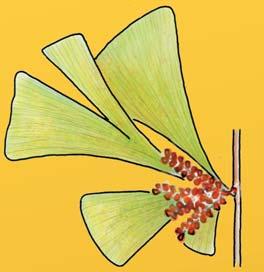




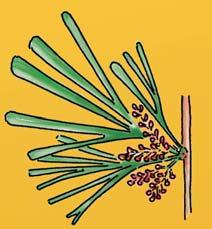
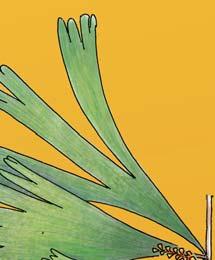


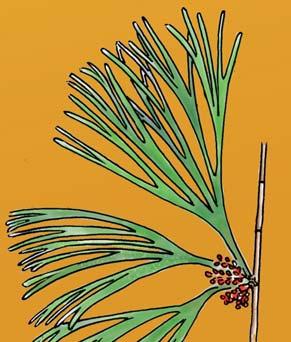













 Suppported by PALAEONTOLOGICAL SCIENTIFIC TRUST
Suppported by PALAEONTOLOGICAL SCIENTIFIC TRUST














 Production by Isteg Scientific Publications, Irene, Centurion, South Africa
Cover images: Kannaskoppia vincularis/Rochipteris vincularis (Kan 111 Ast spA) pp 124, 125. Watercolours by Heidi Anderson, 1995, 2001. Title page images: bottom left: Kannaskoppia telemagnus/Rochipteris telefolia (Tell 111 Hei elo) p. 126; digital watercolours by Heidi & Clara Anderson, June 2020; bottom right: Kannaskoppianthus matatiparvus/Rochipteris matatifolia (Mat 111 Dic dub) p. 134; digital watercolours by Heidi & Clara Anderson, June 2020.
Production by Isteg Scientific Publications, Irene, Centurion, South Africa
Cover images: Kannaskoppia vincularis/Rochipteris vincularis (Kan 111 Ast spA) pp 124, 125. Watercolours by Heidi Anderson, 1995, 2001. Title page images: bottom left: Kannaskoppia telemagnus/Rochipteris telefolia (Tell 111 Hei elo) p. 126; digital watercolours by Heidi & Clara Anderson, June 2020; bottom right: Kannaskoppianthus matatiparvus/Rochipteris matatifolia (Mat 111 Dic dub) p. 134; digital watercolours by Heidi & Clara Anderson, June 2020.





































































































































































































































































































 Kannaskoppia
Kannaskoppia




















































































































































































































































































































































































































































































































































































































































































































































































































































































































































































































































































































































































































































































































































































































































































































































































































































































































